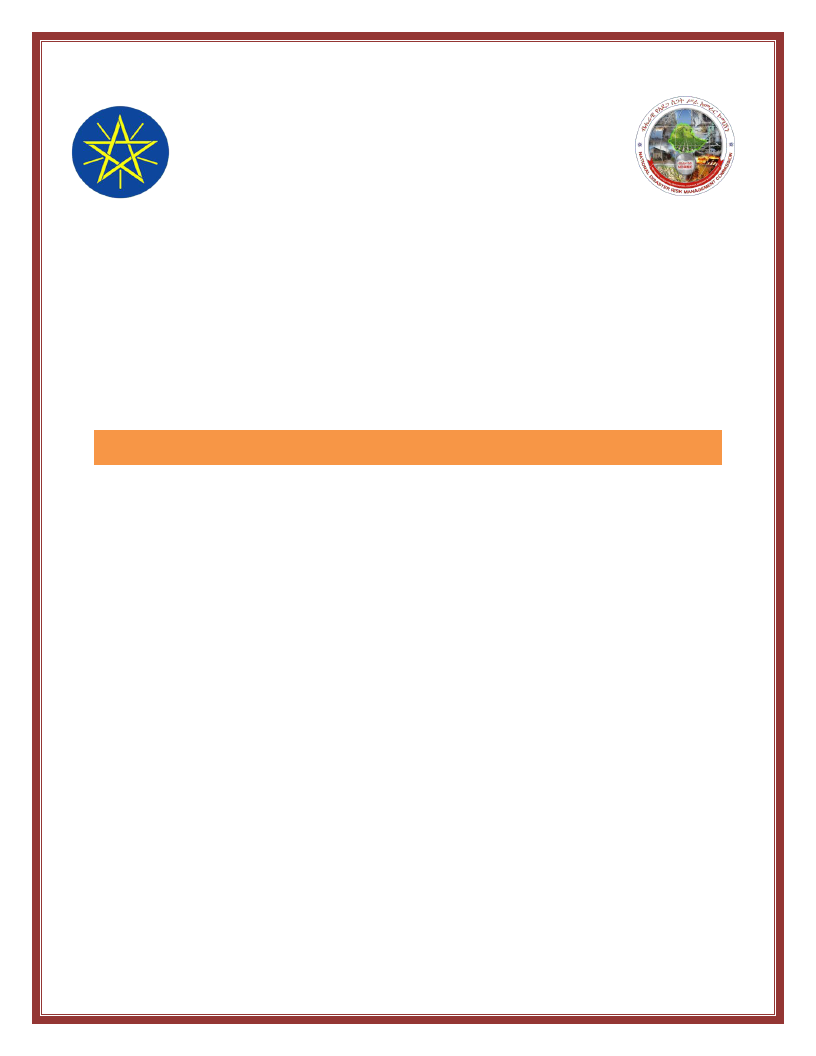
NATIONAL
DISASTER RISK MANAGEMENT COMMISSION
(NDRMC)
WOREDA DISASTER RISK PROFILE (WDRP)
REGION: SNNP
ZONE: GURAGE
WEREDA: MESQAN
December, 2020
Addis Ababa

About the National Disaster Risk Management Commission (NDRMC)
The National Disaster Risk Management Commission (NDRMC) was reestablished in
December 2015 and recognized by an act of Council of Ministers (Regulation No.
363/2015) as an autonomous Federal Government office mandated to conduct
appropriate activities for the comprehensive implementation and realization of the
objectives of the National Disaster Risk Management Policy and Strategy and to
coordinate, monitor and provide appropriate support with respect to activities
carried out by the lead sector institutions.
Address: Kirkos Sub-city Behind Dembel City Center, Addis Ababa, Ethiopia.
P.O.Box: 5686
Tele: 0115524259/4272
Website: www.dppc.gov.et
© 2020 National Disaster Risk Management Commission. All rights reserved
Printed in Addis Ababa, Ethiopia.
Citation- This Document May be Cited as Follows:
National Disaster Risk Management Commission (2020), Mesqan Woreda Disaster
Risk Profile, Addis Ababa, Ethiopia.

PREFACE
Ethiopia is well aware of the impact that disasters can have on the
development goals that we are rigorously pursuing through our
Growth and Transformation Plan II. With this recognition we started
a paradigm shift a few years ago, largely triggered by the revised
National Policy and Strategy on Disaster Risk Management.
To make the DRM programme implementation in the country well-informed, a
comprehensive information management system is required. We have been undertaking
a comprehensive risk assessment exercise under which Disaster Risk Profiles are being
prepared for each district and at sub-district levels in the country.
This Wereda Disaster Risk Profile establishes an extensive database on disaster risk
elements that will help decision makers at all levels to be better informed at community
and Wereda level about the characteristics of potential hazards, their potential
exposure, vulnerabilities of communities, capacities and that can also be an input for
Wereda Disaster Risk Reduction Plans and area specific early warning tools.
Wereda Disaster Risk Profiles developed are publically available here for the use of all
development partners and government sectors at all levels. Also, other data sources of
NDRMC, such as Desinventar, Livelihood Baseline and the Early Warning information will
be integrated and harmonized with this Information Management System.
Finally, we need to acknowledge the support of partners who have funded this
programme and we also look for the support of donors and all development partners in
order to achieve the ambitious indicators of this risk information and providing every
district with the disaster risk profile and their respective risk-informed plans.
H.E. Ato Mitiku Kassa
Commissioner
National Disaster Risk Management Commission (NDRMC)
The Federal Democratic Republic of Ethiopia (FDRE)

PREFACE
Woreda Disaster Risk Profiling (WDRP) is a government owned
programme undertaken by the National Disaster Risk
Management Commission (NDRMC) in collaboration with regional
DRM offices and development partners to provide baseline
information for disaster risk management practices and
activities in the country. The programme is designed by taking
into account the experiences gained from the implementation of pervious strategies
and actions like the Hygo Framework for Action (2000-2015) and the Sendai Framework
for Disaster Risk Reduction (2015-2030).
WDRP is composed of diversified indicators including hazard related issues, crop and
livestock production, landholding and environmental issues, human and livestock health
issues, education and social issues at wereda and kebele level. It provides basic and
detailed indicators with both quantitative and qualitative information which obtained
from both primary and secondary data sources.
Moreover, two pages summary of profiles is also prepared to help users easily
understand WDRP results for each wereda without going into detail for all indicators.
In addition to this booklet, developed profiles are uploaded on WDRP website
(http://profile.ndrmc.gov.et) to be viewed by all users; we encourage all DRM actors
at all levels to use this profile as baseline information for all DRM initiatives.
This WDRP booklet was produced through exemplary collaboration of all concerned
bodies and I would like to give my deepest gratitude to all who directly or indirectly
contribute for the success of the programme particularly for data enumerators and
supervisors, data encoders and profile development teams, consultants and advisors,
partner ministries and all DRM stakeholders.
Abraham Abebe
Director
Disaster Risk Reduction and Rehabilitation Directorate (DRRRD)
National Disaster Risk Management Commission (NDRMC)
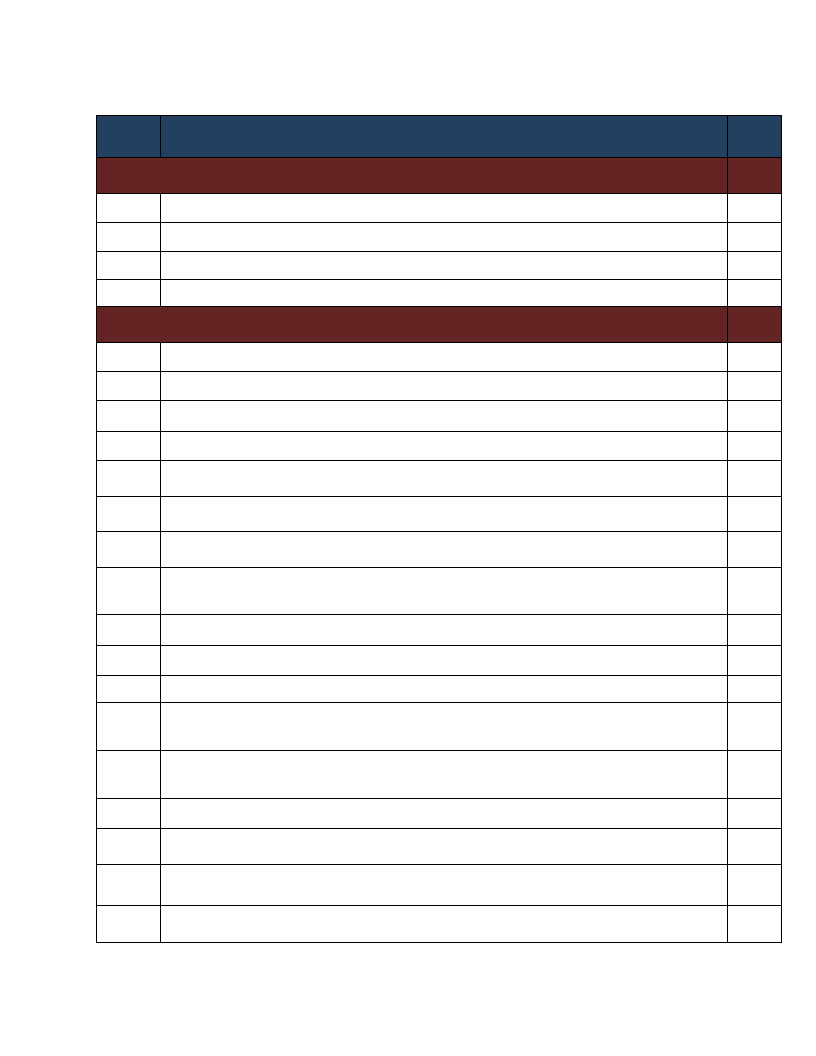
Contents
No. Indicator Name
Page
Preliminary Information
I
Preface
II
Wereda Location in Ethiopian Map
III
WDRP Methodology
IV
Summary Profile
Hazard Related Characteristics
1
1
Biological Hazards of the Wereda
2
2
Geological Hazards of the Wereda
3
3
Hydro Metrological Hazards of the Wereda
4
4
Socio Economic Hazards of the Wereda
5
5
Technological Hazards of the Wereda
6
6
Disaster Characteristics By Kebele
7
7
Hazards: Conflict as an Issue
38
8
Hazard Situation During Last Disaster - Characteristics of most recent disaster that
affected the community
41
9
Frequency of Disaster Occurrence
46
10
Household Exposure to Hazards
47
11
Months of Occurrence of Frequent Disasters
48
12
Conflicts: Perception of households on conflict issues - Is conflict an issue in this
community?
49
13
Conflicts: Perception of households on conflict issues - Who do you turn to in case
of a conflict?
50
14
Losses from Disasters - Losses from all disasters (household response in %)
51
15
Losses from Disasters - Main Losses by Type of Disasters (household response in %) 52
16
Losses from Disasters - Secondary Losses by Type of Disasters (household response
in %)
55
17
Seasonal Calendar for Hazards, Activities and Income Level By Kebele
57
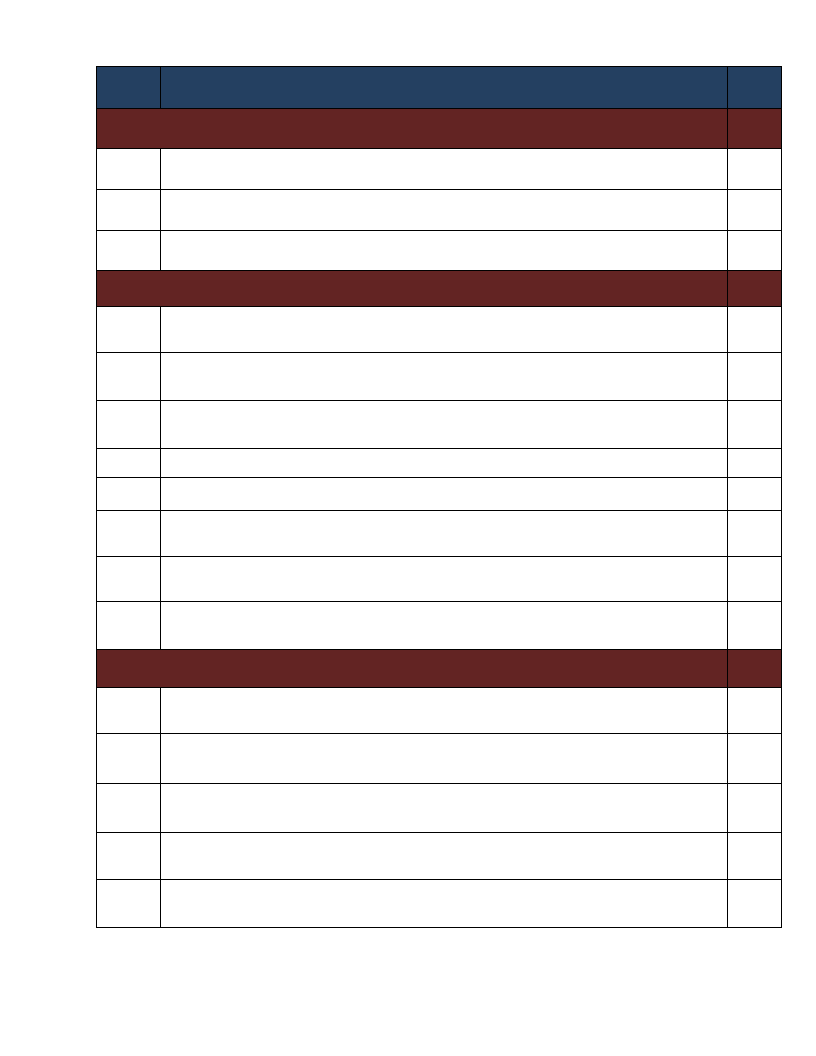
No. Indicator Name
Page
Infrastructure Access Characteristics
87
18
Physical Vulnerability: Access to Roads & Urban Centres - Households access to
road and urban centre
88
19
Physical Vulnerability: Access to Electricity - Households’ access and utilization of
electricity
89
20
Physical Vulnerability: Type of Dwelling Units - Households’ type of dwelling houses 90
Socio Demographic Characteristics
91
21
Economic Vulnerability: Level of Migration - Migration level and its characteristics
by Kebele
92
22
Economic Vulnerability: Household Migration - Household migration and reason for
migration
95
23
Economic Vulnerability: Household Migration - Disasters as a triggering factor for
96
migration (households’ response in %)
24
Demography: Population Structure
97
25
Demography: Population Trends and Ethnic Groups
100
26
Social Vulnerability: Household Demographic Characteristics - Demographic
characteristics of households
102
Social Vulnerability: Level of Educational Attainment - Education status of
27
household members
103
28
Social Vulnerability: Gender Parity - Gender parity in education level (7+ years)
and household heading
105
Environmental Characteristics
106
29
Environmental Situation: Environmental Problems - Major environmental problems
by Kebele
107
30
Environmental Situation: General Land Quality - Perceptions of the community
on changes in the general quality of land over a decade
109
31
Environmental Situation: Changes in Landscape - Changes observed by the
community on landscape and the problems due to the changes
111
32
Environmental Situation: Land-Use other than crop production - Types of land use
other than crop production across Kebeles
113
33
Environmental Situation: Deforestation - Observed changes over levels of
deforestation by the community and its problems
115
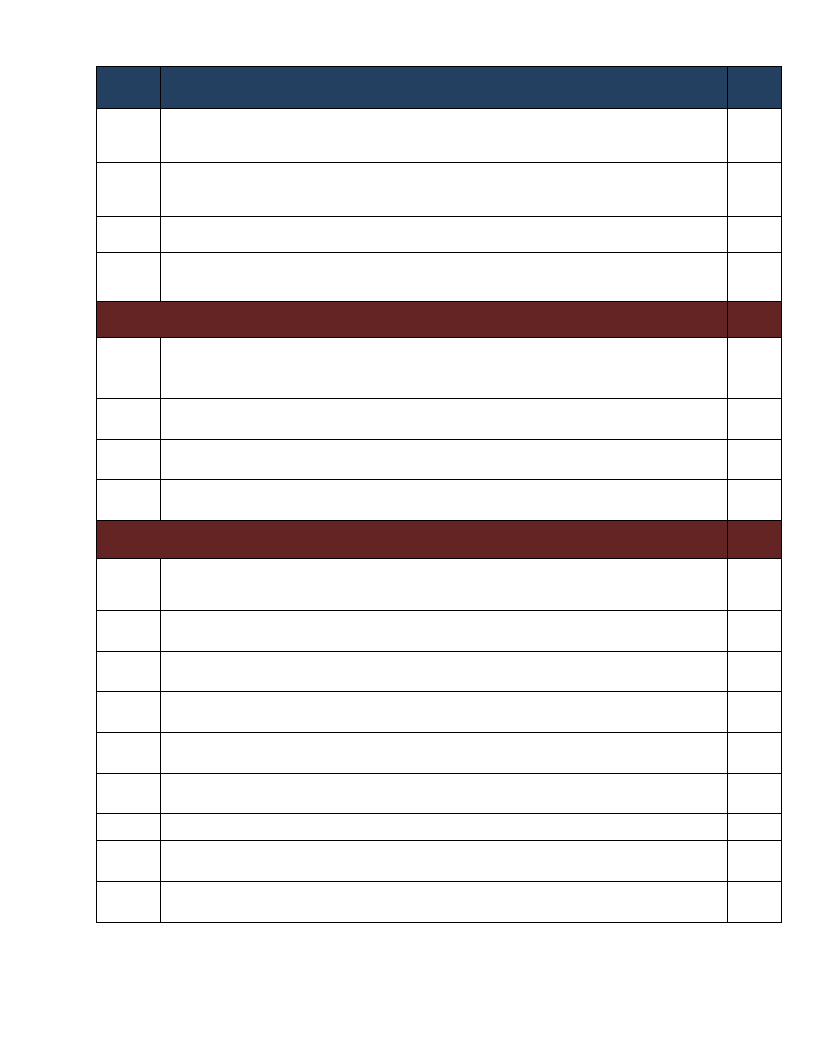
No. Indicator Name
Page
34
Environmental Situation: Natural Resources Availability - Natural resources
available and changes observed by the community
117
35
Environmental Situation: Rainfall & Temperature - Observed changes on rainfall
and temperature by the community over the last decade
132
36
Environmental Situation: Reasons for Environmental Changes
135
37
Environmental Situation: Soil Erosion - Observed changes on levels of soil erosion
by the community
137
Livelihood, Occupation and Source of food
139
38
Economic Vulnerability: Major Occupational Categories - Major categories of
occupation and percent of population engaged in the occupation by Kebele
140
39
Economic Vulnerability: Livelihoods - Households important sources of
Livelihood (response in %)
143
40
Economic Vulnerability: Occupational Categories - Percent of population above 15
years age by occupation categories
146
41
Economic Vulnerability: Sources of Food - Households source for different food
items (response in %)
147
Crop Production
149
42
Hazards: Change in Crop Damages - Proportion of total crop damage (percentage
response by households)
150
43
Hazards: Change in Crop Damages - Major reasons for crop damage (percentage
response by households)
151
44
Hazards: Change in Crop Damages - Proportion of Damage for Major Crops
(percentage response by households)
152
45
Hazards: Change in Crop Damages - Reasons for Damage of Major Crops
(percentage response by households)
154
46
Agricultural Situation: Change in Crops Grown - Five major crops grown by
proportion of total cultivated land
156
47
Agricultural Situation: Access to Extension - Perception of the community on
Access to Agricultural extension Services
166
48
Economic Vulnerability: Crops Grown - Types of crops grown by households
168
49
Economic Vulnerability: Crops Grown - Proportion of households by amount of yield
of major crops (last year)
169
50
Economic Vulnerability: Crops Grown - Proportion of households by amount of yield 170
of major crops (Five years ago)
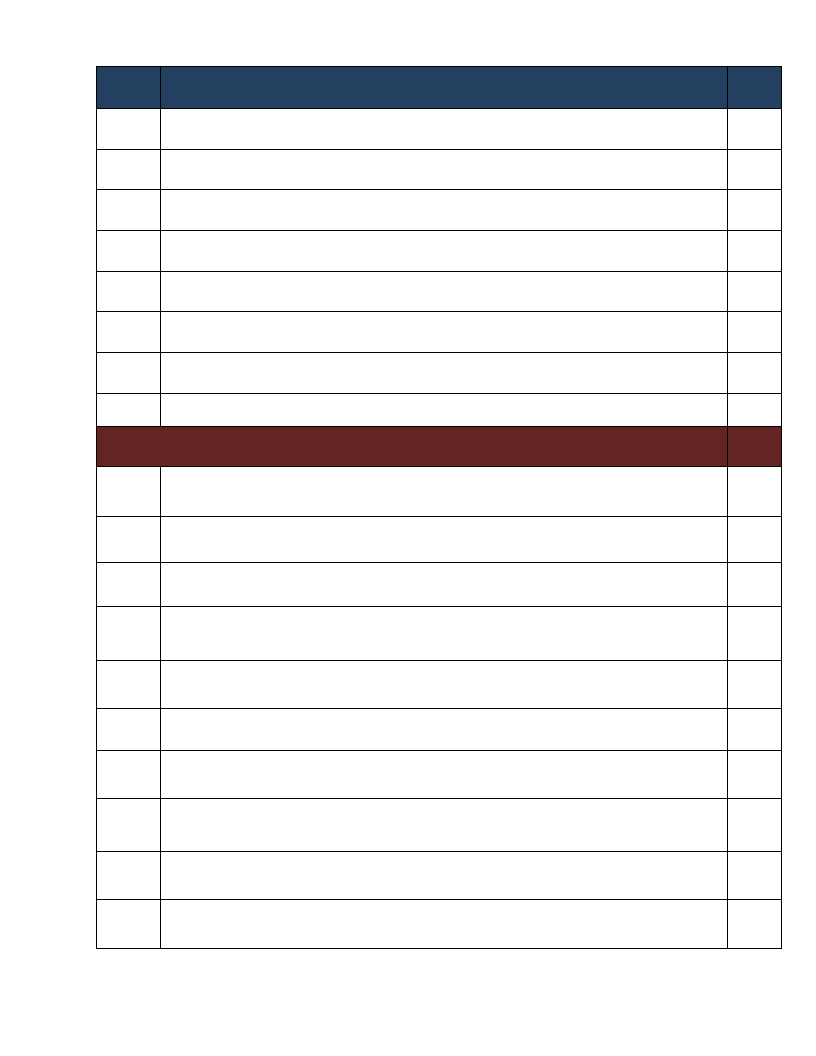
No. Indicator Name
Page
51
Economic Vulnerability: Land Ownership and Quality - Landownership of households 171
52
Economic Vulnerability: Land Ownership and Quality - Farmers’ perception on the
quality of their agricultural land
172
53
Agricultural Situation: Access to Inputs - Perception of the community on access
to improved agricultural inputs
173
54
Agricultural Situation: Water for irrigation - Access to water for irrigation in the
community
174
55
Agricultural Situation: Soil Fertility - Perception of the community on soil fertility
and its change over time
177
56
Economic Vulnerability: Status of Agriculture - Methods of tillage, Irrigation and
other agricultural input utilization by households
179
57
Economic Vulnerability: Change in Agricultural Situation - Households
perception on changes of crop type, size of cultivated area and crop yields
180
58
Economic Vulnerability: Crops Grown - Number of crops grown by households
182
Livestock Production
183
59
Agricultural Situation: Status of Livestock Disease - Change In Livestock Disease
Status By Kebele
184
60
Livestock Prevalent of Diseases & Veterinary Facility - Livestock Diseases
Prevalence
187
61
Livestock Prevalent of Diseases & Veterinary Facility - Evaluation of Access to
Veterinary Services and Livestock Drugs
188
62
Agricultural Situation: Water Availability for Livestock - Water availability for
livestock in the community
189
63
Agricultural Situation: Livestock Diversity - Type of livestock and their economic
importance in the community
191
64S
Economic Vulnerability: Livestock Ownership and Changes - Percentage of
households by number and type of livestock owned
198
65
Economic Vulnerability: Livestock Ownership and Changes - Households’ perception
on changes in livestock number in the last five years (response in %)
200
66
Agriculture (Livestock): Pasture Availability - Households’ perception on access and
quality of pasture
205
67
Agriculture (Livestock): Pasture Availability - Households’ perception on
problematic months for pasture availability
206
68
Agriculture (Livestock): Water Availability - Households’ response on water
availability for livestock
207
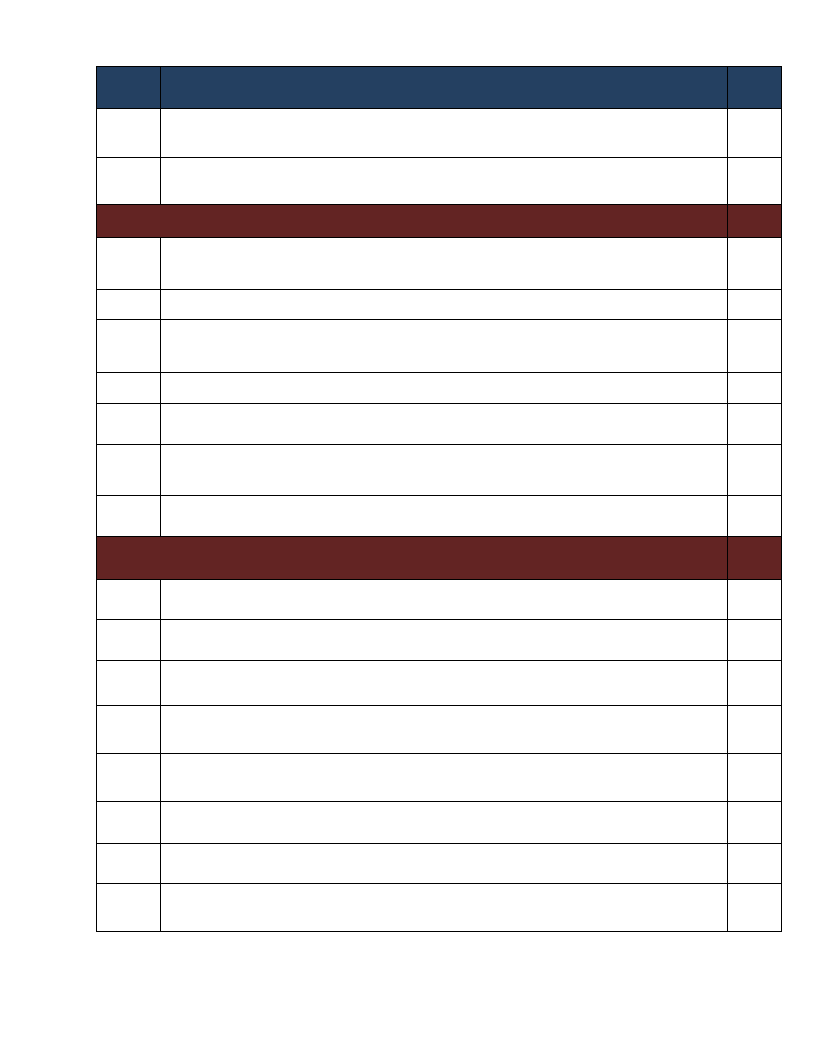
No. Indicator Name
Page
69
Agriculture (Livestock): Water Availability - Households’ perception on problematic
months of water availability for livestock
208
70
Agriculture (Livestock): Water Availability - Sources of water for livestock
(households’ response in %)
209
Access to Markets and Credit
210
71
Economic Vulnerability: Proportion of Produce Sold and Market - Proportion of
crops and livestock sold from total production and markets
211
72
Economic Vulnerability: Kebele Access to Markets - Access to market by Kebele
214
73
Economic Vulnerability: Formal & Informal Transfers - Percentage of households
reporting received formal transfers
216
74
Capacity: Access to Credit Facilities - Households access to credit facilities
218
75
Capacity: Access to Credit Facilities - Percentage of households by major reasons
of borrowing money
219
76
Capacity: Access to Credit Facilities - Percentage of households by major sources 220
of credit
77
Capacity: Access to Credit Facilities - Percent of households with ability to raise
500 birr in one week
221
Health and Sanitation Characteristics
222
78
Household Access to Health Facilities - Where do patients go for health care?
223
79
Hazards: Health problems and changes over the last decade
224
80
Household Health Status - Households’ health condition and major health problems 227
81
Household Access to Sanitation - Percentage of households with access to different
kind of toilet facilities
229
Household Access to Drinking Water - Sources of drinking water for households
82
(response in %)
230
83
Household Access to Drinking Water - Households’ methods of treating drinking
water
231
84
Household Access to Drinking Water - Number of times households fetch water in a
week
232
85
Household Access to Drinking Water - Time taken per day to fetch water for
households
233
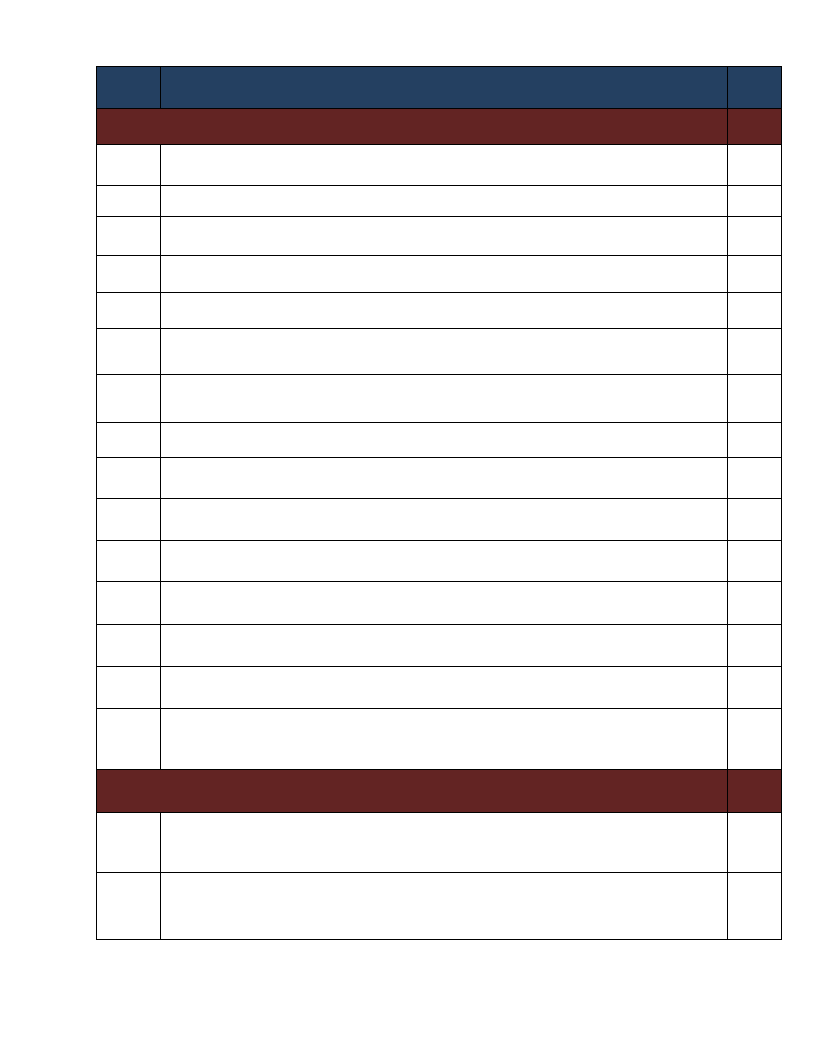
No. Indicator Name
Page
Coping Mechanisms and Preparedness Measures
234
86
Capacity: Community Preparedness against Sudden Onset Disasters
235
87
Capacity: Community Preparedness against Increase in Disaster Intensity
239
88
Capacity: Community Preparedness against Disasters
243
89
Hazard: Coping and recovering during last Disaster
248
90
Capacity: Type Community Participation
263
91
Capacity: Recovery from Losses from Disasters - Percentage of Households who
have managed to recover from losses of disasters
265
92
Capacity: Coping Strategies Adopted by Households - Main coping strategies
adopted by households to recover from respective losses
266
93
Capacity: Coping Strategies Adopted by Households - Percentage of households
by frequency of main coping strategies adopted
270
94
Capacity: Alternative Livelihood Sources - Alternative livelihood sources suggested
by the community
272
95
Capacity: Recovery from Losses from Disasters - Percentage of households
recovered from past disasters by type of Disasters
276
Capacity: Recovery from Losses from Disasters - Proportion of households
96
recovered by type of Losses
277
97
Capacity: Coping Options if More Resources Available - What coping strategy could
be adopted if more resource were available?
278
98
Capacity: Coping Strategies Adopted by Households - Percentage of households by
major type of coping strategies adopted (at least once)
279
99
Capacity: Coping Strategies Adopted by Households - Main coping strategies
adopted by households for respective disasters
281
100
Capacity: Coping Strategies Adopted by Households - Secondary coping strategies
adopted by households for respective disasters
287
Community Perception and Suggestions
289
Interventions: Community Perception on Mediums to Influence DRM Actors -
101
Community perception on the effectiveness of institutional channels to use to
290
influence DRM actors
Interventions: Community Perception on their Knowledge used in DRM Process -
102
Perception of the community on how their knowledge influences the priorities and 295
measures of DRM actors
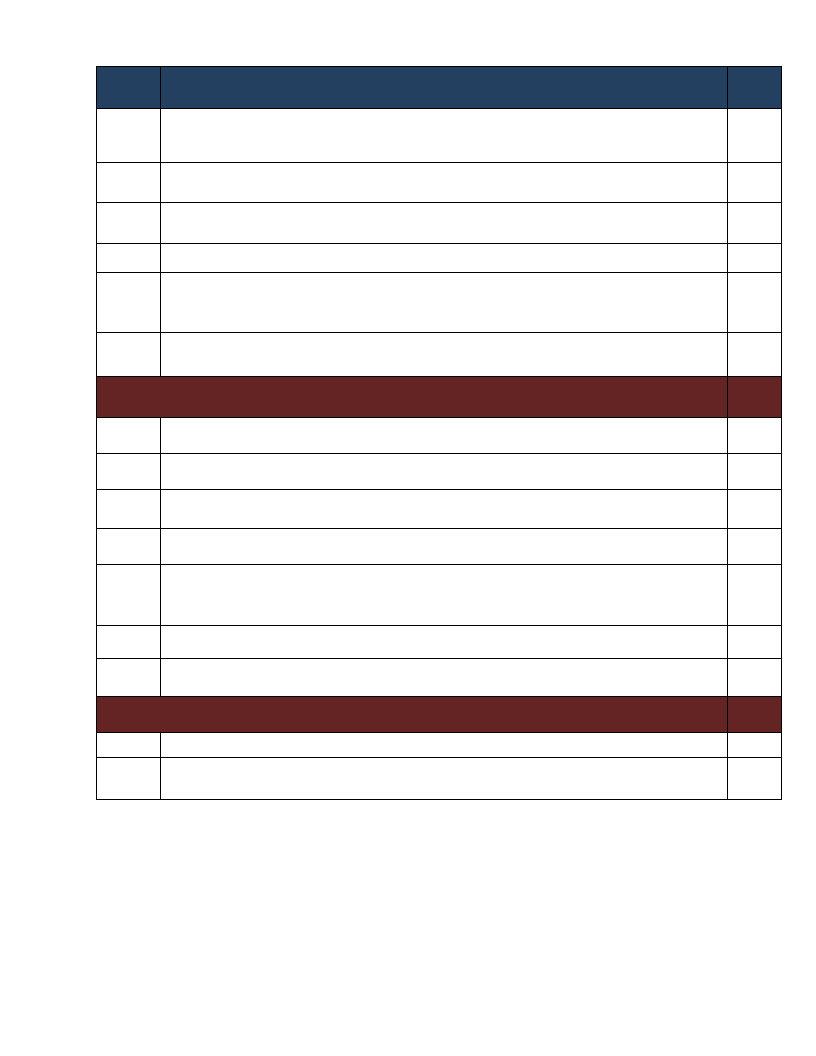
No. Indicator Name
Page
103
Interventions: Suggestions to improve preparedness - Interventions suggested by
the community to development actors to improve preparedness in the area
297
104
Interventions: Suggestions to DRM Actors in the Area - Community suggested
measures to DRM actors in the area for effective DRM actions
298
105
Economic Vulnerability: Community Suggestions to Improve Economic Situation -
Community suggested measures to improve the economic situation of the area
304
106
Community Awareness of Disaster Risk Management System and Actors
308
Community Perception of DRM System and Actors - Perception of the community on
107
the effectiveness of DRM system in helping them to prevent, cope and recover
323
from disasters
108
Major Public Interventions Desired - Percentage of households by type of
intervention desired
328
Others
330
109
Capacity: Community Based Organization in the Wereda
331
110
Supporting Agencies against Disasters - Percentage of households by supporting
institutions to handle or recover from disaster damages
342
111
Type of Support Received From Supporting Agencies – Household responses of types
of support received from supporting agencies
343
112
Government Actors in the Field of Disaster Risk Management - Government actors
and their activities in the field of Disaster Risk Managements
344
113
Non-Government Actors in the Field of Disaster Risk Management - Non-government
actors and their activities in the field of Disaster Risk Management
347
114
Interventions: Community Suggestions to Development Actors
348
115
Wereda SWOT Analysis
363
Supplementary Information from Secondary Sources
116
Wereda Livelihood Zone Information
117
Wereda General Information
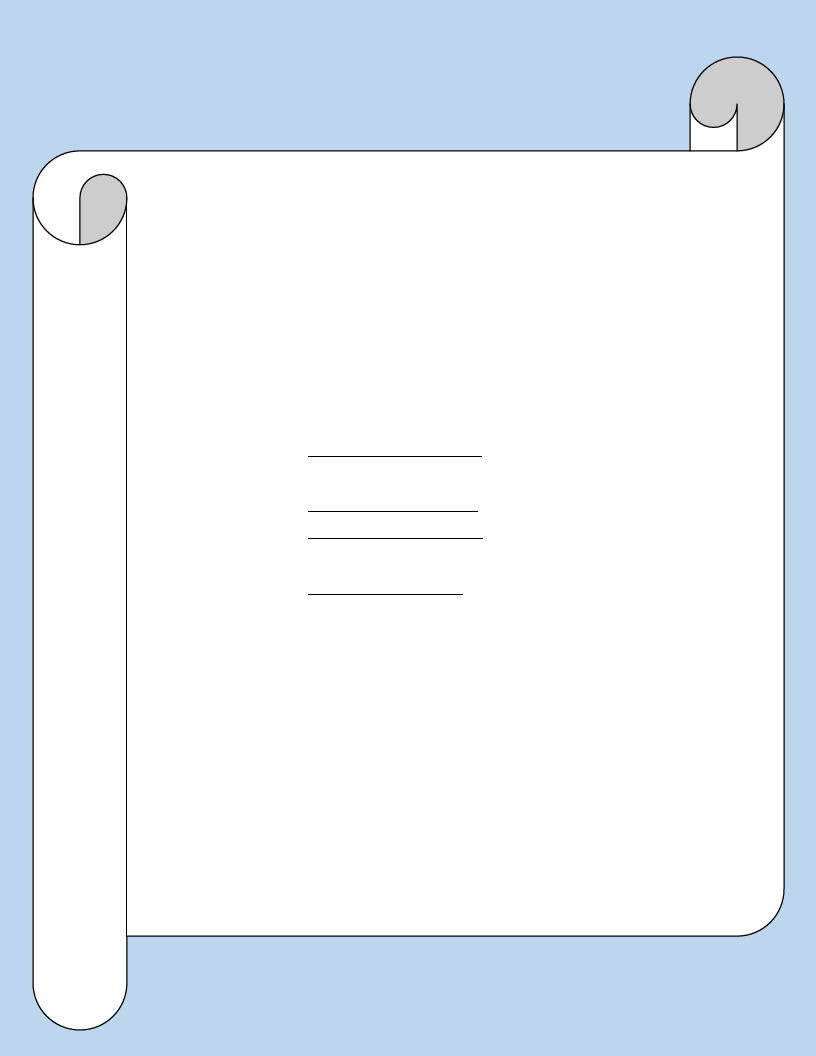
METHODOLOGY
WDRP Content :
• Comprehensive information on disaster risk components
(Hazards, Vulnerability and Capacity)
• Multi-sectoral and multi-hazard information.
Research Approach:
• Mixed Approach
• Both quantitative and qualitative information
Data Sources:
• Primary Data:
Household Questionnaires: statistically significant number
(around 400 households).
Focus Groups Discussions: One per kebele
Key Informant Interviews: with major woreda level government
and non-government DRM actors
Problem Tree Analyses : to see the cause and effect of disasters
• Secondary Data:
collected relevant to WDRP indicators:
LIU, SERA Project, Risk baseline, other ministries…
Sampling Technique:
• Multistage cluster sampling
• Both Probability and Non-probability sampling
Methods of Analysis:
• Descriptive Statistics
• Textual Analysis
• Cispro and SPSS
• Automate WDRP software

WEREDA
SUMMARY DISASTER RISK PROFILE
INFORMATION
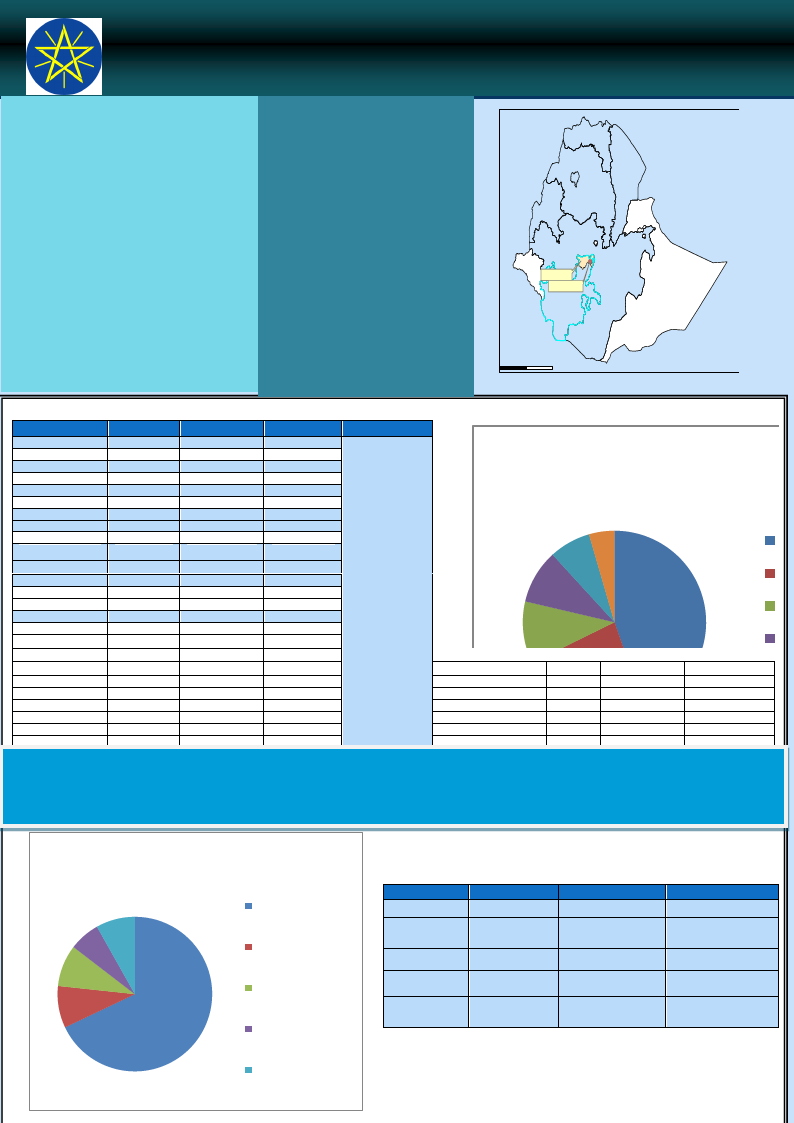
Wereda Disaster Risk Profiling Programme: SNNPR
Disaster Risk Profile: Meskan Wereda
SUMMARY OF WEREDA PROFILE
Drought and flooding are the most challenging disaster
risk in the wereda which resulted in other serious
problems of the community followed by crop disease,
frost/ cold wave and livestock, which affect the
households.
Environmental problems such as deforestation, soil
erosion, crop pest, water pollution, lack of irrigation,
population pressure lack of soil and water
conservation, weak capacity of the community, high
illiteracy level, and poor preparedness measures, are
among the major vulnerability factors in the wereda.
Enhancing utilization of irrigation schemes, solving
social and financial problem in the community, having
cooperatives, provision of improved crop seed based
on agro ecology, natural resource conservation,
developing underground water, and awareness
creation on family planning, and improving
infrastructures like road and electricity are some of
the suggestion intervention in the woreda.
MAJOR DISASTERS REPORTED IN WEREDA
Kebele
Disaster 1
Disaster 2
BATI FATO
BATI LEJANO
BECHE BULCHANO
BERESA
DEBO TUTO
DEBUB SHERSHERA
DEGAGOGOT
DIDA
DIRAMA
DOBENA
Drought
Drought
Drought
Drought
Flood
Drought
Livestock disease
Drought
Flood
Drought
Crop diseases
Flood
Flood
Flood
Drought
Flood
Flood
Crop disease
Drought
Flood
GIDENA ABORAT
GOYBAN
ILE
INSENO USME
JOLE ANDENYA
JOLE HULETENYA
MEKICHO
MESERETEWEGERAMO
MIKAELO
Flood
Flood
Flood
Drought
Flood
Flood
Drought
Flood
Flood
Frost / Cold waves
Drought
Drought
Livestock Disease
Drought
Frost / Cold waves
Flood
Livestock Disease
Frost / Cold waves
MIRAB IMBOR
MIRAB MESKAN
OCHAGENEME
SEMEN SHORSHORA
SHERSHERA MACHMENA
WEJABATI
Flood
Flood
Drought
Drought
Drought
Drought
Drought
Drought
Flood
Flood
Flood
Crop disease
Gurage-Siltie Highland Enset and Barley Livelihood Zone
This zone has historically been self-sufficient in crop
production, and households remain generally food secure.
But population pressure is increasing, and already there is
±
major work out-migration of young men as far as Nazareth,
Addis Ababa and even Dire Dawa, although men from
poorer households tend to work more locally. Apart from
enset the main food crops are barley, pulses and Irish
potato. Space for pasture and therefore plough oxen is
limited. Eucalyptus is also planted, and is both used for
firewood and sold for use in construction.
Gurage-Siltie Midland Enset and Chat Livelihood Zone
Population density is high and a wide variety of crops are
grown, including the main staple, enset, and the main cash
crop, chat. Even poorer households produce an unusually
high proportion of thier basic food needs, but they depend
for cash on casual work locally and in towns. All wealth
groups, particularly the better-off, receive significant
remittances from family members working longterm in
urban centres, including Addis Ababa. This has been a food
secure zone, but is under some economic stress as income
from the capital has been affected by competition from
migrants from other areas, official restraints on street
vending, and the official tax on chat entering the city.
Gurage-Siltie Enset and Teff Livelihood Zone This is a fertile
zone, but until recently a large part of it has not been
cultivated due to government set-aside for the resettlement
0
programme and to trypanosomiasis, which severely inhibits
local oxen production. Some tractors are now being used to
open new land. Enset is the main staple food, together with
maize, sorghum and chickpeas. Erratic spring or summer
rains can be particularly damaging to production given the
high moisture requirement here. Teff and Niger seed are the
prDiniscaipsatlecras3h crops whichLIrUeaIcnhfoAddis Ababa via the Jimma-
AALldaidvbeiass-htMoigcahkrwedkaisoye.asLeoswland Pepper Livelihood Zone This
reClraotpivdeilsyefaosoed secure zonCehhraosnaicvaHluaazbalredcsa:sh crop industry
thCartopadtitsreaacstes migrant laborers from other zones. The
pLoipvuelsattoiockndisiseraelsaetsively sparse and land-holdings are large
eonLfiovtuhegsethiroctfkoooDadilsloenwaeseeedvsenanpdootroheoaursnehcoalsdhs
to grow
through
nearly 60%
the sale of
peHpupmearns. disLeiavesestock production, especially cattle, is
imFproosrtta/nCtoilndcwluadvinegs for the poor through butter sales . The
zoLniveesistoacffkecDtiesedabsey both rain failure and flooding.
CoHnutmenantsdiMseaapse& livelihood zone description Population by
mlivLoievnleiihtsootoroicdnkgzDNoinsoeena-Lfsoievoedlihsoeoctdorzosnuemmpraorfiieless Key parameters for
Livestock Disease
Snow
Livestock Disease
Flood
Livestock Disease
Drought
Frost / Cold waves
Landslide
Livestock Disease
Kebele
Frost / Cold waves
Frost / Cold waves
Livestock Disease
Soil Erosion
Livestock disease
WITA
WOLENSHO ANDENYA
YETABON
YIMERWACHO 2NYA
YIMERWACHO 3NYA
Location of Meskan Wereda SNNP Region
Tigray
Benishangul Gumuz
Afar
Amhara
Addis Ababa
Dire Dawa
Hareri
Gambela
Guraghe Zone
Meskan Wereda
SNNPR
Oromia
Somali
200
400
Km
Administrative boundaries couldn't be authorized as llegal
Proportion of households by m
disaster suffered last five yea
7% 4%
10%
45%
11%
Disaster 1
Disaster 2
23% Drought
Flood
Drought
Flood
Flood
Livestock Disease
Drought
Flood
Drought
Crop disease
Disaster 3
Livestock Disease
Snow
Drought
Livestock disease
Flood
Dr
Flo
Cro
Fro
Liv
Ot
SHORT NARRATIVE ON MAJOR DISASTERS:
The hydro metrological hazard drought, flood and frost/cold waves are the major disaster risks in the wereda which are the ma in ca uses for crop da ma ge,
l oss of i ncome, livestock damage, illness/ health problem a nd Phys ical damages on houses a nd properties. Li vestock diseases s uch a s Lumpy Skin Di s ea s e
(LSD), Anthra x a ffecti ng ca ttl e, Foot a nd mouth di s ea s e, Newca s l e di s ea s e (Chi cken) a nd Bl a ck l eg) a re a l s o preva l ent i n the a rea .
Proportion of households by main disaster
losses
8%
6%
9%
9%
68%
Crop damage
Physical damages on
houses and property
Livestock damage
Loss of income
Disasters
Drought
Flood
Crop disease
Frost/cold
waves
Livestock
disease
EFFECT OF DISASTERS
Loss 1
Crop Damage
Crop damage
Crop damage
Loss 2
Loss of income
Physical damages on
houses and property
Loss of income
Crop damage
Loss of income
Livestock
damage
Illness/health
problems
Loss 3
Livestock disease
Had to flee/change
residence area
Loss of saving
Illness/health
problems
Livestock damage
Others
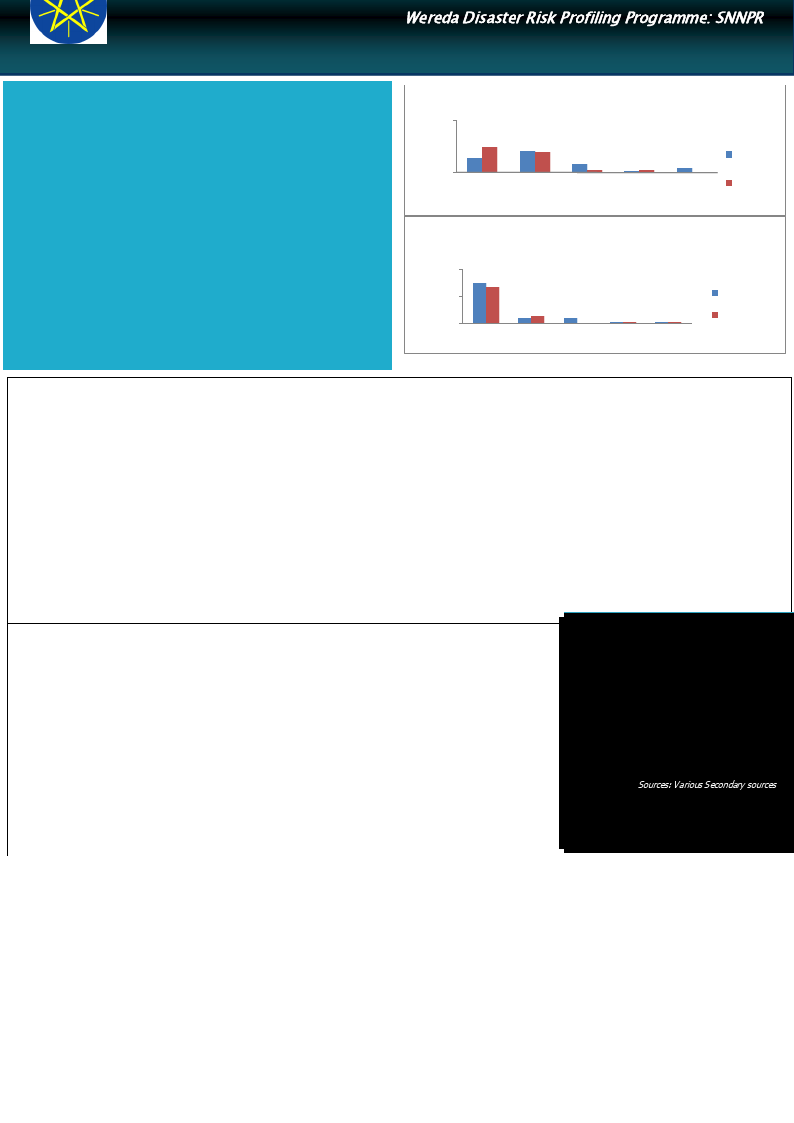
Wereda Disaster Risk Profiling Programme: SNNPR
HOUSEHOLD AND COMMUNITY
VULNERABILITY
Disaster Risk Profile: Meskan wereda
VULNERABILITY
The l ivelihood of the community i s highly dependent on cereal crop . Ma i ze
a nd Teff a re the main grown crops i n addition; wheat, Enset, Beans, pepper
Proportion of reason for crop damage for those crops cultivated by
100.00
the households
a nd fruits are a lso produced i n the woreda. Selling cereals food crops is the
ma i n s ource of i ncome .
Pes ts and drought a re the ma jor rea s ons for crop da ma ge, whi ch i s
res ulted i n less production a nd loss of i ncome makes the communi ty more
0.00
Pests, Insects, WeedDs rought
Fl ood
Fr ost
Others
Last Year
Five Year
Ago
vul nera bl e to di s a s ter. From the s urveyed hous ehol ds ha l f of the
communi ty ha ve not ma na ged to recover from l os s es of di s a s ter.
Envi ronmental problems; Deforestation, s oi l eros i on (due to fl oodi ng),
extent of drought, water pollution, pest i nfes ta ti on a nd l a ck of na tura l
res ource conservation, a nd l a ck of s hi fti ng cul ti va ti on a re a mong the
fa ctors whi ch ma ke the communi ty vul nera bl e to di s a s ter.
Proportion of households by major crops grown and changes
during last year and last five years
100.00
50.00
Last Year
La ck of i nfrastructure s uch as electricity a nd road, lack of fa mi l y pl a nni ng
a nd l ack of awareness a re a mong the weaknes s of the communi ty whi ch
ma kes them vul nera bl e.
0.00
Maize Teff Enset Wheat others
Five Years
Acces s ibility:
Access to road and urban center: 25% of the households reported either there is no road or dirty roa d that is difficult for ca r. The average ti me ta ken
to rea ch the nearest paved road in the woreda i s 14 mi nutes and the a vera ge ti me to rea ch the nea res t urba n ca nter i s 1 hours a nd 7 mi nutes .
Accesses to electricity: Of the household surveyed 13.39% a re located i n the community with electricity a nd 9.54% a re actually connected to electric
p o we r.
Access to market: Al l most all kebeles reported that a ccess to ma rket is very l imited because of price fl uctuation, i nformation gap and in s ome kebeles
there i s l a ck of tra ns porta ti on.
Access to water and sanitation: Mos t of the households (91%) use water for drinking from communal tap (bono), pi ped wa ter outs i de the hous e,
ri ver/s tream a nd Birka , where 57% of them use other methods for treating water. Out of the s urveyed hous ehol ds 89% of them ha ve outdoors
l a tri ne/hol e on pl ot, 9% ha ve no toi l et fa ci l i ti es i n the hous e a nd 2% of them a re s ha ri ng toi l ets .
Access to credit: ‐ 84% of the s urveyed households reported using credit servi ce mainly from bank or formal l ending institute and friends, mainl y), to
buy a gri cul tura l i nput (37%), to buy food (23%), to buy or rent l a nd (10%) a nd pa y for other needs (25%).
Access to agricultural inputs: Acces s to fertilizer a nd pesticides is good 91% a nd 78% of households reported using both chemical and natural fertil i zer
a nd pesticides respectively. Al so a ccess to extension services i s good; where 96% of the households reported obtaining the s ervi ce a nd 89% of them
a l s o ha ve a cces s to improved seed.
Level of Awareness and Institutional Development
Info Bits:
Literacy level The proporti on of l i tera te popul a ti on a bove 7 yea rs ol d i s 14.04% out of whi ch 25%
compl eted below 1st gra de l evel, 43% a nd 29% of the population completed primary a nd s econdary s chool
Population
res pectively. With regard to gender parity i n education, proportion of female students is higher than male
Sex ratio
s tudents i n completing 1st gra de level, but dominated by male students i n all other education levels. Of the
Urban Population
tota l hous ehol ds s urveyed, 18% of them a re fema l e -hea ded hous ehol ds .
M ean A ltitude
Community awareness a bout di s a s ter ri s k ma na gement s ys tem a nd a ctors Is genera l l y reported
l es s effecti ve due to l a ck of commi tment a nd l a ck of a wa renes s a nd budget. There a re formal
to be
Mean Slope
Road density
communi ty ba s ed orga ni za ti ons s uch a s s a vi ng a nd credi t a s s oci a ti on, fa rmers a s s oci a ti on, youth Measles caseload
: 159,884 (2007)
: 1039.5F/1000 M
: 13,232 (2007)
: 2023.85 m
: 4.46%
:69.5
:2 (2004-2009)
a s s oci a ti on, coopera ti ves , womem a s s oci a ti on a nd i rri ga ti on coopera ti ves a nce. Informal orga ni za ti on
equb, edi r, debo a nd da do hel pi ng ea ch other when there i s s pi ri tua l a nd s oci a l probl em duri ng fa rm
Sources: Various S econdary sources
work ba d ti me a nd s a vi ng money. There a re a l s o NGOs s uch MERCY CORPS, USIAD, SOS Sa hel Ethi opi a ,
Hunger project a nd Agri s ervi ce Ethi opi a n worki ng on di fferent a cti vi ti es , s ee d provi s i on, a wa renes s crea ti on
a nd chi l d ca re the communi ty.
COMMUNITY CAPACITY TO COPE
Major coping mechanisms are: Seek alternative or additional jobs, consumption ra ther than sale of crop surplus, increased working hours and
reduced expenditure on non -essential i tems (beer, cigarettes, clothes, meat, etc.).
In the events of more resource available (40%) of them a daptation of economic activi ties to hazards s eason (e.g. cropping cycl e, short term
crops , etc.), (32%) Phys ical protection of buildings a nd property a nd (254%) Storage of food and other necessities.
In the wereda it is reported that 49% of the household have managed to recover from l osses of disasters a ffected.
Duri ng disaster 65% of the households are a ble to raise Birr 500.00 i n one week through borrowing money, s a vi ngs a nd by s el l i ng a s s et or
l i ves tock.
The social capital in the wereda is cooperation among the community during farm work, helping each other and other activities is
very strong which still in a good condition in all kebeles.
Crop and Livestock diversity: The most commonly grown crops i n the woreda a re Maize, Teff, sorghum, barley, wheat, ha ri cot bea n, pepper,
bea ns a nd fruits. The major types of l ivestock reared in the wereda are cow, ox, s hoats, ca ttle a nd donkey (for tra nsporting goods ). Poul try a l s o
for food a nd i ncome.

WDRP Indicators
Hazard Related Characteristics
1
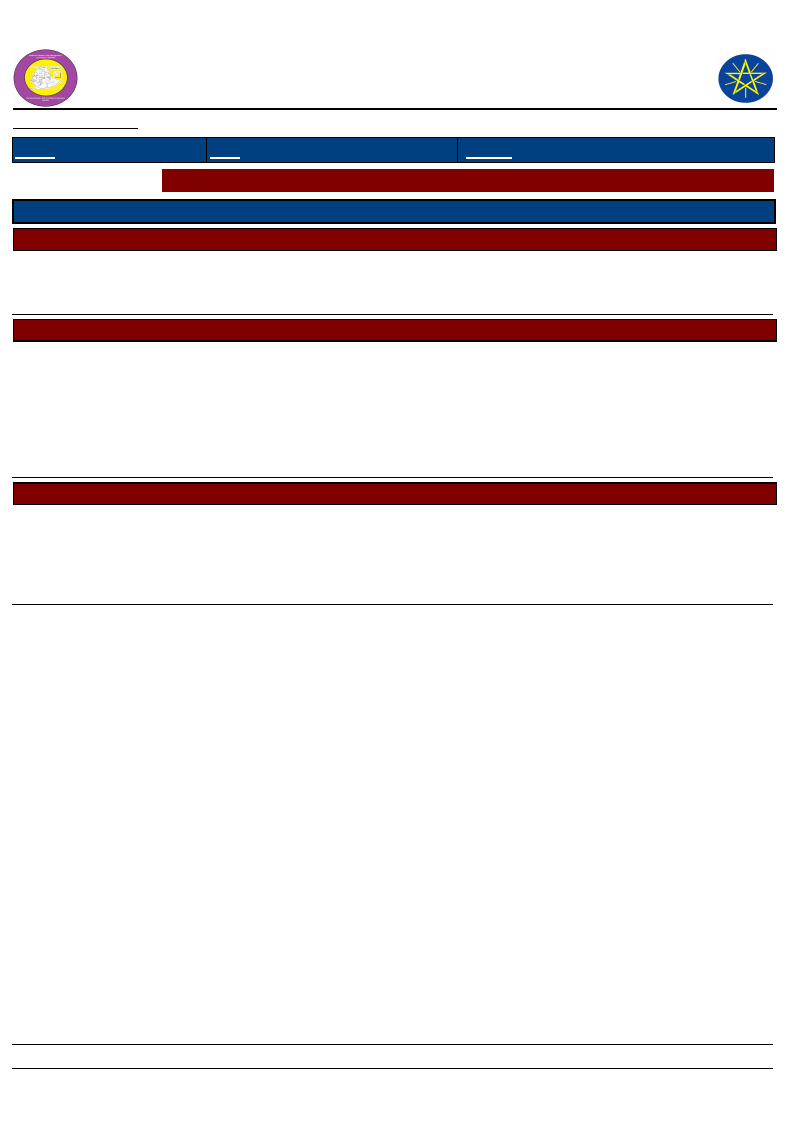
Wereda Disaster
Risk Profile
National Disaster Risk Management
Commission (NDRMC)
Data_Collected_Date
Tuesday, July 9, 2019
Region S.N.N.P
Zone
GURAGE
Wereda
MESKAN
Selected Indicator
Biological Hazards of the Wereda
Hazard_Name
Cause_Of_Hazard
Hazard_Sub_Type
Crop diseases
Crop diseases
Climate change, Increasing
temperature, fungus, no crop rotation,
No resistant verity seeds
Hazard_Sub_Type
Human diseases
Chronic fever
Stomach pain
Headache
Eye problems
Malaria
Diarrhea
Mental illness
Climate change, shortage of food, lack
of clean drinking water
Favorable condition for mosquito
reproduction (Stagnant water)
Hazard_Sub_Type
Livestock diseases
Lumpy Skin Disease (LSD)
Anthrax affecting cattle
Foot and mouth disease
Newcasle disease (Chicken)
Black leg
Climate change, shortage of food
Disease transmit from in migrating
animal and from camel, shortage of
pasture, damaging skin of livestock
Effects_Of_Hazard
Crop damage, decreased yield, shortage
of food
Death of human, loss of income,
economic crises
Death and disease of livestock
Decreasing livestock production, loss of
income, economic crises
Page 1 of 1
2
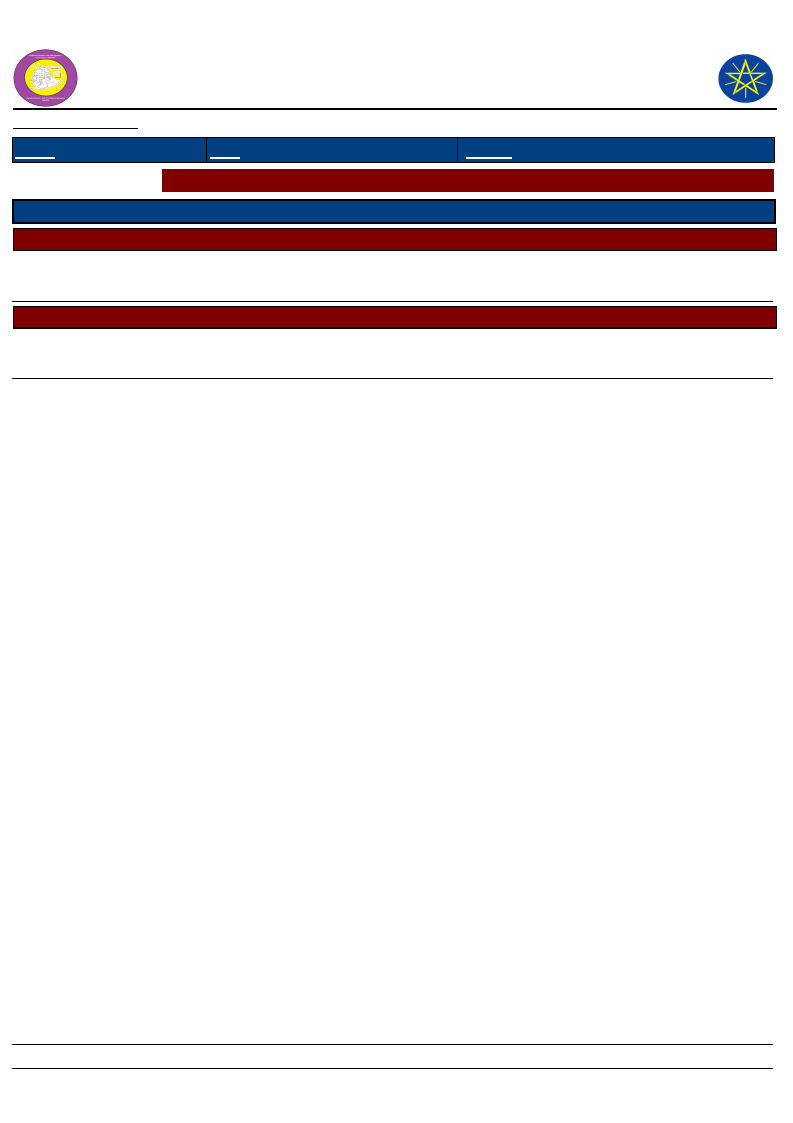
Wereda Disaster
Risk Profile
National Disaster Risk Management
Commission (NDRMC)
Data_Collected_Date
Tuesday, July 9, 2019
Region S.N.N.P
Zone
GURAGE
Wereda
MESKAN
Selected Indicator
Geological Hazards of the Wereda
Hazard_Name
Hazard_Sub_Type
Landslide
Cause_Of_Hazard
Landslide
High rain fall, flood
Effects_Of_Hazard
Destruction of house, damage farm land,
crop damage
Hazard_Sub_Type
No report
No Geological hazard
Page 1 of 1
3
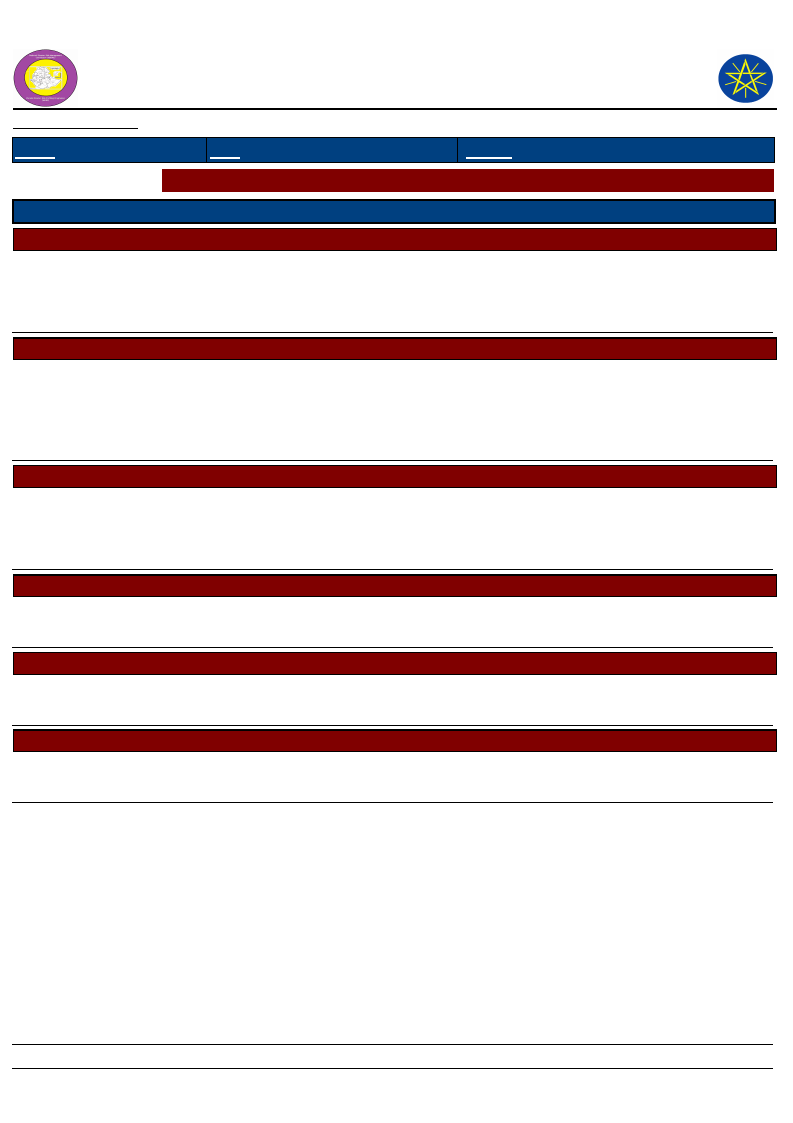
Wereda Disaster
Risk Profile
National Disaster Risk Management
Commission (NDRMC)
Data_Collected_Date
Tuesday, July 9, 2019
Region S.N.N.P
Zone
GURAGE
Wereda
MESKAN
Selected Indicator
Hydro Metrological Hazards of the Wereda
Hazard_Name
Hazard_Sub_Type
Drought
Cause_Of_Hazard
Drought
Climate change, shortage of rain,
erratic rain fall, deforestation
Hazard_Sub_Type
Flood
Hazard_Sub_Type
Frost / Cold waves
Flood
Heavy rain fall, fluctuation of rain fall,
climate change, deforestation
Unseasonal and heavy rain fall,
topography, sandy soil type, Poor
ploughing system
Frost / Cold waves
Climate change
Hazard_Sub_Type
Snow
Snow
Climate change
Effects_Of_Hazard
Shortage of food and water, human and
livestock disease, economic loss
Crop damage, death of livestock,
shortage of pasture, malnutrition
Death of livestock and crop damage,
water pollution, damage livestock
forage, shortage of food
Soil erosion, destruction of house and
material, human disease
Damage crop, loss of income, loss of
livestock forage, loss of income
Damage enset, chat, fruit, coffee/,
damage livestock and production
Crop damage
Hazard_Sub_Type
Soil Erosion
Hazard_Sub_Type
Storms / hail storm
Soil Erosion
Over grazing, topography, deforestation
Storms / hail storm
High wind and rain fall
Decreased soil fertility, decreased
productivity
Death of human and livestock
Page 1 of 1
4
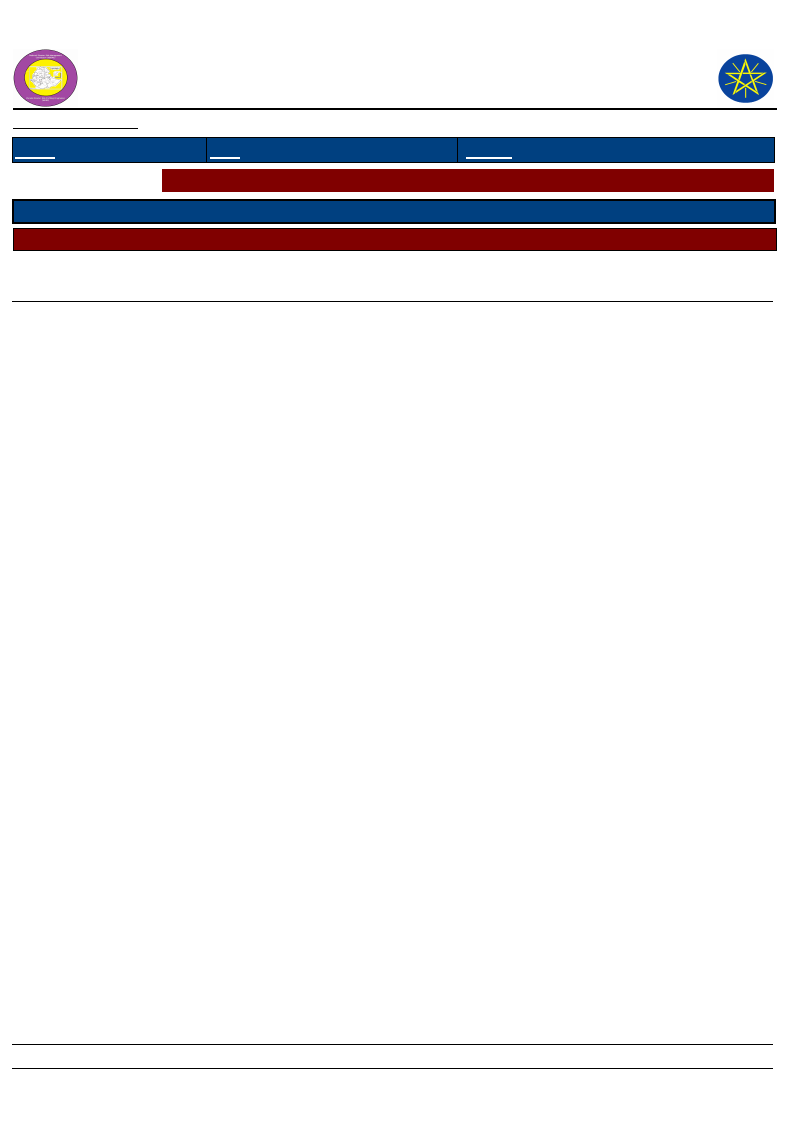
Wereda Disaster
Risk Profile
National Disaster Risk Management
Commission (NDRMC)
Data_Collected_Date
Tuesday, July 9, 2019
Region S.N.N.P
Zone
GURAGE
Wereda
MESKAN
Selected Indicator
Socio Economic Hazards of the Wereda
Hazard_Name
Hazard_Sub_Type
No Report
Cause_Of_Hazard
No Socio Economic hazard
Effects_Of_Hazard
Page 1 of 1
5
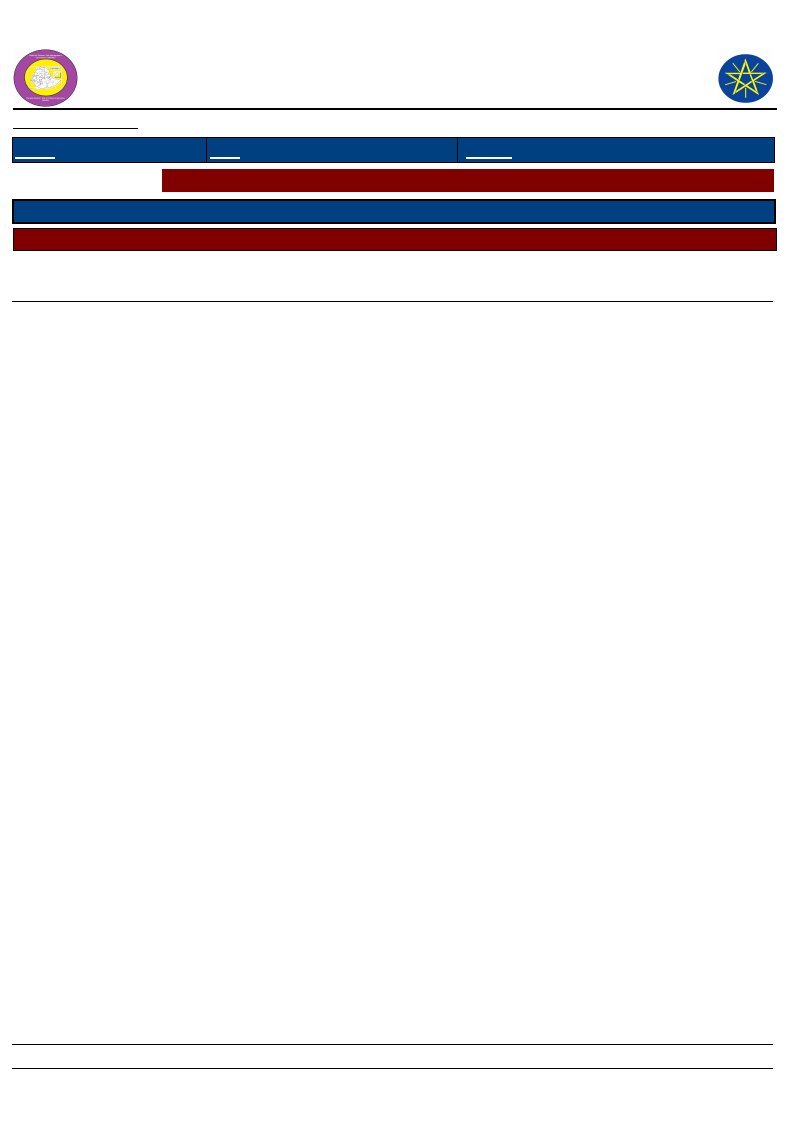
Wereda Disaster
Risk Profile
National Disaster Risk Management
Commission (NDRMC)
Data_Collected_Date
Tuesday, July 9, 2019
Region S.N.N.P
Zone
GURAGE
Wereda
MESKAN
Selected Indicator
Technological Hazards of the Wereda
Hazard_Name
Hazard_Sub_Type
No Report
Cause_Of_Hazard
No Technological Hazard
Effects_Of_Hazard
Page 1 of 1
6
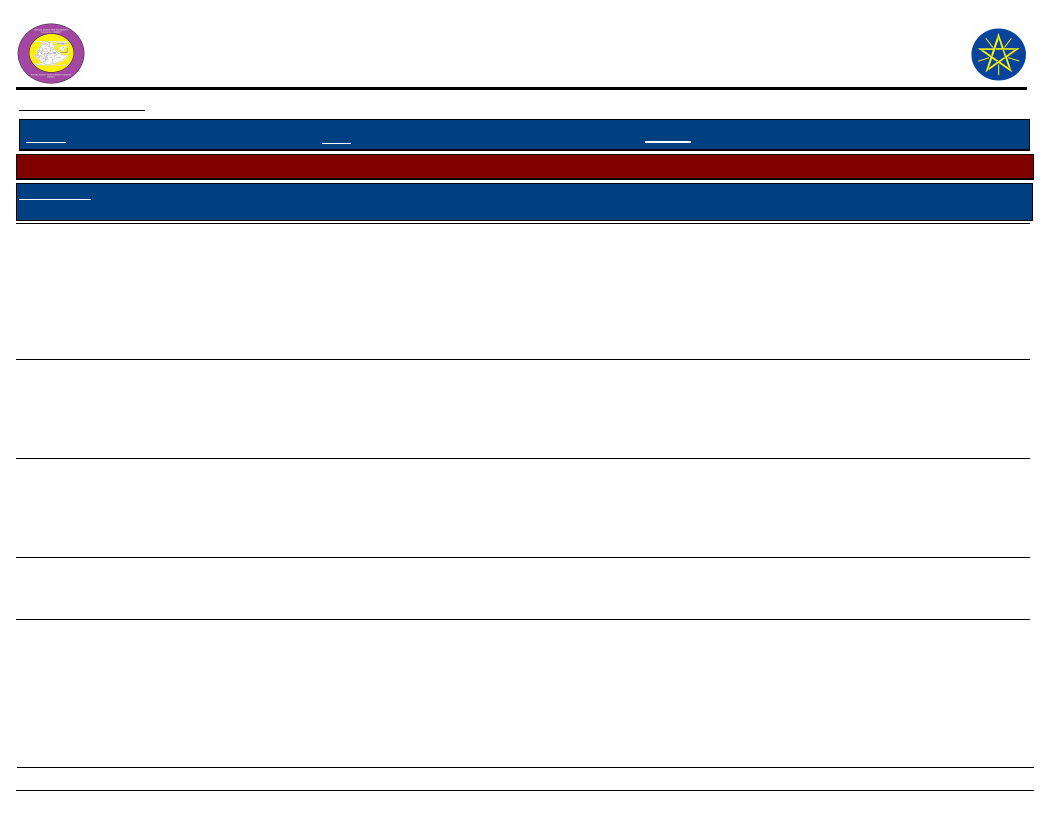
Wereda Disaster
Risk Profile
National Disaster Risk Management
Commission (NDRMC)
Data_Collected_Date
Tuesday, July 9, 2019
Region S.N.N.P
Zone GURAGE
Wereda MESKAN
Selected Indictor:
Kebele Name
BATI FATO
Disaster Characteristics By Kebele
Disaster_Type Common Period
Year
Worst_ Trends of
Occured Year Effects
Drought
March to
September
1995 -
2007
1997
Increased
Root Causes
Climate
change,
shortage of
rain,
deforestation
Crop diseases June, July
Livestock
diseases
March, April,
May,, June,
July, August
Frost / Cold
waves
January
1994 -
2009
1994 -
2009
1994 -
2009
2008
Increased
Increased
Climate
change,
excess
water/water
logging
Climate
change,
shortage of
food
2009
2009
Increased
Climate
change
Effects
Shortage of
food and
water,
human
disease,
economic
loss
Crop
damage,
decreasing
yield, loss of
income
Death and
disease of
livestock,
loss of
income
Damage
crop, loss of
income
Vulnerability
Depending on
seasonal rain fall
Climate exchange,
shortage of verity
seed
Climate change
Climate change
Coping Strategy
Relief of
government, safety
net, working for food
Shifting plants,
searching job
opportunities
Traditional
treatment, helping
each other
Shifting plants
7
Page 1 of 31
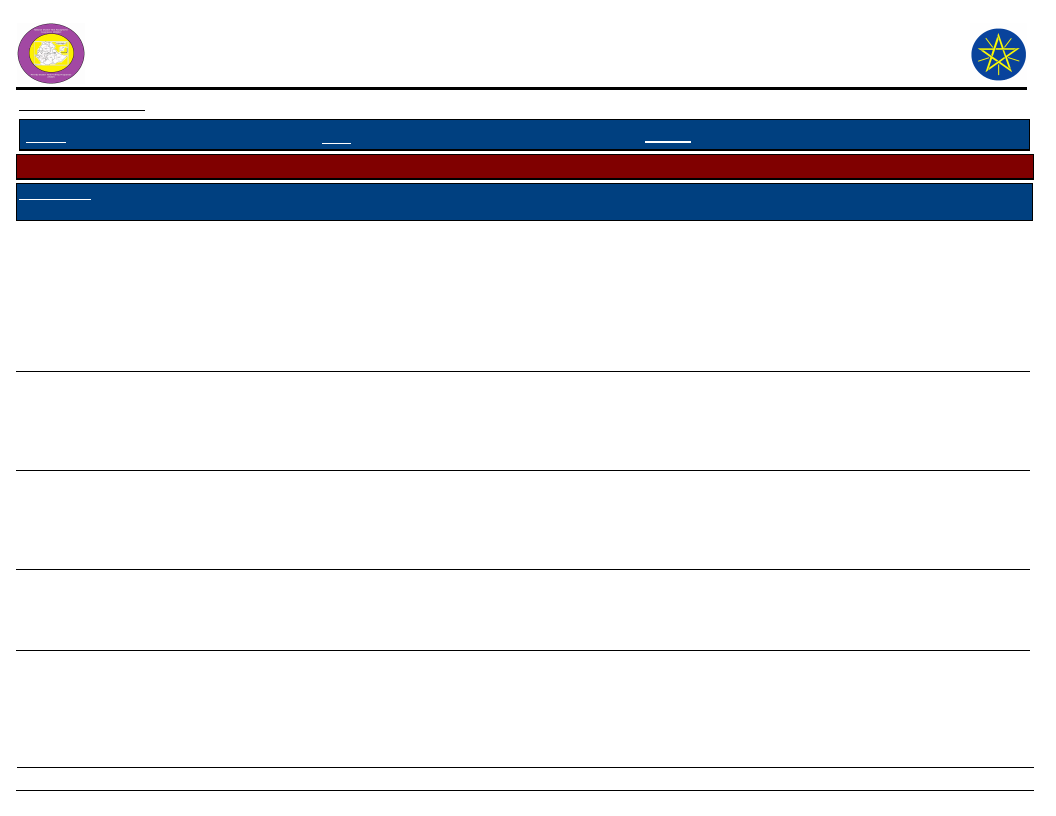
Wereda Disaster
Risk Profile
National Disaster Risk Management
Commission (NDRMC)
Data_Collected_Date
Tuesday, July 9, 2019
Region S.N.N.P
Zone GURAGE
Wereda MESKAN
Selected Indictor:
Kebele Name
BATI LEJANO
Disaster Characteristics By Kebele
Disaster_Type Common Period
Drought
April, May, June
Year
Occured
1996 -
2009
Worst_
Year
1997
Trends of
Effects
Decreased
Root Causes
Erratic rain
fall
Flood
April, May,
June, July
1999 -
2008
1990
Decreased Heavy rain
fall
Crop diseases
August,
September
Livestock
diseases
May, June, July
1990 -
2008
1999 -
2009
2008
2008
Increased
Increased
Transmit
from crop
recede,
climate
change
Transmition
from camel,
shortage of
pasture
Effects
Crop
damage,
death of
livestock,
shortage of
food and
pasture,
malnutrition
Death of
livestock,
damage
crops and
house
Crop
damage,
decreasing
crop
production
Death of
livestock,
skin damage
Vulnerability
Climate change,
depending rain fall
Near to high land
No disease resistant
variety, improper
farming system
Shortage of forage
Coping Strategy
Planting forest tree
Divert the flood way,
making soil bund
Use crop rotation,
spraying chemicals,
pick out the affected
plant
Medial
treatment/veterinar
y service, traditional
treatment
8
Page 2 of 31
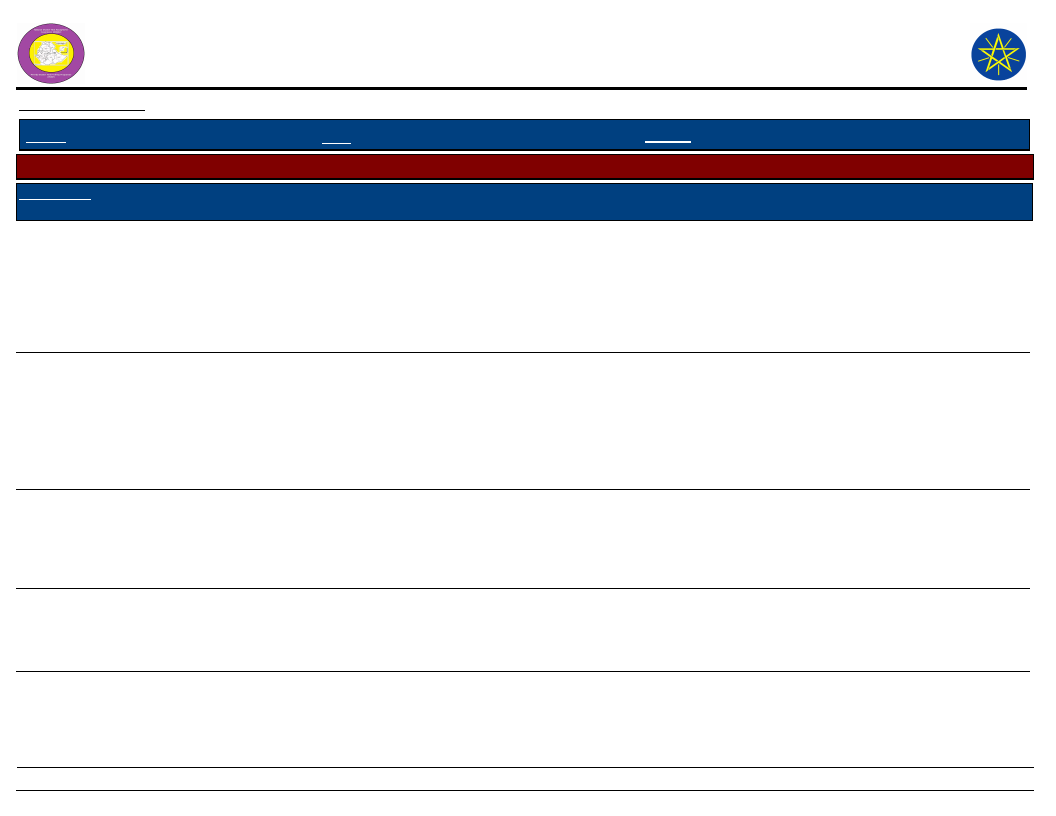
Wereda Disaster
Risk Profile
National Disaster Risk Management
Commission (NDRMC)
Data_Collected_Date
Tuesday, July 9, 2019
Region S.N.N.P
Zone GURAGE
Wereda MESKAN
Selected Indictor:
Kebele Name
BECHE
BULCHANO
Disaster Characteristics By Kebele
Disaster_Type Common Period
Drought
February,
March, April,
May, June, July,
August,
September
Year
Occured
1996 -
2007
Worst_
Year
2007
Trends of
Effects
Increased
Root Causes
Climate
change,
deforestation
Flood
July, August
2005,
2008
Crop diseases May, June, July
2005,
2006,
2007,
2008
Livestock
diseases
October to
August
2005,
2006,
2007,
2008
2008
2008
Increased
Increased
Heavy rain
fall,
fluctuation of
rain fall,
climate
change,
deforestation
Climate
change,
fluctuation of
rain fall
2008
Increased
Climate
change
Effects
Vulnerability
Shortage of
food and
feed, human
and livestock
disease,
shortage of
food
Damage crop
and plat
production,
destruction
of house
Dependent on
seasonal rain fall
Climate change,
drainage problem,
unseasonal rain fall
Loss of yield,
shortage of
food,
economic
crises
Death of
livestock,
loss of
income
Climate change, the
production of less
resistance crop
varieties
Poor veterinary
service, less
management,
climate change
Coping Strategy
Construction of soil
and water,
conservation care of
maintain structures
Drainage, support of
governmental and
NGOs
Shifting crops,
planting resistance
varieties, treatment
of seeds and soil
Medical treatment,
improve feeding
system
9
Page 3 of 31
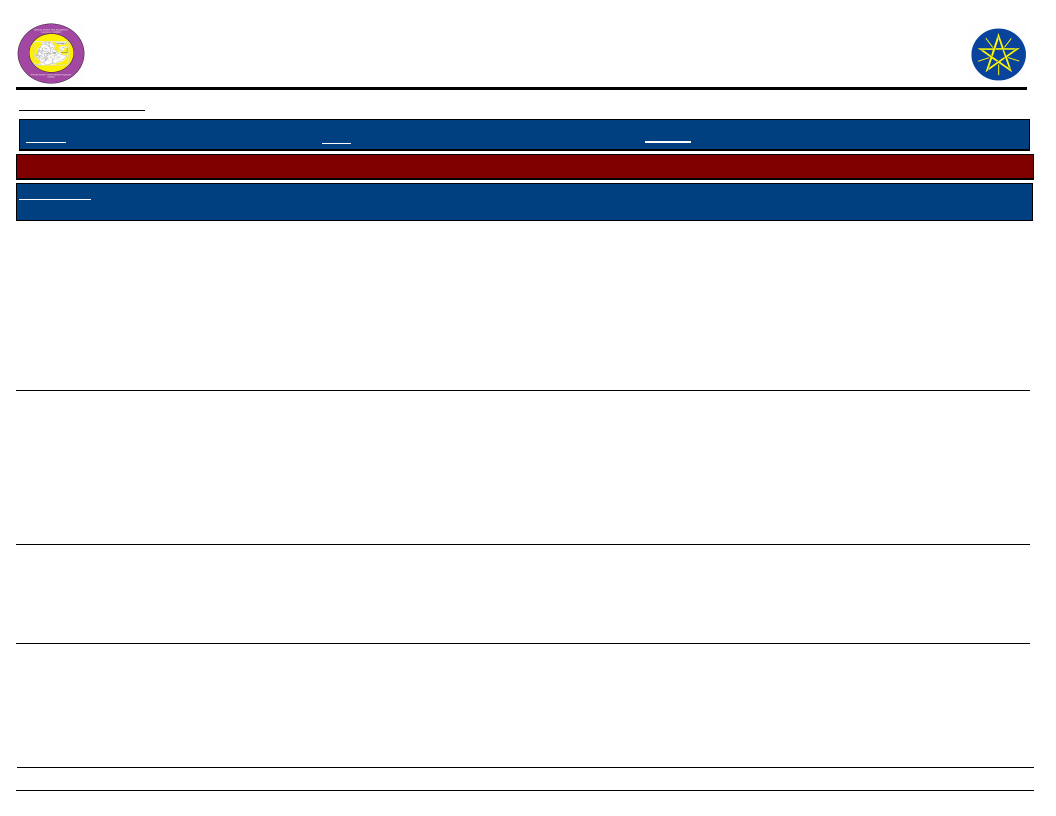
Wereda Disaster
Risk Profile
National Disaster Risk Management
Commission (NDRMC)
Data_Collected_Date
Tuesday, July 9, 2019
Region S.N.N.P
Zone GURAGE
Wereda MESKAN
Selected Indictor:
Kebele Name
BERESA
Disaster Characteristics By Kebele
Disaster_Type Common Period
Drought
May to
September
Year
Occured
1977 -
2008
Worst_
Year
1991
Trends of
Effects
Remained
the same
Root Causes
Erratic rain
fall, climate
change
Flood
March, April,
May, June, July
1992,
2001,
2007,
2008
2008
Increased
Heavy rain
fall,
topography
Livestock
diseases
August,
September,
October
1998 -
2009
2008
Increased
Climate
change,
transmit in
migrate
animals
Effects
Crop
damage,
death of
livestock,
shortage of
human and
livestock
drinking
water
Death of
human, crop
damage,
destruction
house and
loss of asset,
shortage of
food
Death of
livestock,
loss of
livestock
production
Vulnerability
Depending on rain
fall, poor saving
habit
Topography of the
land, unsustainable
soil and water
conservation
There is poor
practice to bring to
veterinary center,
improper for age
use
Coping Strategy
Harvesting water in
cultivated land,
borrowing food items
Relief aid, daily
labor, migration
Medical treatment
10
Page 4 of 31
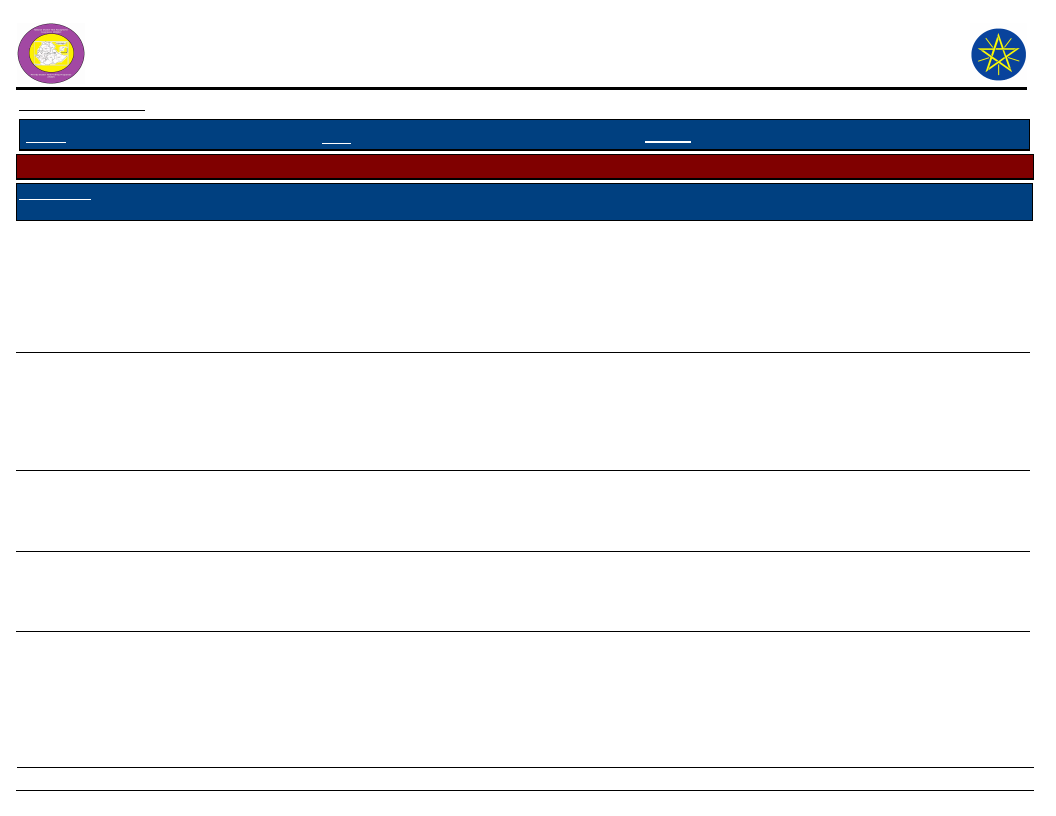
Wereda Disaster
Risk Profile
National Disaster Risk Management
Commission (NDRMC)
Data_Collected_Date
Tuesday, July 9, 2019
Region S.N.N.P
Zone GURAGE
Wereda MESKAN
Selected Indictor:
Kebele Name
DEBO TUTO
Disaster Characteristics By Kebele
Disaster_Type Common Period
Flood
April -
September
Year
Occured
1998 -
2008
Worst_
Year
2008
Trends of
Effects
Increased
Root Causes
Heavy rain
fall,
topography
Drought
May - October
1980 -
2009
2008
Increased
Shortage of
rainfall,
climate
change,
Livestock
diseases
May, June, July,
August,
September
2000 -
2008
Storms / hail
storm
August,
September
1991 -
2003
2008
Decreased
Transmit
from affected
livestock,
2003
Increased
Effects
Vulnerability
Crop
damage,
destruction
of house, loss
of income,
shortage of
food
Crop
damage,
highly
shortage of
water, water
pollution
Death of
livestock,
loss of
livestock
Crop
damage,
destruction
of house
High slope
topography,
deforestation,
unsustainable water
and soil
conservation
No any water
source, using river
and ground water,
erratic rainfall
Climate change
Coping Strategy
Sharing resource,
helping each other,
re planting, improve
saving habit
Water harvesting,
keep moisture of
soil, migration,
replant, daily labor
Using veterinary
treatment
11
Page 5 of 31
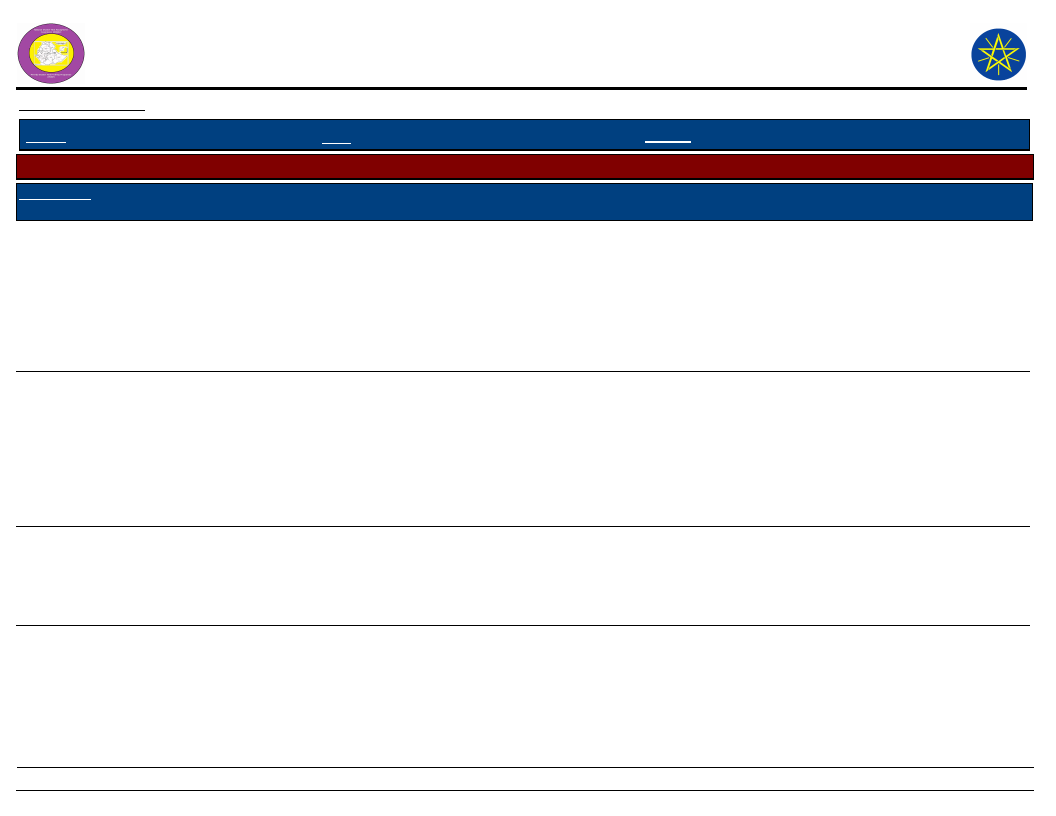
Wereda Disaster
Risk Profile
National Disaster Risk Management
Commission (NDRMC)
Data_Collected_Date
Tuesday, July 9, 2019
Region S.N.N.P
Zone GURAGE
Wereda MESKAN
Selected Indictor:
Kebele Name
DEBUB
SHERSHERA
Disaster Characteristics By Kebele
Disaster_Type Common Period
Drought
March, April,
May, June,
August
Year
Occured
1989,
1997,
2000,
2002,
2003,
Worst_
Year
2007
Trends of
Effects
Increased
Root Causes
Climate
change,
deforestation
Flood
Human
diseases
April, June,
July, August
1988,
1991,
1994,
1998,
2000,
2003,
2008
October,
December,
April, May, July,
August
1991,
2008,
2009
2008
Increased
Unseasonal
and heavy
rain fall,
topography,
sandy soil
type
2008
Increased
Reproduction
of mosquito
bite
Effects
Shortage of
food and
pasture,
human and
livestock
disease,
shortage of
water
Soil erosion,
crop
damage,
destruction
of house and
material,
human
disease
Death of
human, loss
of income,
economic
crises
Vulnerability
Climate change,
type of soil,
depending seasonal
rain fall
Topography, soil
type, climate
change
Not use of bed net,
poor sanitation,
drainage problem
Coping Strategy
Support by
government, relief
food, Safety net,
working for food
Construct soil and
water conservation,
biological controlling
method, flood
diversion
Medial treatment
12
Page 6 of 31
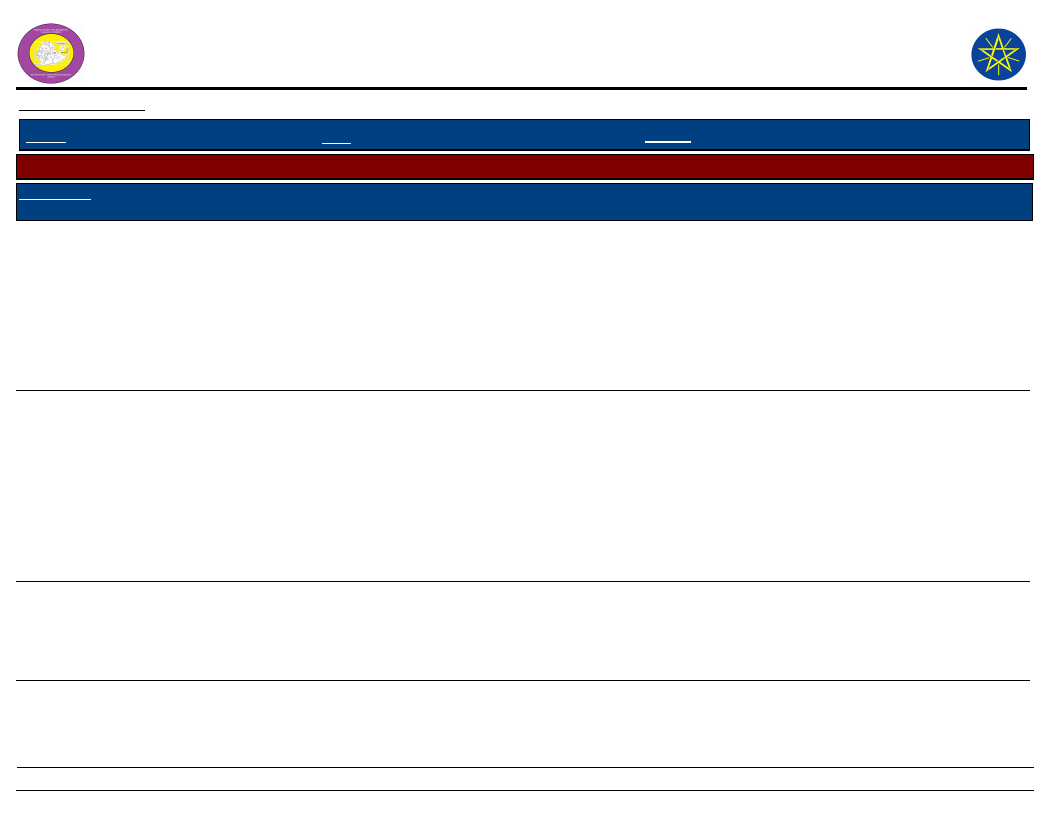
Wereda Disaster
Risk Profile
National Disaster Risk Management
Commission (NDRMC)
Data_Collected_Date
Tuesday, July 9, 2019
Region S.N.N.P
Zone GURAGE
Wereda MESKAN
Selected Indictor:
Kebele Name
DEBUB
SHERSHERA
Disaster Characteristics By Kebele
Disaster_Type Common Period
Livestock
diseases
April, May,
June, July,
August,
September
Year
Occured
1997,
1998,
1999,
2002,
2004,
Worst_
Year
2008
Trends of
Effects
Increased
Root Causes
DEGAGOGOT
Flood
April, May,
June, July
2002,
2008
2002
Decreased
Heavy
rainfall,
climate
change,
deforestation
Frost / Cold
waves
October,
November,
December,
January
2002,
2009
2009
Decreased
Climate
change,
shortage of
rain fall
Effects
Death of
livestock,
decreasing
livestock
production,
loss of
income,
economic
crises
Crop
damage,
water
pollution,
soil erosion,
damage food
items,
damage
livestock
forage
Crop
damage, loss
of livestock
forage, loss
of income
Vulnerability
Less vaccination
and management,
climate change, un
separation of camel
Unsustainable soil
and water
conservation
activities,
deforestation,
incorrect ploughing
system
They are depending
on seasonal rain
fall, cropping type
Coping Strategy
Medical treatment,
borrow oxen each
other, helping each
other
Sharing resource by
helping each other,
re planting, improve
saving habit
Creating income
generating activities,
saving assets, selling
livestock, sowing
early mature crops
13
Page 7 of 31
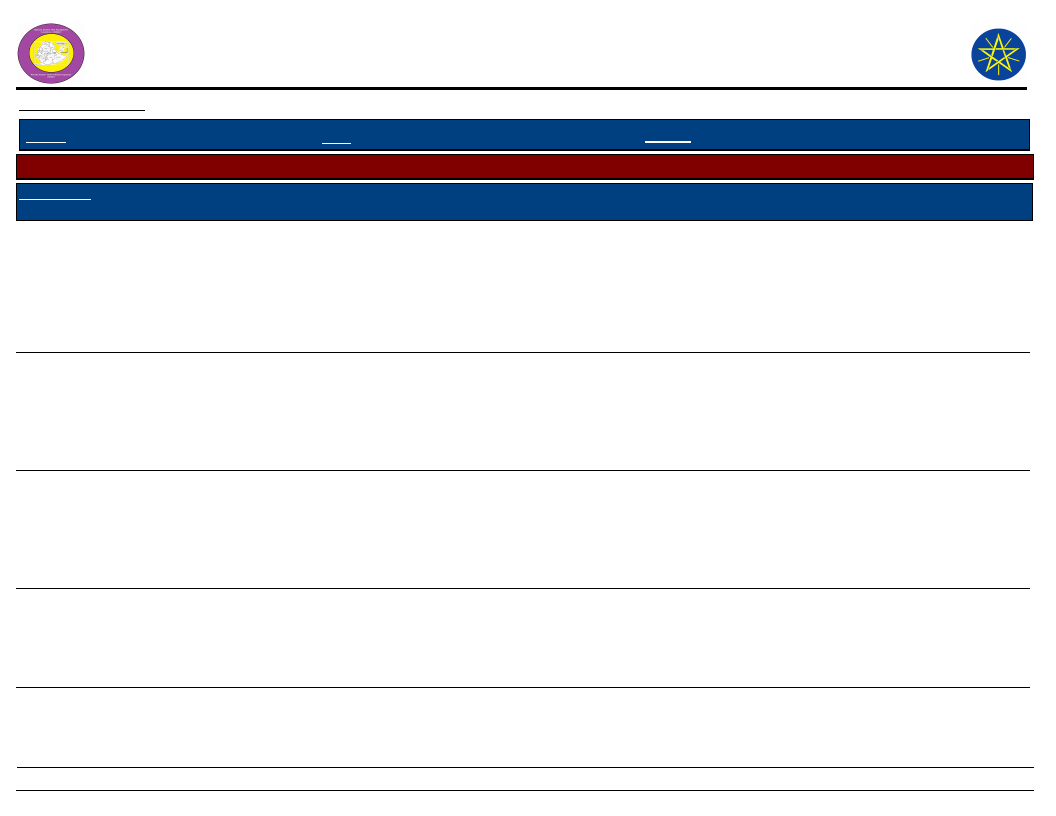
Wereda Disaster
Risk Profile
National Disaster Risk Management
Commission (NDRMC)
Data_Collected_Date
Tuesday, July 9, 2019
Region S.N.N.P
Zone GURAGE
Wereda MESKAN
Selected Indictor:
Kebele Name
DEGAGOGOT
Disaster Characteristics By Kebele
Disaster_Type
Drought
Common Period
Year
Occured
1977,
1997,
2000
Worst_
Year
1977
Trends of
Effects
Decreased
Root Causes
Shortage of
rain fall,
climate
change
DIDA
Drought
April, May,
June, July,
August,
September
Crop diseases
July, August,
September
1997 -
2008
2000 -
2008
2007
2007
Increased
Increased
Shortage of
rain fall,
climate
change,
ecology of
the area
Climate
change
Livestock
diseases
All the year
2005,
2006,
2007,
2008
2008
Increased
Climate
change,
immigration
of camel
Effects
Shortage of
food and
water,
damage
crops, death
of livestock,
migration
Decreased
yield,
shortage of
food and
water
Crop
damage,
decreased
yield,
shortage of
food
Death and
disease of
livestock,
loss of
income
Vulnerability
Depending on rain
fall
Climate change
Climate change,
shortage of
resistant variety of
crops
Climate change,
ecology of the area
Coping Strategy
Decreased number of
animals, migrate to
urban area, re
planting
Government support
by relief, selling
livestock
Support by
government,
treatment for soil
and sowing seed
Vaccination, clinical
treatment
14
Page 8 of 31
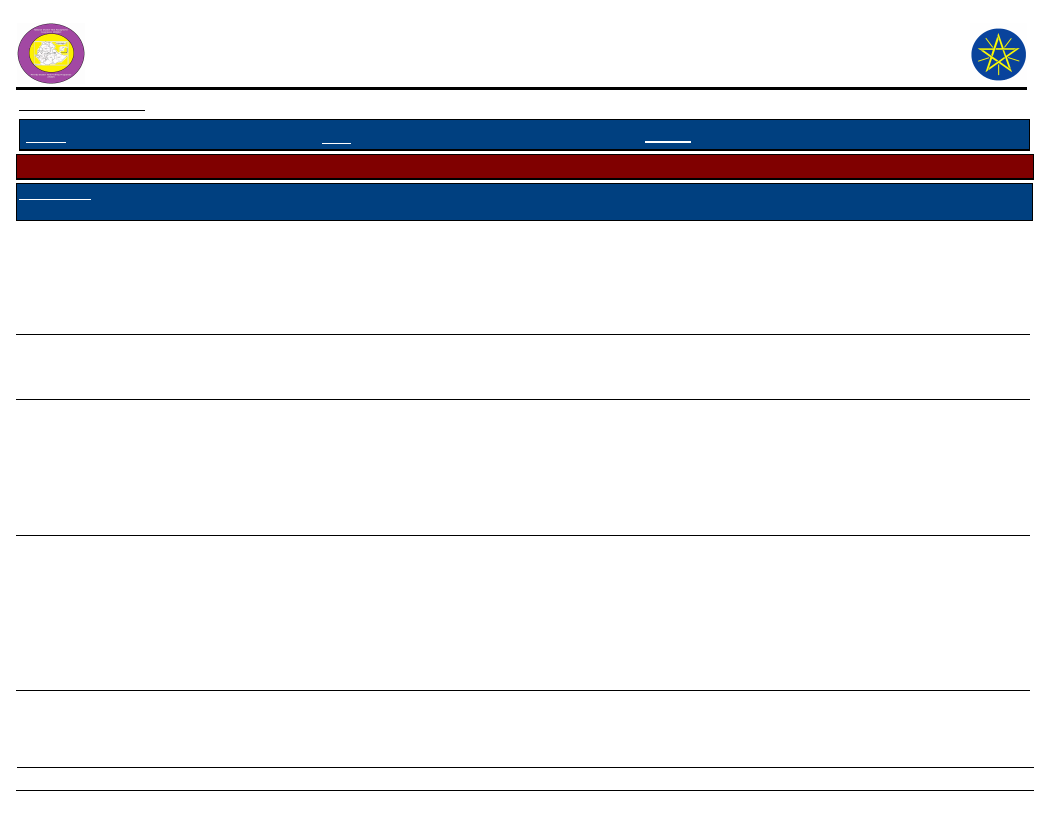
Wereda Disaster
Risk Profile
National Disaster Risk Management
Commission (NDRMC)
Data_Collected_Date
Tuesday, July 9, 2019
Region S.N.N.P
Zone GURAGE
Wereda MESKAN
Selected Indictor:
Kebele Name
DIDA
Disaster Characteristics By Kebele
Disaster_Type Common Period
Flood
July, August
Year
Occured
1997,
1998,
2008
Worst_
Year
2008
Trends of
Effects
Increased
Root Causes
Climate
change
DIRAMA
Frost / Cold
waves
Flood
October,
December,
November
July, August
2005,
2008,
2009
2006,
2007,
2008
2009
Increased
Climate
change
2008
Increased
Climate
change,
heavy rain
fall,
topography
Drought
May, April,
June, September
2003,
2004,
2005,
2006,
2007
2007
Increased
Forest
management,
deforestation
, climate
change,
shortage of
rain fall
Effects
Vulnerability
Damage
crops and
farm land,
crop, human
and livestock
disease
Damage
crops
Climate change,
unconditional heavy
rain fall
Climate change,
crop type
Erosion, crop
damage,
destruction
of house and
asset,
decreasing
soil fertility
Shortage of
food and
water,
damage
livestock,
livestock
disease, loss
of income
Topography, over
grazing,
deforestation, less
maintenance of
structures
Deforestation,
climate change,
ecology of area
Coping Strategy
Diversion of flood,
support by
government, food
and seed aid
Replace by other
crop, job
opportunities
Government and
NGOs support,
helping each other,
shifting plant,
diversion mechanism
Government support,
helping each other
15
Page 9 of 31
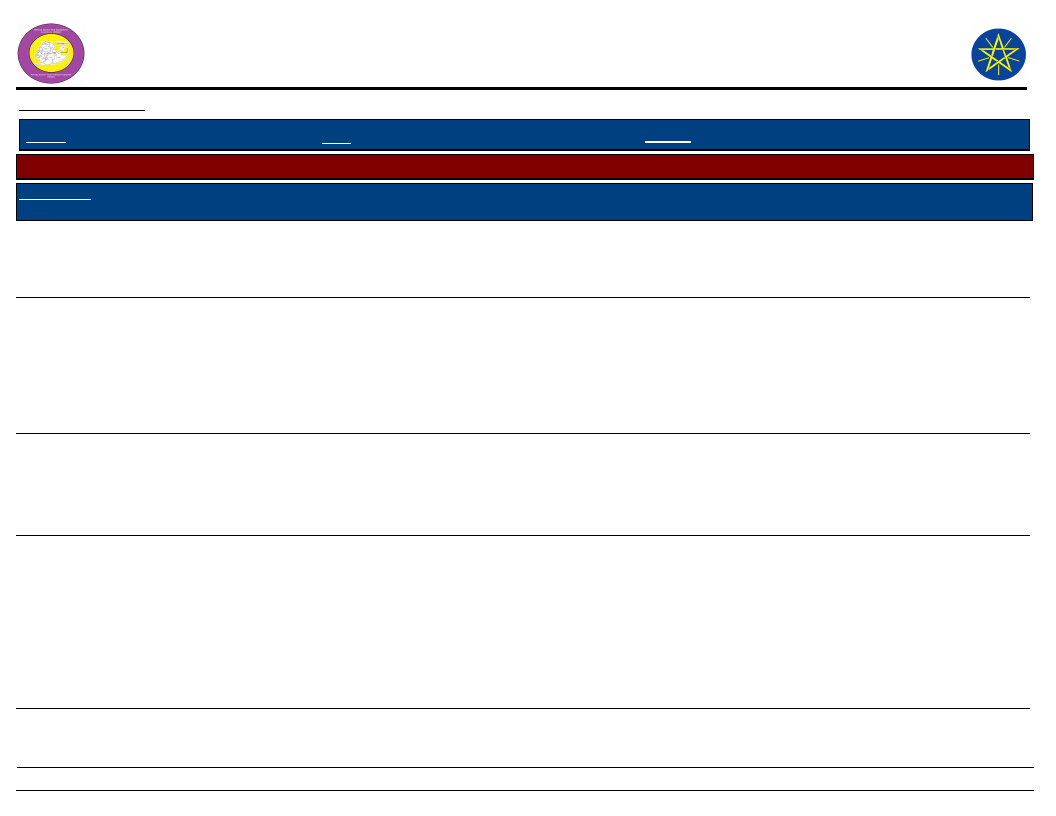
Wereda Disaster
Risk Profile
National Disaster Risk Management
Commission (NDRMC)
Data_Collected_Date
Tuesday, July 9, 2019
Region S.N.N.P
Zone GURAGE
Wereda MESKAN
Selected Indictor:
Kebele Name
DIRAMA
DOBENA
Disaster Characteristics By Kebele
Disaster_Type Common Period
Human
diseases
October,
November, July
Year
Occured
2006,
2007
Worst_
Year
2008
Trends of
Effects
Increased
Root Causes
Stagnant
water,
reproduction
of mosquito
Livestock
diseases
October,
November,
December
2006,
2007,
2008,
2009
2008
Decreased
Immigration
of camel,
poor
veterinary
service,
bacteria and
virus
Drought
April, May,
June, September
1992,
1996,
2005,
2006,
2007
2007
Increased
Crop damage,
deforestation
Flood
May, July,
August
1988,
2000,
2001,
2008
1988
Increased
Conservation
problem,
deformation,
climate
change
Effects
Human
disease, loss
of income
Death and
disease of
livestock
Crop
damage,
yield loss,
shortage of
food
Death of
human and
livestock,
damage crop
production
and
harvested
food, loss of
income
Vulnerability
Stagnant water, not
use of net
Climate change,
immigration of
camel, vaccination
problem
Deforestation, soil
and crop type
Climate change,
topography, soil
type
Coping Strategy
Selling asset,
medical treatment
Medical treatment,
helping each other
by financial
Store human food
and animal feed,
daily labor, relief
from government
Relief, helping each
other, support by
government
16
Page 10 of 31
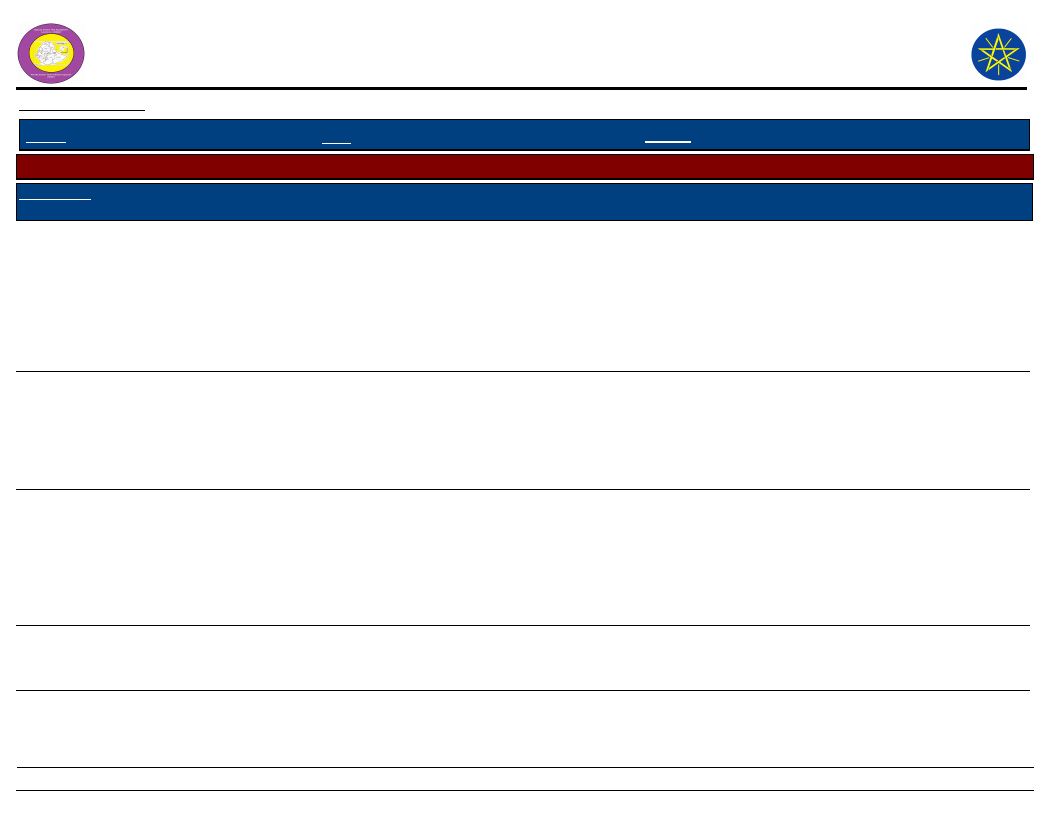
Wereda Disaster
Risk Profile
National Disaster Risk Management
Commission (NDRMC)
Data_Collected_Date
Tuesday, July 9, 2019
Region S.N.N.P
Zone GURAGE
Wereda MESKAN
Selected Indictor:
Kebele Name
DOBENA
Disaster Characteristics By Kebele
Disaster_Type Common Period
Livestock
diseases
January,
February,
March, May,
June, July,
August
Year
Occured
2006,
2007,
2008,
2009
Worst_
Year
2008
Trends of
Effects
Increased
Root Causes
Climate
change, in
migration of
camels
Human
diseases
June, July,
August,
September,
October
2006,
2007,
2008
2008
Increased
Climate
change,
shortage of
food
GIDENA ABORAT
Flood
April, June,
July, August
Frost / Cold
waves
October,
January,
February
1990,
1996,
1997,
2006,
2007,
2008
1997 -
2009
2008
Increased
Heavy rain
fall, no ditch
construction
2009
Increased
Climate
change
Effects
Death and
disease of
livestock,
loss of
income,
problem of
agricultural
activities
Human
disease,
shortage of
food,
economic
crises
Erosion,
decreased
soil fertility,
crop
damage,
destruction
of house
Damage crop
production
Vulnerability
Climate change,
livestock type,
immigration of
camel
Climate change,
shortage of food
and money
Climate change,
topography
Climate change,
ecology, crop type
Coping Strategy
Helping each other,
borrowing animals
Early medical
treatment, first aid
at the local health
post
Government and
NGOs aid, construct
diversion ditch,
supporting by seed,
money and food
Shifting plants
17
Page 11 of 31
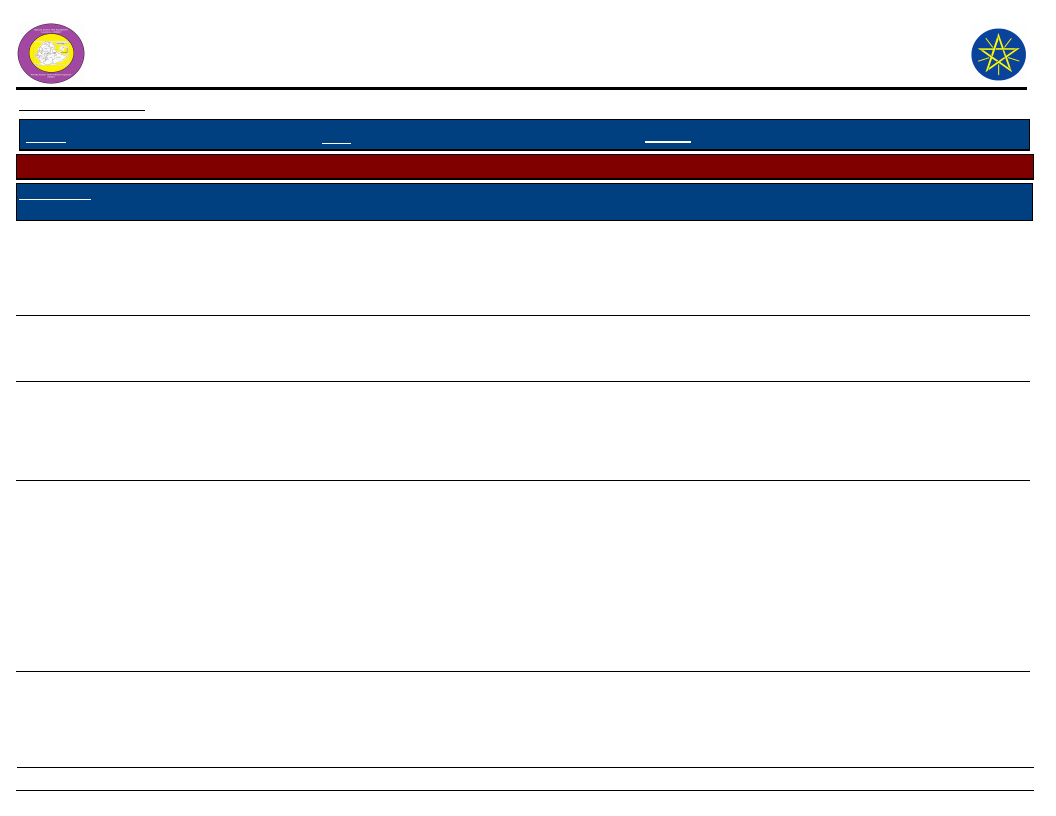
Wereda Disaster
Risk Profile
National Disaster Risk Management
Commission (NDRMC)
Data_Collected_Date
Tuesday, July 9, 2019
Region S.N.N.P
Zone GURAGE
Wereda MESKAN
Selected Indictor:
Kebele Name
GIDENA ABORAT
Disaster Characteristics By Kebele
Disaster_Type Common Period
Livestock
diseases
June, July,
August,
September,
October
Year
Occured
2008
Worst_
Year
2008
Trends of
Effects
Increased
Root Causes
Virus
GOYBAN
Crop diseases
Drought
July, August,
September,
October
April, May,
June, July,
August
Flood
June, July,
August
2008
1997,
2000 -
2007
1998,
2002,
2007
2008
2007
2002
Increased
Increased
Increased
Climate
change,
fungus
Climate
change,
deforestation
, shortage of
rain fall
Climate
change,
deforestation
, poor
ploughing
system,
heavy rainfall
Effects
Vulnerability
Death and
disease of
livestock,
loss of
income
Loss of yield,
economic
crises
Decreased
yield,
shortage of
water, loss
of income
Crop
damage, soil
erosion,
water
pollution,
damage
livestock
forage,
shortage of
food
Vaccination
problem,
immigration of
camel
Depending on
seasonal rainfall,
climate change
Deforestation,
climate change,
Depending on rain
fall, shortage of
irrigation access
Deforestation,
incorrect ploughing
system, low
participation in soil
and water
conservation
activities
Coping Strategy
Medical treatment,
helping each other
financial, borrowing
oxen
Shifting, soil and
seed treatment
Supported by
government, helping
each other, saving
food and asset
Soil and water
conservation, cut of
drainage,
forestation, daily
labor
18
Page 12 of 31
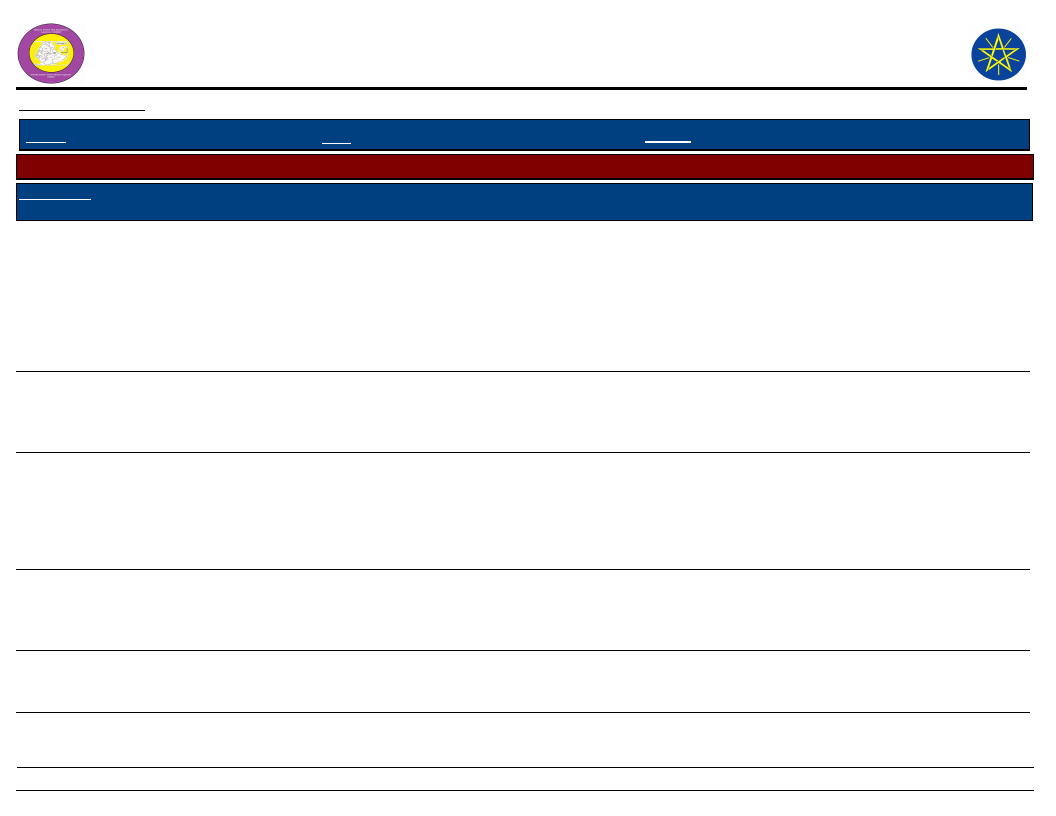
Wereda Disaster
Risk Profile
National Disaster Risk Management
Commission (NDRMC)
Data_Collected_Date
Tuesday, July 9, 2019
Region S.N.N.P
Zone GURAGE
Wereda MESKAN
Selected Indictor:
Kebele Name
GOYBAN
Disaster Characteristics By Kebele
Disaster_Type Common Period
Drought
January - August
Year
Occured
1977,
1997,
2000,
2008
Worst_
Year
1997
Trends of
Effects
Decreased
Root Causes
Climate
change,
shortage of
rain fall
Snow
September
2006
Decreased Climate
change
Effects
Vulnerability
Shortage of
food,
shortage of
water, crop
damage,
death of
livestock,
migration
Crop damage
Deforestation,
depending on
seasonal rain fall,
unused drought
resistant variety
Ecological condition
of the area
ILE
Flood
January - July
1997 -
1997
Decreased Heavy rain
Crop
Topography, un
2008
fall, high
damage,
sustainable soil and
sloppy,
destruction
water conservation,
deforestation of house,
deforestation
death of
livestock
Drought
March, April,
May, June, July,
August
1997,
2002 -
2008
1997
Decreased Erratic rain
fall
Crop
damage,
shortage of
food
Deforestation,
climate change
Livestock
diseases
March, April
2007,
2008
2008
Increased
Transmit
from camel
Death and
disease of
livestock
Livestock type,
transmit from in
migrate camels
Coping Strategy
Selling livestock,
daily labor,
migration, replanting
Re-cover cultivated
land by other crops,
helping each other
by sharing resource
Sharing resource,
make drainage soil
bund, replanting,
improve saving habit
Forestation,
replanting, water
harvesting, decrease
number of livestock
Traditional
treatment and
medical treatment
19
Page 13 of 31

Wereda Disaster
Risk Profile
National Disaster Risk Management
Commission (NDRMC)
Data_Collected_Date
Tuesday, July 9, 2019
Region S.N.N.P
Zone GURAGE
Wereda MESKAN
Selected Indictor:
Kebele Name
ILE
INSENO USME
Disaster Characteristics By Kebele
Disaster_Type Common Period
Crop diseases
April, may,
June, July,
August,
September
Year
Occured
1997 -
2008
Worst_
Year
2002
Trends of
Effects
Increased
Root Causes
Climate
change, no
crop rotation
Drought
April, May,
June, July,
August,
September
1990 -
2004
1991
Decreased
Climate
change,
erratic rain
fall
Livestock
diseases
May to June
1995 -
2009
2008
Increased
Consequence
of green grass
Flood
June - August
2000 -
2008
2008
Increased
High rain fall,
climate
change
Effects
Less
productivity,
crop damage
Crop
damage,
livestock
death,
malnutrition
of yields loss
Death of of
livestock,
affects
animal
health,
shortage of
food, loss of
productivity
Crop
damage,
human
disease, soil
erosion
Vulnerability
No resistant variety
Hot sop area,
decreasing rain fall
Species of livestock
Deforestation,
unsustainable soil
and water
conservation
Coping Strategy
Forestation, uses of
irrigation, water
harvesting activity
Using medical and
traditional treatment
Soil bund, water
drainage ditch
20
Page 14 of 31
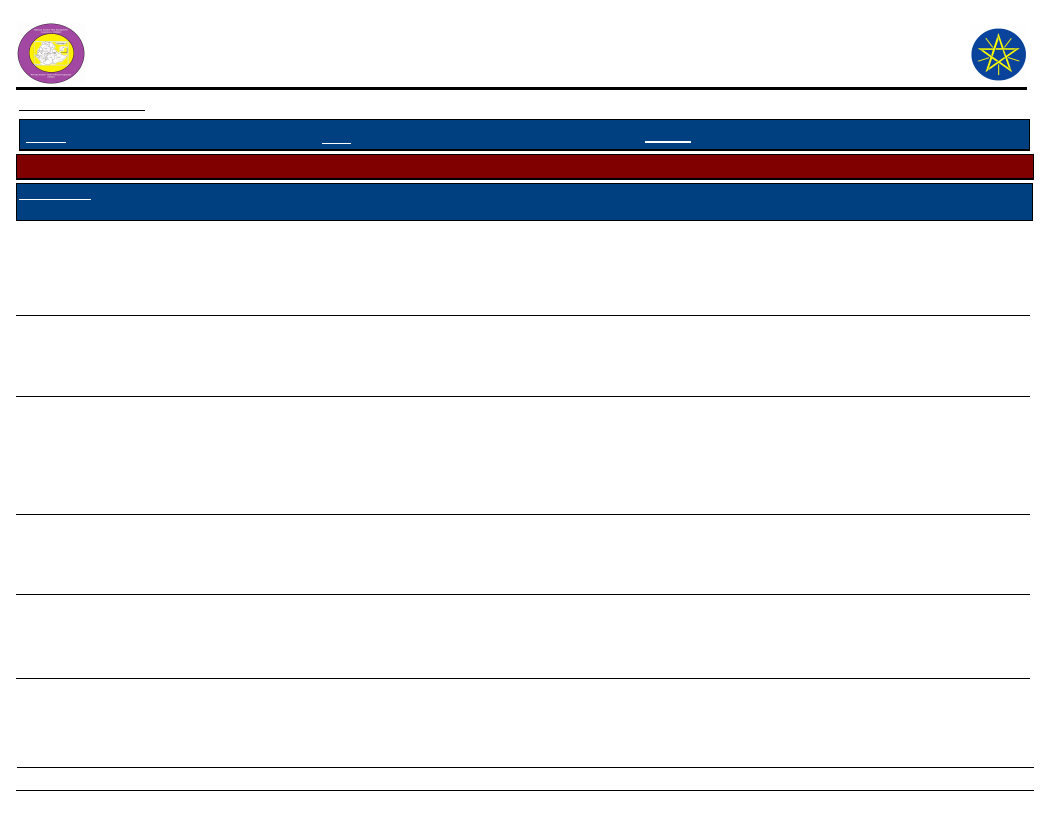
Wereda Disaster
Risk Profile
National Disaster Risk Management
Commission (NDRMC)
Data_Collected_Date
Tuesday, July 9, 2019
Region S.N.N.P
Zone GURAGE
Wereda MESKAN
Selected Indictor:
Kebele Name
INSENO USME
Disaster Characteristics By Kebele
Disaster_Type Common Period
Crop diseases
August,
September,
October,
November
Year
Occured
1994 -
2008
Worst_
Year
2008
Trends of
Effects
Increased
Root Causes
Climate
change, poor
crop rotation
Frost / Cold
waves
October,
November
2005
-2009
2009
Increased
Climate
change
JOLE ANDENYA
Flood
May
2007,
2008
2008
Increased
Heavy rain
fall
Drought
August
Livestock
diseases
September
2006,
2007,
2008
2008
Decreased Shortage of
rain fall
2006,
2007,
2008 ,
2009
2009
Decreased
Immigration
of camel,
climate
change
Effects
Crop
damage, loss
of yield,
shortage of
food
Crop and
venerable
damage, loss
of yield
Crop
damage, loss
of income
Crop
damage,
death of
livestock
Death of
livestock,
loss of
income
Vulnerability
No resistant variety,
let sowing
Deforestation,
unsustainable water
and soil
conservation, un
proper farming
practice
Rainfall depending,
deforestation
Disease transmit
from camel
Coping Strategy
Spray chemicals, pull
out the effected
plant
Make plastic fence
Construction of soil
and stone bund, cut
of drain
Water harvesting, in
the pond and in the
cultivated land
Medial and
traditional treatment
21
Page 15 of 31
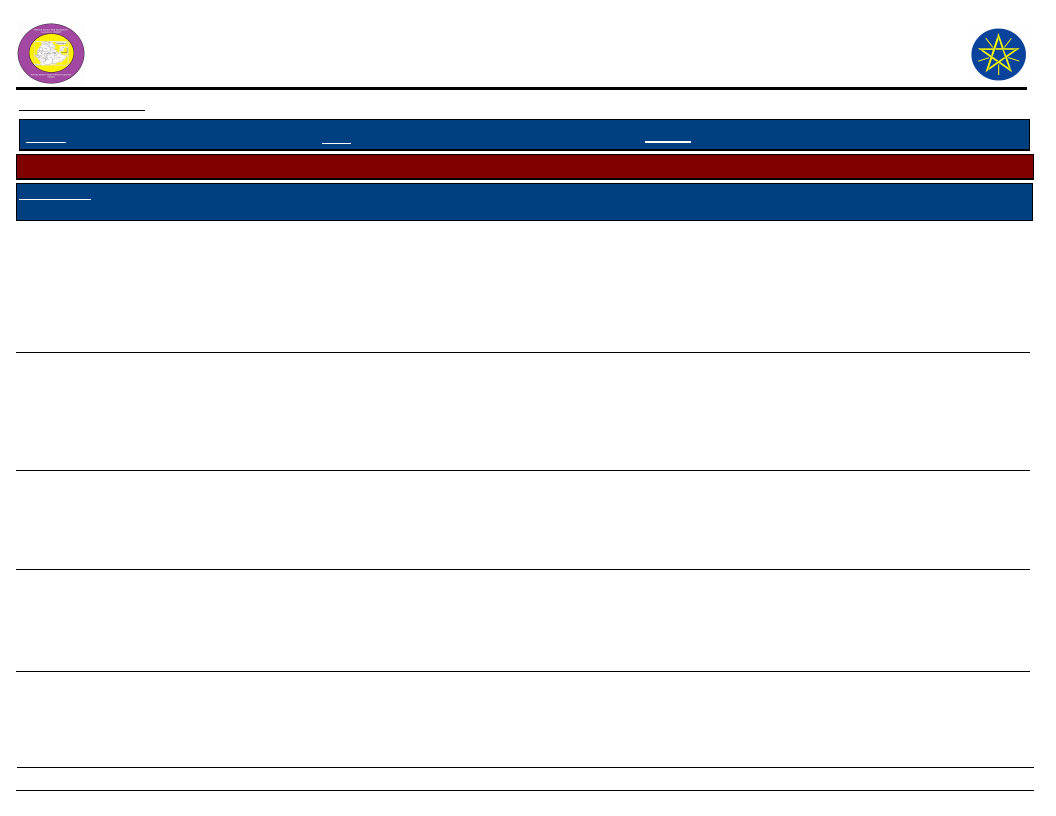
Wereda Disaster
Risk Profile
National Disaster Risk Management
Commission (NDRMC)
Data_Collected_Date
Tuesday, July 9, 2019
Region S.N.N.P
Zone GURAGE
Wereda MESKAN
Selected Indictor:
Kebele Name
JOLE HULETENYA
Disaster Characteristics By Kebele
Disaster_Type Common Period
Flood
April, July,
August,
September
Year
Occured
2004 -
2008
Worst_
Year
2008
Trends of
Effects
Increased
Root Causes
Climate
change,
heavy rain
fall,
topography of
land
Frost / Cold
waves
October,
December,
November
2008
2009
Increased
Climate
change
Drought
Livestock
diseases
May, June, July
1977,
2005,
2006,
2007
All months
2002,
2006,
2007,
2008,
2009
2007
2008
Increased
Increased
Climate
change,
deforestation
, shortage of
rain fall
Bacterial and
virus
Effects
Damage crop
and farm
land, loss of
yield,
shortage of
food and
feed
Damage
crop,
shortage of
food,
economic
crises
Low
productivity,
yield loss,
shortage of
food
Death and
disease of
livestock,
economic
loss
Vulnerability
Topography of the
ground, Meki river
Climate change,
crop type,
dependent of rain
Climate change,
deforestation
Climate change, in
migration of camel
Coping Strategy
Government aid,
helping each other,
shifting plants
Shifting crops
Need government
help, food relief,
helping each other
Early clinical
treatment, helping
ach other by finance
and agricultural work
activities
22
Page 16 of 31
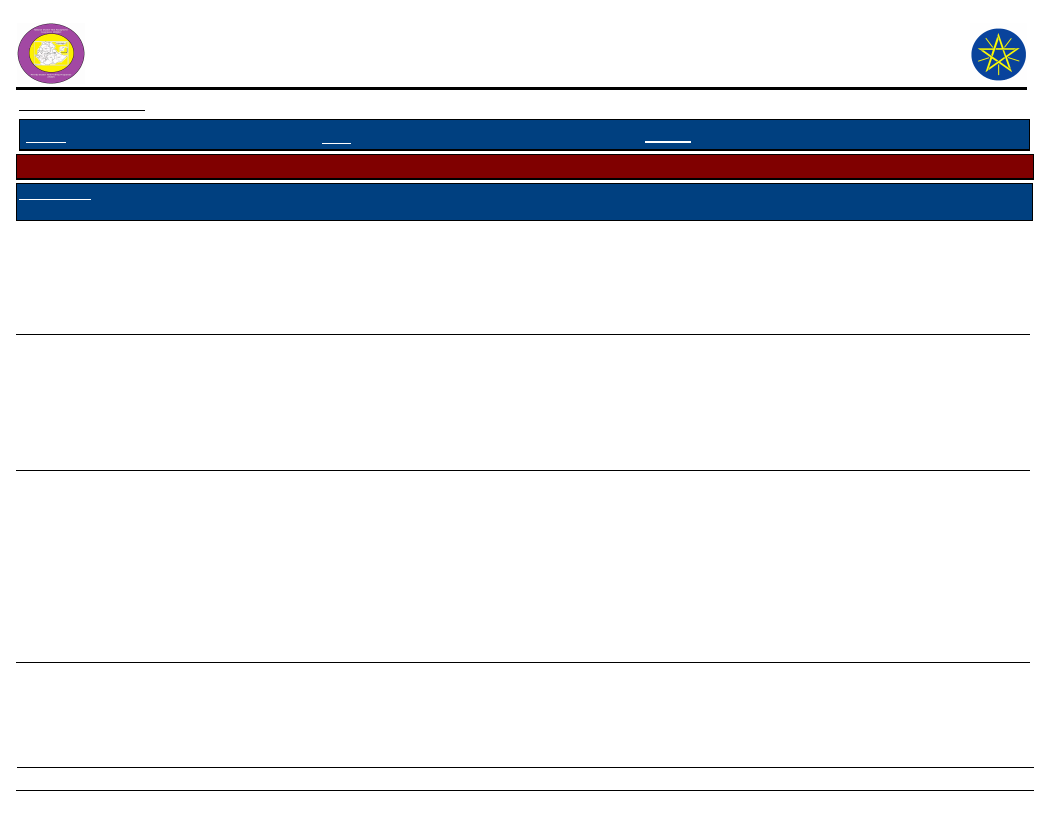
Wereda Disaster
Risk Profile
National Disaster Risk Management
Commission (NDRMC)
Data_Collected_Date
Tuesday, July 9, 2019
Region S.N.N.P
Zone GURAGE
Wereda MESKAN
Selected Indictor:
Kebele Name
JOLE HULETENYA
MEKICHO
Disaster Characteristics By Kebele
Disaster_Type Common Period
Human
diseases
May, June, July,
August
Year
Occured
2007,
2008
Worst_
Year
2008
Trends of
Effects
Increased
Drought
March, April,
May, June,
September
1977,
1991,
2000 -
2007
2002
Increased
Root Causes
Flood,
climate
change,
drought ,
reproduction
of mosquito
Climate
exchange,
deforestation
, shortage of
rain fall
Flood
March, April,
July, August
1991,
1993,
1997,
2001,
2004,
2008
2008
Increased
Heavy rain
fall, climate
change,
deforestation
, topography
Effects
Human
disease, loss
of economic
and time
Food
shortage,
water
scarcity, loss
of yield,
human
disease
Destruction
of house,
damage crop
and farm
land, human
disease,
shortage of
food,
erosion, less
production
Vulnerability
Flood, climate
change, drought
Climate change,
shortage of water
access
Climate change,
topography, soil
type
Coping Strategy
Medical treatment,
selling asset
Helped each other,
shifting plants,
selling asset
Support by
government, helping
another, resisted by
eating Kocho
23
Page 17 of 31
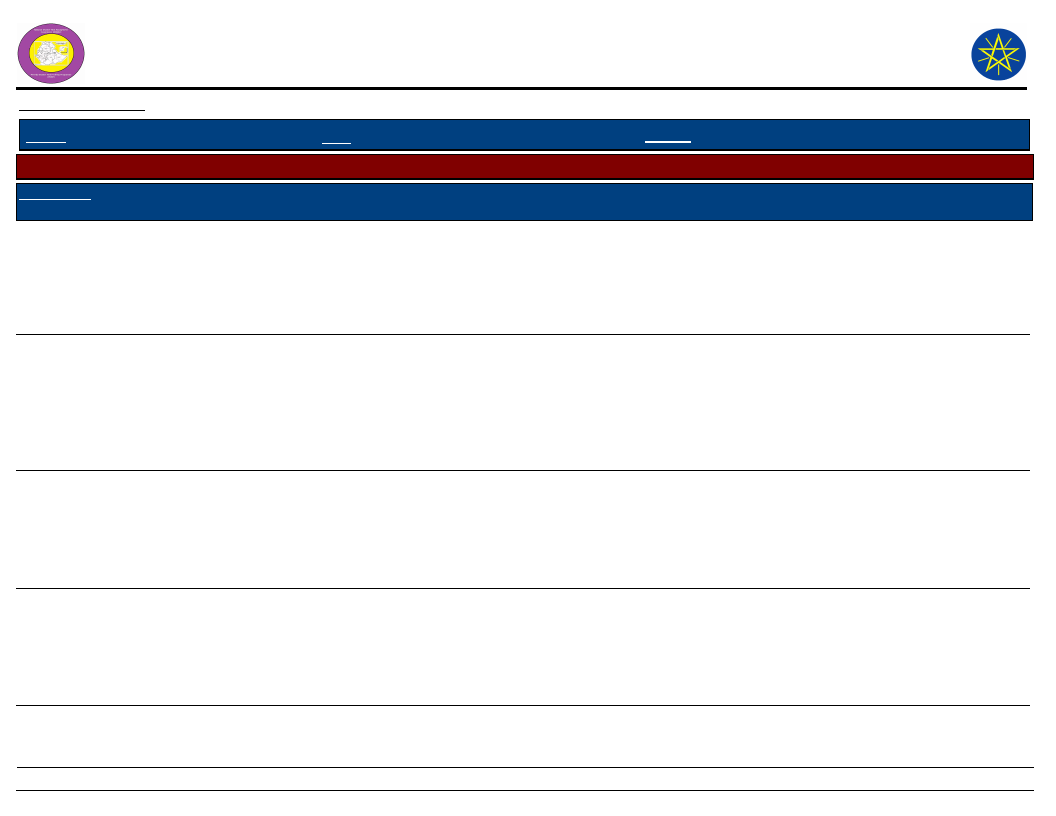
Wereda Disaster
Risk Profile
National Disaster Risk Management
Commission (NDRMC)
Data_Collected_Date
Tuesday, July 9, 2019
Region S.N.N.P
Zone GURAGE
Wereda MESKAN
Selected Indictor:
Kebele Name
MEKICHO
Disaster Characteristics By Kebele
Disaster_Type Common Period
Frost / Cold
waves
October,
January,
February
Year
Occured
1985,
1996,
2009
Worst_
Year
2009
Trends of
Effects
Increased
Root Causes
Climate
change
Livestock
diseases
July, August,
September,
October
2008,
2009
2009
Increased Virus
MESERETEWEGER
AMO
Flood
April, May,
June, July,
August
2006 -
2008
2008
Increased High rain fall
Livestock
diseases
June - January
2000 -
2009
2008
Increased
No resistant
variety of
livestock,
virus and
bacteria
Effects
Damage crop
production,
loss of
production,
shortage of
food
Death and
disease of
livestock,
loss of
income, loss
of livestock
production
Crop
damage,
damage
house and
asset, death
of livestock
Death of
livestock,
less milk and
peat
production
activity
Vulnerability
Climate change,
deforestation
Immigration of
camels, climate
change
Sloppy topography
No resistant
Coping Strategy
Shifting plants,
selling asset to buy
food, cover crops.
Medical treatment,
helping each other,
borrowing money
Soil bund, make
drought ditch
Medical and
traditional treatment
24
Page 18 of 31
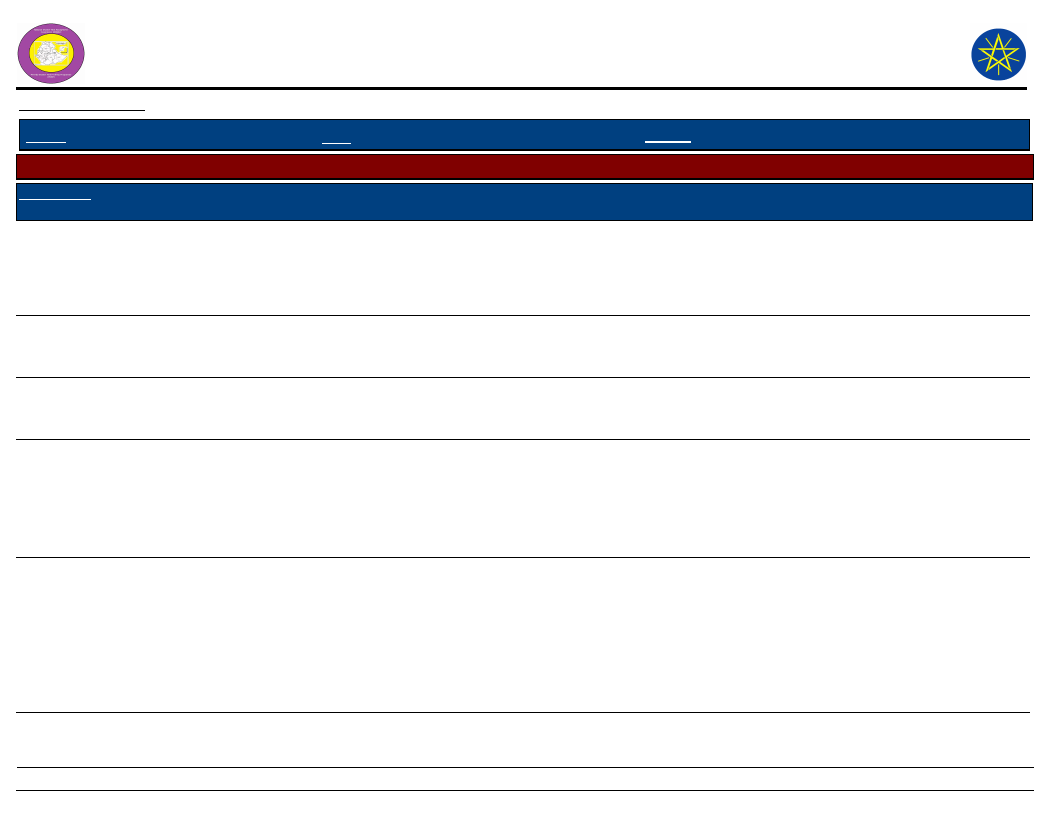
Wereda Disaster
Risk Profile
National Disaster Risk Management
Commission (NDRMC)
Data_Collected_Date
Tuesday, July 9, 2019
Region S.N.N.P
Zone GURAGE
Wereda MESKAN
Selected Indictor:
Kebele Name
MESERETEWEGER
AMO
Disaster Characteristics By Kebele
Disaster_Type Common Period
Landslide
April -
September
Year
Occured
1992,
1997,
2008
Worst_
Year
2008
Trends of
Effects
Increased
Root Causes
High rain fall,
flood
MIKAELO
Storms / hail
storm
April, May, June
2003
Crop diseases February - June
2003
Decreased High wind
and rain fall
1977
Decreased No resistant
verity seeds
Flood
March -
September
2000 -
2008
2004
Increased
Heavy rain
fall,
topography,
road
construction
Frost / Cold
waves
October,
November,
December,
January
2000 -
2009
2009
Increased
Climate
change
Effects
Vulnerability
Destruction
of house,
damage farm
land, crop
damage
Death of
human and
livestock
Crop
damage, loss
of yield
Crop
damage,
house
destruction
Damage
animal
annual crop,
vegetable,
change,
Enset, coffee
and fruit
damage
high topography
High topography
No resistance
variety
Deforestation,
unsustainable water
and soil
conservation,
improper farming
system
No frost resistant
variety, hey re
depending on rain
fall, cropping type
Coping Strategy
Drainage ditch
Out metal shed in
surrounding of house
Sowing efficient
plant/Enset
Constructing of soil
bund, make drainage
ditch
25
Page 19 of 31
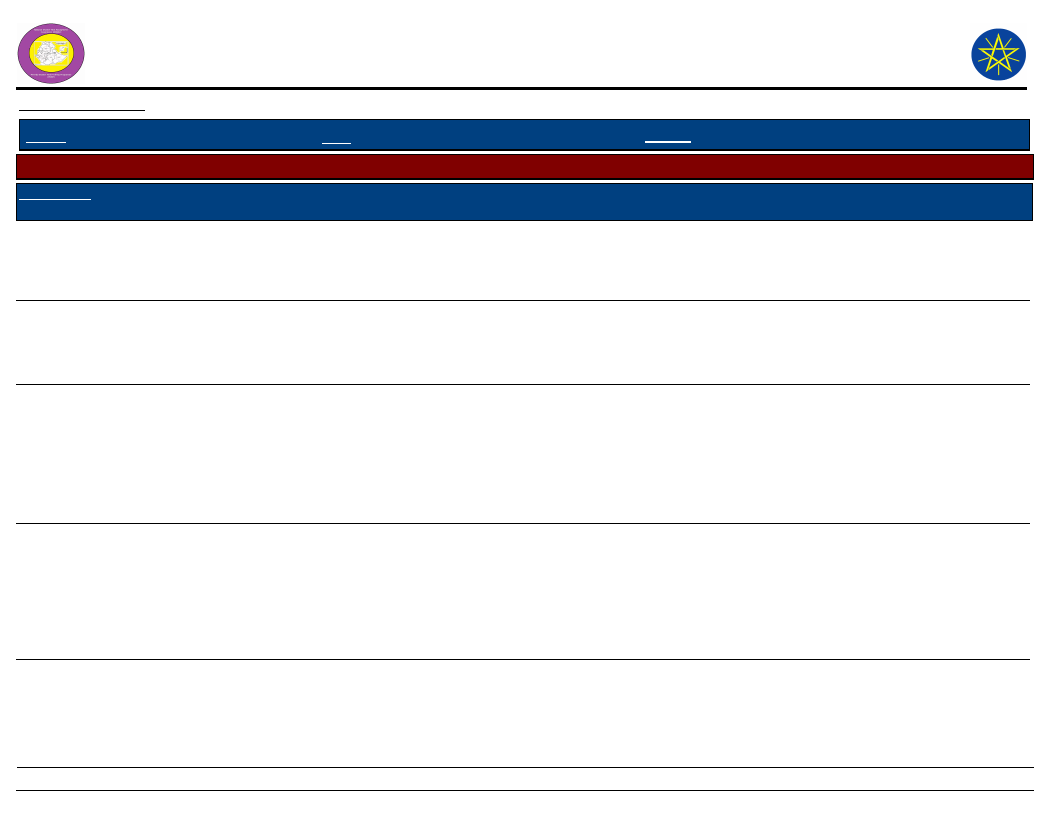
Wereda Disaster
Risk Profile
National Disaster Risk Management
Commission (NDRMC)
Data_Collected_Date
Tuesday, July 9, 2019
Region S.N.N.P
Zone GURAGE
Wereda MESKAN
Selected Indictor:
Kebele Name
MIKAELO
MIRAB IMBOR
Disaster Characteristics By Kebele
Disaster_Type Common Period
Livestock
diseases
March, April,
May, June, July,
August,
September
Year
Occured
2004 -
2009
Worst_
Year
2008
Trends of
Effects
Increased
Crop diseases
August,
September,
October,
November
2001 -
2009
2008
Increased
Flood
June, July,
August, April,
May
1996,
2000,
2001,
2002,
2003,
2004,
2008
2008
Increased
Drought
April, May,
June, September
1977,
1992,
1994,
1997,
2002,
2007
Increased
Root Causes
Transmit
from camels
and other
animals
Climate
change, poor
crop variety
Unconditional
rain, health
rain fall,
topography
Deforestation
, shortage of
forestation,
climate
change,
shortage of
rain fall
Effects
Death and
disease of
livestock
Vulnerability
Problem of
vaccination
Affected
productivity
and crop
damage
Soil erosion,
distributed
mange crops,
decrease soil
fertility,
decreased
productivity
Topography,
deforestation,
problem of
maintenance of
structures
Shortage of
food, disease
of livestock
and human,
shortage of
food
Climate change,
deforestation,
depending on rain
fall
Coping Strategy
Vaccination and
medical treatment
Chemical spray, pick
up the infected
plants
Support by
government,
employment saved
food, shifting
Dig deep under
ground water,
harvest enset
production, planting
early grow plant
26
Page 20 of 31
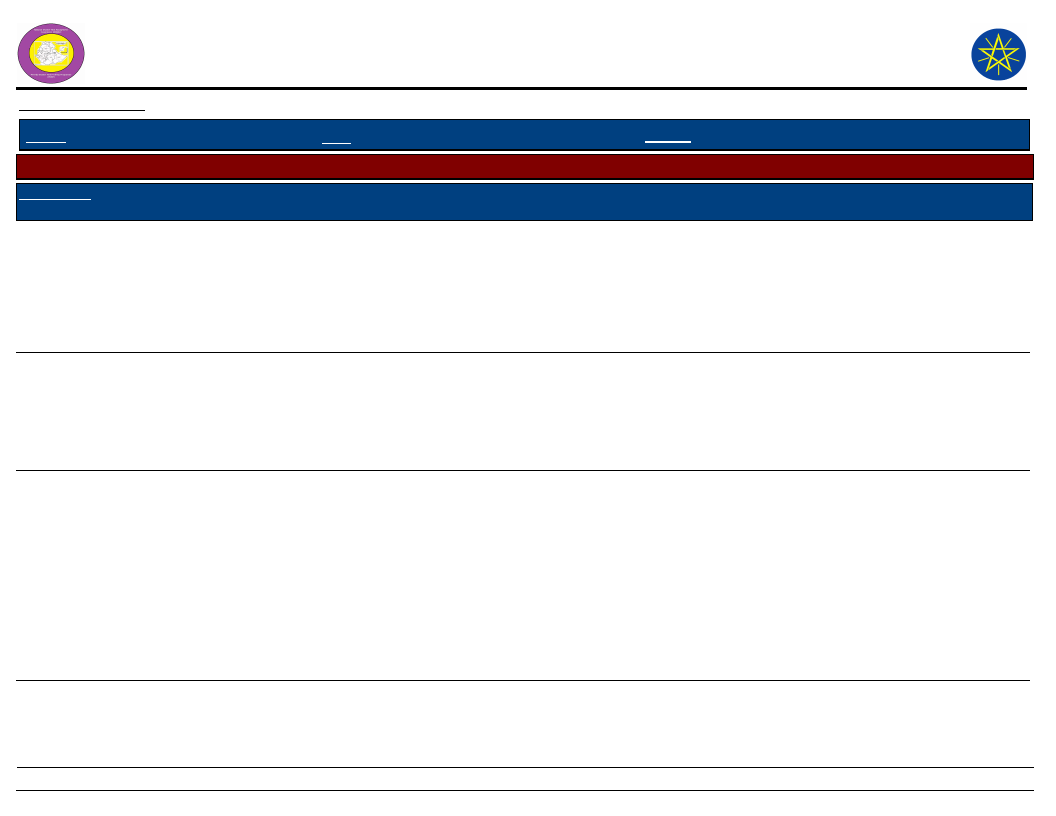
Wereda Disaster
Risk Profile
National Disaster Risk Management
Commission (NDRMC)
Data_Collected_Date
Tuesday, July 9, 2019
Region S.N.N.P
Zone GURAGE
Wereda MESKAN
Selected Indictor:
Kebele Name
MIRAB IMBOR
Disaster Characteristics By Kebele
Disaster_Type Common Period
Frost / Cold
waves
October,
November,
January
Year
Occured
2009
Worst_
Year
2009
Trends of
Effects
Increased
Root Causes
Climate
change
Livestock
diseases
June, July,
August,
September,
October
MIRAB MESKAN
Flood
June, July,
August,
September
2007,
2008
1992,
1996,
2004,
2008
2008
Increased
Immigration
of camel,
climate
change, poor
vaccination
2008
Increased
Unconditional
heavy rain
fall, climate
change,
topography
Effects
Vulnerability
Damage crop
production,
damage
human and
livestock,
shortage of
food
Death of
livestock,
decreasing
production,
loss of
income
Destruction
of house,
death of
livestock,
soil erosion,
damage
construction,
loss of
production,
loss of
income
Climate change,
planting sensitive
plants
Vaccinating
problem, climate
change, depending
livestock production
Topography
Coping Strategy
Smoking and
fumigation of
different plant leaf,
fever vegetables by
straw and leaf of
plants
Early treatment,
helping each other
by Edir
Ask government and
NGOs help, helping
each other, shifting
crops, eating enset
27
Page 21 of 31
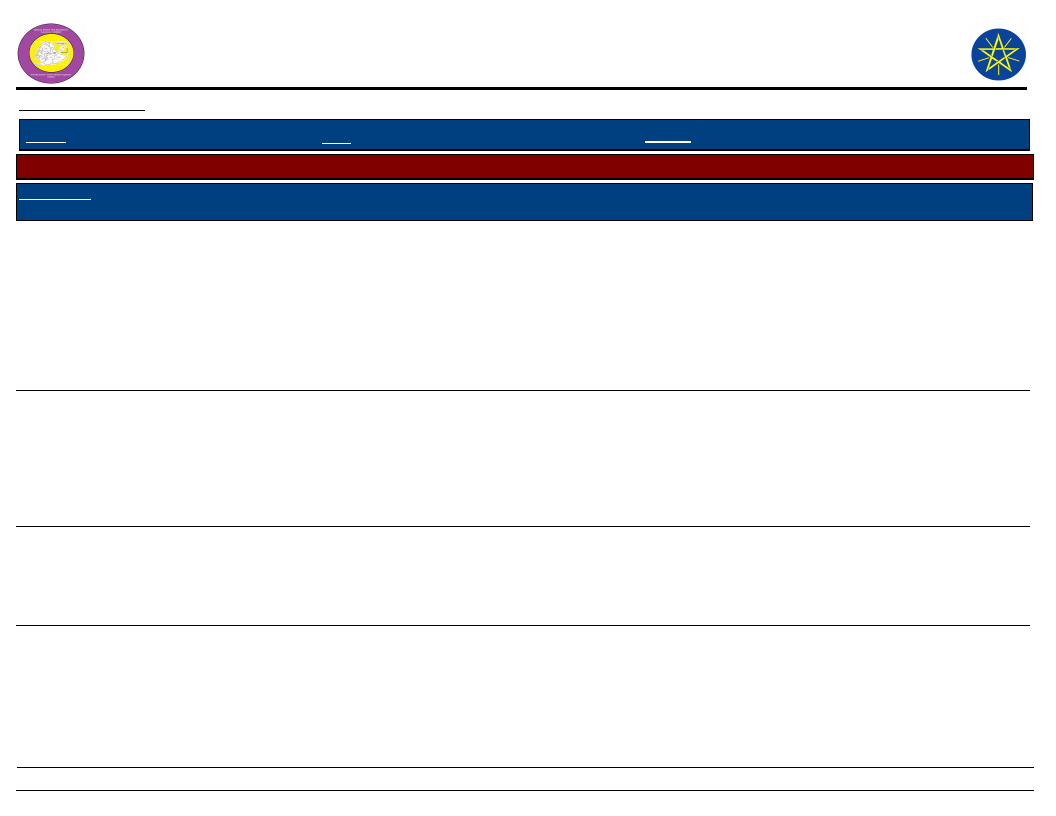
Wereda Disaster
Risk Profile
National Disaster Risk Management
Commission (NDRMC)
Data_Collected_Date
Tuesday, July 9, 2019
Region S.N.N.P
Zone GURAGE
Wereda MESKAN
Selected Indictor:
Kebele Name
MIRAB MESKAN
Disaster Characteristics By Kebele
Disaster_Type Common Period
Drought
March, April,
May, June,
September
Year
Occured
1977,
1987,
1997,
2003,
2006,
2007
Worst_
Year
2007
Trends of
Effects
Increased
Root Causes
Climate
change,
deforestation
, shortage of
rain fall
Frost / Cold
waves
January,
October
2009,
2009
2009
Increased
Climate
change
Human
diseases
Livestock
diseases
September, July
1977,
2002,
2008
June, July,
August,
September
2008
2008
Increased
Shortage of
clan water,
stagnant
water
2008
Increased
Immigration
of camels,
shortage of
pre
treatment/va
ccination
Effects
Vulnerability
Shortage of
food and
feed,
fluctuating of
time of
plating,
human and
livestock
disease
Damage
crops/enset,
chat, fruit,
coffee/,
damage
livestock and
production
Human
health crisis,
loss of of
time and
income
Death of
livestock,
loss of
production,
loss of
income
Depending on
seasonal rain fall,
irrigation water
problem
Climate change,
deforestation
Harvested water,
mosquito
Immigration of
camels, shortage of
pre
treatment/vaccinati
on
Coping Strategy
Cultivate drought
resistant
crops,/Enset, saving
food and feed
Replace by other
crops
Medial treatment,
drainage, using net
Medial treatment,
helping each other
by finance
28
Page 22 of 31
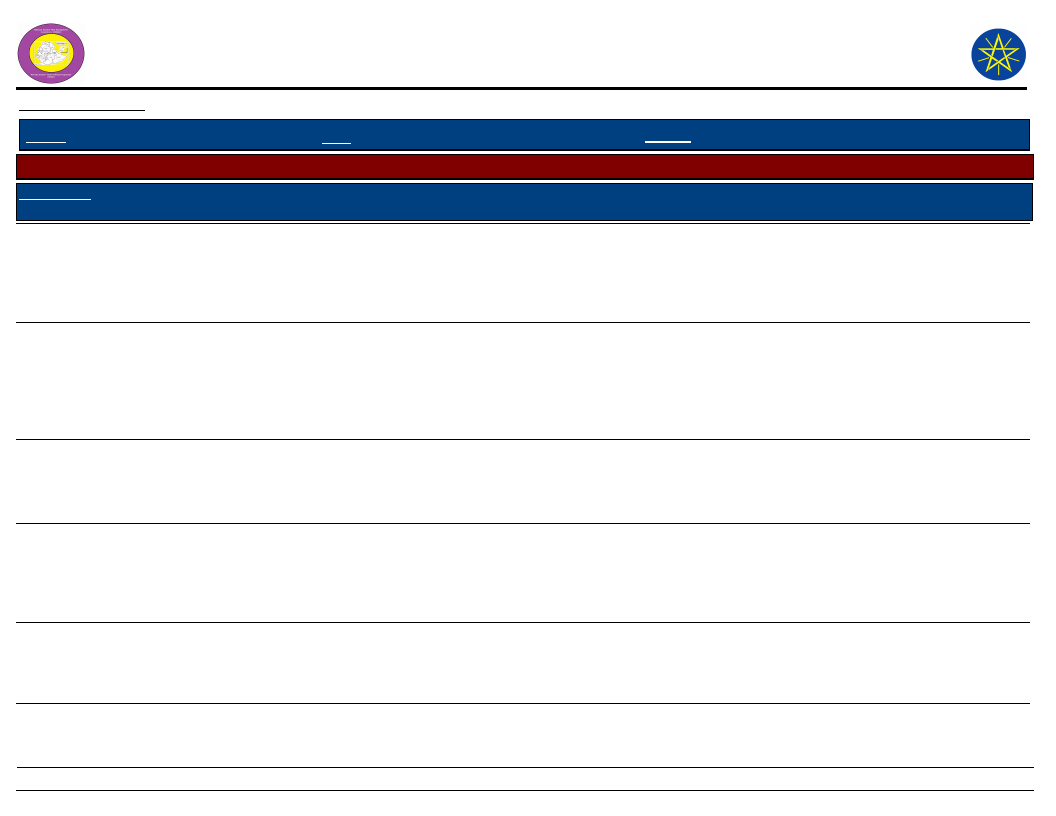
Wereda Disaster
Risk Profile
National Disaster Risk Management
Commission (NDRMC)
Data_Collected_Date
Tuesday, July 9, 2019
Region S.N.N.P
Zone GURAGE
Wereda MESKAN
Selected Indictor:
Kebele Name
OCHAGENEME
Disaster Characteristics By Kebele
Disaster_Type Common Period
Year
Worst_ Trends of
Occured Year Effects
Root Causes
Drought
March, April,
May, June, July,
August
1997 -
2008
1998
Decreased
Erratic rain
fall, climate
change
Effects
Crop
damage,
death f
livestock
Vulnerability
Rain fall
dependents
Flood
July, August,
September
1996,
2000,
2007,
2008
Livestock
diseases
Frost / Cold
waves
September,
October,
November,
January
November,
December,
January
1997 -
2008
1997,
2002,
2009
Crop diseases
May, June, July,
August,
September
2000 -
2008
2008
2008
2009
2007
Increased
High rain fall,
over flow
Increased
Increased
Transmit
from camel,
climate
change
Climate
change
Increased
Increasing
temperature
Crop
damage,
house
destruction,
shortage of
food
Death and
disease of
livestock,
skin damage
Damage all
crop and
vegetable,
shortage of
food
Crop
damage,
shortage of
food
Unsustainable water
and soil
conservation,
improper farming
system
In migration of
camel
No frost resistant
variety
Loss of crop
rotation
Coping Strategy
Digging under ground
water to use
irrigation, water
harvesting activity in
the cultivated land
Make soil bund, daily
labor
Traditional and
medical treatment
Selling livestock,
fairing the
surrounding
Using chemical,
supply water, pull
out infected plant
29
Page 23 of 31
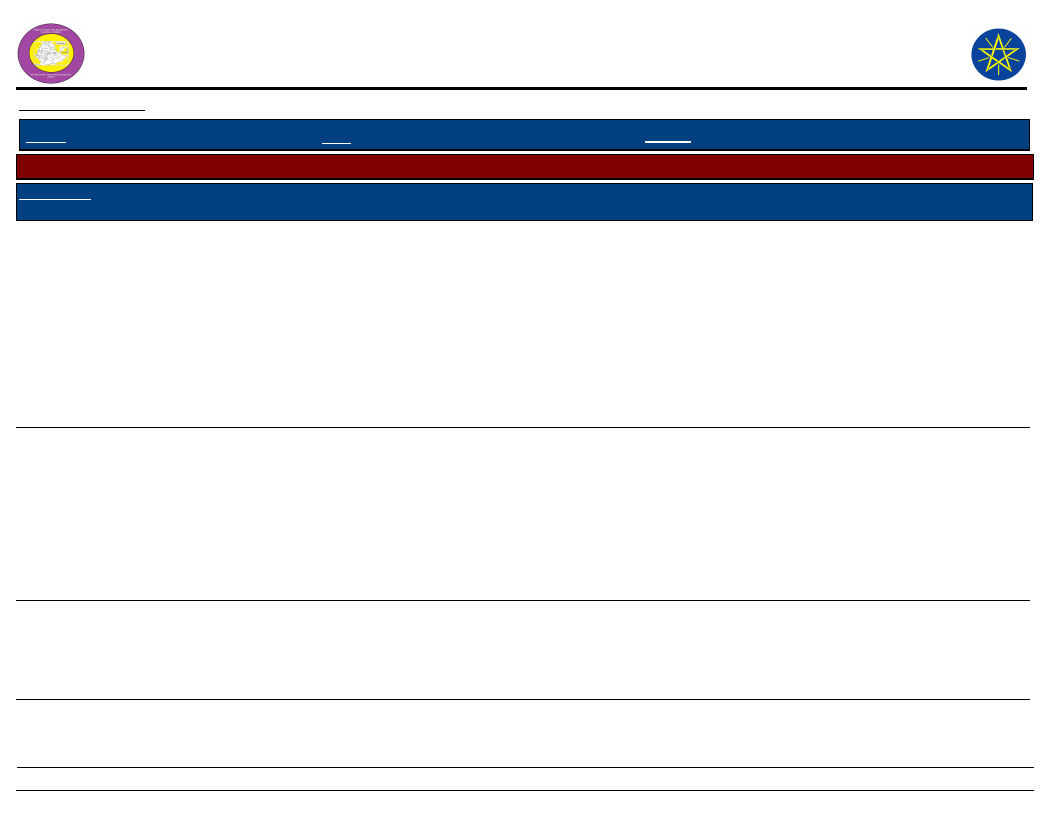
Wereda Disaster
Risk Profile
National Disaster Risk Management
Commission (NDRMC)
Data_Collected_Date
Tuesday, July 9, 2019
Region S.N.N.P
Zone GURAGE
Wereda MESKAN
Selected Indictor:
Kebele Name
SEMEN
SHORSHORA
SHERSHERA
MACHMENA
Disaster Characteristics By Kebele
Disaster_Type Common Period
Drought
March, April,
May, June, July,
August,
September
Year
Occured
1977,
2008
Worst_
Year
1977
Trends of
Effects
Decreased
Root Causes
Climate
change
Flood
Drought
June
1988,
2008
1988
Decreased
Climate
change,
topography of
the location,
deforestation
, heavy rain
fall
January,
February, March
2000,
2001 -
2007
2007
Increased
Climate
change,
deforestation
, shortage of
rain fall
Effects
Crop
damage,
shortage of
food,
shortage of
drinking
water,
shortage of
animal
forage,
migration
Soil erosion,
loss of yield,
crop
damage,
water
pollution,
damage
livestock
forage
Human
disease,
livestock
disease, loss
of income
Vulnerability
Rain fall
dependant, weak
saving habit, bad
trends for planting
early matured crops
Un sustainable soil
and water
conservation,
deforestation, poor
ploughing system
Climate change,
ecological
condition, soil and
crop type
Coping Strategy
Migrate to relatives,
decrease number of
cattle, helping ach
other, borrow food
items
Receiving relief,
daily labor,
resettlement,
migration
Helping each other
by money and
material,
governmental help
30
Page 24 of 31
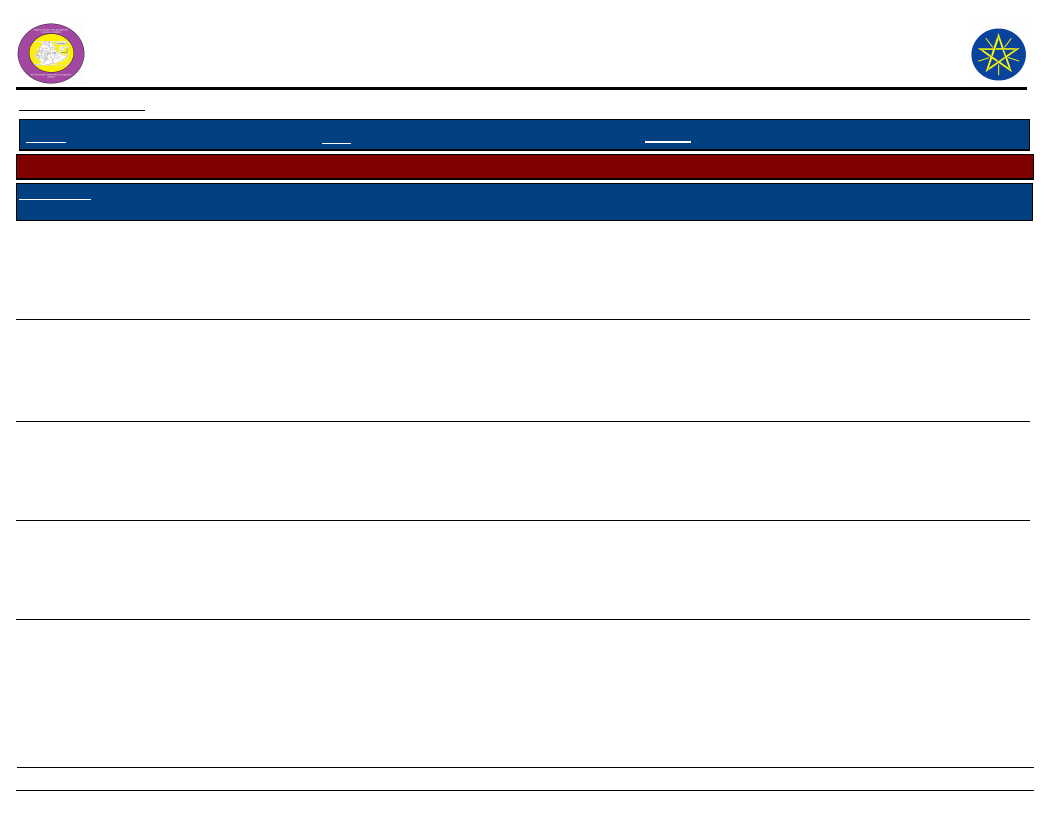
Wereda Disaster
Risk Profile
National Disaster Risk Management
Commission (NDRMC)
Data_Collected_Date
Tuesday, July 9, 2019
Region S.N.N.P
Zone GURAGE
Wereda MESKAN
Selected Indictor:
Kebele Name
SHERSHERA
MACHMENA
Disaster Characteristics By Kebele
Disaster_Type Common Period
Flood
July, August
Year
Occured
1976,
1996,
2001,
2007,
2008
Worst_
Year
2006
Trends of
Effects
Increased
Soil Erosion
June, July,
August
1976,
1996,
2001,
2006,
2007,
2006
Increased
Livestock
diseases
October, May
2008,
2009
2008
Increased
Crop diseases
September,
October
2005,
2008
2008
Increased
Root Causes
Heavy rain
fall,
deforestation
Over grazing,
topography,
deforestation
Drought, lack
of
vaccination,
in migration
of camel
Climate
change, less
resistance of
crop
WEJABATI
Drought
March, May,
June, July
2004 -
2008
2006
Decreased
Erratic rain
fall, climate
change
Effects
Vulnerability
Destruction
of house,
crop
damage, soil
erosion
Decreased
soil fertility,
decreased
productivity
Topography, soil
type, climate
change, shortage of
drainage
Over grazing,
topography, type of
soil
Death of
livestock
Loss of yield,
food
shortage,
economic
loss
Crop
damage,
livestock
death
Climate change,
less resistant crops
Deforestation, lack
of early matured
variety of seed,
depending on rain
fall
Coping Strategy
Help by government
and NGOs, shifting
crops, construct
flood diversion
Conservation,
planting premature
plant, relief and
safetymen
Medical treatment,
helping each other
with edir
Chemical protection,
shifting
Water harvest
practice in
cultivated land,
shifting another
crop, selling
livestock
31
Page 25 of 31
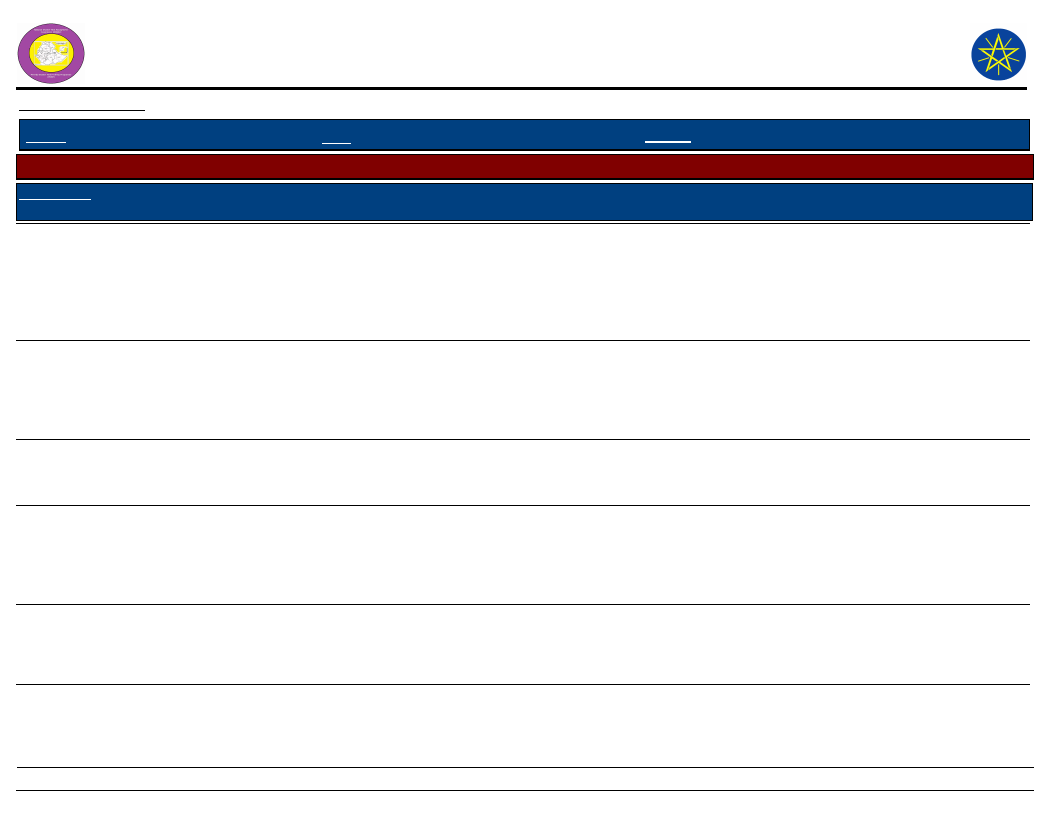
Wereda Disaster
Risk Profile
National Disaster Risk Management
Commission (NDRMC)
Data_Collected_Date
Tuesday, July 9, 2019
Region S.N.N.P
Zone GURAGE
Wereda MESKAN
Selected Indictor:
Kebele Name
WEJABATI
Disaster Characteristics By Kebele
Disaster_Type Common Period
Year
Worst_ Trends of
Occured Year Effects
Crop diseases
January - August
2001 -
2008
2007
Increased
Root Causes
Lack of
resistant
variety,
fungus
Effects
Vulnerability
Loss of yield,
crop damage
Un proper farming
practice
Livestock
diseases
March, April,
May, June,
2004 -
2009
2007
Decreased Transmit
from camel
Death of
livestock,
skin damage
Livestock type and
transmit from
camel
WITA
Frost / Cold
waves
November -
January
Drought
April
Flood
June
Livestock
diseases
November
1997,
2002,
2009
2006,
2007
2007,
2008
2008,
2009
2009
2006
2008
2009
Increased
Climate
change
Remained
the same
Climate
change
Increased High rain fall
Increased
Transmit
from camel
32
Crop and
vegetable
damage
Crop damage
Crop
damage,
erosion
Cattle death,
skin damage
No frost resist
variety
Rain fall
dependent,
deforestation, no
sustainable soil and
water conservation
Deforestation, un
proper farming
practice, soil and
water conservation
In migration of
camel, species of
animals
Coping Strategy
Application of
manure, spray
chemical, seed
treatment, burning
of cultivated land,
grain pod harvest
Traditional and
medical treatment,
using clean water,
isolate the effected
cattle
Smoking and firing
the surrounding
Water harvest,
selling livestock,
recovering relief,
daily labour
Soil bund
construction, cut of
drain
Using cultured
medicine, bring the
cattle to veterinary
clinic
Page 26 of 31
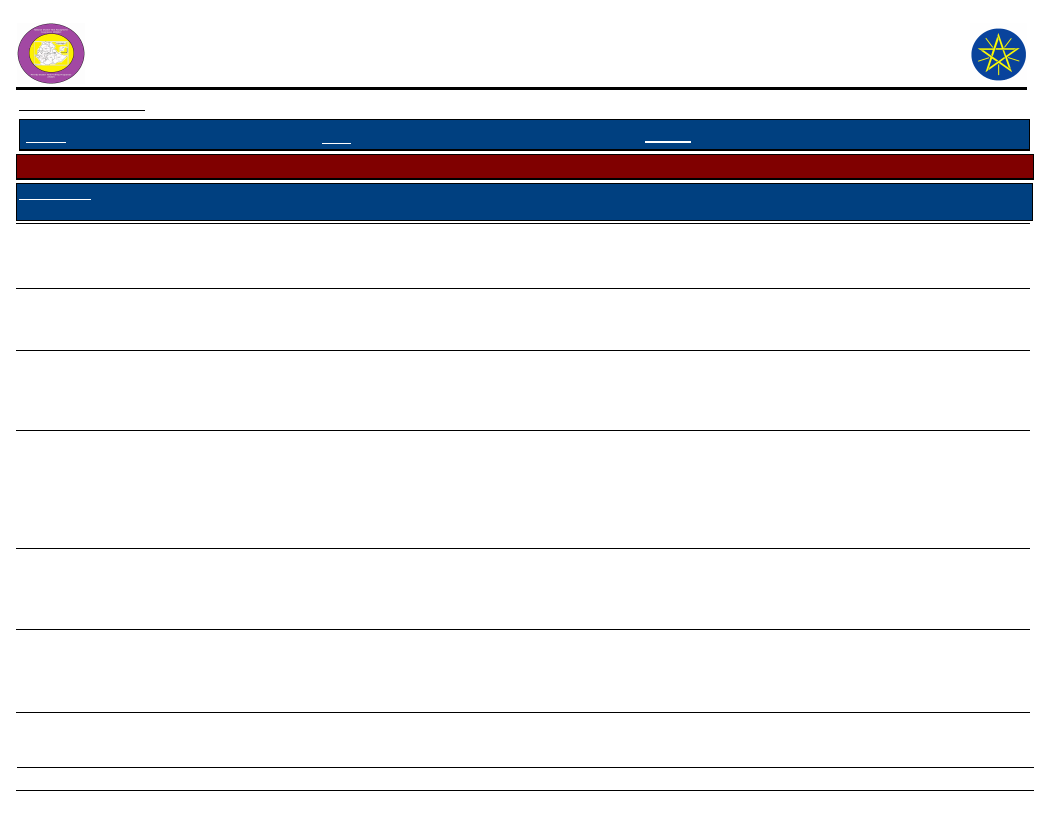
Wereda Disaster
Risk Profile
National Disaster Risk Management
Commission (NDRMC)
Data_Collected_Date
Tuesday, July 9, 2019
Region S.N.N.P
Zone GURAGE
Wereda MESKAN
Selected Indictor:
Kebele Name
WITA
Disaster Characteristics By Kebele
Disaster_Type Common Period
Year
Worst_ Trends of
Occured Year Effects
Frost / Cold
waves
October,
November,
December
2008,
2009
2009
Increased
Crop diseases June, July
2009 -
2009
2009
Increased
Root Causes
Climate
change
Climate
change
WOLENSHO
ANDENYA
Drought
Flood
November - June
1997 -
2009
June, July,
August
2004 -
2008
Increased
Increased
Shortage of
rain fall,
climate
change
Topography,
high rain fall,
deforestation
Snow
June, July,
August
2002,
2005,
2008
Increased
Effects
Vulnerability
Crop damage
No frost resistant
variety
Crop damage
Human
disease,
shortage of
water
Crop
damage, loss
of soil
fertility,
destruction
of house
Crop and
house
damage
Loss of crop
rotation, un proper
time of sowing
No clean water
Deforestation, all
proper cultivate
land, un sustainable
soil and water
conservation
Ecological factors of
the area
Frost / Cold
waves
November,
December,
January
2003,
2004,
2005,
2009
2009
Increased
Climate
change
Crop
damage,
death of
livestock
High landless
Coping Strategy
Faring and smoking
Chemical spray, pull
out the damage crop
Collected ground
water, drinking
water from near
town
Soil and water
conservation, cut of
drain, forestation
Re plant the damage
plant, recover the
cultivated land,
sharing resource
Create income
generating, saving
asset, selling more
livestock
33
Page 27 of 31
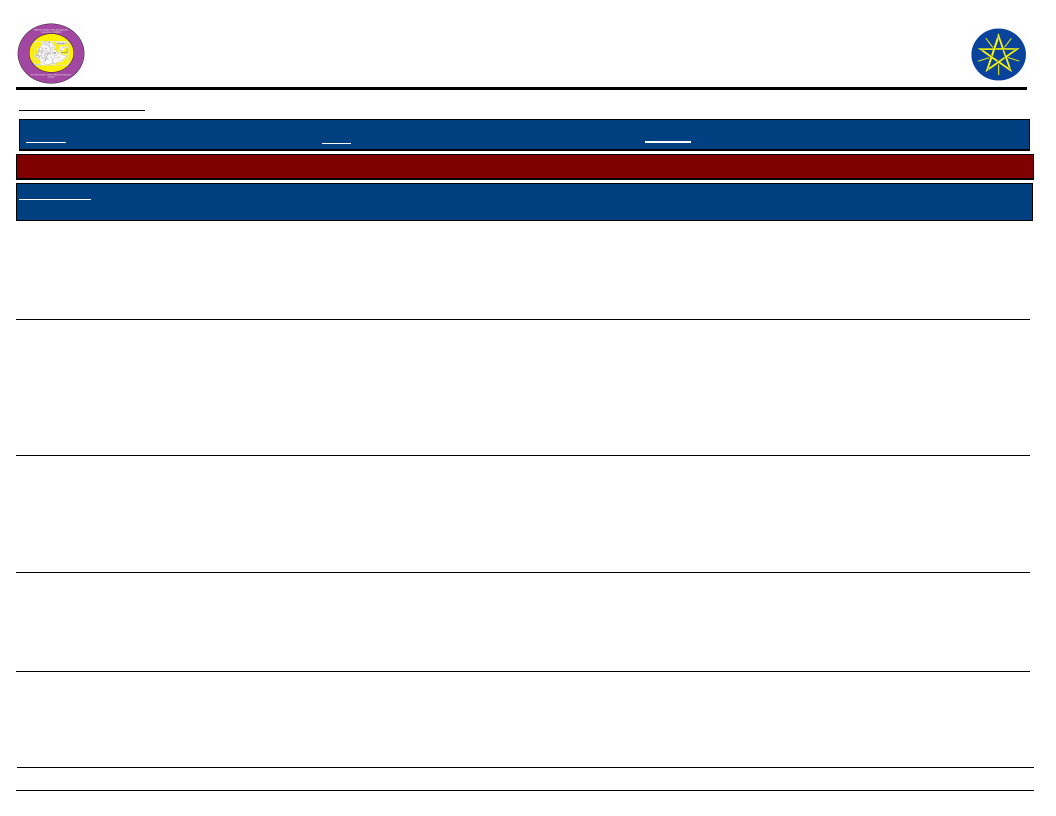
Wereda Disaster
Risk Profile
National Disaster Risk Management
Commission (NDRMC)
Data_Collected_Date
Tuesday, July 9, 2019
Region S.N.N.P
Zone GURAGE
Wereda MESKAN
Selected Indictor:
Kebele Name
WOLENSHO
ANDENYA
YETABON
Disaster Characteristics By Kebele
Disaster_Type Common Period
Livestock
diseases
February,
March, April,
May, June, July,
August,
September
Year
Occured
2007,
2008,
2009
Worst_
Year
2008
Trends of
Effects
Decreased
Root Causes
Transmit
from camel
Flood
April, May,
June, July,
August,
September
1990,
2005,
2007,
2008
2007
Increased
Heavy rain
fall,
topography,
deforestation
Livestock
diseases
All the year
Drought
April, Mau,
June, July,
September
2007,
2008
1977,
1984,
1993,
2007
2008
Increased
In migration
of camel,
climate
change,
livestock type
2007
Increased
Shortage of
rain fall,
climate
change,
deforestation
Effects
Death of
livestock,
skin damage
Damaged
crop
production,
damage
house and
farm land,
migration
Death of
livestock,
damage skin
production,
loss of
income
Shortage of
food, feed
and water,
loss of
income
Vulnerability
Type suspect able
cattle
Topography,
drainage problem
Climate change,
deforestation, crop
type
Coping Strategy
Traditional and
medical treatment,
rearing cattle at
home
Shifting plants, early
matured plats,
support by
government, using
resistant crops
Early medical
treatment, helping
each other with
financial
Selling livestock and
asset to buy food,
helping each other
34
Page 28 of 31
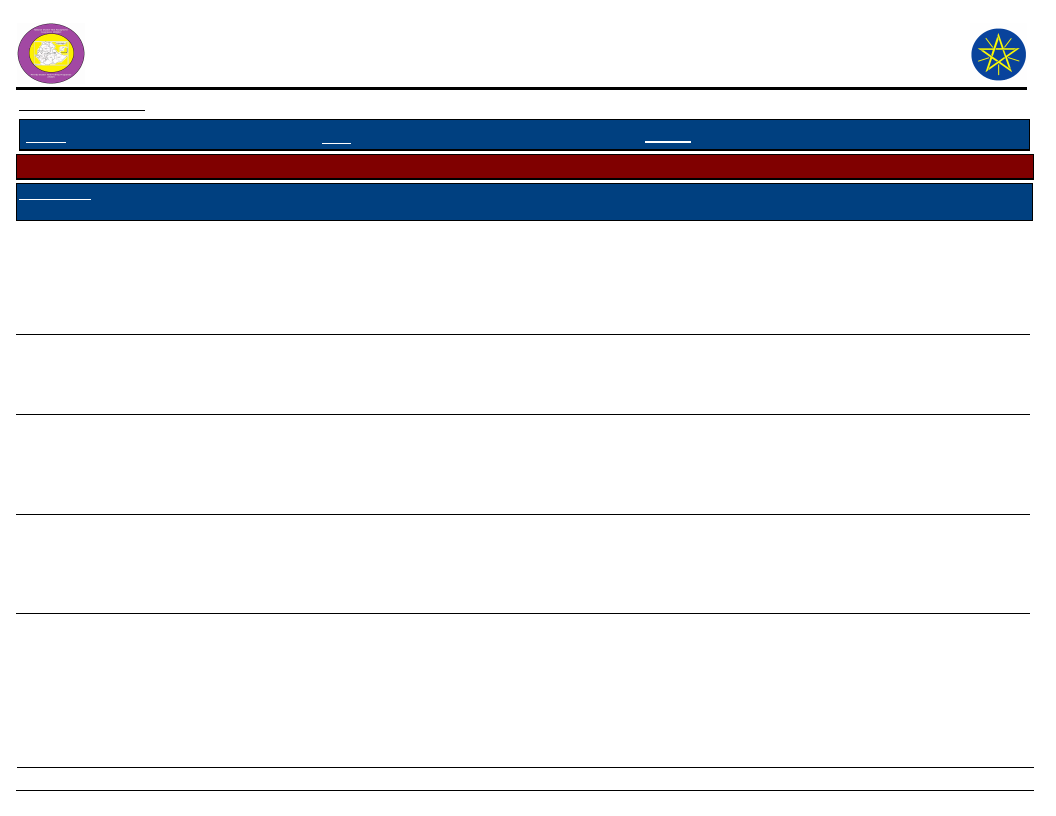
Wereda Disaster
Risk Profile
National Disaster Risk Management
Commission (NDRMC)
Data_Collected_Date
Tuesday, July 9, 2019
Region S.N.N.P
Zone GURAGE
Wereda MESKAN
Selected Indictor:
Kebele Name
YETABON
Disaster Characteristics By Kebele
Disaster_Type Common Period
Crop diseases July, August
Year
Occured
2006,
2007,
2008
Worst_
Year
2007
Trends of
Effects
Increased
Root Causes
Climate
change,
deforestation
, crop type
YIMERWACHO
2NYA
Frost / Cold
waves
January
2009
2009
Increased
Climate
change
Drought
Flood
Livestock
diseases
March, April,
May, June,
September
July, August
1977,
1996,
2000 -
2007
2002,
2008
2007
2008
Increased
Increased
Shortage of
rain fall,
deforestation
, climate
change
Heavy rain
fall, climate
change,
topography
March, April,
May, June, July,
August
2000,
2002,
2005,
2007,
2008,
2009
2008
Increased
Climate
change,
problem of
vaccination
Effects
Vulnerability
Loss of yield,
loss of
income,
shortage of
food, feed
and water
Loss of crop,
shortage of
food, loss of
income
Decreasing
yield,
shortage of
food
Climate change,
crop type
Depending on rain
fall, poor farming
system
Damage crop
and farm
land, human
and livestock
disease
Death and
disease of
livestock,
loss of
economy
Deforestation,
topography of the
area
Coping Strategy
Early treatment,
helping each other
with finance and
labour
Shifting crops,
borrowing money
Improve of
irrigation, dig deep
underground water,
support by
government
Construct water
way, planting
permanent crops,
diversion of crops
Traditional and
medical treatment,
isolate affected
livestock
35
Page 29 of 31
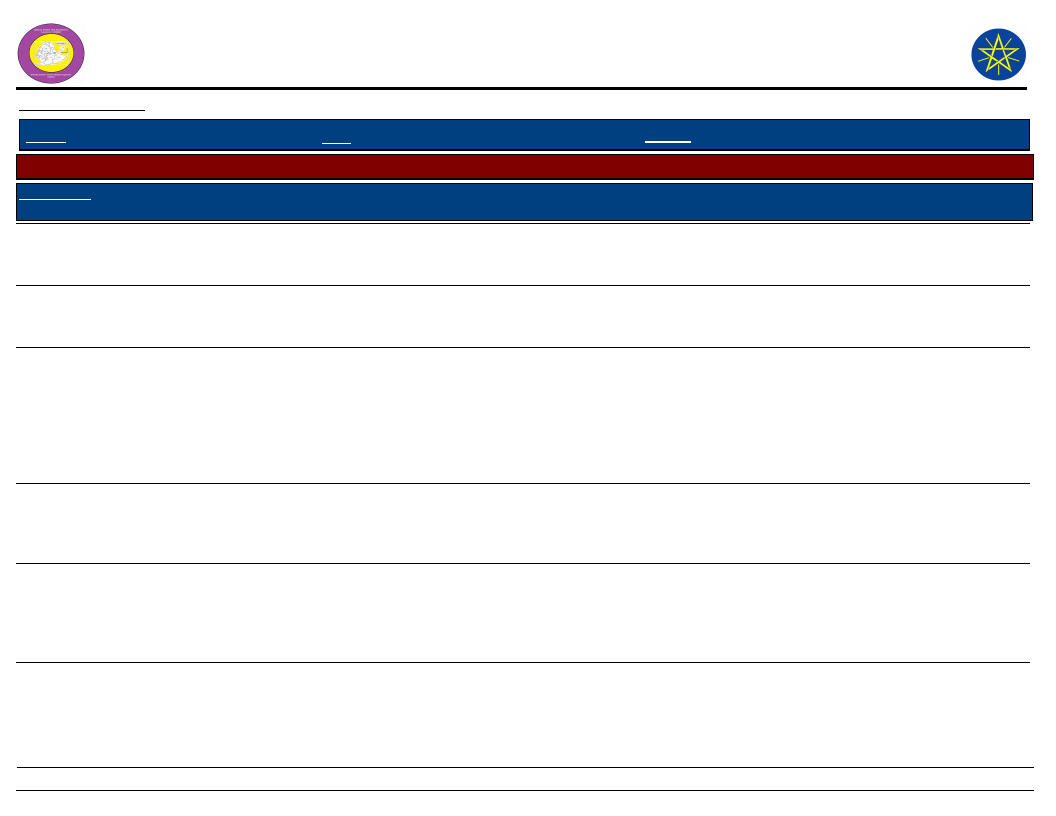
Wereda Disaster
Risk Profile
National Disaster Risk Management
Commission (NDRMC)
Data_Collected_Date
Tuesday, July 9, 2019
Region S.N.N.P
Zone GURAGE
Wereda MESKAN
Selected Indictor:
Kebele Name
YIMERWACHO
2NYA
YIMERWACHO
3NYA
Disaster Characteristics By Kebele
Disaster_Type Common Period
Year
Worst_ Trends of
Occured Year Effects
Root Causes
Crop diseases July, August
2000 -
2009
2008
Increased
Climate
change,
fungus
Human
diseases
September,
October
Every
year
2008
Increased
Stagnant
water,
mosquito bite
Drought
April, May,
June, July,
August
1997 -
2009
2003
Decreased Erratic rain
fall
Crop diseases
September - May
2000 -
2009
Flood
July, August,
September
1997 -
2008
2003
2008
Increased
Decreased
Climate
change, poor
crop rotation,
fungus
Heavy rain
fall,
deforestation
Effects
Vulnerability
Loss of yield,
economic
crises
Hunan
disease, loss
of income
Crop
damage,
death of
human and
livestock,
loss of
production
Crop
damage, loss
of yield
Crop
damage,
destruction
of house, loss
of income
Repeating of crops,
less resistant of
crops
Problem of
drainage, poor use
of net
Shortage of early
mature variety
,depending on rain
fall
Climate change,
lack of resistant
varsity, loss of crop
rotation
Shortage of
drainage,
deforestation
Coping Strategy
Shifting plant,
cultivated resistant
variety of crops
Medial treatment
Water harvesting
activities,
forestation
Spray chemical, pull
out affect plants
36
Page 30 of 31
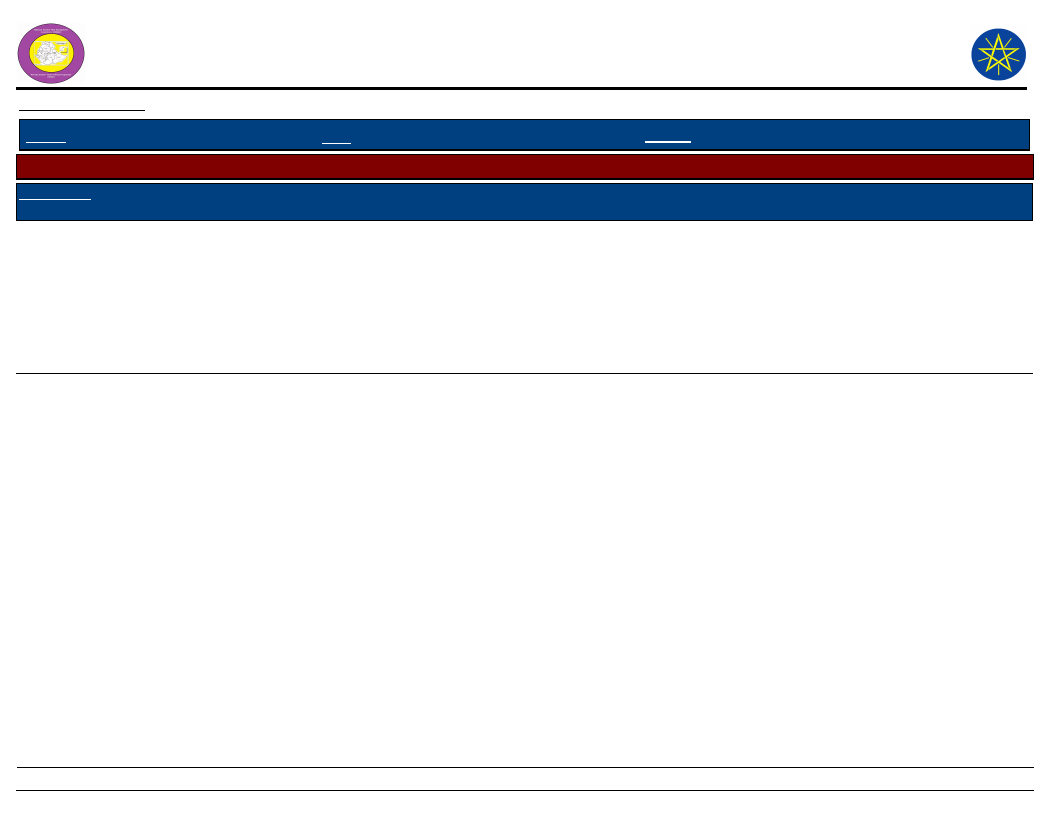
Wereda Disaster
Risk Profile
National Disaster Risk Management
Commission (NDRMC)
Data_Collected_Date
Tuesday, July 9, 2019
Region S.N.N.P
Zone GURAGE
Wereda MESKAN
Selected Indictor:
Kebele Name
YIMERWACHO
3NYA
Disaster Characteristics By Kebele
Disaster_Type Common Period
Livestock
diseases
November - May
Year
Occured
2004 -
2009
Worst_
Year
2008
Trends of
Effects
Increased
Root Causes
In migration
of camels
IMPORTANT: The years and months mentoned in this report are according to Ethiopian Calendar (EC).
Effects
Vulnerability
Death of
livestock,
skin damage,
loss of
livestock
production,
loss of
income
Shortage of
vaccination, no
early treatment
Coping Strategy
Medial
treatment/get
veterinary service,
traditional treatment
37
Page 31 of 31
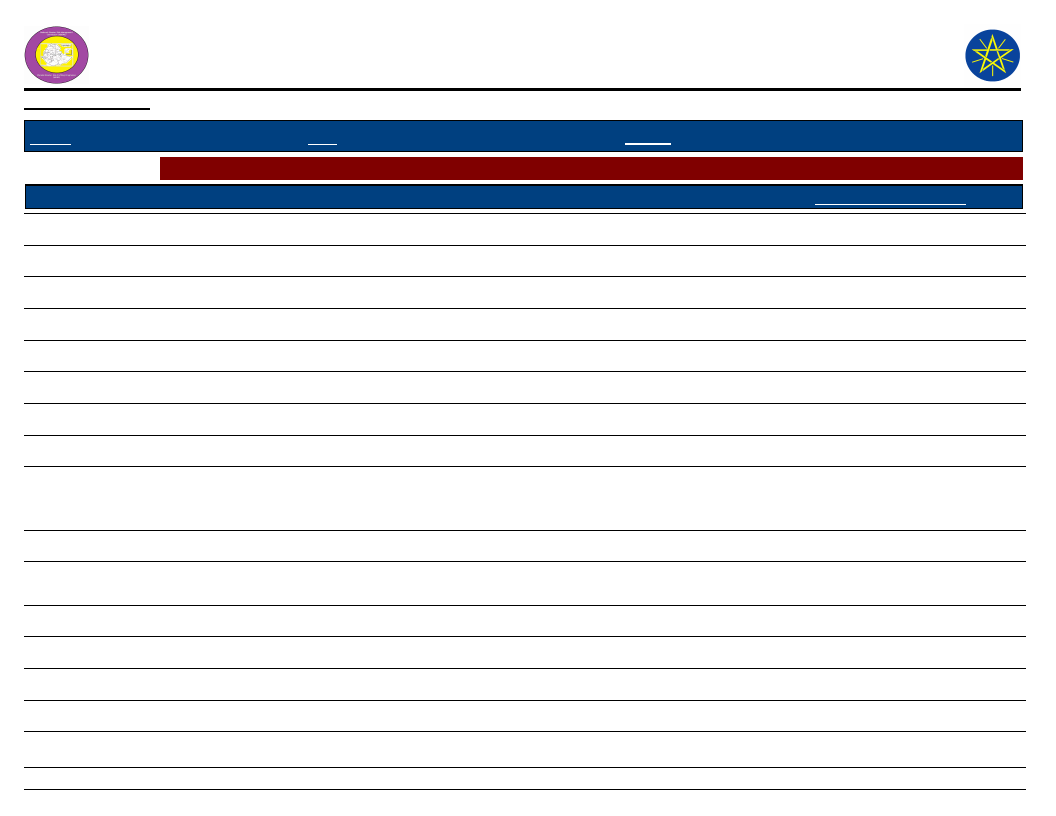
Wereda Disaster
Risk Profile
Data_Collected_Date
Region S.N.N.P
Zone GURAGE
Selected Indictor:
KebeleName
BATI FATO
Hazards: Conflict as an Issue
Description_Of_Conflict
BATI LEJANO
No conflict
BECHE BULCHANO
BERESA
No conflict
DEBO TUTO
Water problem
DEBUB SHERSHERA
DEGAGOGOT
Decreased
DIDA
No conflict
DIRAMA
High
DOBENA
GIDENA ABORAT
GOYBAN
ILE
INSENO USME
JOLE ANDENYA
No
High
Very low
No conflict
No conflict
No
National Disaster Risk Management
Commission (NDRMC)
Tuesday, July 9, 2019
Wereda MESKAN
Change_In_Last_Decade
Main_Causes_Of_Conflict
Increase
Increased
Increased
Decreased
Use of water
Common land, social
conflict, loss of finance
and time/loss of asset
Common school land
conflict,
38
Page 1 of 3
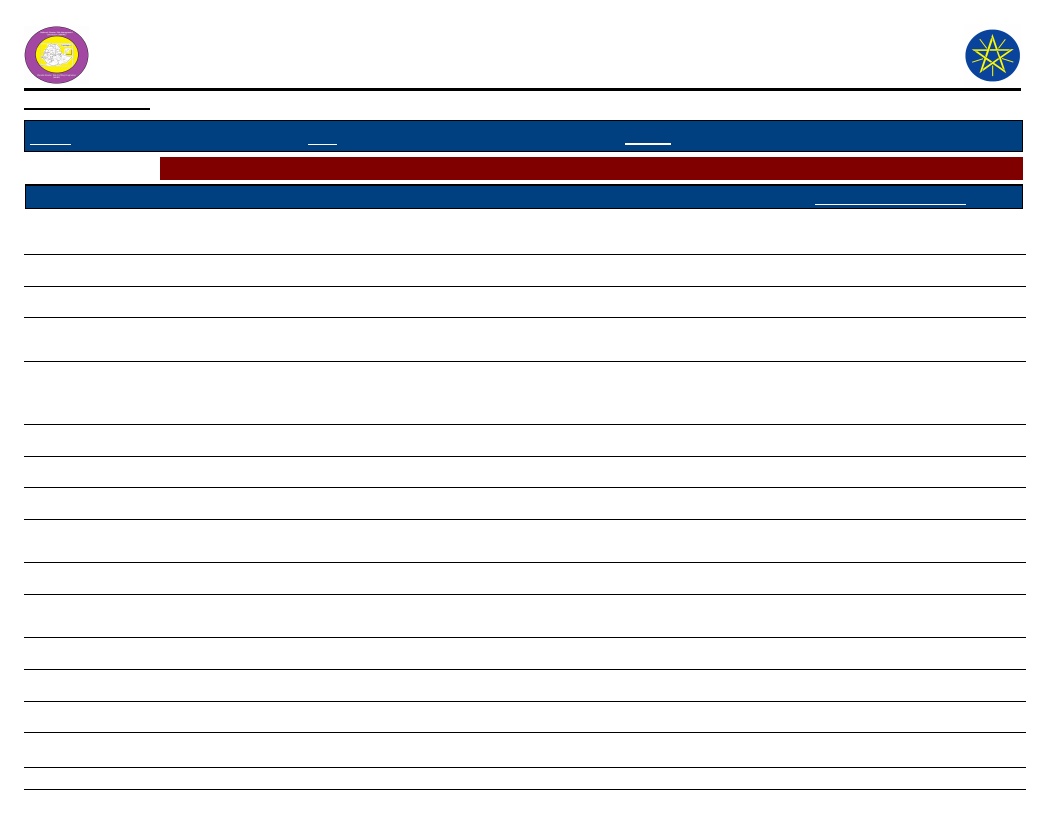
Wereda Disaster
Risk Profile
Data_Collected_Date
Region S.N.N.P
Zone GURAGE
Selected Indictor: Hazards: Conflict as an Issue
KebeleName
JOLE HULETENYA
Description_Of_Conflict
High
MEKICHO
MESERETEWEGERAMO
MIKAELO
MIRAB IMBOR
No conflicts
Border of the kebele conflict from neighboring
kebeles
High
MIRAB MESKAN
OCHAGENEME
SEMEN SHORSHORA
SHERSHERA
MACHMENA
WEJABATI
WITA
WOLENSHO ANDENYA
YETABON
YIMERWACHO 2NYA
YIMERWACHO 3NYA
No conflict
No conflict
Very low
Very high
No conflict
Conflict
No conflict
High
Very less
No conflict
National Disaster Risk Management
Commission (NDRMC)
Tuesday, July 9, 2019
Wereda MESKAN
Change_In_Last_Decade
Increased
Main_Causes_Of_Conflict
Conflict by land and Meki
river,
No change
Decreased
Border conflict each other,
forest fire
Because of irrigation water
from border kebeled,
death of human
Decreased
Decreased
Decreased
Decreased
Decreased
39
Boundary conflict
Land border, social
problem
By common land border
Due to boundary
Page 2 of 3
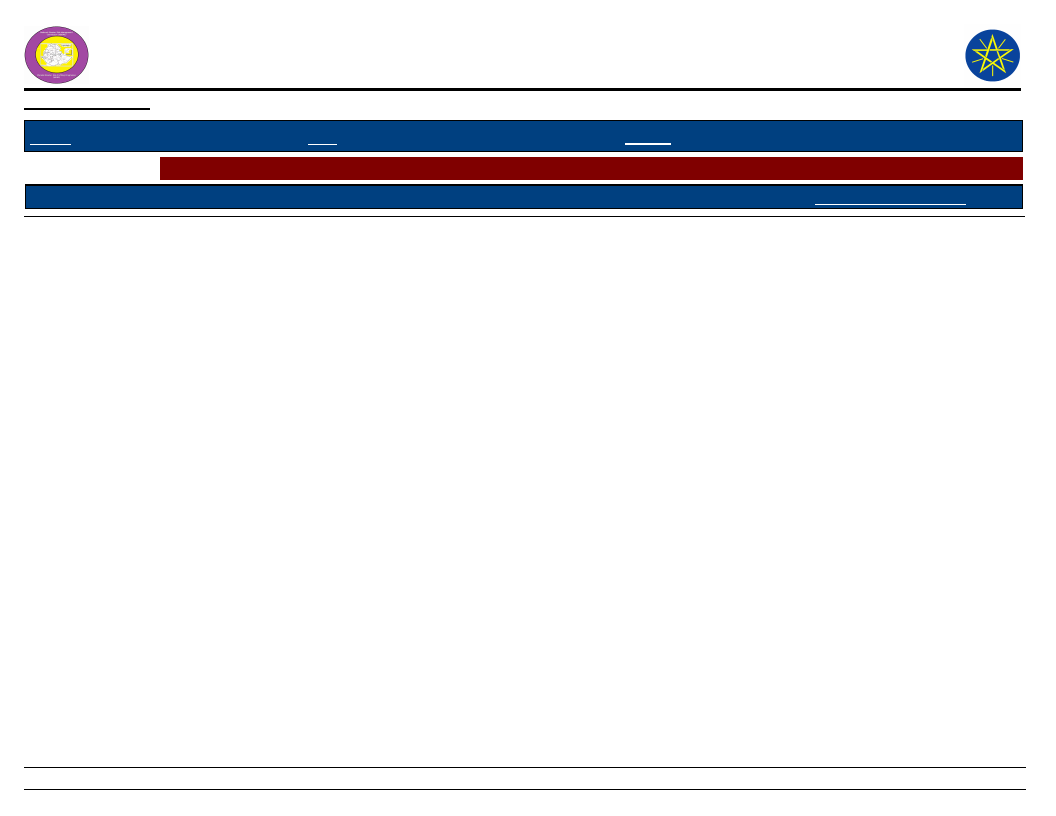
Wereda Disaster
Risk Profile
Data_Collected_Date
Region S.N.N.P
Zone GURAGE
Selected Indictor: Hazards: Conflict as an Issue
KebeleName
Description_Of_Conflict
National Disaster Risk Management
Commission (NDRMC)
Tuesday, July 9, 2019
Wereda MESKAN
Change_In_Last_Decade
Main_Causes_Of_Conflict
40
Page 3 of 3
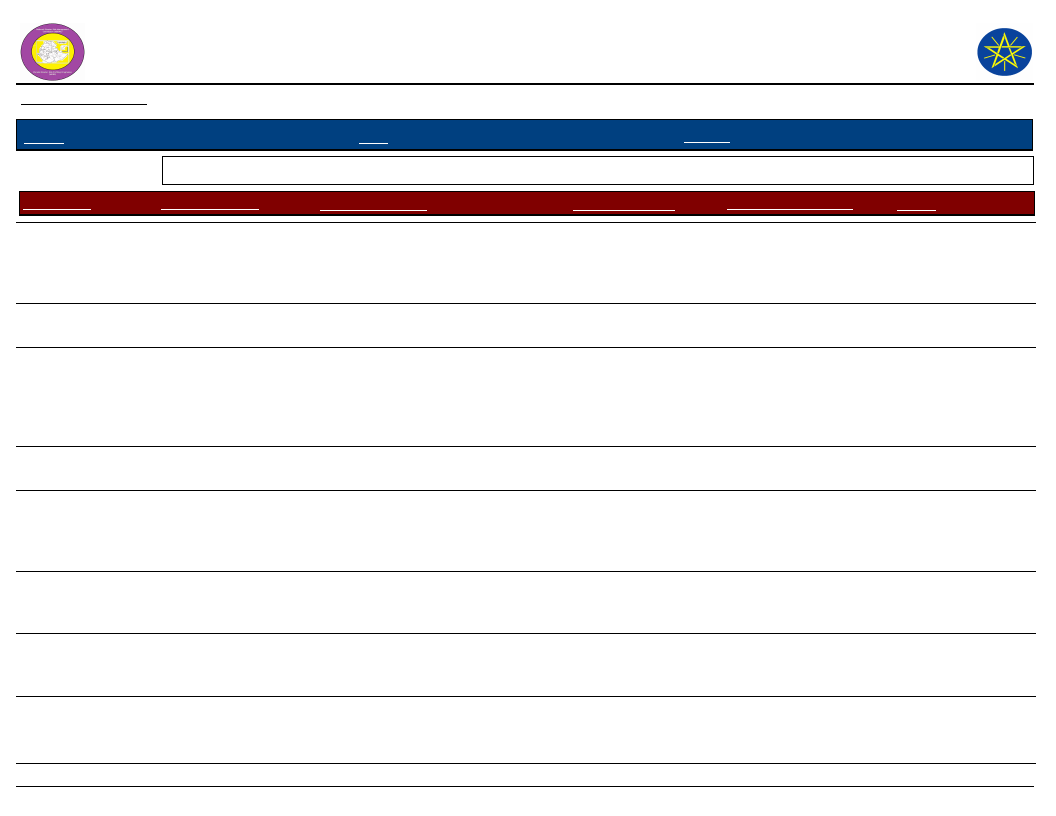
Wereda Disaster Risk
Profile
Data_Collected_Date
National Disaster Risk Management
Commission (NDRMC)
Tuesday, July 9, 2019
Region S.N.N.P
Zone
GURAGE
Wereda
MESKAN
Selected Indicator: Hazard Situation During Last Disaster - Characteristics of most recent disasters that affected the community
KebeleName
Types of Disasters
Hazard_Description
Effect_Of_Disaster
Most_Severly_Affected
Reason
BATI FATO
Frost
BATI LEJANO
BECHE BULCHANO
Drought
Flood and drought
BERESA
DEBO TUTO
Drought
Drought
DEBUB SHERSHERA
Flood and drought
DEGAGOGOT
Food
Affect all annual and perennial crops
of the area, durable for 1 months
highly intensity
Affect the 90% of the community for
6 months
Highly affect the community for two
to three months and high severity
Duration for six months affect 75%
community medium severity
Highly affect 90% of community every
year
Highly affect the community for five
months continuously this three years
Affect at list 50% of community and
stay for two months in every year
Crop damage,
shortage of food,
income loss, social
crises
Shortage of food
Model farmers, investors
Children and elders
Loss of crop
production, shortage
of food, loss of
income, human and
livestock disease
Loss of food security
Shortage of drinking
water both for
humane and livestock,
shortage of food
Loss of asset, crop
damage, loss of
production
Damage crops and
food items, water
pollution
Children, women, elders
and poor farmers
Children, women and
elders
Children, women and
elder
Children, women, elders
ad disabled
Children, women and
elders
They invested with
high costs and
losing money
No strength to
resist the disaster
Low capacity and
less energy
No strength to
resist
No strength to
protect themselves
They are
economically
dependents
They are
economically
dependent
41
Page 1 of 5
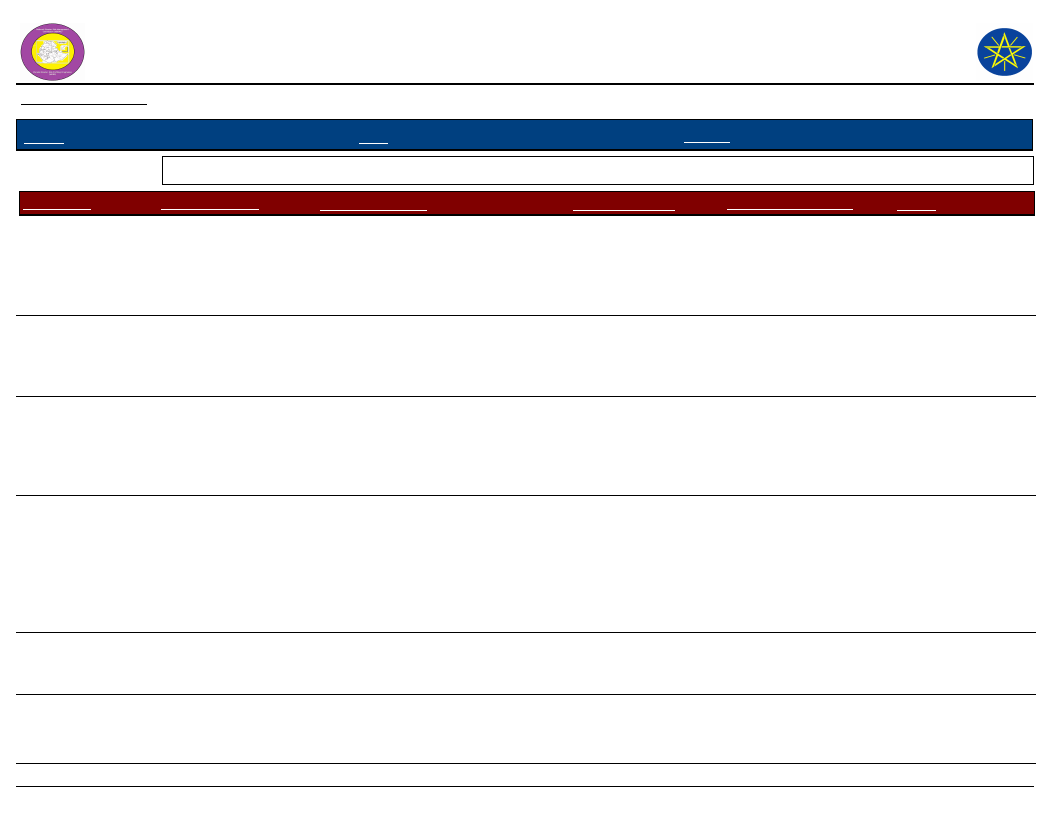
Wereda Disaster Risk
Profile
Data_Collected_Date
National Disaster Risk Management
Commission (NDRMC)
Tuesday, July 9, 2019
Region S.N.N.P
Zone
GURAGE
Wereda
MESKAN
Selected Indicator: Hazard Situation During Last Disaster - Characteristics of most recent disasters that affected the community
KebeleName
DIDA
Types of Disasters
Drought, flood and
livestock disease
Hazard_Description
Affect all community every year
intensity for 6 months
DIRAMA
Flood
Highly affect community
DOBENA
Flood
GIDENA ABORAT
Flood
775% of the community durable to 4
months frequent for times and the
intensity was very high
Affect all community for 5 months
GOYBAN
Flood
Affect 70% of community every year
stay for two to three months
Effect_Of_Disaster
Migration, shortage of
food, crop damage,
human, livestock and
crop disease,
economic loss
Migration, human
disease, livestock
disease, shortage of
food, loss of income
Destruction of house,
migration, crop and
farm land damage,
economic loss
Damage crop and
livestock, shortage of
food, eroded land,
pollute water, human
disease, loss of
income
Crop damage,
shortage of food and
water, migration
Most_Severly_Affected
Children, women and
elders
Children, women, elders
all the community but
economically poor
farmers do not
recovered after the
disaster
Irrigate producing
farmers, sloppy land
area, children, women,
elders and poor
communities
Women, children, elders
Reason
They are
economically
dependent
They were
economic
dependents
Because who have
no economical
power
More exposed to
the disaster due to
topography more
asset loss, living
near to rivers,
economic
depending
They are economic
dependent
42
Page 2 of 5

Wereda Disaster Risk
Profile
Data_Collected_Date
National Disaster Risk Management
Commission (NDRMC)
Tuesday, July 9, 2019
Region S.N.N.P
Zone
GURAGE
Wereda
MESKAN
Selected Indicator: Hazard Situation During Last Disaster - Characteristics of most recent disasters that affected the community
KebeleName
ILE
Types of Disasters
Flood
INSENO USME
JOLE ANDENYA
JOLE HULETENYA
Drought
Flood
Flood
MEKICHO
Flood
MESERETEWEGERAM
O
Flood
MIKAELO
Flood
Hazard_Description
Affect 75% of community every year
and stay for two months
Affect 85% present every year for
month
Affect 75% of community every year
for 3 months
Affect above 75% of community every
year for 4-5 months/three times
About 90% of the community affected
by flood for 5 months
Affect 70% of community for two
months
Affect 80% of community for four
months very high sever
Effect_Of_Disaster
Shortage of food,
destruction of house,
loss of asset, loss of
income
Shortage of food
Most_Severly_Affected
Children, women and
elders
Children and elders
Crop damages,
shortage of food
Loss of crop
production and farm
land, migration,
destruction of house,
shortage of food and
water, loss of asset
Damage house and
asset, damage crop
and farm land, loss of
yield, shortage of
food, migrate
Damage crop
production,
destruction of house
Crop damage,
shortage of food,
damage house and
asset
Children, women and
elders
Living near of Meki river
Children, elders and
disabled
Children, elders
Children and elders
Reason
No strength to
protect the disaster
No strength to
protect the disaster
No strength to
protect
Who have more
nears and exposed
to the effect of
flood
They are economic
dependents
No strength to
protect the disaster
The capacity of
sensitive, no power
to protect the
disaster
43
Page 3 of 5
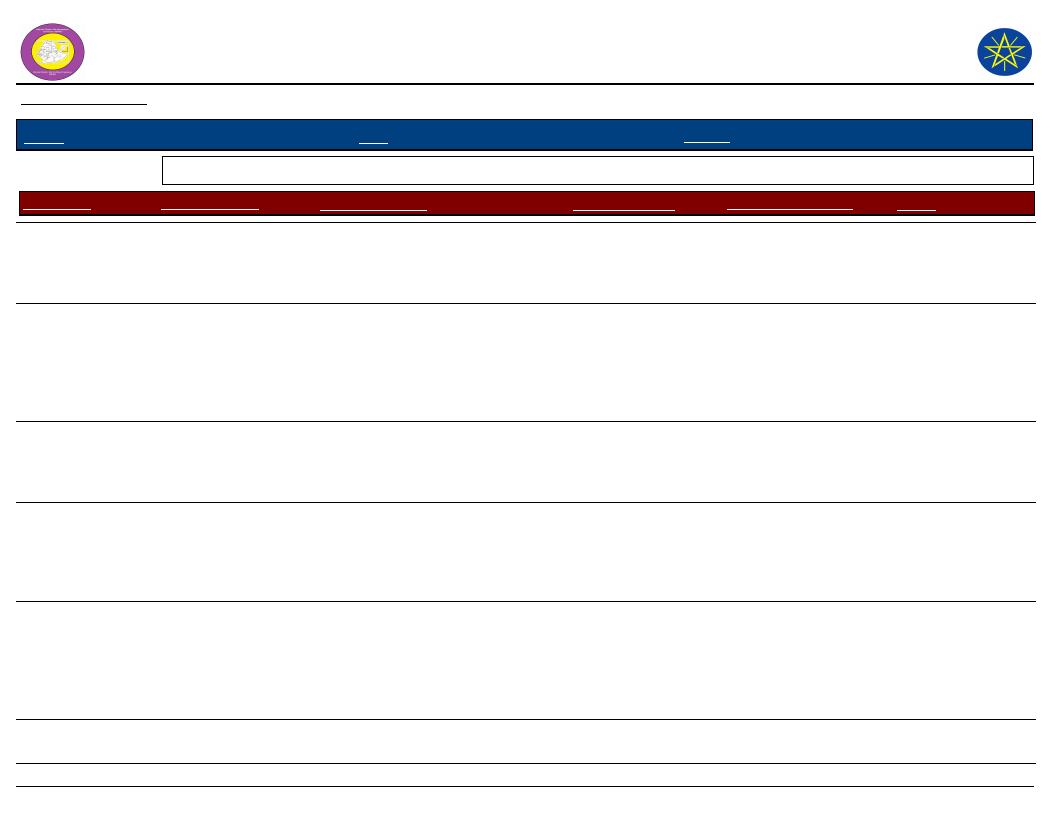
Wereda Disaster Risk
Profile
Data_Collected_Date
National Disaster Risk Management
Commission (NDRMC)
Tuesday, July 9, 2019
Region S.N.N.P
Zone
GURAGE
Wereda
MESKAN
Selected Indicator: Hazard Situation During Last Disaster - Characteristics of most recent disasters that affected the community
KebeleName
Types of Disasters
Hazard_Description
Effect_Of_Disaster
Most_Severly_Affected
Reason
MIRAB IMBOR
Flood
MIRAB MESKAN
Flood
OCHAGENEME
Drought
SEMEN SHORSHORA
Drought
SHERSHERA
MACHMENA
Flood
WEJABATI
Drought
Highly affect farm land and also
house due to topography of area
Highly affect the community 3 times
for 15 days
Affect 90% of community every year
stay for 6 months
Affect 50% of community every year
for 5 to months
Highly affect 80% of community every
year for 5 months
Highly affect 95% of community for 8
months every year
44
Damage crops, soil
fertility, damage
house
Children, elders,
women, handicapped
Loss of crops, soil
erosion, damage
farming land, shortage
of food, human and
livestock disease,
economic crises
Shortage of food
Children, women, elders
and disabled
Children, elder and
disabled
Crop damage,
shortage of water,
shortage of food,
migration, loss of
livestock
Damage house,
damage crop, farm
land and livestock,
migration, expose to
food and water
shortage
Shortage of food
Children, women and
elders
Children, women, elders
and disabled
Children and elders
Because of less
energy and
economic
dependents
They are economic
dependent
No strength to
protect the disaster
and they re easily
vulnerable
They are economic
dependent
They are
economically
dependent
No strength to
protect the disaster
Page 4 of 5
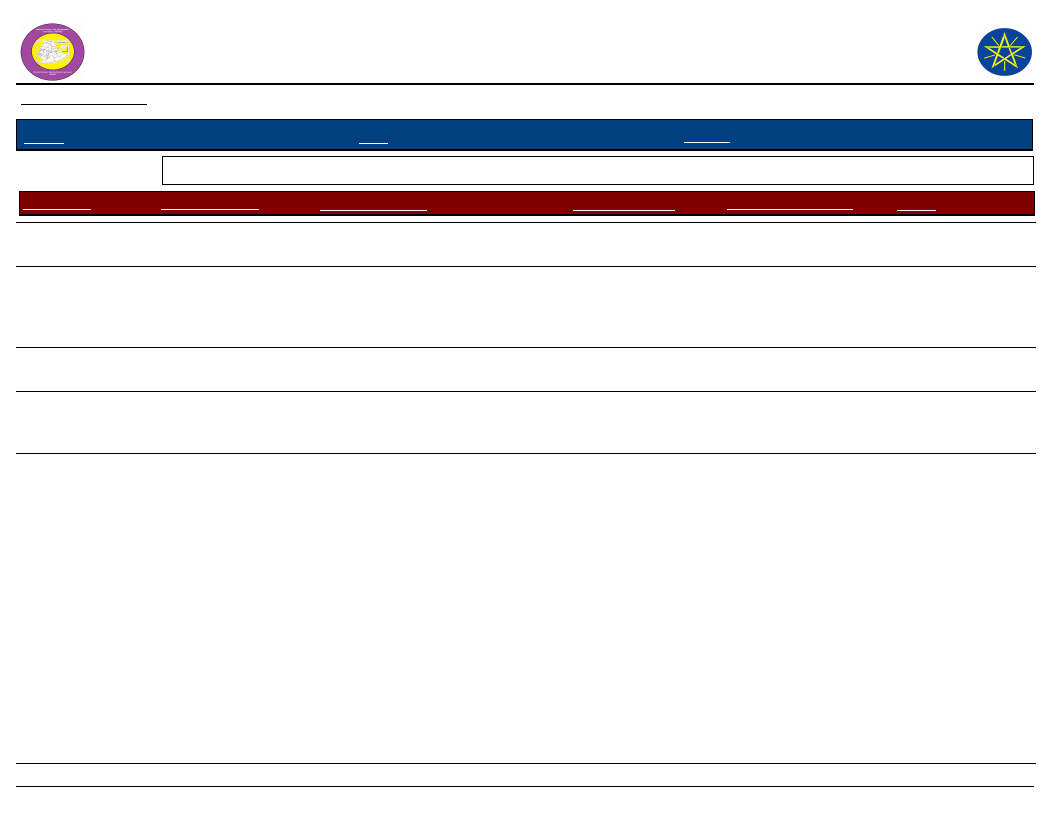
Wereda Disaster Risk
Profile
Data_Collected_Date
National Disaster Risk Management
Commission (NDRMC)
Tuesday, July 9, 2019
Region S.N.N.P
Zone
GURAGE
Wereda
MESKAN
Selected Indicator: Hazard Situation During Last Disaster - Characteristics of most recent disasters that affected the community
KebeleName
Types of Disasters
Hazard_Description
Effect_Of_Disaster
Most_Severly_Affected
Reason
WITA
WOLENSHO
ANDENYA
Drought
Shortage of
water/Drought
YETABON
Flood and frost
YIMERWACHO 2NYA
Flood
YIMERWACHO 3NYA
Drought
Highly affect 80% for 5 months in a
year
Highly affect 90% community for six
months every year
Affect more than 50% of community
for four months
Affect more than 75% of community
and stay for 3 months, high severity
Affect 80% of community for 5
months in every year
Shortage of food
Water pollution
Children and elders
Children, elder
Shortage of food, loss
of crop
Migration, death of
livestock, shortage of
food
Shortage of food
Irrigation users
Children, women and
elders
Children and elders
The stage of
vulnerability
Most vulnerable
because of no
strength to protect
the disaster
Who loss more
money and assets
They are depend on
others
No strength to
protect the disaster
45
Page 5 of 5
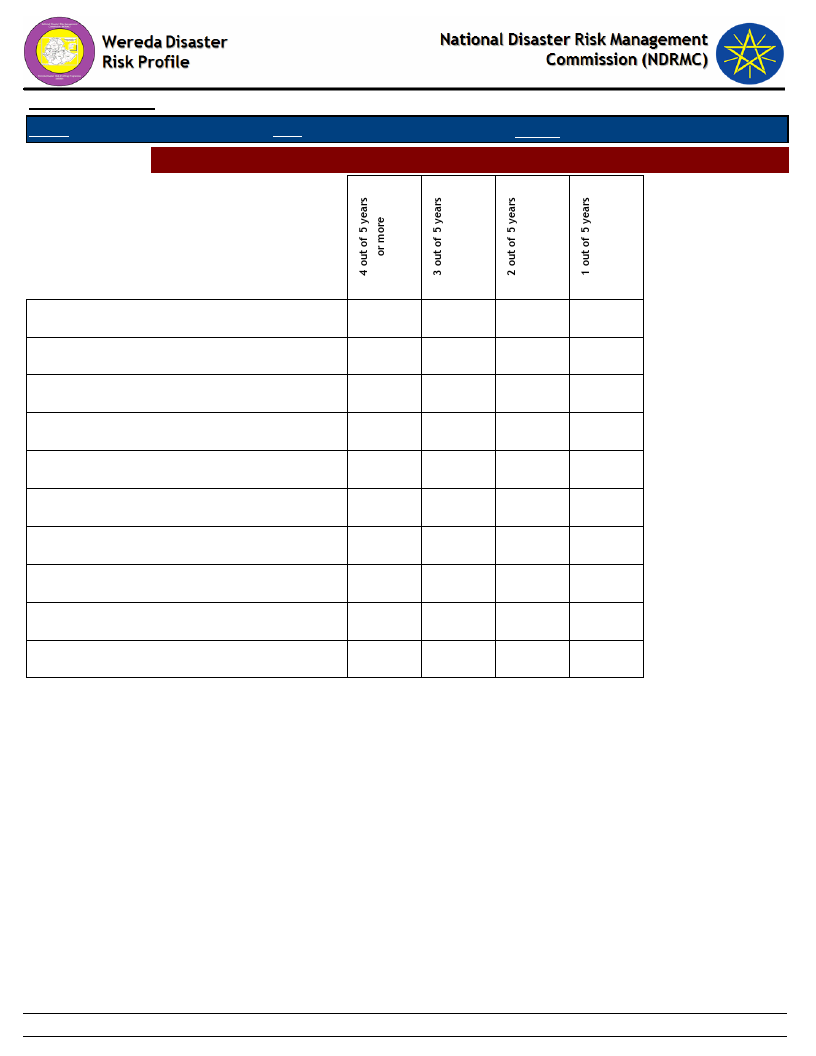
Data_Collected_Date
Region S.N.N.P
Zone GURAGE
Selected Indictor: Frequency of Disaster Occurrence
Wereda MESKAN
Tuesday, July 9, 2019
Conflicts
Crop diseases
Drought
Flood
Frost / Cold waves
Heavy Rain
Human diseases
Landslide
Livestock diseases
Storms / hail storm
100.00
12.82
15.82
13.75
5.88
10.26
29.75
15.00
2.94
11.54
20.00
50.00
3.85
25.64
30.38
5.00
8.82
25.00
17.95
18.35
31.25
82.35
100.00
75.00
38.46
42.31
80.00
46
Page 1 of 1
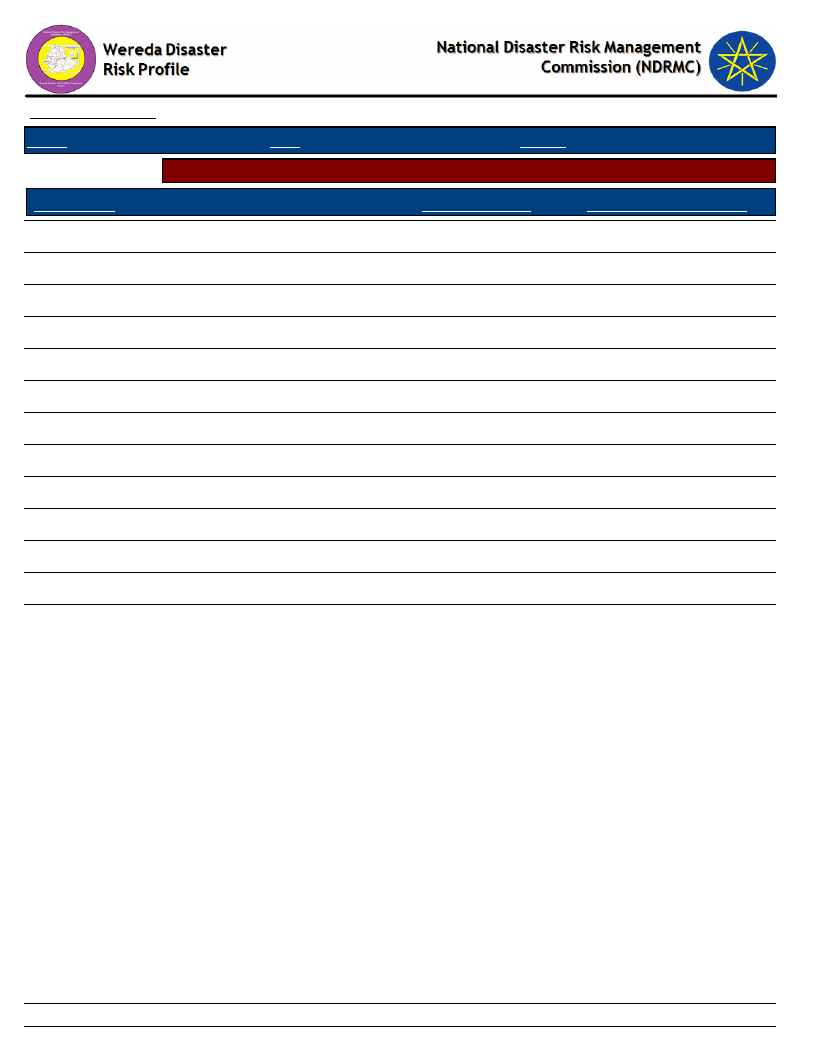
Data_Collected_Date
Region S.N.N.P
Zone GURAGE
Selected Indictor: Household Exposure to Hazards
Disaster Type
Drought
Flood
Crop diseases
Livestock diseases
Frost / Cold waves
Storms / hail storm
Heavy Rain
Landslide
Earthquake
No Disaster
Human diseases
Economic / Price shock
Conflicts
Wereda MESKAN
Tuesday, July 9, 2019
General_Exposure
46.37
24.86
10.06
6.15
5.03
2.79
1.40
0.84
0.84
0.56
0.56
0.28
0.28
Last_Five_Years_Exposure
44.66
23.03
10.96
7.30
9.55
1.40
0.28
0.56
0.84
1.12
0.28
47
Page 1 of 1
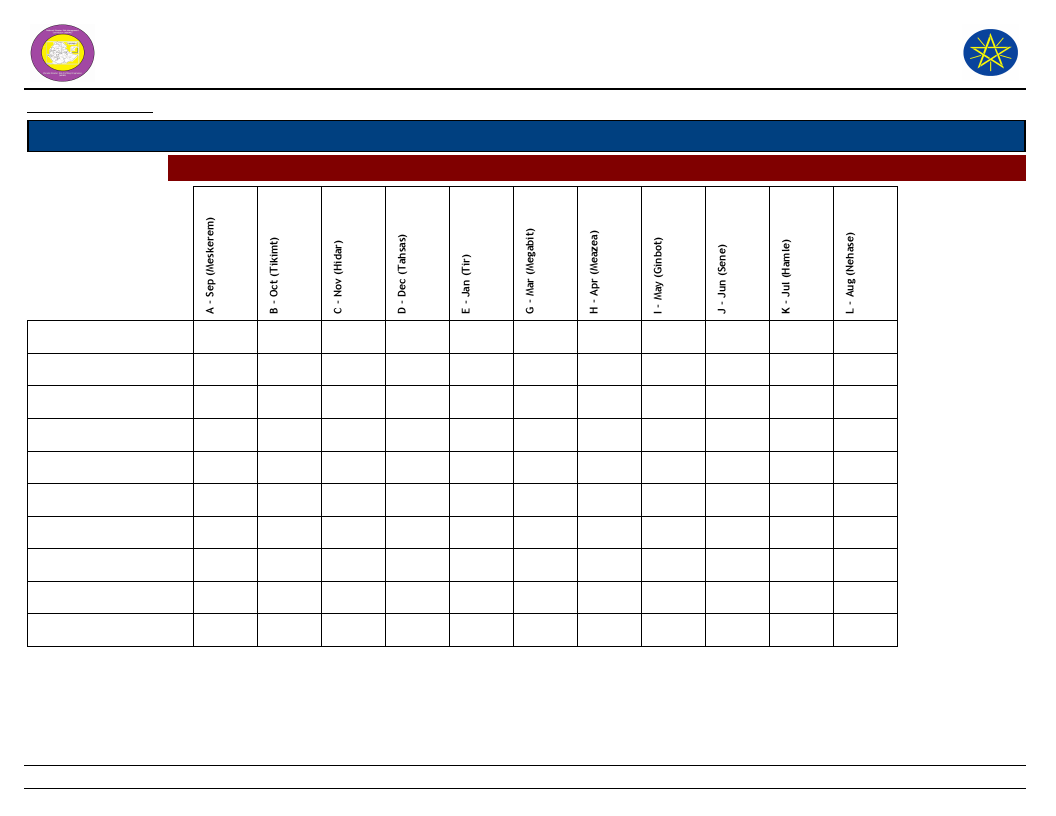
Wereda Disaster
Risk Profile
Data_Collected_Date
Region S.N.N.P
Selected Indictor:
Zone GURAGE
Months of Occurrence of Frequent Disasters
National Disaster Risk Management
Commission (NDRMC)
Tuesday, July 9, 2019
Wereda MESKAN
Conflicts
Crop diseases
Drought
Flood
Frost / Cold waves
Heavy Rain
Landslide
Livestock diseases
No Disaster
Storms / hail storm
100.00
1.47
1.47
12.50
2.94
8.82
23.53
8.82
17.65
38.24
2.94
2.94
38.24
19.12
17.65
5.88
10.29
20.00
3.64
20.00
34.55
21.82
66.67
33.33
100.00
100.00
6.25
12.50
6.25
50.00
12.50
100.00
33.33
66.67
48
Page 1 of 1
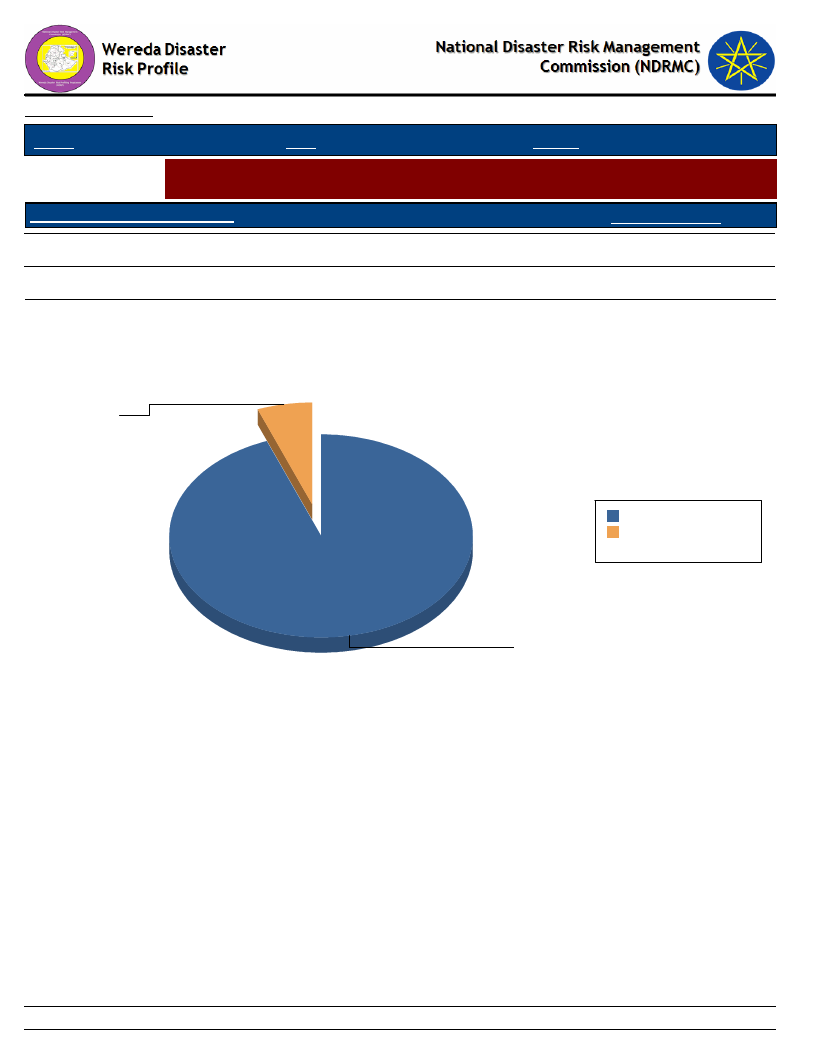
Data_Collected_Date
Tuesday, July 9, 2019
Region S.N.N.P
Zone GURAGE
Wereda MESKAN
Selected Indictor:
Conflicts: Perception of households on conflict issues - Is conflict an issue in this
community?
Is Conflict an Issue in Community?
Response_Percent
Yes
5.96
No
94.04
Is Conflict an Issue in Community?
Yes
6.0
No
94.0
No 94.0 94.0%
Yes 6.0 6.0%
Total: 100 100.0%
49
Page 1 of 1
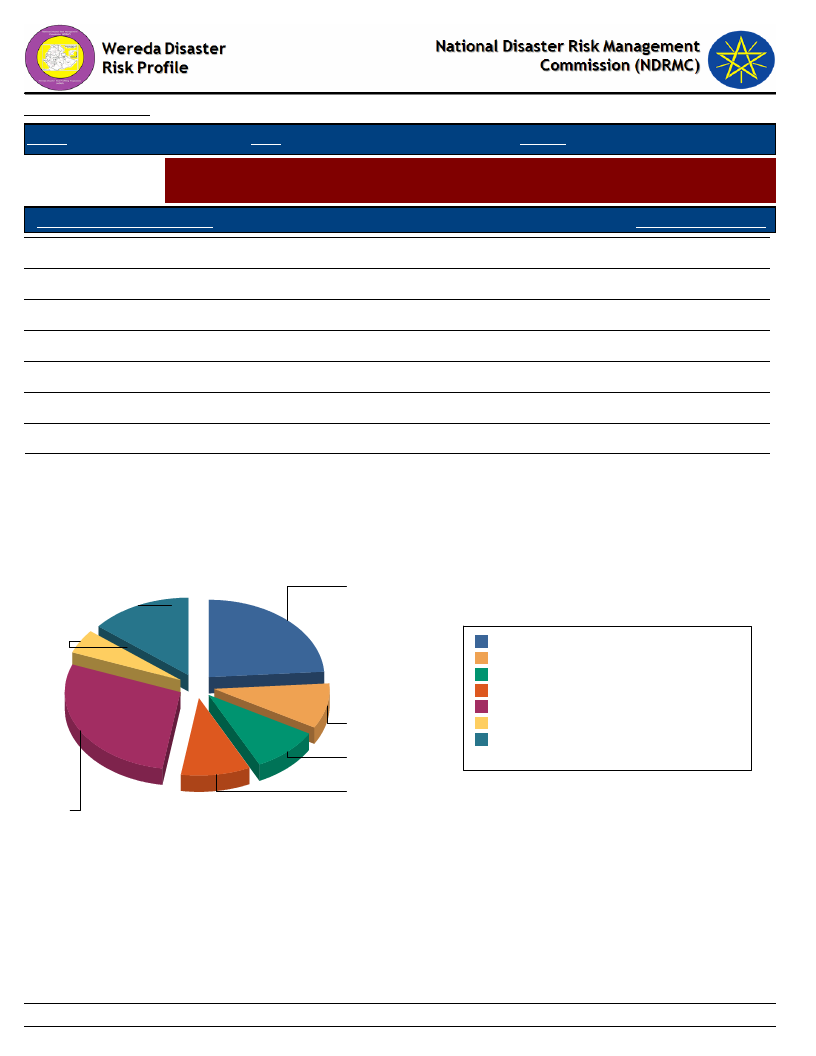
Data_Collected_Date
Region S.N.N.P
Zone GURAGE
Tuesday, July 9, 2019
Wereda MESKAN
Selected Indictor:
Conflicts: Perception of households on conflict issues - Who To Turn To in case
of Conflict?
Who To Turn During Conflict?
Response_Percentage
Family members
9.52
Elders
23.81
Wereda administration
14.29
Police
28.57
Militia
9.52
Regional representatives
4.76
Other
9.52
Who To Turn During Conflict?
Wereda administration
14
Regional
representatives
5
Police
29
Elders
24
Family members
10
Militia
10
Other
10
Elders
Family members
Militia
Other
Police
Regional representatives
Wereda administration
24 23.8%
10 9.5%
10 9.5%
10 9.5%
29 28.6%
5 4.8%
14 14.3%
Total:
100 100.0%
50
Page 1 of 1
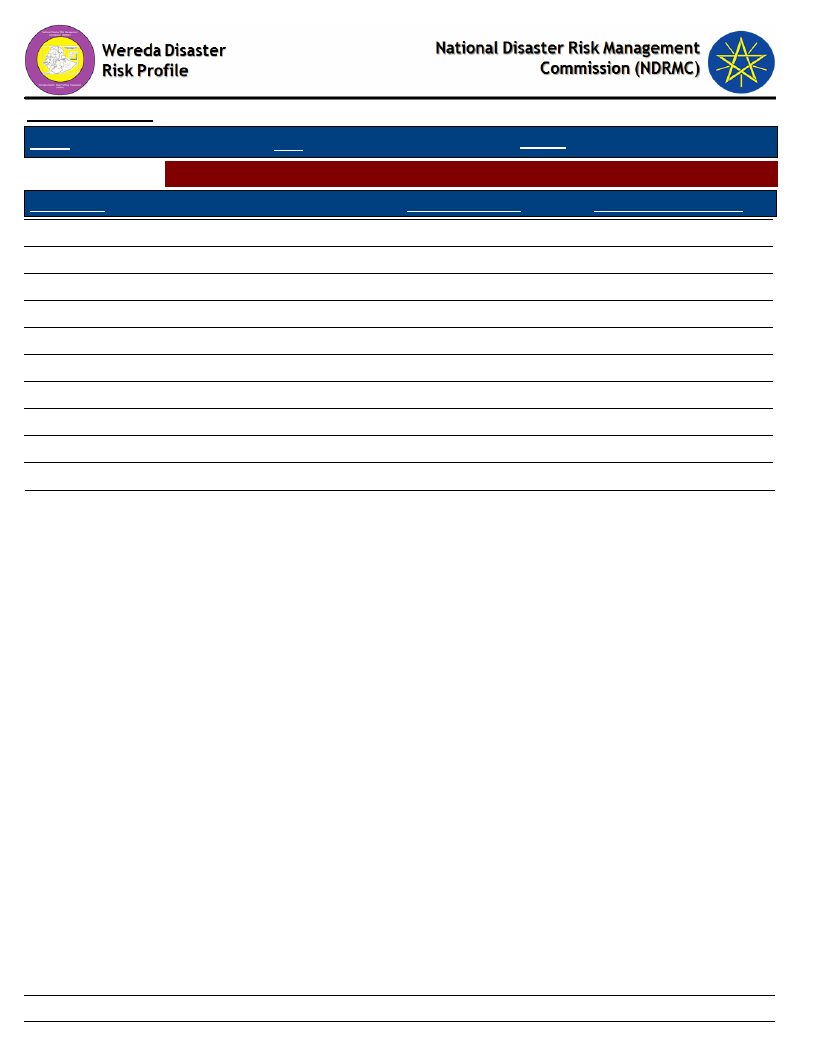
Data_Collected_Date
Region S.N.N.P
Zone GURAGE
Wereda MESKAN
Tuesday, July 9, 2019
Selected Indictor: Losses from Disasters - Losses from all disasters (household response in %)
Type of Loss
Main_Loss_Percent
Secondary_Loss_Percent
Physical damages on houses and property
8.43
4.21
Crop damage
65.45
4.49
Livestock damage
8.43
2.25
Death of household members
1.12
0.28
Illness/health problems
3.93
2.25
Loss of access to social services, including school
0.56
42.42
Loss of income
6.18
1.69
Loss of savings
0.56
1.40
Livestock were stolen
0.28
3.09
Lost access to grazing land
1.40
0.56
51
Page 1 of 1
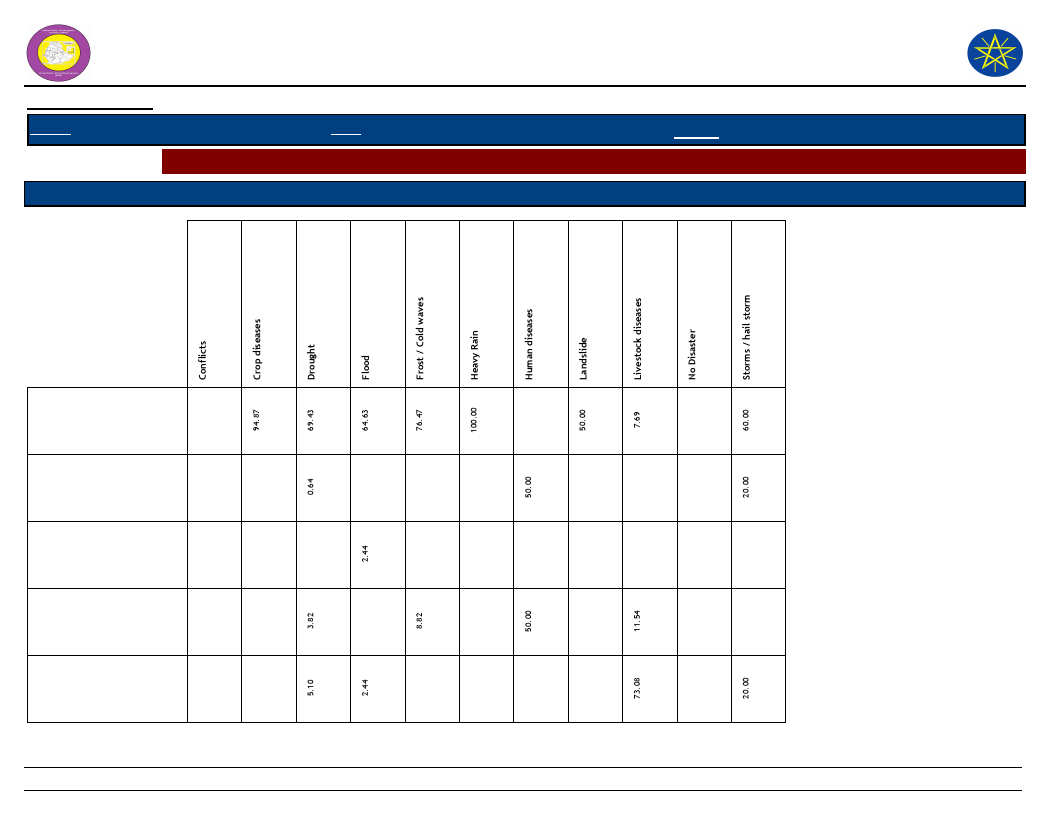
Wereda Disaster
Risk Profile
National Disaster Risk Management
Commission (NDRMC)
Data_Collected_Date
Region S.N.N.P
Zone GURAGE
Wereda MESKAN
Tuesday, July 9, 2019
Selected Indictor: Losses from Disasters - Main Losses by Type of Disasters (household response in %)
Type of Loss
Type of Disasters which mainly caused Listed Losses
Crop damage
Death of household
members
Had to flee/change
residence area
Illness/health problems
Livestock damage
52
Page 1 of 3
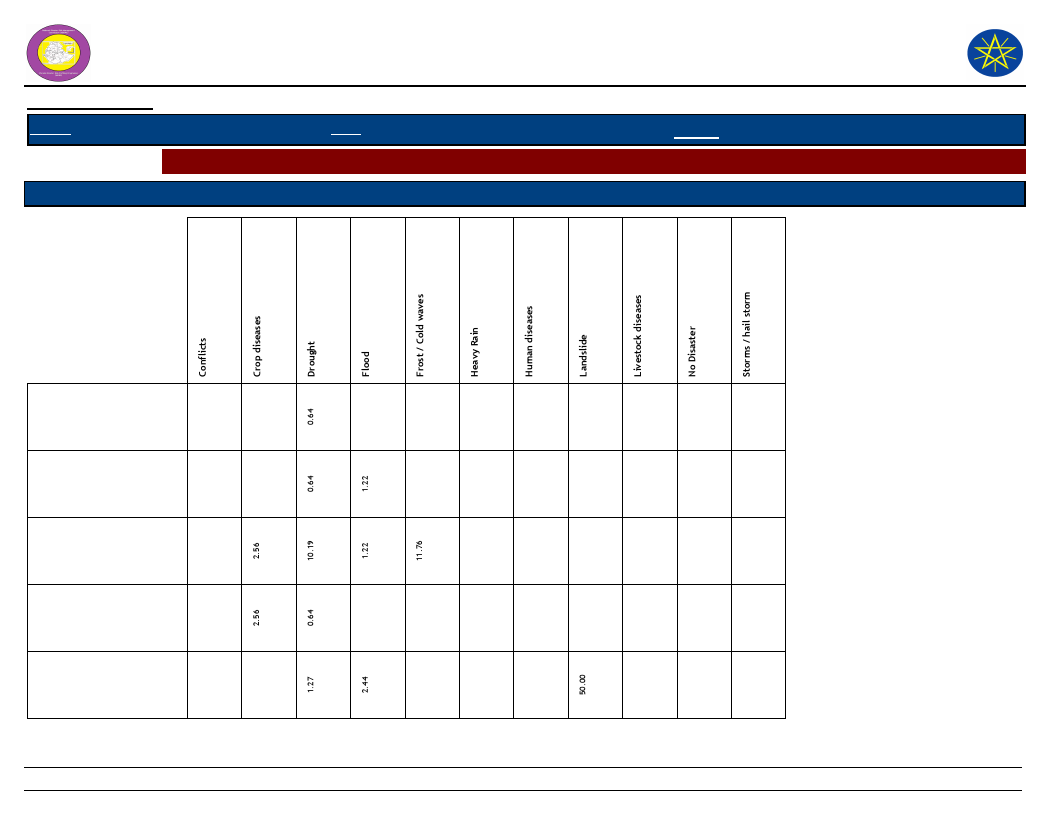
Wereda Disaster
Risk Profile
National Disaster Risk Management
Commission (NDRMC)
Data_Collected_Date
Region S.N.N.P
Zone GURAGE
Wereda MESKAN
Tuesday, July 9, 2019
Selected Indictor: Losses from Disasters - Main Losses by Type of Disasters (household response in %)
Type of Loss
Type of Disasters which mainly caused Listed Losses
Livestock were stolen
Loss of access to social
services, including
school
Loss of income
Loss of savings
Lost access to grazing
land
53
Page 2 of 3
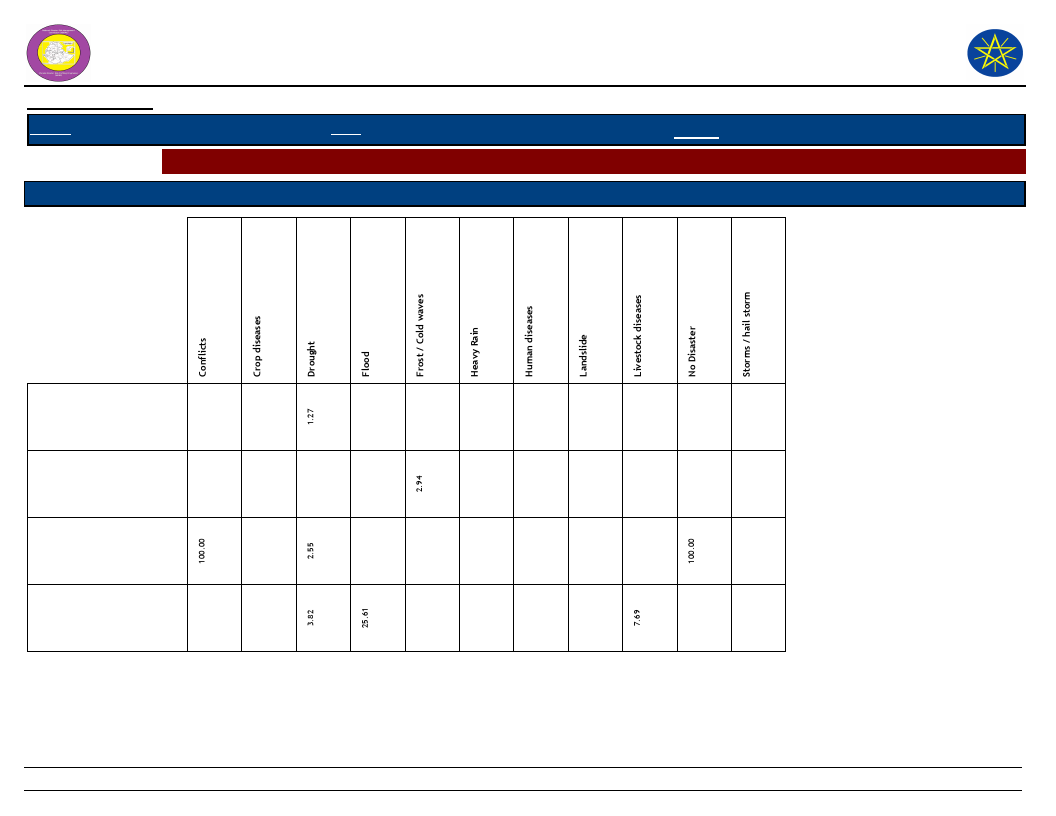
Wereda Disaster
Risk Profile
National Disaster Risk Management
Commission (NDRMC)
Data_Collected_Date
Region S.N.N.P
Zone GURAGE
Wereda MESKAN
Tuesday, July 9, 2019
Selected Indictor: Losses from Disasters - Main Losses by Type of Disasters (household response in %)
Type of Loss
Type of Disasters which mainly caused Listed Losses
Lost access to water
source
No Losses
Other losses/damages
Physical damages on
houses and property
54
Page 3 of 3
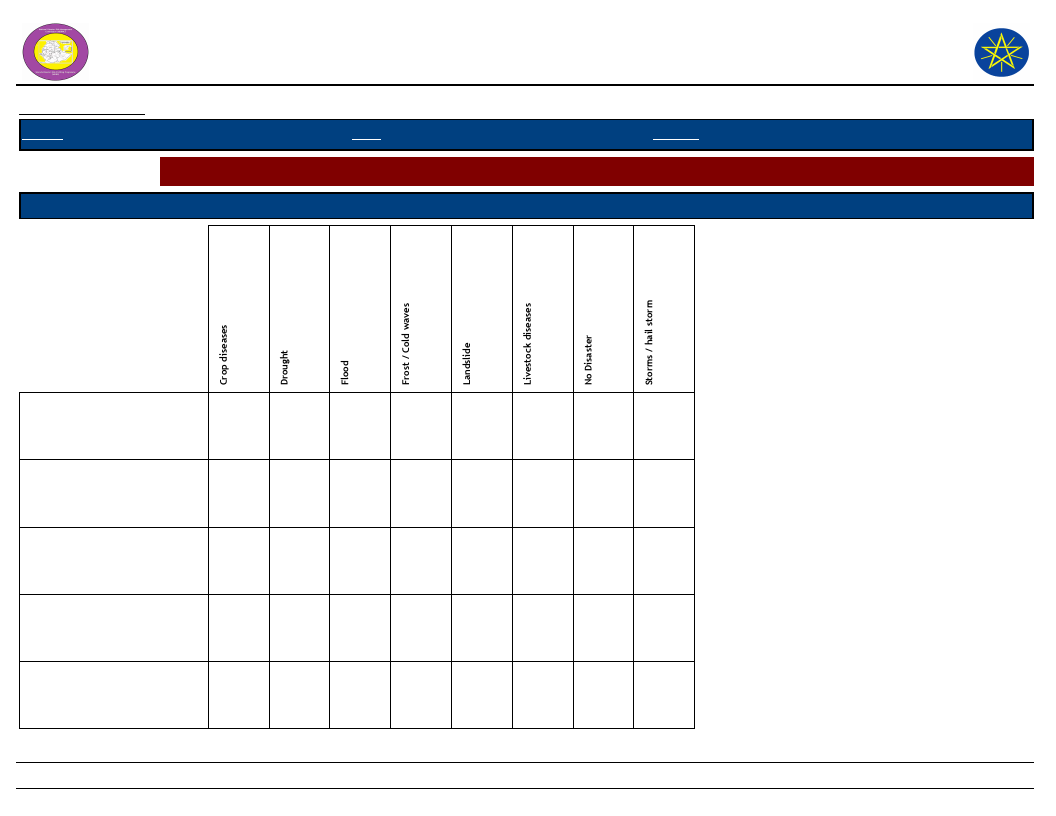
Wereda Disaster Risk
Profile
Data_Collected_Date
Region S.N.N.P
Zone GURAGE
National Disaster Risk Management
Commission (NDRMC)
Wereda MESKAN
Tuesday, July 9, 2019
Selected Indictor: Losses from Disasters - Secondary Losses by Type of Disasters (household response in %)
Type of Loss
Type of Disasters which caused Listed Secondary Losses
Crop damage
3.03
3.37
16.00
12.00
Death of household
members
Had to flee/change
residence area
Illness/health problems
4.00
2.00
5.00
4.49
8.00
Livestock damage
3.03
5.62
2.00
55
50.00
Page 1 of 2
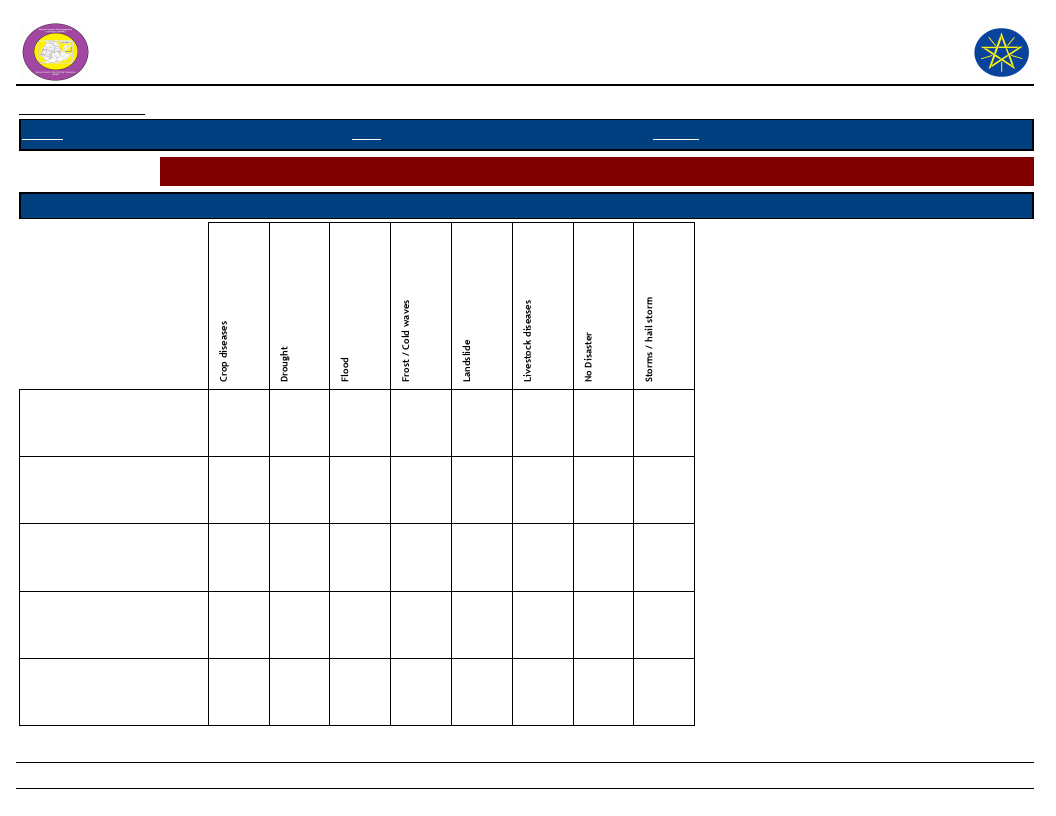
Wereda Disaster Risk
Profile
Data_Collected_Date
Region S.N.N.P
Zone GURAGE
National Disaster Risk Management
Commission (NDRMC)
Wereda MESKAN
Tuesday, July 9, 2019
Selected Indictor: Losses from Disasters - Secondary Losses by Type of Disasters (household response in %)
Type of Loss
Type of Disasters which caused Listed Secondary Losses
Loss of income
Loss of savings
Lost access to grazing land
Lost access to water source
Physical damages on houses
and property
90.91
61.80
46.00
84.00
100.00
90.00
100.00
50.00
3.03
3.37
2.00
5.00
2.25
6.00
12.36
6.74
18.00
56
Page 2 of 2
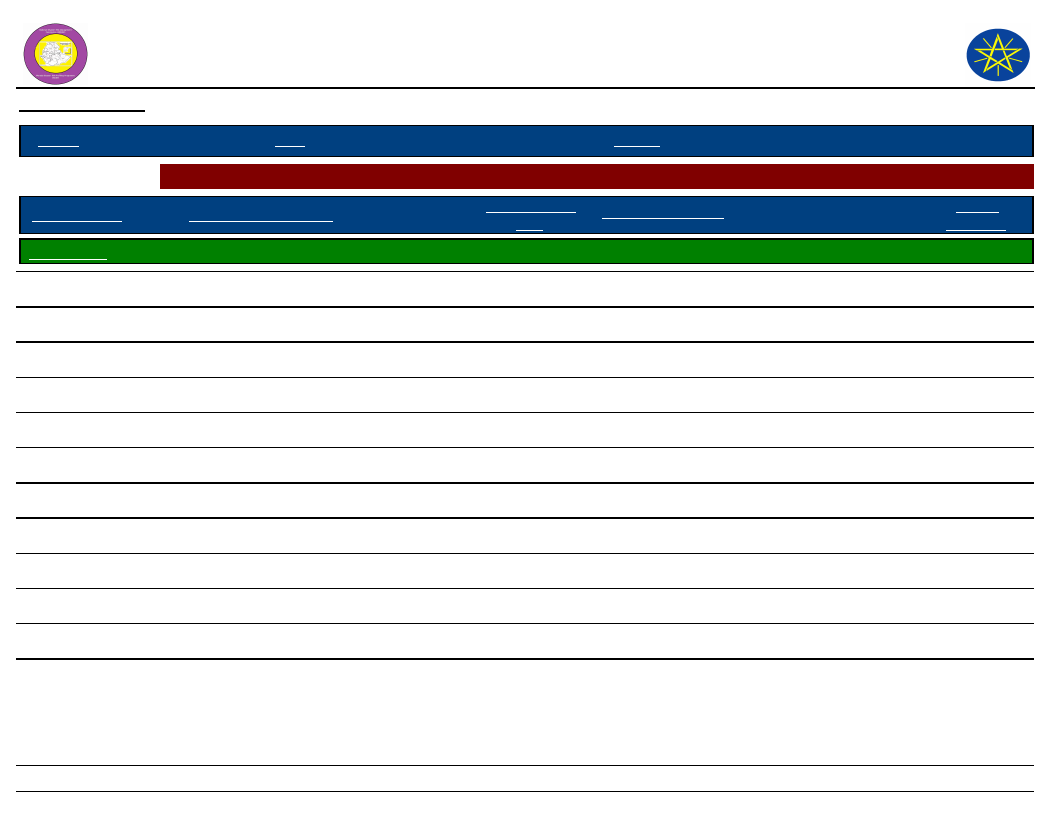
Wereda Disaster
Risk Profile
Data_Collected_Date
National Disaster Risk Management
Commission (NDRMC)
Tuesday, July 9, 2019
Region S.N.N.P
Zone GURAGE
Wereda MESKAN
Selected Indictor: Seasonal Calendar for Hazards, Activities and Income Level By Kebele
Month of Hazard
Major_Problems /Disasters
Hazard Severity
Rank
Agricultural_Activities
Kebele Name BATI FATO
E - Jan (Tir)
Frost
2
Harvesting
Income
Level Rank
2nd
F - Feb (Yekatit)
Shortage of rain
2
Land preparation
4th
G - Mar (Megabit)
Human disease
2
Land preparation, sowing
6th
H - Apr (Meazea)
Shortage of food
3
Land preparation, sowing
7th
I - May (Ginbot)
Shortage of food
3
Sowing
8th
J - Jun (Sene)
Shortage of food
3
Sowing
10th
K - Jul (Hamle)
Livestock disease
2
Land management
12th
L - Aug (Nehase)
Shortage of food
2
Land management
11th
A - Sep (Meskerem)
Shortage of food
3
Weeding
11th
B - Oct (Tikimt)
Human disease
2
Weeding
5th
C - Nov (Hidar)
Unconditional rain
3
Harvesting
1st
D - Dec (Tahsas)
Unconditional rain
3
Harvesting
1st
NOTE: Hazard Severity Rank helps prioritize the more severe hazards that have occurred in the months of disaster occurrence, 3 being the worst and 1
the least severe hazards.
57
Page 1 of 30
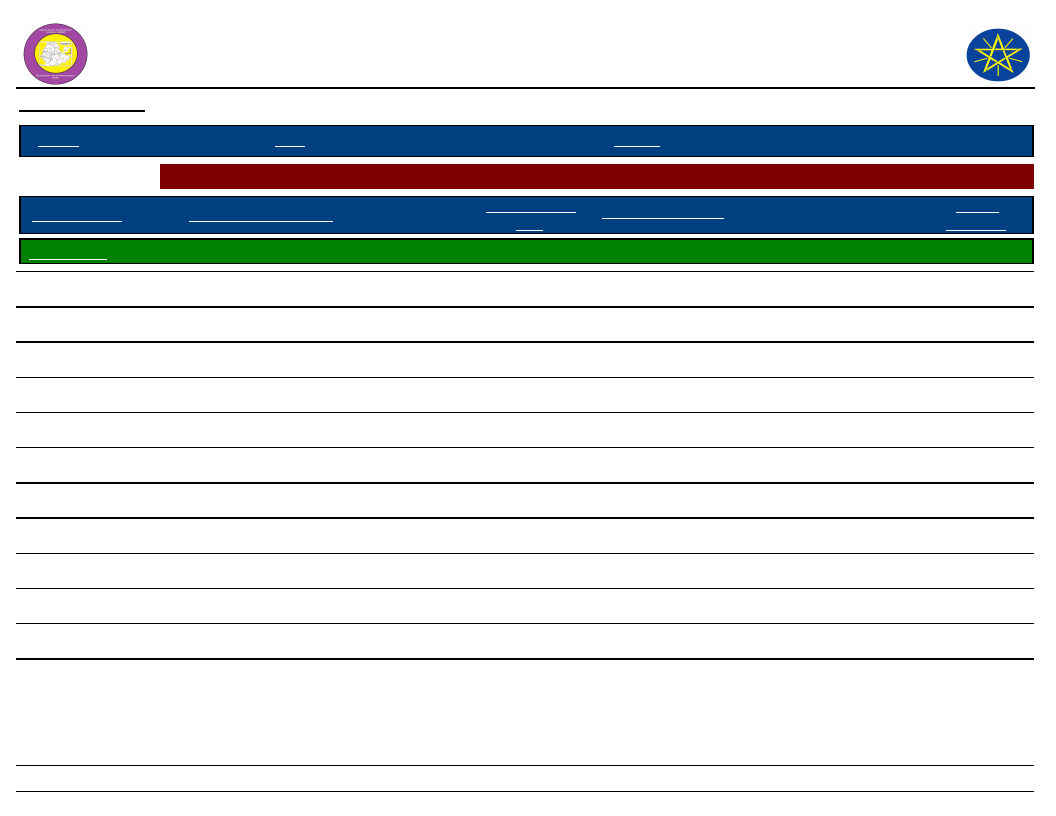
Wereda Disaster
Risk Profile
Data_Collected_Date
National Disaster Risk Management
Commission (NDRMC)
Tuesday, July 9, 2019
Region S.N.N.P
Zone GURAGE
Wereda MESKAN
Selected Indictor: Seasonal Calendar for Hazards, Activities and Income Level By Kebele
Month of Hazard
Major_Problems /Disasters
Hazard Severity
Rank
Agricultural_Activities
Kebele Name BATI LEJANO
E - Jan (Tir)
Frost
3
Threshing
Income
Level Rank
1st
F - Feb (Yekatit)
Livestock disease
1
Tillage
5th
G - Mar (Megabit)
Drought
2
Tillage
6th
H - Apr (Meazea)
Drought
3
Sowing
7th
I - May (Ginbot)
Livestock disease
2
Sowing
8th
J - Jun (Sene)
Livestock disease
3
Weeding
9th
K - Jul (Hamle)
Crop disease
2
Sowing
10th
L - Aug (Nehase)
Crop disease
1
Weeding
11th
A - Sep (Meskerem)
Human disease
1
Weeding
12th
B - Oct (Tikimt)
Human disease
2
Fattening
3rd
C - Nov (Hidar)
Crop disease
1
Livestock activities
4th
D - Dec (Tahsas)
Frost
2
Harvesting
2nd
NOTE: Hazard Severity Rank helps prioritize the more severe hazards that have occurred in the months of disaster occurrence, 3 being the worst and 1
the least severe hazards.
58
Page 2 of 30
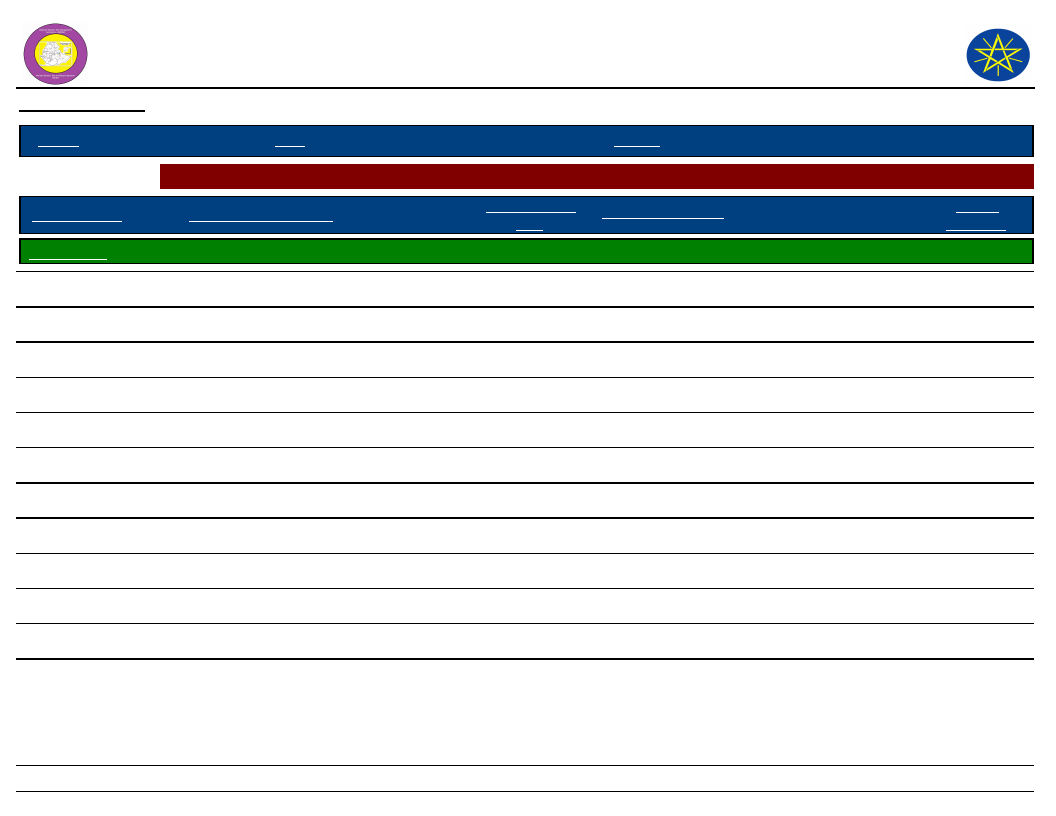
Wereda Disaster
Risk Profile
Data_Collected_Date
National Disaster Risk Management
Commission (NDRMC)
Tuesday, July 9, 2019
Region S.N.N.P
Zone GURAGE
Wereda MESKAN
Selected Indictor: Seasonal Calendar for Hazards, Activities and Income Level By Kebele
Month of Hazard
Major_Problems /Disasters
Hazard Severity
Rank
Agricultural_Activities
Kebele Name BECHE BULCHANO
E - Jan (Tir)
Frost
3
Harvesting livestock feed
Income
Level Rank
6th
F - Feb (Yekatit)
Shortage of food
2
Sowing
7th
G - Mar (Megabit)
Shortage of food
3
Sowing
8th
H - Apr (Meazea)
Shortage of food
3
Sowing
9th
I - May (Ginbot)
Shortage of food
3
Sowing
4th
J - Jun (Sene)
Shortage of food
3
Sowing
5th
K - Jul (Hamle)
Shortage of food
3
Weeding
10th
L - Aug (Nehase)
Shortage of food
3
Weeding
12th
A - Sep (Meskerem)
Shortage of food
3
Weeding
11th
B - Oct (Tikimt)
Shortage of food
3
Harvesting
1st
C - Nov (Hidar)
---------
Harvesting
2nd
D - Dec (Tahsas)
---------
Harvesting
3rd
NOTE: Hazard Severity Rank helps prioritize the more severe hazards that have occurred in the months of disaster occurrence, 3 being the worst and 1
the least severe hazards.
59
Page 3 of 30
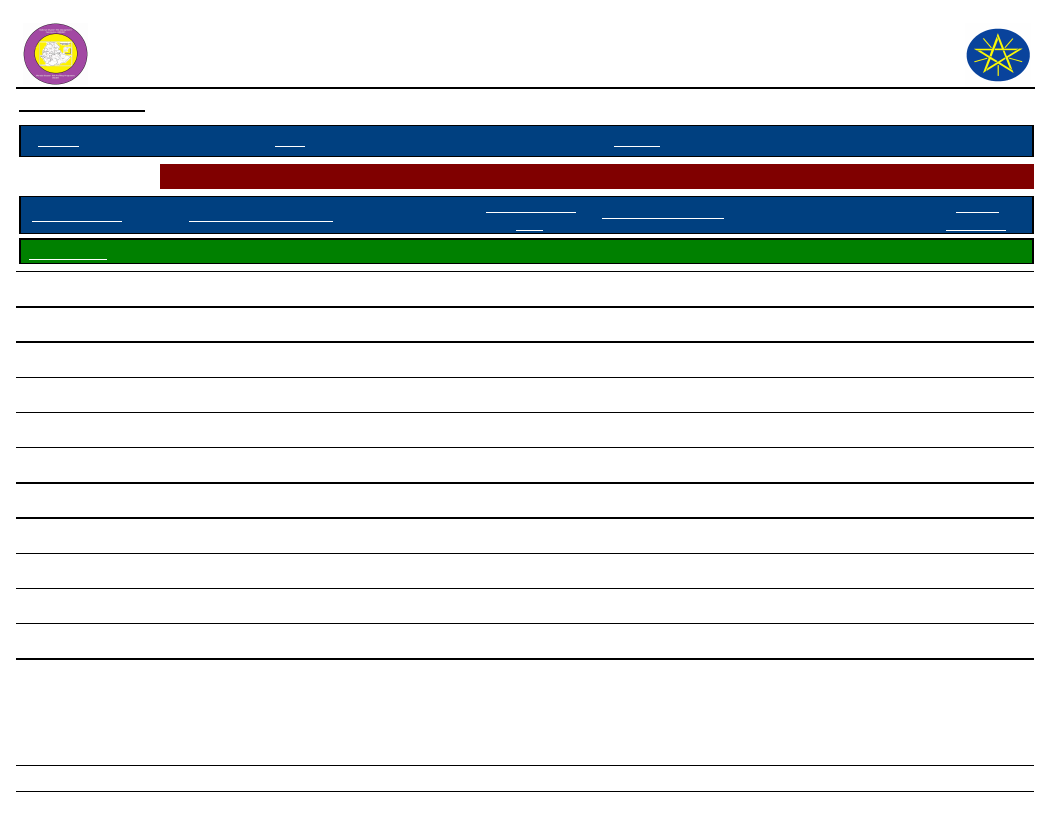
Wereda Disaster
Risk Profile
Data_Collected_Date
National Disaster Risk Management
Commission (NDRMC)
Tuesday, July 9, 2019
Region S.N.N.P
Zone GURAGE
Wereda MESKAN
Selected Indictor: Seasonal Calendar for Hazards, Activities and Income Level By Kebele
Month of Hazard
Major_Problems /Disasters
Hazard Severity
Rank
Agricultural_Activities
Kebele Name BERESA
E - Jan (Tir)
Livestock disease
2
Trashing
Income
Level Rank
1st
F - Feb (Yekatit)
Shortage of water
2
Land preparation
3rd
G - Mar (Megabit)
---------
Ploughing
4th
H - Apr (Meazea)
Flood
3
Sowing
5th
I - May (Ginbot)
Flood
2
Ploughing
6th
J - Jun (Sene)
Crop disease
1
Sowing
7th
K - Jul (Hamle)
Drought
3
Sowing
8th
L - Aug (Nehase)
Flood
2
Weeding
9th
A - Sep (Meskerem)
Frost
1
Weeding
10th
B - Oct (Tikimt)
Livestock disease
2
Chemical spray
11th
C - Nov (Hidar)
Frost
1
---------
D - Dec (Tahsas)
Frost
2
Harvesting
2nd
NOTE: Hazard Severity Rank helps prioritize the more severe hazards that have occurred in the months of disaster occurrence, 3 being the worst and 1
the least severe hazards.
60
Page 4 of 30
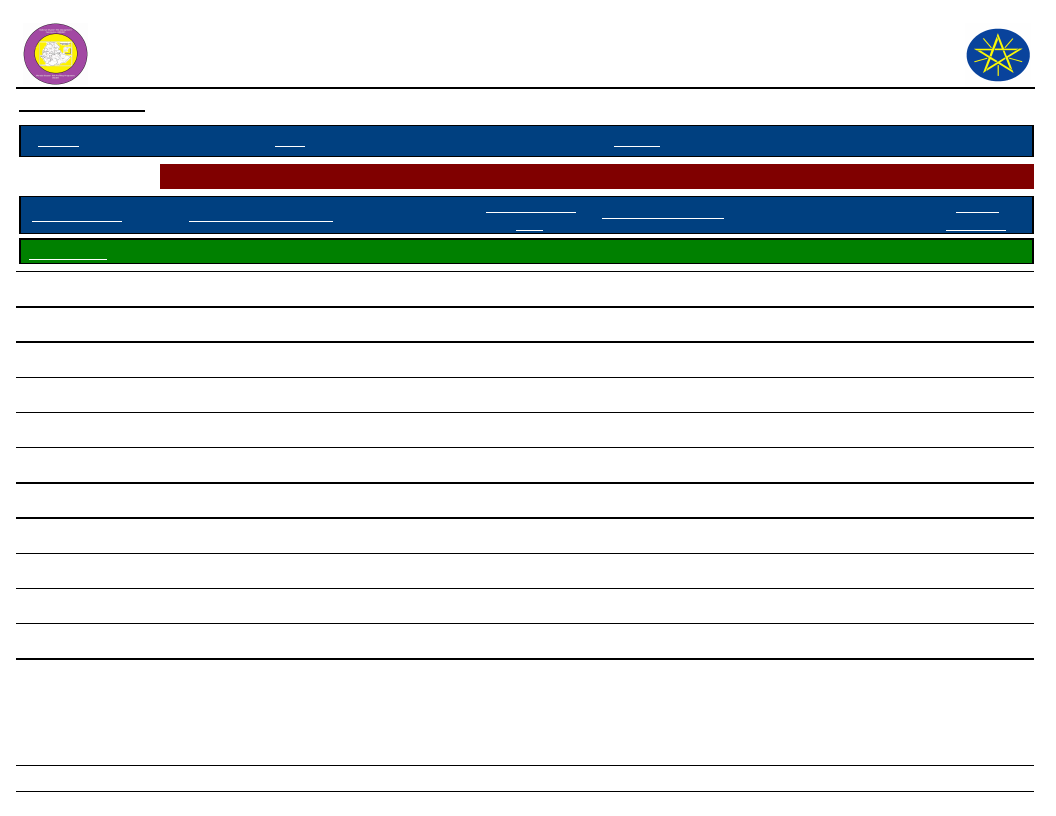
Wereda Disaster
Risk Profile
Data_Collected_Date
National Disaster Risk Management
Commission (NDRMC)
Tuesday, July 9, 2019
Region S.N.N.P
Zone GURAGE
Wereda MESKAN
Selected Indictor: Seasonal Calendar for Hazards, Activities and Income Level By Kebele
Month of Hazard
Major_Problems /Disasters
Hazard Severity
Rank
Agricultural_Activities
Kebele Name DEBO TUTO
E - Jan (Tir)
Livestock disease
2
Threshing
Income
Level Rank
5th
F - Feb (Yekatit)
Shortage of water
3
Cultivate
6th
G - Mar (Megabit)
---------
Ploughing
7th
H - Apr (Meazea)
Flood
2
Livestock activity
2nd
I - May (Ginbot)
Crop disease
1
Ploughing
8th
J - Jun (Sene)
Drought
2
Sowing
9th
K - Jul (Hamle)
Flood
3
Weeding
10th
L - Aug (Nehase)
Snow
1
Weeding
11th
A - Sep (Meskerem)
Livestock disease
2
Spray chemicals
12th
B - Oct (Tikimt)
Livestock disease
1
Livestock activities
3rd
C - Nov (Hidar)
Frost
1
Livestock activities
4th
D - Dec (Tahsas)
Frost
2
Harvesting
1st
NOTE: Hazard Severity Rank helps prioritize the more severe hazards that have occurred in the months of disaster occurrence, 3 being the worst and 1
the least severe hazards.
61
Page 5 of 30
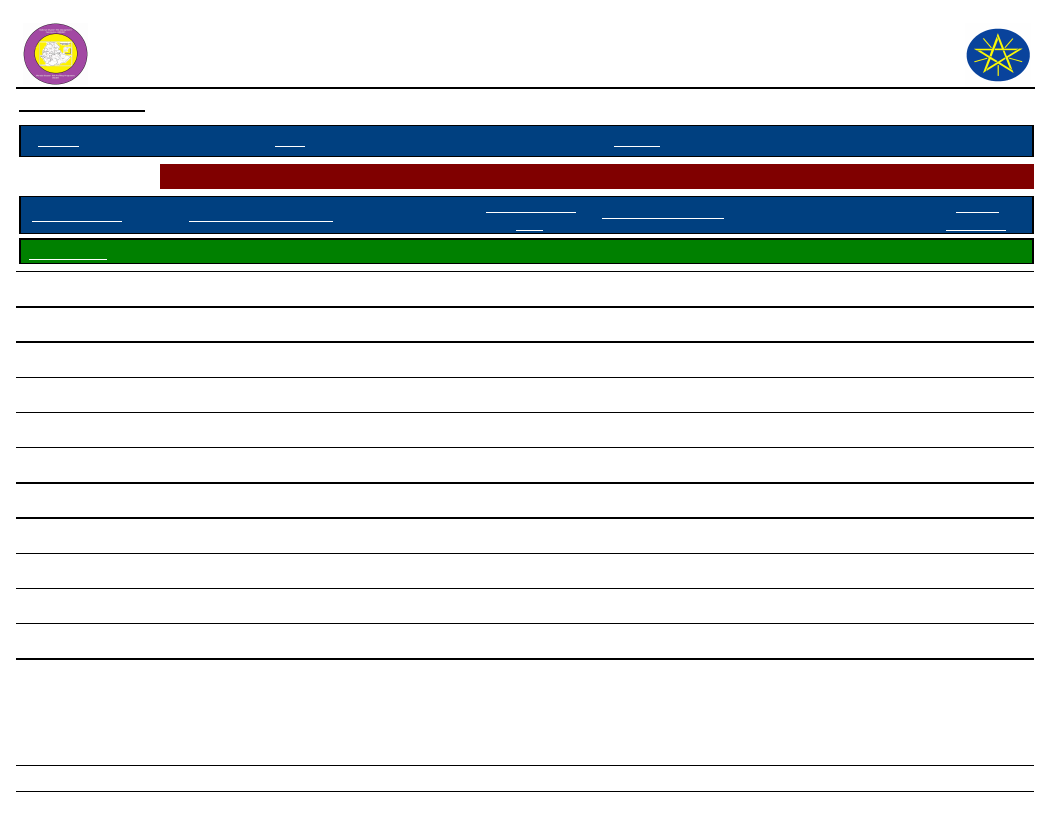
Wereda Disaster
Risk Profile
Data_Collected_Date
National Disaster Risk Management
Commission (NDRMC)
Tuesday, July 9, 2019
Region S.N.N.P
Zone GURAGE
Wereda MESKAN
Selected Indictor: Seasonal Calendar for Hazards, Activities and Income Level By Kebele
Month of Hazard
Major_Problems /Disasters
Hazard Severity
Rank
Agricultural_Activities
Kebele Name DEBUB SHERSHERA
E - Jan (Tir)
Shortage of water
2
Harvesting
Income
Level Rank
2nd
F - Feb (Yekatit)
Shortage of water
3
Harvesting
3rd
G - Mar (Megabit)
Shortage of water
3
Land preparation
4th
H - Apr (Meazea)
Shortage of food
3
Sowing
5th
I - May (Ginbot)
Shortage of food
3
Sowing
6th
J - Jun (Sene)
Shortage of food
3
Land preparation
9th
K - Jul (Hamle)
Shortage of food
3
Sowing
1st
L - Aug (Nehase)
Shortage of food
3
Sowing
11th
A - Sep (Meskerem)
Shortage of food
3
Weeding, fattening
12th
B - Oct (Tikimt)
Shortage of food
3
Selling
10th
C - Nov (Hidar)
Shortage of money
2
Harvesting
8th
D - Dec (Tahsas)
Shortage of money
2
Harvesting
7th
NOTE: Hazard Severity Rank helps prioritize the more severe hazards that have occurred in the months of disaster occurrence, 3 being the worst and 1
the least severe hazards.
62
Page 6 of 30
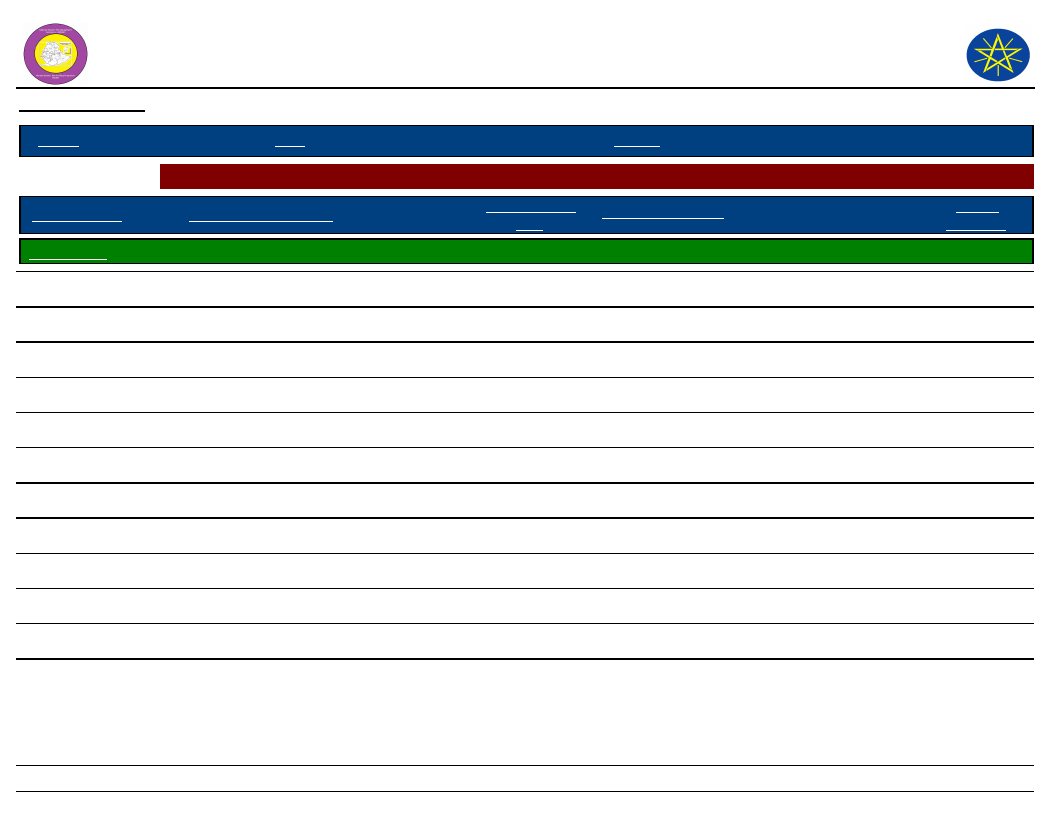
Wereda Disaster
Risk Profile
Data_Collected_Date
National Disaster Risk Management
Commission (NDRMC)
Tuesday, July 9, 2019
Region S.N.N.P
Zone GURAGE
Wereda MESKAN
Selected Indictor: Seasonal Calendar for Hazards, Activities and Income Level By Kebele
Month of Hazard
Major_Problems /Disasters
Hazard Severity
Rank
Agricultural_Activities
Kebele Name DEGAGOGOT
E - Jan (Tir)
Shortage of pasture
3
Planting enset
Income
Level Rank
1st
F - Feb (Yekatit)
Shortage of pasture
3
Ploughing
1st
G - Mar (Megabit)
---------
Ploughing
2nd
H - Apr (Meazea)
Flood
1
Ploughing
1st
I - May (Ginbot)
Livestock disease
3
Livestock activities
12th
J - Jun (Sene)
Flood
1
Crop sowing
12th
K - Jul (Hamle)
Flood
2
Planting forest seeds
12th
L - Aug (Nehase)
Flood
3
Weeding
12th
A - Sep (Meskerem)
---------
Weeding
12th
B - Oct (Tikimt)
---------
Harvesting
9th
C - Nov (Hidar)
Frost
2
Harvesting
3rd
D - Dec (Tahsas)
Frost
3
Threshing
1st
NOTE: Hazard Severity Rank helps prioritize the more severe hazards that have occurred in the months of disaster occurrence, 3 being the worst and 1
the least severe hazards.
63
Page 7 of 30
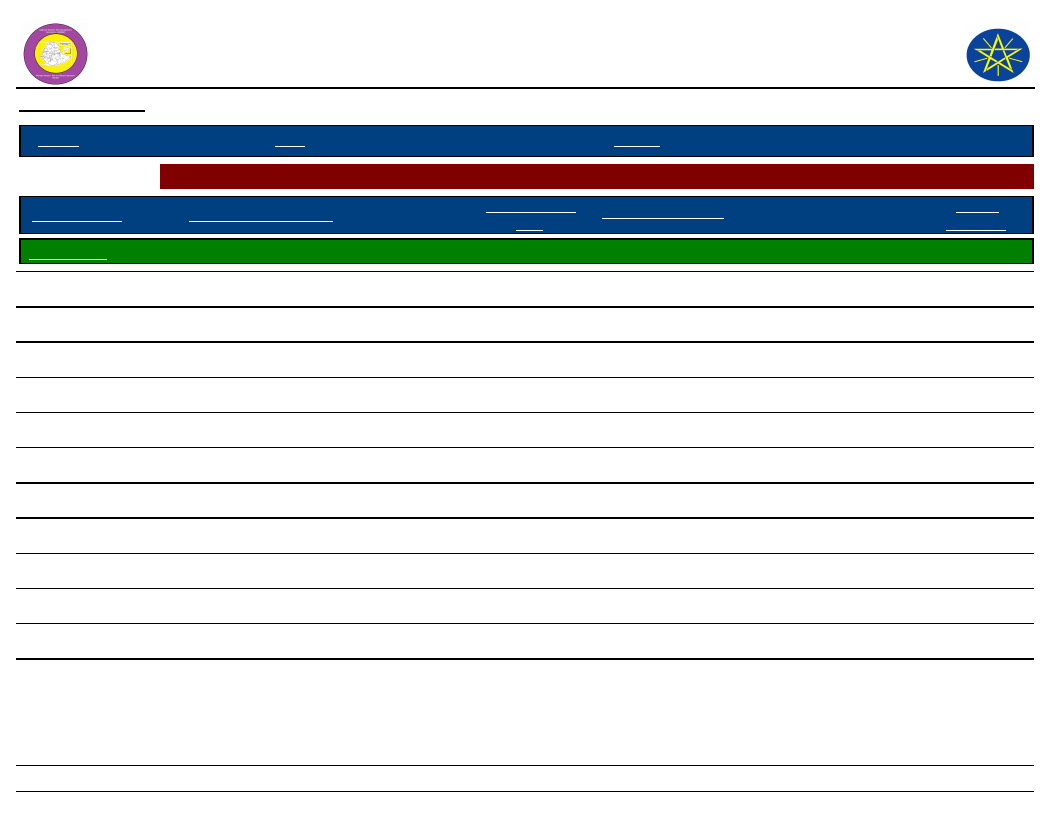
Wereda Disaster
Risk Profile
Data_Collected_Date
National Disaster Risk Management
Commission (NDRMC)
Tuesday, July 9, 2019
Region S.N.N.P
Zone GURAGE
Wereda MESKAN
Selected Indictor: Seasonal Calendar for Hazards, Activities and Income Level By Kebele
Month of Hazard
Major_Problems /Disasters
Hazard Severity
Rank
Agricultural_Activities
Kebele Name DIDA
E - Jan (Tir)
Frost
3
Harvesting
Income
Level Rank
2nd
F - Feb (Yekatit)
Frost
1
Sowing
3rd
G - Mar (Megabit)
Shortage of food
3
Land preparation
5th
H - Apr (Meazea)
Shortage of food
3
Land preparation
6th
I - May (Ginbot)
Shortage of pasture
2
Sowing
7th
J - Jun (Sene)
Shortage of food
2
Sowing
8th
K - Jul (Hamle)
Shortage of food
3
Sowing
10th
L - Aug (Nehase)
Shortage of food
3
Sowing
12th
A - Sep (Meskerem)
Shortage of food
3
Weeding
11th
B - Oct (Tikimt)
Shortage of money
3
Weeding
9th
C - Nov (Hidar)
Shortage of money
2
Harvesting
4th
D - Dec (Tahsas)
Human disease
1
Harvesting
1st
NOTE: Hazard Severity Rank helps prioritize the more severe hazards that have occurred in the months of disaster occurrence, 3 being the worst and 1
the least severe hazards.
64
Page 8 of 30
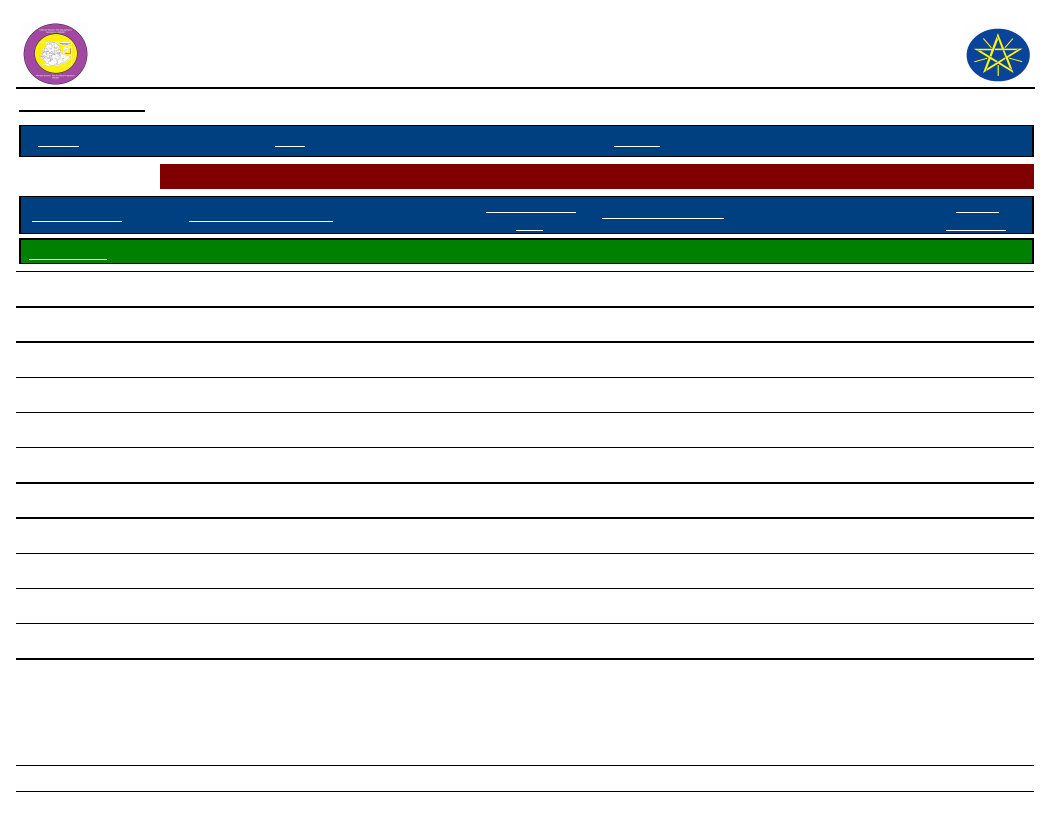
Wereda Disaster
Risk Profile
Data_Collected_Date
National Disaster Risk Management
Commission (NDRMC)
Tuesday, July 9, 2019
Region S.N.N.P
Zone GURAGE
Wereda MESKAN
Selected Indictor: Seasonal Calendar for Hazards, Activities and Income Level By Kebele
Month of Hazard
Major_Problems /Disasters
Hazard Severity
Rank
Agricultural_Activities
Kebele Name DIRAMA
E - Jan (Tir)
Human and livestock disease
2
Harvesting
Income
Level Rank
1st
F - Feb (Yekatit)
Drought
1
Harvesting
2nd
G - Mar (Megabit)
Drought
2
Land preparation
5th
H - Apr (Meazea)
Shortage of food
2
Land preparation
6th
I - May (Ginbot)
drought
3
Sowing
7th
J - Jun (Sene)
Shortage of food
3
Sowing
9th
K - Jul (Hamle)
Shortage of food
5
Sowing
10th
L - Aug (Nehase)
Shortage of food
3
Sowing, weeding
11th
A - Sep (Meskerem)
Shortage of food
3
Weeding
12th
B - Oct (Tikimt)
Drought
3
Weeding
8th
C - Nov (Hidar)
Human disease
2
Harvesting
4th
D - Dec (Tahsas)
Human disease
2
Harvesting
3rd
NOTE: Hazard Severity Rank helps prioritize the more severe hazards that have occurred in the months of disaster occurrence, 3 being the worst and 1
the least severe hazards.
65
Page 9 of 30
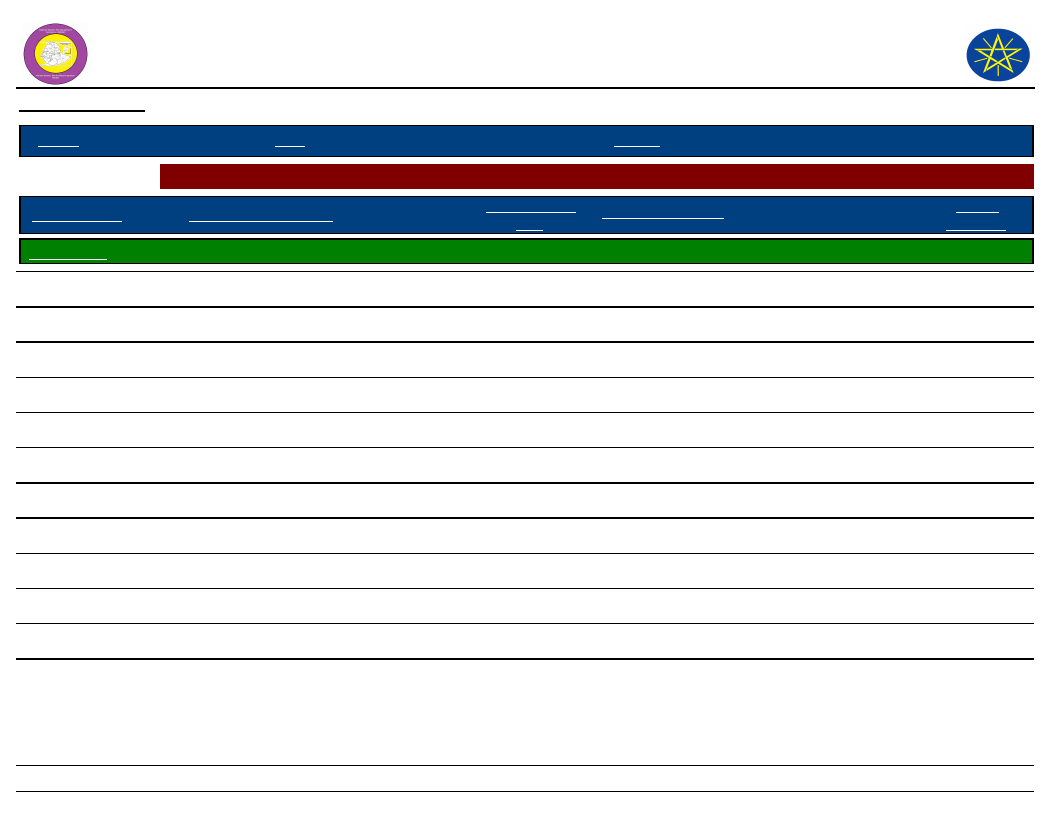
Wereda Disaster
Risk Profile
Data_Collected_Date
National Disaster Risk Management
Commission (NDRMC)
Tuesday, July 9, 2019
Region S.N.N.P
Zone GURAGE
Wereda MESKAN
Selected Indictor: Seasonal Calendar for Hazards, Activities and Income Level By Kebele
Month of Hazard
Major_Problems /Disasters
Hazard Severity
Rank
Agricultural_Activities
Kebele Name DOBENA
E - Jan (Tir)
Shortage of water
3
Harvesting
Income
Level Rank
2nd
F - Feb (Yekatit)
Shortage of water
3
Harvesting
4th
G - Mar (Megabit)
Shortage of water
3
Sowing
6th
H - Apr (Meazea)
Shortage of rain
2
Land preparation
7th
I - May (Ginbot)
Shortage of rain
3
Sowing
8th
J - Jun (Sene)
Shortage of food and water
3
Sowing
9th
K - Jul (Hamle)
Shortage of food and water
3
Sowing
10th
L - Aug (Nehase)
Shortage of food and water
3
Sowing
11th
A - Sep (Meskerem)
Shortage of food and water
3
Weeding
12th
B - Oct (Tikimt)
Shortage of food and water
3
Management
5th
C - Nov (Hidar)
Shortage of food and water
2
Harvesting
3rd
D - Dec (Tahsas)
Shortage of food and water
2
Harvesting
1st
NOTE: Hazard Severity Rank helps prioritize the more severe hazards that have occurred in the months of disaster occurrence, 3 being the worst and 1
the least severe hazards.
66
Page 10 of 30
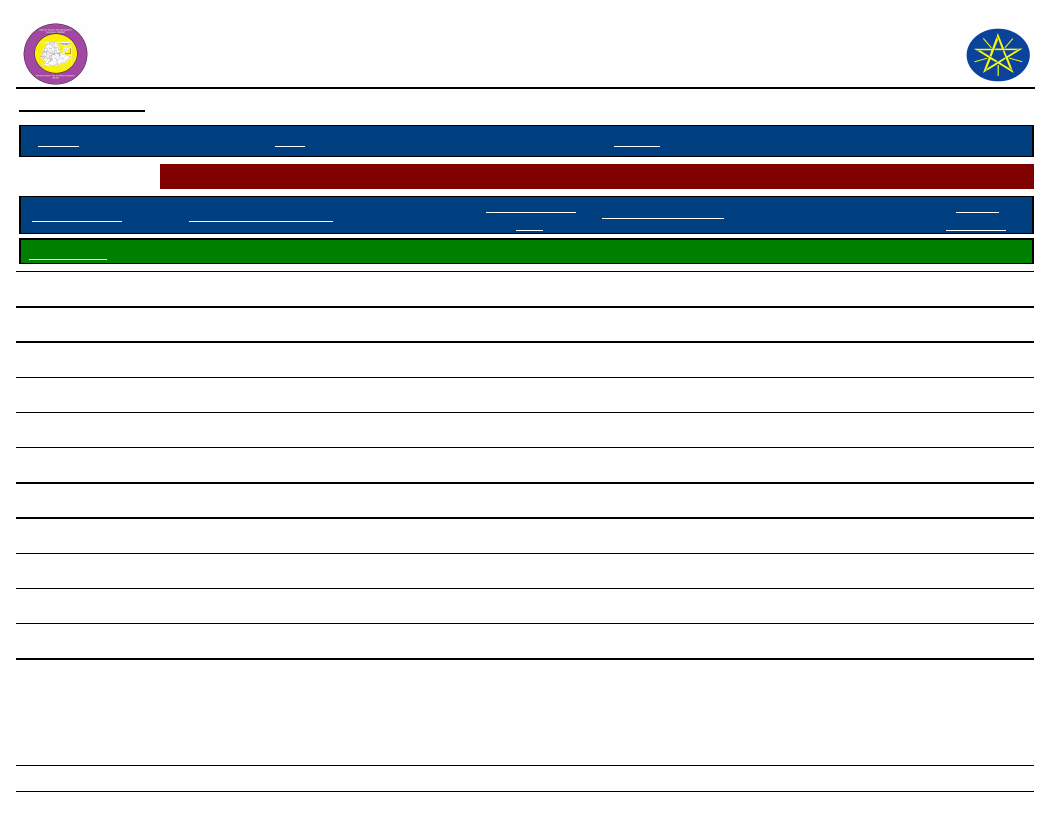
Wereda Disaster
Risk Profile
Data_Collected_Date
National Disaster Risk Management
Commission (NDRMC)
Tuesday, July 9, 2019
Region S.N.N.P
Zone GURAGE
Wereda MESKAN
Selected Indictor: Seasonal Calendar for Hazards, Activities and Income Level By Kebele
Month of Hazard
Major_Problems /Disasters
Hazard Severity
Rank
Agricultural_Activities
Kebele Name GIDENA ABORAT
E - Jan (Tir)
Frost
3
Harvesting, land preparation
Income
Level Rank
1st
F - Feb (Yekatit)
Frost
3
Harvesting
2nd
G - Mar (Megabit)
Shortage of rain fall
2
Land preparation
3rd
H - Apr (Meazea)
Shortage of rain fall
3
Sowing
4th
I - May (Ginbot)
Shortage of rain fall
3
Sowing
5th
J - Jun (Sene)
Shortage of rain fall
2
Land preparation
9th
K - Jul (Hamle)
Shortage of food
1
Ploughing, sowing
10th
L - Aug (Nehase)
Shortage of food
1
Sowing
12th
A - Sep (Meskerem)
Livestock disease
2
Weeding
11th
B - Oct (Tikimt)
Crop disease
2
Weeding
8th
C - Nov (Hidar)
Human disease
2
---------
D - Dec (Tahsas)
Frost
3
Harvesting
6th
NOTE: Hazard Severity Rank helps prioritize the more severe hazards that have occurred in the months of disaster occurrence, 3 being the worst and 1
the least severe hazards.
67
Page 11 of 30
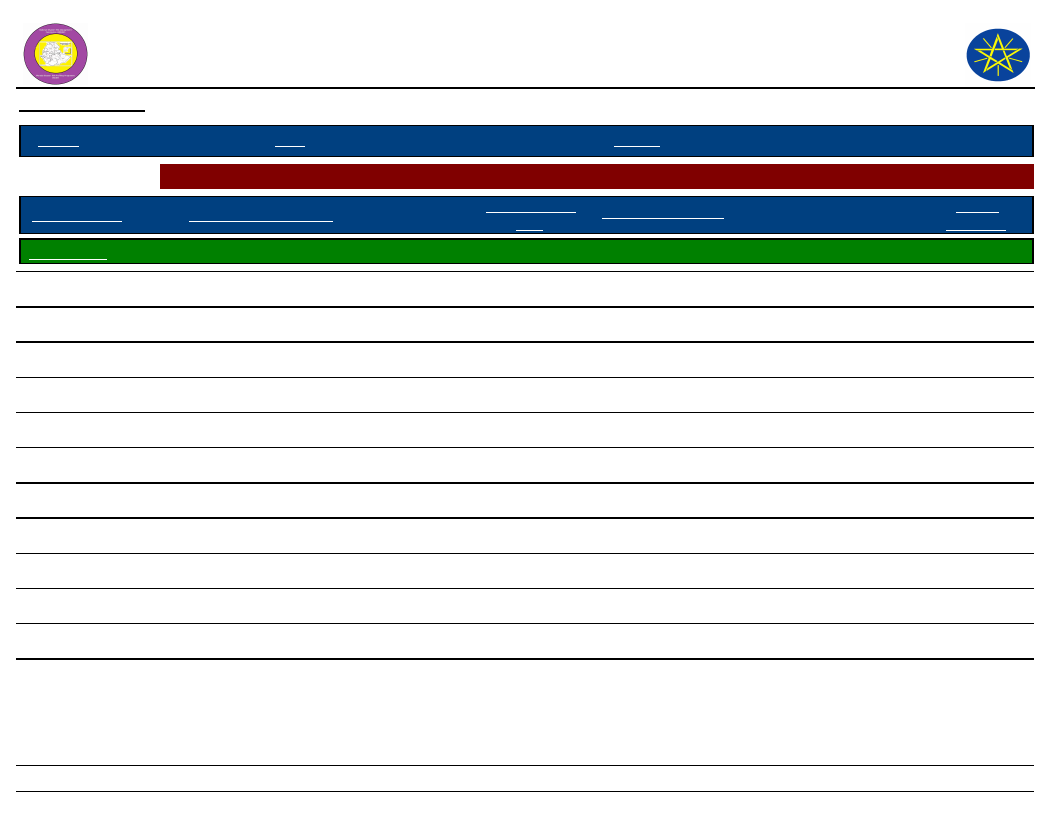
Wereda Disaster
Risk Profile
Data_Collected_Date
National Disaster Risk Management
Commission (NDRMC)
Tuesday, July 9, 2019
Region S.N.N.P
Zone GURAGE
Wereda MESKAN
Selected Indictor: Seasonal Calendar for Hazards, Activities and Income Level By Kebele
Month of Hazard
Major_Problems /Disasters
Hazard Severity
Rank
Agricultural_Activities
Kebele Name GOYBAN
E - Jan (Tir)
Shortage of water
3
Enset planting
Income
Level Rank
1st
F - Feb (Yekatit)
Shortage of water
3
Ploughing
2nd
G - Mar (Megabit)
Shortage of water
3
Ploughing
2nd
H - Apr (Meazea)
Shortage of water
3
Sowing
6th
I - May (Ginbot)
Loss of income
3
Ploughing
7th
J - Jun (Sene)
Livestock disease
3
Sowing
6th
K - Jul (Hamle)
Shortage of food
3
Sowing, weeding
5th
L - Aug (Nehase)
Shortage of food
3
Livestock activities
6th
A - Sep (Meskerem)
Shortage of food
3
Ploughing
7th
B - Oct (Tikimt)
Shortage of food
3
Ploughing
5th
C - Nov (Hidar)
Shortage of food
3
Harvesting
2nd
D - Dec (Tahsas)
---------
Harvesting
1st
NOTE: Hazard Severity Rank helps prioritize the more severe hazards that have occurred in the months of disaster occurrence, 3 being the worst and 1
the least severe hazards.
68
Page 12 of 30
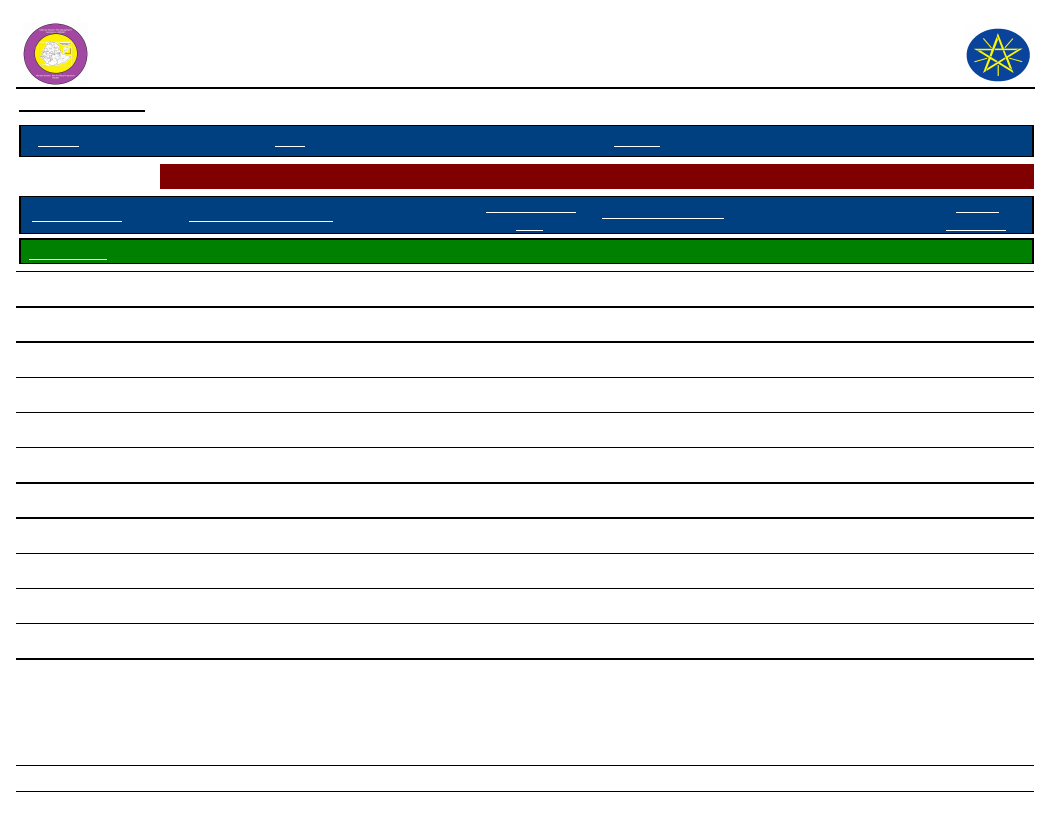
Wereda Disaster
Risk Profile
Data_Collected_Date
National Disaster Risk Management
Commission (NDRMC)
Tuesday, July 9, 2019
Region S.N.N.P
Zone GURAGE
Wereda MESKAN
Selected Indictor: Seasonal Calendar for Hazards, Activities and Income Level By Kebele
Month of Hazard
Major_Problems /Disasters
Hazard Severity
Rank
Agricultural_Activities
Kebele Name ILE
E - Jan (Tir)
Frost
3
Threshing
Income
Level Rank
10th
F - Feb (Yekatit)
---------
Ploughing
5th
G - Mar (Megabit)
Livestock disease
1
Ploughing
6th
H - Apr (Meazea)
Drought
3
Sowing
7th
I - May (Ginbot)
Crop disease
2
Sowing
8th
J - Jun (Sene)
Flood
1
Weeding
9th
K - Jul (Hamle)
Flood
2
Sowing
10th
L - Aug (Nehase)
Crop disease
2
Weeding
11th
A - Sep (Meskerem)
Crop disease
1
Fattening
12th
B - Oct (Tikimt)
---------
Fattening
3rd
C - Nov (Hidar)
Frost
2
Harvesting
4th
D - Dec (Tahsas)
Frost
1
Harvesting
2nd
NOTE: Hazard Severity Rank helps prioritize the more severe hazards that have occurred in the months of disaster occurrence, 3 being the worst and 1
the least severe hazards.
69
Page 13 of 30
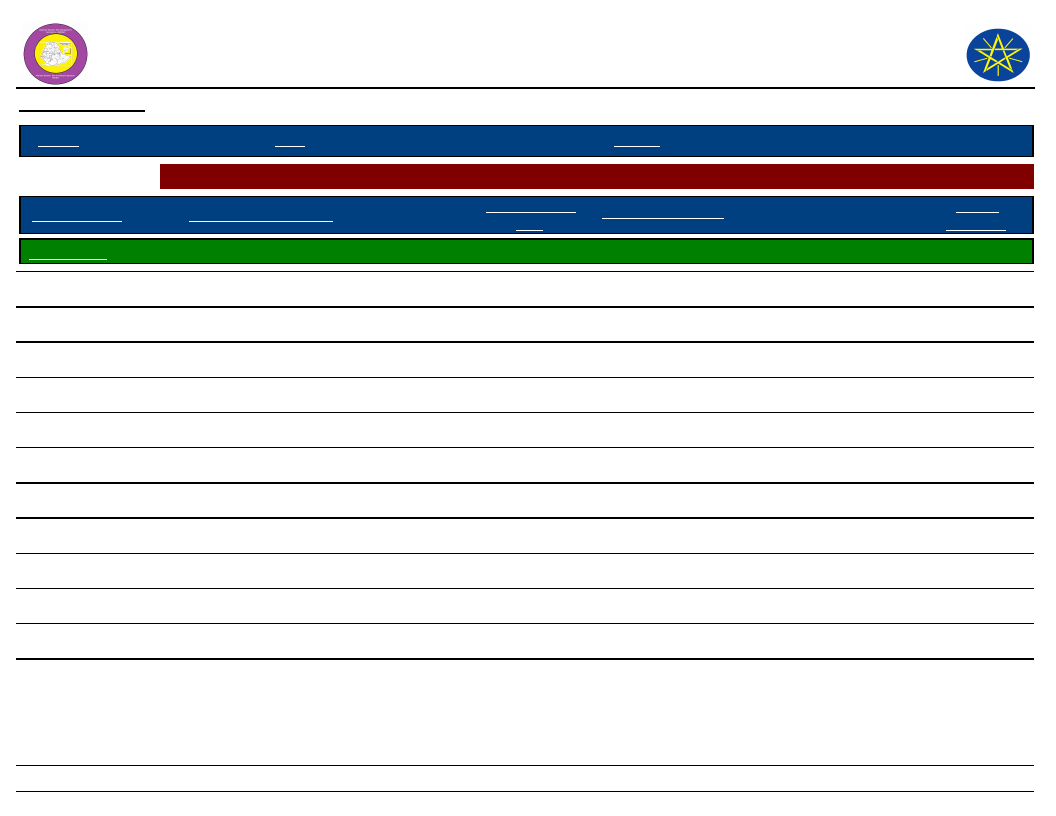
Wereda Disaster
Risk Profile
Data_Collected_Date
National Disaster Risk Management
Commission (NDRMC)
Tuesday, July 9, 2019
Region S.N.N.P
Zone GURAGE
Wereda MESKAN
Selected Indictor: Seasonal Calendar for Hazards, Activities and Income Level By Kebele
Month of Hazard
Major_Problems /Disasters
Hazard Severity
Rank
Agricultural_Activities
Kebele Name INSENO USME
E - Jan (Tir)
Frost
3
Threshing
Income
Level Rank
1st
F - Feb (Yekatit)
---------
Tillage
5th
G - Mar (Megabit)
---------
Tillage
6th
H - Apr (Meazea)
Drought
2
Sowing
7th
I - May (Ginbot)
Drought
3
Sowing
8th
J - Jun (Sene)
Livestock disease
2
Weeding
9th
K - Jul (Hamle)
Flood
3
Sowing
10th
L - Aug (Nehase)
Flood
2
Weeding
11th
A - Sep (Meskerem)
Crop disease
3
Weeding
12th
B - Oct (Tikimt)
Crop disease
2
Fattening
3rd
C - Nov (Hidar)
Frost
1
Pest control
4th
D - Dec (Tahsas)
Frost
2
Harvesting
2nd
NOTE: Hazard Severity Rank helps prioritize the more severe hazards that have occurred in the months of disaster occurrence, 3 being the worst and 1
the least severe hazards.
70
Page 14 of 30
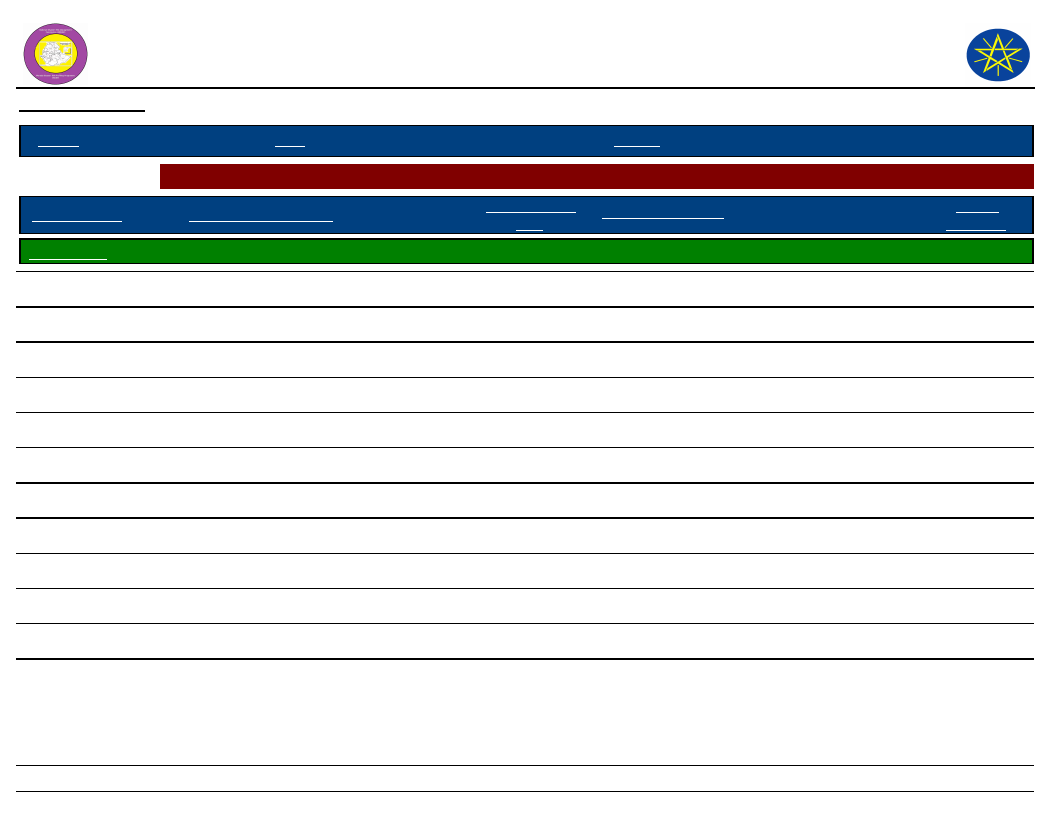
Wereda Disaster
Risk Profile
Data_Collected_Date
National Disaster Risk Management
Commission (NDRMC)
Tuesday, July 9, 2019
Region S.N.N.P
Zone GURAGE
Wereda MESKAN
Selected Indictor: Seasonal Calendar for Hazards, Activities and Income Level By Kebele
Month of Hazard
Major_Problems /Disasters
Hazard Severity
Rank
Agricultural_Activities
Kebele Name JOLE ANDENYA
E - Jan (Tir)
Frost
2
Crashing
Income
Level Rank
3rd
F - Feb (Yekatit)
---------
Land preparation
5th
G - Mar (Megabit)
Drought
2
Ploughing
6th
H - Apr (Meazea)
---------
Livestock activities
4th
I - May (Ginbot)
Flood
3
Ploughing
10th
J - Jun (Sene)
---------
Sowing
7th
K - Jul (Hamle)
---------
Weeding
8th
L - Aug (Nehase)
---------
Weeding
11th
A - Sep (Meskerem)
Human disease/malaria
1
Chemical spray
9th
B - Oct (Tikimt)
Livestock disease
2
Livestock activities
7th
C - Nov (Hidar)
Human disease/typhoid
1
12th
D - Dec (Tahsas)
---------
Harvesting
1st
NOTE: Hazard Severity Rank helps prioritize the more severe hazards that have occurred in the months of disaster occurrence, 3 being the worst and 1
the least severe hazards.
71
Page 15 of 30

Wereda Disaster
Risk Profile
Data_Collected_Date
National Disaster Risk Management
Commission (NDRMC)
Tuesday, July 9, 2019
Region S.N.N.P
Zone GURAGE
Wereda MESKAN
Selected Indictor: Seasonal Calendar for Hazards, Activities and Income Level By Kebele
Month of Hazard
Major_Problems /Disasters
Hazard Severity
Rank
Agricultural_Activities
Kebele Name JOLE HULETENYA
E - Jan (Tir)
Frost
3
Harvesting
Income
Level Rank
1st
F - Feb (Yekatit)
Frost
3
Harvesting
2nd
G - Mar (Megabit)
Shortage of food and feed
3
Land preparation
3rd
H - Apr (Meazea)
Shortage of food and feed
3
Land preparation
6th
I - May (Ginbot)
Shortage of money
2
Sowing
8th
J - Jun (Sene)
Shortage of food and feed
3
sowing
9th
K - Jul (Hamle)
Shortage of food and feed
3
Sowing
10th
L - Aug (Nehase)
Shortage of food
3
Sowing
11th
A - Sep (Meskerem)
Shortage of food
3
Weeding
12th
B - Oct (Tikimt)
Shortage of food
2
Weeding
7th
C - Nov (Hidar)
Shortage of money
2
Harvesting
5th
D - Dec (Tahsas)
Human disease
2
Harvesting
4th
NOTE: Hazard Severity Rank helps prioritize the more severe hazards that have occurred in the months of disaster occurrence, 3 being the worst and 1
the least severe hazards.
72
Page 16 of 30
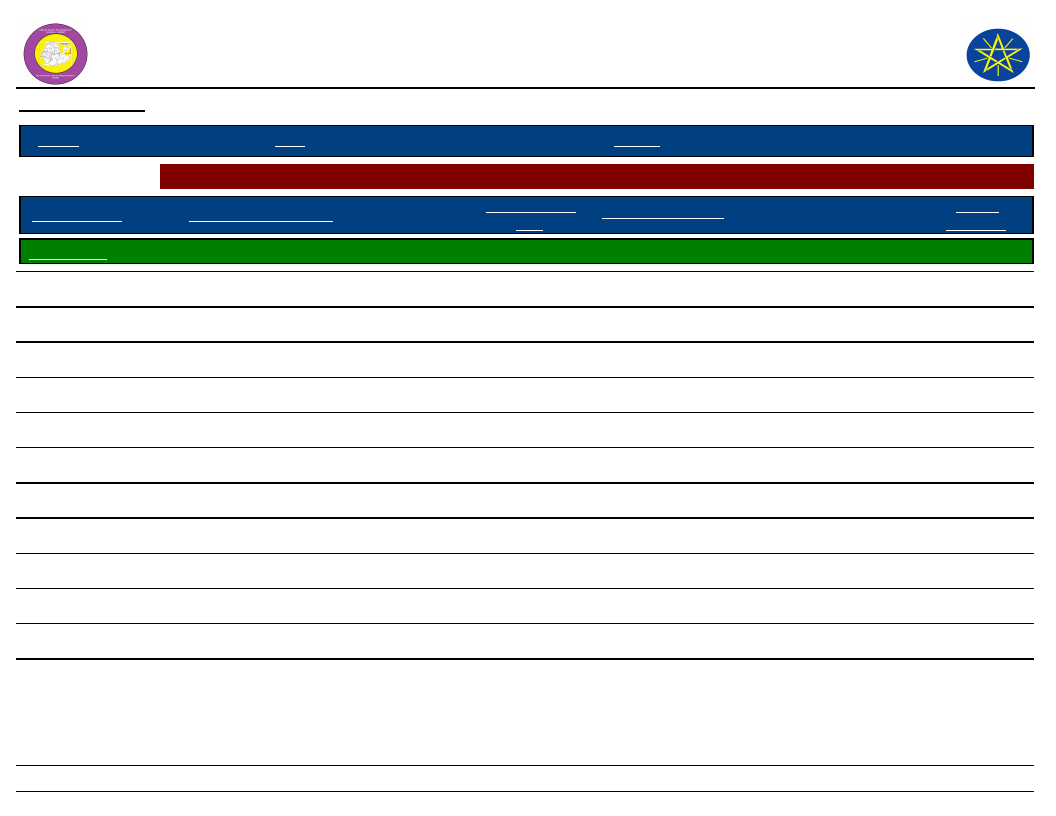
Wereda Disaster
Risk Profile
Data_Collected_Date
National Disaster Risk Management
Commission (NDRMC)
Tuesday, July 9, 2019
Region S.N.N.P
Zone GURAGE
Wereda MESKAN
Selected Indictor: Seasonal Calendar for Hazards, Activities and Income Level By Kebele
Month of Hazard
Major_Problems /Disasters
Hazard Severity
Rank
Agricultural_Activities
Kebele Name MEKICHO
E - Jan (Tir)
Frost
3
Harvesting, planting enset
Income
Level Rank
1st
F - Feb (Yekatit)
Shortage of water
2
Harvesting, planting enset
2nd
G - Mar (Megabit)
Shortage of food
2
Land preparation
4th
H - Apr (Meazea)
Shortage of food
2
Land preparation
5th
I - May (Ginbot)
Shortage of food
2
Sowing
6th
J - Jun (Sene)
Shortage of food
3
Sowing
8th
K - Jul (Hamle)
Shortage of food
3
Sowing
10th
L - Aug (Nehase)
Shortage of food
3
Sowing
12th
A - Sep (Meskerem)
Shortage of food
3
Weeding
11th
B - Oct (Tikimt)
Shortage of money
2
Management
9th
C - Nov (Hidar)
Frost
3
Harvesting
7th
D - Dec (Tahsas)
Frost
3
Harvesting
3rd
NOTE: Hazard Severity Rank helps prioritize the more severe hazards that have occurred in the months of disaster occurrence, 3 being the worst and 1
the least severe hazards.
73
Page 17 of 30
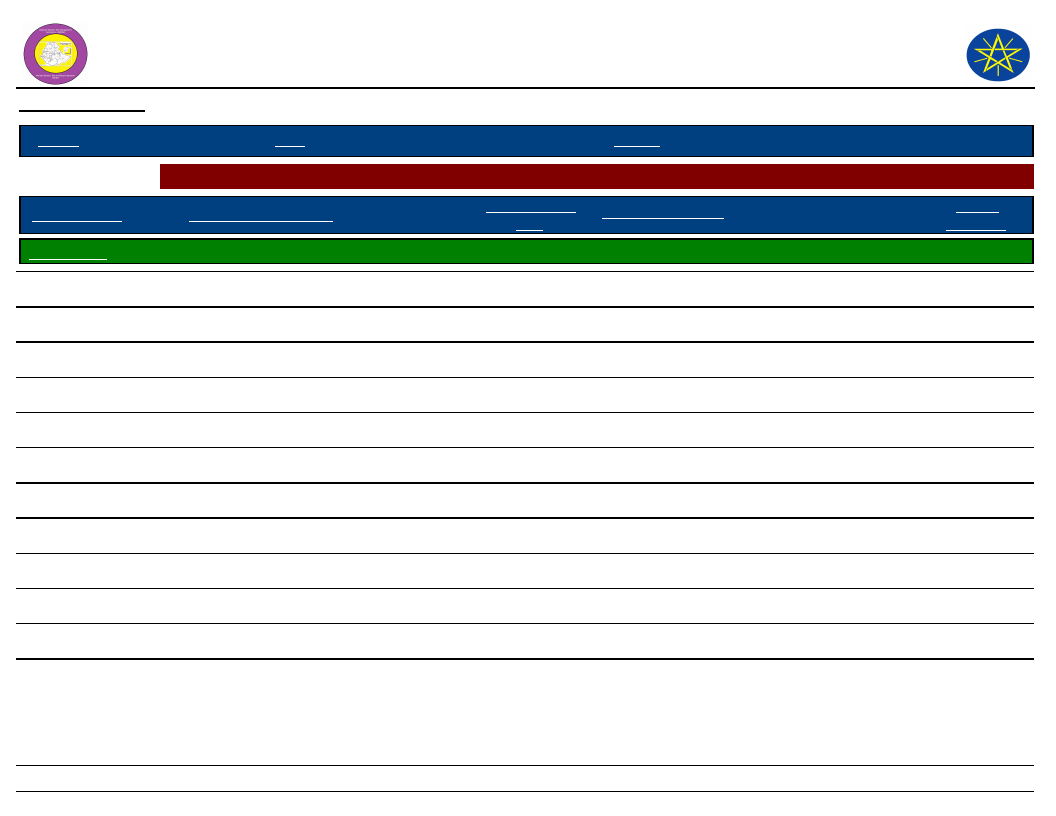
Wereda Disaster
Risk Profile
Data_Collected_Date
National Disaster Risk Management
Commission (NDRMC)
Tuesday, July 9, 2019
Region S.N.N.P
Zone GURAGE
Wereda MESKAN
Selected Indictor: Seasonal Calendar for Hazards, Activities and Income Level By Kebele
Month of Hazard
Major_Problems /Disasters
Hazard Severity
Rank
Agricultural_Activities
Kebele Name MESERETEWEGERAMO
E - Jan (Tir)
Crop disease
2
Enset planting, harvesting
Income
Level Rank
4th
F - Feb (Yekatit)
---------
Tillage
5th
G - Mar (Megabit)
---------
Tillage
6th
H - Apr (Meazea)
Flood
1
Sowing
7th
I - May (Ginbot)
Flood
2
Tillage
8th
J - Jun (Sene)
Snow
3
Sowing
9th
K - Jul (Hamle)
Livestock disease
3
Sowing
10th
L - Aug (Nehase)
Flood
3
Weeding
11th
A - Sep (Meskerem)
Land slide
2
Weeding
12th
B - Oct (Tikimt)
---------
Fattening
3rd
C - Nov (Hidar)
Crop disease
3
Harvesting
2nd
D - Dec (Tahsas)
Crop disease
3
Harvesting
1st
NOTE: Hazard Severity Rank helps prioritize the more severe hazards that have occurred in the months of disaster occurrence, 3 being the worst and 1
the least severe hazards.
74
Page 18 of 30
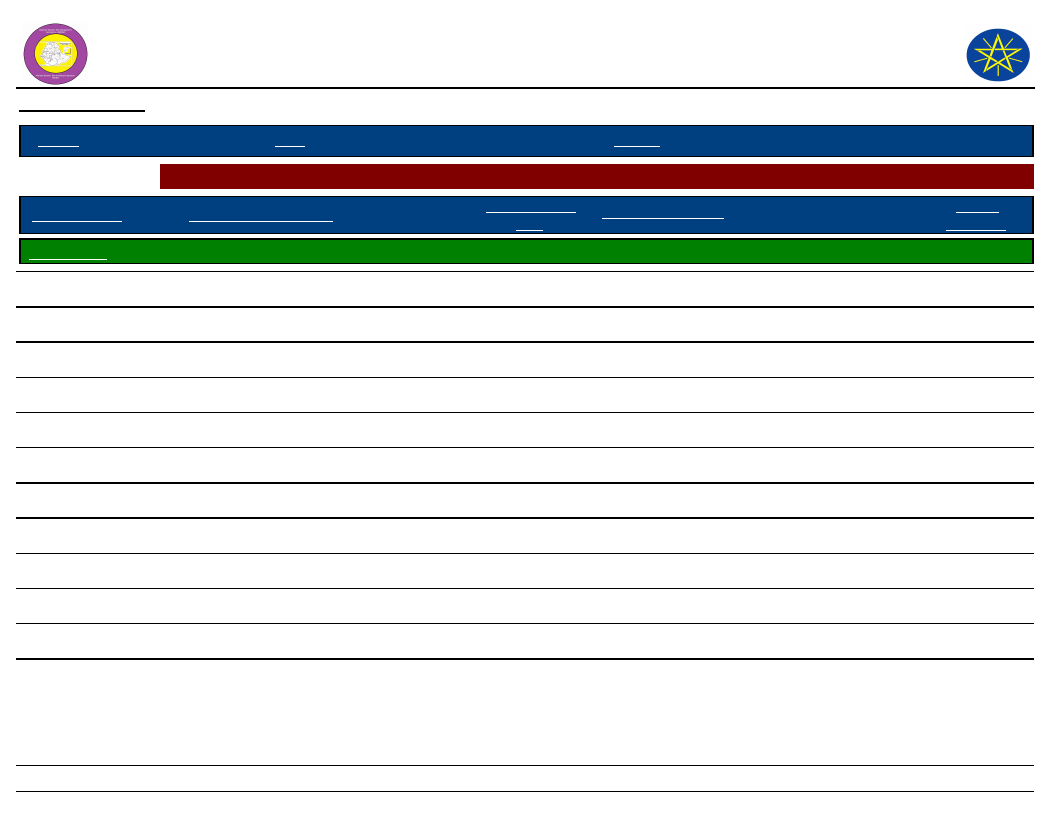
Wereda Disaster
Risk Profile
Data_Collected_Date
National Disaster Risk Management
Commission (NDRMC)
Tuesday, July 9, 2019
Region S.N.N.P
Zone GURAGE
Wereda MESKAN
Selected Indictor: Seasonal Calendar for Hazards, Activities and Income Level By Kebele
Month of Hazard
Major_Problems /Disasters
Hazard Severity
Rank
Agricultural_Activities
Kebele Name MIKAELO
E - Jan (Tir)
Decreasing productivity
1
Trashing
Income
Level Rank
3rd
F - Feb (Yekatit)
Shortage of rain fall
2
Land preparation
12th
G - Mar (Megabit)
Shortage of forage
1
Ploughing
6th
H - Apr (Meazea)
Shortage of rain fall
2
Livestock activities
3rd
I - May (Ginbot)
Crop pest
1
Ploughing
10th
J - Jun (Sene)
Crop pest
2
Sowing
7th
K - Jul (Hamle)
Flood
3
Weeding
8th
L - Aug (Nehase)
Shortage of food
2
Weeding
11th
A - Sep (Meskerem)
Livestock disease
1
Chemical spray
9th
B - Oct (Tikimt)
Frost
2
Livestock activities
5th
C - Nov (Hidar)
Flood
2
Livestock activities
2nd
D - Dec (Tahsas)
Frost
2
Harvesting
1st
NOTE: Hazard Severity Rank helps prioritize the more severe hazards that have occurred in the months of disaster occurrence, 3 being the worst and 1
the least severe hazards.
75
Page 19 of 30
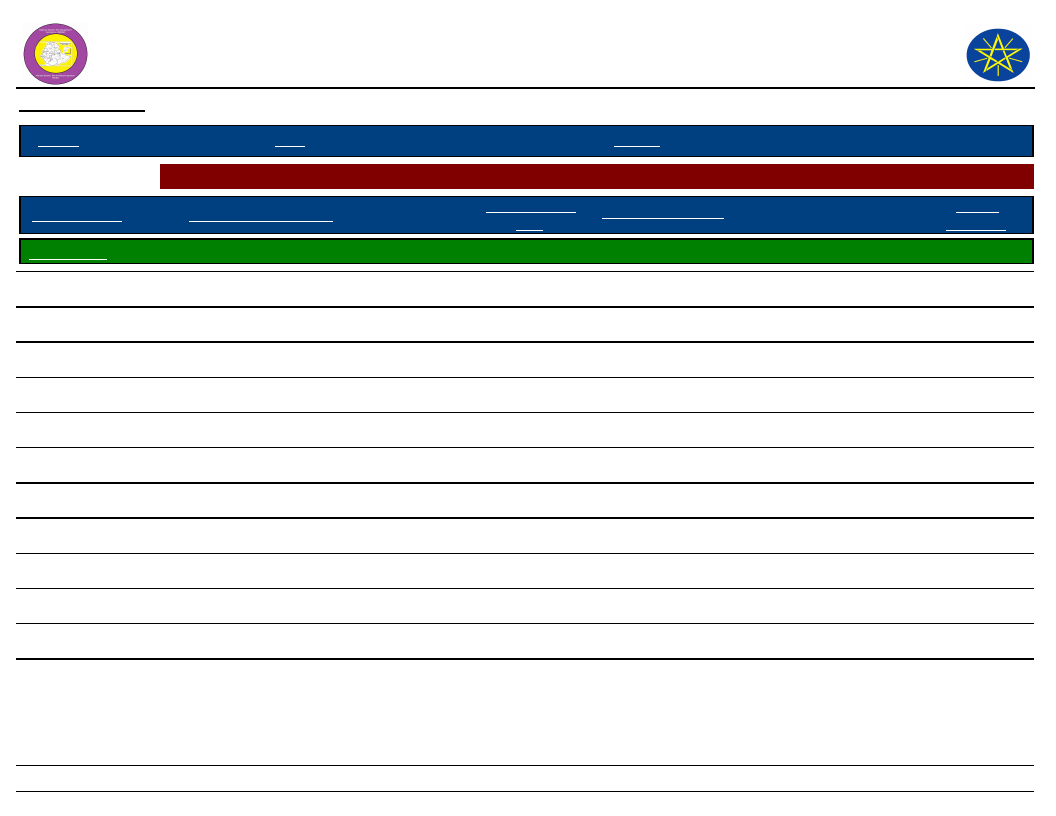
Wereda Disaster
Risk Profile
Data_Collected_Date
National Disaster Risk Management
Commission (NDRMC)
Tuesday, July 9, 2019
Region S.N.N.P
Zone GURAGE
Wereda MESKAN
Selected Indictor: Seasonal Calendar for Hazards, Activities and Income Level By Kebele
Month of Hazard
Major_Problems /Disasters
Hazard Severity
Rank
Agricultural_Activities
Kebele Name MIRAB IMBOR
E - Jan (Tir)
Frost
3
Harvesting, planting Enset
Income
Level Rank
1st
F - Feb (Yekatit)
Shortage of food
3
Sowing, planting Enset
2nd
G - Mar (Megabit)
Shortage of food
2
Planting Enset
3rd
H - Apr (Meazea)
Shortage of rain fall
2
Land preparation
5th
I - May (Ginbot)
Drought
3
Sowing
6th
J - Jun (Sene)
Shortage of food
3
Ploughing
9th
K - Jul (Hamle)
Shortage of food
3
Sowing
10th
L - Aug (Nehase)
Shortage of food
3
Sowing
11th
A - Sep (Meskerem)
Shortage of food
3
Weeding, livestock activities
12th
B - Oct (Tikimt)
Crop disease
2
Weeding, ploughing Enset
7th
C - Nov (Hidar)
Livestock disease/lumpy skin disease
1
Harvesting
8th
D - Dec (Tahsas)
Human disease/malaria, typhus, typhoid
2
Harvesting
4th
NOTE: Hazard Severity Rank helps prioritize the more severe hazards that have occurred in the months of disaster occurrence, 3 being the worst and 1
the least severe hazards.
76
Page 20 of 30
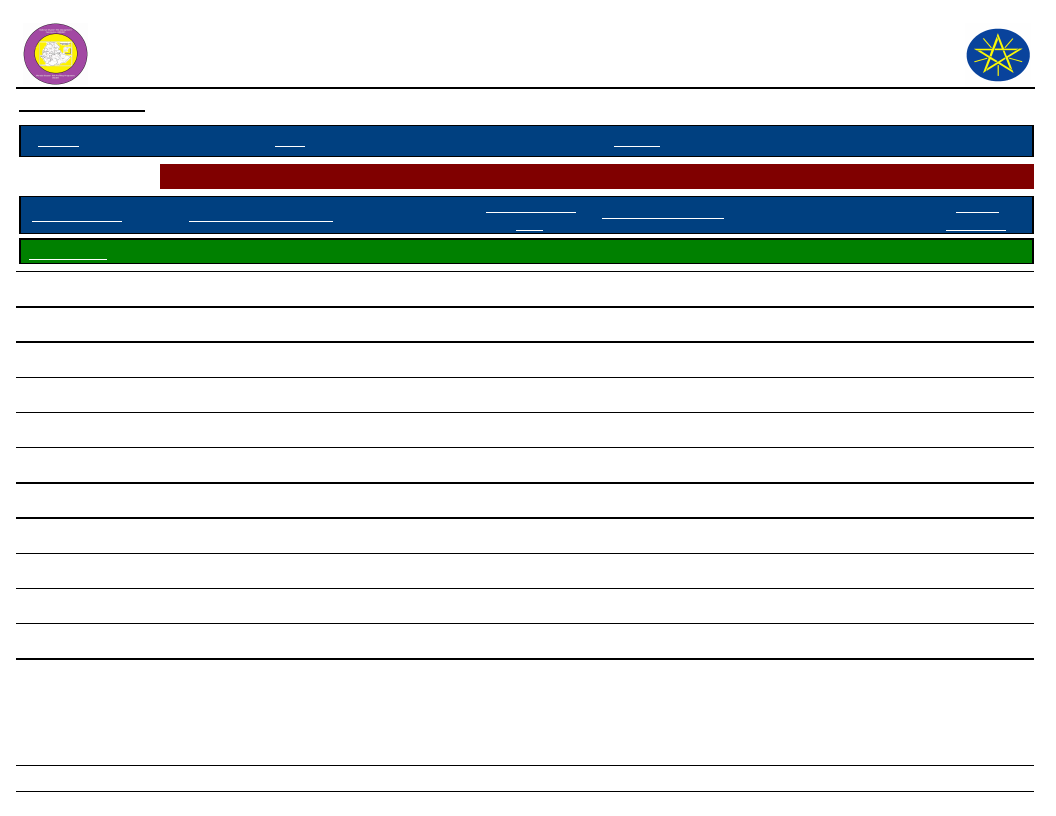
Wereda Disaster
Risk Profile
Data_Collected_Date
National Disaster Risk Management
Commission (NDRMC)
Tuesday, July 9, 2019
Region S.N.N.P
Zone GURAGE
Wereda MESKAN
Selected Indictor: Seasonal Calendar for Hazards, Activities and Income Level By Kebele
Month of Hazard
Major_Problems /Disasters
Hazard Severity
Rank
Agricultural_Activities
Kebele Name MIRAB MESKAN
E - Jan (Tir)
Frost
3
Harvesting, sowing
Income
Level Rank
1st
F - Feb (Yekatit)
Frost
3
Harvesting, sowing
2nd
G - Mar (Megabit)
Shortage of water
3
Plohging
3rd
H - Apr (Meazea)
Drought, shortage of water
2
Ploughing
4th
I - May (Ginbot)
Drought, shortage of water
3
Sowing
6th
J - Jun (Sene)
Drought, shortage of water
3
Land preparation
9th
K - Jul (Hamle)
Shortage of food
2
Sowing, ploughing
10th
L - Aug (Nehase)
Shortage of food
2
Sowing, weeding
11th
A - Sep (Meskerem)
Shortage of food
2
Weeding
12th
B - Oct (Tikimt)
Shortage of money
1
Weeding
8th
C - Nov (Hidar)
Shortage of money
1
Livestock activities
7th
D - Dec (Tahsas)
Human and livestock disease
2
Harvesting
5th
NOTE: Hazard Severity Rank helps prioritize the more severe hazards that have occurred in the months of disaster occurrence, 3 being the worst and 1
the least severe hazards.
77
Page 21 of 30
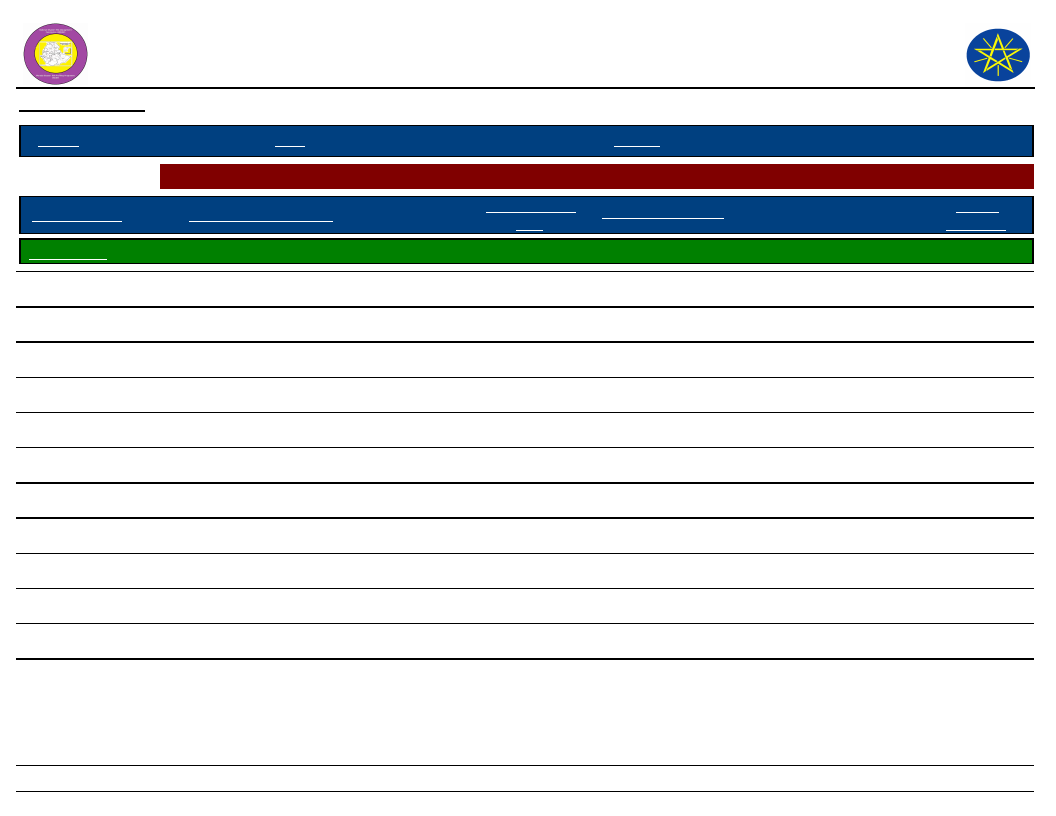
Wereda Disaster
Risk Profile
Data_Collected_Date
National Disaster Risk Management
Commission (NDRMC)
Tuesday, July 9, 2019
Region S.N.N.P
Zone GURAGE
Wereda MESKAN
Selected Indictor: Seasonal Calendar for Hazards, Activities and Income Level By Kebele
Month of Hazard
Major_Problems /Disasters
Hazard Severity
Rank
Agricultural_Activities
Kebele Name OCHAGENEME
E - Jan (Tir)
Frost
3
Threshing
Income
Level Rank
1st
F - Feb (Yekatit)
Livestock disease
1
Tillage
5th
G - Mar (Megabit)
Drought, shortage of rainfall
1
Tillage
6th
H - Apr (Meazea)
Drought
2
Sowing
7th
I - May (Ginbot)
Drought
3
Weeding
8th
J - Jun (Sene)
Livestock disease
3
Weeding
9th
K - Jul (Hamle)
Crop disease
2
Sowing
10th
L - Aug (Nehase)
Crop disease
1
Sowing
11th
A - Sep (Meskerem)
---------
Weeding
12th
B - Oct (Tikimt)
Human disease
2
Livestock activity
3rd
C - Nov (Hidar)
Human disease
1
Livestock activity
4th
D - Dec (Tahsas)
Frost
2
Harvesting
2nd
NOTE: Hazard Severity Rank helps prioritize the more severe hazards that have occurred in the months of disaster occurrence, 3 being the worst and 1
the least severe hazards.
78
Page 22 of 30
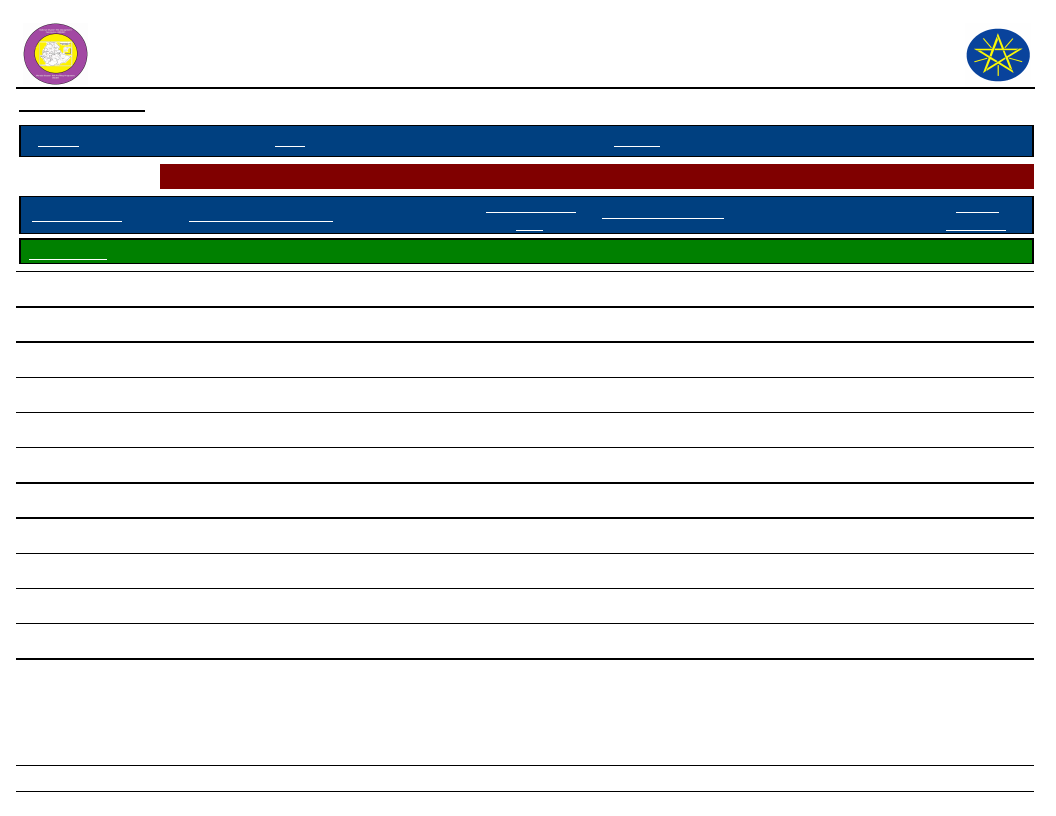
Wereda Disaster
Risk Profile
Data_Collected_Date
National Disaster Risk Management
Commission (NDRMC)
Tuesday, July 9, 2019
Region S.N.N.P
Zone GURAGE
Wereda MESKAN
Selected Indictor: Seasonal Calendar for Hazards, Activities and Income Level By Kebele
Month of Hazard
Major_Problems /Disasters
Hazard Severity
Rank
Agricultural_Activities
Kebele Name SEMEN SHORSHORA
E - Jan (Tir)
Shortage of drinking water
3
Harvesting
Income
Level Rank
1st
F - Feb (Yekatit)
Shortage of drinking water
3
Ploughing
2nd
G - Mar (Megabit)
Shortage of ran fall
3
Ploughing, sowing
4th
H - Apr (Meazea)
Shortage of ran fall
2
Sowing
8th
I - May (Ginbot)
Erratic rain fall
2
Plouging, tillage
9th
J - Jun (Sene)
Livestock disease
2
Weeding, sowing
10th
K - Jul (Hamle)
Crop disease
3
Weeding, sowing
12th
L - Aug (Nehase)
Crop disease
2
Weeding
11th
A - Sep (Meskerem)
Shortage of food
3
Weeding, livestock activities
5th
B - Oct (Tikimt)
Frost
1
Harvesting
3rd
C - Nov (Hidar)
Loss of yield
1
Harvesting
2nd
D - Dec (Tahsas)
Shortage of water
3
Harvesting
1st
NOTE: Hazard Severity Rank helps prioritize the more severe hazards that have occurred in the months of disaster occurrence, 3 being the worst and 1
the least severe hazards.
79
Page 23 of 30
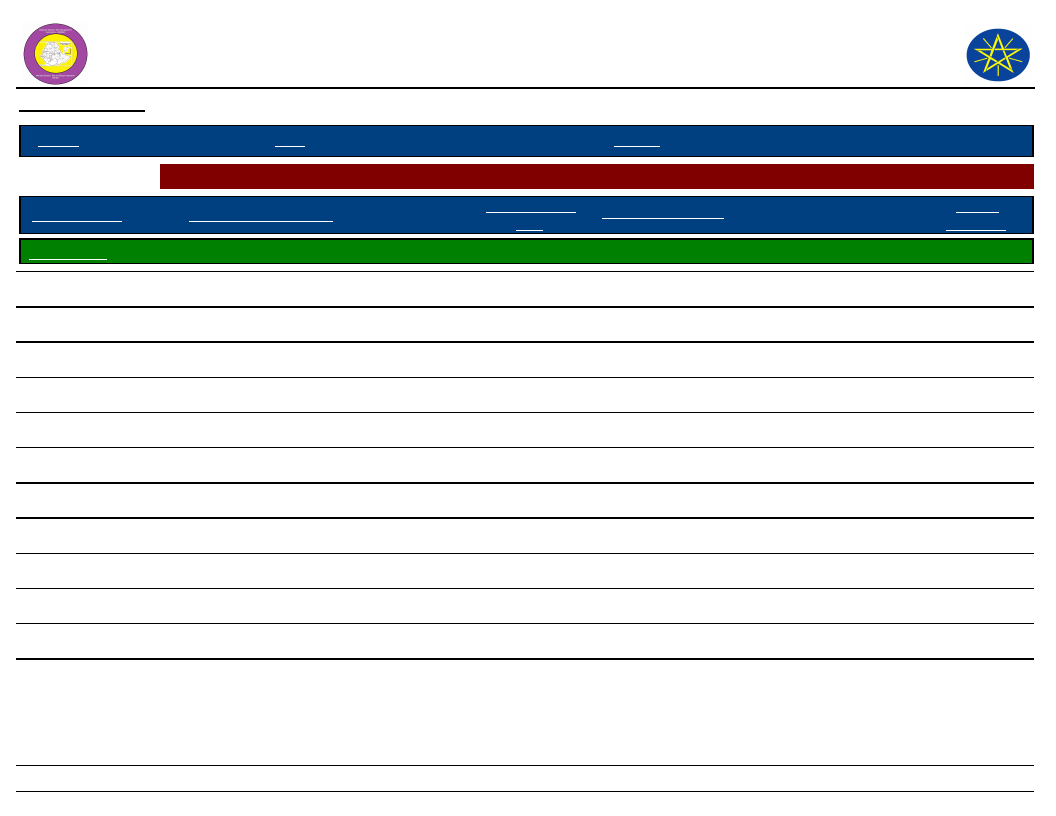
Wereda Disaster
Risk Profile
Data_Collected_Date
National Disaster Risk Management
Commission (NDRMC)
Tuesday, July 9, 2019
Region S.N.N.P
Zone GURAGE
Wereda MESKAN
Selected Indictor: Seasonal Calendar for Hazards, Activities and Income Level By Kebele
Month of Hazard
Major_Problems /Disasters
Hazard Severity
Rank
Agricultural_Activities
Kebele Name SHERSHERA MACHMENA
E - Jan (Tir)
Shortage of water
2
Harvesting, livestock activities
Income
Level Rank
1st
F - Feb (Yekatit)
Shortage of water
3
Harvesting
2nd
G - Mar (Megabit)
Shortage of water
3
Land preparation
8th
H - Apr (Meazea)
Shortage of water
3
Land preparation
9th
I - May (Ginbot)
Shortage of water
3
Sowing
10th
J - Jun (Sene)
Shortage of water
3
Sowing
11th
K - Jul (Hamle)
Shortage of food
3
Sowing
12th
L - Aug (Nehase)
Shortage of money
2
Sowing
7th
A - Sep (Meskerem)
Shortage of money
2
Sowing
6th
B - Oct (Tikimt)
Human disease
1
Weeding, livestock activities
5th
C - Nov (Hidar)
Human disease
1
Harvesting
4th
D - Dec (Tahsas)
Livestock disease
2
Harvesting
3rd
NOTE: Hazard Severity Rank helps prioritize the more severe hazards that have occurred in the months of disaster occurrence, 3 being the worst and 1
the least severe hazards.
80
Page 24 of 30
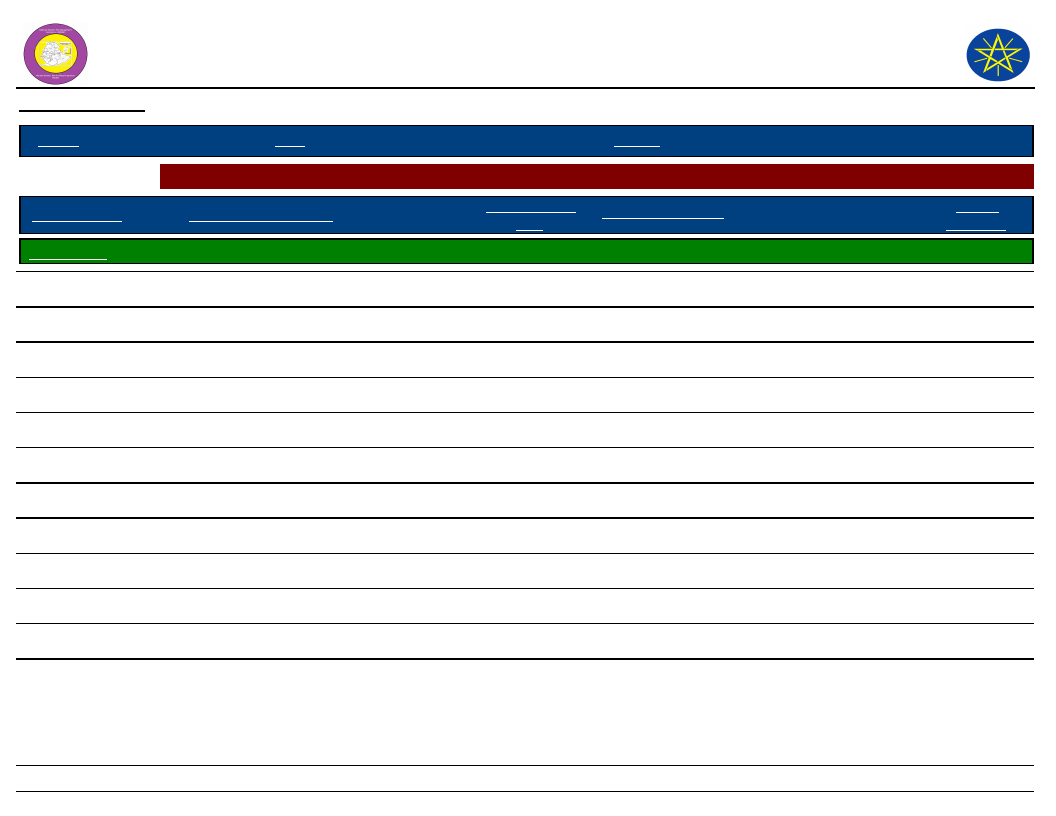
Wereda Disaster
Risk Profile
Data_Collected_Date
National Disaster Risk Management
Commission (NDRMC)
Tuesday, July 9, 2019
Region S.N.N.P
Zone GURAGE
Wereda MESKAN
Selected Indictor: Seasonal Calendar for Hazards, Activities and Income Level By Kebele
Month of Hazard
Major_Problems /Disasters
Hazard Severity
Rank
Agricultural_Activities
Kebele Name WEJABATI
E - Jan (Tir)
Frost
3
Threshing
Income
Level Rank
10th
F - Feb (Yekatit)
Livestock disease
1
Tillage
5th
G - Mar (Megabit)
Drought, shortage of rain fall
1
Tillage
6th
H - Apr (Meazea)
Drought
2
Sowing
7th
I - May (Ginbot)
Drought
3
Weeding
8th
J - Jun (Sene)
Livestock disease
3
Weeding
9th
K - Jul (Hamle)
Livestock disease
1
Sowing
10th
L - Aug (Nehase)
Crop disease and pest
1
Sowing
11th
A - Sep (Meskerem)
---------
Weeding
12th
B - Oct (Tikimt)
Human disease
2
Livestock activities
3rd
C - Nov (Hidar)
Human disease
1
Livestock activities
4th
D - Dec (Tahsas)
Frost
1
Harvesting
2nd
NOTE: Hazard Severity Rank helps prioritize the more severe hazards that have occurred in the months of disaster occurrence, 3 being the worst and 1
the least severe hazards.
81
Page 25 of 30
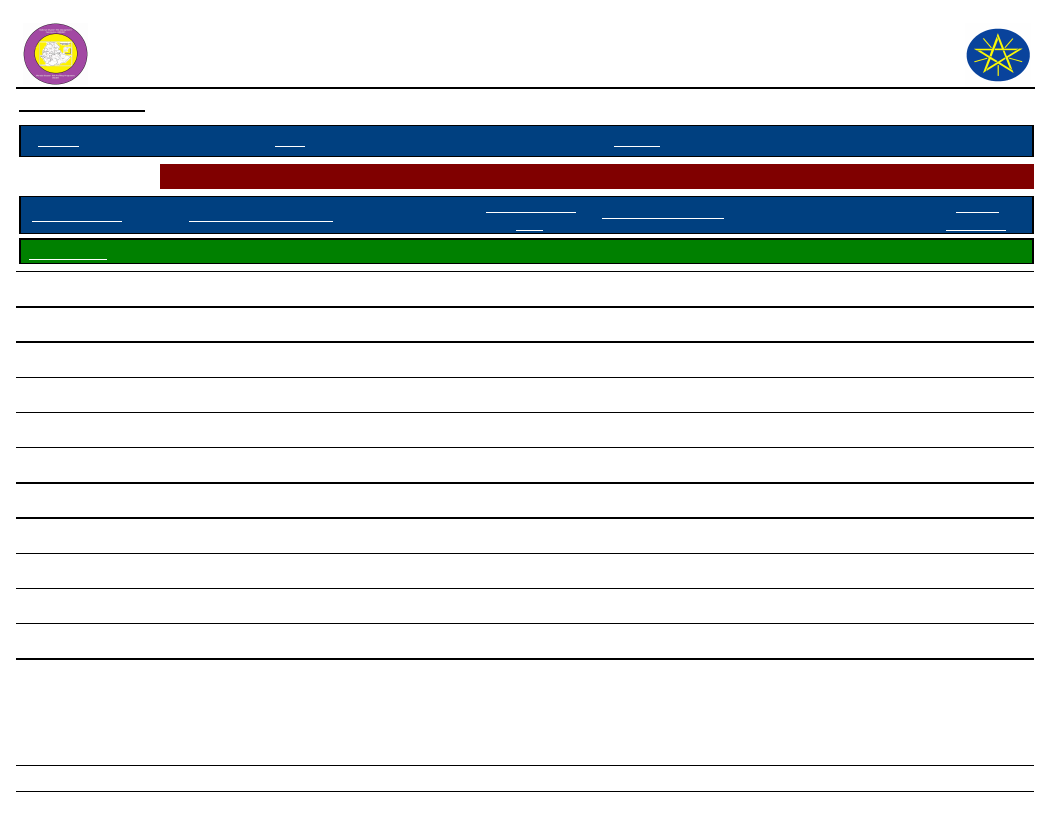
Wereda Disaster
Risk Profile
Data_Collected_Date
National Disaster Risk Management
Commission (NDRMC)
Tuesday, July 9, 2019
Region S.N.N.P
Zone GURAGE
Wereda MESKAN
Selected Indictor: Seasonal Calendar for Hazards, Activities and Income Level By Kebele
Month of Hazard
Major_Problems /Disasters
Hazard Severity
Rank
Agricultural_Activities
Kebele Name WITA
E - Jan (Tir)
Frost
3
Harvesting
Income
Level Rank
1st
F - Feb (Yekatit)
Drought
3
Crashing
3rd
G - Mar (Megabit)
Drought
3
Soil conservation
5th
H - Apr (Meazea)
Drought
1
Ploughing
6th
I - May (Ginbot)
Flood
2
Sowing
4th
J - Jun (Sene)
---------
Weeding
8th
K - Jul (Hamle)
Crop disease
1
Sowing
9th
L - Aug (Nehase)
Flood
2
Weeding
8th
A - Sep (Meskerem)
Malaria
1
Livestock production
7th
B - Oct (Tikimt)
Livestock disease
2
Livestock production
2nd
C - Nov (Hidar)
---------
Harvesting
2nd
D - Dec (Tahsas)
---------
Harvesting
1st
NOTE: Hazard Severity Rank helps prioritize the more severe hazards that have occurred in the months of disaster occurrence, 3 being the worst and 1
the least severe hazards.
82
Page 26 of 30
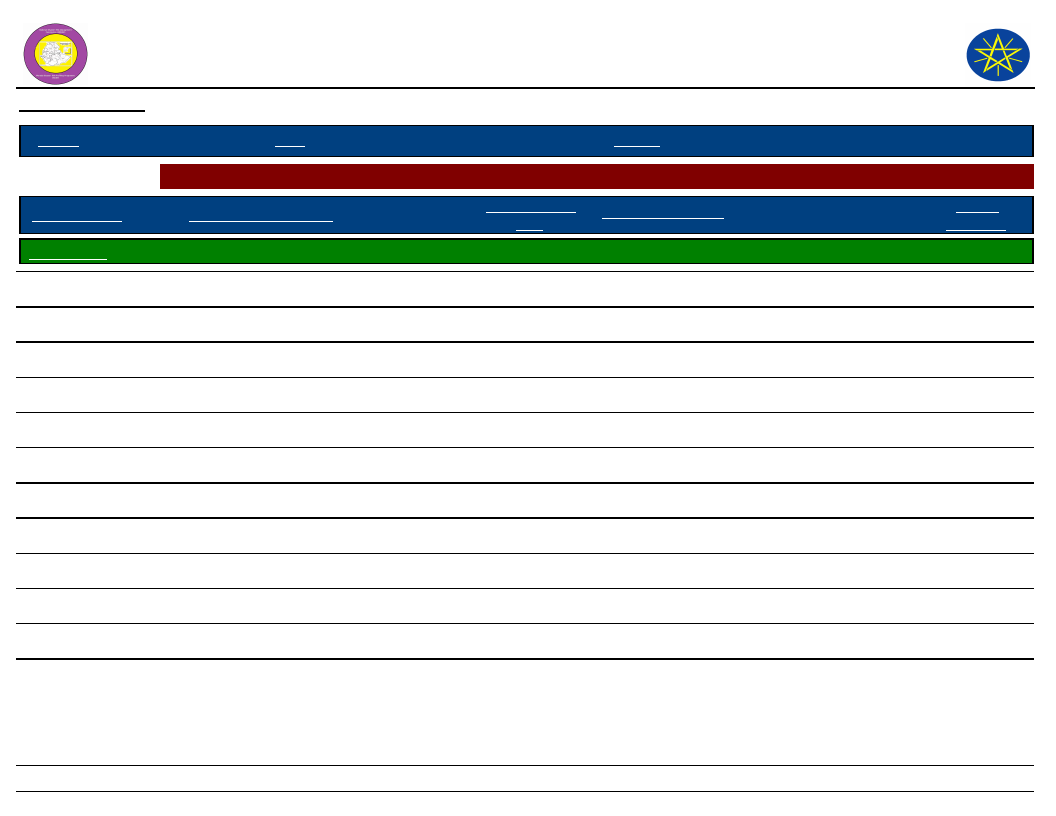
Wereda Disaster
Risk Profile
Data_Collected_Date
National Disaster Risk Management
Commission (NDRMC)
Tuesday, July 9, 2019
Region S.N.N.P
Zone GURAGE
Wereda MESKAN
Selected Indictor: Seasonal Calendar for Hazards, Activities and Income Level By Kebele
Month of Hazard
Major_Problems /Disasters
Hazard Severity
Rank
Agricultural_Activities
Kebele Name WOLENSHO ANDENYA
E - Jan (Tir)
Frost
2
Crashing
Income
Level Rank
5th
F - Feb (Yekatit)
Shortage of water
3
Land preparation
6th
G - Mar (Megabit)
Livestock disease
1
Ploughing
7th
H - Apr (Meazea)
---------
Livestock activities
2nd
I - May (Ginbot)
Crop pest
2
Ploughing
8th
J - Jun (Sene)
Flood
2
Sowing
9th
K - Jul (Hamle)
Flood
1
Weeding
10th
L - Aug (Nehase)
Snow
2
Weeding
11th
A - Sep (Meskerem)
Crop pest
1
Chemical spray
12th
B - Oct (Tikimt)
Frost
2
Livestock activities
3rd
C - Nov (Hidar)
Frost
1
Livestock activities
4th
D - Dec (Tahsas)
Frost
1
Harvesting
1st
NOTE: Hazard Severity Rank helps prioritize the more severe hazards that have occurred in the months of disaster occurrence, 3 being the worst and 1
the least severe hazards.
83
Page 27 of 30
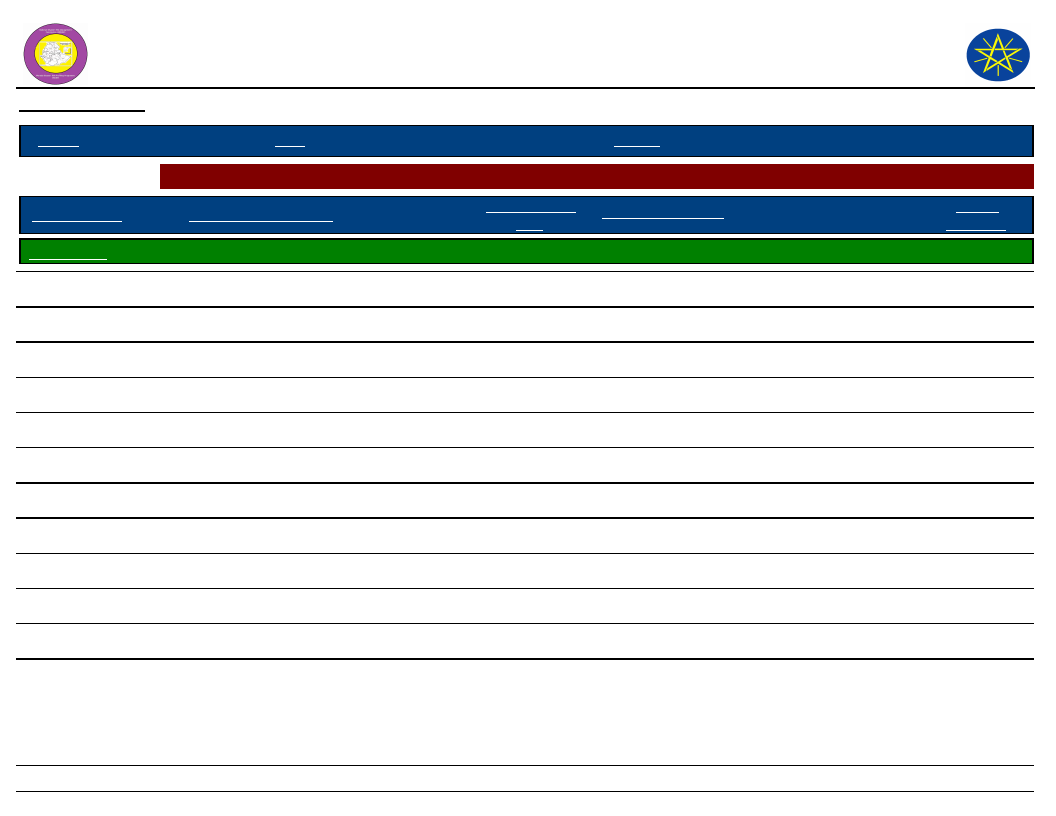
Wereda Disaster
Risk Profile
Data_Collected_Date
National Disaster Risk Management
Commission (NDRMC)
Tuesday, July 9, 2019
Region S.N.N.P
Zone GURAGE
Wereda MESKAN
Selected Indictor: Seasonal Calendar for Hazards, Activities and Income Level By Kebele
Month of Hazard
Major_Problems /Disasters
Hazard Severity
Rank
Agricultural_Activities
Kebele Name YETABON
E - Jan (Tir)
Shortage of water
3
Harvesting
Income
Level Rank
3rd
F - Feb (Yekatit)
Shortage of water
3
Harvesting
1st
G - Mar (Megabit)
Shortage of water
3
Land preparation
2nd
H - Apr (Meazea)
Shortage of water
2
Land preparation
4th
I - May (Ginbot)
Shortage of food
2
Sowing
5th
J - Jun (Sene)
Shortage of food
3
Ploughing
6th
K - Jul (Hamle)
Shortage of food
3
Sowing
7th
L - Aug (Nehase)
Shortage of food
3
Sowing
10th
A - Sep (Meskerem)
Shortage of food
2
Weeding
11th
B - Oct (Tikimt)
Shortage of income
2
Weeding
12th
C - Nov (Hidar)
Shortage of income
2
Harvesting
9th
D - Dec (Tahsas)
Shortage of income
1
Harvesting
8th
NOTE: Hazard Severity Rank helps prioritize the more severe hazards that have occurred in the months of disaster occurrence, 3 being the worst and 1
the least severe hazards.
84
Page 28 of 30
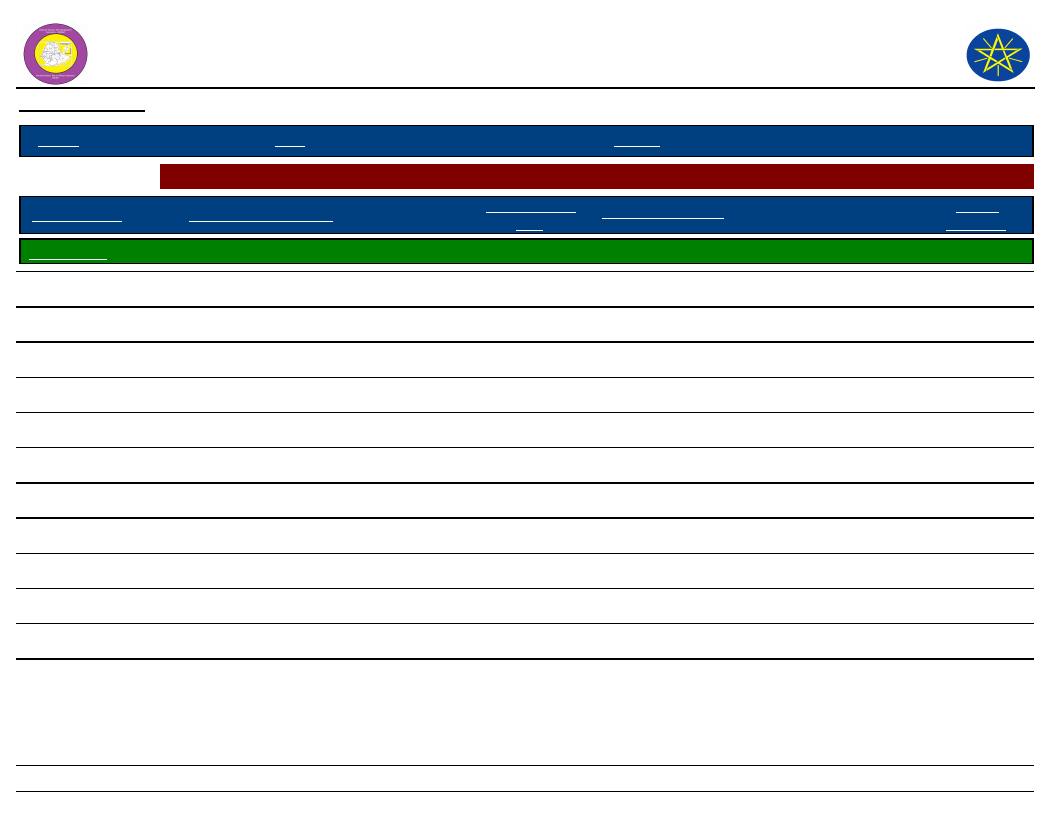
Wereda Disaster
Risk Profile
Data_Collected_Date
National Disaster Risk Management
Commission (NDRMC)
Tuesday, July 9, 2019
Region S.N.N.P
Zone GURAGE
Wereda MESKAN
Selected Indictor: Seasonal Calendar for Hazards, Activities and Income Level By Kebele
Month of Hazard
Major_Problems /Disasters
Hazard Severity
Rank
Agricultural_Activities
Kebele Name YIMERWACHO 2NYA
E - Jan (Tir)
Frost
3
Harvesting
Income
Level Rank
1st
F - Feb (Yekatit)
Frost
3
Land preparation
2nd
G - Mar (Megabit)
Shortage of rain fall
3
Ploughing
4th
H - Apr (Meazea)
Shortage of rain fall
2
Sowing
6th
I - May (Ginbot)
Shortage of rain fall
2
Sowing
7th
J - Jun (Sene)
Shortage of rain fall
3
Ploughing
8th
K - Jul (Hamle)
Livestock disease
2
Weeding, sowing
9th
L - Aug (Nehase)
Shortage of food
2
Sowing, weeding
11th
A - Sep (Meskerem)
Shortage of food
3
Weeding
12th
B - Oct (Tikimt)
Livestock disease/lumpy skin disease
3
Weeding
10th
C - Nov (Hidar)
Human disease/malaria, typhoid
2
Harvesting
5th
D - Dec (Tahsas)
Human disease
2
Harvesting
3rd
NOTE: Hazard Severity Rank helps prioritize the more severe hazards that have occurred in the months of disaster occurrence, 3 being the worst and 1
the least severe hazards.
85
Page 29 of 30
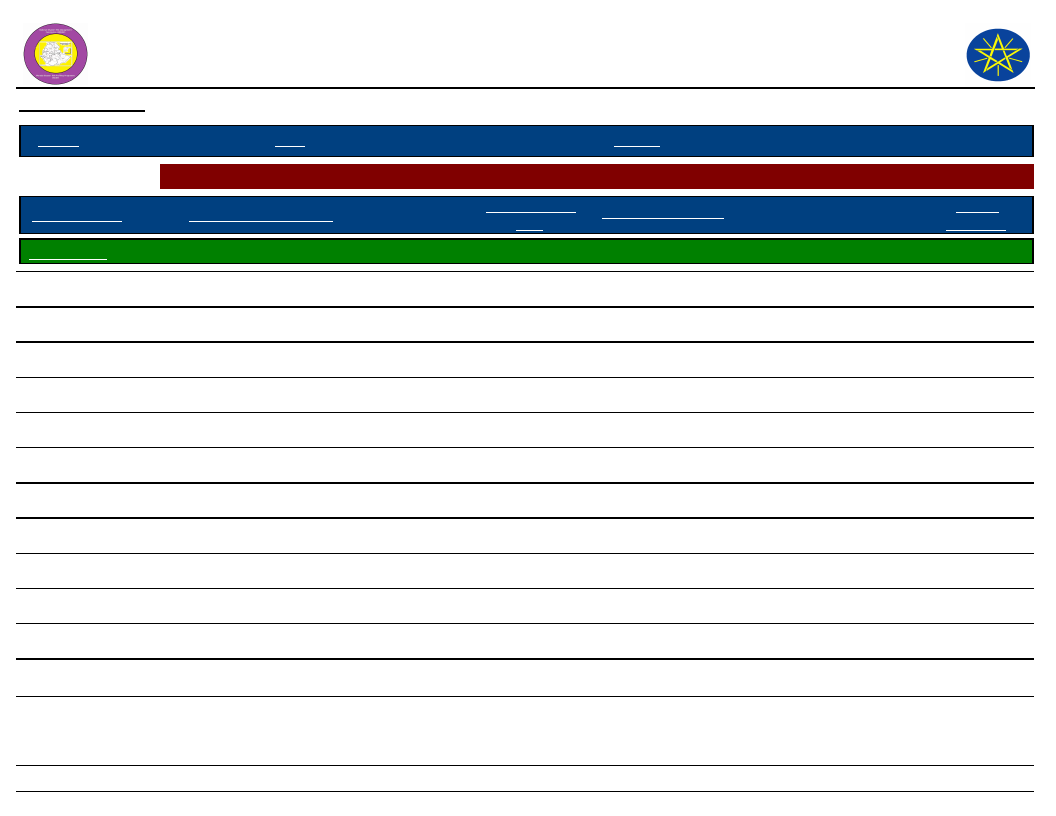
Wereda Disaster
Risk Profile
Data_Collected_Date
National Disaster Risk Management
Commission (NDRMC)
Tuesday, July 9, 2019
Region S.N.N.P
Zone GURAGE
Wereda MESKAN
Selected Indictor: Seasonal Calendar for Hazards, Activities and Income Level By Kebele
Month of Hazard
Major_Problems /Disasters
Hazard Severity
Rank
Agricultural_Activities
Kebele Name YIMERWACHO 3NYA
E - Jan (Tir)
Frost
2
Threshing
Income
Level Rank
1st
F - Feb (Yekatit)
Crop disease
1
Tillage
5th
G - Mar (Megabit)
Crop disease
1
Tillage
6th
H - Apr (Meazea)
Drought
2
Sowing
7th
I - May (Ginbot)
Drought
3
Sowing
8th
J - Jun (Sene)
Livestock disease
2
Weeding
9th
K - Jul (Hamle)
Flood
2
Sowing
10th
L - Aug (Nehase)
Flood
3
Weeding
11th
A - Sep (Meskerem)
Flood
1
Pest control
12th
B - Oct (Tikimt)
Crop disease
3
Vegetable planting
4th
C - Nov (Hidar)
Crop disease
2
Vegetable planting
3rd
D - Dec (Tahsas)
Frost
3
Harvesting
2nd
NOTE: Hazard Severity Rank helps prioritize the more severe hazards that have occurred in the months of disaster occurrence, 3 being the worst and 1
the least severe hazards.
86
Page 30 of 30
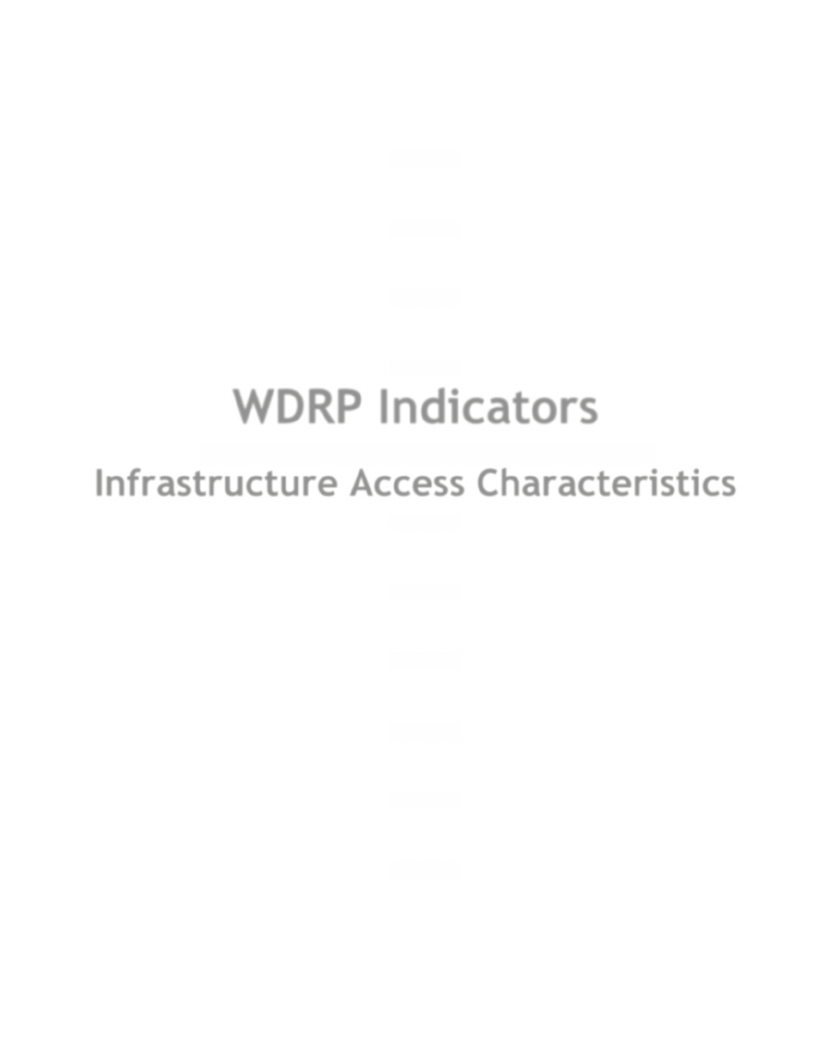
WDRP Indicators
Infrastructure Access Characteristics
87
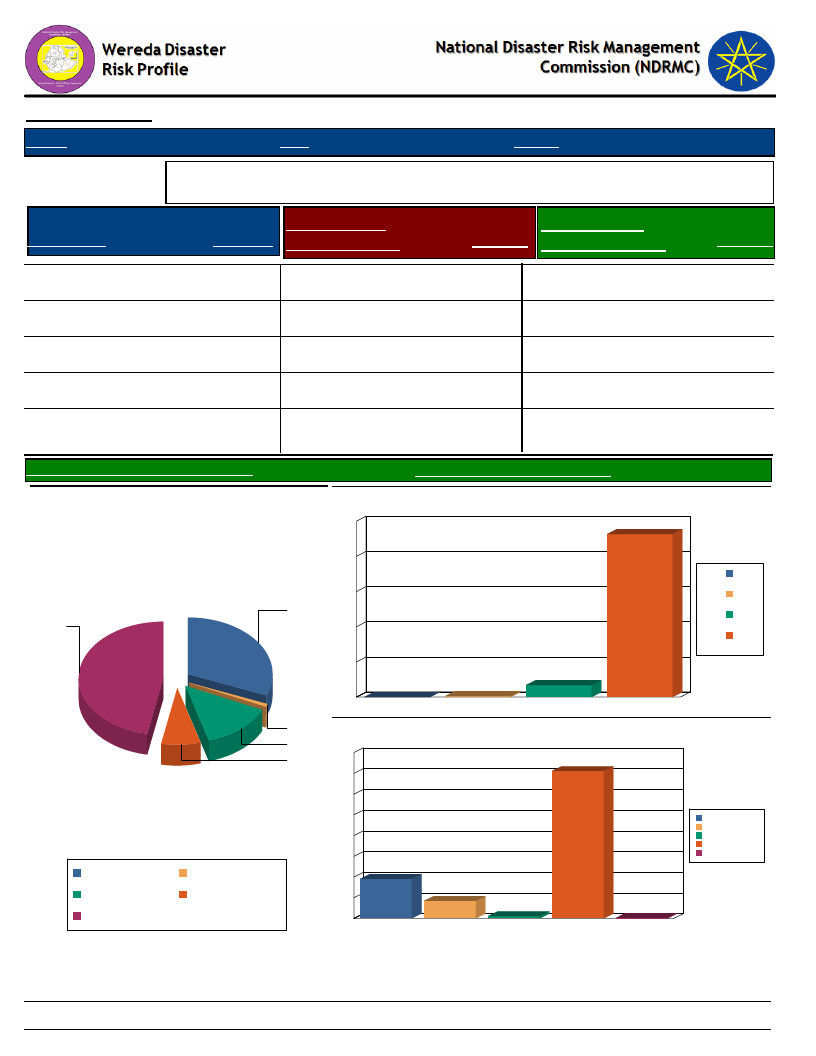
Data_Collected_Date
Region S.N.N.P
Zone GURAGE
Wednesday, July 10, 2019
Wereda MESKAN
Selected Indicator
Type of Road
Physical Vulnerability: Access to Roads & Urban Centres - Households access to
road and urban centre
Time to Nearest
Response Paved Road (Mins.)
Time To Nearest
Response Urban Center (Mins.)
Response
Yes, partly paved road
5.99 30 – 60 min
6.81 1 - 2 hrs
19.07
Yes, gravel road
10.63 1 – 2 hrs
0.54 2 - 4 hrs
8.45
No road
24.25
0.00 More than 6 hrs
0.27
Yes, paved
36.51 Less than 30 min
92.64 Less than 1 hr
71.12
Yes, dirt road (difficult
0.54
for car)
Avg Time To Nearest Urban Center(Mins.)
Type of Road
0.00 4 - 6 hrs
1.09
67.11
Avg_Time_To_Nearest_Paved_Road
13.57
Time to reach the nearest paved road from the HH
100
93
80
37
No road
Yes, gravel road
Yes, paved
24
1
11
6
Yes, dirt road (difficult
for car)
Yes, partly paved road
60
40
20
0
0
1
1 – 2 hrs
7
30 – 60 min
Less than 30 min
1 – 2 hrs
30 – 60 min
Less than 30 min
Time to reach nearest urban center from the HH
80
71
70
60
50
40
30
20
19
10
0
1 - 2 hrs
8
2 - 4 hrs
1
4 - 6 hrs
Less than 1 hr
0
More than 6 hrs
1 - 2 hrs
2 - 4 hrs
4 - 6 hrs
Less than 1 hr
More than 6 hrs
88
Page 1 of 1
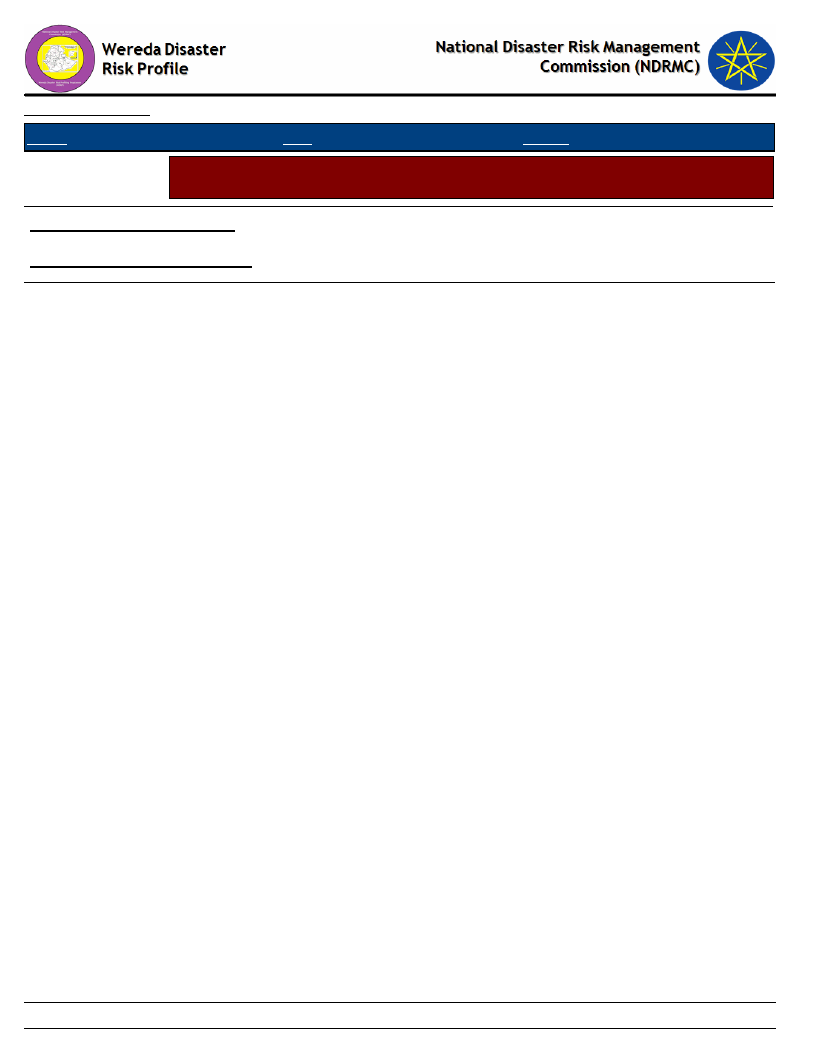
Data_Collected_Date
Region S.N.N.P
Zone GURAGE
Wednesday, July 10, 2019
Wereda MESKAN
Selected Indicator
Physical Vulnerability: Access to Electricity - Households access and utilization
of electricity
Household_Located_In_Electricity
13.39
Household_Connected_To Electricity
9.54
89
Page 1 of 1
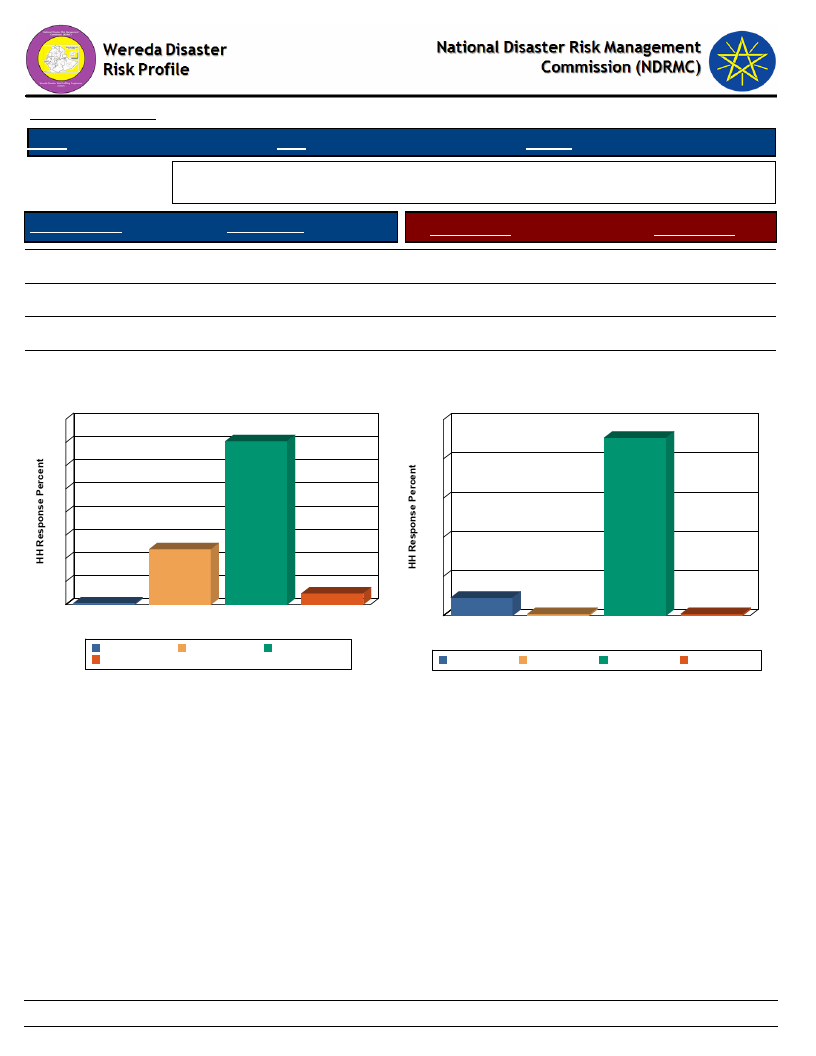
Data_Collected_Date
Region S.N.N.P
Zone GURAGE
Wednesday, July 10, 2019
Wereda MESKAN
Selected Indicator
Floor Structure
Physical Vulnerability: Type of Dwelling Units - Households type of dwelling
houses
HH Response
Type of Floor
HH Response
Tin house
70.57
Concrete
9.19
Wood and mud
4.90
Non-Concrete
90.81
Mobile home
0.54
DK
0.84
Thatched
23.98
NR
0.84
Floor Structure
80
71
70
60
50
40
30
24
20
10
1
0
Mobile home
Thatched
Tin house
Floor Structure
5
Wood and mud
Mobile home
Wood and mud
Thatched
Tin house
Type of Floor
100
91
80
60
40
20
9
0
Concrete
Concrete
1
DK
Non-Concrete
Type of Floor
DK
Non-Concrete
1
NR
NR
90
Page 1 of 1
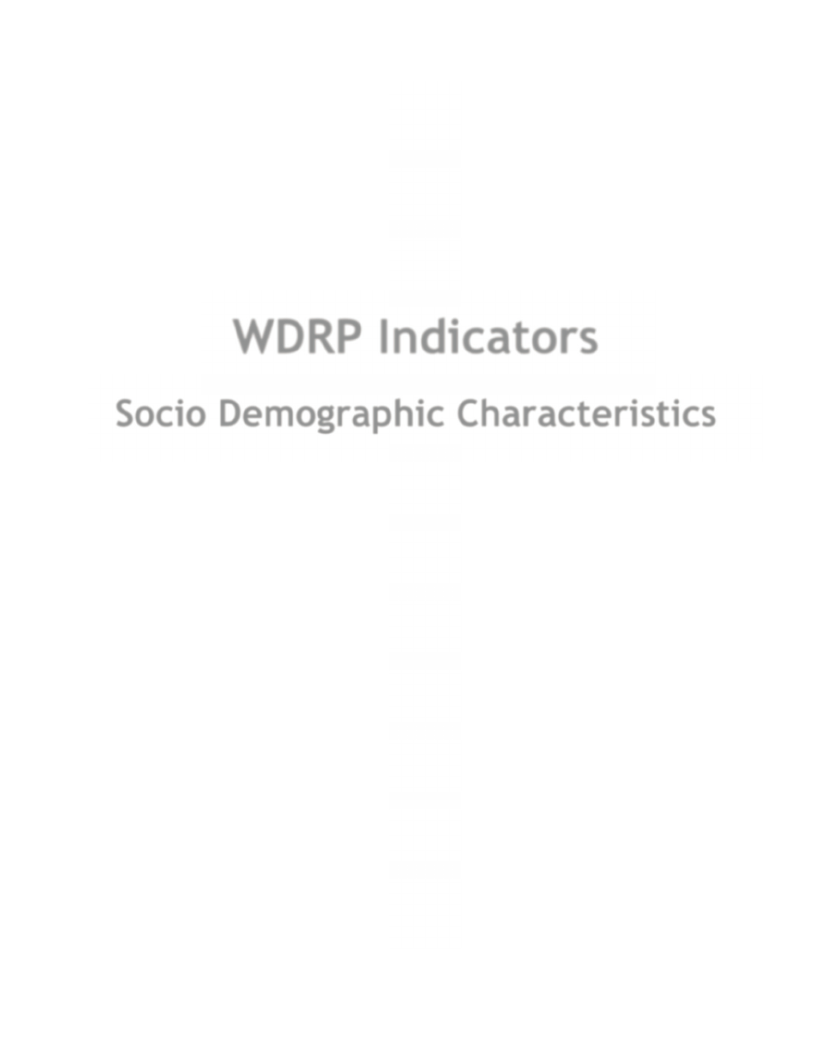
WDRP Indicators
Socio Demographic Characteristics
91
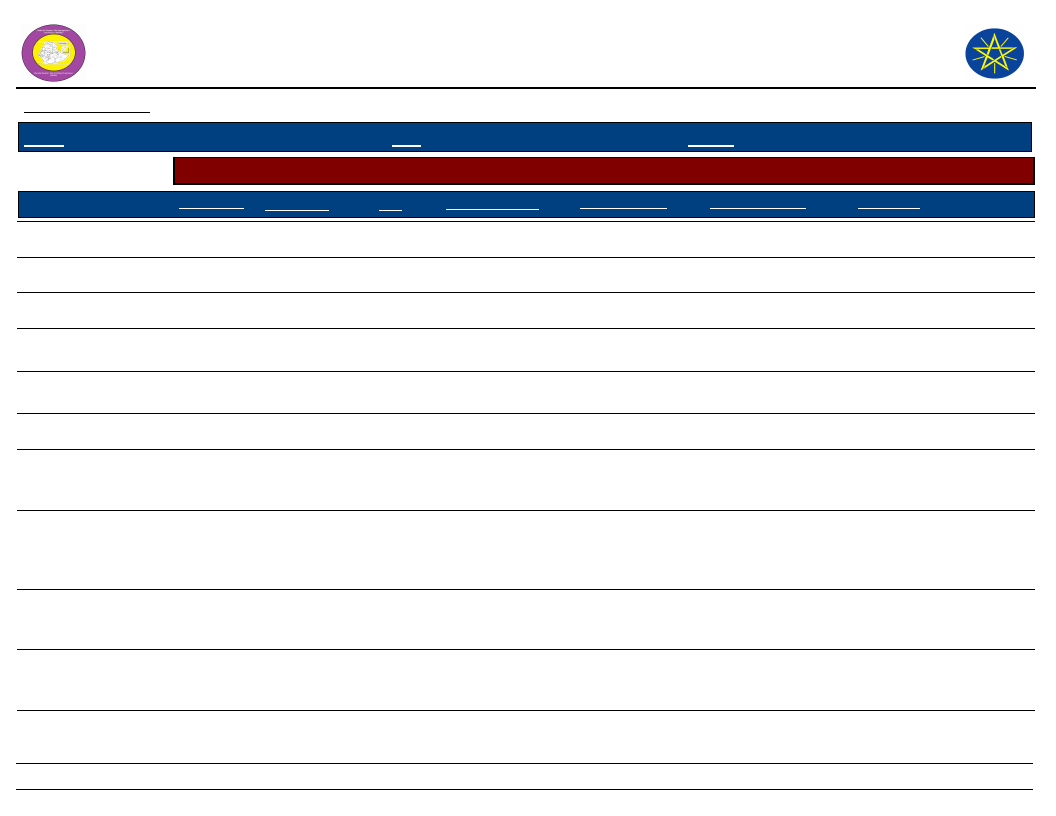
Wereda Disaster
Risk Profile
Data_Collected_Date
National Disaster Risk Management
Commission (NDRMC)
Wednesday, July 10, 2019
Region S.N.N.P
Selected Indicator
Kebele Name
BATI FATO
Zone GURAGE
Wereda MESKAN
Economic Vulnerability: Level of Migration - Migration level and its characteristics by Kebele
Approx_No. Age_Group
Sex
Migration_Period
Migration Trend
Migration_Reason
No
---------
Destination
BATI LEJANO
No
Increased
BECHE BULCHANO
Increased
BERESA
50
DEBO TUTO
20
DEBUB SHERSHERA
No
Youth and
working gr
Youth, working
group
Both
Both
April to September
1991 - 2009
Increased
Increased
Increased
Economic hardship
Economic hardship
Urban area
Urban and foreign country
DEGAGOGOT
DIDA
DIRAMA
DOBENA
GIDENA ABORAT
Increased
800 - 1000
Working group
Both
January, February
Increased
260 - 300
Youth
7-10
30 - 50 years
Male
Both
January, February,
March, Apri
August 2008
Increased
Remained the
same
---------
Job opportunities,
low yield, shortage
of farm land
Job opportunity,
economic hardship,
food scarcity,
shortage of rain
Job opportunity,
economic hardship,
Job opportunity,
economic hardship,
economic hardship
Urban, Addis Ababa
Yirgale, Addis Ababa, Meki,
Hageremariam, Ziway
Addis Ababa,
Hageremriam, Harar, Dire
Dawa, Gambela
Butajira, Hageremariam,
Addis Ababa, Diredawa,
Arab
92
Page 1 of 3
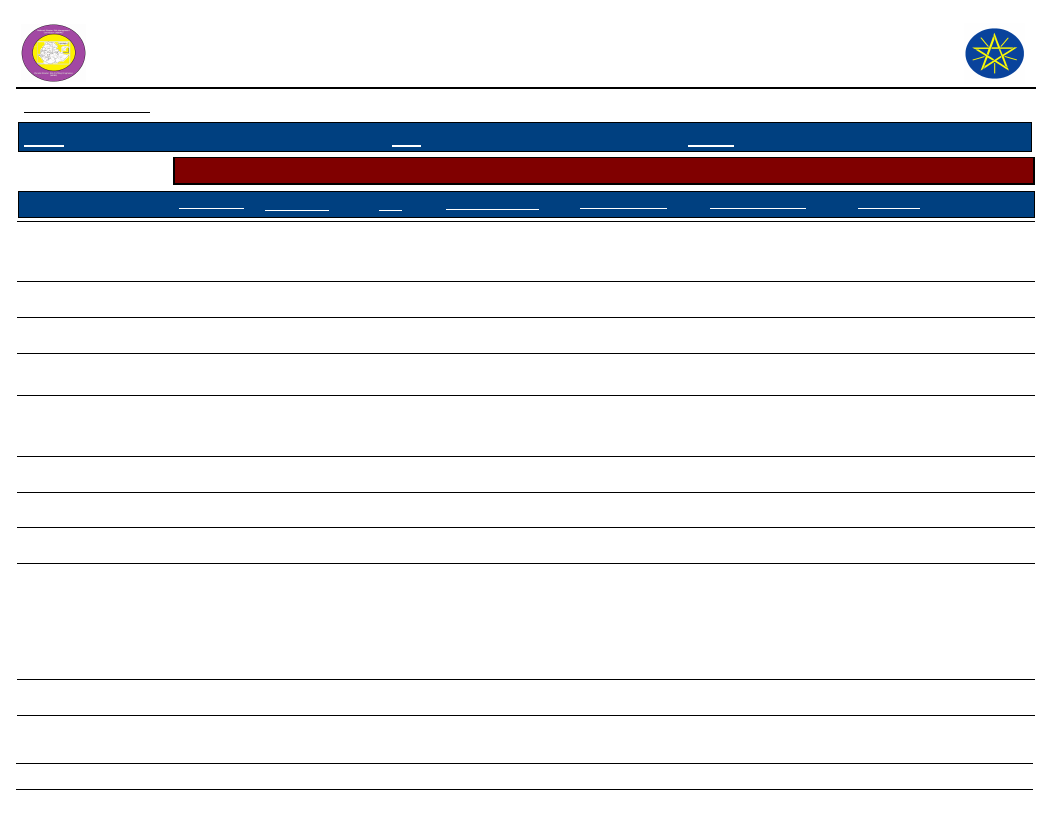
Wereda Disaster
Risk Profile
Data_Collected_Date
National Disaster Risk Management
Commission (NDRMC)
Wednesday, July 10, 2019
Region S.N.N.P
Selected Indicator
Kebele Name
GOYBAN
ILE
Zone GURAGE
Wereda MESKAN
Economic Vulnerability: Level of Migration - Migration level and its characteristics by Kebele
Approx_No. Age_Group
Sex
Migration_Period
Migration Trend
Migration_Reason
20
Working group
Both
April to September
Decreased
Job opportunities,
loss of asset,
searching for water
Increased
Destination
Addis Ababa, Yirgalem,
Hageremariam
INSENO USME
Increased
JOLE ANDENYA
JOLE HULETENYA
MEKICHO
50
340 - 400
Working group
Male
All group
Both
No
January, February
May, 2008
Decreased
Remained the
same
---------
Job opportunity
economic hardship
Job opportunities,
economic hardship,
shortage of food
Urban area
Addis Ababa,
Hageremariam, Harar,
Diredawa
MESERETEWEGERAMO
No
---------
MIKAELO
60
Youth working
Both
March-December
Increased
Economic problems
Urban and rural community
MIRAB IMBOR
6
Working groups Both
June 2008
MIRAB MESKAN
No
Increased
Increased
Job opportunities,
shortage of land, less
soil fertility,
economic hardship,
topography of the
area
Urban/Hageremariam, Arsi
Negele, Addis Ababa
OCHAGENEME
No
Increased
93
Page 2 of 3
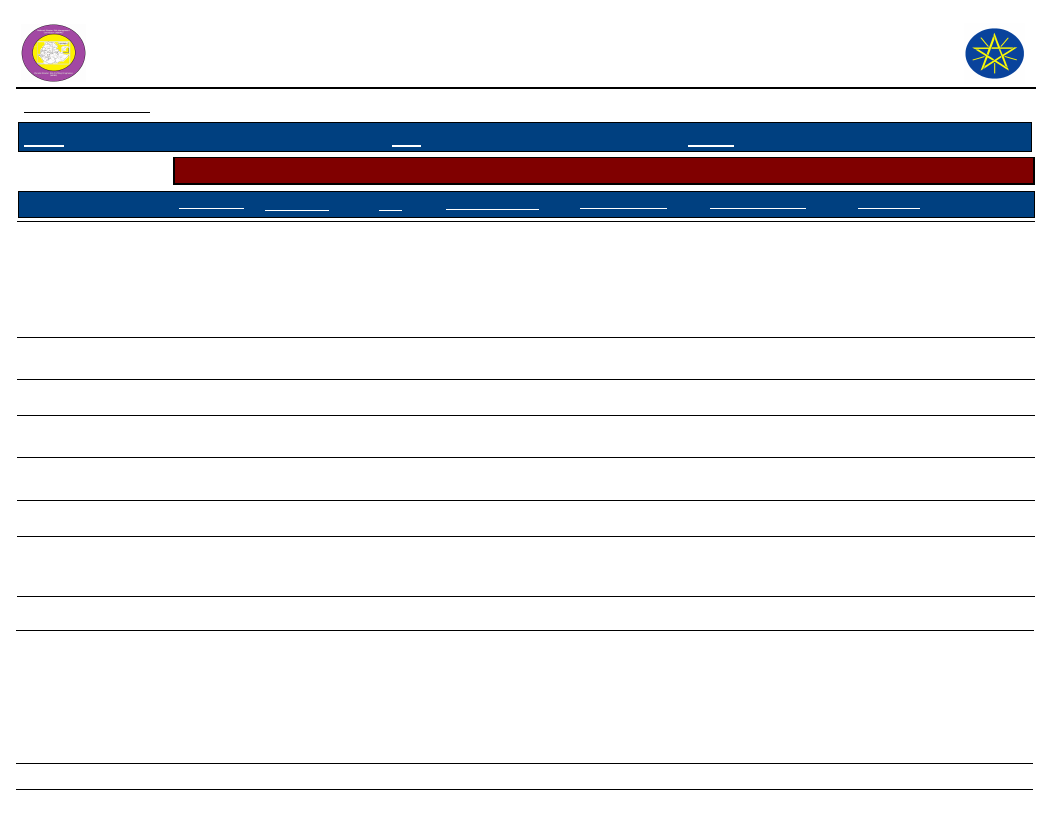
Wereda Disaster
Risk Profile
National Disaster Risk Management
Commission (NDRMC)
Data_Collected_Date
Wednesday, July 10, 2019
Region S.N.N.P
Selected Indicator
Kebele Name
SEMEN SHORSHORA
SHERSHERA
MACHMENA
WEJABATI
Zone GURAGE
Wereda MESKAN
Economic Vulnerability: Level of Migration - Migration level and its characteristics by Kebele
Approx_No. Age_Group
Sex
Migration_Period
Migration Trend
Migration_Reason
20
30 - 50
200 - 300
Youth
Both
June to August
Decreased
Male
February
Increased
---------
Loss of crop
production, shortage
of farm land,
shortage of farm
land, shortage of
drinking water
Economic hardship,
job opportunity
Destination
Urban area, Mito, Addis
Ababa, Metehara,
Ageremariam
Addis Ababa
WITA
40
WOLENSHO ANDENYA
100
YETABON
Youth and
working
Youth, working
group
Both
Both
April - June
September,
October
Decreased
Increased
---------
Economic hardship,
job opportunity
Economic hardship
Urban and foreign
Urban and foreign country
YIMERWACHO 2NYA
300 - 350
Working group
Both
February
YIMERWACHO 3NYA
Increased
---------
Job opportunity, loss
of asst, economic
hardship
To other kebeles
94
Page 3 of 3
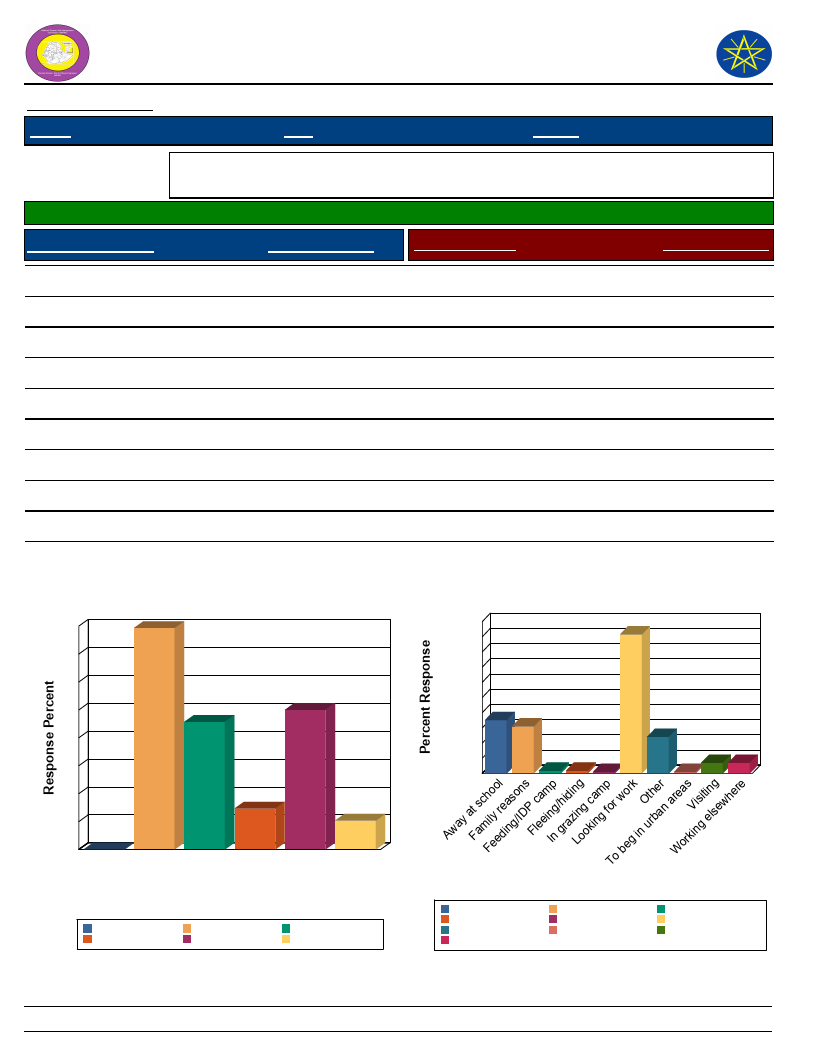
Wereda Disaster
Risk Profile
Data_Collected_Date
Region S.N.N.P
Zone GURAGE
National Disaster Risk Management
Commission (NDRMC)
Wednesday, July 10, 2019
Wereda MESKAN
Selected Indicator
Economic Vulnerability: Household Migration - Household migration and reason
for migration
Households who migrated (%)
13.94
Duration of Migration
Response Percent
Migration Reason
Response Percent
Less than 2 weeks
Two weeks – month
3 – 6 months
> 6 months
A month – 3 months
25.00
5.17
22.84
39.66
7.33
0.00
0.00
0.00
0.00
0.00
Visiting
Family reasons
Working elsewhere
In grazing camp
Looking for work
Fleeing/hiding
Feeding/IDP camp
Away at school
To beg in urban areas
Other
3.42
15.38
3.42
0.43
45.73
0.85
0.85
17.52
0.43
11.97
Duration of Migration
40
40
35
30
25
25
23
20
15
10
7
5
5
0
0
> 6 3 – 6 A month Less Two
months months – 3 than 2 weeks –
months weeks month
Duration of Migration
A month – 3 months
> 6 months
Less than 2 weeks
3 – 6 months
Two weeks – month
Migration Reason
50
46
45
40
35
30
25
20 18 15
15
12
10
5
110
0
33
0
Away at school
Fleeing/hiding
Other
Working elsewhere
Migration Reason
Family reasons
In grazing camp
To beg in urban areas
Feeding/IDP camp
Looking for work
Visiting
95
Page 1 of 1
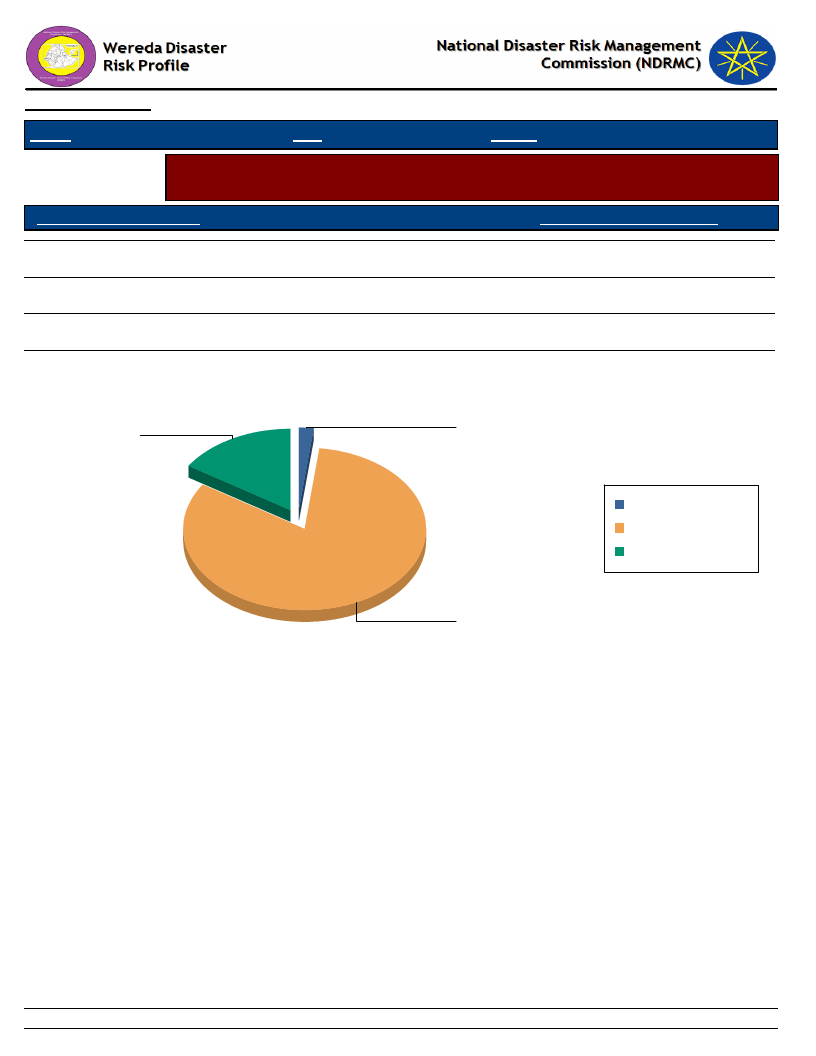
Data_Collected_Date
Wednesday, July 10, 2019
Region S.N.N.P
Zone GURAGE
Wereda MESKAN
Selected Indicator
Economic Vulnerability: Household Migration - Disasters as a triggering factor for
migration (households response in %)
Is Migration Due to Hazard?
HH Response - Due To Hazard
No
83.52
Yes
16.19
Migration partly because of such impacts
1.99
Is Migration Due to Hazard?
Yes
16.2
Migration partly because of such
impacts
2.0
Migration partly because
of such impacts
No
Yes
No
83.5
96
Page 1 of 1
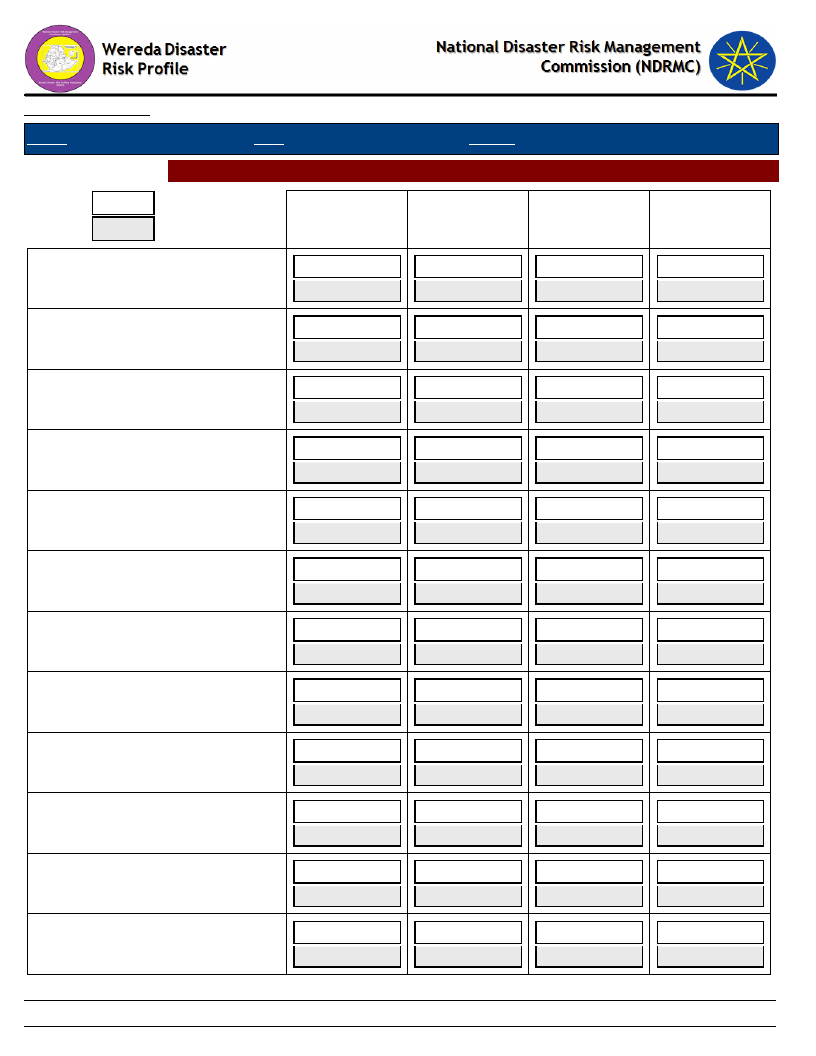
Data_Collected_Date
Region S.N.N.P
Zone GURAGE
Selected Indictor: Demography: Population Structure
KEY:
Male
Female
A-Children
(0-12 yrs)
BATI FATO
51
49
BATI LEJANO
59
41
BECHE BULCHANO
42
58
BERESA
48
52
DEBO TUTO
59
41
DEBUB SHERSHERA
46
54
DEGAGOGOT
53
47
DIDA
53
47
DIRAMA
41
59
DOBENA
51
49
GIDENA ABORAT
48
52
GOYBAN
55
45
Wereda MESKAN
Wednesday, July 10, 2019
B-Youth
(12-25 yrs)
50
50
53
47
41
59
51
49
60
40
43
57
51
49
53
47
46
54
48
52
47
53
68
32
C-Working
(25-55 yrs)
50
50
51
49
40
60
52
48
58
42
41
59
49
51
49
51
46
54
50
50
46
54
6
40
D-Older
(Above 55
51
49
60
40
42
58
50
50
53
47
47
53
52
48
48
52
48
52
50
50
46
54
40
60
97
Page 1 of 3
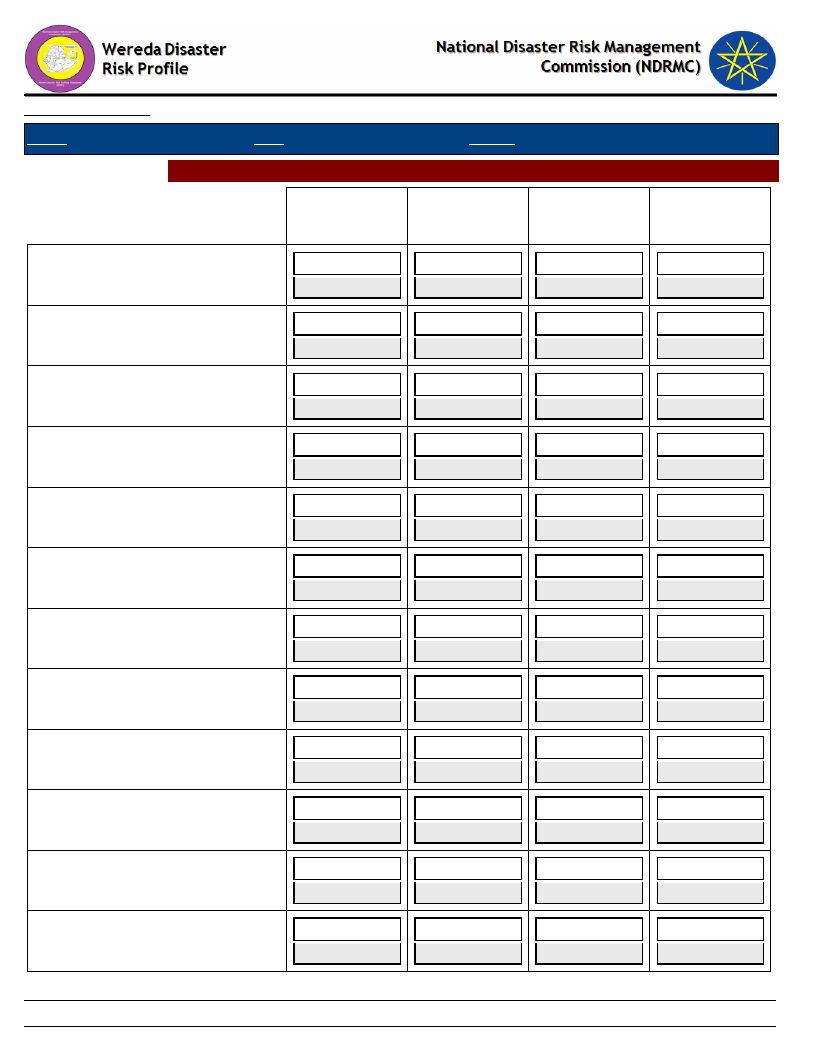
Data_Collected_Date
Region S.N.N.P
Zone GURAGE
Selected Indictor: Demography: Population Structure
A-Children
(0-12 yrs)
ILE
60
40
INSENO USME
46
54
JOLE ANDENYA
53
47
JOLE HULETENYA
43
57
MEKICHO
49
51
MESERETEWEGERAMO
43
57
MIKAELO
47
53
MIRAB IMBOR
41
59
MIRAB MESKAN
48
52
OCHAGENEME
58
42
SEMEN SHORSHORA
65
35
SHERSHERA MACHMENA
49
51
Wereda MESKAN
Wednesday, July 10, 2019
B-Youth
(12-25 yrs)
56
44
58
42
58
52
44
56
48
52
50
50
52
48
46
54
49
51
54
44
55
45
49
51
C-Working
(25-55 yrs)
59
41
60
40
59
41
42
58
43
57
51
49
55
45
5
95
47
53
51
49
60
40
50
50
D-Older
(Above 55
55
45
62
38
60
40
49
51
41
59
49
51
60
40
57
43
48
52
59
41
45
55
49
51
98
Page 2 of 3
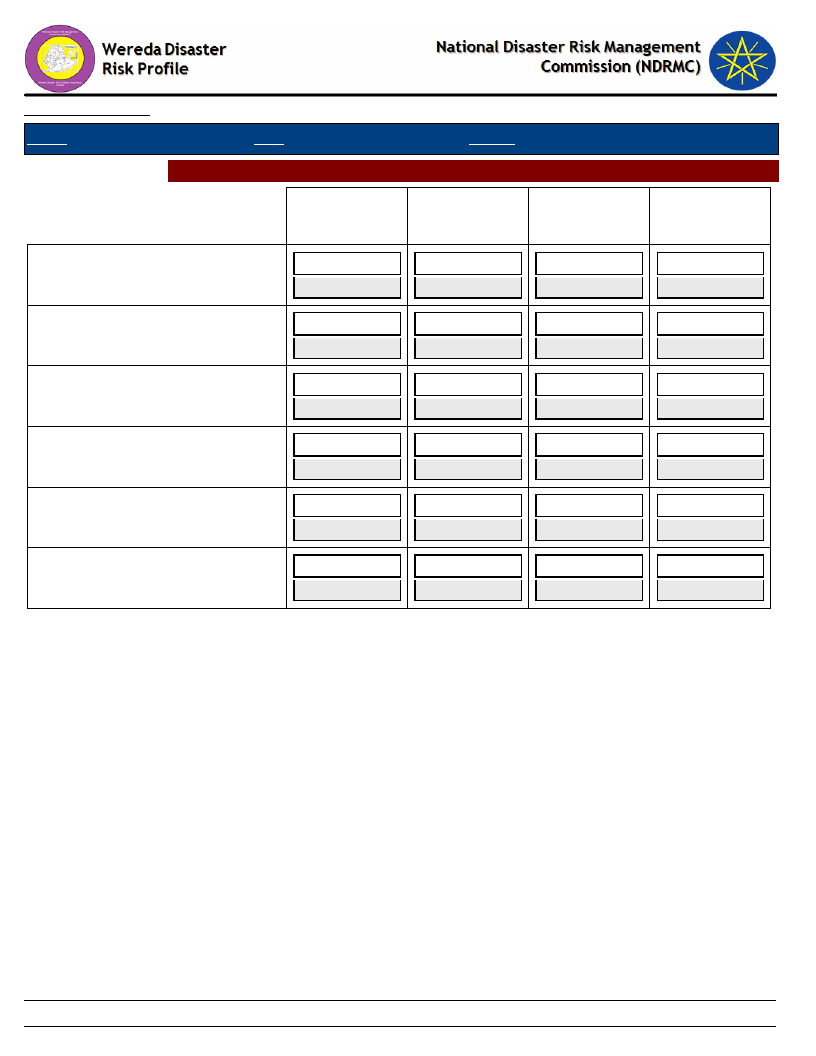
Data_Collected_Date
Region S.N.N.P
Zone GURAGE
Selected Indictor: Demography: Population Structure
A-Children
(0-12 yrs)
WEJABATI
49
51
WITA
58
42
WOLENSHO ANDENYA
52
49
YETABON
48
52
YIMERWACHO 2NYA
44
56
YIMERWACHO 3NYA
47
53
Wereda MESKAN
Wednesday, July 10, 2019
B-Youth
(12-25 yrs)
56
44
57
43
53
47
47
53
43
57
55
45
C-Working
(25-55 yrs)
54
46
60
40
54
46
46
54
41
59
57
43
D-Older
(Above 55
53
47
59
41
50
50
47
53
45
55
60
40
99
Page 3 of 3
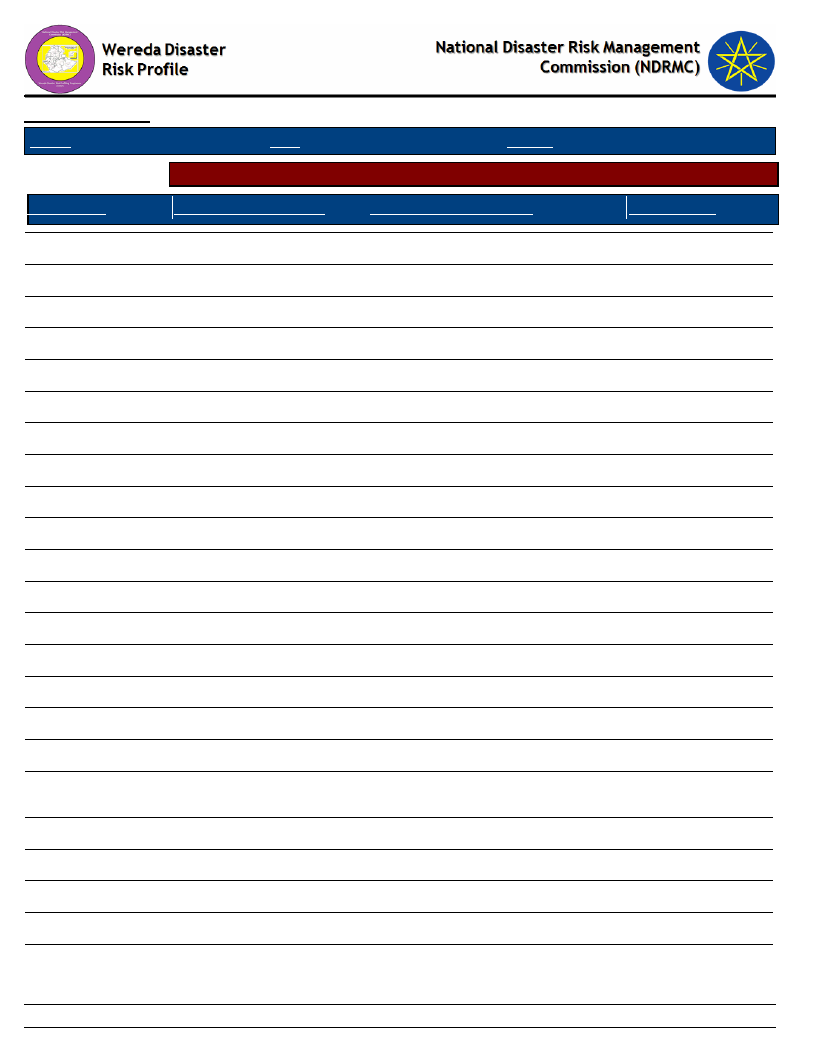
Data_Collected_Date
Region S.N.N.P
Zone GURAGE
Wednesday, July 10, 2019
Wereda MESKAN
Selected Indicator
Demography: Population Trends and Ethnic Groups
Kebele Name
Population Change Trend
Population Change Reasons
Ethnic_Groups
BATI FATO
BATI LEJANO
BECHE BULCHANO
BERESA
DEBO TUTO
DEBUB SHERSHERA
DEGAGOGOT
DIDA
DIRAMA
DOBENA
GIDENA ABORAT
GOYBAN
ILE
INSENO USME
JOLE ANDENYA
JOLE HULETENYA
MEKICHO
MESERETEWEGERA
MO
MIKAELO
MIRAB IMBOR
MIRAB MESKAN
OCHAGENEME
SEMEN SHORSHORA
Increased
Increased
Increased
Increased
Increased
Increased
Increased
Increased
Increased
Increased
Increased
Increased
Increased
Increased
Increased
Increased
Increased
Increased
Increased
Increased
Increased
Increased
Increased
More children, low mortality
More children
More children
More children
More children
More children
More children
More children
More children
More children, less mortality
More children
More children
More children
More children
More children
More children, decrease mortality
More children, less mortality
More children
More children
More children, decreased mortality
More children
More children
More children, mortality rate
decreased
100
Meskan
Meskan
Meskan
Meskan
Meskan
Meskan
Meskan
Meskan
Meskan
Meskan
Meskan
Meskan
Meskan
Meskan
Meskan
Meskan
Meskan
Sodo
Meskan
Meskan
Meskan
Meskan
Meskan
Page 1 of 2
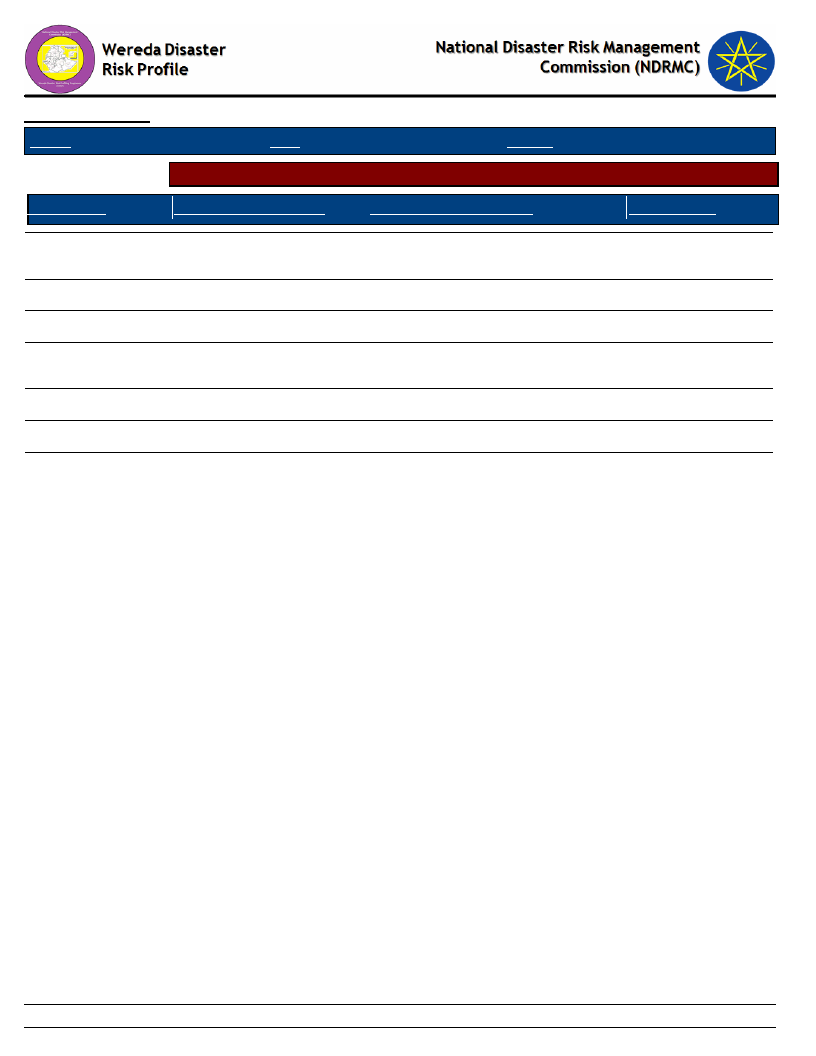
Data_Collected_Date
Region S.N.N.P
Zone GURAGE
Wednesday, July 10, 2019
Wereda MESKAN
Selected Indicator
Demography: Population Trends and Ethnic Groups
Kebele Name
Population Change Trend
Population Change Reasons
Ethnic_Groups
SHERSHERA
MACHMENA
WEJABATI
WITA
WOLENSHO
ANDENYA
YETABON
YIMERWACHO 2NYA
YIMERWACHO 3NYA
Increased
Increased
Increased
Increased
Increased
Increased
Increased
More children
More children
More children
More children
More children
More children
More children
Meskan
Meskan
Meskan
Sodo and Dobi
Meskan
Meskan
Markeko
101
Page 2 of 2

Data_Collected_Date
Wednesday, July 10, 2019
Region S.N.N.P
Zone
GURAGE
Wereda MESKAN
Selected Indicator
Social Vulnerability: Household Demographic Characteristics - Demographic
characteristics of households
Demographic Indicator
Indicator_Value Comments
Average household size
6.5
Sex ratio
960.0 Number of females per 1000 males
Child sex ratio (under 14 yrs)
1,062.0 Number of females per 1000 males
Adult sex ratio (18 & Above yrs)
862.0 Number of females per 1000 males
Dependency ratio ([(0-14)+(64+)] / (15-64)
0.8
yrs)
102
Page 1 of 1
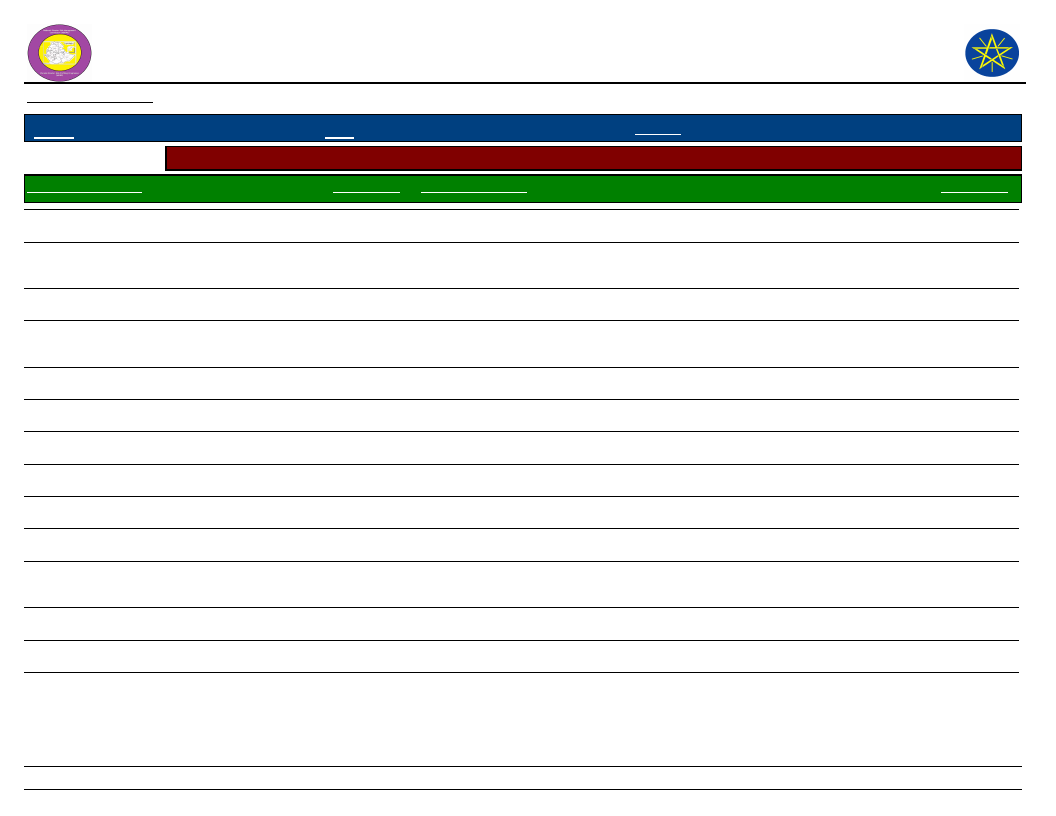
Wereda Disaster
Risk Profile
Data_Collected_Date
National Disaster Risk Management
Commission (NDRMC)
Wednesday, July 10, 2019
Region S.N.N.P
Selected Indicator
General Awareness
Zone
GURAGE
Wereda MESKAN
Social Vulnerability: Level of Educational Attainment - Education status of household members
Percentage Educational Level
Percentage
Read and understand text - Yes, easily
Read and understand text - Yes, with
difficulty
Can write letters - Yes, easily
Can write letters - Yes, with difficulty
47.22
13.11
From Proportion of population (7+) - Less than 1st grade completed
Primary Education (Grade 1 - 6) Student
45.95
12.48
0.00
0.00
0.00
0.00
0.00
0.00
0.00
0.00
0.00
0.00
Secondary School Education (7 - 12) Student
From Proportion of population (7+) - Technical / vocational
certificate or diploma
UNIVERSITY DEGREE
From Proportion of population (15+) - Less than 1st grade
From Proportion of population (15+) - Primary (1-6)
From Proportion of population (15+) - Secondary (7-12)
From Proportion of population (15+) - Technical
From Proportion of population (15+) - Diploma
From Proportion of population (15+) - Pursuing or completed
University
From Proportion of population (7+) - University diploma
From Proportion of population (7+) - Pursuing University degree
From Proportion of population (7+) - University degree or higher
25.44
42.91
28.77
1.01
0.35
31.44
31.09
33.43
1.42
0.50
1.70
0.35
1.21
0.25
103
Page 1 of 2
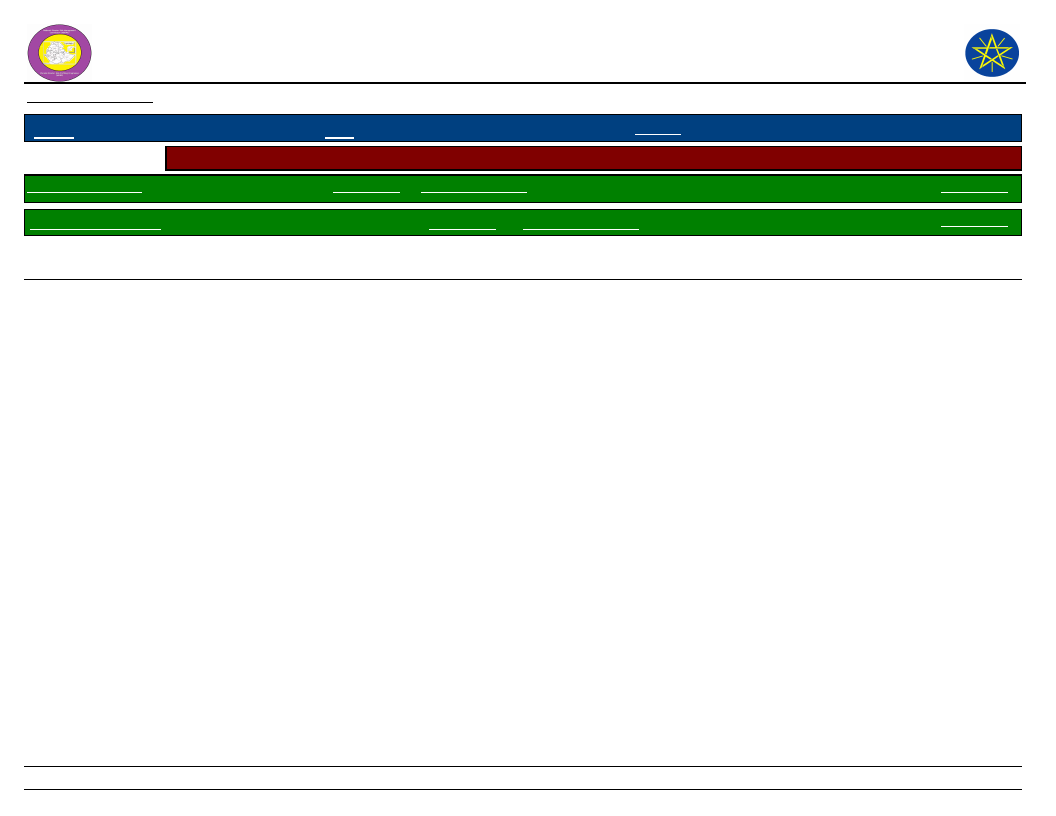
Wereda Disaster
Risk Profile
Data_Collected_Date
National Disaster Risk Management
Commission (NDRMC)
Wednesday, July 10, 2019
Region S.N.N.P
Selected Indicator
General Awareness
Zone
GURAGE
Wereda MESKAN
Social Vulnerability: Level of Educational Attainment - Education status of household members
Percentage Educational Level
Percentage
General Literacy Rate
Proportion of literate population (7+) to total 7+
population
Percentage
14.04
Adult Literacy Rate
Proportion of literate population (15+) to total 15+
population
Percentage
11.55
104
Page 2 of 2
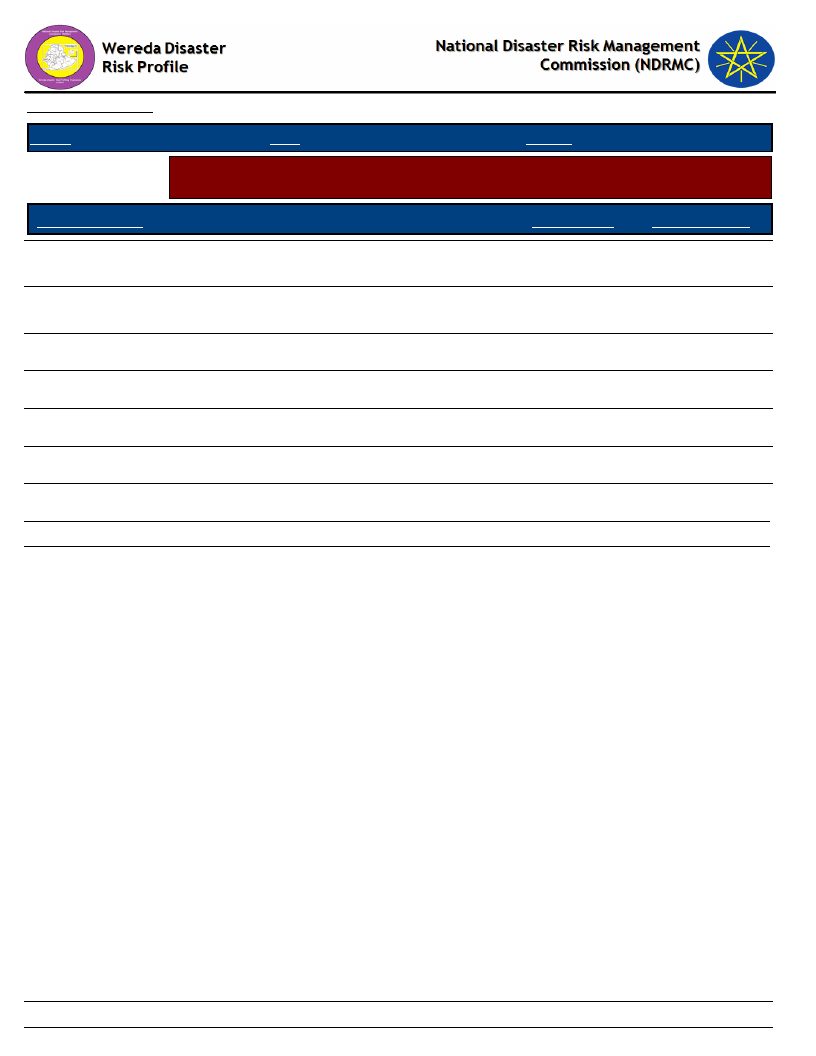
Data_Collected_Date
Wednesday, July 10, 2019
Region S.N.N.P
Zone GURAGE
Wereda MESKAN
Selected Indicator
Educational Level
Social Vulnerability: Gender Parity - Gender parity in education level (7+ years)
and household heading
Male_Percent
Female_Percent
From Proportion of population (7+) - Less than 1st grade
completed
From Proportion of population (7+) - Technical / vocational
certificate or diploma
From Proportion of population (7+) - University diploma
36.79
58.82
100.00
63.21
41.18
0.00
From Proportion of population (7+) - Pursuing University degree
90.91
9.09
From Proportion of population (7+) - University degree or higher
60.00
40.00
Primary Education (Grade 1 - 6) Student
56.53
43.47
Secondary School Education (7 - 12) Student
55.70
44.30
Male Head of HH
81.77
Female Head of HH
18.23
105
Page 1 of 1

WDRP Indicators
Environmental Characteristics
106
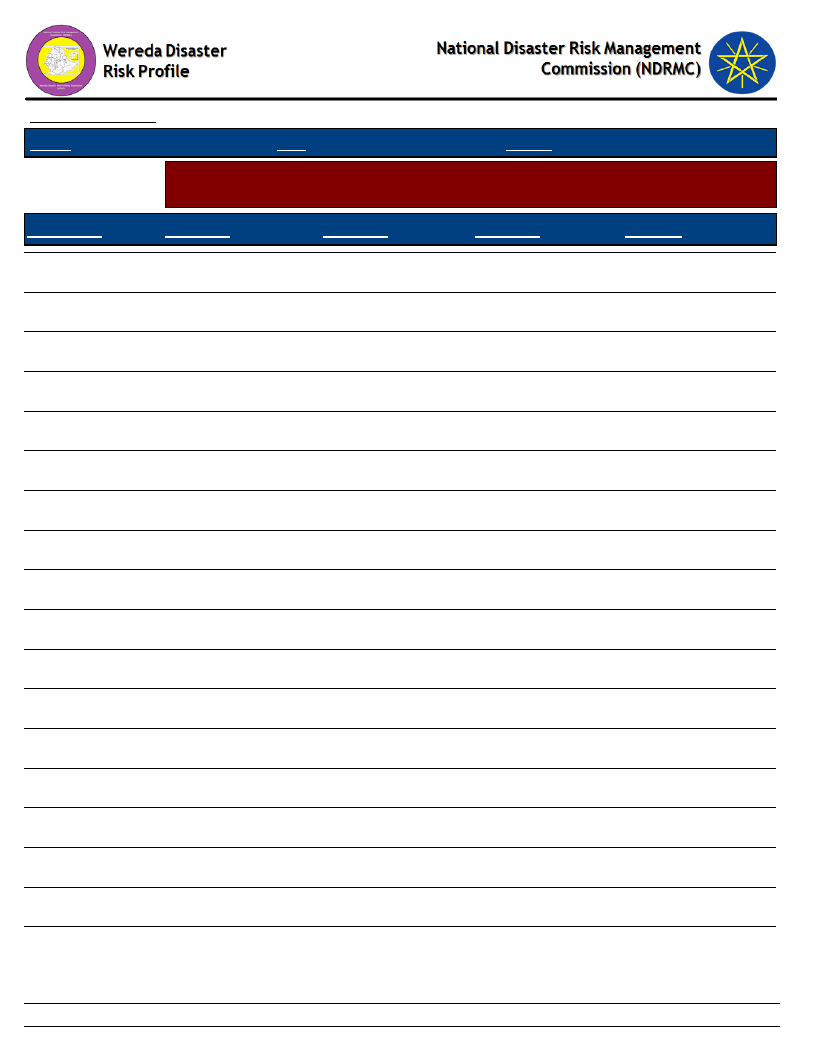
Data_Collected_Date
Region S.N.N.P
Zone GURAGE
Wednesday, July 10, 2019
Wereda MESKAN
Selected Indicator
Environmental Situation: Environmental Problems - Major environmental
problems by Kebele
KebeleName
Problem_1
Problem_2
Problem_3
Problem4
BATI FATO
Deforestation
Pest
BATI LEJANO
Climate change
Pest
Deforestation
BECHE BULCHANO
Pest
Drought
BERESA
Water pollution
DEBO TUTO
Water problem
DEBUB SHERSHERA Soil erosion
Pest
DEGAGOGOT
Water pollution
Soil erosion
DIDA
Pest
water pollution
DIRAMA
Soil erosion
Pest
DOBENA
Soil erosion
Pest
GIDENA ABORAT
Soil erosion
Water pollution
Pest
GOYBAN
Soil erosion
Water pollution
ILE
Climate change
INSENO USME
Climate change
Pest
Deforestation
JOLE ANDENYA
Soil erosion
Out break
Deforestation
JOLE HULETENYA
Pest
MEKICHO
Soil erosion
MESERETEWEGERA Pest
MO
Deforestation
Soil erosion
107
Page 1 of 2
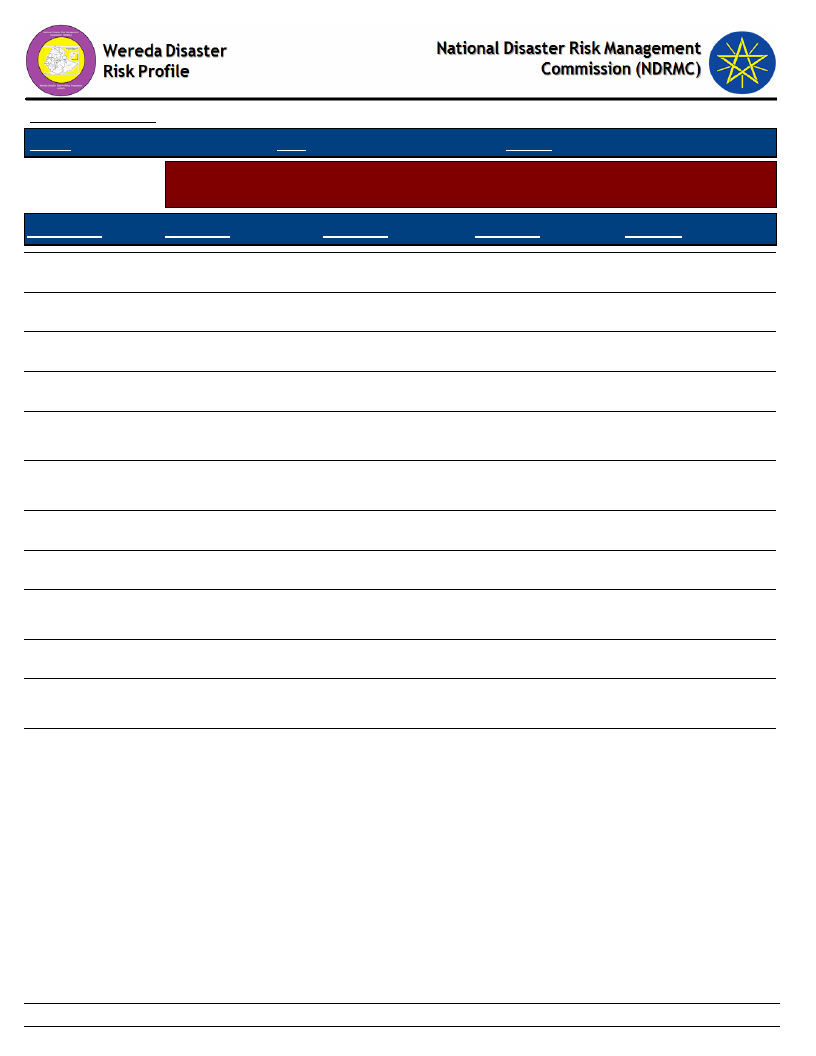
Data_Collected_Date
Region S.N.N.P
Zone GURAGE
Wednesday, July 10, 2019
Wereda MESKAN
Selected Indicator
Environmental Situation: Environmental Problems - Major environmental
problems by Kebele
KebeleName
Problem_1
Problem_2
Problem_3
Problem4
MIKAELO
Soil erosion
Pest
MIRAB IMBOR
Soil erosion
MIRAB MESKAN
Soil erosion
Water pollution
Pest
OCHAGENEME
pest
Water pollution
Deforestation
SEMEN
SHORSHORA
SHERSHERA
MACHMENA
WEJABATI
Water pollution
Soil erosion
Climate change
Soil erosion
Pest
Water pollution
Deforestation
WITA
Soil erosion
Pest
WOLENSHO
ANDENYA
YETABON
Water pollution
Pest
Erosion
Pollution
Livestock disease
YIMERWACHO
2NYA
YIMERWACHO
3NYA
Soil erosion
Climate change
Pest and disease
Pest
Deforestation
108
Page 2 of 2
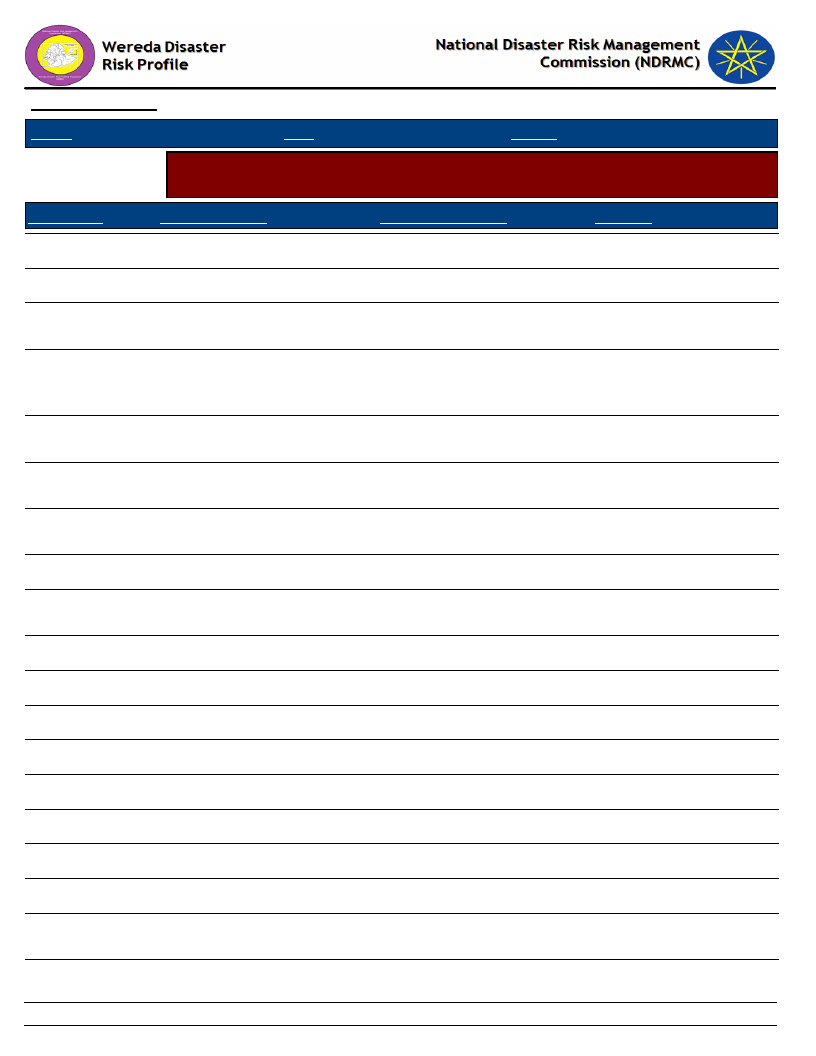
Data_Collected_Date
Wednesday, July 10, 2019
Region S.N.N.P
Zone GURAGE
Wereda MESKAN
Selected Indicator
Environmental Situation: General Land Quality - Perceptions of the community
on changes in the general quality of land over a decade
KebeleName
Current_Situation
Change_Last_Decade
Comment
BATI FATO
Mixed farming
No change
BATI LEJANO
Good
No change
BECHE
BULCHANO
BERESA
Mixed farming
Annual crop and forest
DEBO TUTO
DEBUB
SHERSHERA
DEGAGOGOT
DIDA
Annual crop and forest,
grazing land
Mixed farming
Very low
Mixed farming
No change
Decreased
Decreased
No change
Decreased
No change
Due to stony and sand
land and poor
productivity
Due to stony and sandy
land, poor productivity
Soil erosion,
deforestation
DIRAMA
DOBENA
Mixed farming
Mixed farming
Shift to one crop to others
No change
Because of crop
disease/pepper disease
GIDENA ABORAT
Mixed farming
No change
GOYBAN
Good
Increased
ILE
Good
No change
INSENO USME
Good
No change
JOLE ANDENYA
Good
No change
JOLE HULETENYA Mixed farming
No change
MEKICHO
Mixed farming
No change
MESERETEWEGER
AMO
Good
No change
109
Page 1 of 2
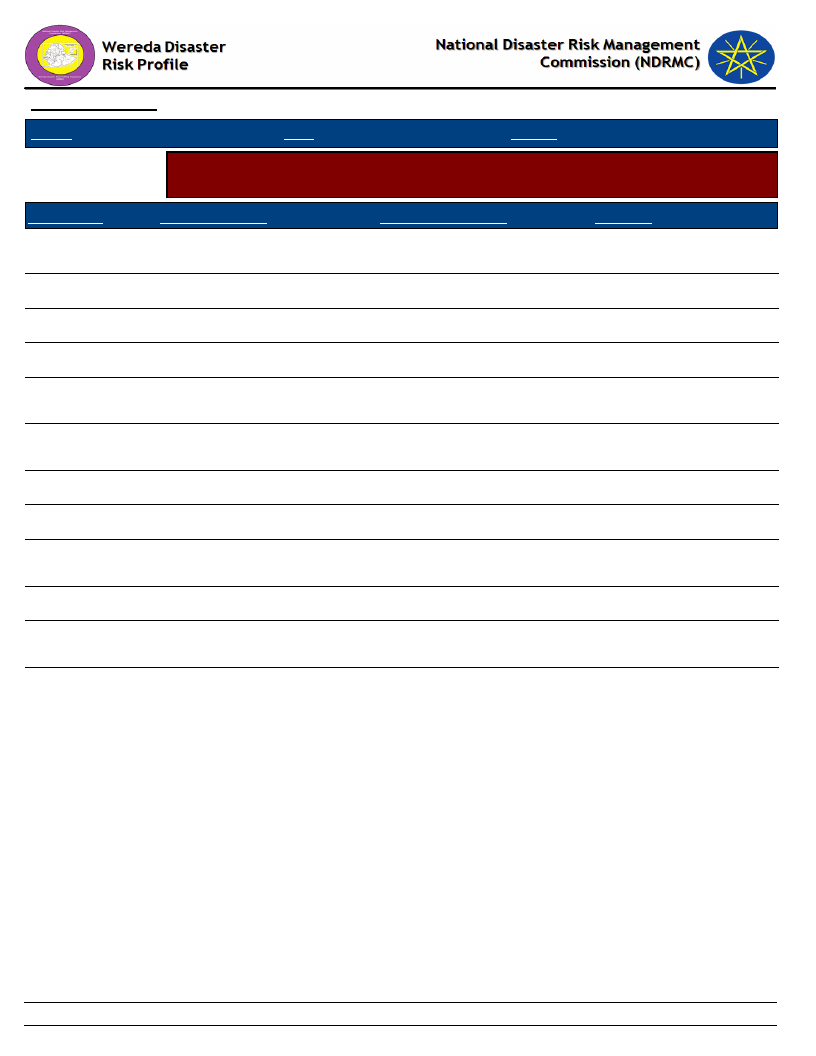
Data_Collected_Date
Wednesday, July 10, 2019
Region S.N.N.P
Zone GURAGE
Wereda MESKAN
Selected Indicator
Environmental Situation: General Land Quality - Perceptions of the community
on changes in the general quality of land over a decade
KebeleName
MIKAELO
MIRAB IMBOR
Current_Situation
Annual crop forest and
grazing land
Mixed farming
Change_Last_Decade
No change
No change
Comment
MIRAB MESKAN
Mixed farming
No change
OCHAGENEME
Good
No change
SEMEN
SHORSHORA
SHERSHERA
MACHMENA
WEJABATI
Very low
Mixed farming
Good
No change
No change
No change
WITA
Good
No change
WOLENSHO
ANDENYA
YETABON
Annual crop prenatal part,
forest and grazing land
Mixed farming
Increased
No change
The cultivated land
YIMERWACHO
2NYA
YIMERWACHO
3NYA
Mixed farming
Good
No change
No change
110
Page 2 of 2
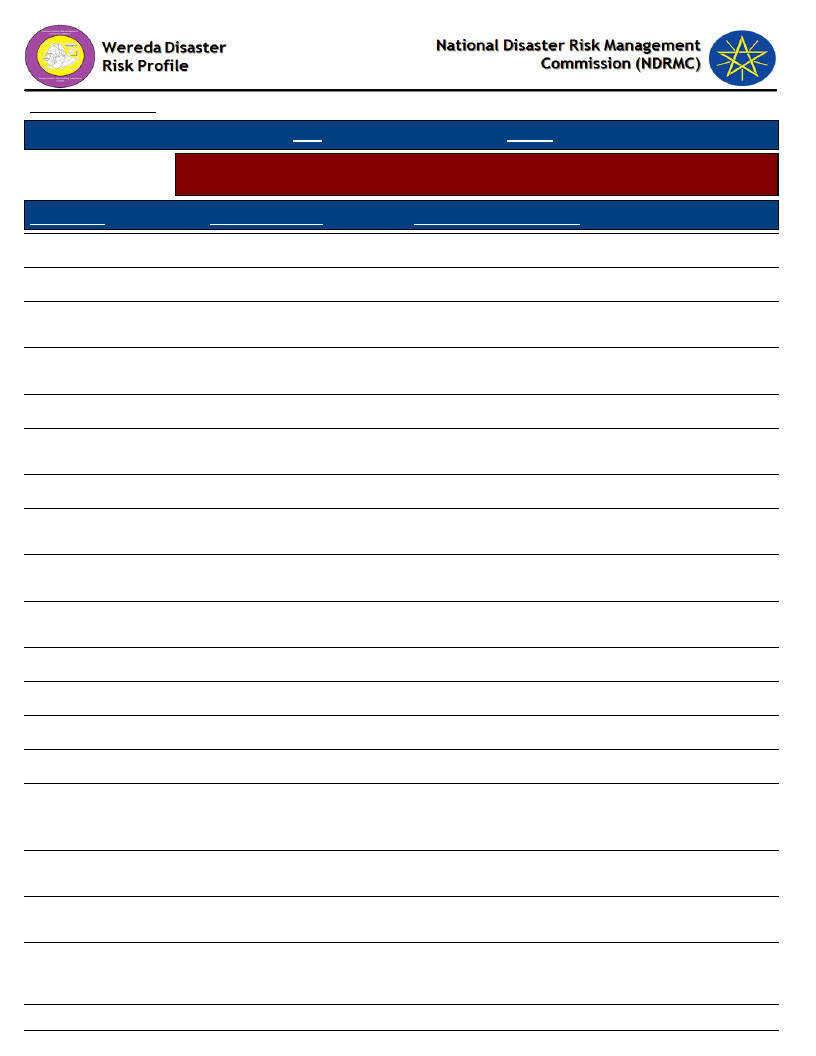
Data_Collected_Date
Wednesday, July 10, 2019
S.N.N.P
Region
Selected Indicator
Zone GURAGE
Wereda MESKAN
Environmental Situation: Changes in Landscape - Changes observed by the
community on landscape and the problems due to the changes
KebeleName
Changes_Observed
Problems_Due_To_Changes
BATI FATO
Decreased
Shortage of land, decrease soil fertility, low yield
BATI LEJANO
BECHE BULCHANO
BERESA
DEBO TUTO
Decreased land cover
Land use and land cover is
decreased
Land use is decreased
Erosion, land scarce, decreasing fertility and
productivity
Less cultivated land face the community poverty
Less cultivated land and soil fertility is very poor
DEBUB SHERSHERA
DEGAGOGOT
Decreased land cover
Decreased
Soil erosion, decreased soil fertility, less
productivity
Decreased soil fertility, increased soil erosion
DIDA
DIRAMA
DOBENA
GIDENA ABORAT
Decreased
Decreased
Decreased land cover
Decreasing land cover
Land shortage, soil fertility problem, less
productivity
Soil erosion, decreased soil fertility, shortage of
land, less yield
Erosion, less production, less soil fertility,
shortage of food
Erosion, less fertility, decreased productivity
GOYBAN
Increased
ILE
Decreasing
Drought, soil erosion
INSENO USME
Increased
No
JOLE ANDENYA
JOLE HULETENYA
MEKICHO
MESERETEWEGERAMO
Land cover decreased, over
grazing, improper farm
practice
Decreased
Decreased land cover
Increased
Drought, soil erosion, flood, run off
Land shortage, less soil fertility, soil erosion, less
productivity
Migration, land shortage, low productivity, soil
erosion, food shortage
111
Page 1 of 2
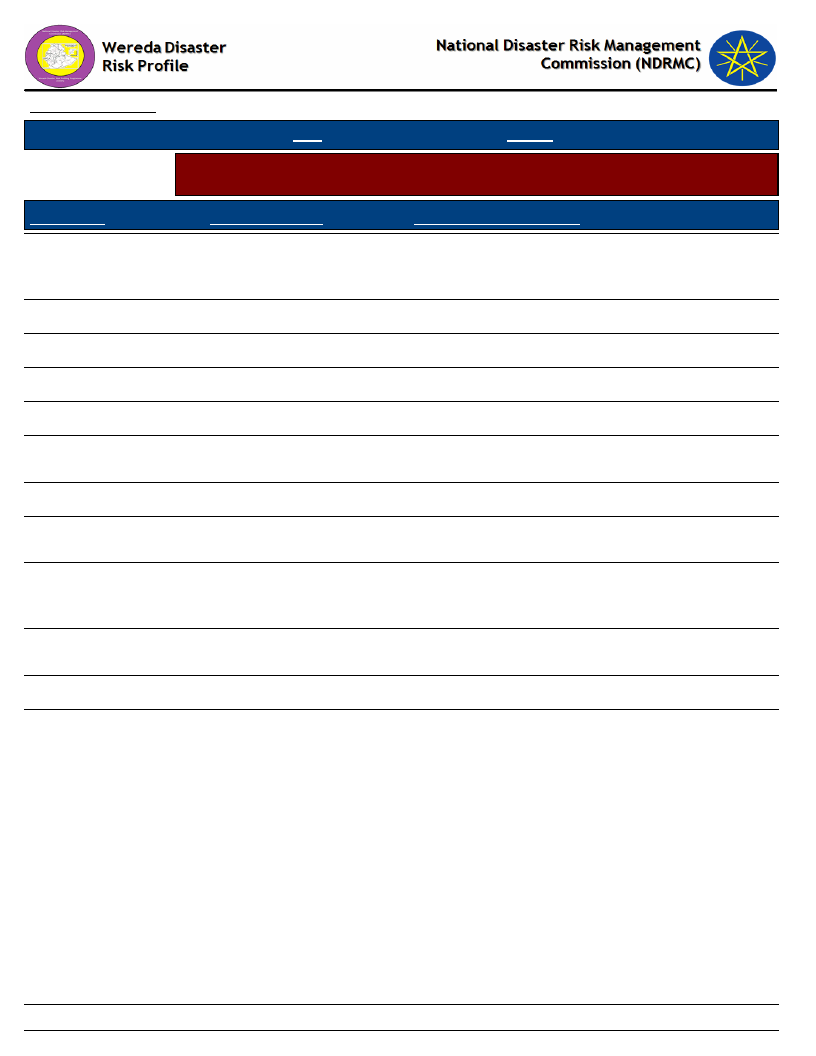
Data_Collected_Date
Wednesday, July 10, 2019
S.N.N.P
Region
Selected Indicator
Zone GURAGE
Wereda MESKAN
Environmental Situation: Changes in Landscape - Changes observed by the
community on landscape and the problems due to the changes
KebeleName
Changes_Observed
Problems_Due_To_Changes
MIKAELO
MIRAB IMBOR
Land coverage decreased
because of over grazing and
deforestation
Decreased
Erosion, decreased soil fertility
Soil erosion, less soil fertility, decreased yield
MIRAB MESKAN
Decreased land cover
Soil erosion, decreased soil fertility
OCHAGENEME
Decreased
Drought, soil erosion, less soil fertility
SEMEN SHORSHORA
Increased
SHERSHERA MACHMENA
WEJABATI
Decreased
Decreased
Land source, less soil fertility, shortage of food,
migration
Drought, soil erosion
WITA
WOLENSHO ANDENYA
YETABON
YIMERWACHO 2NYA
Land cover is decreased,
over grazing, degradation
Land coverage decreased
due to over grazing,
deforestation
Decreased land cover
Decreased
Drought, soil erosion
Erosion, decrease soil fertility
Land shortage, low soil fertility, soil erosion,
decreased yield
Shortage of food, soil erosion
YIMERWACHO 3NYA
Increased
112
Page 2 of 2
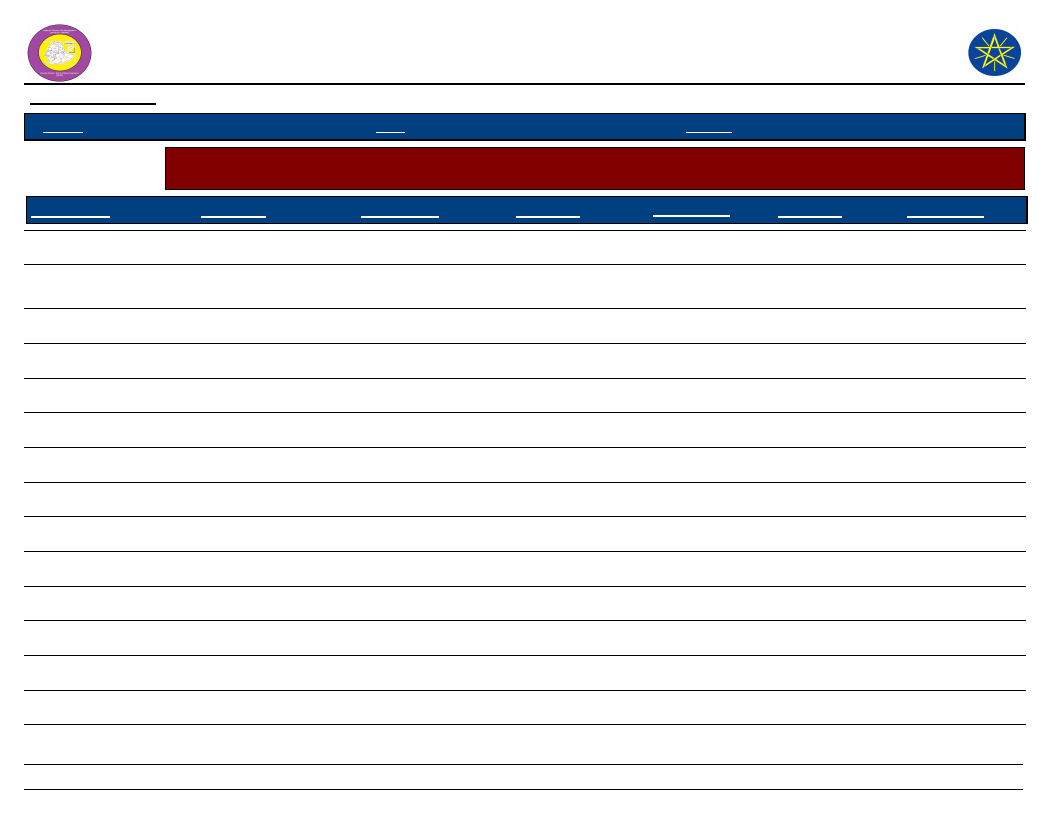
Wereda Disaster Risk
Profile
Data_Collected_Date
Region S.N.N.P
Zone GURAGE
National Disaster Risk Management
Commission (NDRMC)
Wednesday, July 10, 2019
Wereda MESKAN
Selected Indicator
Kebele Name
Environmental Situation: Land-Use other than crop production - Types of land use other than crop production
across Kebeles
Landuse_1
Comments_1
Landuse_2
Comments_2
Landuse_3
Comments_3
BATI FATO
Grazing land
25 hectare
Wood land
50 hectare
BATI LEJANO
BECHE BULCHANO
Honey production/bee
keeping
Wood land
500 hive
20 hectare
Poultry
Grazing land
500 chickens
10 hectare
BERESA
Poultry
450
Bee keeping
10
DEBO TUTO
Fattening
Poultry
Bee keeping
DEBUB SHERSHERA
Wood land
62.5 hectare
Grazing land
5 hectare
DEGAGOGOT
Land
40
Wood
30
Forest
30
DIDA
Wood land
37.5 hectare
Grazing land
75 hectare
DIRAMA
Frost land
212 hectare
Grazing land
15.6 hectare
DOBENA
Wood land
27 hectare
Grazing gland
20 hectare
GIDENA ABORAT
Grazing land
25 hectare
Forest land
15 hectare
Harvest
12 hectare
GOYBAN
Farm land
High
Grazing gland
Low
Forest
Low
ILE
Grazing land
230 hectare
Bee keeping
300 hive
INSENO USME
Poultry farm
750 chicks
Bee keeping
450 hive
JOLE ANDENYA
Honey production
50
113
Page 1 of 2
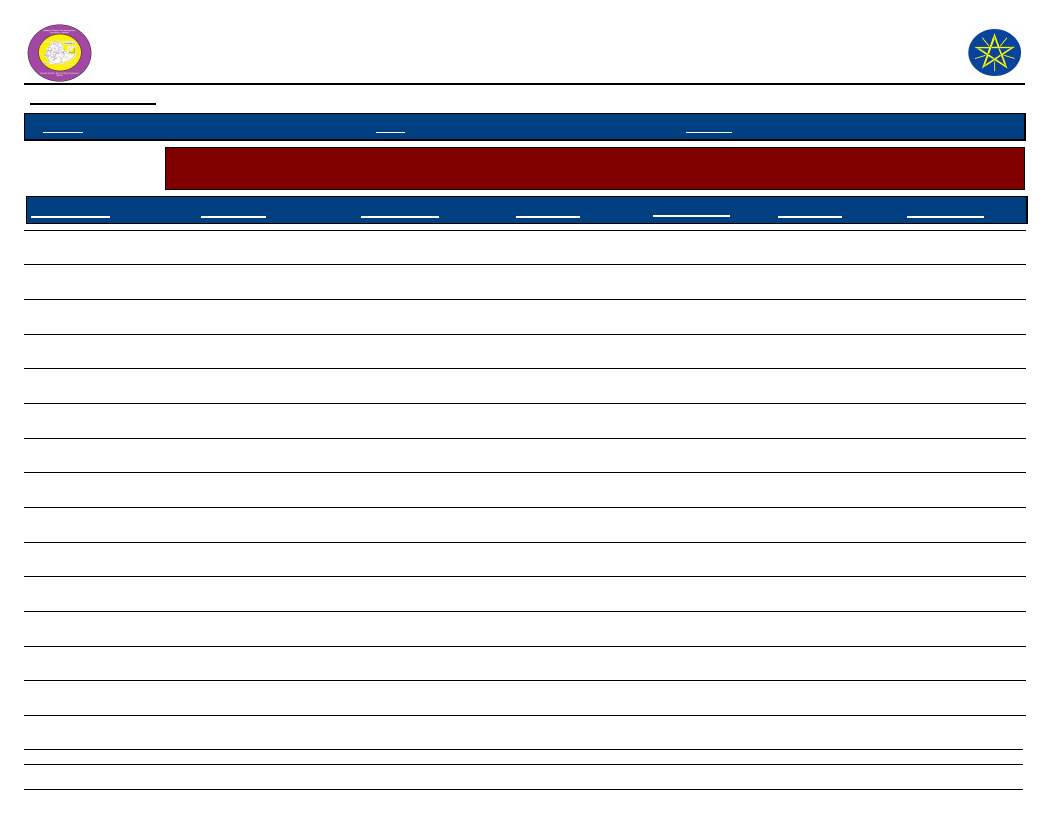
Wereda Disaster Risk
Profile
Data_Collected_Date
Region S.N.N.P
Zone GURAGE
National Disaster Risk Management
Commission (NDRMC)
Wednesday, July 10, 2019
Wereda MESKAN
Selected Indicator
Kebele Name
Environmental Situation: Land-Use other than crop production - Types of land use other than crop production
across Kebeles
Landuse_1
Comments_1
Landuse_2
Comments_2
Landuse_3
Comments_3
JOLE HULETENYA
Wood land
46 hectare
Grazing land
36 hectare
MEKICHO
Forest
25 hectare
Grazing land
15
MESERETEWEGERAMO
Grazing land
500
Honey production
1000 hive
Forest
150 hectare
MIKAELO
Honey production
200 bee keeping
Fattening
200 cattle
Grazing land
20 hectare
MIRAB IMBOR
Forest land
28 hectare
Grazing land
13 hectare
MIRAB MESKAN
Forest
38.75 hectare
Grazing land
31 hectare
OCHAGENEME
Honey production
200 hive
SEMEN SHORSHORA
Farm land
Grazing land
Forest land
SHERSHERA MACHMENA
Grazing land
21 hectare
Forest
18 hectare
Harvest land
4 hectare
WEJABATI
Honey production
250
WITA
Grazing
6
Honey production
100
WOLENSHO ANDENYA
Grazing land
10 hectare
Bee keeping
200 hive
YETABON
Forest
71.5 hectare
Grazing land
34.5 hectare
YIMERWACHO 2NYA
Forest
18 hectare
Grazing land
21 hectare
Harvesting
5.5
YIMERWACHO 3NYA
114
Page 2 of 2
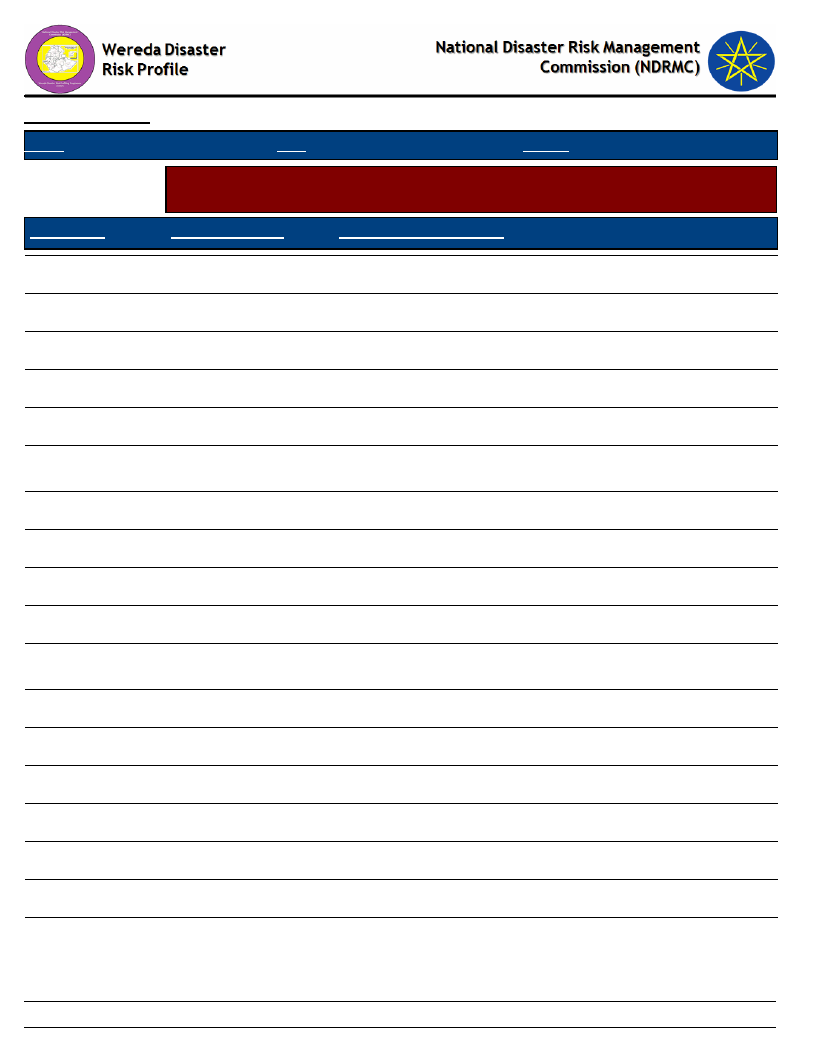
Data_Collected_Date
Region S.N.N.P
Zone GURAGE
Wednesday, July 10, 2019
Wereda MESKAN
Selected Indicator
KebeleName
Environmental Situation: Deforestation - Observed changes over levels of
deforestation by the community and its problems
Changes_Observed
Problems_Due_To_Changes
BATI FATO
Increased
Erosion, climate change
BATI LEJANO
Increased
Climate change, erosion
BECHE BULCHANO
Decreased
BERESA
Decreased
Climate change erosion
DEBO TUTO
Increased
climate change, erosion
DEBUB
SHERSHERA
DEGAGOGOT
Decreased
Decreased
DIDA
Decreased
DIRAMA
Increased
Soil erosion, decreased soil fertility, low productivity
DOBENA
Increased
Erosion, climate change, low soil fertility
GIDENA ABORAT
GOYBAN
Increased
Decreased
Weather change, increased temperature, decreased
fertility, drought
Develop community awareness
ILE
Increasing
Climate change, soil erosion
INSENO USME
Increased
Climate change
JOLE ANDENYA
Increased
Climate change
JOLE HULETENYA
Increased
Rain shortage, climate change, soil erosion, flood
MEKICHO
Increased
Weather change, rain shortage, low fertility, erosion
MESERETEWEGERA
MO
Decreased
115
Page 1 of 2
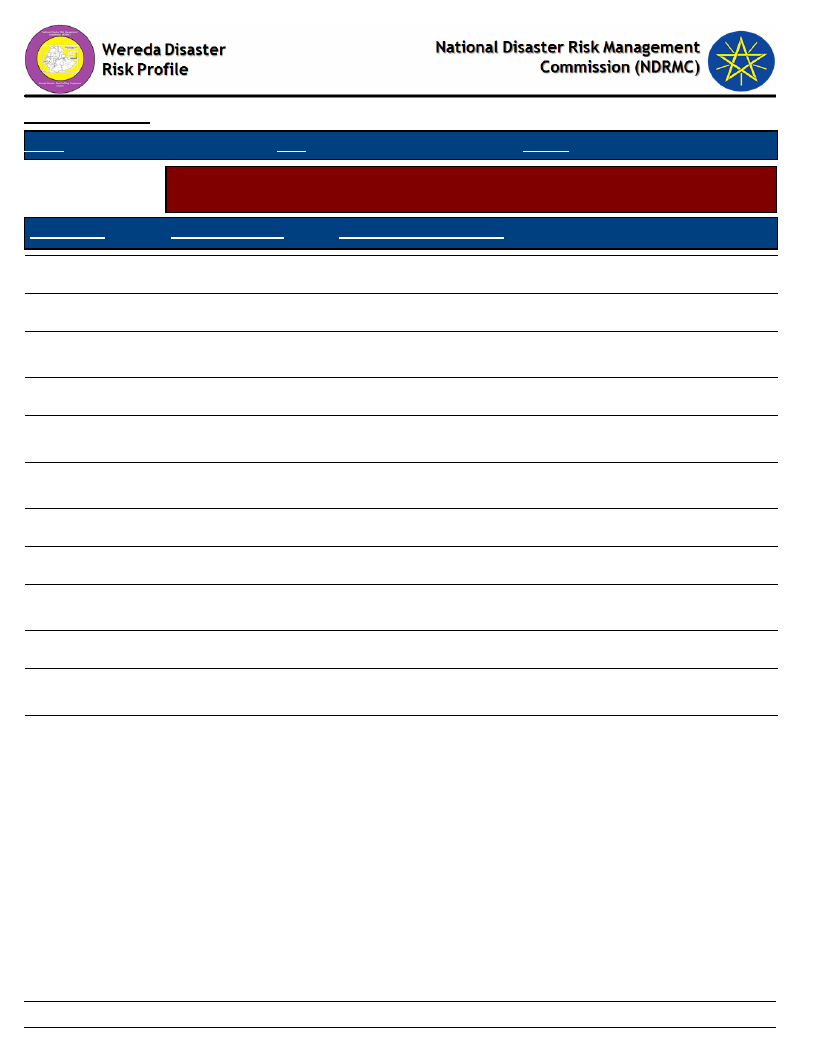
Data_Collected_Date
Region S.N.N.P
Zone GURAGE
Wednesday, July 10, 2019
Wereda MESKAN
Selected Indicator
KebeleName
Environmental Situation: Deforestation - Observed changes over levels of
deforestation by the community and its problems
Changes_Observed
Problems_Due_To_Changes
MIKAELO
Increased
Climate change, erosion
MIRAB IMBOR
Decreased
MIRAB MESKAN
OCHAGENEME
Increased
Decreased
Water shortage, soil erosion, concern flood, less soil
fertility
Climate change, erosion
SEMEN
SHORSHORA
SHERSHERA
MACHMENA
WEJABATI
Increased
Increased
Increasing
Loss of soil fertility, soil erosion, flood, shortage of
productivity
Erosion, decreased soil fertility, decrease productivity
Climate change, soil erosion
WITA
Increased
Climate change, erosion
WOLENSHO
ANDENYA
YETABON
Increased
Increased
Climate change, erosion
Flood, soil erosion, low soil fertility, decreased yield
YIMERWACHO
2NYA
YIMERWACHO
3NYA
Increased
Increased
Climate change, erosion
Climate change
116
Page 2 of 2
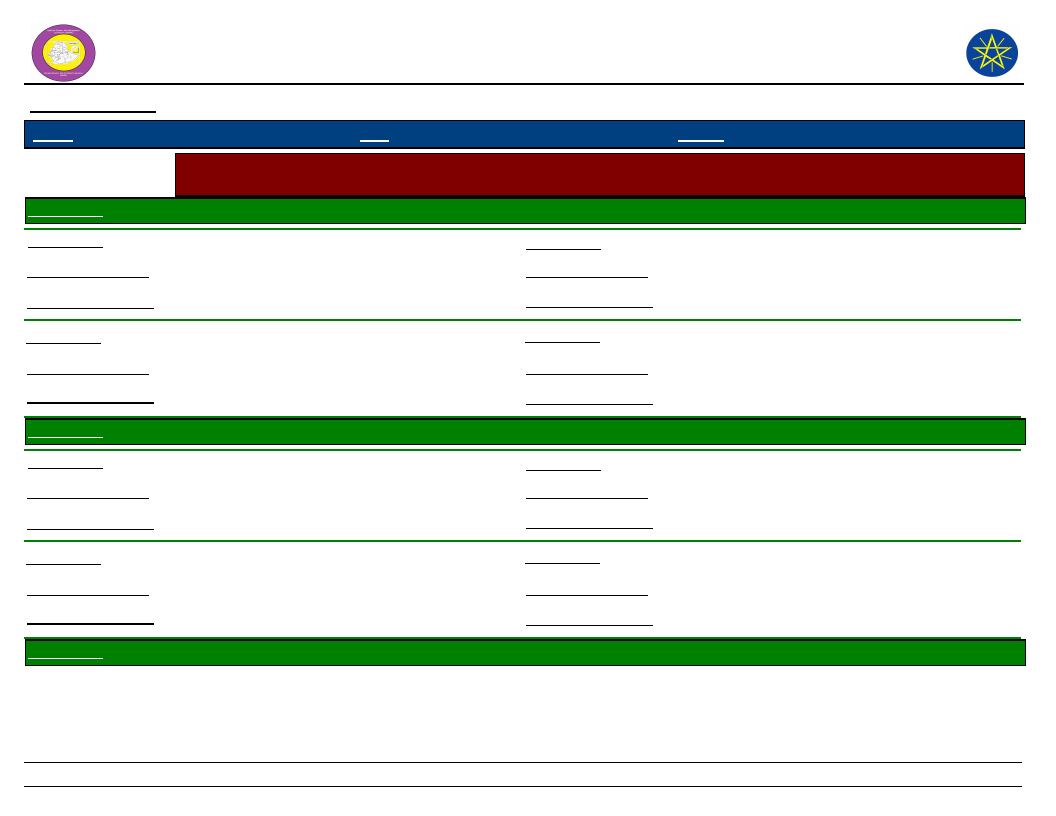
Wereda Disaster
Risk Profile
National Disaster Risk Management
Commission (NDRMC)
Data_Collected_Date
Region S.N.N.P
Zone GURAGE
Wereda MESKAN
Wednesday, July 10, 2019
Selected Indicator
KebeleName
Environmental Situation: Natural Resources Availability - Natural resources available and changes observed by
the community
BATI FATO
Resources_1
Land
Resources_3
Observed_Change_1
Decreased
Observed_Change_3
Problems_Changes_1
Population increased
Problems_Changes_3
Resources_2
Observed_Change_2
Problems_Changes_2
Ground water
Increased
Resources_4
Observed_Change_4
Problems_Changes_4
KebeleName
BATI LEJANO
Resources_1
Land
Observed_Change_1
No change
Problems_Changes_1
Resources_3
Observed_Change_3
Problems_Changes_3
Resources_2
Observed_Change_2
Problems_Changes_2
Water
Pollution
Human disease
Resources_4
Observed_Change_4
Problems_Changes_4
KebeleName
BECHE BULCHANO
117
Page 1 of 15
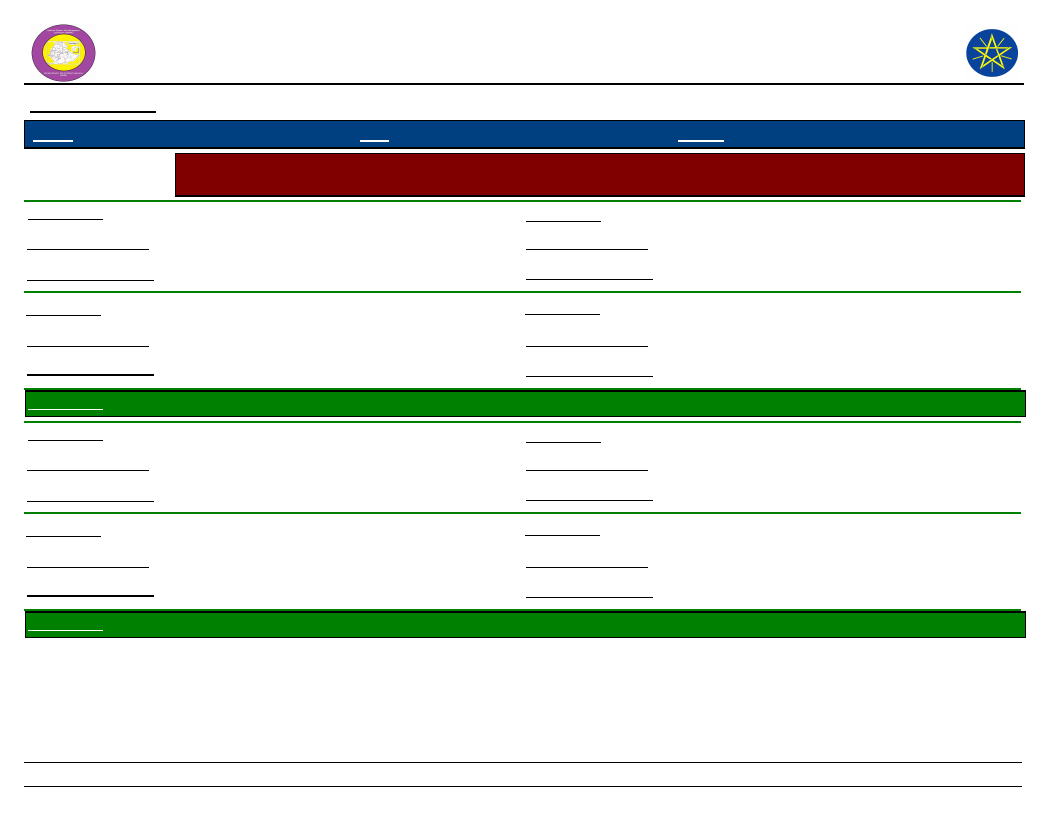
Wereda Disaster
Risk Profile
National Disaster Risk Management
Commission (NDRMC)
Data_Collected_Date
Region S.N.N.P
Zone GURAGE
Wereda MESKAN
Wednesday, July 10, 2019
Selected Indicator
Resources_1
Observed_Change_1
Problems_Changes_1
Environmental Situation: Natural Resources Availability - Natural resources available and changes observed by
the community
Land
Resources_3
River water
Decreased
Observed_Change_3
Decreased
Population density
Problems_Changes_3
Drought
Resources_2
Observed_Change_2
Problems_Changes_2
Ground water
Decreased
Drought
Resources_4
Observed_Change_4
Problems_Changes_4
KebeleName
BERESA
Resources_1
Land
Observed_Change_1
Problems_Changes_1
No food security
Resources_3
Observed_Change_3
Problems_Changes_3
Forest
Decreased
Less re plantation
Resources_2
Observed_Change_2
Problems_Changes_2
Water
Decreased
Water scarcity
Resources_4
Observed_Change_4
Problems_Changes_4
KebeleName
DEBO TUTO
118
Page 2 of 15
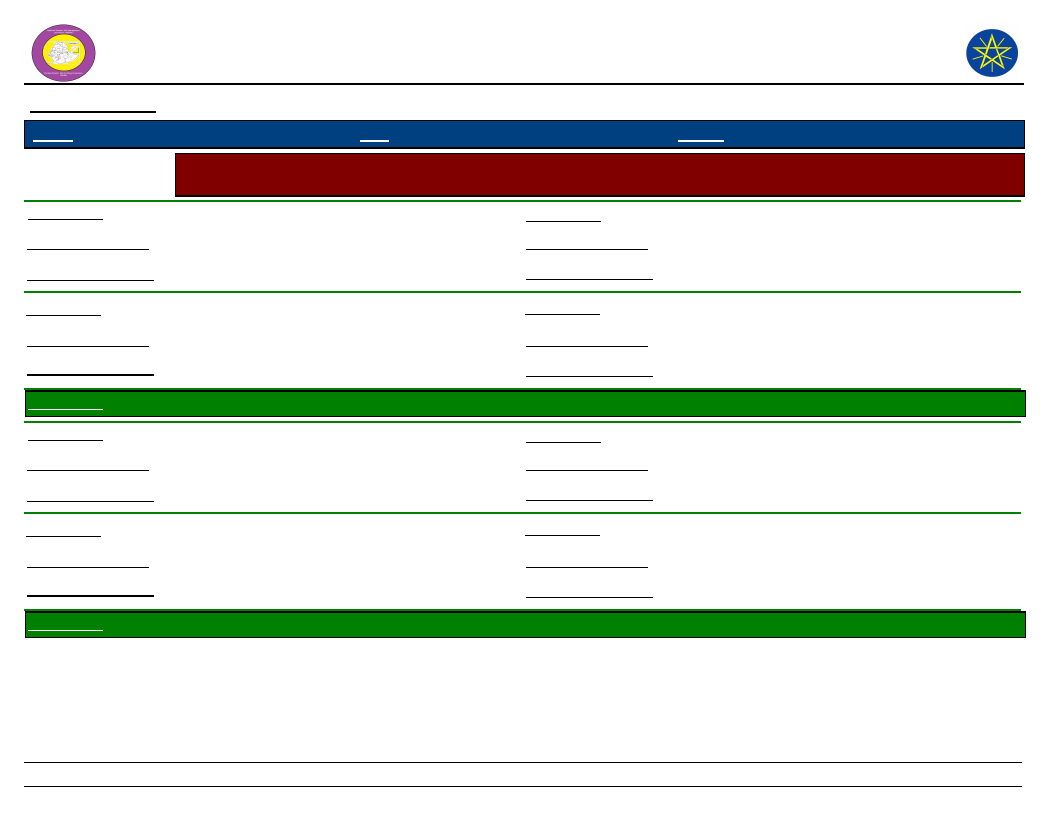
Wereda Disaster
Risk Profile
National Disaster Risk Management
Commission (NDRMC)
Data_Collected_Date
Region S.N.N.P
Zone GURAGE
Wereda MESKAN
Wednesday, July 10, 2019
Selected Indicator
Resources_1
Observed_Change_1
Problems_Changes_1
Environmental Situation: Natural Resources Availability - Natural resources available and changes observed by
the community
Land
Resources_3
Forest
Increase stone and sand
Observed_Change_3
Decreased
No food security
Problems_Changes_3
No tree plantation
Resources_2
Observed_Change_2
Problems_Changes_2
Water
Decreased
Water scarcity
Resources_4
Observed_Change_4
Problems_Changes_4
KebeleName
DEBUB SHERSHERA
Resources_1
Land
Observed_Change_1
Decreased
Problems_Changes_1
Land shortage
Resources_3
Observed_Change_3
Problems_Changes_3
Stone
Decreased
Shortage of construction materials
Resources_2
Observed_Change_2
Problems_Changes_2
Water
Decreased
Shortage of water
Resources_4
Observed_Change_4
Problems_Changes_4
Sand
Decreased
Shortage of construction materials
KebeleName
DEGAGOGOT
119
Page 3 of 15
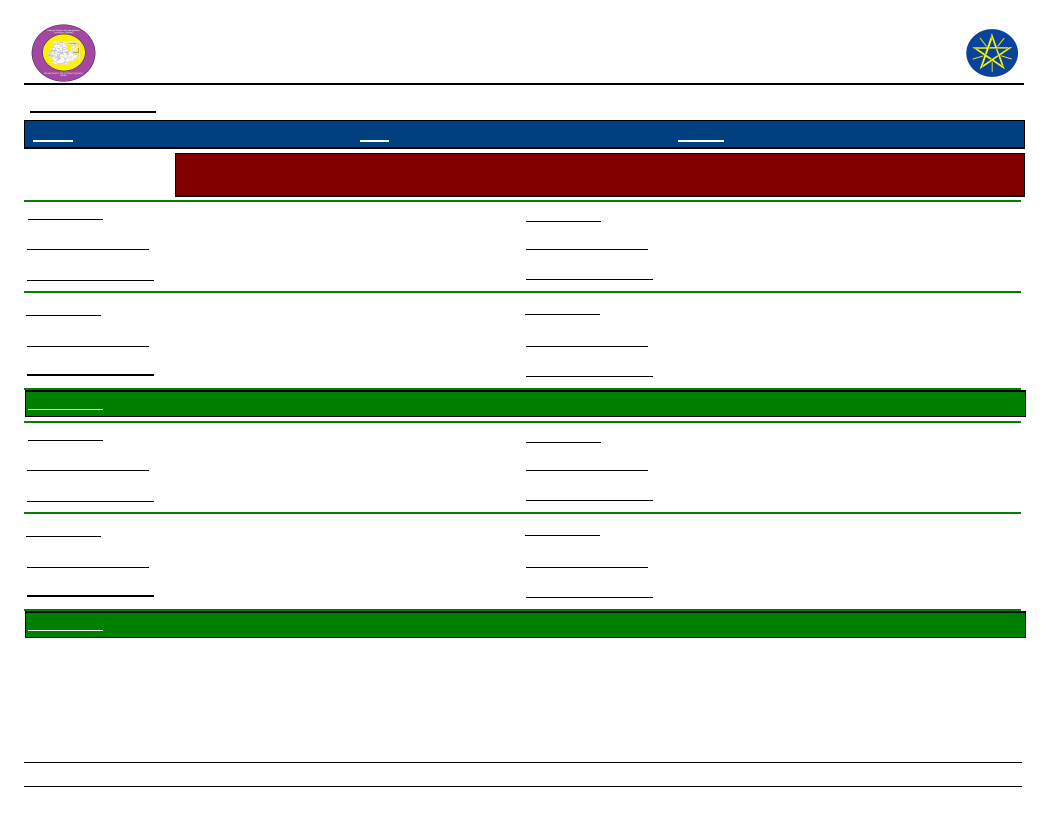
Wereda Disaster
Risk Profile
National Disaster Risk Management
Commission (NDRMC)
Data_Collected_Date
Region S.N.N.P
Zone GURAGE
Wereda MESKAN
Wednesday, July 10, 2019
Selected Indicator
Resources_1
Observed_Change_1
Problems_Changes_1
Environmental Situation: Natural Resources Availability - Natural resources available and changes observed by
the community
Land
Resources_3
Wood
Decreased
Observed_Change_3
Increased
Shortage of farm land
Problems_Changes_3
Forestation
Resources_2
Observed_Change_2
Problems_Changes_2
Spring and river
Decreased
Climate change
Resources_4
Observed_Change_4
Problems_Changes_4
Forest
Decreased
Deforestation
KebeleName
DIDA
Resources_1
Land
Observed_Change_1
Decreased
Problems_Changes_1
Population growth
Resources_3
Observed_Change_3
Problems_Changes_3
Wood
Increased
Decreased soil fertility
Resources_2
Observed_Change_2
Problems_Changes_2
Ground water
Decreased
Shortage of water
Resources_4
Observed_Change_4
Problems_Changes_4
KebeleName
DIRAMA
120
Page 4 of 15
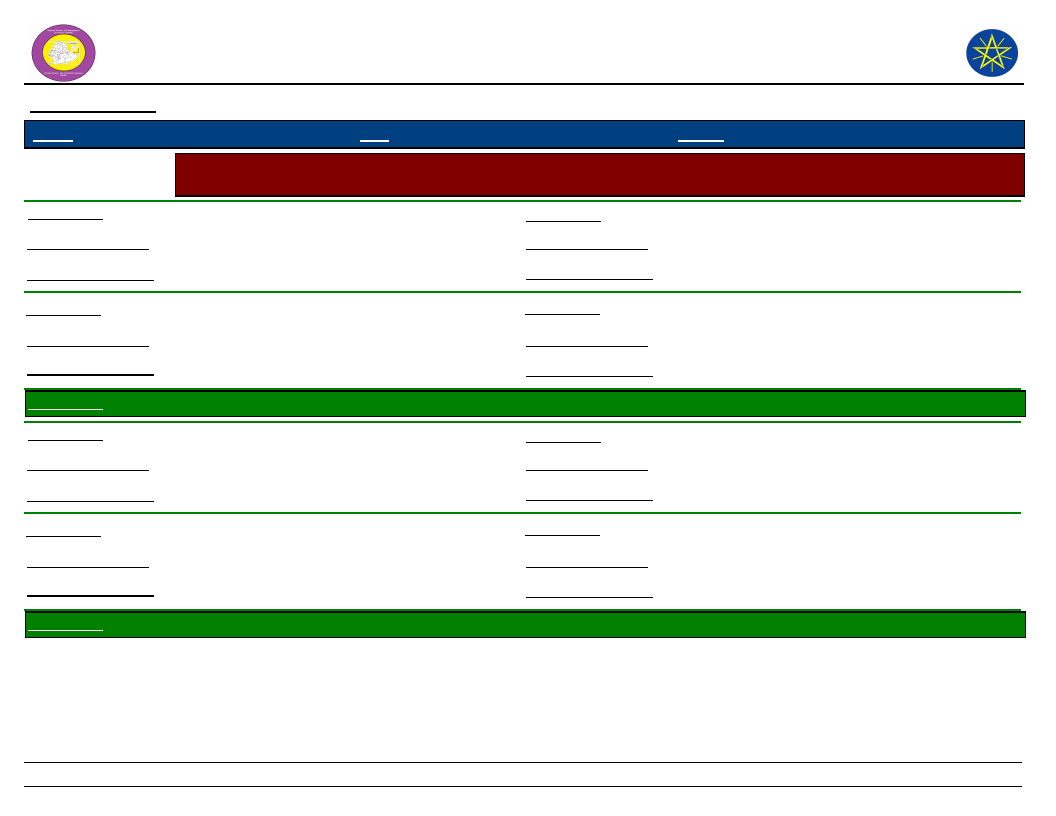
Wereda Disaster
Risk Profile
National Disaster Risk Management
Commission (NDRMC)
Data_Collected_Date
Region S.N.N.P
Zone GURAGE
Wereda MESKAN
Wednesday, July 10, 2019
Selected Indicator
Resources_1
Observed_Change_1
Problems_Changes_1
Environmental Situation: Natural Resources Availability - Natural resources available and changes observed by
the community
Land
Resources_3
Decreased
Observed_Change_3
Shortage of land /migration
Problems_Changes_3
Resources_2
Observed_Change_2
Problems_Changes_2
Forest
Increased
Compare farm land
Resources_4
Observed_Change_4
Problems_Changes_4
KebeleName
DOBENA
Resources_1
Land
Observed_Change_1
Decreased
Problems_Changes_1
Population pressure
Resources_3
Observed_Change_3
Problems_Changes_3
Resources_2
Observed_Change_2
Problems_Changes_2
Ground water
Decreased
Drought
Resources_4
Observed_Change_4
Problems_Changes_4
KebeleName
GIDENA ABORAT
121
Page 5 of 15
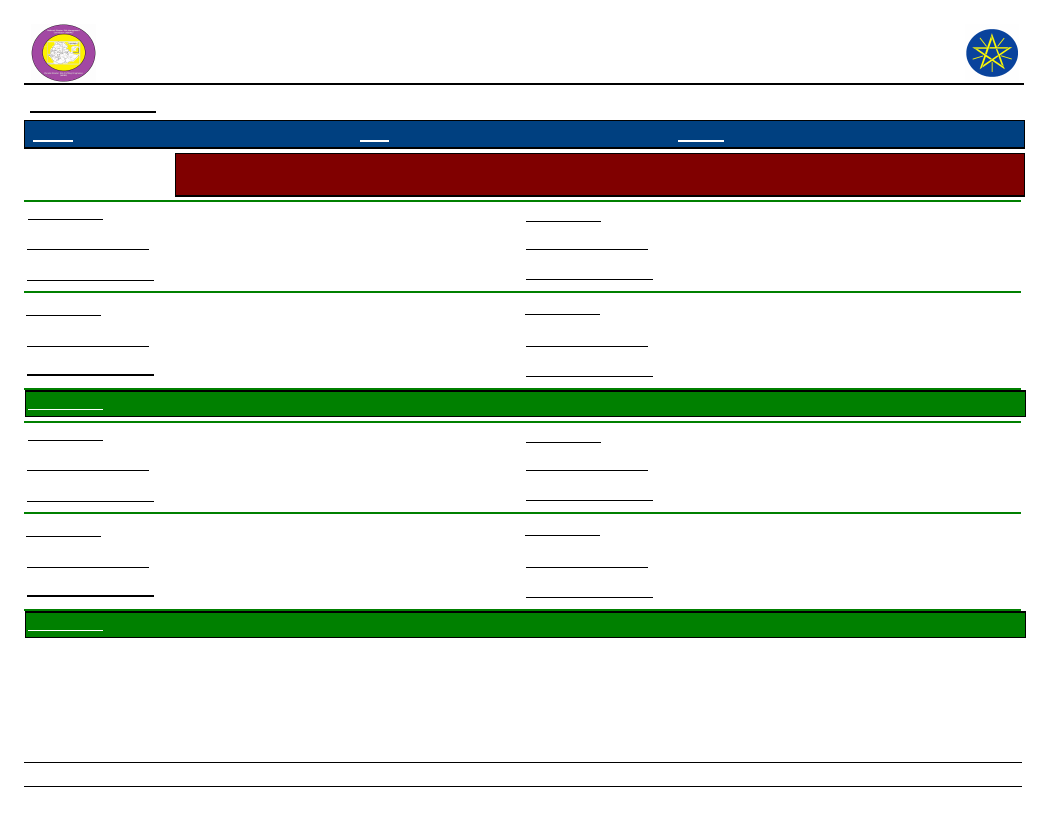
Wereda Disaster
Risk Profile
National Disaster Risk Management
Commission (NDRMC)
Data_Collected_Date
Region S.N.N.P
Zone GURAGE
Wereda MESKAN
Wednesday, July 10, 2019
Selected Indicator
Resources_1
Observed_Change_1
Problems_Changes_1
Environmental Situation: Natural Resources Availability - Natural resources available and changes observed by
the community
Land
Resources_3
Wood
Decreased
Observed_Change_3
Increased
Migration, poverty, food scarcity
Problems_Changes_3
Problem of soil fertility
Resources_2
Observed_Change_2
Problems_Changes_2
Water
Decreased
Water shortage, human disease
Resources_4
Observed_Change_4
Problems_Changes_4
KebeleName
GOYBAN
Resources_1
Land
Observed_Change_1
Same
Problems_Changes_1
Resources_3
Observed_Change_3
Problems_Changes_3
Forest
Decreased
Deforestation
Resources_2
Observed_Change_2
Problems_Changes_2
Wood
Decreased
Low forestation
Resources_4
Observed_Change_4
Problems_Changes_4
KebeleName
ILE
122
Page 6 of 15
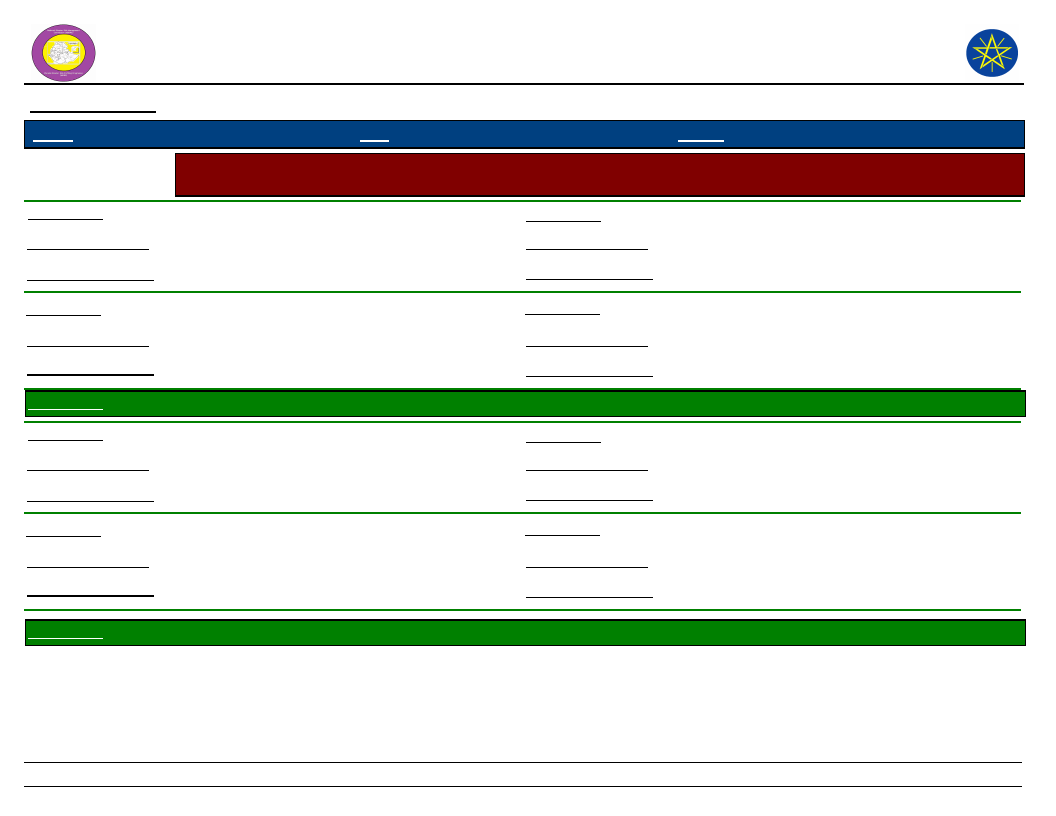
Wereda Disaster
Risk Profile
National Disaster Risk Management
Commission (NDRMC)
Data_Collected_Date
Region S.N.N.P
Zone GURAGE
Wereda MESKAN
Wednesday, July 10, 2019
Selected Indicator
Resources_1
Observed_Change_1
Problems_Changes_1
Environmental Situation: Natural Resources Availability - Natural resources available and changes observed by
the community
Land
Resources_3
No change
Observed_Change_3
Problems_Changes_3
Resources_2
Observed_Change_2
Problems_Changes_2
Water
Decrease
Pollution
Resources_4
Observed_Change_4
Problems_Changes_4
KebeleName
INSENO USME
Resources_1
Land
Observed_Change_1
No change
Problems_Changes_1
Resources_3
Observed_Change_3
Problems_Changes_3
Resources_2
Water
Observed_Change_2
Decreased
Problems_Changes_2
Lack of of drinking water both for human
and animal
KebeleName
JOLE ANDENYA
Resources_4
Observed_Change_4
Problems_Changes_4
123
Page 7 of 15
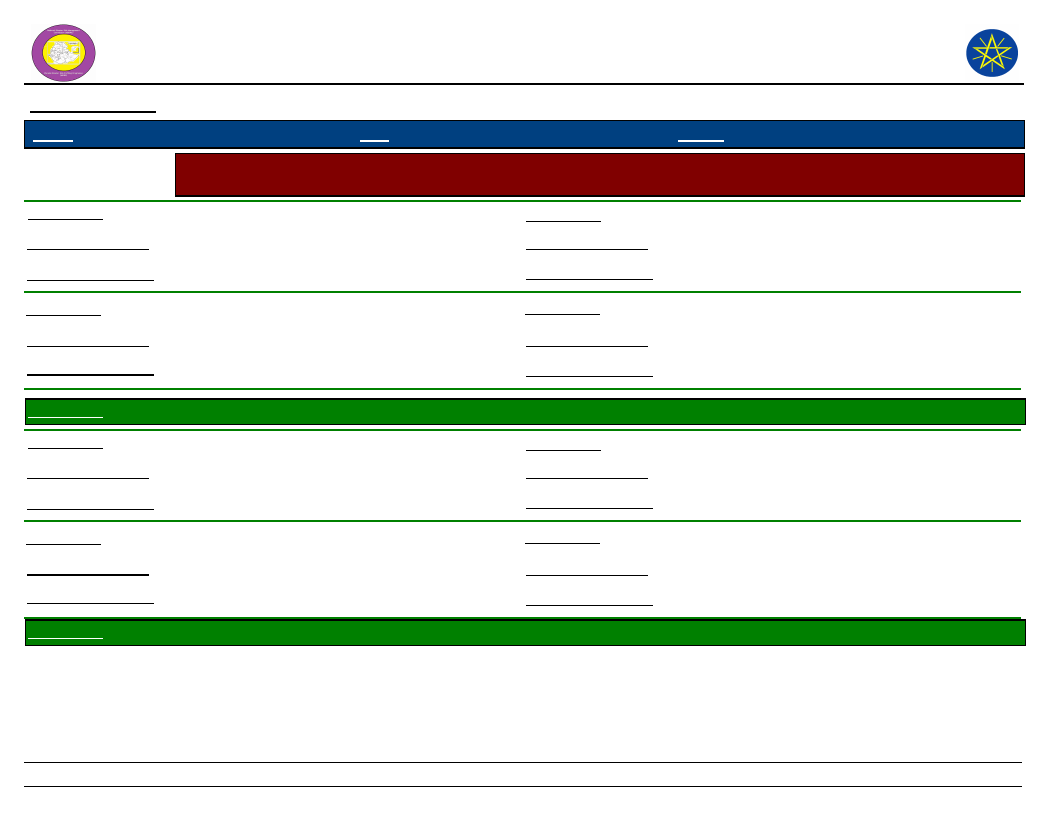
Wereda Disaster
Risk Profile
National Disaster Risk Management
Commission (NDRMC)
Data_Collected_Date
Region S.N.N.P
Zone GURAGE
Wereda MESKAN
Wednesday, July 10, 2019
Selected Indicator
Resources_1
Observed_Change_1
Problems_Changes_1
Environmental Situation: Natural Resources Availability - Natural resources available and changes observed by
the community
Land
Resources_3
Forest
Increased
Observed_Change_3
Increased
Using fertilizer
Problems_Changes_3
Planting trees
Resources_2
Water
Observed_Change_2
Increased
Problems_Changes_2
Do soil and water conservation and water
harvesting
KebeleName
JOLE HULETENYA
Resources_1
Land
Observed_Change_1
Decreased
Problems_Changes_1
Shortage of land
Resources_4
Observed_Change_4
Problems_Changes_4
Resources_3
Observed_Change_3
Problems_Changes_3
River
Decreased
Conflict to others
Resources_2
Observed_Change_2
Problems_Changes_2
Ground water
Decreased
exposed to additional cost
Resources_4
Observed_Change_4
Problems_Changes_4
KebeleName
MEKICHO
124
Page 8 of 15
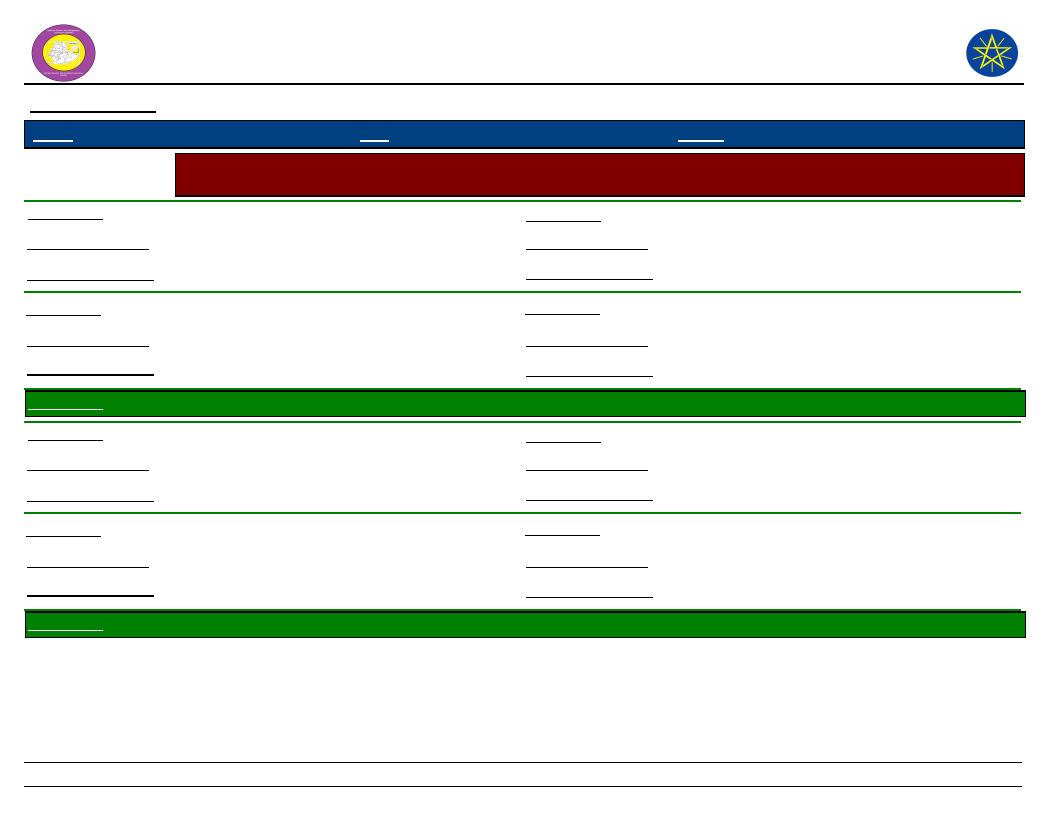
Wereda Disaster
Risk Profile
National Disaster Risk Management
Commission (NDRMC)
Data_Collected_Date
Region S.N.N.P
Zone GURAGE
Wereda MESKAN
Wednesday, July 10, 2019
Selected Indicator
Resources_1
Observed_Change_1
Problems_Changes_1
Environmental Situation: Natural Resources Availability - Natural resources available and changes observed by
the community
Land
Resources_3
Decreased
Observed_Change_3
Migration, erosion, less fertility
Problems_Changes_3
Resources_2
Observed_Change_2
Problems_Changes_2
Tree
Increased
Less soil fertility
Resources_4
Observed_Change_4
Problems_Changes_4
KebeleName
MESERETEWEGERAMO
Resources_1
Land
Observed_Change_1
No change
Problems_Changes_1
Resources_3
Observed_Change_3
Problems_Changes_3
Resources_2
Observed_Change_2
Problems_Changes_2
Water
No change
Resources_4
Observed_Change_4
Problems_Changes_4
KebeleName
MIKAELO
125
Page 9 of 15
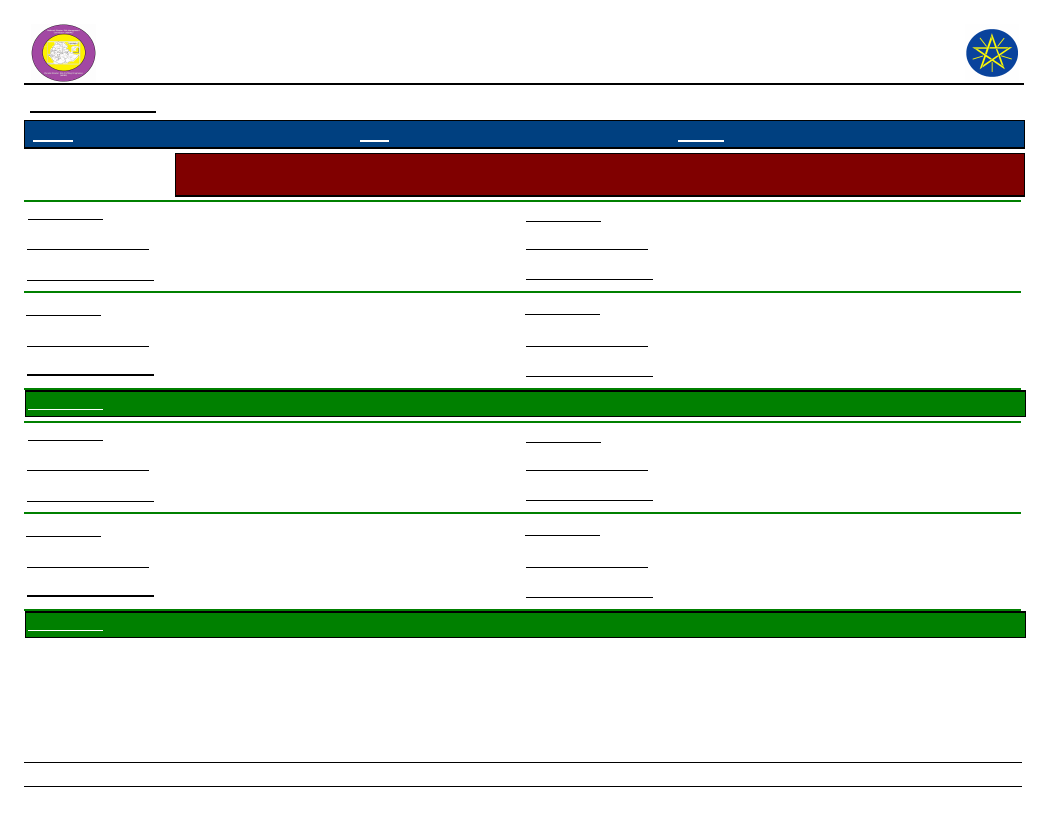
Wereda Disaster
Risk Profile
National Disaster Risk Management
Commission (NDRMC)
Data_Collected_Date
Region S.N.N.P
Zone GURAGE
Wereda MESKAN
Wednesday, July 10, 2019
Selected Indicator
Resources_1
Observed_Change_1
Problems_Changes_1
Environmental Situation: Natural Resources Availability - Natural resources available and changes observed by
the community
Land
Resources_3
Wood
Eroded
Observed_Change_3
Decreased
Soil erosion, less soil fertility
Problems_Changes_3
Cutting forest
Resources_2
Observed_Change_2
Problems_Changes_2
Water
Decreased
No clean water usable program
Resources_4
Observed_Change_4
Problems_Changes_4
KebeleName
MIRAB IMBOR
Resources_1
Land
Observed_Change_1
Decreased
Problems_Changes_1
Population growth
Resources_3
Observed_Change_3
Problems_Changes_3
Resources_2
Observed_Change_2
Problems_Changes_2
Ground water
Decreased
Drought
Resources_4
Observed_Change_4
Problems_Changes_4
KebeleName
MIRAB MESKAN
126
Page 10 of 15
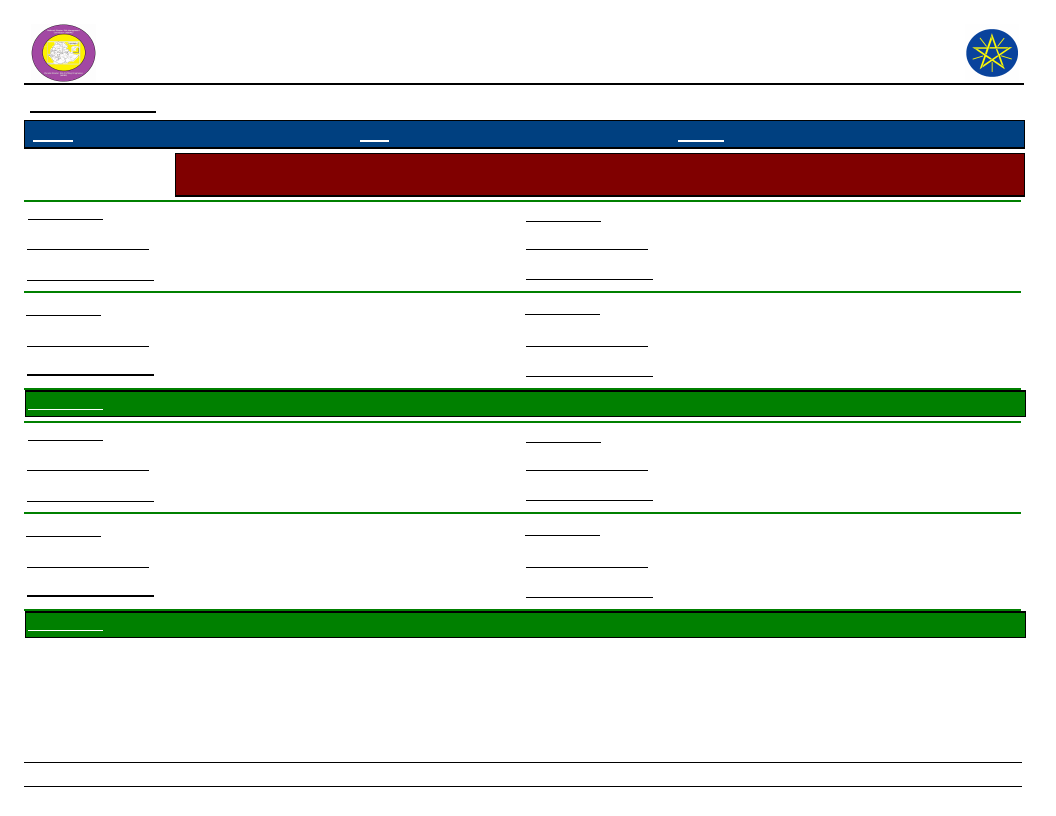
Wereda Disaster
Risk Profile
National Disaster Risk Management
Commission (NDRMC)
Data_Collected_Date
Region S.N.N.P
Zone GURAGE
Wereda MESKAN
Wednesday, July 10, 2019
Selected Indicator
Resources_1
Observed_Change_1
Environmental Situation: Natural Resources Availability - Natural resources available and changes observed by
the community
Land
Resources_3
Wood
Decreased
Observed_Change_3
Increased
Problems_Changes_1
Resources_2
Less fertility. migration, less productivity
Water
Problems_Changes_3
Resources_4
Decreased soil fertility, compute farming
crop lands
Observed_Change_2
Problems_Changes_2
Decreased
Shortage of clean water and irrigation
Observed_Change_4
Problems_Changes_4
KebeleName
OCHAGENEME
Resources_1
Land
Observed_Change_1
Eroded
Problems_Changes_1
decrease crop productivity
Resources_3
Observed_Change_3
Problems_Changes_3
Resources_2
Observed_Change_2
Problems_Changes_2
Water
Increase pollution
Human disease
Resources_4
Observed_Change_4
Problems_Changes_4
KebeleName
SEMEN SHORSHORA
127
Page 11 of 15
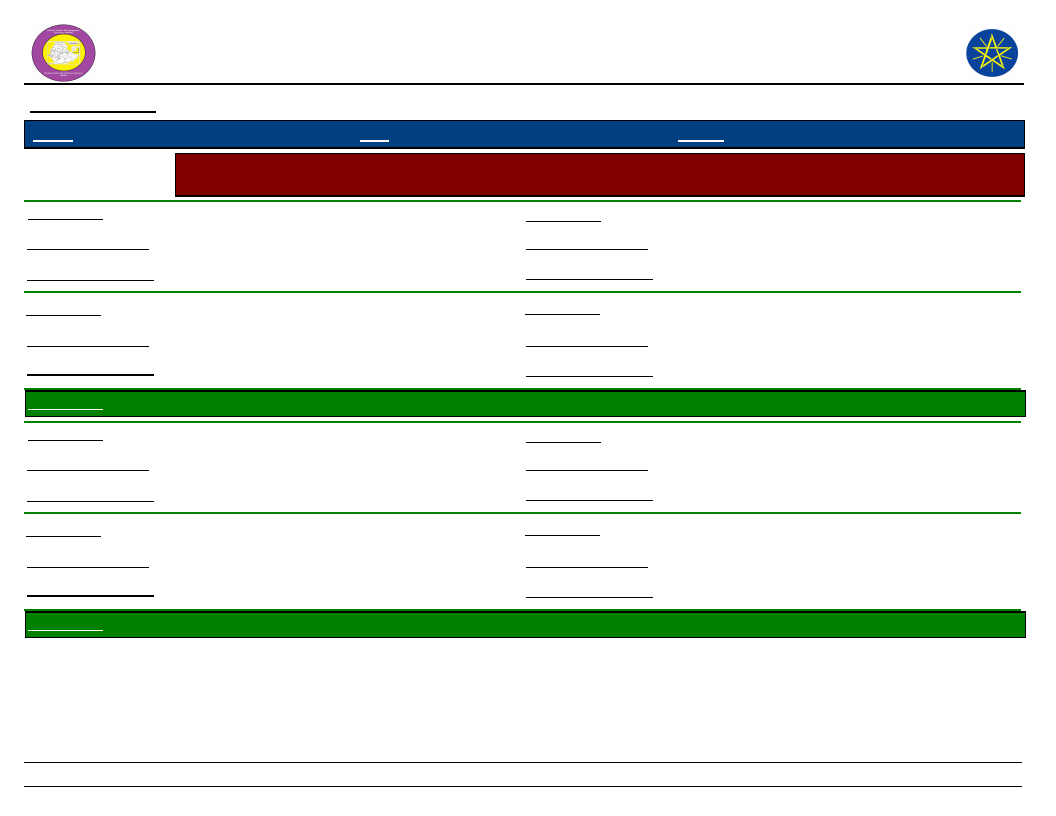
Wereda Disaster
Risk Profile
National Disaster Risk Management
Commission (NDRMC)
Data_Collected_Date
Region S.N.N.P
Zone GURAGE
Wereda MESKAN
Wednesday, July 10, 2019
Selected Indicator
Resources_1
Observed_Change_1
Problems_Changes_1
Environmental Situation: Natural Resources Availability - Natural resources available and changes observed by
the community
Land
Resources_3
Forest
Decreased
Observed_Change_3
Increased
Shortage of farm and, loss of yield
Problems_Changes_3
Resources_2
Observed_Change_2
Problems_Changes_2
Wood
Increased
Decrease soil fertility
Resources_4
Observed_Change_4
Problems_Changes_4
KebeleName
SHERSHERA MACHMENA
Resources_1
Land
Observed_Change_1
Decreased
Problems_Changes_1
Increased population
Resources_3
Observed_Change_3
Problems_Changes_3
Wood
Increased
Resources_2
Observed_Change_2
Problems_Changes_2
Forest
Increased
Resources_4
Observed_Change_4
Problems_Changes_4
KebeleName
WEJABATI
128
Page 12 of 15
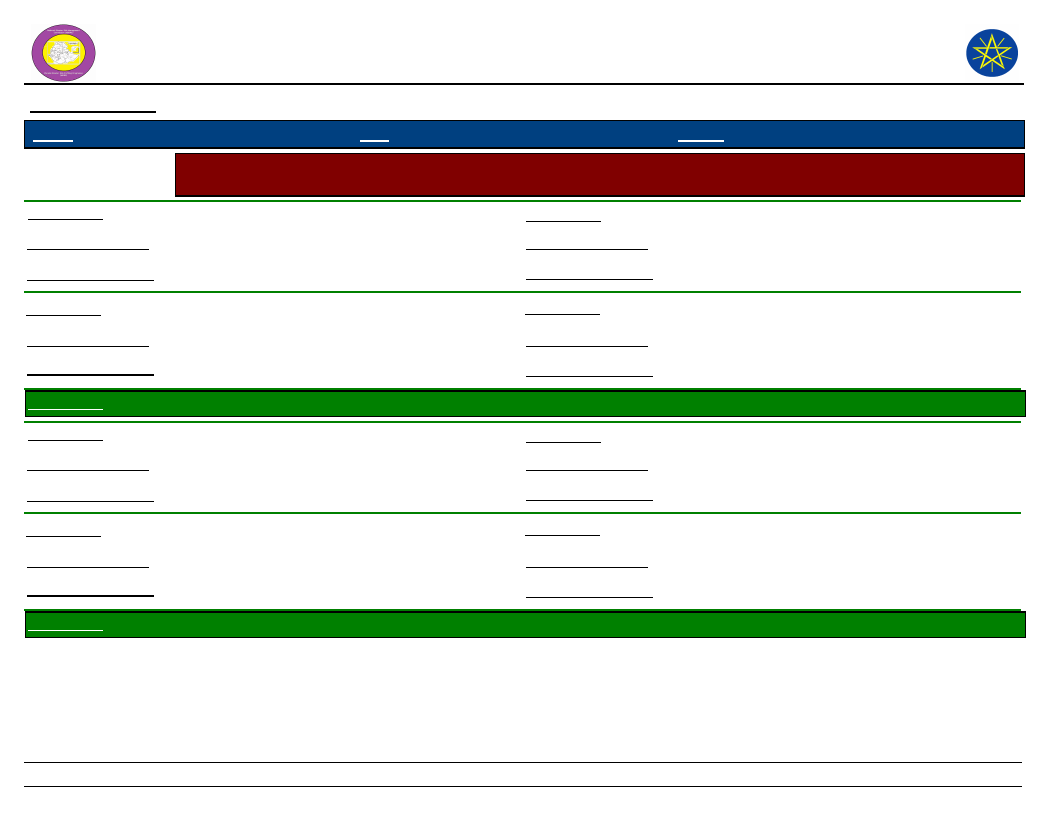
Wereda Disaster
Risk Profile
National Disaster Risk Management
Commission (NDRMC)
Data_Collected_Date
Region S.N.N.P
Zone GURAGE
Wereda MESKAN
Wednesday, July 10, 2019
Selected Indicator
Resources_1
Observed_Change_1
Problems_Changes_1
Environmental Situation: Natural Resources Availability - Natural resources available and changes observed by
the community
Land
Resources_3
No change
Observed_Change_3
Problems_Changes_3
Resources_2
Observed_Change_2
Problems_Changes_2
Water
Increasing pollution
Human disease
Resources_4
Observed_Change_4
Problems_Changes_4
KebeleName
WITA
Resources_1
Land
Observed_Change_1
Increased soil fertility
Problems_Changes_1
Resources_2
By constructing different soil conservation
activity
Water
Observed_Change_2
Increased
Problems_Changes_2
Increased water harvest activity
Resources_3
Observed_Change_3
Problems_Changes_3
Resources_4
Observed_Change_4
Problems_Changes_4
KebeleName
WOLENSHO ANDENYA
129
Page 13 of 15
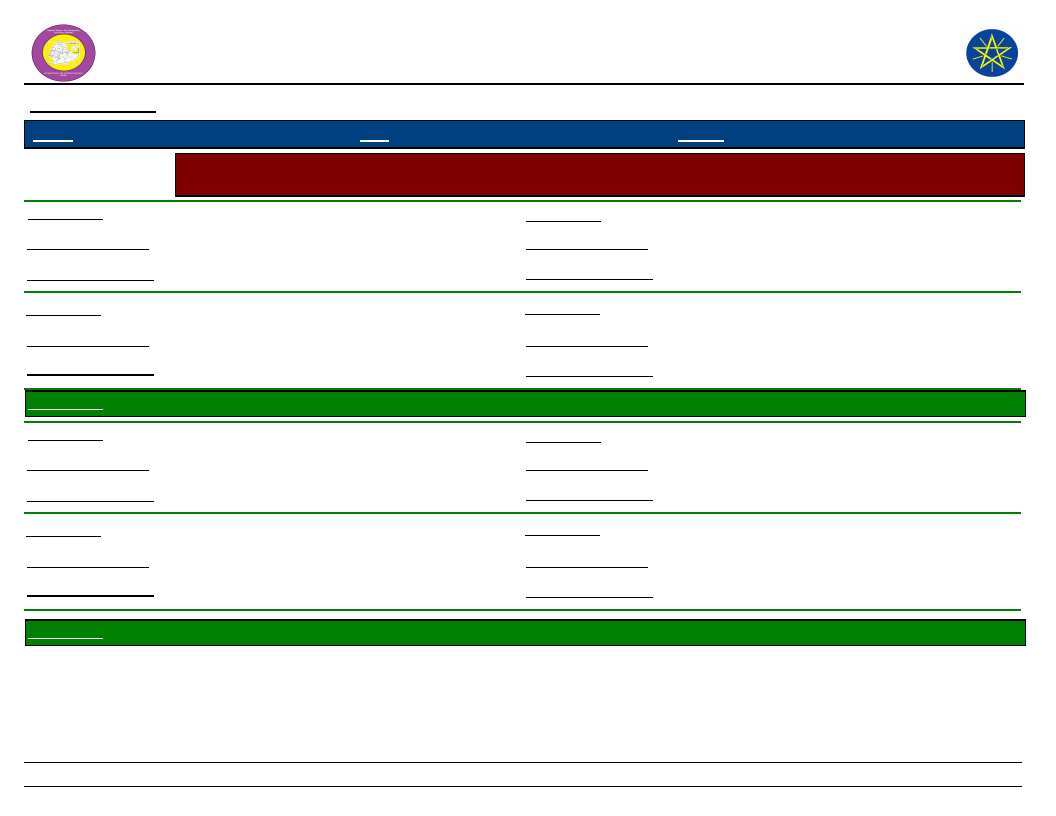
Wereda Disaster
Risk Profile
National Disaster Risk Management
Commission (NDRMC)
Data_Collected_Date
Region S.N.N.P
Zone GURAGE
Wereda MESKAN
Wednesday, July 10, 2019
Selected Indicator
Resources_1
Observed_Change_1
Problems_Changes_1
Environmental Situation: Natural Resources Availability - Natural resources available and changes observed by
the community
Land
Resources_3
Forest
Eroded
Observed_Change_3
Decreased
Erosion and decrease soil fertility
Problems_Changes_3
Cutting, firing the forest
Resources_2
Observed_Change_2
Problems_Changes_2
Water
Decreased
Shortage of water
Resources_4
Observed_Change_4
Problems_Changes_4
KebeleName
YETABON
Resources_1
Land
Observed_Change_1
Decreased
Problems_Changes_1
Shortage of food, migration
Resources_3
Observed_Change_3
Problems_Changes_3
Resources_2
River and stream
Observed_Change_2
Decreased
Problems_Changes_2
Shortage water for human, animal and
irrigation water
KebeleName
YIMERWACHO 2NYA
Resources_4
Observed_Change_4
Problems_Changes_4
130
Page 14 of 15
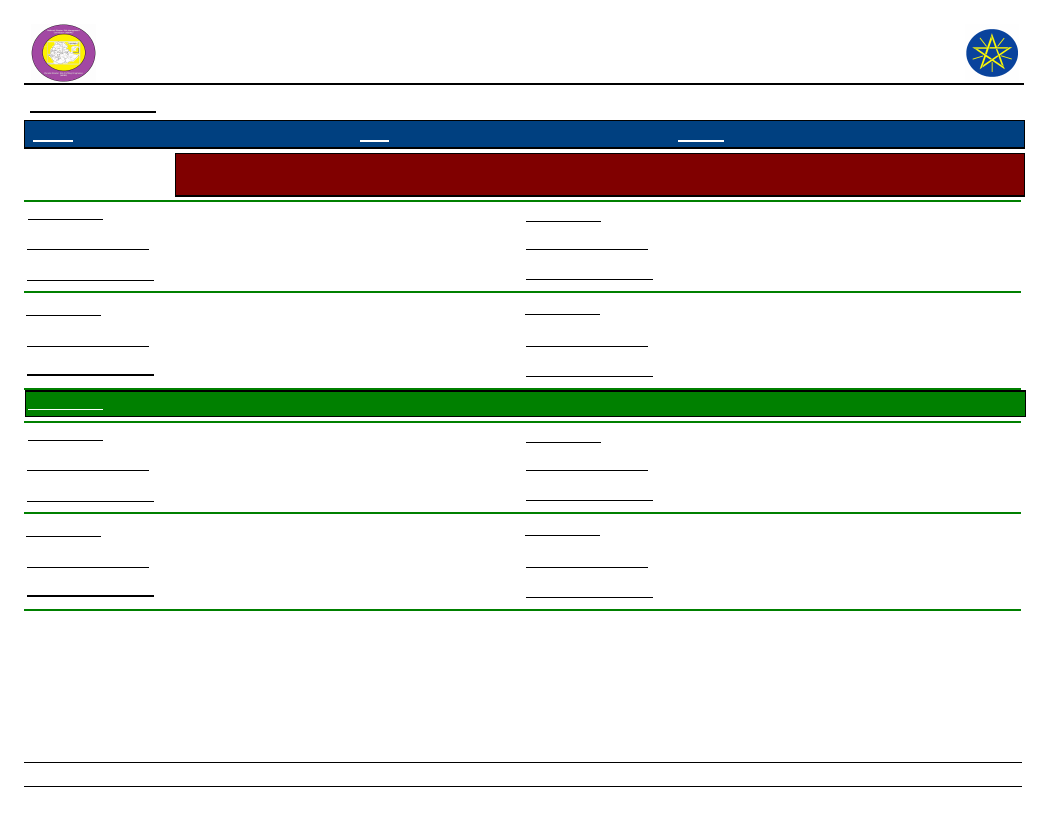
Wereda Disaster
Risk Profile
National Disaster Risk Management
Commission (NDRMC)
Data_Collected_Date
Region S.N.N.P
Zone GURAGE
Wereda MESKAN
Wednesday, July 10, 2019
Selected Indicator
Resources_1
Observed_Change_1
Problems_Changes_1
Environmental Situation: Natural Resources Availability - Natural resources available and changes observed by
the community
Land
Resources_3
Wood
Decreasing
Observed_Change_3
Increasing
Migration, land scarcity
Problems_Changes_3
Decrease land fertility
Resources_2
Observed_Change_2
Problems_Changes_2
Water
Decreasing
Water born disease
Resources_4
Observed_Change_4
Problems_Changes_4
KebeleName
YIMERWACHO 3NYA
Resources_1
Land
Observed_Change_1
No change
Problems_Changes_1
Resources_3
Observed_Change_3
Problems_Changes_3
Resources_2
Observed_Change_2
Problems_Changes_2
Water
Increased
Resources_4
Observed_Change_4
Problems_Changes_4
131
Page 15 of 15
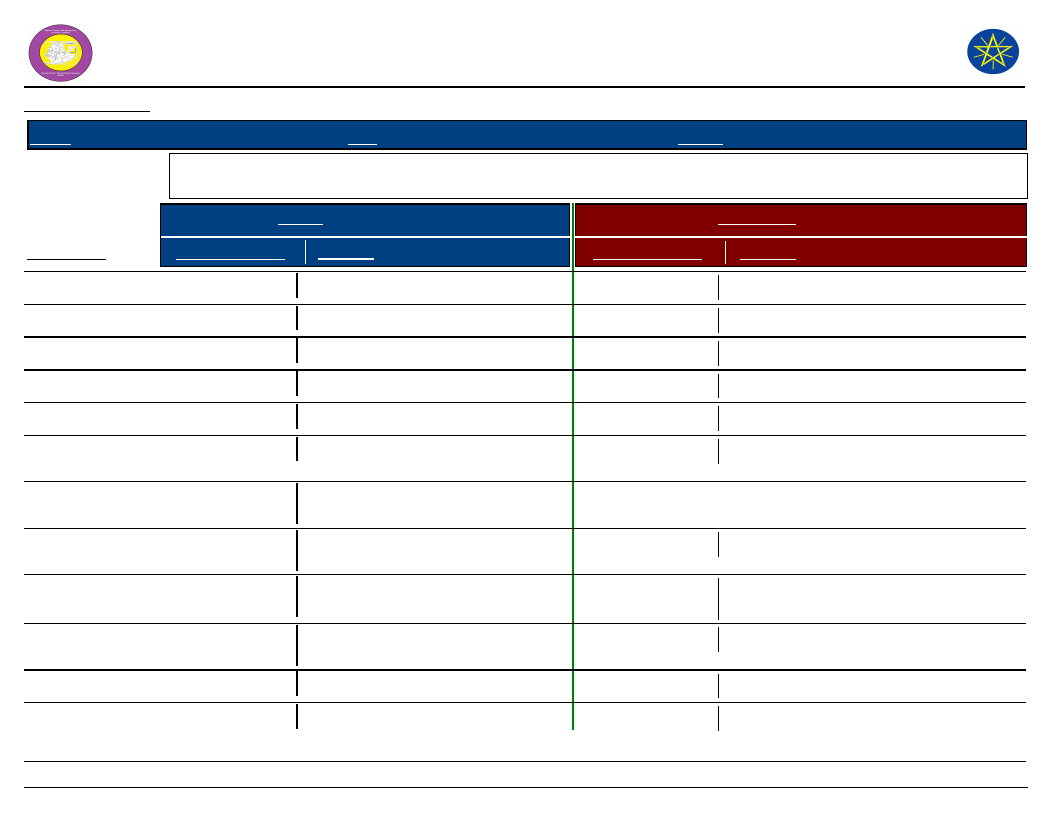
Wereda Disaster
Risk Profile
National Disaster Risk Management
Commission (NDRMC)
Data_Collected_Date
Region S.N.N.P
Selected Indicator
Zone GURAGE
Wereda MESKAN
Environmental Situation: Rainfall & Temperature - Observed changes on rainfall and temperature by the
community over the last decade
Rainfall
Temperature
Wednesday, July 10, 2019
Kebele Name
Changes Observed Problems
Changes Observed
Problems
BATI FATO
BATI LEJANO
BECHE BULCHANO
BERESA
DEBO TUTO
DEBUB
SHERSHERA
DEGAGOGOT
Decreased
Decreased
Decreased
Decreasing
Increased
Decreased
Decreased
DIDA
Decreased
DIRAMA
Decreased
DOBENA
Decreased
GIDENA ABORAT
GOYBAN
Decreased
Decreased
Shortage of yield, shortage of food
Drought, shortage of food
Decreased production/yield
Drought
Flood
Hunger, less productivity
Shortage of water, crop damage,
temperature increased
Decreased productivity, shortage of
food, shortage of water
Shortage of water, decreased
productivity
Less production, shortage of food,
feed and water
Less productivity
Crop damage, shortage of water
Increased
Increased
Increased
Increased
Increased
Increased
No change
Increased
Increased
Increased
Increased
Increased
Human disease
Climate change
Climate change
No effect
High temperature
Disease, shortage of water
Human and livestock disease
Shortage of water, human and livestock
disease
Human and livestock disease
River drying, under ground water
Socio economic disturbance
132
Page 1 of 3
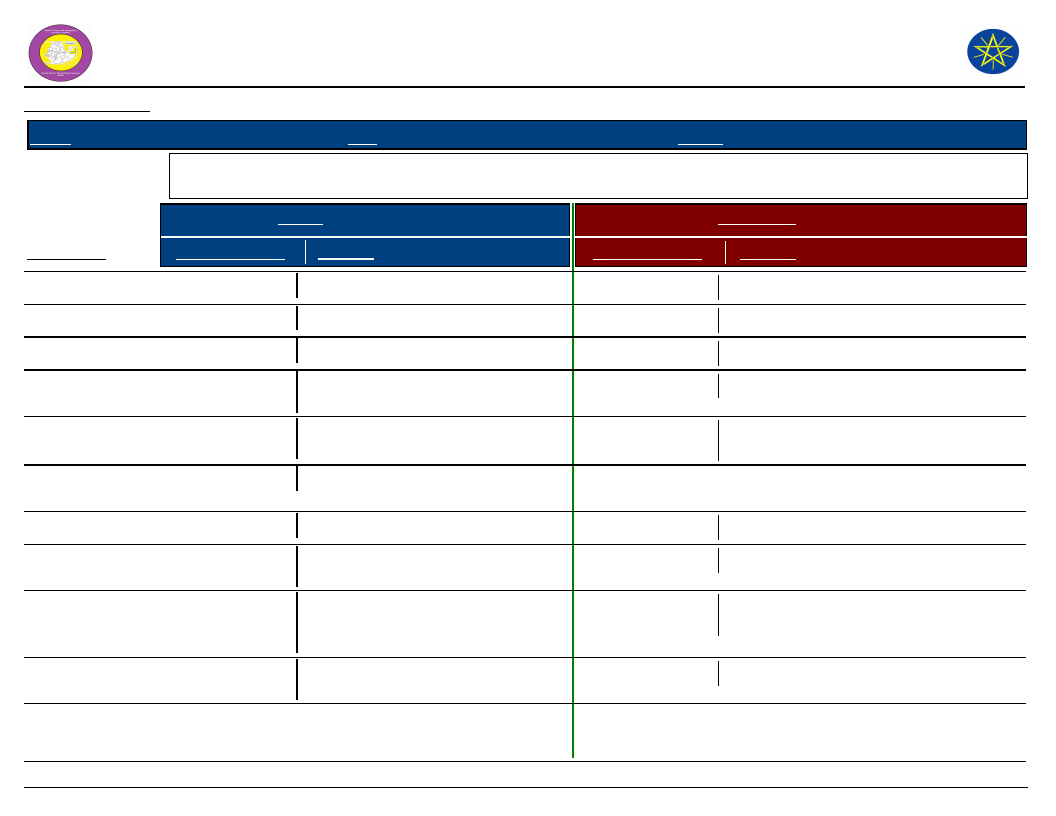
Wereda Disaster
Risk Profile
National Disaster Risk Management
Commission (NDRMC)
Data_Collected_Date
Region S.N.N.P
Selected Indicator
Zone GURAGE
Wereda MESKAN
Environmental Situation: Rainfall & Temperature - Observed changes on rainfall and temperature by the
community over the last decade
Rainfall
Temperature
Wednesday, July 10, 2019
Kebele Name
Changes Observed Problems
Changes Observed
Problems
ILE
INSENO USME
JOLE ANDENYA
JOLE HULETENYA
Decreased
Decreased
Decreased
Decreased
MEKICHO
Decreased
MESERETEWEGER
AMO
MIKAELO
MIRAB IMBOR
Increased
Increased
Decreased
MIRAB MESKAN
Decreased
OCHAGENEME
Decreased
Affect agricultural activity, food gap
Drought
Affect farm activities
Less productivity, shortage of water
and feed, shortage of food
Less productivity, shortage of water,
shortage of food and feed
Flood, soil erosion
Flood
Shortage of food, water concern
human and livestock disease
Less productivity, shortage of food,
feed and water, migration, social
and economic crises
Affect agricultural activity, shortage
of food
Increased
Increased
Increased
Increased
Increased
Moderate
Moderate
Increased
Increased
Increased
Climate change
Climate change
Climate change
Human, livestock disease and crop disease
Water shortage, concern human and
animal disease
No effect
Water shortage, human disease
Human and livestock disease, shortage of
water, dry plants
Climate change
133
Page 2 of 3
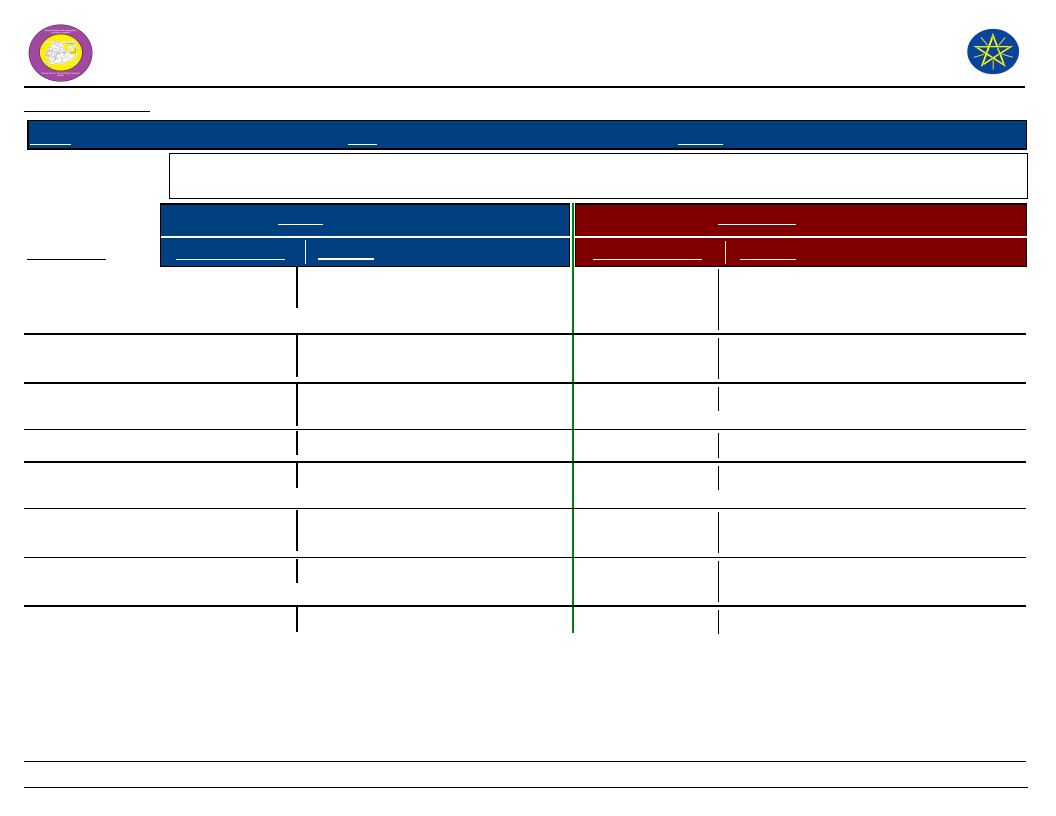
Wereda Disaster
Risk Profile
National Disaster Risk Management
Commission (NDRMC)
Data_Collected_Date
Region S.N.N.P
Selected Indicator
Zone GURAGE
Wereda MESKAN
Environmental Situation: Rainfall & Temperature - Observed changes on rainfall and temperature by the
community over the last decade
Rainfall
Temperature
Wednesday, July 10, 2019
Kebele Name
SEMEN
SHORSHORA
SHERSHERA
MACHMENA
WEJABATI
WITA
WOLENSHO
ANDENYA
YETABON
YIMERWACHO
2NYA
YIMERWACHO
3NYA
Changes Observed Problems
Decreased
Yield loss, crop damage, shortage of
water
Decreased
Decreased
Decreased
Increased
Decreased
Decreased
Less production of crop, water
shortage
Affect agricultural activities, food
gap
Affect agricultural activity
Flood
Less production, less water and
yield, shortage of food
Decreasing productivity
Decreased
Loss of productivity, shortage of food
Changes Observed
Problems
Increased
Crop damage, drinking water need
increasing. children exposed to different
problems
Increased
Decreased production, decrease water
source
Increased
Climate change
Increased
Moderate
Climate change
No effect
Increased
Increased
Increased
Human, animal and crop disease, shortage
of water
Decreasing productivity, absence of
ground water
Climate change
134
Page 3 of 3
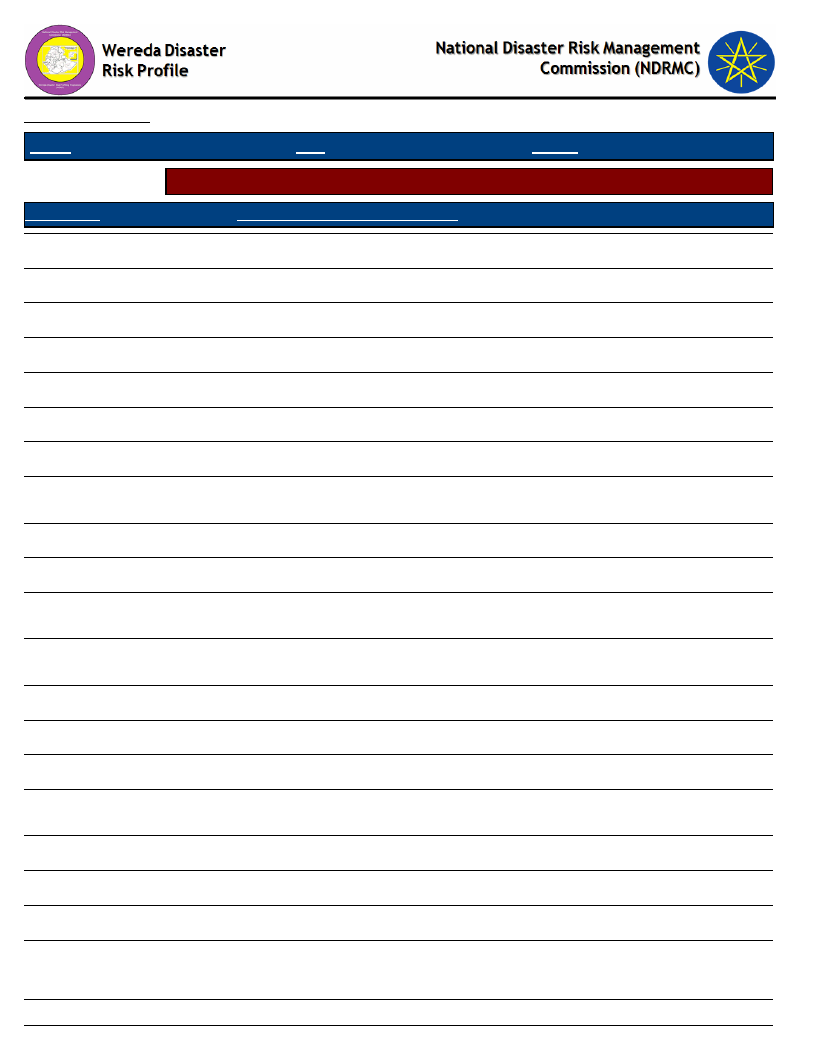
Data_Collected_Date
Region S.N.N.P
Zone GURAGE
Wednesday, July 10, 2019
Wereda MESKAN
Selected Indicator
KebeleName
Environmental Situation: Reasons for Environmental Changes
Reason_For_Environmental_Changes
BATI FATO
Deforestation, climate change
BATI LEJANO
Deforestation
BECHE BULCHANO
Deforestation, less forestation
BERESA
Deforestation, less tree plantation
DEBO TUTO
Deforestation
DEBUB SHERSHERA
Climate change, population density, deforestation
DEGAGOGOT
DIDA
DIRAMA
Climate change, ecologically condition of the area, problem of the
preparedness of the community
Lack of awareness, topography, deforestation
DOBENA
Climate change, deforestation, topography of the area
GIDENA ABORAT
GOYBAN
ILE
Population pressure, over grazing, deforestation, climate change, land
use problem
Deforestation, unsustainable soil and water conservation, poor ploughing
system
Deforestation, improper farm practice
INSENO USME
Deforestation, less tree plantation/forestation
JOLE ANDENYA
Deforestation, poor farming practice
JOLE HULETENYA
MEKICHO
Climate change, deforestation, population growth, livestock feeding
system/over grazing, poor farming system
Climate change, deforestation, topography of the area
MESERETEWEGERAMO
Deforestation, less tree plantation
MIKAELO
MIRAB IMBOR
Climate change
135
Page 1 of 2
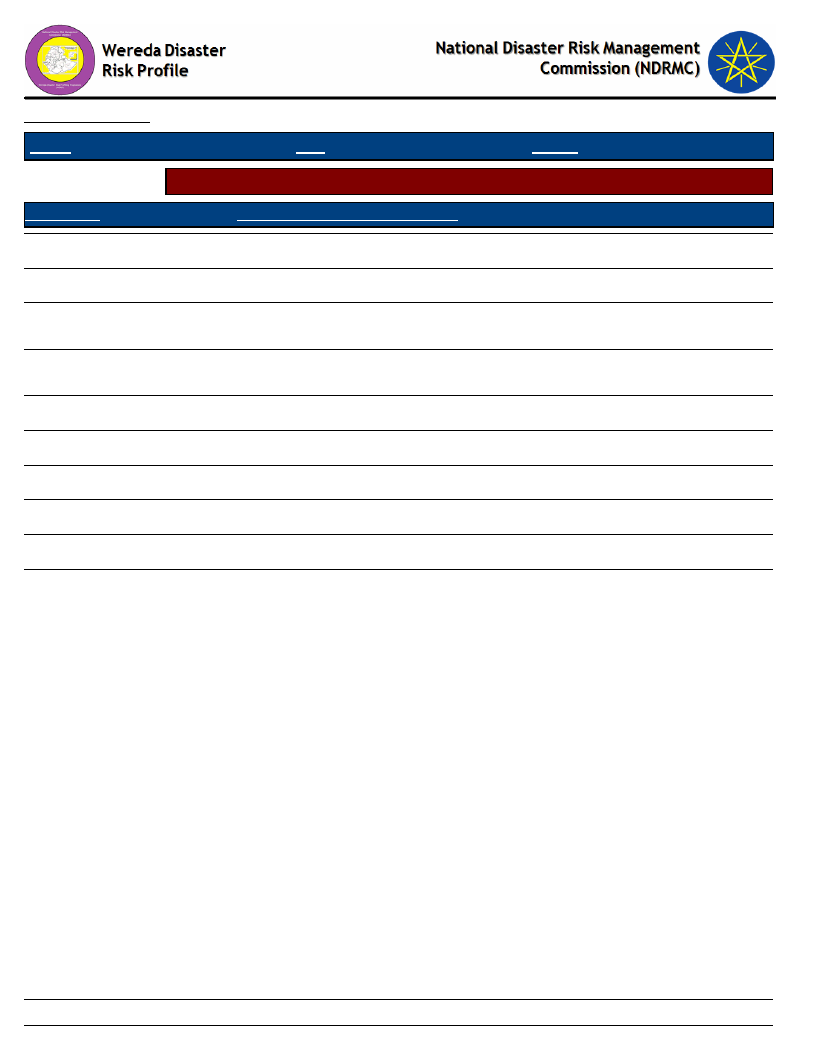
Data_Collected_Date
Region S.N.N.P
Zone GURAGE
Wednesday, July 10, 2019
Wereda MESKAN
Selected Indicator
KebeleName
Environmental Situation: Reasons for Environmental Changes
Reason_For_Environmental_Changes
MIRAB MESKAN
Deforestation, climate change, population pressure, over grazing
OCHAGENEME
Shortage of tree plantation, over grazing, improper farm practice
SEMEN SHORSHORA
SHERSHERA MACHMENA
WEJABATI
Climate change, topography of the area, type of soil ex, sandy soil, over
grazing
Climate change, deforestation, the shortage of forestation, population
pressure, topography of the area and soil type
Deforestation, over grazing, improper farm practice
WITA
Deforestation, over grazing, in proper farm practice
WOLENSHO ANDENYA
Deforestation and no forestation
YETABON
Climate change, deforestation, population growth, over grazing
YIMERWACHO 2NYA
The problem of forestation, deforestation, flooding
YIMERWACHO 3NYA
Deforestation, less three population forestation
136
Page 2 of 2
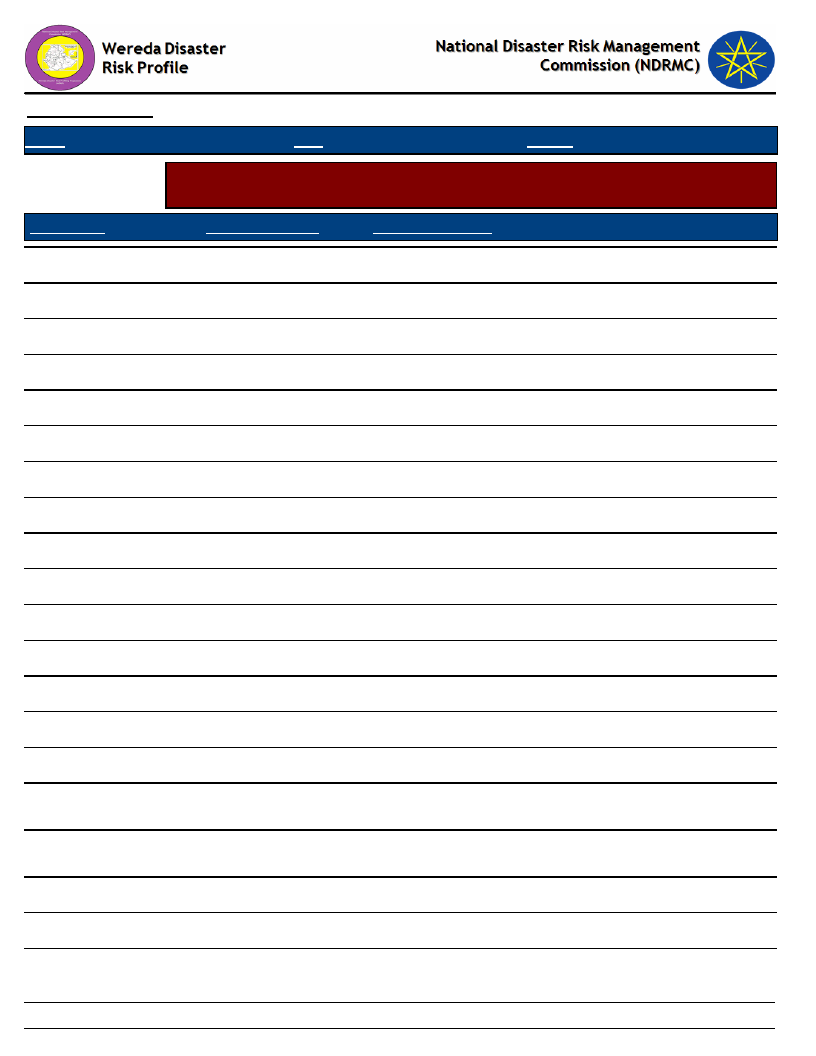
Data_Collected_Date
Region S.N.N.P
Zone GURAGE
Wednesday, July 10, 2019
Wereda MESKAN
Selected Indicator
KebeleName
BATI FATO
Environmental Situation: Soil Erosion - Observed changes on levels of soil
erosion by the community
Changes_Observed
Problems_Observed
Increased
Low soil fertility, decreased fertility
BATI LEJANO
Decreased
BECHE BULCHANO
Decreased
BERESA
Increased
Decrease soil fertility, degraded land
DEBO TUTO
Increased
Decrease soil fertility, degradation
DEBUB SHERSHERA
Increased
Less soil fertility, less yield
DEGAGOGOT
Increased
Loss of yield, exposed to run off, loss of soil fertility
DIDA
Decreased
DIRAMA
Increased
Decreased soil fertility, decreased yield
DOBENA
Increased
Loss of fertility, less yield, flood, shortage of food
GIDENA ABORAT
Increased
Decreased soil fertility
GOYBAN
Increased
Crop damage, decrease soil fertility
ILE
Increasing
Decrease soil fertility, less productivity
INSENO USME
Decreased
JOLE ANDENYA
Decreased
JOLE HULETENYA
MEKICHO
MESERETEWEGERAMO
Increased
Increased
Decreased
Low soil fertility, decreased yield, flood and shortage
of food
Low soil fertility, low yield, shortage of food, concern
flood hazard
MIKAELO
Increased
Affect farm productivity
MIRAB IMBOR
Increased
Decreased yield, shortage of food
137
Page 1 of 2
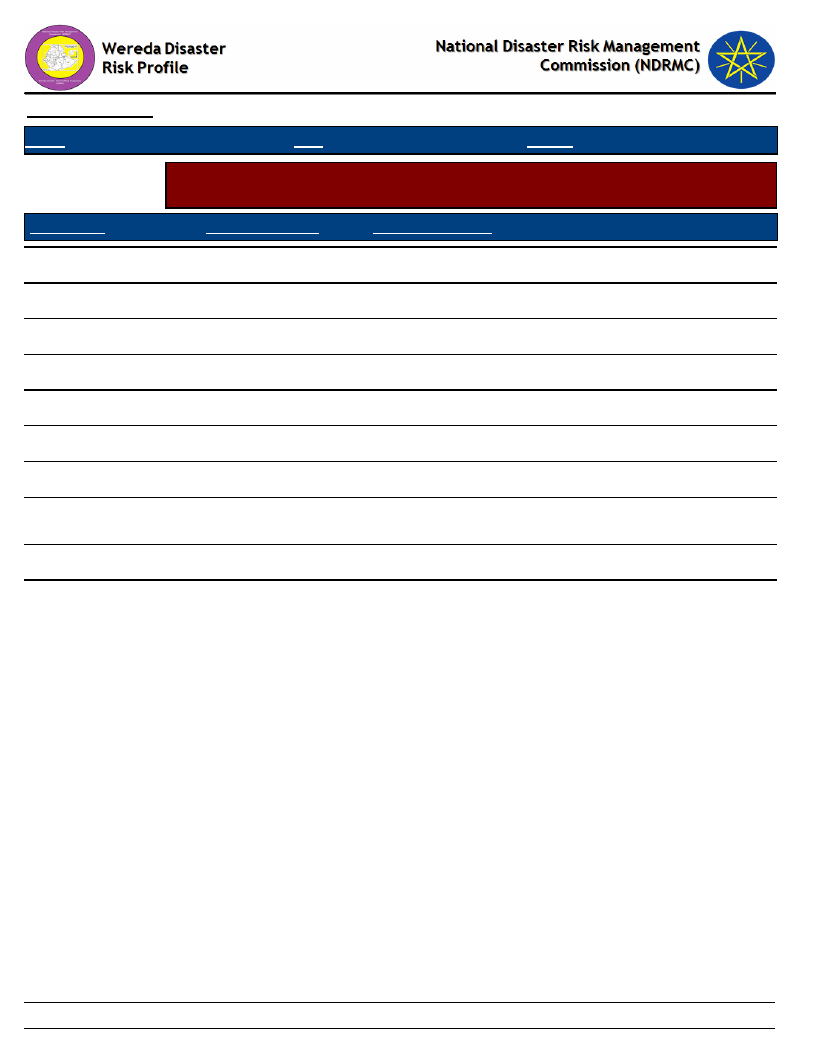
Data_Collected_Date
Region S.N.N.P
Zone GURAGE
Wednesday, July 10, 2019
Wereda MESKAN
Selected Indicator
KebeleName
MIRAB MESKAN
Environmental Situation: Soil Erosion - Observed changes on levels of soil
erosion by the community
Changes_Observed
Problems_Observed
Increased
Low soil fertility, decrease yield, flood, food shortage
OCHAGENEME
Decreased
SEMEN SHORSHORA
Increased
Decreased soil fertility, low yield, shortage of food
SHERSHERA MACHMENA
Very high
Flood, decreased soil fertility, decreased productivity
WEJABATI
Increased
Less productivity, less soil fertility
WITA
Decreased
Little affect farm production
WOLENSHO ANDENYA
Increased
Degradation, les farm productivity
YETABON
YIMERWACHO 2NYA
Increased
Increased
Flood, loss of soil fertility, loss of yield, shortage of
food
Decreasing soil fertility
YIMERWACHO 3NYA
Decreased
138
Page 2 of 2
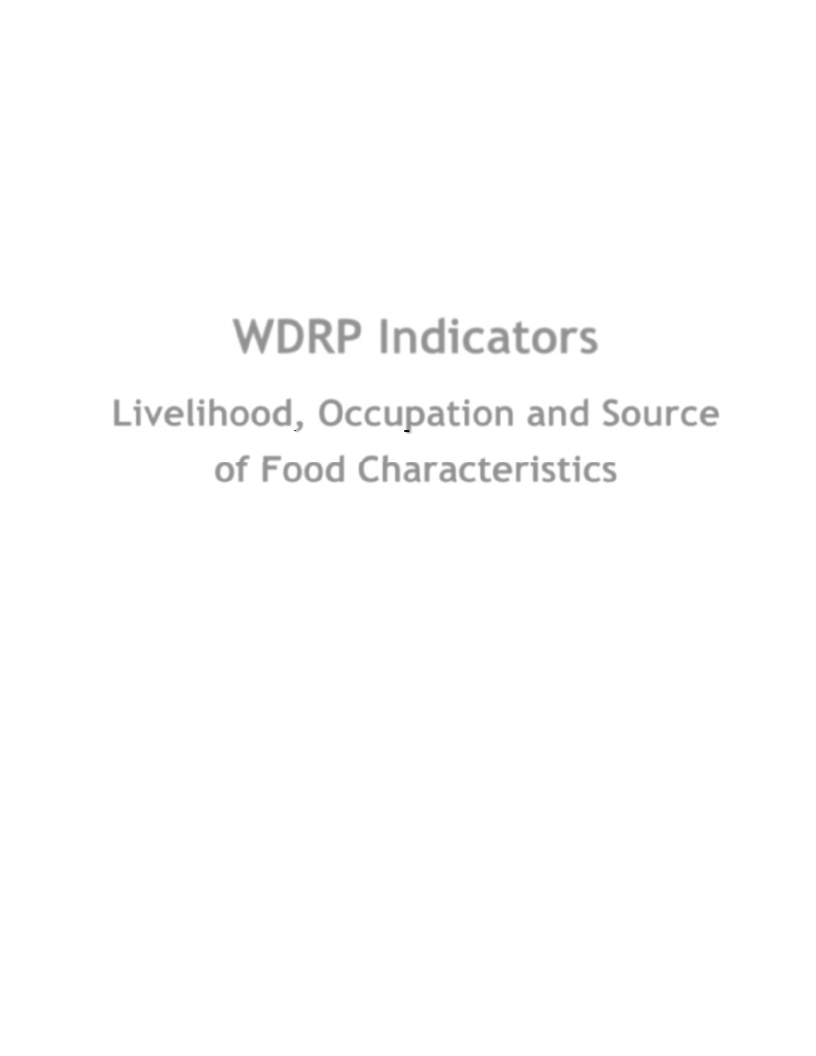
WDRP Indicators
Livelihood, Occupation and Source
of Food Characteristics
139
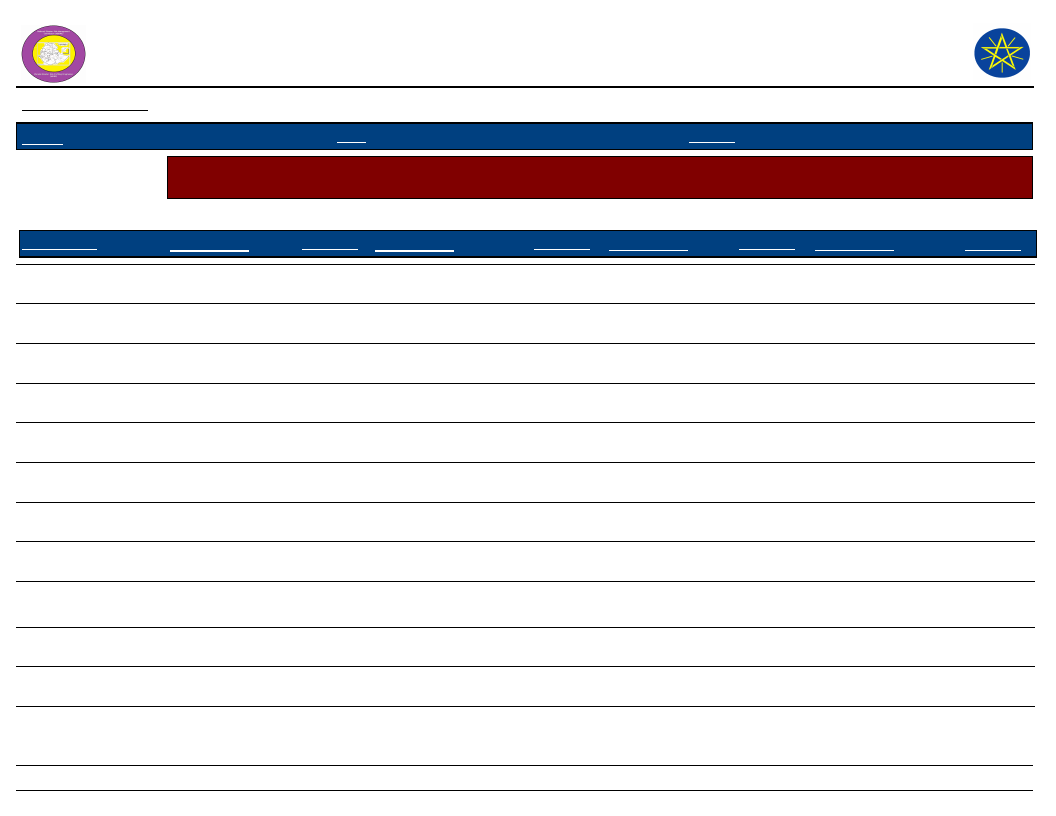
Wereda Disaster
Risk Profile
Data_Collected_Date
National Disaster Risk Management
Commission (NDRMC)
Wednesday, July 10, 2019
Region S.N.N.P
Zone
GURAGE
Wereda MESKAN
Selected Indicator
Economic Vulnerability: Major Occupational Categories - Major categories of occupation and percent of population
engaged in the occupation by Kebele
Occupational Categories and Percent of Population engaged within these occupational categories
Percent (%) of Population
KebeleName
Occupation 1
Population Occupation 2
Population Occupation 3
Population Occupation 4
Population
BATI FATO
Crop production -
85
Livestock production -
10
Wood planting -
3
Chat -
2
BATI LEJANO
Crop production -
95
Fattening -
2
Poultry -
3
-
BECHE BULCHANO
Crop production -
50
Livestock production -
20
Daily labour -
30
-
BERESA
Crop production -
80
Bee keeping -
10
Daily labour -
10
-
DEBO TUTO
Crop production -
50
Fattening -
10
Livestock bread -
20
Poultry -
15
DEBUB SHERSHERA
Chat production -
40
Wood planting -
20
Crop production -
17
Livestock production -
15
DEGAGOGOT
Enset production -
50
Daily labour -
20
Small trading -
10
Livestock production -
10
DIDA
Crop production -
60
Livestock production -
20
Wood planting -
15
Chat -
5
DIRAMA
DOBENA
Crop production -
Crop production -
50
Charcoal and wood -
50
Livestock production -
30
Petty trade -
20
Chat -
12
Livestock production
8
-
15
Wood -
10
GIDENA ABORAT
Crop production -
75
Wood planting -
15
Livestock production -
10
-
GOYBAN
Crop production -
80
Livestock production -
15
Petty trade -
5
-
140
Page 1 of 3
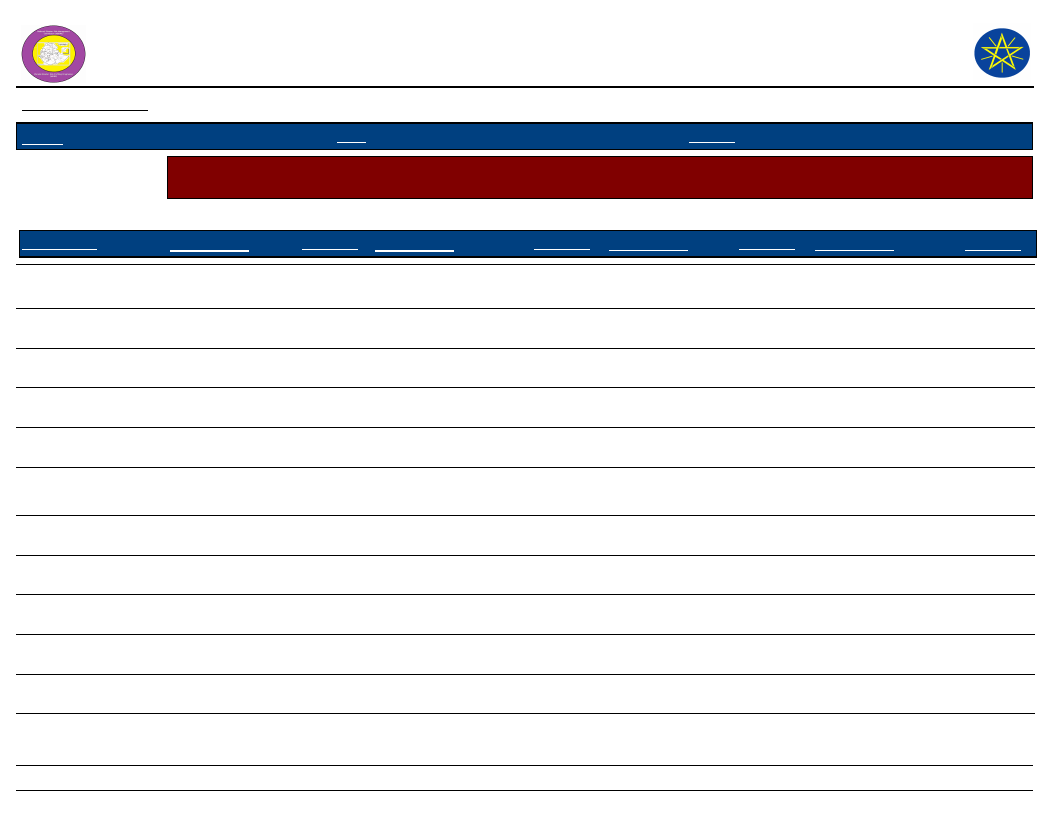
Wereda Disaster
Risk Profile
Data_Collected_Date
National Disaster Risk Management
Commission (NDRMC)
Wednesday, July 10, 2019
Region S.N.N.P
Zone
GURAGE
Wereda MESKAN
Selected Indicator
Economic Vulnerability: Major Occupational Categories - Major categories of occupation and percent of population
engaged in the occupation by Kebele
Occupational Categories and Percent of Population engaged within these occupational categories
Percent (%) of Population
KebeleName
Occupation 1
Population Occupation 2
Population Occupation 3
Population Occupation 4
Population
ILE
INSENO USME
Crop production -
Crop production -
85
Livestock production,
fattening -
98
Livestock production -
10
Poultry -
2
-
5
-
-
JOLE ANDENYA
Farming -
80
Fattening -
15
Poultry -
5
-
JOLE HULETENYA
Crop production -
50
Livestock production -
30
Irrigation -
10
Chat -
6
MEKICHO
Crop production -
50
Livestock production -
30
Wood -
20
-
MESERETEWEGERA
MO
MIKAELO
Crop production -
Crop production -
80
Livestock production -
80
Fattening -
20
-
15
Poultry -
-
5
-
MIRAB IMBOR
Crop production -
50
Chat planting -
25
Wood -
20
Livestock production -
5
MIRAB MESKAN
Crop production -
50
Chat -
30
Wood -
12
Livestock production -
8
OCHAGENEME
Crop production -
90
Poultry -
5
Livestock production -
5
-
SEMEN SHORSHORA
Crop production -
30
Chat -
25
Wood -
20
Livestock production -
15
SHERSHERA
MACHMENA
Crop production -
70
Livestock production -
20
141
Wood -
10
-
Page 2 of 3
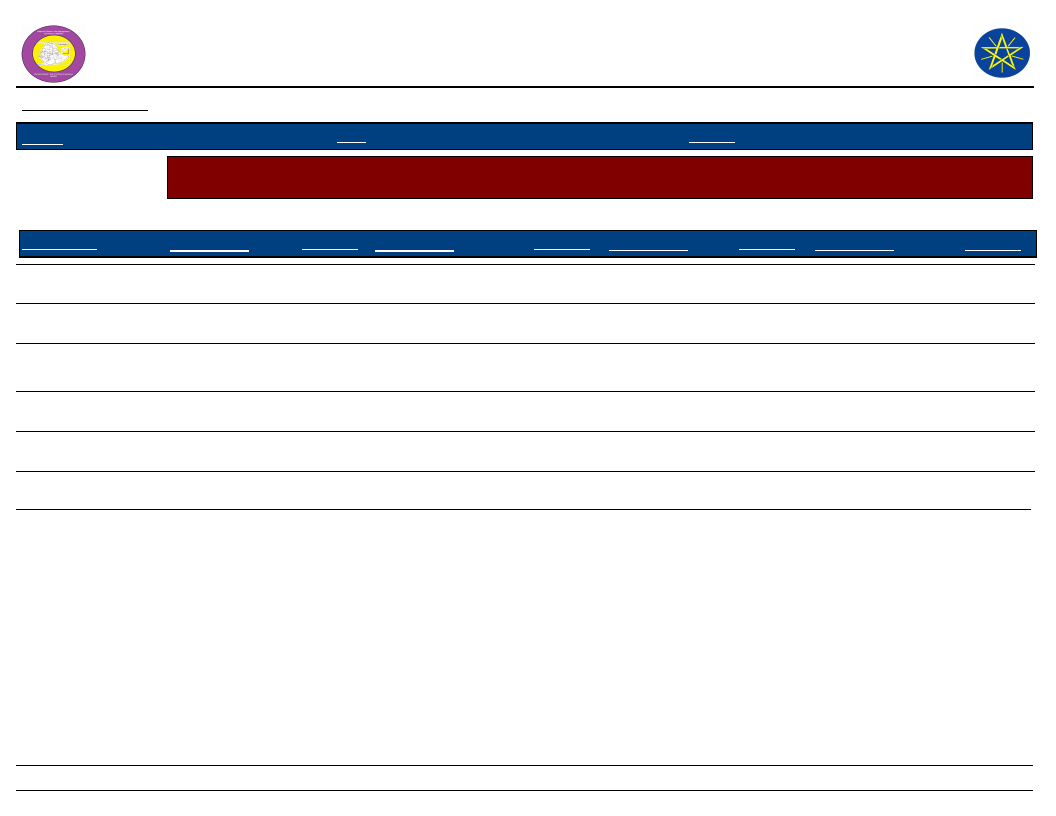
Wereda Disaster
Risk Profile
Data_Collected_Date
National Disaster Risk Management
Commission (NDRMC)
Wednesday, July 10, 2019
Region S.N.N.P
Zone
GURAGE
Wereda MESKAN
Selected Indicator
Economic Vulnerability: Major Occupational Categories - Major categories of occupation and percent of population
engaged in the occupation by Kebele
Occupational Categories and Percent of Population engaged within these occupational categories
Percent (%) of Population
KebeleName
Occupation 1
Population Occupation 2
Population Occupation 3
Population Occupation 4
Population
WEJABATI
Crop production -
94
Livestock production -
4
Poultry farm -
2
-
WITA
Crop production -
80
Livestock production -
15
Fattening -
5
-
WOLENSHO
ANDENYA
YETABON
Crop production -
Chat production -
75
Fattening -
45
Crop production -
10
Livestock production -
10
Bee keeping -
2
35
Livestock production -
10
Wood -
10
YIMERWACHO 2NYA
Crop production -
75
Livestock production -
25
-
-
YIMERWACHO 3NYA
Crop production -
80
Irrigation -
17
Livestock production -
3
-
142
Page 3 of 3
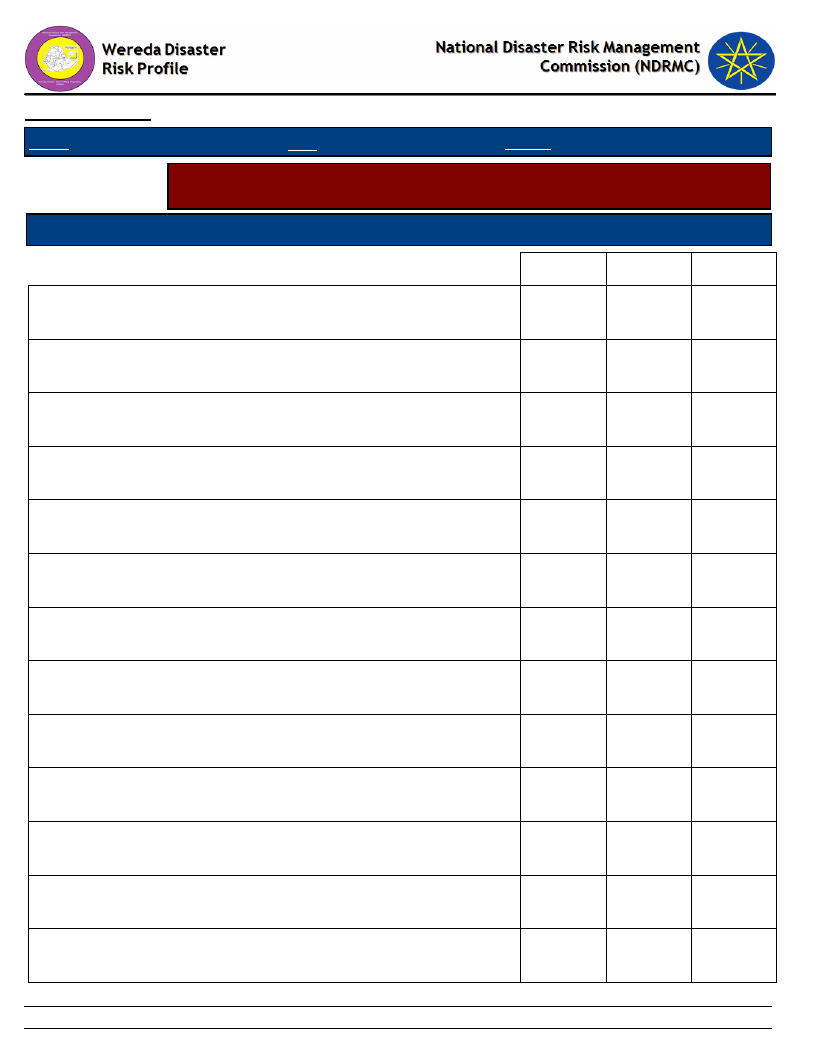
Data_Collected_Date
Region S.N.N.P
Zone GURAGE
Wednesday, July 10, 2019
Wereda MESKAN
Selected Indicator
Economic Vulnerability: Livelihoods - Households important sources of
livelihood (response in %)
Type of Livelihood Activity
Order of Importnce
Agricultural laborer
1st
2nd
3rd
0.82
1.35
6.38
Basket-making, Mat-making
0.54
0.00
2.13
Begging activities
1.63
0.00
0.00
Buying and selling livestock (cattle, sheep, goats, camels)
2.72
5.86
6.38
Carpenter, Furniture-maker, or Metal-worker
0.00
2.70
4.26
Daily laborer
11.72
23.87
12.77
Making traditional utensils or farm tools
0.00
0.45
0.00
Others
2.18
2.70
4.26
Rearing & selling animals (camels, cattle, sheep, goats)
5.18
7.66
8.51
Religious teacher
0.27
0.00
0.00
Salaried job
1.09
3.15
6.38
Sale_Of_Natural_Products - Construction materials (sand, grass,
wooden poles, etc.)
Sale_Of_Natural_Products - Firewood
0.27
0.00
0.00
0.54
0.45
2.13
143
Page 1 of 3
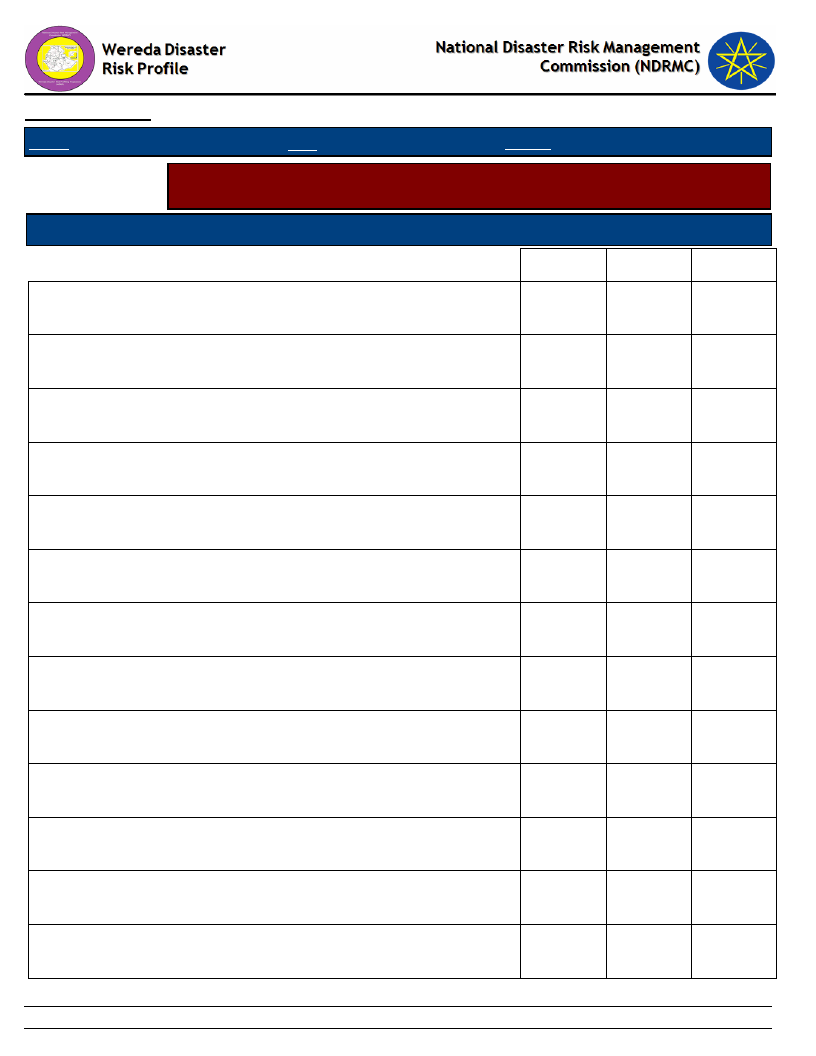
Data_Collected_Date
Region S.N.N.P
Zone GURAGE
Wednesday, July 10, 2019
Wereda MESKAN
Selected Indicator
Economic Vulnerability: Livelihoods - Households important sources of
livelihood (response in %)
Type of Livelihood Activity
Order of Importnce
1st
2nd
3rd
Sale_Of_Natural_Products - Water
0.00
0.00
2.13
Sale_Of_Natural_Products - Wild fruits
0.00
0.45
0.00
Selling Cereal food crops (sorghum, maize, wheat, barley)
58.31
28.38
14.89
Selling Chat / Khat
10.08
12.61
6.38
Selling Clothes and shoes
0.27
0.00
0.00
Selling dairy products (milk, butter, ghee, cheese)
0.00
0.90
2.13
Selling eggs (from own chickens) Beekeeping (selling honey
bees-wax, or bee-hives)
Selling Fruits (mango, papaya, banana, orange, lemon, etc.)
0.54
2.25
4.26
0.54
0.00
2.13
Selling meat (from own livestock)
0.27
0.45
0.00
Selling Other foods (sugar, flour, coffee, etc.)
0.54
0.90
0.00
Selling Pulses (beans, cow-pea, chick-pea)
0.27
0.00
0.00
Selling Root crops (Irish potato, sweet potato)
0.00
0.45
0.00
Selling tea, coffee, cake, bread, “areki”, “tella”
1.91
2.70
14.89
144
Page 2 of 3
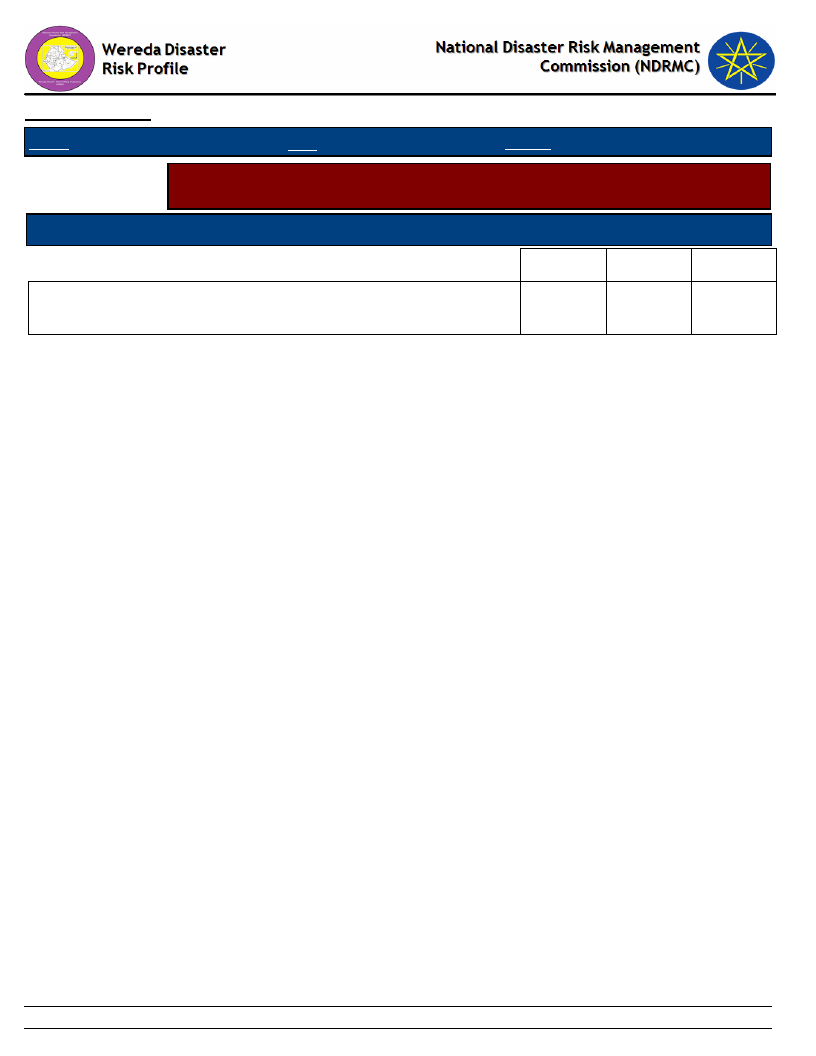
Data_Collected_Date
Region S.N.N.P
Zone GURAGE
Wednesday, July 10, 2019
Wereda MESKAN
Selected Indicator
Economic Vulnerability: Livelihoods - Households important sources of
livelihood (response in %)
Type of Livelihood Activity
Order of Importnce
1st
2nd
3rd
Selling Vegetables (onion, tomato, cabbage, pumpkin, etc.)
0.27
2.70
0.00
145
Page 3 of 3
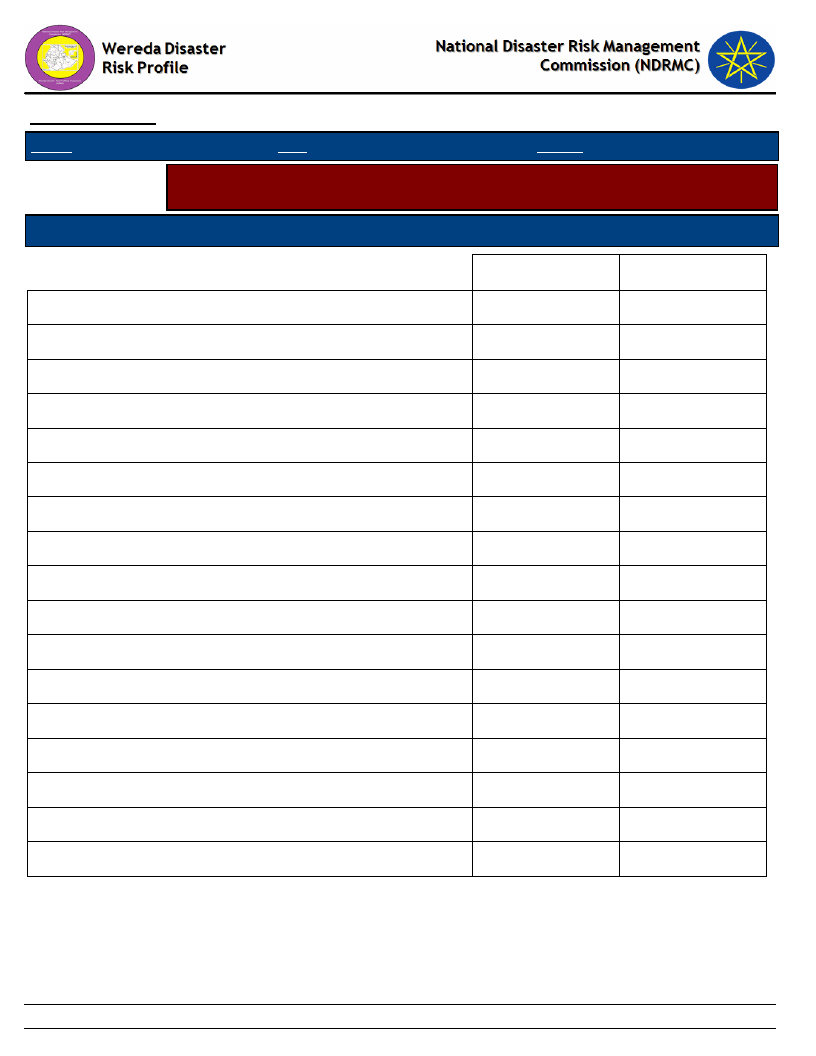
Data_Collected_Date
Region S.N.N.P
Zone GURAGE
Wednesday, July 10, 2019
Wereda MESKAN
Selected Indicator
Economic Vulnerability: Occupational Categories - Percent of population
above 15 years age by occupation categories
Type of Livelihood Activity
Main Occupation
Secondary Occupation
B)Student
C)Unemployed & seeking work
D)Neither studying nor working nor seeking work
E)Retired/ Old
F)Cultivator
G)Agricultural labourer
H)Livestock rearing
I)Non-agricultural labour
J)Craftsman
K)Shopkeeper and Petty trade
L)Home-maker (housewife)
M)Salaried
N)Chronically ill
O)Physically disabled
P)Others (specify)
Q)None
S)Herder
1st Occupation
23.03
7.32
0.49
2.06
32.48
0.90
0.49
3.04
0.99
5.92
18.50
2.06
0.25
0.90
1.32
0.25
2nd Occupation
7.45
2.88
0.13
0.39
2.09
2.35
1.96
4.31
0.92
5.88
6.01
0.65
1.31
63.66
146
Page 1 of 1
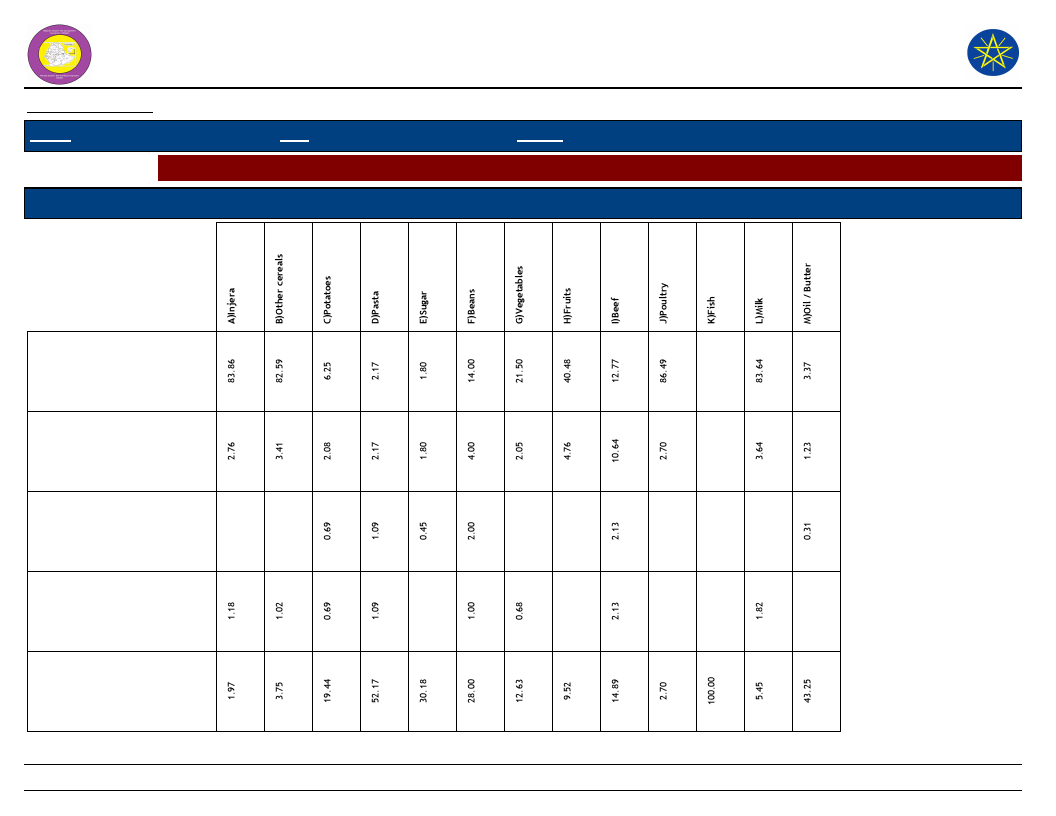
Wereda Disaster Risk
Profile
National Disaster Risk Management
Commission (NDRMC)
Data_Collected_Date
Region S.N.N.P
Zone GURAGE
Wereda MESKAN
Wednesday, July 10, 2019
Selected Indictor: Economic Vulnerability: Sources of Food - Households source for different food items (response in %)
Source of Food
Types of Food Item
A)Own
cultivation/production
B)Casual labor
C)Borrowed
D)Gifts from
friends/neighbors
E)Purchases from main
shop
147
Page 1 of 2
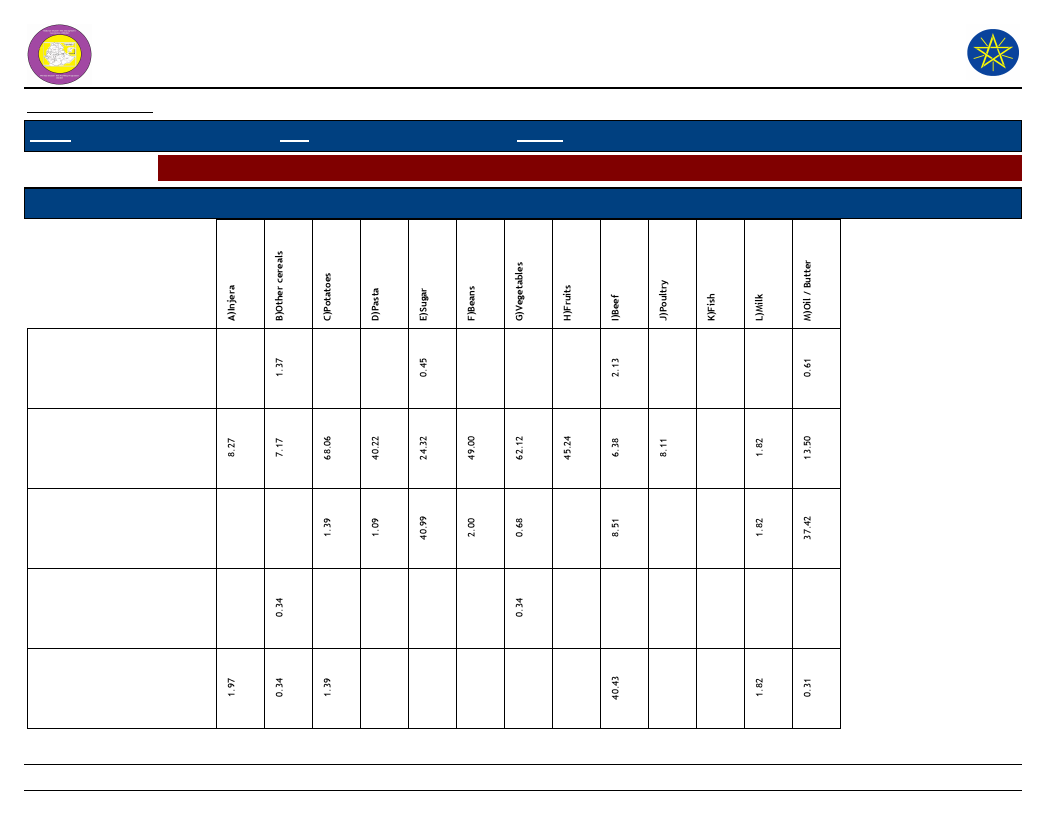
Wereda Disaster Risk
Profile
National Disaster Risk Management
Commission (NDRMC)
Data_Collected_Date
Region S.N.N.P
Zone GURAGE
Wereda MESKAN
Wednesday, July 10, 2019
Selected Indictor: Economic Vulnerability: Sources of Food - Households source for different food items (response in %)
Source of Food
Types of Food Item
F)Free meals/Food
assistance
G)Purchase from
roadside vendor/tuck
shop
H)Purchase subsidized
food from Kebele shop
J)Begging
K)Other
148
Page 2 of 2
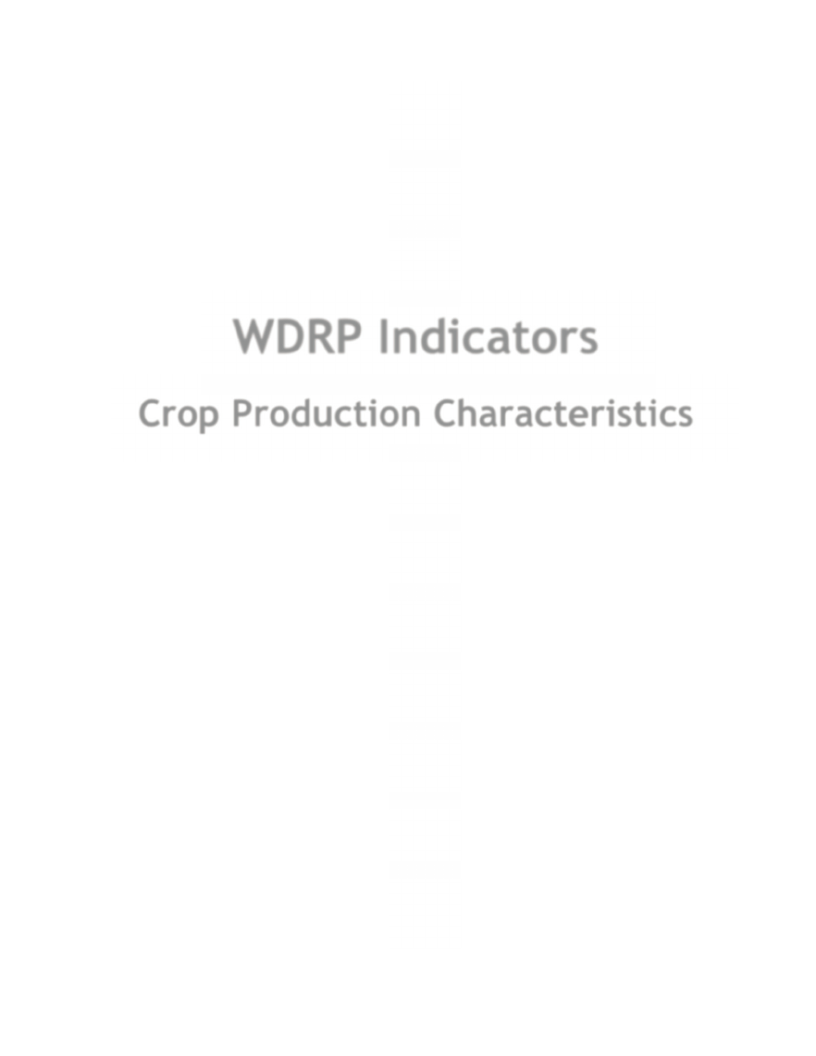
WDRP Indicators
Crop Production Characteristics
149
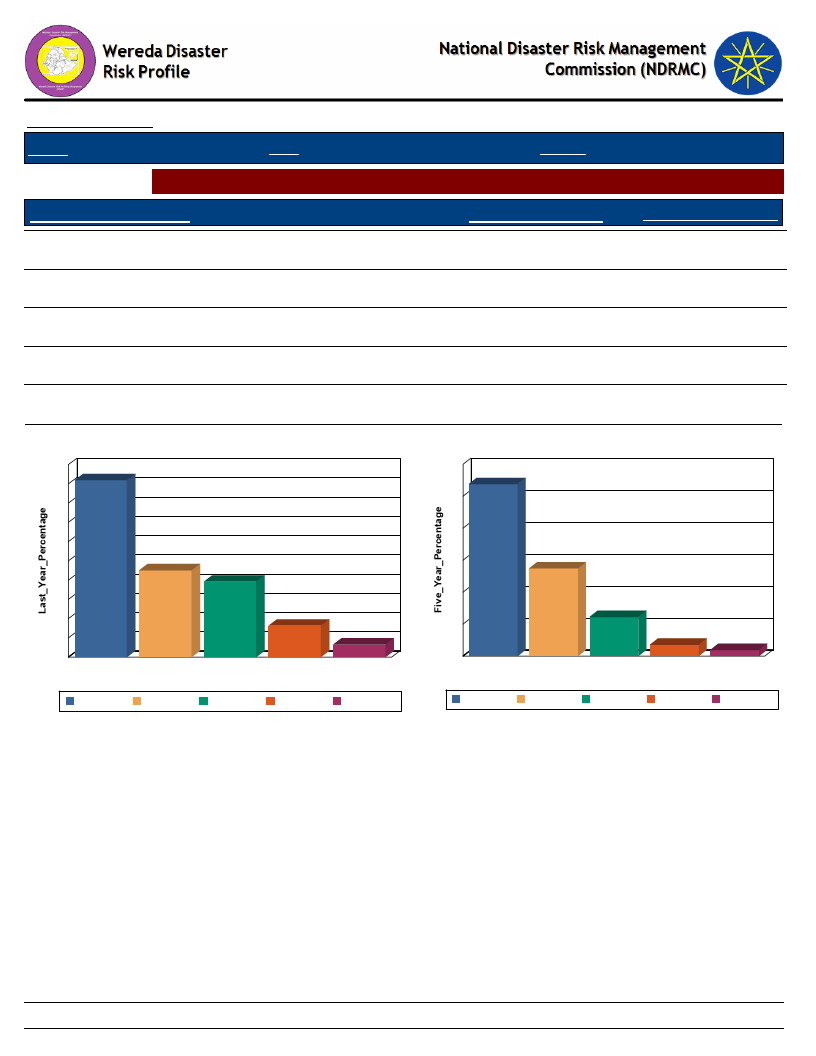
Data_Collected_Date
Region S.N.N.P
Zone GURAGE
Wednesday, July 10, 2019
Wereda MESKAN
Selected Indictor: Hazards: Change in Crop Damages - Proportion of Total Crop Damage
Extent of Crop Damage (%)
0%
Last_Year_Percentage
45.92
Five_Year_Percentage
53.80
1 - 25 %
22.55
27.45
26 - 50 %
19.57
12.23
51 - 75 %
8.15
3.53
76 - 100 %
3.26
1.90
Extent of Crop Damage Last_Year
50
46
45
40
35
30
25
23
20
20
15
10
8
5
3
0
0%
1 - 25 %
26 - 50 %
51 - 75 %
Extent of Crop Damage
76 - 100 %
0%
1 - 25 %
26 - 50 %
51 - 75 %
76 - 100 %
Extent of Crop Damage Five Years Ago
60
54
50
40
30
27
20
10
0
0%
0%
12
4
2
1 - 25 %
26 - 50 % 51 - 75 %
Extent of Crop Damage
76 - 100 %
1 - 25 %
26 - 50 %
51 - 75 %
76 - 100 %
150
Page 1 of 1
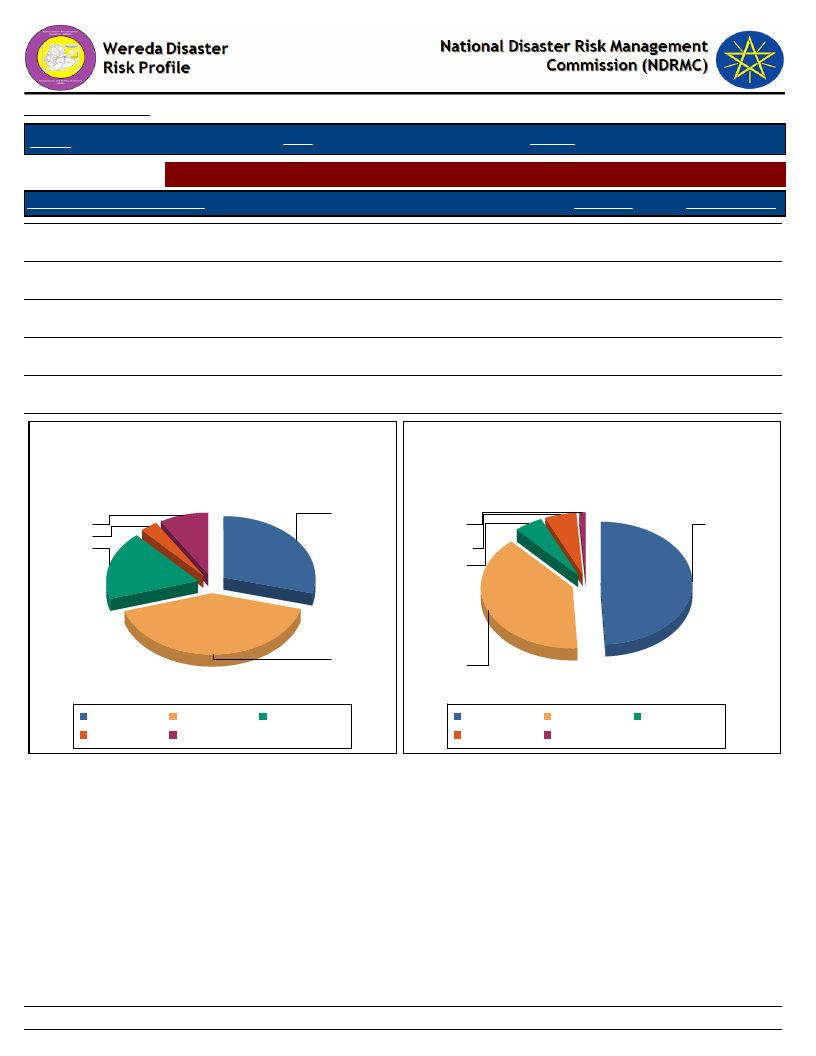
Data_Collected_Date
Wednesday, July 10, 2019
Region S.N.N.P
Zone GURAGE
Wereda MESKAN
Selected Indictor: Hazards: Change in Crop Damages - Major reasons for crop damage
Major Reason of Crop Damage
Last_Year
Five_Year_Ago
A - Pests, Insects, Weeds
29.25
49.17
B - Drought
41.04
39.23
C - Flood
17.92
4.97
D - Frost/ Cold wave
3.30
5.52
E - Others (specify)
8.49
1.10
Major Reason of Crop Damage -
Last Year
29.3
8.5
3.3
17.9
Major Reason of Crop Damage -
Five Years Ago
E - Others
(specify)
D - Frost/ Cold
wave
C - Flood
A - Pests,
Insects,
Weeds
41.0
A - Pests, Insects,
Weeds
D - Frost/ Cold wave
B - Drought
E - Others (specify)
C - Flood
B - Drought
A - Pests, Insects,
Weeds
D - Frost/ Cold wave
B - Drought
E - Others (specify)
C - Flood
151
Page 1 of 1
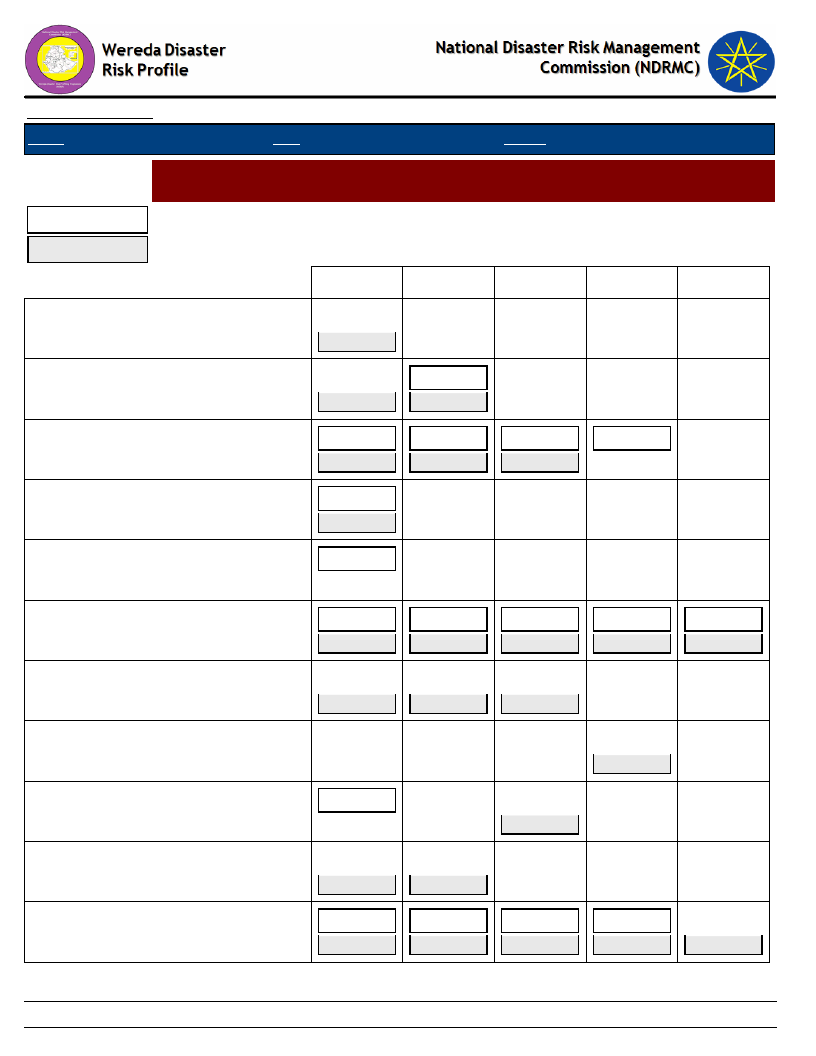
Data_Collected_Date
Region S.N.N.P
Zone GURAGE
Wereda MESKAN
Selected Indictor:
Last Year
Hazards: Change in Crop Damages - Proportion of Damage for Major Crops
(percentage response by households)
Five Years Ago
Wednesday, July 10, 2019
0%
1-25%
26-50%
51-75%
76-100%
Barley
100.00
Chat
60.00
100.00
40.00
Enset
60.53
26.32
10.53
2.63
59.46
27.03
10.81
Lentils
100.00
100.00
Linseed
100.00
Maize
Other cash crop
Other pulses
Peas
Sorghum
Teff
43.12
22.46
19.57
9.78
4.35
53.20
28.40
11.60
3.60
2.00
33.33
33.33
33.33
100.00
100.00
100.00
66.67
33.33
42.50
17.50
35.00
5.00
54.90
23.53
15.69
1.96
3.92
152
Page 1 of 2
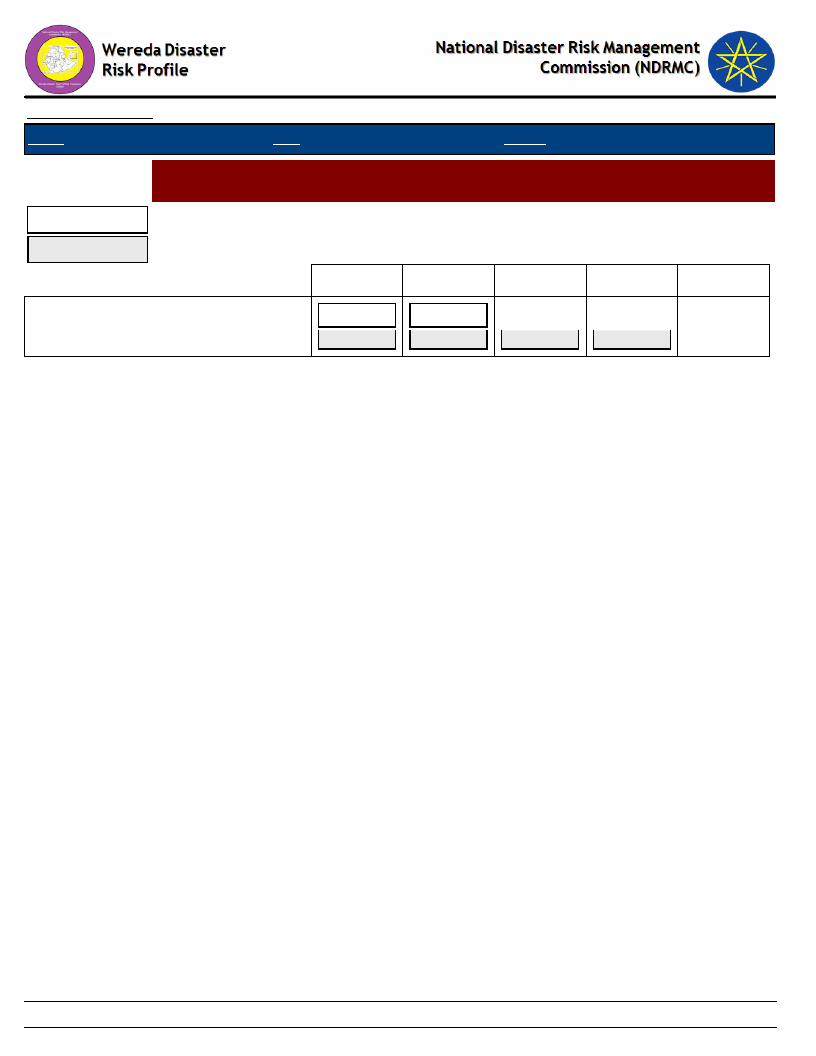
Data_Collected_Date
Region S.N.N.P
Zone GURAGE
Wereda MESKAN
Wednesday, July 10, 2019
Selected Indictor:
Last Year
Hazards: Change in Crop Damages - Proportion of Damage for Major Crops
(percentage response by households)
Five Years Ago
0%
1-25%
26-50%
51-75%
76-100%
Wheat
62.50
33.33
37.50
33.33
16.67
16.67
153
Page 2 of 2
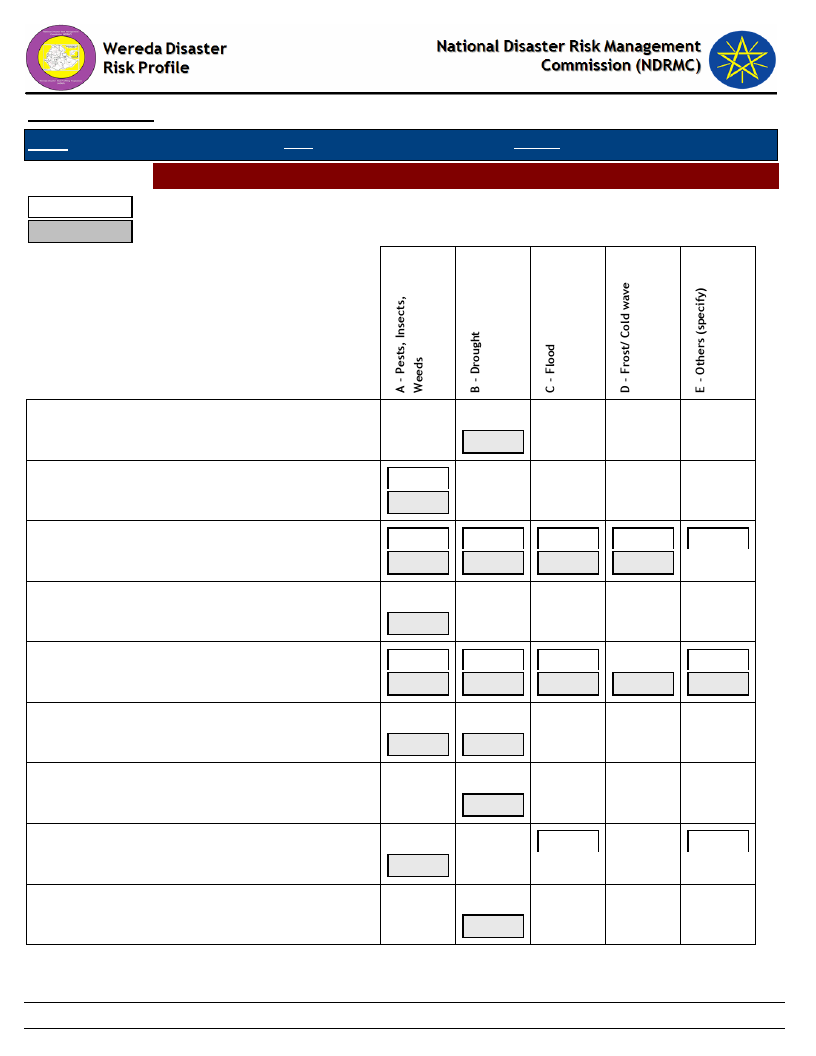
Data_Collected_Date
Region S.N.N.P
Zone GURAGE
Wednesday, July 10, 2019
Wereda MESKAN
Hazards: Change in Crop Damages - Reasons for Damage of Major Crops
Last Year
Five Years Ago
Barley
Chat
Enset
Lentils
Maize
Other cash crop
Other pulses
Peas
Sorghum
100.00
100.00
100.00
21.05
21.05
15.79
36.84
5.26
11.76
35.29
11.76
41.18
100.00
31.90
45.40
13.50
9.20
56.00
38.40
1.60
2.40
1.60
50.00
50.00
100.00
100.00
33.33
66.67
100.00
154
Page 1 of 2
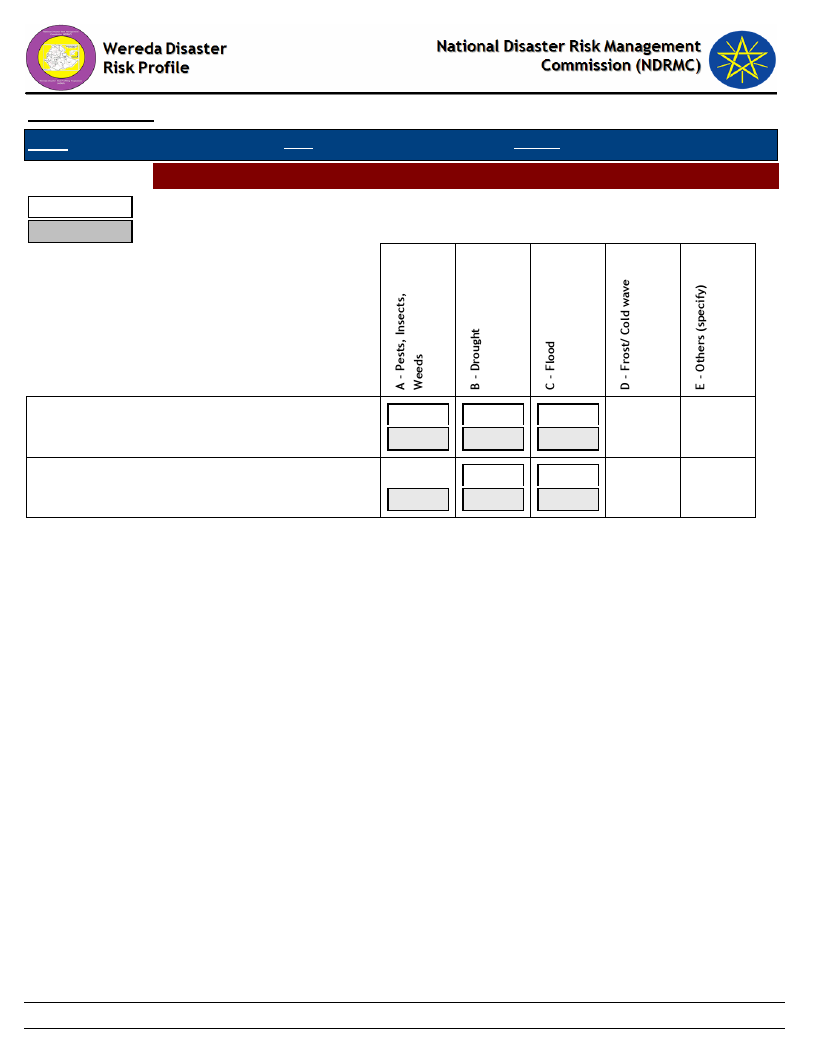
Data_Collected_Date
Region S.N.N.P
Zone GURAGE
Wednesday, July 10, 2019
Wereda MESKAN
Hazards: Change in Crop Damages - Reasons for Damage of Major Crops
Last Year
Five Years Ago
Teff
Wheat
22.73
45.45
25.00
36.36
40.91
25.00
50.00
40.91
13.64
75.00
25.00
155
Page 2 of 2
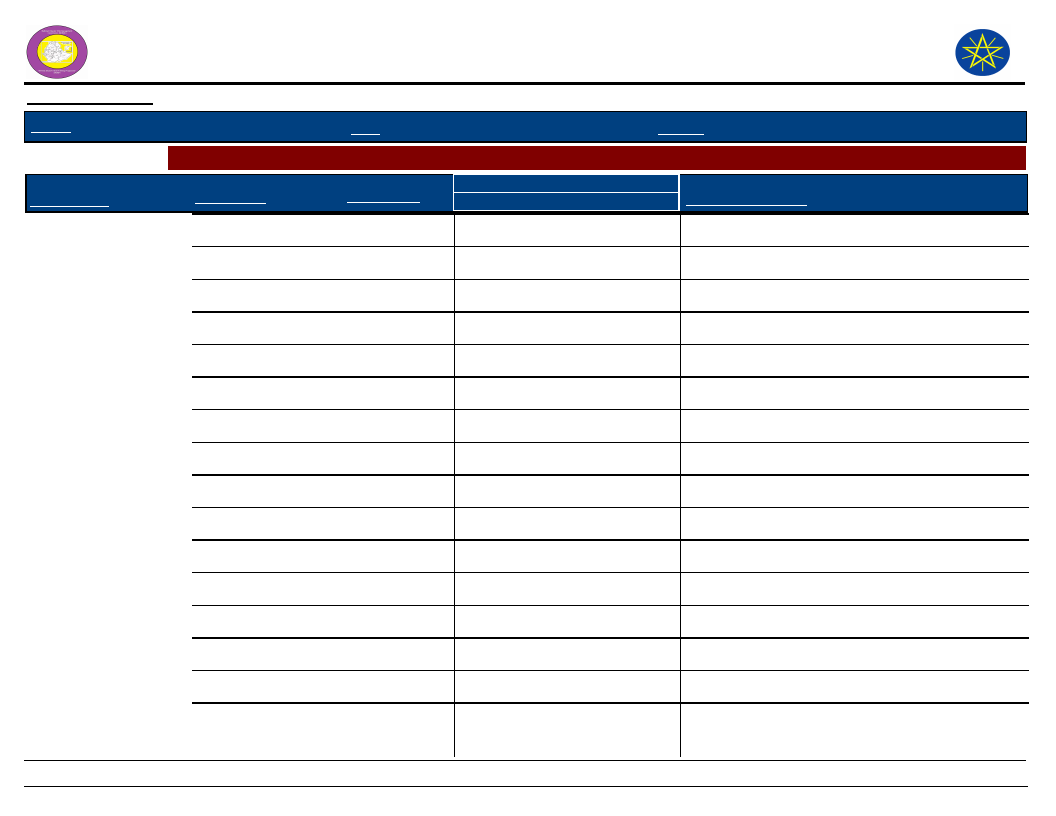
Wereda Disaster
Risk Profile
Data_Collected_Date
Region
S.N.N.P
Zone
GURAGE
National Disaster Risk Management
Commission (NDRMC)
Wednesday, July 10, 2019
Wereda
MESKAN
Selected Indictor:
Kebele Name
BATI FATO
Agricultural Situation: Change in Crops Grown - Five major crops grown by proportion of total cultivated land
Major Crops
Main Season
Present
Cropped Area
Five_Years_Ago
Reason_For_Change
Maize
Meher
80
50
Wheat
Meher
10
8
Fruits
Meher
5
3
Pepper
Meher
2
35
Sorghum
Meher
3
5
BATI LEJANO
Haricot Bean
Belg
10
Barley
Meher
7
Teff
Meher
10
Wheat
Meher
20
Maize
Belg
50
BECHE BULCHANO
Maize
Meher
85
70
Wheat
Meher
10
8
Haricot Bean
Meher
5
5
Pepper
Meher
18
BERESA
Wheat
Meher
10
Sorghum
Belg
15
156
Page 1 of 10
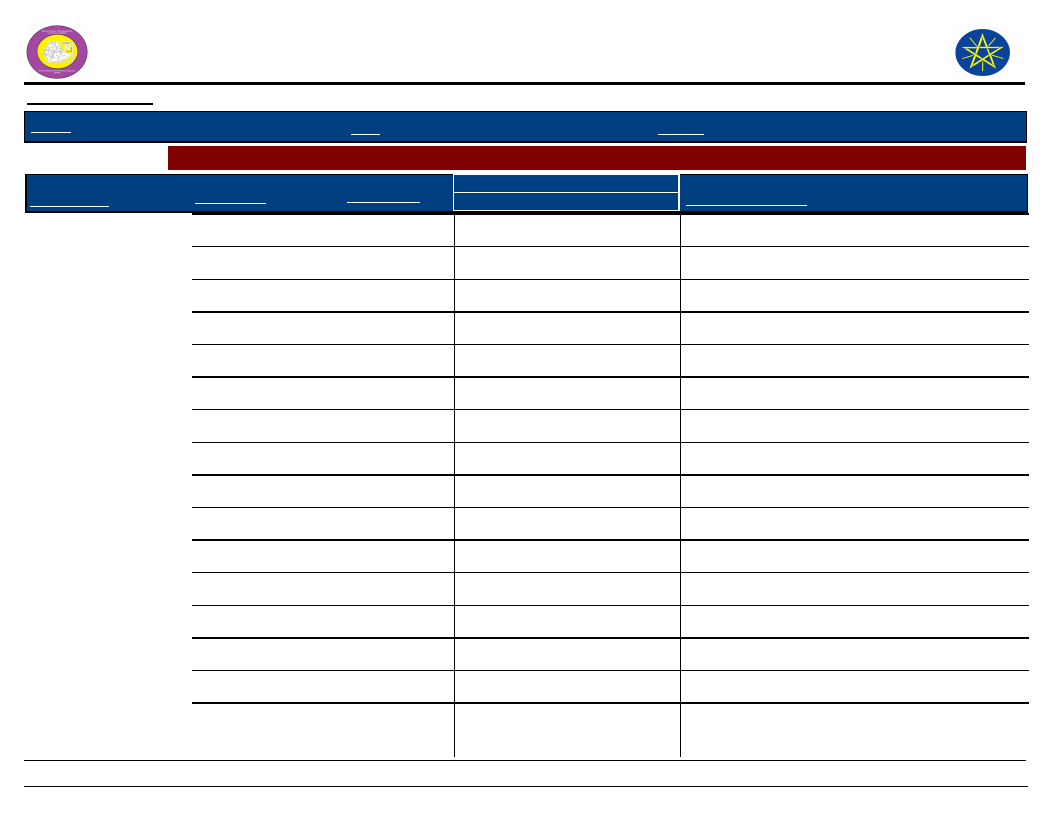
Wereda Disaster
Risk Profile
Data_Collected_Date
Region
S.N.N.P
Zone
GURAGE
National Disaster Risk Management
Commission (NDRMC)
Wednesday, July 10, 2019
Wereda
MESKAN
Selected Indictor:
Kebele Name
BERESA
Agricultural Situation: Change in Crops Grown - Five major crops grown by proportion of total cultivated land
Major Crops
Main Season
Present
Cropped Area
Five_Years_Ago
Reason_For_Change
Teff
Meher
25
Beans
Belg
10
Maize
Belg
40
DEBO TUTO
Teff
Meher
40
40
Sorghum
Belg
2
2
Maize
Belg
30
30
Wheat
Meher
20
20
Barley
Meher
8
8
DEBUB SHERSHERA
Pulses
Meher
5
5
Teff
Meher
10
10
Maize
Meher
25
25
Chat
All Season
60
60
DEGAGOGOT
Wheat
Meher
80
Beans
Meher
10
Barley
Meher
5
Teff
Meher
5
157
Page 2 of 10
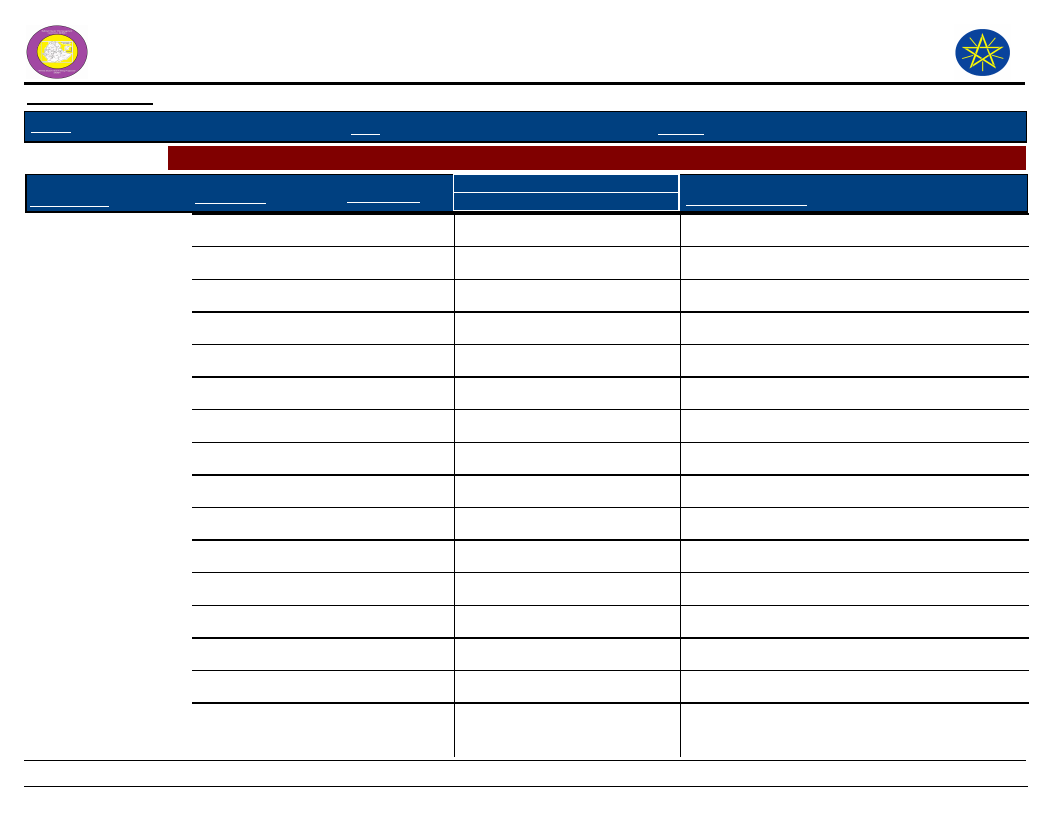
Wereda Disaster
Risk Profile
Data_Collected_Date
Region
S.N.N.P
Zone
GURAGE
National Disaster Risk Management
Commission (NDRMC)
Wednesday, July 10, 2019
Wereda
MESKAN
Selected Indictor:
Kebele Name
DIDA
Agricultural Situation: Change in Crops Grown - Five major crops grown by proportion of total cultivated land
Major Crops
Main Season
Present
Cropped Area
Five_Years_Ago
Reason_For_Change
Fruits
Meher
5
5
Sorghum
Meher
8
8
Wheat
Meher
10
10
Barley
Meher
2
2
Maize
Meher
75
75
DIRAMA
Maize
Meher
60
60
No change
Peas
Meher
5
5
No change
Teff
Meher
20
20
No change
Haricot Bean
Meher
8
8
No change
Wheat
Meher
7
7
No change
DOBENA
Fruits
Meher
8
8
Wheat
Meher
14
10
Teff
Meher
25
25
Pepper
Meher
7
7
Maize
Meher
50
50
GIDENA ABORAT
Maize
Belg
50
50
158
Page 3 of 10
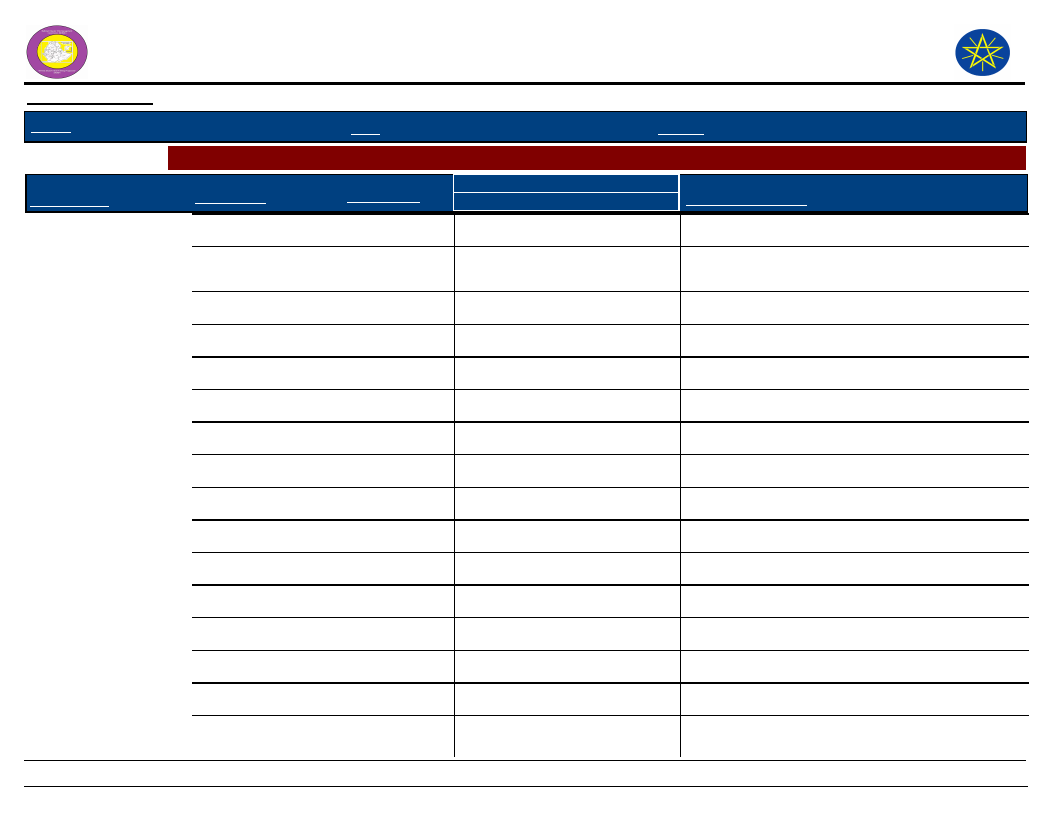
Wereda Disaster
Risk Profile
Data_Collected_Date
Region
S.N.N.P
Zone
GURAGE
National Disaster Risk Management
Commission (NDRMC)
Wednesday, July 10, 2019
Wereda
MESKAN
Selected Indictor:
Kebele Name
GIDENA ABORAT
Agricultural Situation: Change in Crops Grown - Five major crops grown by proportion of total cultivated land
Major Crops
Main Season
Present
Cropped Area
Five_Years_Ago
Reason_For_Change
Pulses
Meher
2
2
Enset
Teff
Belg and
30
30
Meher
Meher
15
15
Wheat
Meher
3
3
GOYBAN
Beans
Meher
5
10
Shortage of farm land
Sorghum
Belg
1
3
Low yield
Wheat
Meher
55
40
Crop disease
Peas
Meher
5
7
Crop pest
Maize
Belg
34
40
Soil fertility
ILE
Maize
Belg
45
No change
Sorghum
Belg
5
Teff
Meher
20
Wheat
Meher
20
Barley
Meher
5
INSENO USME
Haricot Bean
Belg
10
Sorghum
Belg
10
159
Page 4 of 10
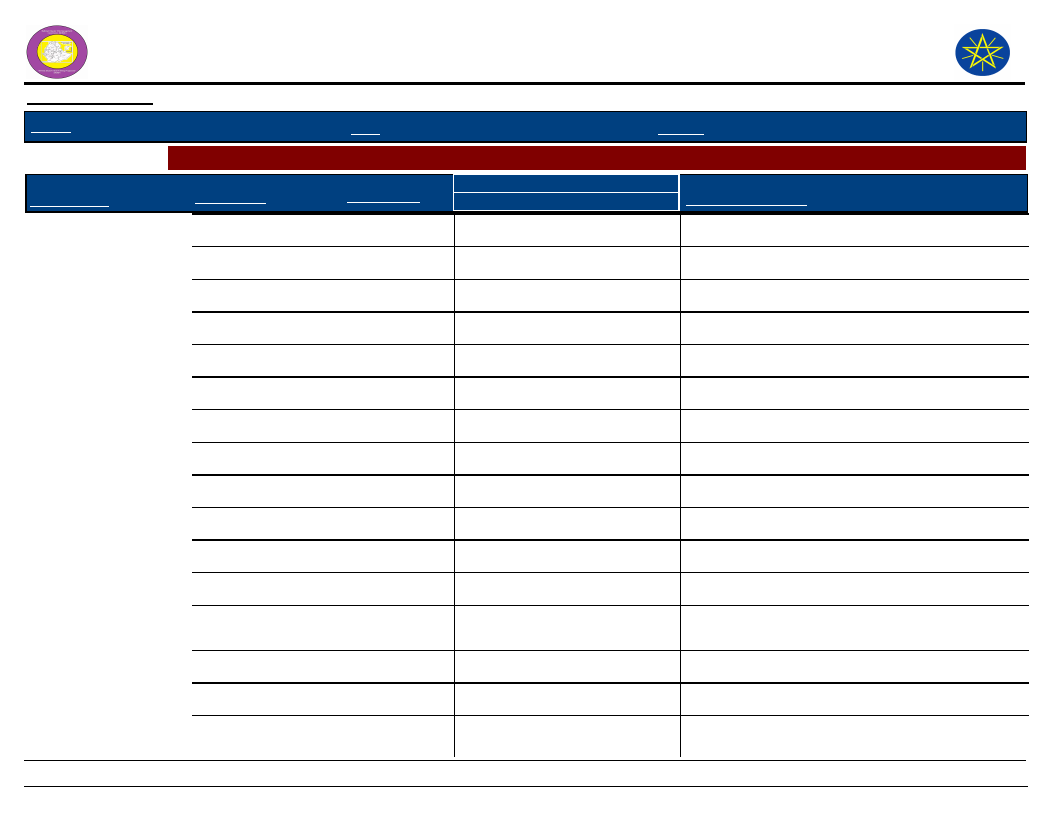
Wereda Disaster
Risk Profile
Data_Collected_Date
Region
S.N.N.P
Zone
GURAGE
National Disaster Risk Management
Commission (NDRMC)
Wednesday, July 10, 2019
Wereda
MESKAN
Selected Indictor:
Kebele Name
INSENO USME
Agricultural Situation: Change in Crops Grown - Five major crops grown by proportion of total cultivated land
Major Crops
Main Season
Present
Cropped Area
Five_Years_Ago
Reason_For_Change
Wheat
Meher
20
Barley
Meher
5
Maize
Belg
55
No change
JOLE ANDENYA
Maize
Belg
60
60
No change
Teff
Meher
25
25
No change
Wheat
Meher
10
10
No change
Sorghum
Belg
5
5
No change
JOLE HULETENYA
Sesame
---------
8
8
Wheat
---------
10
8
Teff
---------
25
20
Papaya
---------
7
24
Maize
---------
50
40
MEKICHO
Enset
Pulses
Belg and
50
Meher
Meher
2
50
No change
2
No change
Maize
Meher
25
25
No change
Teff
Meher
15
15
No change
160
Page 5 of 10
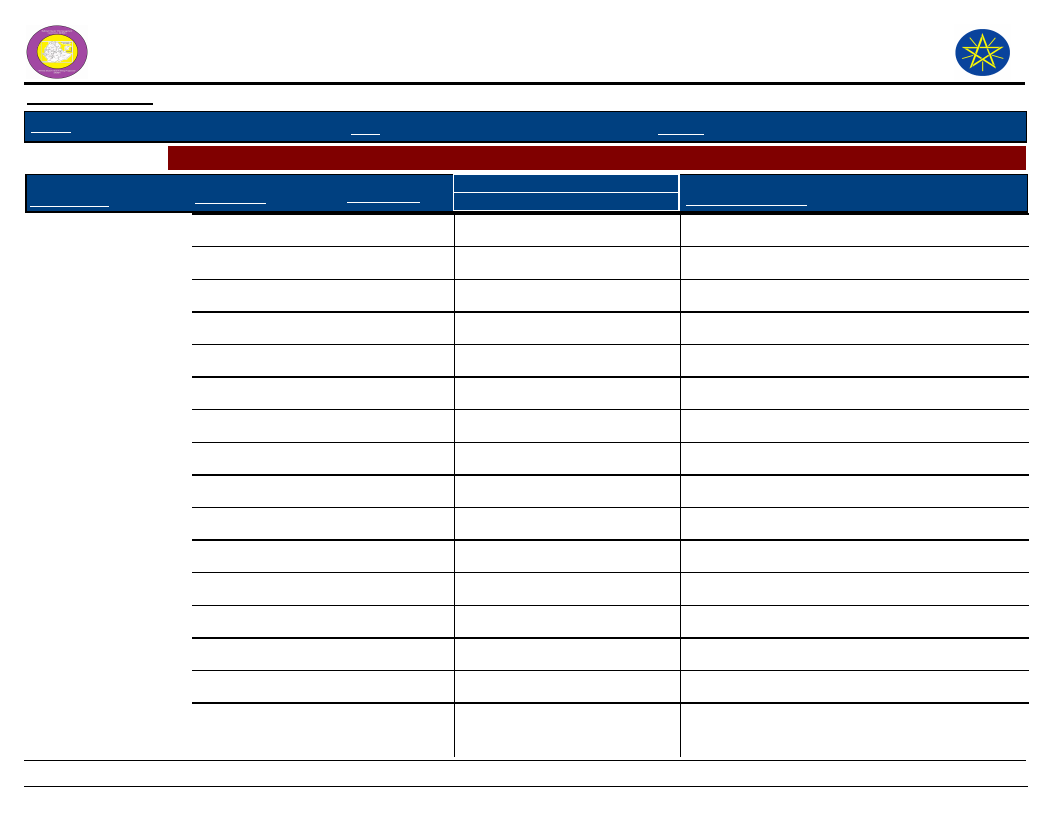
Wereda Disaster
Risk Profile
Data_Collected_Date
National Disaster Risk Management
Commission (NDRMC)
Wednesday, July 10, 2019
Region
S.N.N.P
Zone
GURAGE
Wereda
MESKAN
Selected Indictor:
Kebele Name
MEKICHO
Agricultural Situation: Change in Crops Grown - Five major crops grown by proportion of total cultivated land
Major Crops
Main Season
Present
Cropped Area
Five_Years_Ago
Reason_For_Change
Wheat
Meher
8
8
No change
MESERETEWEGERAMO
Enset
Belg
15
Beans
Meher
20
Wheat
Meher
20
Maize
Belg
5
Teff
Meher
40
No change
MIKAELO
Maize
Belg
60
60
No change
Sorghum
Belg
5
5
No change
Teff
Meher
20
20
No change
Wheat
Meher
10
10
No change
Haricot Bean
Belg
5
5
No change
MIRAB IMBOR
Wheat
Meher
8
10
Maize
Meher
10
8
Due to productivity
Teff
Meher
30
30
No change
Beans
Meher
7
7
No change
Enset
Belg and
45
Meher
45
No change
161
Page 6 of 10
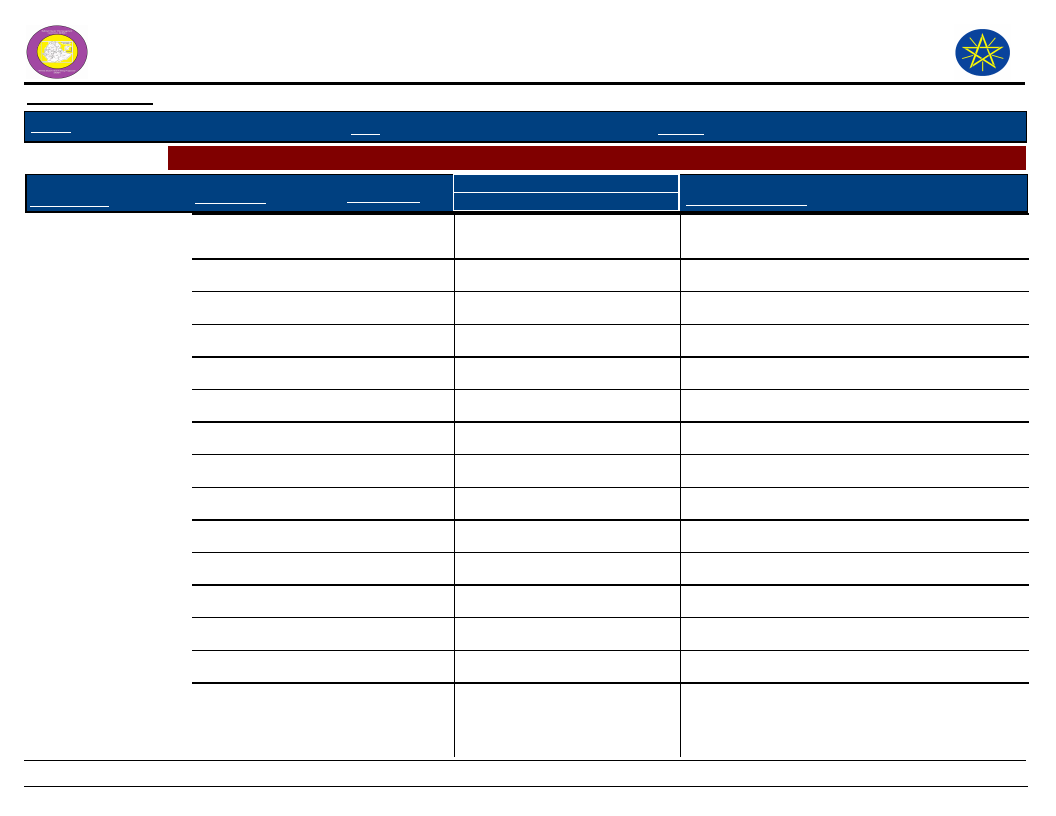
Wereda Disaster
Risk Profile
Data_Collected_Date
Region
S.N.N.P
Zone
GURAGE
National Disaster Risk Management
Commission (NDRMC)
Wednesday, July 10, 2019
Wereda
MESKAN
Selected Indictor:
Kebele Name
MIRAB MESKAN
Agricultural Situation: Change in Crops Grown - Five major crops grown by proportion of total cultivated land
Major Crops
Main Season
Present
Cropped Area
Five_Years_Ago
Reason_For_Change
Enset
Belg and
30
Meher
40
Enset disease
Pulses
Meher
5
5
No change
Maize
Meher
25
15
Teff
Meher
20
20
No change
Wheat
Meher
15
15
No change
OCHAGENEME
Barley
Meher
10
No change
Teff
Meher
15
No change
Wheat
Meher
25
No change
Sorghum
Belg
5
No change
Maize
Belg
45
No change
SEMEN SHORSHORA
Maize
Belg
75
150
Shortage of farm land
Sorghum
Meher
15
10
Low yield
Haricot Bean
Meher
5
10
Crop disease
Peas
Meher
5
5
SHERSHERA
MACHMENA
Wheat
Meher
3
2
Disease and pest
162
Page 7 of 10
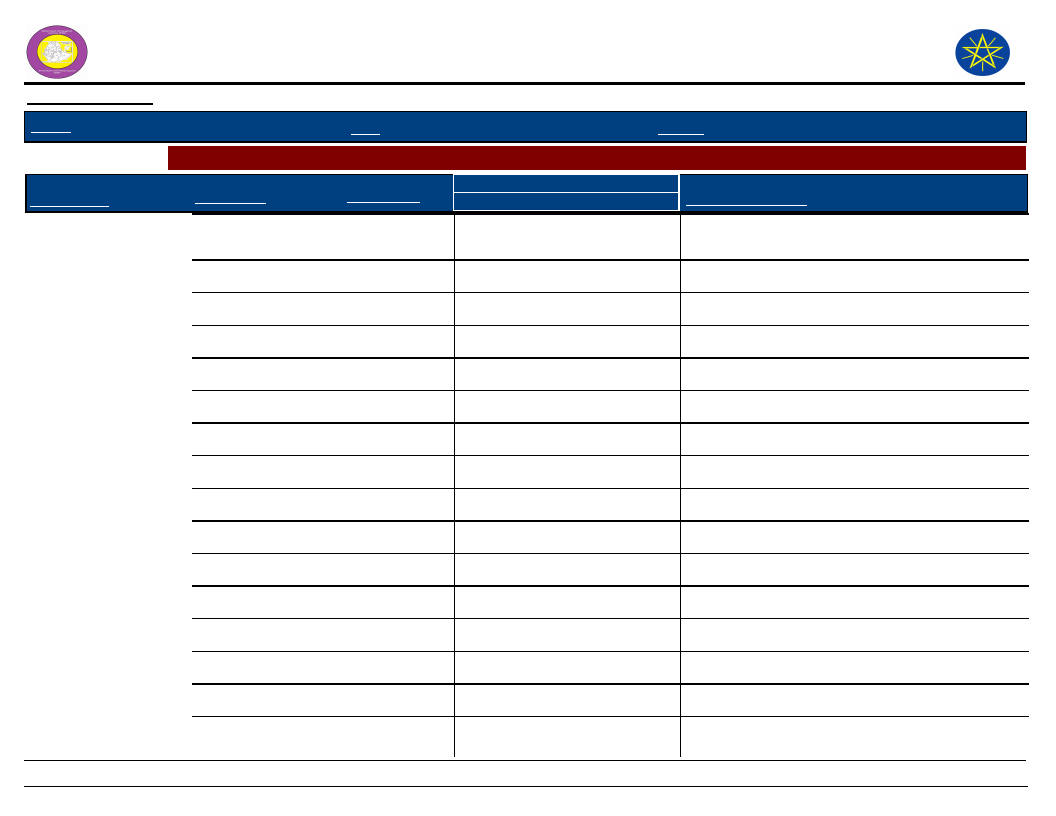
Wereda Disaster
Risk Profile
Data_Collected_Date
Region
S.N.N.P
Zone
GURAGE
National Disaster Risk Management
Commission (NDRMC)
Wednesday, July 10, 2019
Wereda
MESKAN
Selected Indictor:
Kebele Name
SHERSHERA
MACHMENA
Agricultural Situation: Change in Crops Grown - Five major crops grown by proportion of total cultivated land
Major Crops
Main Season
Present
Cropped Area
Five_Years_Ago
Reason_For_Change
Sorghum
Belg
5
3
Disease and pest
Maize
Belg
20
20
Pulses
Meher
2
5
Disease and pest
Teff
Meher
60
50
Less rain
WEJABATI
Maize
Belg
45
Barley
Meher
10
Wheat
Meher
20
Teff
Meher
10
Haricot Bean
Belg
10
WITA
Teff
Meher
20
20
Wheat
Meher
20
20
Sorghum
Belg
10
10
Banana
Belg
5
5
Maize
Belg
55
55
No change
WOLENSHO ANDENYA
Teff
Meher
50
50
No change
Sorghum
Belg
5
5
No change
163
Page 8 of 10
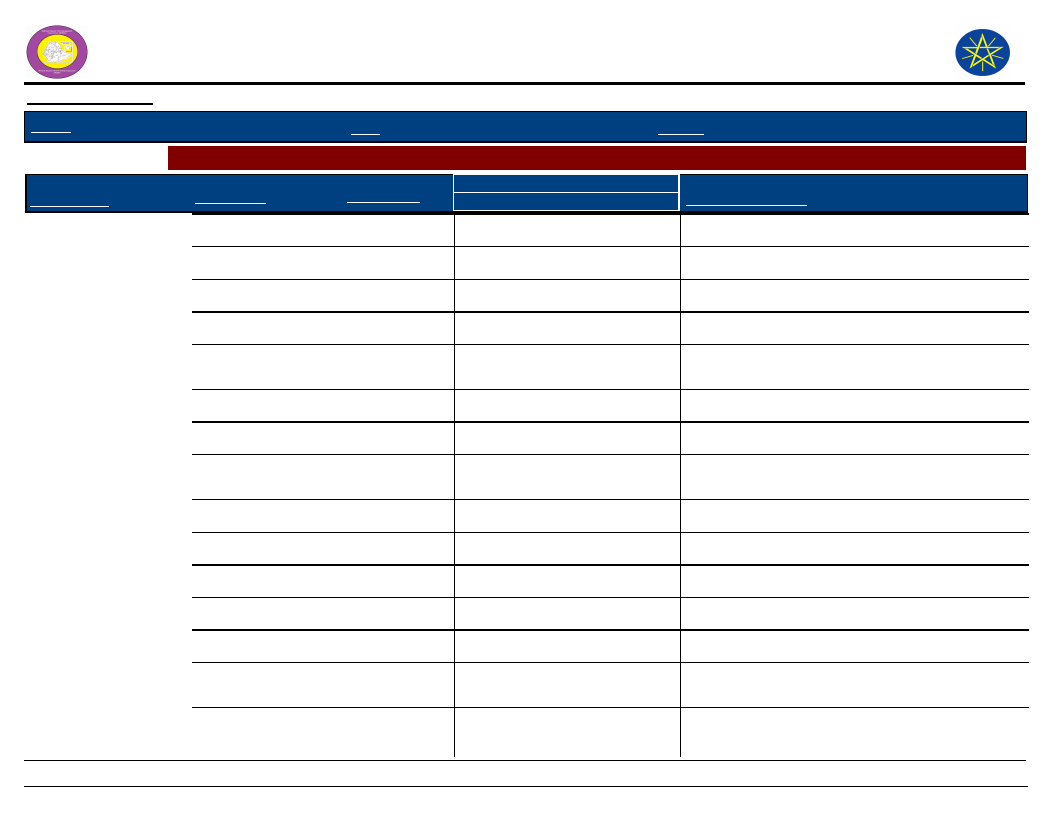
Wereda Disaster
Risk Profile
Data_Collected_Date
Region
S.N.N.P
Zone
GURAGE
National Disaster Risk Management
Commission (NDRMC)
Wednesday, July 10, 2019
Wereda
MESKAN
Selected Indictor:
Kebele Name
WOLENSHO ANDENYA
Agricultural Situation: Change in Crops Grown - Five major crops grown by proportion of total cultivated land
Major Crops
Main Season
Present
Cropped Area
Five_Years_Ago
Reason_For_Change
Maize
Belg
15
15
No change
Beans
Meher
15
15
No change
Wheat
Belg
15
15
No change
YETABON
Teff
Meher
15
15
No change
Enset
Wheat
Belg and
20
Meher
Meher
25
20
No change
25
No change
Chat
All Season
10
10
No change
YIMERWACHO 2NYA
Maize
Maize
Belg and
30
Meher
Meher
60
30
No change
60
Vegetables
Meher
5
5
Cash crop
Wheat
Meher
10
10
Cash crop
Teff
Meher
7
7
Cash crop
Pulses
Meher
10
10
Cash crop
YIMERWACHO 3NYA
Vegetable and
Other
20
fruits
Teff
Meher
15
Increasing
15
No change
164
Page 9 of 10
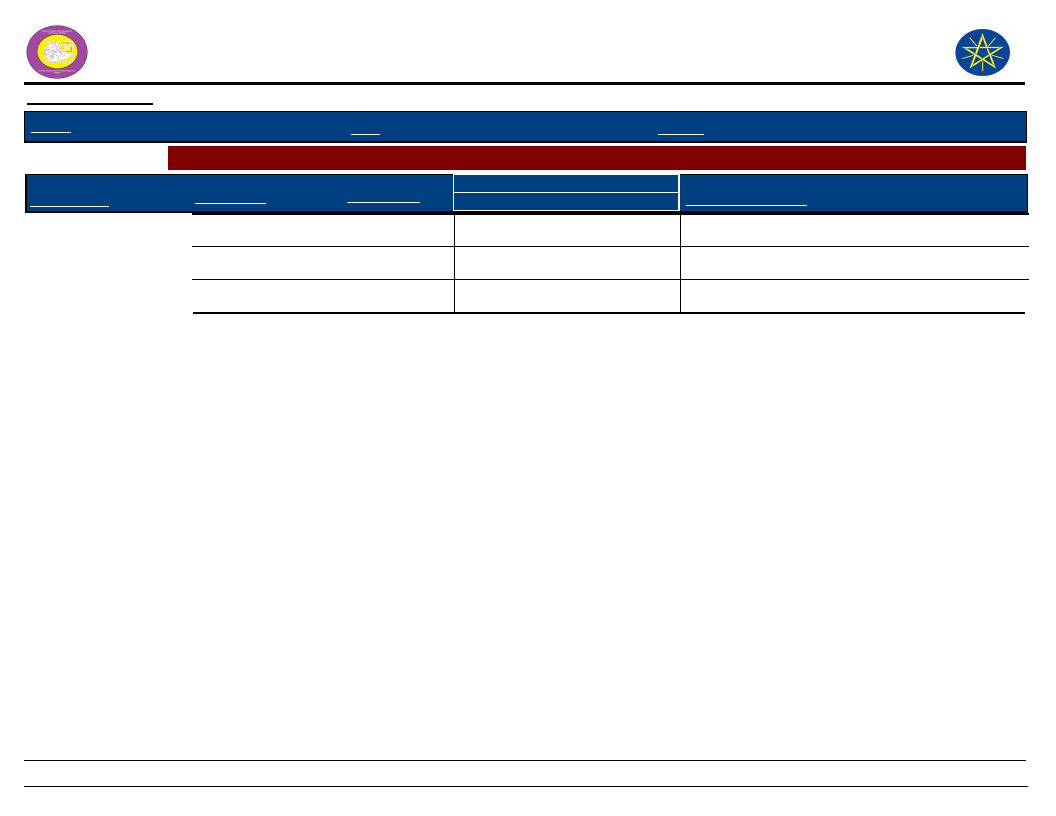
Wereda Disaster
Risk Profile
Data_Collected_Date
Region
S.N.N.P
Zone
GURAGE
National Disaster Risk Management
Commission (NDRMC)
Wednesday, July 10, 2019
Wereda
MESKAN
Selected Indictor:
Kebele Name
YIMERWACHO 3NYA
Agricultural Situation: Change in Crops Grown - Five major crops grown by proportion of total cultivated land
Major Crops
Main Season
Present
Cropped Area
Five_Years_Ago
Reason_For_Change
Wheat
Meher
20
20
No change
Sorghum
Belg
5
5
No change
Maize
Belg
40
40
No change
165
Page 10 of 10
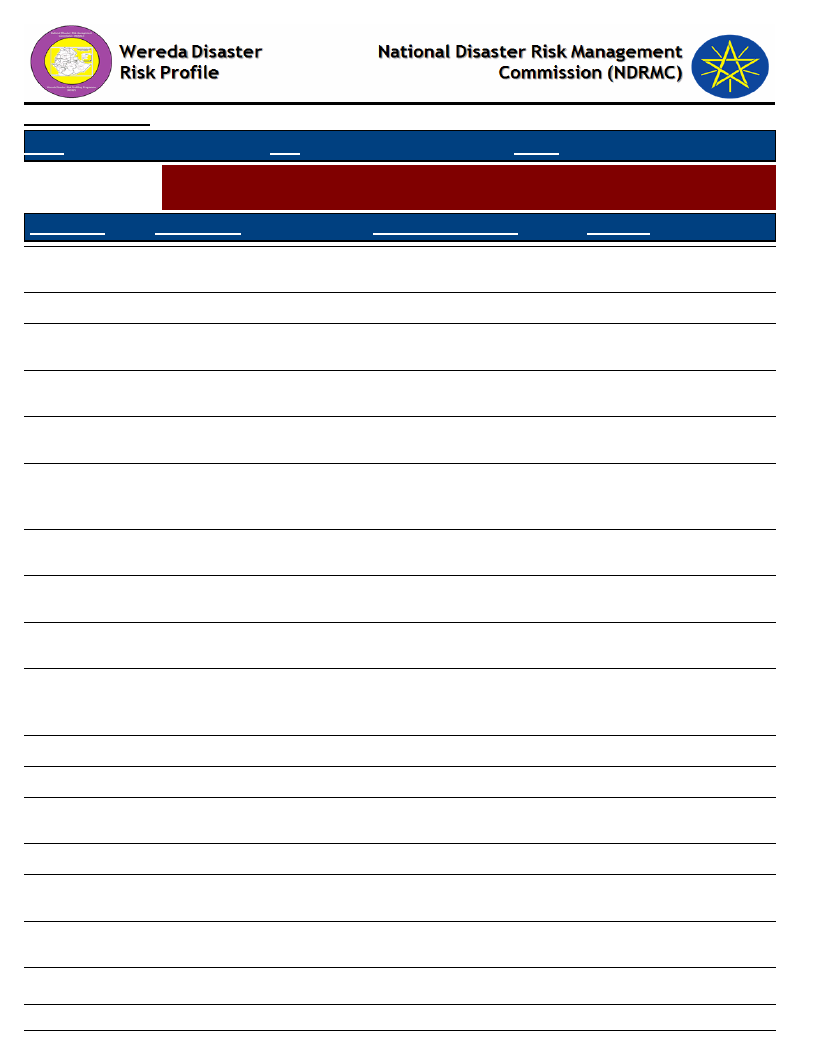
Data_Collected_Date
Wednesday, July 10, 2019
Region S.N.N.P
Zone GURAGE
Wereda MESKAN
Selected Indictor:
Agricultural Situation: Access to Extension - Perception of the community on
Access to Agricultural extension Services
KebeleName
Current_Level
Change_In_Last_Decade
Comments
BATI FATO
BATI LEJANO
Increasing
Good
Increasing
Increased
Presence of agricultural
extension agents
Available extension agent
BECHE BULCHANO Very good
BERESA
Good
DEBO TUTO
Good
DEBUB
SHERSHERA
Very good
DEGAGOGOT
very good
DIDA
Very good
DIRAMA
Good
DOBENA
Very good
GIDENA ABORAT
Very less
Increased
Increased
Increased
Increased
Increased
Increased
Increased
Increased
No change
Presence of skilled man
power
Availability of extension
agent
Availability of extension
agent
The presence of skilled
agricultural extensional
agent
Presence of extension
workers
The present of extension
agents
The presence of all
department agents
Due to presence of
agricultural extension
agent
No center to population
GOYBAN
Increased
Increased
ILE
INSENO USME
Increased
Good
Increased
Increased
More number of extension
agent
Available extension agent
JOLE ANDENYA
Very good
JOLE HULETENYA Good
Increased
Increased
Increasing of extension
agent
Presence of agricultural
extension workers
166
Page 1 of 2
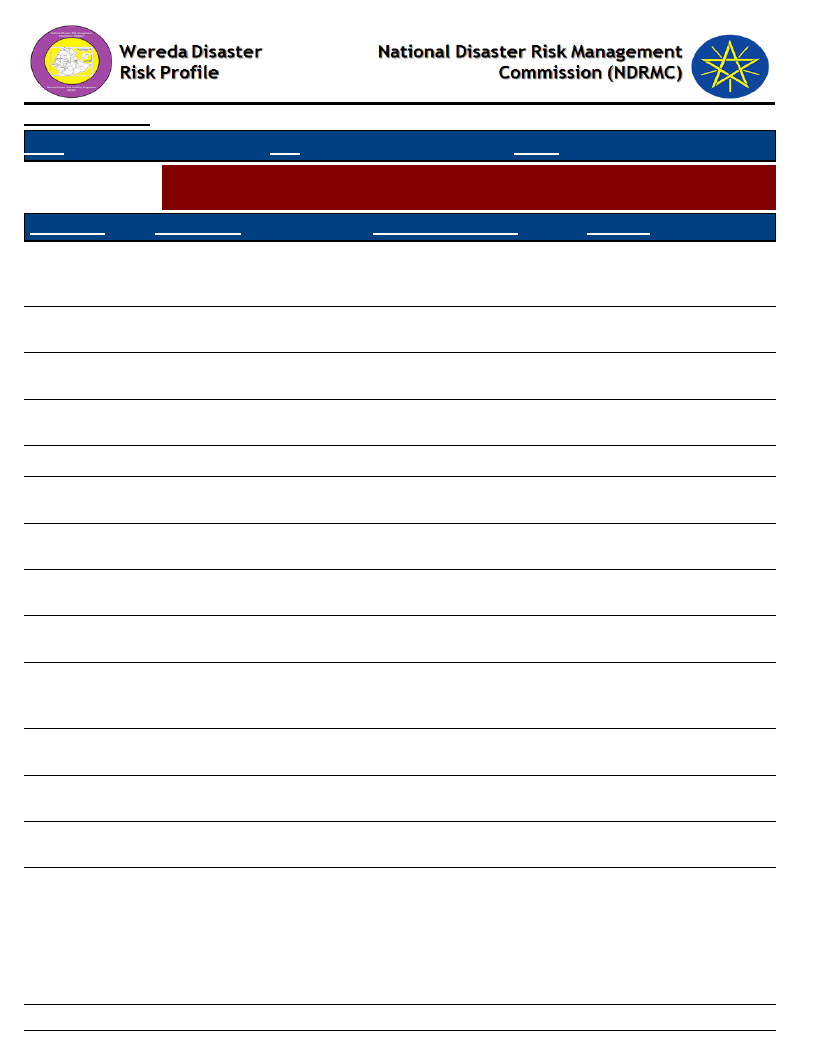
Data_Collected_Date
Wednesday, July 10, 2019
Region S.N.N.P
Zone GURAGE
Wereda MESKAN
Selected Indictor:
Agricultural Situation: Access to Extension - Perception of the community on
Access to Agricultural extension Services
KebeleName
MEKICHO
Current_Level
Good
MESERETEWEGER
AMO
MIKAELO
Good
Good
MIRAB IMBOR
Poor
MIRAB MESKAN
Very good
Change_In_Last_Decade
Increased
Increased
Increased
Decreased
Increased
Comments
The presence of
agricultural extension
agent
Extension agent available
Because of increasing
extension agents
The service is less but
improved time to time
OCHAGENEME
SEMEN
SHORSHORA
SHERSHERA
MACHMENA
WEJABATI
WITA
Good
Very good
Good
good
Very good
WOLENSHO
ANDENYA
YETABON
YIMERWACHO
2NYA
YIMERWACHO
3NYA
Increased
Increased
Good service or well
Increased
Increased
Increased
Increased
Increased
Increased
Increased
Increased
Increasing
Increased
Increasing the number of
skilled extension agent
Good extension service
The increasing extension
agent
Because of increased the
number of extension
agents
Available of extension
agents
By the presence of
agriculture extension
Available extension agent
167
Page 2 of 2
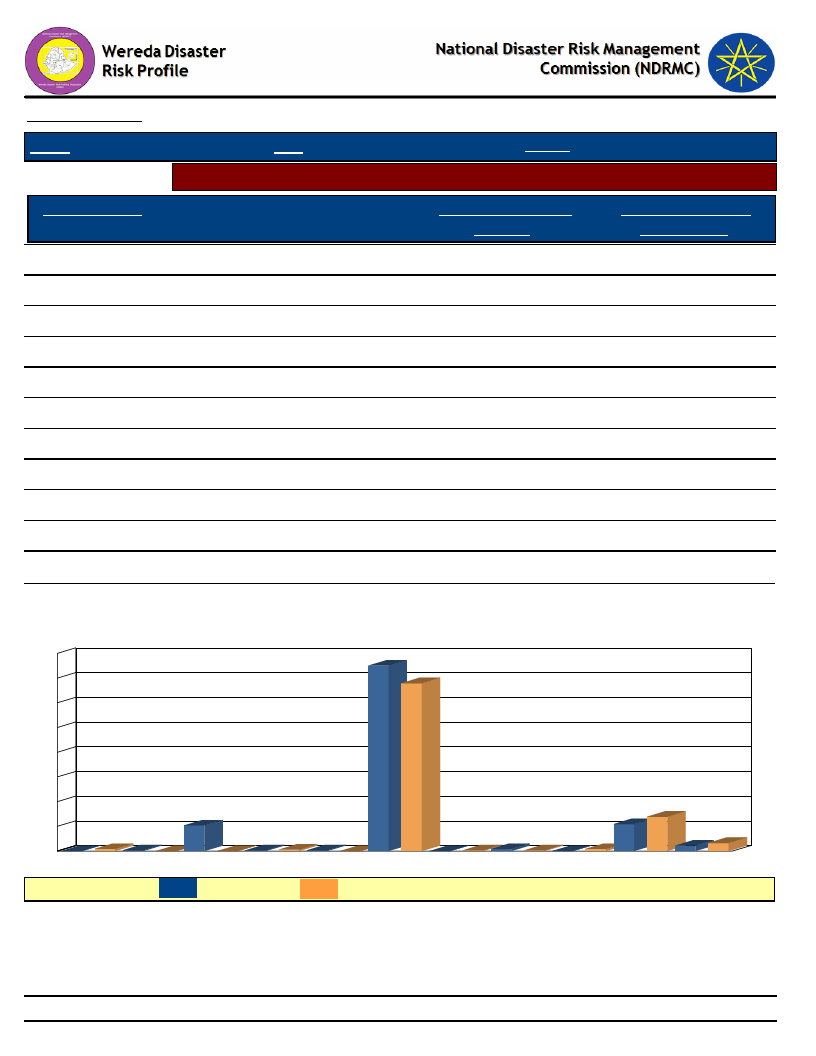
Data_Collected_Date
Region S.N.N.P
Selected Indicator
Major Crop Type
Maize
Teff
Enset
Wheat
Peas
Lentils
Linseed
Chat
Sorghum
Barley
Other pulses
Zone GURAGE
Wereda
Wednesday, July 10, 2019
MESKAN
Economic Vulnerability: Crops Grown - Types of crops grown by households
Type of Crops Grown
Last Year
75.00
Type of Crops Grown
Five Years Ago
67.93
10.87
13.86
10.33
0.00
2.17
3.26
0.82
0.27
0.27
0.54
0.27
0.00
0.27
0.00
0.00
0.82
0.00
0.82
0.00
0.27
Types of Crops Grown - Percent Responses of HHs for Last Year as compared to
Five Years Ago
80
75
70
68
60
50
40
30
20
10
0
1
0
Barley
10
0
0
Chat
0
Enset
0
1
Lentils
0
0
Linseed
Maize
0
0
Other pulses
1
0
Peas
0
1
Sorghum
14
11
Teff
2
3
Wheat
LEGEND :
Last year
Five Years Ago
168
Page 1 of 1
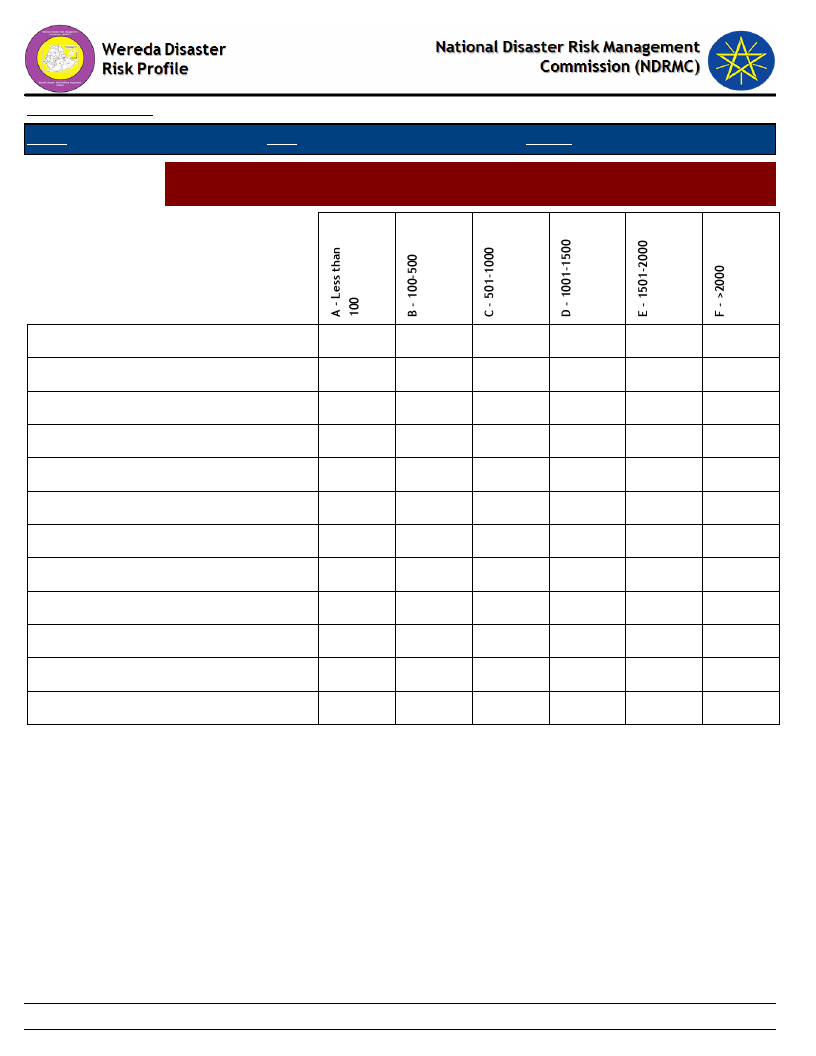
Data_Collected_Date
Region S.N.N.P
Zone GURAGE
Wednesday, July 10, 2019
Wereda MESKAN
Selected Indictor:
Economic Vulnerability: Crops Grown - Proportion of households by amount of
yield of major crops (last year)
Barley
Chat
Enset
Lentils
Linseed
Maize
Other cash crop
Other pulses
Peas
Sorghum
Teff
Wheat
100.00
5.26
63.16
21.05
5.26
2.63
2.63
100.00
100.00
16.30
48.55
20.29
5.43
4.35
5.07
66.67
33.33
32.50
57.50
100.00
10.00
169
Page 1 of 1
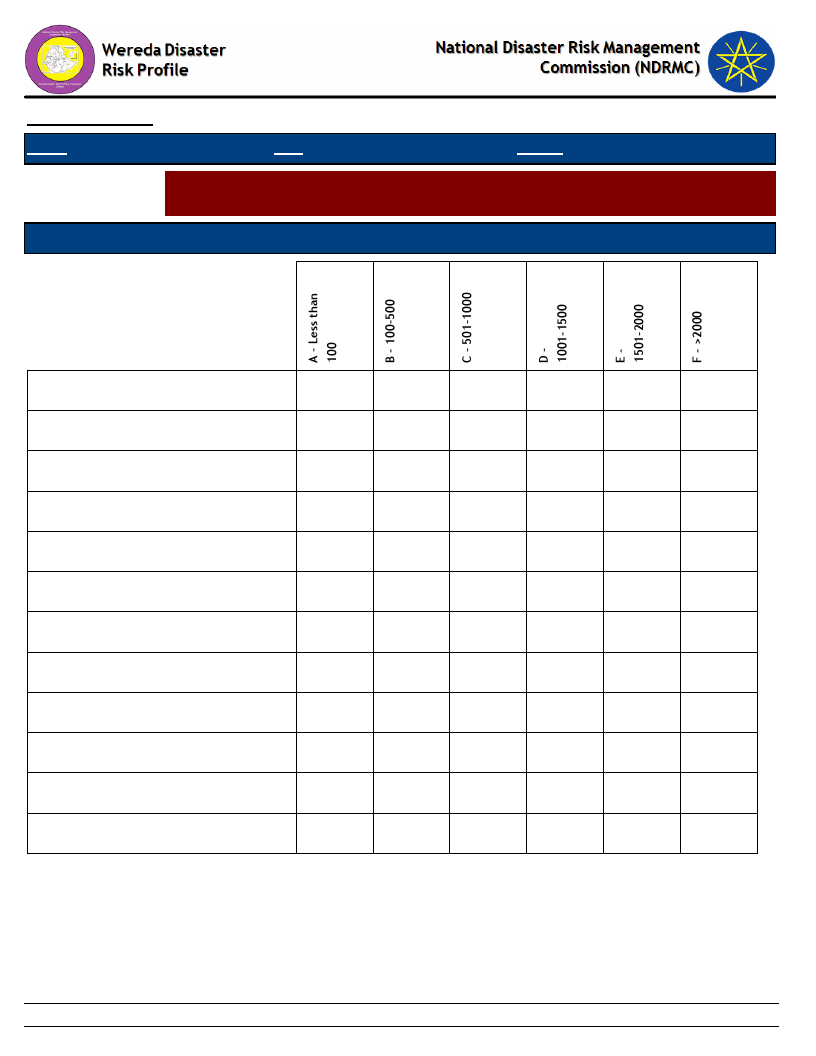
Data_Collected_Date
Region S.N.N.P
Zone GURAGE
Wednesday, July 10, 2019
Wereda MESKAN
Selected Indictor:
Economic Vulnerability: Crops Grown - Proportion of households by amount of
yield of major crops (Five Years Ago)
Types of Major Crops
Category of Yield used to be obtained five years ago
Barley
Chat
Enset
Lentils
Linseed
Maize
Other cash crop
Other pulses
Peas
Sorghum
Teff
Wheat
66.67
33.33
40.00
60.00
5.41
62.16
27.03
2.70
2.70
50.00
50.00
11.60
47.20
25.60
6.40
33.33
33.33
100.00
100.00
100.00
25.49
72.55
1.96
33.33
50.00
16.67
2.80
6.40
33.33
170
Page 1 of 1
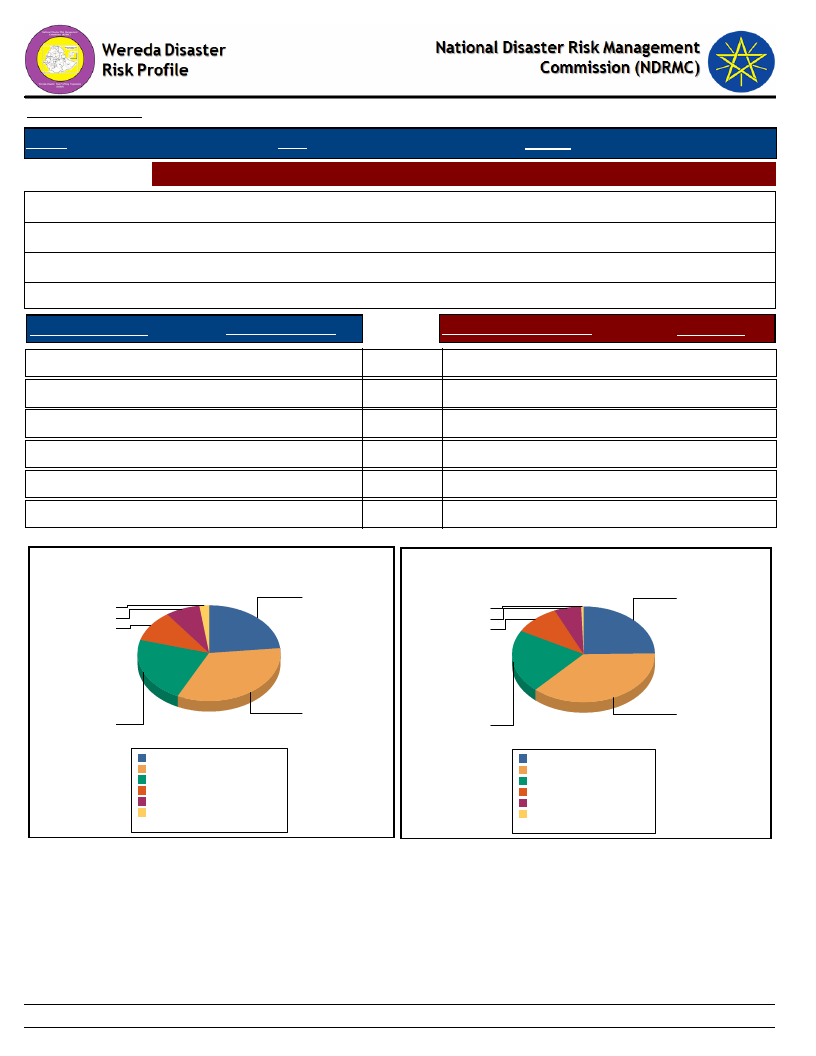
Data_Collected_Date
Wednesday, July 10, 2019
Region S.N.N.P
Zone GURAGE
Wereda MESKAN
Selected Indictor: Economic Vulnerability: Land Ownership and Quality - Landownership of HHs
Households owning land (%)
Average landholding (in Hectares)s
Households cultivating land in last 12 months (%)
Average quantity of land cultivated (in hectares)
94.29
1.49
96.15
0.65
Range Land Holding
Percent_Response
Range of Cultivated Land
% Response
A - Less than 0.25 ha
23.0
B - 0.25 - 0.50 ha
34.0
D - 0.75 - 1 ha
10.0
E - 1 - 2 ha
8.0
C - 0.5 - 0.75 ha
22.0
F - More than 2 ha
2.0
IMPORTANT: ha = Hectars
Household Responses to Range Land Holding
A - Less than 0.25 ha
23.0
B - 0.25 - 0.50 ha
35.0
D - 0.75 - 1 ha
10.0
E - 1 - 2 ha
6.0
C - 0.5 - 0.75 ha
20.0
F - More than 2 ha
1.0
Household Responses to Range Cultivated Land
23.3
23.1
2.3
0.6
7.8
5.8
10.4
9.5
34.0
22.2
A - Less than 0.25 ha 23.3%
B - 0.25 - 0.50 ha
C - 0.5 - 0.75 ha
34.0%
22.2%
D - 0.75 - 1 ha
10.4%
E - 1 - 2 ha
7.8%
F - More than 2 ha
2.3%
Total:
100.0%
20.2
34.6
A - Less than 0.25 ha 23.1
B - 0.25 - 0.50 ha 34.6
C - 0.5 - 0.75 ha
20.2
D - 0.75 - 1 ha
9.5
E - 1 - 2 ha
5.8
F - More than 2 ha
0.6
Total:
93.7
171
Page 1 of 1
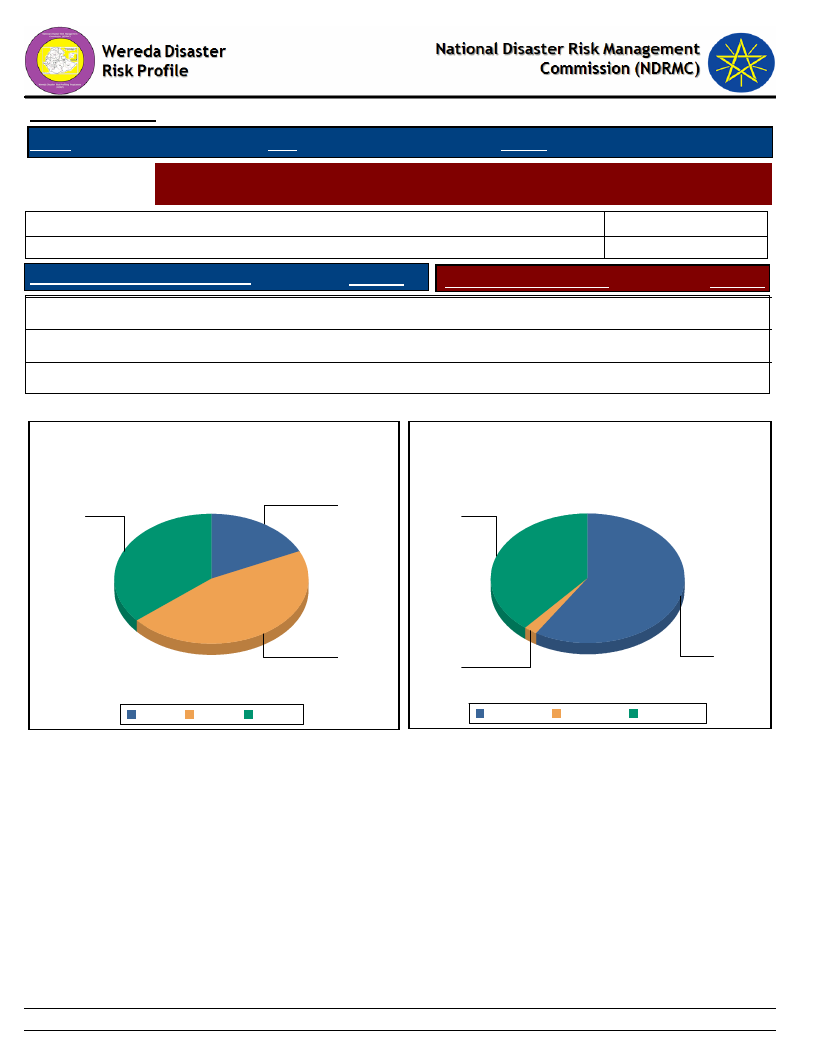
Data_Collected_Date
Wednesday, July 10, 2019
Region S.N.N.P
Zone GURAGE
Wereda MESKAN
Selected Indictor:
Economic Vulnerability: Land Ownership and Quality - Farmers’ perception on the
quality of their agricultural land
Cropping_Intensity *
Households with enough land for farming
HHs with favourable location of farm
Response
Households with fertile soil
0.53
3.84
Response
Yes
35.99
Highly fertile
2.19
Partially
45.88
Fertile
58.90
No
18.13
Not fertile
38.90
* Cropping Intensity = (Gross Cropped Area / Net Cropped Area )x 100%
Household responses to the type of farm
location
Household responses tp the type of soil
fertility
18
36
39
46
No
Partially Yes
Gross Cropped Area = Irrigated Area + Unirrigated
Area
59
2
Fertile
Highly fertile Not fertile
Net Cropped Area = Total Cultivated Area in last
12 months
172
Page 1 of 1
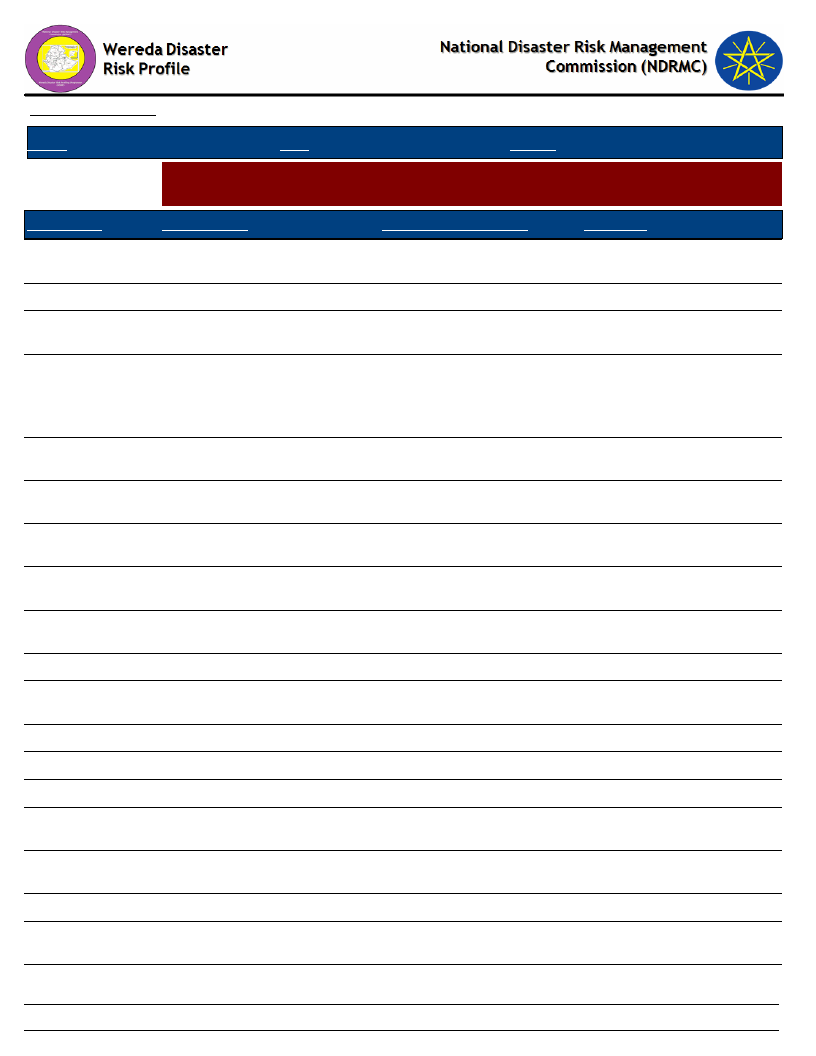
Data_Collected_Date
Wednesday, July 10, 2019
Region S.N.N.P
Selected Indictor:
KebeleName
BATI FATO
BATI LEJANO
BECHE
BULCHANO
BERESA
DEBO TUTO
DEBUB
SHERSHERA
DEGAGOGOT
DIDA
DIRAMA
DOBENA
GIDENA ABORAT
GOYBAN
ILE
INSENO USME
JOLE ANDENYA
JOLE HULETENYA
MEKICHO
MESERETEWEGER
AMO
MIKAELO
Zone GURAGE
Wereda MESKAN
Agricultural Situation: Access to Inputs - Perception of the community on access
to improved agricultural inputs
Current_Level
Change_In_Last_Decade
Comments
Increasing
Very good
Good but very expensive
Good
Good
Very good
Very good
Very good
Good
Very good
Very less
Increased
Increased
Very good
Very good
Good
Good
Good
Increasing
Increased
Increased
Increased
Increased
Increased
Increased
Increased
Increased
Increased
Decreased
Increased
Increased
Increased
Increased
Increased
Increased
Increased
Presence of supplying
inputs
Available
Support of government is
less
Input not used
proportional to the land
behavior poor economic
level
Input not used
proportional to the land
Due to presence of input
cooperative
Presence of extension
workers
Supply of agriculture
extension
Improvement of supplying
inputs
Due to supplying inputs
Shortage of supplying of
inputs
Available
Due to available inputs
Use of improved seed and
fertilizer
Supplying of input by
government
Supply of government
Input available
Very good
Increased
Poor quality
173
Page 1 of 2
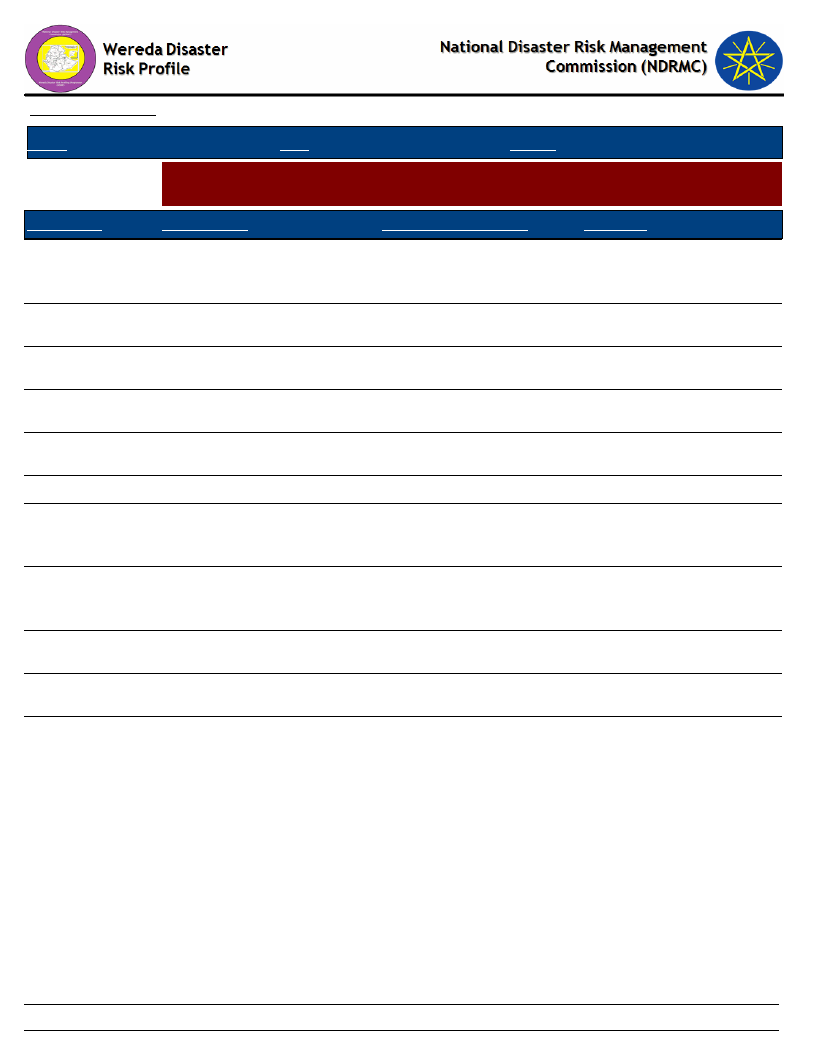
Data_Collected_Date
Wednesday, July 10, 2019
Region S.N.N.P
Selected Indictor:
KebeleName
MIRAB IMBOR
MIRAB MESKAN
OCHAGENEME
SEMEN
SHORSHORA
SHERSHERA
MACHMENA
WEJABATI
WITA
WOLENSHO
ANDENYA
YETABON
YIMERWACHO
2NYA
YIMERWACHO
3NYA
Zone GURAGE
Wereda MESKAN
Agricultural Situation: Access to Inputs - Perception of the community on access
to improved agricultural inputs
Current_Level
Very good supplying but
problems
Good
Very good
Very good
Change_In_Last_Decade
Increased
Increase
Increased
Increased
Comments
The inputs/improved
variety of not match
ecology
The activity of extension
agent
Source is available and
increased
Good supply
Good
Increased
Very good
Very good
Increased
Increased
Good supplying
Increased
Increased
Increased
Increased
Increasing
Available
Good submission of
improved seed fertilizer
pesticide
Poor quality of seeds not
suitable to climate
condition
Supply of input by
government
More will be improved
Increased
Increased
Available agricultural
inputs
174
Page 2 of 2
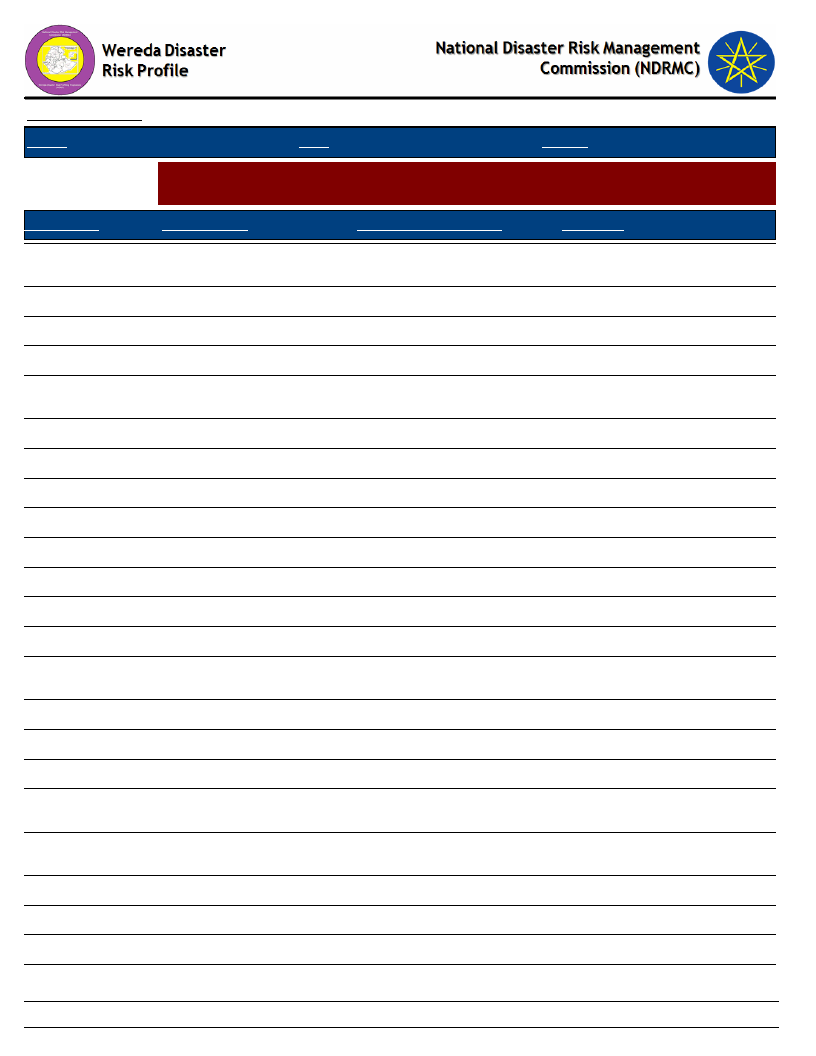
Data_Collected_Date
Region S.N.N.P
Zone GURAGE
Wednesday, July 10, 2019
Wereda MESKAN
Selected Indictor:
KebeleName
Agricultural Situation: Water for irrigation - Access to water for irrigation in the
community
Current_Level
Change_In_Last_Decade
Comments
BATI FATO
Increasing
BATI LEJANO
BECHE BULCHANO
BERESA
DEBO TUTO
Not good
Good
No irrigation
Not good
DEBUB SHERSHERA
DEGAGOGOT
DIDA
DIRAMA
DOBENA
GIDENA ABORAT
GOYBAN
ILE
INSENO USME
No access
Low
No access
No
Very less
Very low
Decreased
Decreased
Good
JOLE ANDENYA
JOLE HULETENYA
MEKICHO
MESERETEWEGERAM
O
MIKAELO
Good
Good
Very less
Poor
Not good
MIRAB IMBOR
MIRAB MESKAN
OCHAGENEME
SEMEN SHORSHORA
Less
Less
Low
Very low
Increasing
No change
Decreased
Decreased
Decreased
Decreased
Decreased
Decreased
Decreased
Decreased
Increased
No change
Increased
Increased
Increased
Decreased
No change
Decreased
Decreased
No change
Decreased
The presence of soil and water
conservation activities
Drought
Not sufficient
Lack of water, not sufficient
water
Topography, source of water
Due to repetition of drought
Due to source of water
Climate change
Good awareness creation,
available ground water
Use of cultural irrigation
Drought, climate change
The water source and the
population not proportional
No source of water or limited
Drought
No water access
175
Page 1 of 2
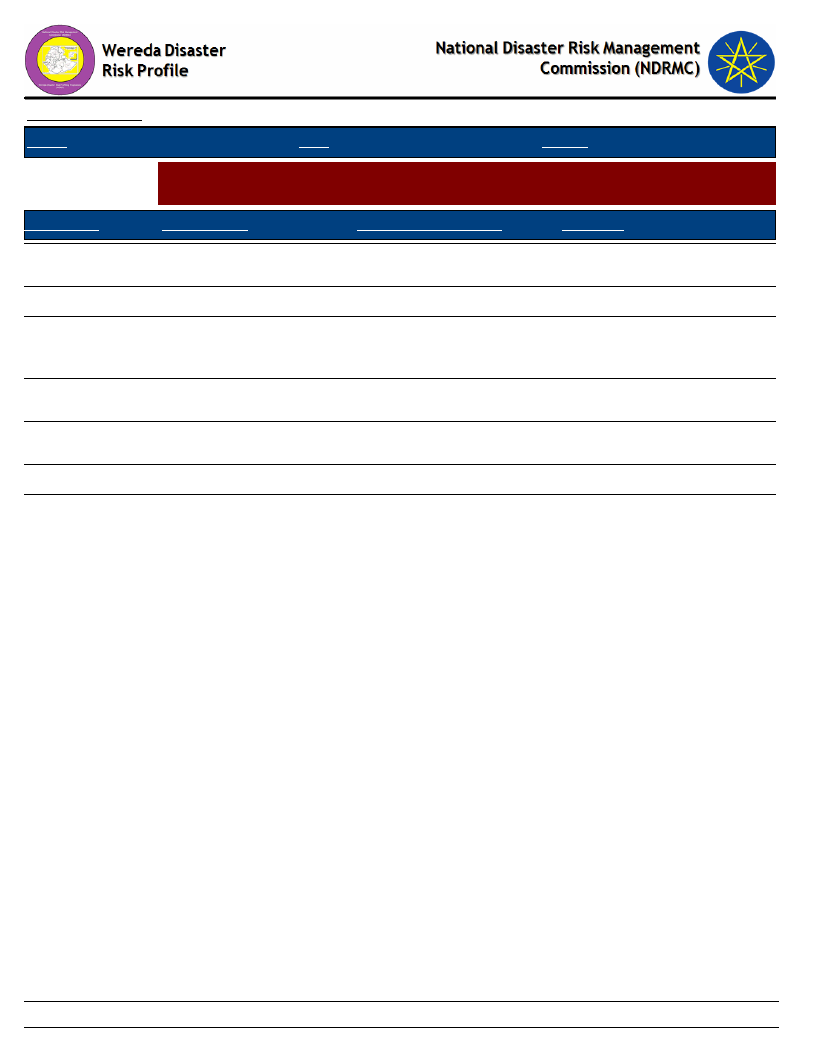
Data_Collected_Date
Region S.N.N.P
Zone GURAGE
Wednesday, July 10, 2019
Wereda MESKAN
Selected Indictor:
Agricultural Situation: Water for irrigation - Access to water for irrigation in the
community
KebeleName
Current_Level
Change_In_Last_Decade
Comments
SHERSHERA
MACHMENA
WEJABATI
WITA
No water
Decreased
Very good
WOLENSHO
ANDENYA
YETABON
Decreased
Decreased
YIMERWACHO 2NYA
YIMERWACHO 3NYA
Good
Increased
No change
No change
Increased
No change
Decreased
Decreasing
Increased
There is no water access
Construction of modern
irrigation and increase
community awareness
Irrigation water not available
Due to shortage of rain
fall/drought
Ground water access
Available ground water and
stream
176
Page 2 of 2

Data_Collected_Date
Wednesday, July 10, 2019
Region S.N.N.P
Zone GURAGE
Wereda MESKAN
Selected Indictor:
Kebele Name
Agricultural Situation: Soil Fertility - Perception of the community on soil fertility
and its change over time
Current_Level
Change_In_Last_Decade
Comments
BATI FATO
Medium
Decreased
Population growth
BATI LEJANO
Good
Increased
Available inputs
BECHE BULCHANO Medium
BERESA
Not good
DEBO TUTO
Not good
Decreased
Decreased
Decreased
Soil erosion, population
growth, climate change
Due to sandy texture the
soil is poor fertile
The soil is not fertile
DEBUB
SHERSHERA
DEGAGOGOT
Very low
Very low
Decreased
Decreased
Soil erosion, type of soil
Soil erosion
DIDA
Medium
Decreased
Population growth
DIRAMA
Medium
Decreased
Erosion
DOBENA
GIDENA ABORAT
Medium
Medium
Decreased
Decreased
Soil erosion, population
growth
Erosion, repeated planting
GOYBAN
Decreased
Increased
ILE
Good
INSENO USME
Good
JOLE ANDENYA
Good
JOLE HULETENYA
Good
MEKICHO
Medium
MESERETEWEGERA
MO
Good
Increased
Increased
Increased
Decreased
Decreased
No change
Available of agricultural
input
Available agricultural
inputs
Use of manner and
commercial fertilizer
Repeating planting,
population pressure
Due to population growth,
erosion
177
Page 1 of 2
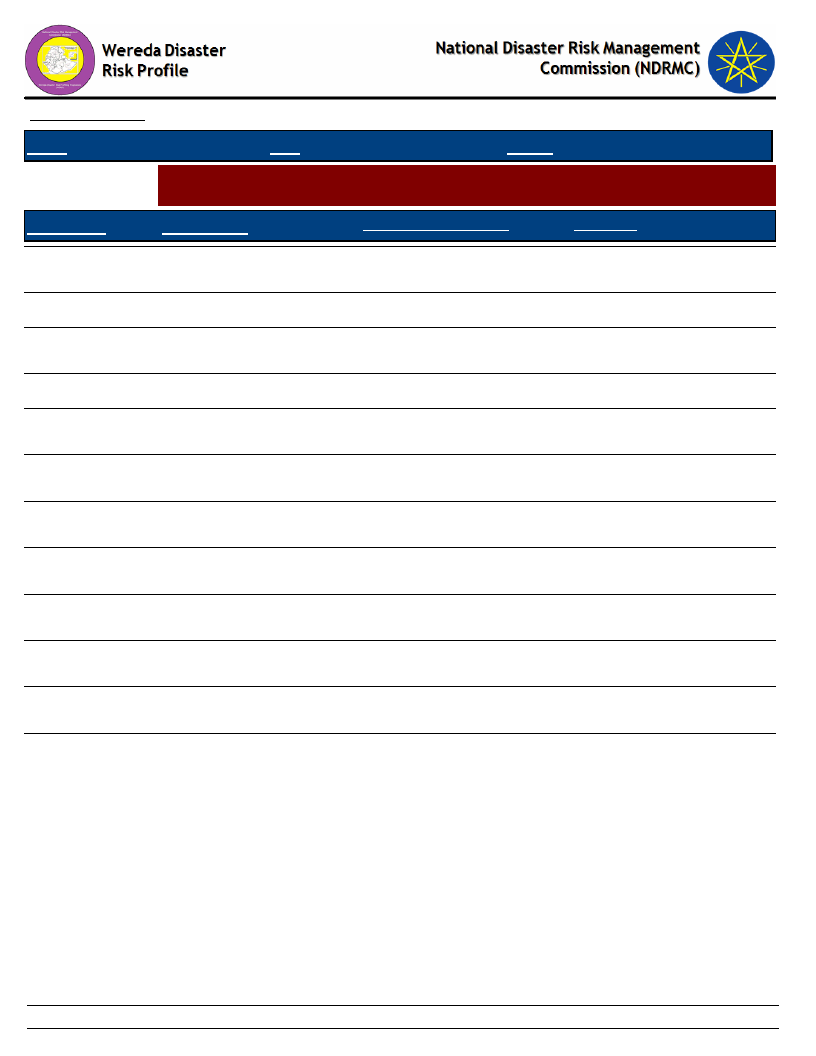
Data_Collected_Date
Wednesday, July 10, 2019
Region S.N.N.P
Zone GURAGE
Wereda MESKAN
Selected Indictor:
Kebele Name
Agricultural Situation: Soil Fertility - Perception of the community on soil fertility
and its change over time
Current_Level
Change_In_Last_Decade
Comments
MIKAELO
MIRAB IMBOR
Good
Medium
Increased
Decreased
Because of farmers use
highly chemical fertilizer
Soil erosion
MIRAB MESKAN
OCHAGENEME
Medium
Good
Decreased
Increased
Soil erosion, repetition of
crops
SEMEN
SHORSHORA
SHERSHERA
MACHMENA
WEJABATI
WITA
WOLENSHO
ANDENYA
YETABON
YIMERWACHO
2NYA
YIMERWACHO
3NYA
Very low
Very low
Good
Good
Increased
Medium
Medium
Increased
Decreased
Decreasing
Increased
Increased
Increased
Decreased
Decreasing
Increased
Soil erosion
Due to increasing
population, erosion
Good use of agricultural
input
Construction of soil
conservation activities
Due to uses of fertilizer
Soil erosion, problem of
rotation
Due to population density
Available agricultural
inputs
178
Page 2 of 2
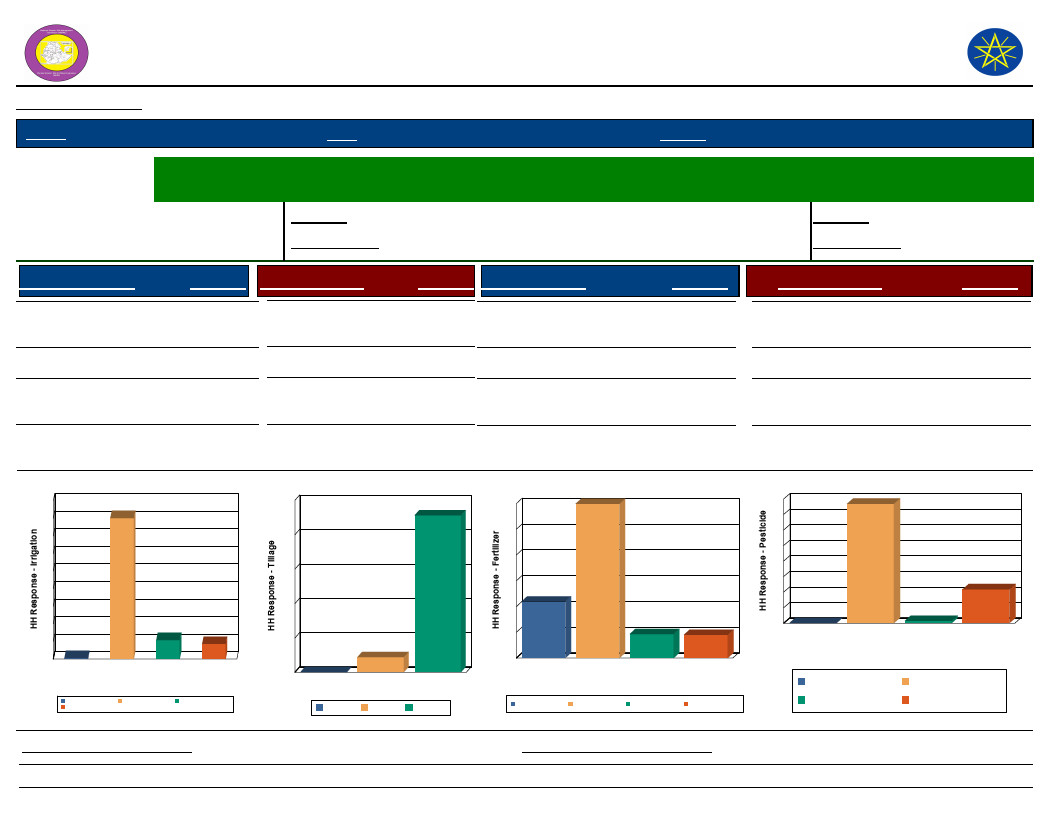
Wereda Disaster
Risk Profile
Data_Collected_Date
Region S.N.N.P
Zone GURAGE
National Disaster Risk Management
Commission (NDRMC)
Wednesday, July 10, 2019
Wereda MESKAN
Selected Indictor:
Economic Vulnerability: Status of Agriculture - Methods of tillage, Irrigation and other agricultural input utilization
by households
Percentage of
Last Year
0.00
Irrigated Area
Five Years Ago
0.00
Percentage of households
Last Year
0.66
with irrigated area
Five Years Ago
0.00
Source of Irrigation
Response Method of Tillage
Response Type of Fertilizer
Response
Type of Pesticide
Response
River/Lake/Pond
8.54 Oxen
91.23 Chemical
59.83
Birkas (tanks)
0.55 Manual
8.77
Other (specify)
10.74
0.00
No Irrigation
(Rain-fed)
80.17
Source of Irrigation
90
80
80
70
60
50
40
30
20
10
11
9
1
0
Birkas (tanks)
Other (specify)
No Irrigation (Rain-fed)
River/Lake/Pond
Source of Irrigation
Birkas (tanks)
River/Lake/Pond
No Irrigation (Rain-fed)
Other (specify)
0.00
Method of Tillage
100
91
80
60
40
20
9
0
0
Manual
Oxen
Method of Tillage
Manual Oxen
Natural/Animal manure
Both Chemical and
Natural
None
9.27
21.91
8.99
Type of Fertilizer
60
60
50
40
30
22
20
10
9
9
0
Both
Chemical and
Natural
Chemical Natural/Animal
manure
Type of Fertilizer
Both Chemical and
Natural
Chemical
Natural/Animal manure
None
None
Chemicals (insecticides,
fungicide, etc)
Natural methods
None
76.79
1.43
21.78
0.00
Type of Pesticide
80
77
70
60
50
40
30
22
20
10
0
0
1
Chemicals
(insecticides,
fungicide, etc)
Natural
methods
Type of Pesticide
None
Natural methods
Chemicals (insecticides,
fungicide, etc)
None
Proportion_Improved_Seeds
89.01
Proportion_Agriculture_Service
179
95.73
Page 1 of 1
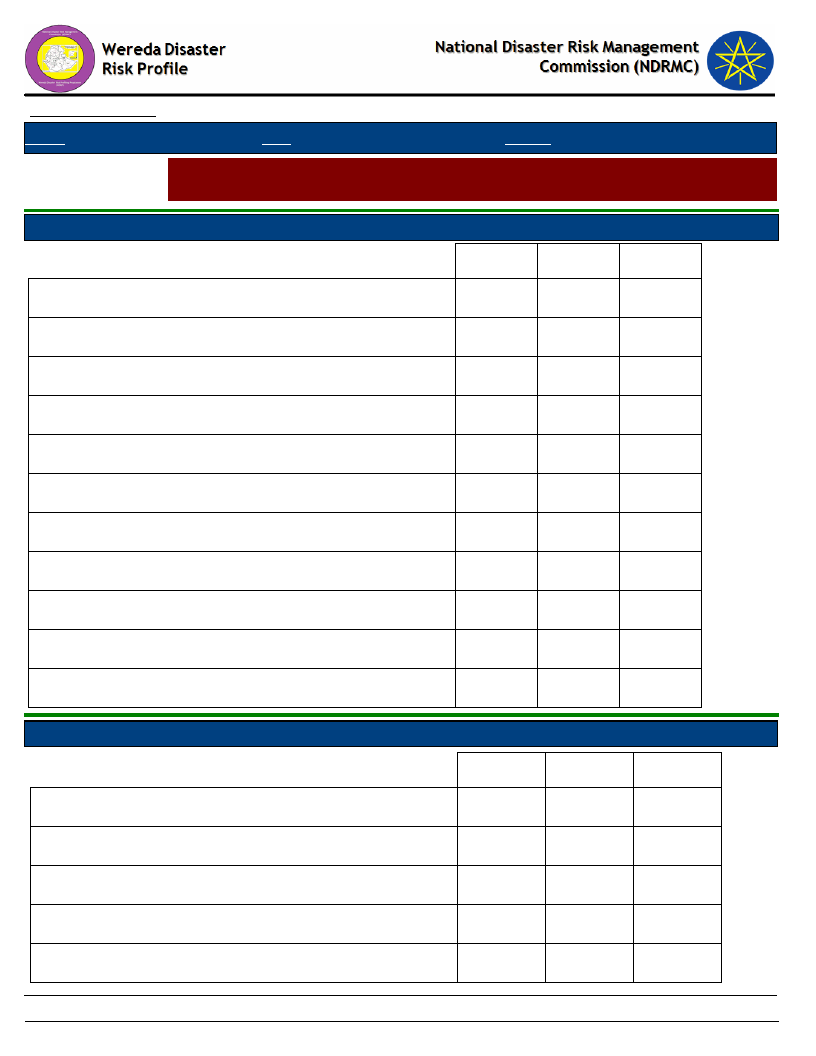
Data_Collected_Date
Region S.N.N.P
Zone GURAGE
Wereda MESKAN
Wednesday, July 10, 2019
Selected Indictor:
Economic Vulnerability: Change in Agricultural Situation - Households perception
on changes of crop type, size of cultivated area and crop yields
Proportion of households reporting change in crops grown
Adequate fertilizer
28.69
%
1st
2nd
3rd
14.29
34.15
Adequate irrigation available
5.71
1.69
Adequate rainfall
12.38
4.88
13.56
Insufficient fertilizer
4.76
6.10
Insufficient irrigation available
0.95
2.44
5.08
Less rainfall
9.52
8.54
3.39
More drought resistant crop
9.52
6.10
More Market Availability
2.86
More pest resistant crop
7.62
20.73
More yielding crop
18.10
17.07
Other
14.29
Proportion of households reporting change in size of area cultivated
12.57 %
Addition of area
1st
2nd
13.04
3rd
7.69
Adequate fertilizer
6.52
38.89
46.15
Adequate irrigation available
10.87
Adequate rainfall
6.52
16.67
Insufficient fertilizer
2.17
5.56
180
Page 1 of 2
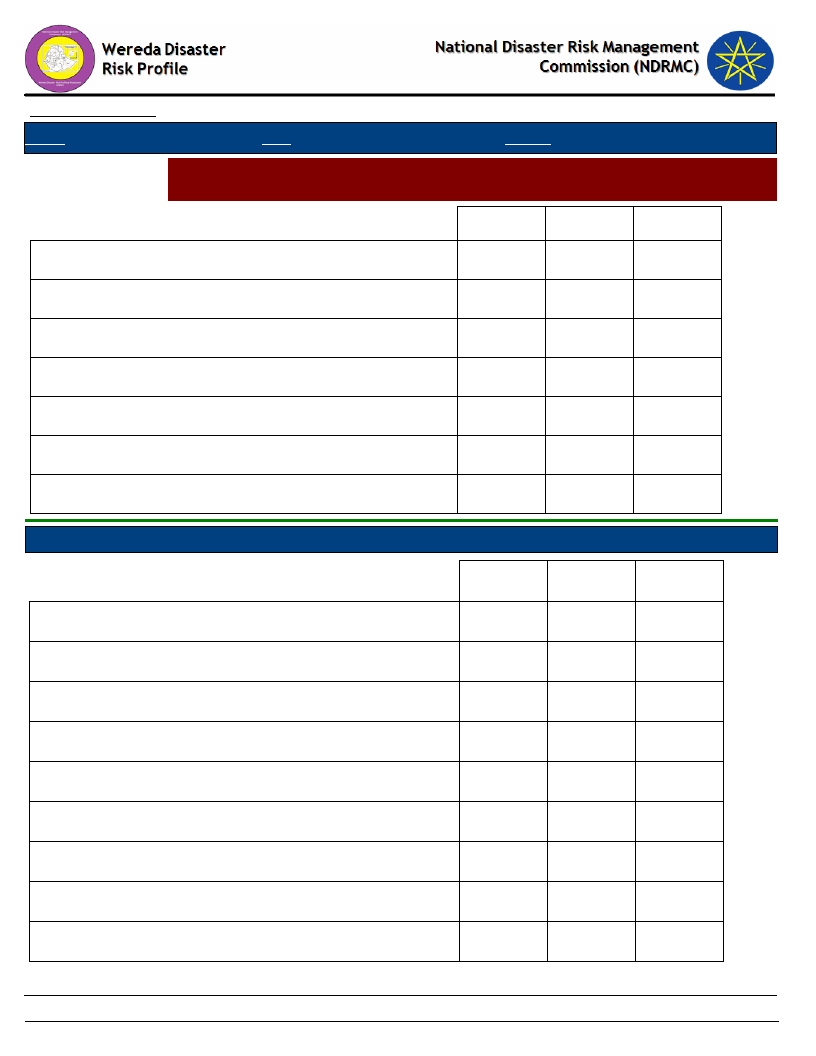
Data_Collected_Date
Region S.N.N.P
Zone GURAGE
Wereda MESKAN
Wednesday, July 10, 2019
Selected Indictor:
Economic Vulnerability: Change in Agricultural Situation - Households perception
on changes of crop type, size of cultivated area and crop yields
1st
2nd
3rd
Insufficient irrigation available
2.17
7.69
Insufficient rainfall
2.17
5.56
7.69
Loss of area
15.22
7.69
More yielding crop
8.70
27.78
23.08
Other
28.26
Salinity problem
5.56
Water logging
4.35
Proportion of households reporting change in crop yield
Adequate fertilizer
Adequate irrigation available
Adequate rainfall
Better yielding crop
Improved variety of seeds
Insufficient fertilizer
Insufficient irrigation available
Insufficient rainfall
Other
69.86
%
1st
2nd
3rd
17.25
28.18
17.59
1.18
0.93
21.96
12.15
16.67
9.41
17.68
22.22
6.27
11.05
29.63
8.63
11.60
4.63
1.66
5.56
20.39
8.84
14.90
8.84
181
Page 2 of 2
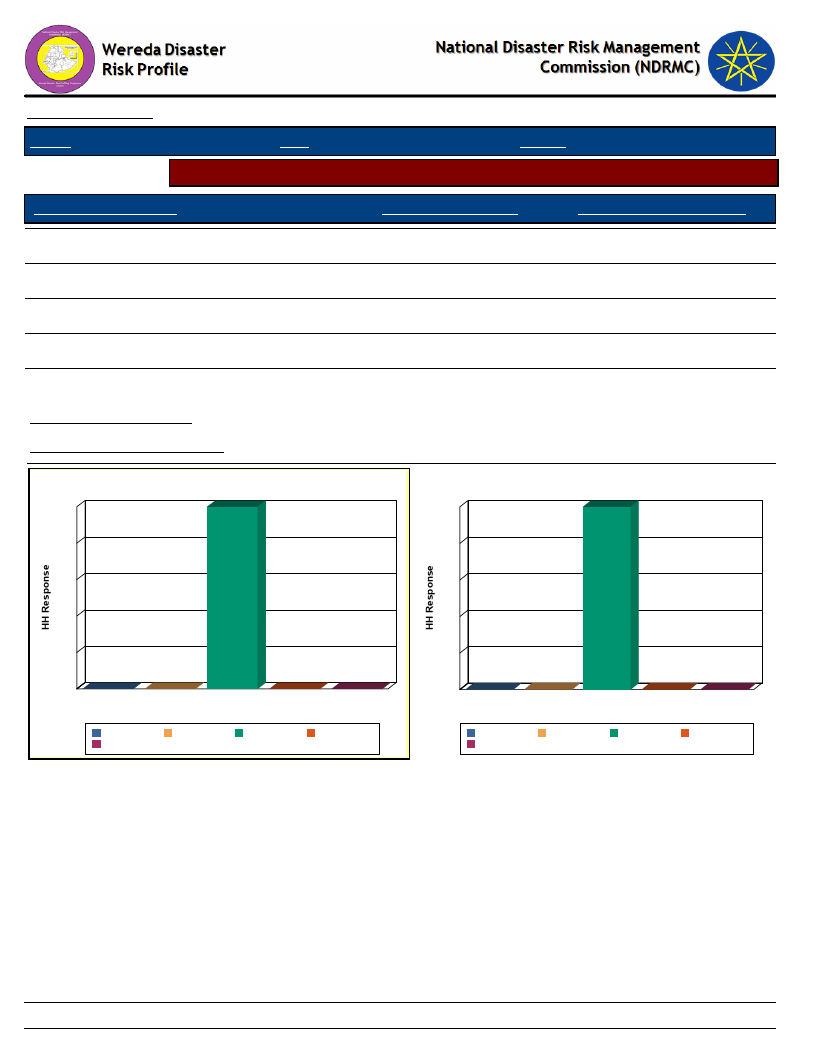
Data_Collected_Date
Wednesday, July 10, 2019
Region S.N.N.P
Zone GURAGE
Wereda MESKAN
Selected Indicator
Economic Vulnerability: Crops Grown - Number of crops grown by households
Number of Crops Grown
Crops Grown Last Year
Crops Grown Five Years Ago
One type
100.00
100.00
Two types
0.00
0.00
Three types
0.00
0.00
Four types
0.00
0.00
Five types
0.00
0.00
Avg Crops Grown Last Year
Avg Crops Grown Five Years Ago
1.00
1.00
Number of Crops Grown Last Year
100
100
Number of Crops Grown five years ago
100
100
80
80
60
60
40
40
20
0
0
Five types
0
0
Four types One type Three types
Number of Crops Grown
0
Two types
Five types
Two types
Four types
One type
Three types
20
0
0
Five types
0
0
Four types One type Three types
Number of Crops Grown
0
Two types
Five types
Two types
Four types
One type
Three types
182
Page 1 of 1
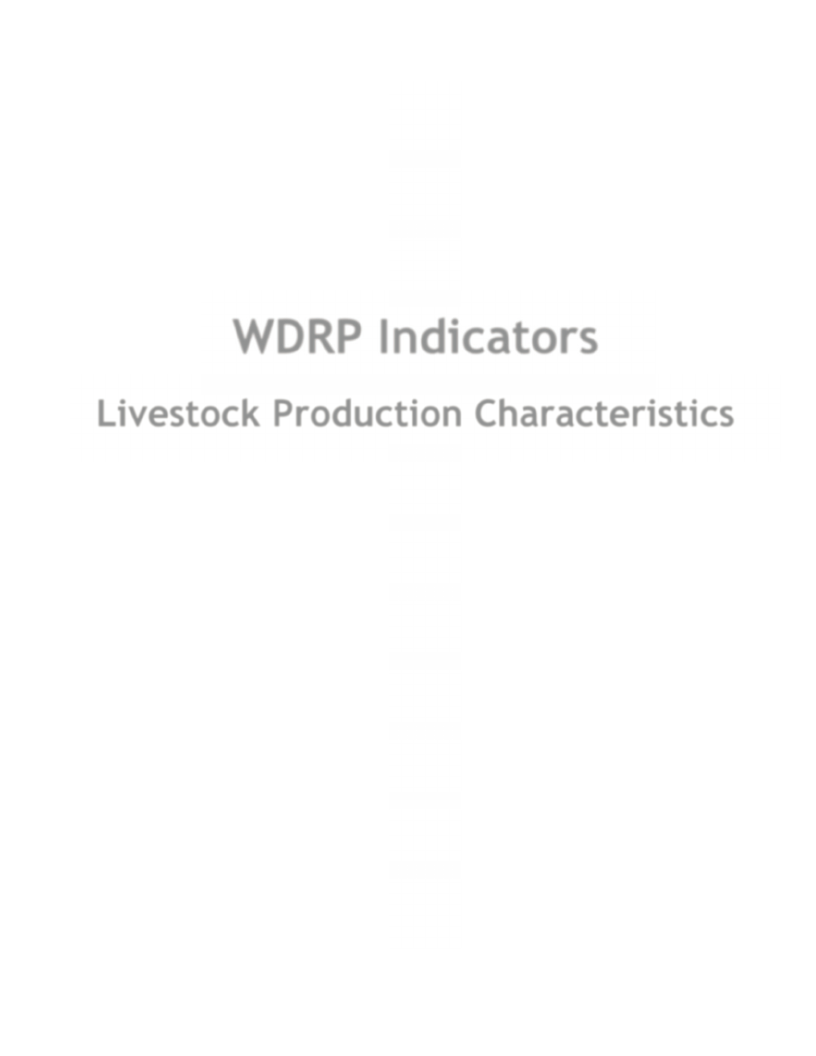
WDRP Indicators
Livestock Production Characteristics
183
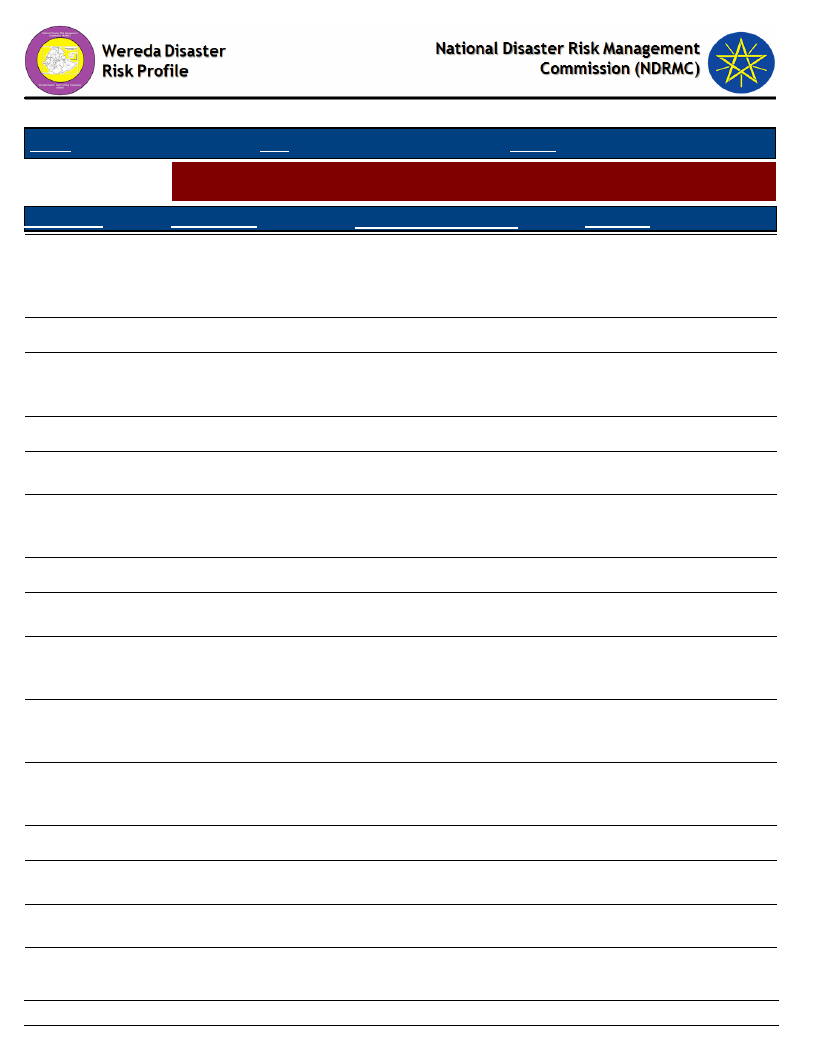
Data_Collected_Date
Wednesday, July 10, 2019
Region S.N.N.P
Zone GURAGE
Wereda MESKAN
Selected Indictor:
Kebele Name
BATI FATO
BATI LEJANO
Agricultural Situation: Status of Livestock Disease - Change in Livestock Disease
Status
Current_Level
Change_Over_Last_Decade
Comment
Lumpy skin disease,
black leg, foot and
mouth disease, new
castle
Lumpy skin disease
Increasing
Increase
Climate change
Poor vaccination
BECHE BULCHANO
BERESA
Lumpy skin disease, foot
and mouth disease, new
castle
Lumpy skin disease
Increased
Increased
Climate change, drought
Less treatment
DEBO TUTO
DEBUB SHERSHERA
DEGAGOGOT
Lumpy skin disease, foot
and mouth disease
Anthrax, lumpy skin
disease, black leg, new
castle
Lumpy skin disease
Increased
Increased
Increased
Less treatment
Poor vaccination activity
Shortage of vaccine
DIDA
DIRAMA
DOBENA
GIDENA ABORAT
GOYBAN
Lumpy skin disease,
anthrax, Newcastle
Lumpy skin disease,
black leg, food and
mouth disease
Lump skin disease,
Black leg, Anthrax, new
castle
Lumpy skin disease, foot
and mouth disease, new
castle disease
Lumpy skin disease
Increased
Increased
Increased
Increased
Decreased
Climate change,
immigration of camel
Climate change,
immigration of camels
Due to climate change,
immigration of camel
Climate change, there is no
skilled man power
ILE
INSENO USME
JOLE ANDENYA
Lumpy skin disease, foot
to mouth disease
Lumpy skin disease
Foot and mouth disease
Increased
Increased
Decrease
Lack of vaccination
Lack of treatment,
vaccination
Availability of vaccination
and treatment
184
Page 1 of 3
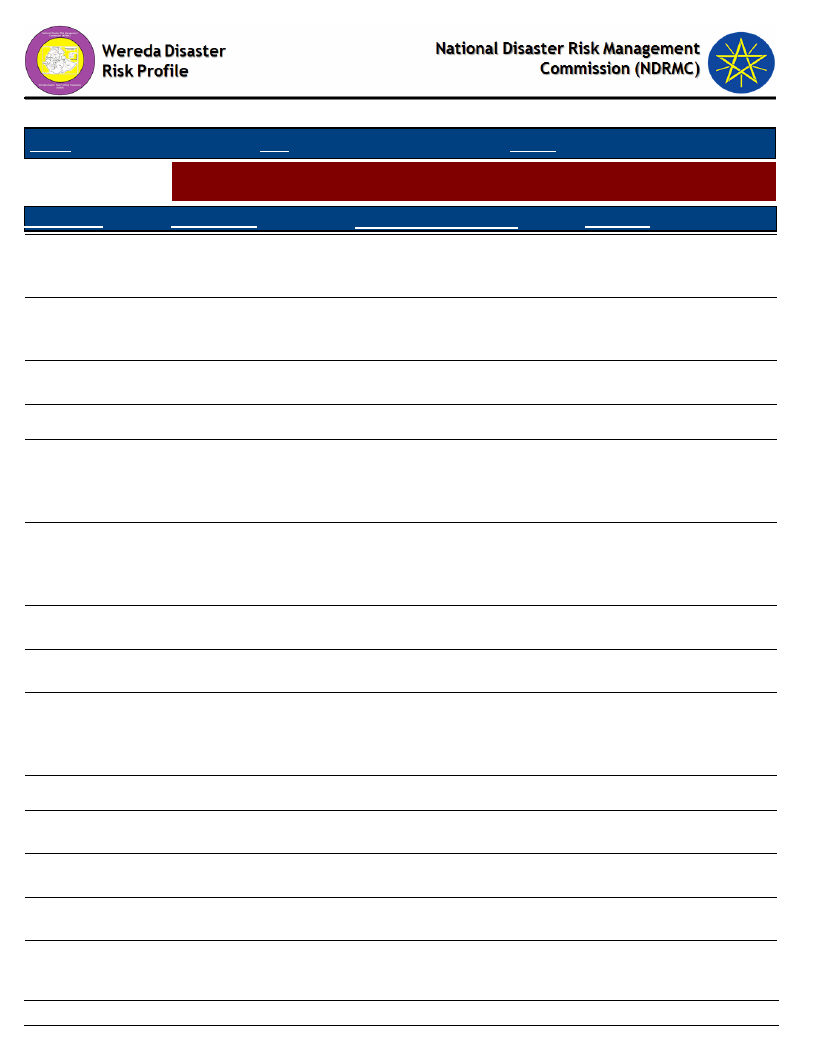
Data_Collected_Date
Wednesday, July 10, 2019
Region S.N.N.P
Zone GURAGE
Wereda MESKAN
Selected Indictor:
Kebele Name
JOLE HULETENYA
MEKICHO
MESERETEWEGERA
MO
MIKAELO
Agricultural Situation: Status of Livestock Disease - Change in Livestock Disease
Status
Current_Level
Change_Over_Last_Decade
Comment
Lumpy skin disease,
Anthrax, black leg,
Newcastle
Lumpy skin disease, foot
and mouth disease, new
castle
Lumpy skin disease
Increased
Increased
Decreased
Climate change,
immigration of camel
Climate change
Good treatment
Lump skin disease
Increase
Shortage of vaccination
MIRAB IMBOR
MIRAB MESKAN
OCHAGENEME
Lumpy skin disease,
black leg, foot and
mouth disease, chicken
disease
Lumpy skin disease,
black leg, foot and
mouse disease, chicken
disease
Lumpy skin disease
SEMEN SHORSHORA
SHERSHERA
MACHMENA
WEJABATI
Lumpy skin disease, foot
and mouth disease
Lumpy skin disease,
black leg, foot and
mouth disease, new
castle
Lumpy skin disease
Increased
Increase
No change
Increased
Increasing
Increased
No livestock health
center/veterinary service
and skilled man power
Due to climate, change and
migration of camel
Transmitted disease, lack
of vaccination
In migration of camel
Due to the problem of
livestock veterinary service
Lack of vaccination
WITA
WOLENSHO
ANDENYA
YETABON
YIMERWACHO
2NYA
Foot and mouth disease,
lumpy skin disease
Lumpy skin disease
Lumpy skin disease,
black leg, new castle
Lumpy skin disease,
sheep and goat disease
Decreased
Increased
Increased
Increasing
Availability of vaccination
Less prevention activities
In migration of camels,
flood and drought
Due to climate change
185
Page 2 of 3
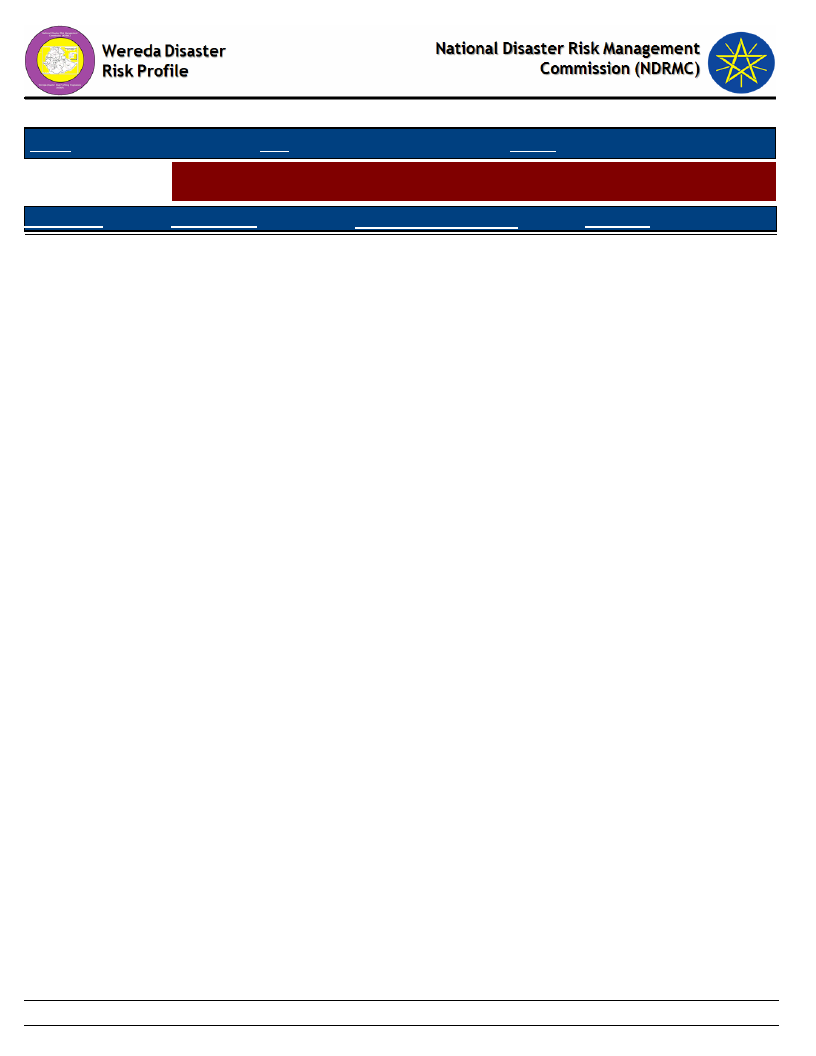
Data_Collected_Date
Wednesday, July 10, 2019
Region S.N.N.P
Zone GURAGE
Wereda MESKAN
Selected Indictor:
Kebele Name
YIMERWACHO
3NYA
Agricultural Situation: Status of Livestock Disease - Change in Livestock Disease
Status
Current_Level
Change_Over_Last_Decade
Comment
Lumpy skin disease, foot
and mouth disease
Increased
Lack of vaccination
186
Page 3 of 3
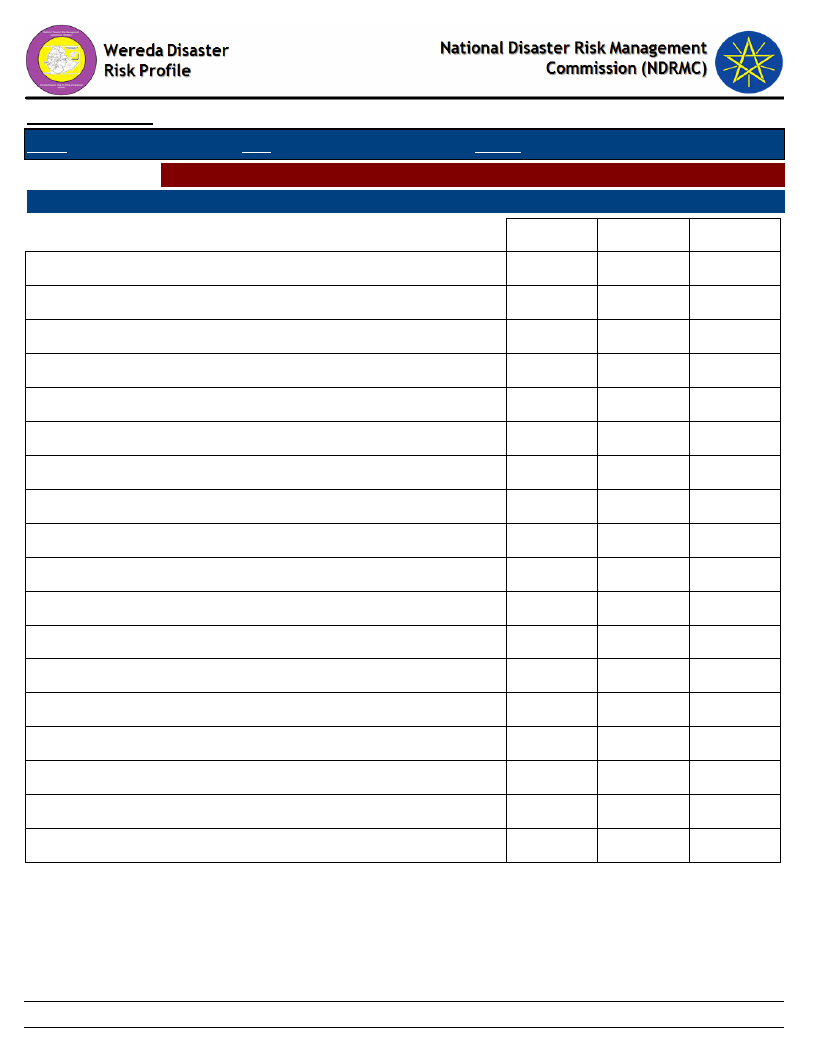
Data_Collected_Date
Wednesday, July 10, 2019
Region S.N.N.P
Zone GURAGE
Wereda MESKAN
Selected Indictor: Livestock Diseases Prevalece
Type of livestock diseases affected households in the last five years (households reporting in %)
1st
2nd
3rd
African horse disease
0.27
0.83
0.94
Anthrax affecting cattle
26.58
24.31
8.75
Black leg
6.58
11.33
9.38
CBPP
1.92
3.31
2.50
Contagious Caprine PLeuropneumonia (CCPP)
0.27
0.62
Faciolosis
0.55
Foot and mouth disease
10.96
22.93
16.88
Internal & External Parasites (Tick, mange, helminthiasis, fasci
0.28
0.62
Liverfluke (Sheep and cattle)
0.55
0.94
Lumpy Skin Disease (LSD)
40.82
14.36
20.62
Newcasle disease (Chicken)
7.95
14.92
22.50
No Disease
0.27
1.56
Pasteurellosis
2.47
3.87
7.50
PPR
0.82
0.83
2.50
Respiratory complex of camels
0.28
0.31
Sheep pox
0.27
0.83
0.62
Tick born diseases
0.55
0.55
3.12
Trypanosomiasis
0.27
0.28
0.62
187
Page 1 of 1
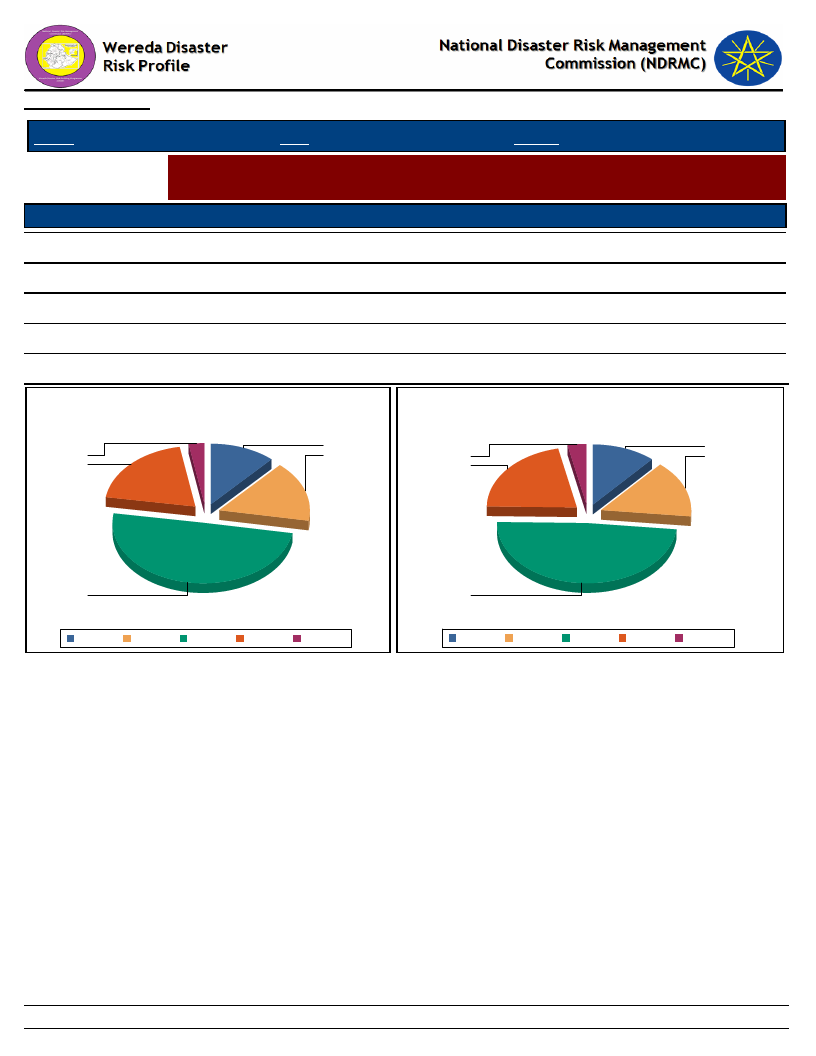
Data_Collected_Date
Wednesday, July 10, 2019
Region S.N.N.P
Selected Indictor:
Level of Access
Excellent
Good
Adequate
Poor
Very poor
Zone GURAGE
Wereda MESKAN
Evaluation of Access to Veternary Services and Livestock Drugs
Households’ evaluation on access to drugs and veterinary services
Veternary Service
Livestock_Drugs
16.12
15.07
49.73
48.77
11.75
11.51
19.67
21.37
2.73
3.29
Level of Access to Veternary Services
Access Level of Livestock Drugs
12
12
3
16
3
15
20
21
50
Adequate Excellent
Good
Poor
Very poor
49
Adequate Excellent
Good
Poor
Very poor
188
Page 1 of 1
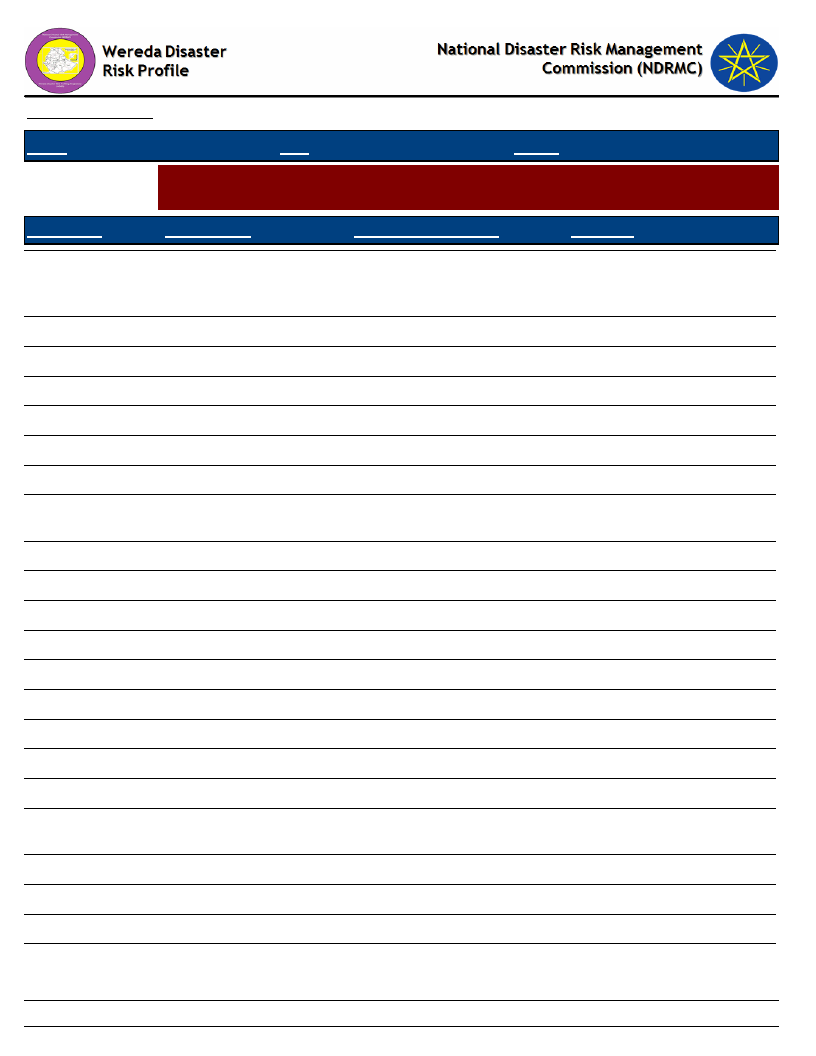
Data_Collected_Date
Wednesday, July 10, 2019
Region S.N.N.P
Selected Indictor:
Zone GURAGE
Wereda MESKAN
Agricultural Situation: Water Availability for Livestock - Water availability for
livestock in the community
KebeleName
Current_Level
Change_In_Last_Decade
Comments
BATI FATO
Increasing
BATI LEJANO
BECHE BULCHANO
BERESA
DEBO TUTO
DEBUB SHERSHERA
DEGAGOGOT
DIDA
Fain
Good
Not good
Not good
Very low
Good
Medium
DIRAMA
DOBENA
GIDENA ABORAT
GOYBAN
ILE
INSENO USME
JOLE ANDENYA
JOLE HULETENYA
MEKICHO
MESERETEWEGERA
MO
MIKAELO
MIRAB IMBOR
MIRAB MESKAN
OCHAGENEME
Decreased
Less
Very low
Decreased
Good
Good
Good
Good
Less
Good
Good
Ground water
good
Good
Increasing
No change
Decreased
Decreased
Decreased
Decreased
No change
Decreased
Decreased
Decreased
Decreased
Increased
No change
No change
No change
Increased
Decreased
No change
No change
Decreased
No change
The presence of soil and
water conservation
activities
Drought
Lack of water
Lack of water
Shortage of source of water
Drought, shortage of rain
fall
Drought
Drought
Climate change
Drought, climate change
Drought
189
Page 1 of 2
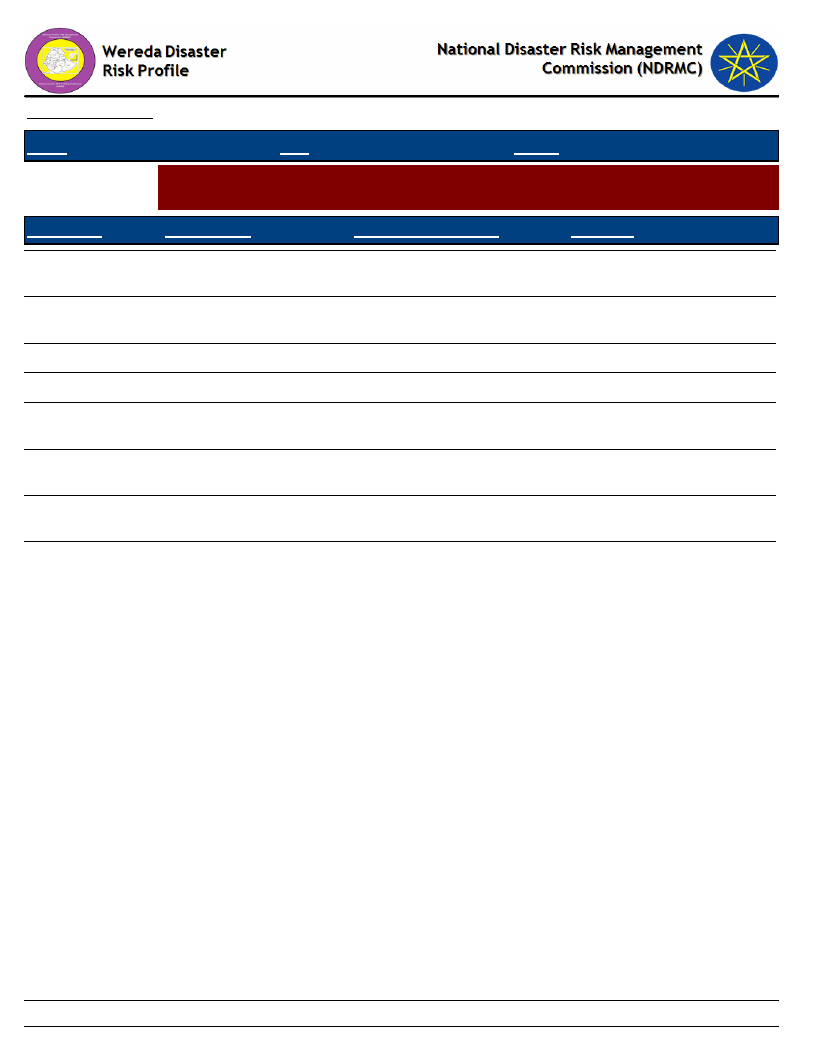
Data_Collected_Date
Wednesday, July 10, 2019
Region S.N.N.P
Selected Indictor:
Zone GURAGE
Wereda MESKAN
Agricultural Situation: Water Availability for Livestock - Water availability for
livestock in the community
KebeleName
Current_Level
Change_In_Last_Decade
Comments
SEMEN
SHORSHORA
SHERSHERA
MACHMENA
WEJABATI
WITA
WOLENSHO
ANDENYA
YETABON
YIMERWACHO
2NYA
YIMERWACHO
3NYA
Very low
No water access
Good
Good
Decreased
Decreased
Medium
Increased
Decreased
No change
No change
No change
No change
Decreased
Decreasing
No change
No water access
There is mo water access
Shortage of water in the
area
Drought, shortage of rain
fall
Due to climate change
Available stream and bore
hole
190
Page 2 of 2
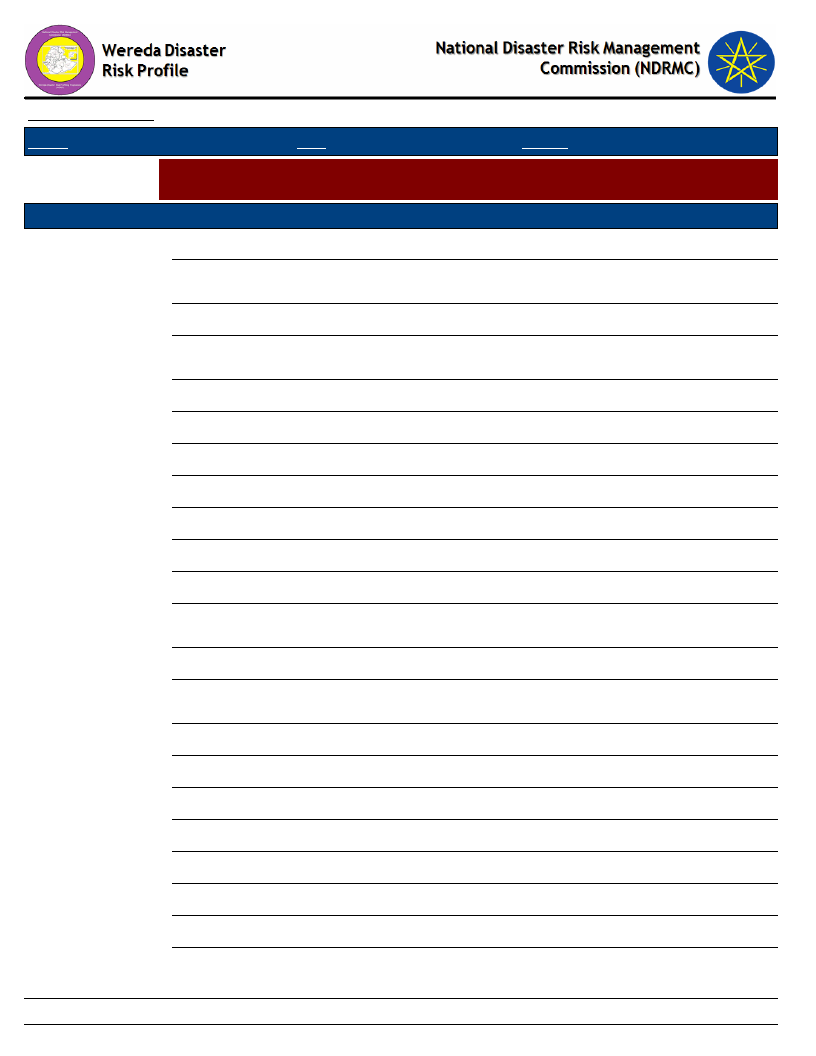
Data_Collected_Date
Wednesday, July 10, 2019
Region S.N.N.P
Zone GURAGE
Wereda MESKAN
Selected Indictor:
Agricultural Situation: Livestock Diversity - Type of livestock and their economic
importance in the community
Kebele Name
BATI FATO
Type of Livestock
Oxe and Cow
Sheep
Avg_Number
2
1
Economic_Importance_Rank
For ploughing, milk and meat
production, source of income
For meat production, source of income
Poultry
Camels: Female
5
For egg and meat production, source of
income
0
Camels: Female
0
BATI LEJANO
Camels: Female
0
Donkeys
1
Loan good and agricultural production
Goats
1
Source of income
Sheep
3
Source of income
Cattle
3
For consumption
BECHE BULCHANO
Oxe and Cow
Sheep
2
For ploughing, milk and meat
production, source of income
1
For meat production, source of income
Poultry
Camels: Female
2
For egg and meat production, source of
income
0
Camels: Female
0
BERESA
Camels: Female
0
Camels: Female
0
Donkeys
1
For transportation
Sheep
3
Market sell
Cattle
2
Consumption
DEBO TUTO
Cattle
4
For ploughing, meat and milk
production
191
Page 1 of 7
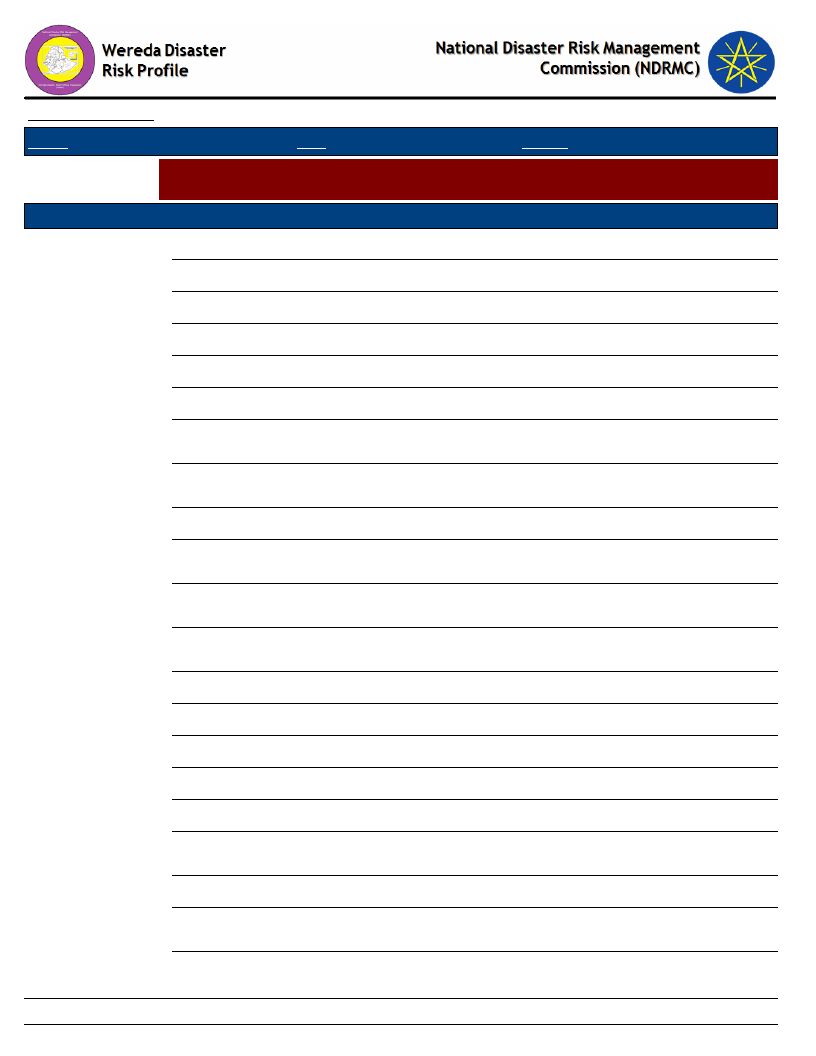
Data_Collected_Date
Wednesday, July 10, 2019
Region S.N.N.P
Zone GURAGE
Wereda MESKAN
Selected Indictor:
Agricultural Situation: Livestock Diversity - Type of livestock and their economic
importance in the community
Kebele Name
DEBO TUTO
Type of Livestock
Sheep
Avg_Number
3
Economic_Importance_Rank
Source of income
Goats
3
Source of income
Donkeys
1
For transportation
Camels: Female
0
DEBUB SHERSHERA
Camels: Female
0
Goats
Sheep
Donkeys
1
For meat production and source of
income
1
For meat production and source of
income
1
For transportation
DEGAGOGOT
Oxe and Cow
Cattle
Poultry
Bee keeping
2
For ploughing, milk and meat
production, source of income
2
For ploughing, milk and meat
production, source of income
5
For egg and meat production, source of
income
0
Honey production
Camels: Female
0
Camels: Female
0
DIDA
Camels: Female
0
Camels: Female
0
Poultry
Sheep
3
For egg and meat production, source of
income
1
For meat production, source of income
DIRAMA
Oxe and Cow
Oxe and Cow
2
For ploughing, milk and meat
production, source of income
3
For ploughing, milk and meat, source of
income
192
Page 2 of 7
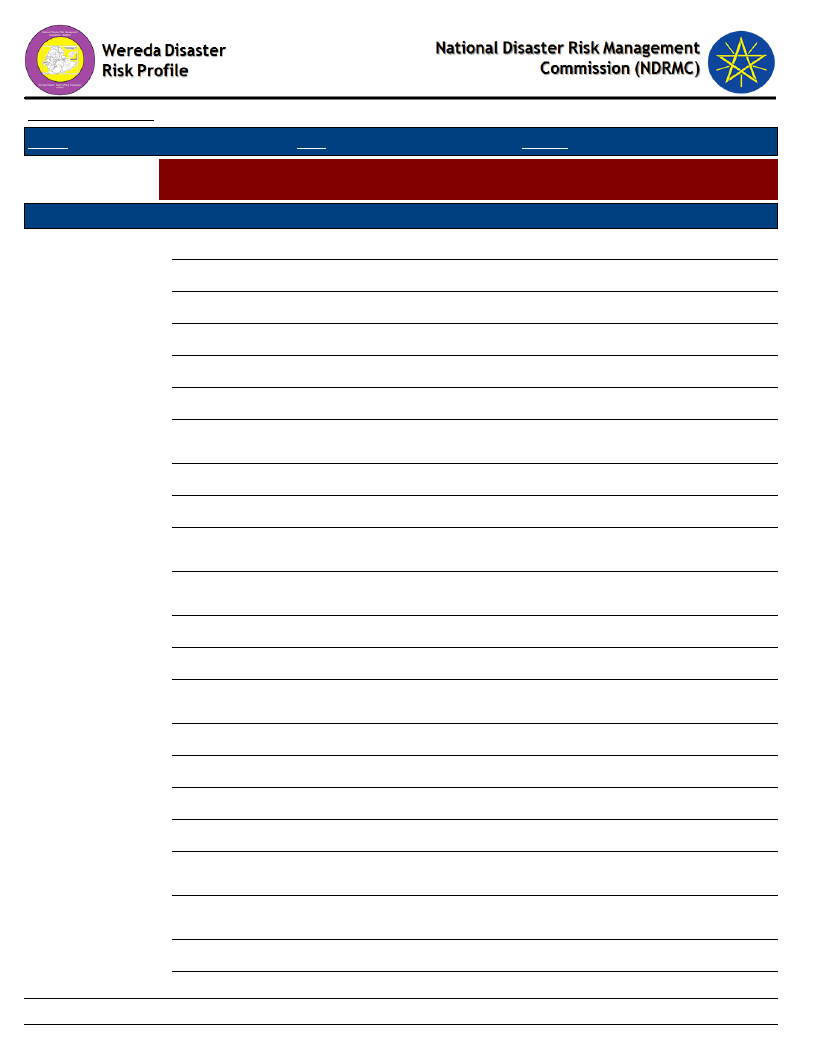
Data_Collected_Date
Wednesday, July 10, 2019
Region S.N.N.P
Zone GURAGE
Wereda MESKAN
Selected Indictor:
Agricultural Situation: Livestock Diversity - Type of livestock and their economic
importance in the community
Kebele Name
DIRAMA
Type of Livestock
Sheep
Avg_Number
2
Economic_Importance_Rank
For meat production, source of income
Goats
3
For meat production, source of income
Donkeys
1
For transportation
Camels: Female
0
DOBENA
Camels: Female
0
Poultry
Goats
3
For egg and meat production, source of
income
1
For meat production, source of income
Sheep
1
For meat production, source of income
GIDENA ABORAT
Oxe and Cow
Oxe and Cow
Sheep
2
For plouching, milk and meat
production, source of income
3
For ploughing, milk and meat
production, source of income
2
For meat production, source of income
Donkeys
1
For transportation
Poultry
Camels: Female
5
For egg and meat production, source of
income
0
GOYBAN
Camels: Female
0
Camels: Female
0
Goat and Sheep
2
Source of income
Poultry
Cattle
ILE
Cattle
3
For egg and meat production, source of
income
1
For ploughing, meat and milk
production, source of income
3
For consumption
Goats
4
Source of income
193
Page 3 of 7
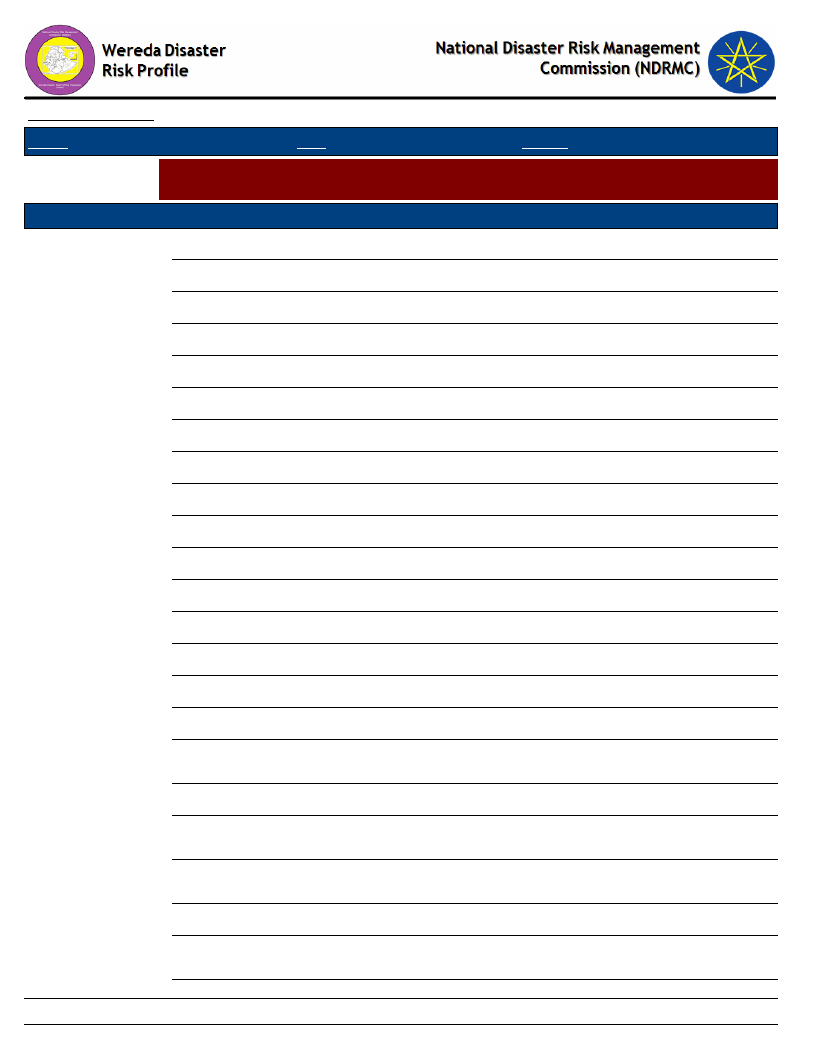
Data_Collected_Date
Wednesday, July 10, 2019
Region S.N.N.P
Zone GURAGE
Wereda MESKAN
Selected Indictor:
Agricultural Situation: Livestock Diversity - Type of livestock and their economic
importance in the community
Kebele Name
ILE
Type of Livestock
Sheep
Avg_Number
3
Economic_Importance_Rank
Source of income
Donkeys
1
For transportation
Camels: Female
0
INSENO USME
Camels: Female
0
Camels: Female
0
Goats
3
Source of income
Sheep
3
Source of income
Cattle
2
For consumption
JOLE ANDENYA
Cattle
4
For consumption
Sheep
3
Source of income
Goats
3
Source of income
Donkeys
1
Family activity
Camels: Female
0
JOLE HULETENYA
Camels: Female
0
Camels: Female
0
Poultry
Sheep
3
For egg and meat production, source of
income
1
For meat production, source of income
MEKICHO
Oxe and Cow
Oxe and Cow
Sheep
2
For ploughing, milk and meat
production, source of income
2
For ploughing, milk and meat
production, source of income
2
For meat production, source of income
Poultry
Camels: Female
4
For egg and meat production, source of
income
0
194
Page 4 of 7
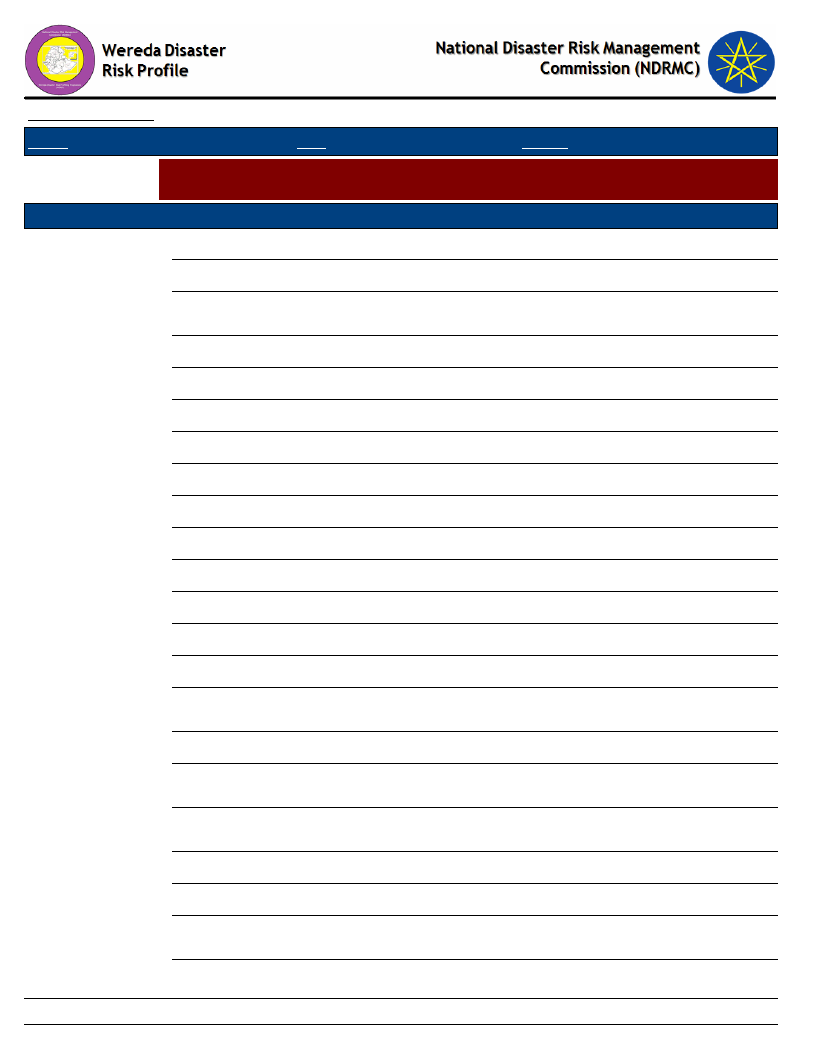
Data_Collected_Date
Wednesday, July 10, 2019
Region S.N.N.P
Zone GURAGE
Wereda MESKAN
Selected Indictor:
Agricultural Situation: Livestock Diversity - Type of livestock and their economic
importance in the community
Kebele Name
MEKICHO
Type of Livestock
Camels: Female
Avg_Number Economic_Importance_Rank
0
MESERETEWEGERAM
O
Camels: Female
Donkeys
0
1
For transportation
Goats
4
Source of income
Sheep
5
Source of income
Cattle
5
Consumption
MIKAELO
Cattle
5
For consumption and farm activity
Sheep
3
Source of income
Goats
3
Source of income
Donkeys
1
For transportation
Camels: Female
0
MIRAB IMBOR
Camels: Female
0
Camels: Female
0
Poultry
Donkeys
3
For meat and egg production, source of
income
1
For transportation
MIRAB MESKAN
Oxe and Cow
Oxe and Cow
Donkeys
2
For ploughing, meat and milk
production, source of income
4
For ploughing, milk and meat
production, source of income
1
For transportation
Sheep
1
For meat production
Poultry
Camels: Female
2
For egg and meat production, source of
income
0
195
Page 5 of 7
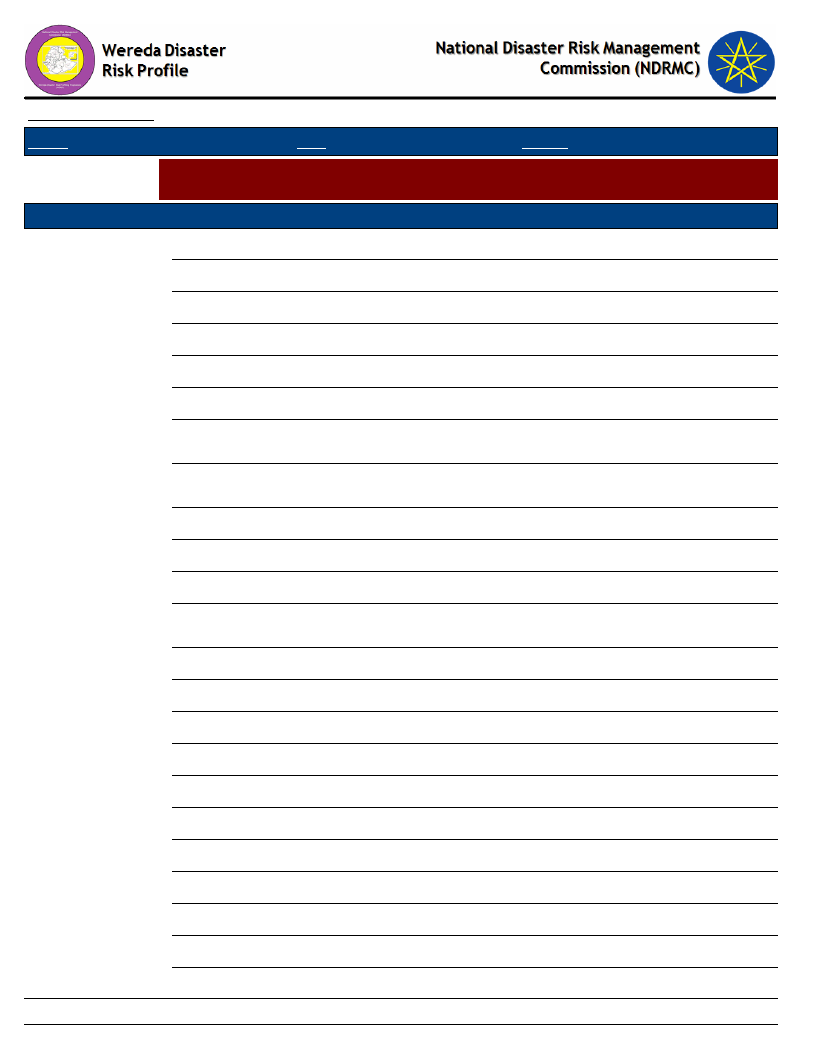
Data_Collected_Date
Wednesday, July 10, 2019
Region S.N.N.P
Zone GURAGE
Wereda MESKAN
Selected Indictor:
Agricultural Situation: Livestock Diversity - Type of livestock and their economic
importance in the community
Kebele Name
OCHAGENEME
Type of Livestock
Camels: Female
Avg_Number Economic_Importance_Rank
0
Donkeys
1
For transportation
Goats
2
Source of income
Sheep
3
Source of income
Cattle
2
For consumption
SEMEN SHORSHORA
Cattle
Poultry
Donkeys
2
For plouging, milk and meat production,
source of income
5
For meat and egg production, source of
income
1
For transportation
Camels: Female
0
Camels: Female
0
SHERSHERA
MACHMENA
Donkeys
Goats
1
For transportation
5
For meat, source of income
Sheep
1
For meat, source of income
Cattle: Mature Male
2
For ploughing, source of income
Cattle: Mature Female
2
For milk production, source of income
WEJABATI
Cattle
2
For consumption
Sheep
3
Source of income
Donkeys
1
For transport
Camels: Female
0
Camels: Female
0
WITA
Camels: Female
0
Camels: Female
0
196
Page 6 of 7
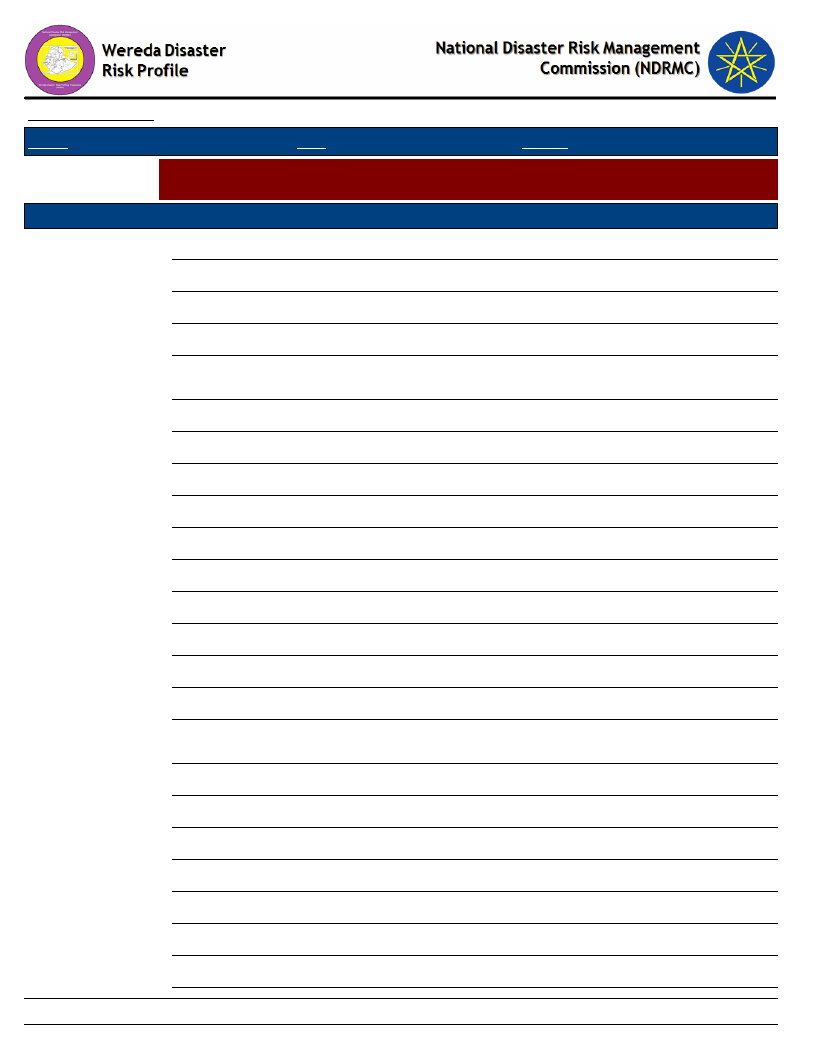
Data_Collected_Date
Wednesday, July 10, 2019
Region S.N.N.P
Zone GURAGE
Wereda MESKAN
Selected Indictor:
Agricultural Situation: Livestock Diversity - Type of livestock and their economic
importance in the community
Kebele Name
WITA
Type of Livestock
Goats
Avg_Number
3
Economic_Importance_Rank
Source of market
Sheep
3
Source of market
Cattle
2
For consumption
WOLENSHO
ANDENYA
Cattle
Sheep
4
For consumption, farm activities and
source of income
3
Source of income
Goats
2
Source of income
Donkeys
1
For transportation
Camels: Female
0
YETABON
Camels: Female
0
Bee keeping
3
Sheep
2
Cattle: Mature Male
1
Cattle: Mature Female
1
YIMERWACHO 2NYA
Cattle: Mature Female
2
For milk and source of income
Cattle: Mature Male
Sheep
2
For ploughing, meat production, source
of income
4
For meat production, source of income
Goats
1
For meat production, source of income
Poultry
6
Source of income
YIMERWACHO 3NYA
Camels: Female
0
Camels: Female
0
Sheep
3
Source of income
Goats
4
Source of income
Cattle
5
For consumption
197
Page 7 of 7
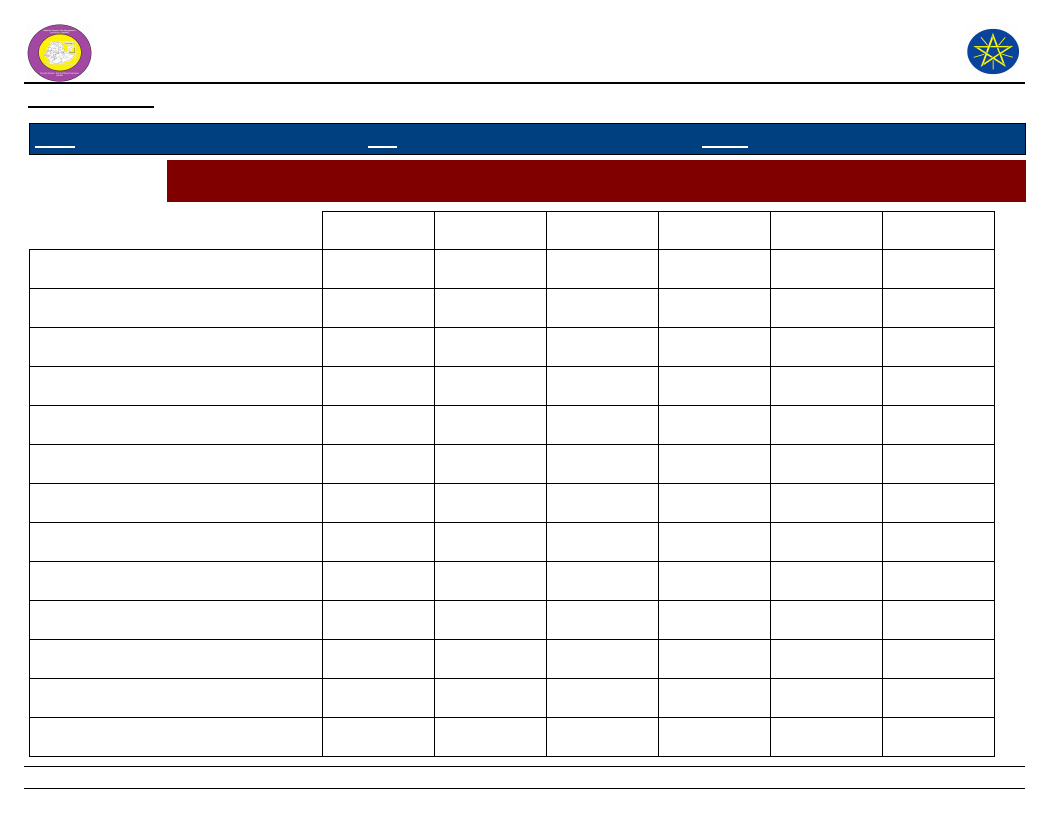
Wereda Disaster
Risk Profile
Data_Collected_Date
National Disaster Risk Management
Commission (NDRMC)
Wednesday, July 10, 2019
Region S.N.N.P
Zone GURAGE
Wereda MESKAN
Selected Indictor:
Economic Vulnerability: Livestock Ownership and Changes - Percentage of households by number and type of
livestock owned
Bee keeping
A - None
90.46
B - 1 to 5
2.45
C - 6 to 10
2.45
D - 11 to 50
1.36
E - 51 to 100
1.09
F - More
than 100
0.82
Camels: Female
99.73
0.27
Camels: Male
99.73
0.27
Camels: Young Female
99.73
0.27
Camels: Young Male
99.46
0.54
Cattle: Female
74.93
21.53
3.27
0.27
Cattle: Male bulls
80.11
16.08
3.00
0.54
Cattle: Mature Female
39.78
42.23
13.62
2.18
1.36
0.27
Cattle: Mature Male
46.59
34.33
17.17
0.82
0.54
0.27
Cattle: under 1 year
55.31
35.15
7.90
1.63
Donkeys
62.94
33.24
2.72
0.54
Goats
84.47
4.36
5.18
2.45
2.45
0.27
Horses
95.10
4.36
0.54
198
Page 1 of 2
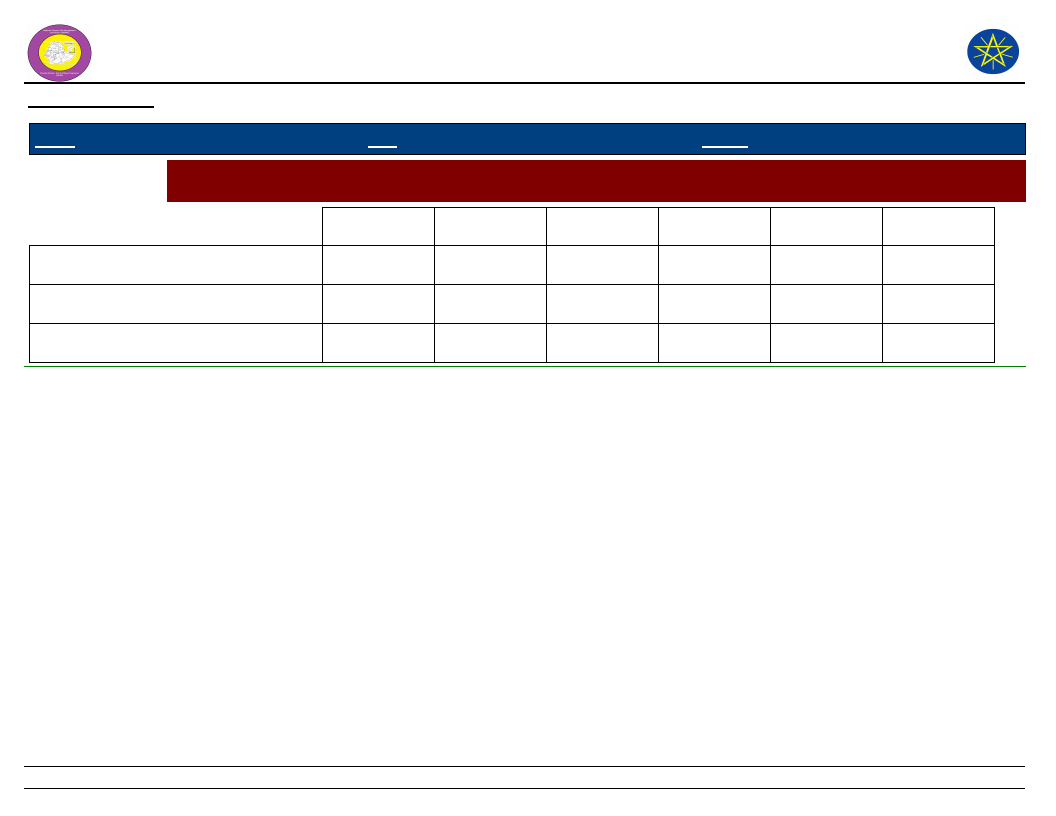
Wereda Disaster
Risk Profile
Data_Collected_Date
National Disaster Risk Management
Commission (NDRMC)
Wednesday, July 10, 2019
Region S.N.N.P
Zone GURAGE
Wereda MESKAN
Selected Indictor:
Economic Vulnerability: Livestock Ownership and Changes - Percentage of households by number and type of
livestock owned
A - None
B - 1 to 5
C - 6 to 10
D - 11 to 50
E - 51 to 100
Mules
99.73
F - More
than 100
Poultry
35.69
8.45
13.08
14.17
7.08
7.63
Sheep
60.22
12.53
9.81
8.17
4.63
2.45
199
Page 2 of 2
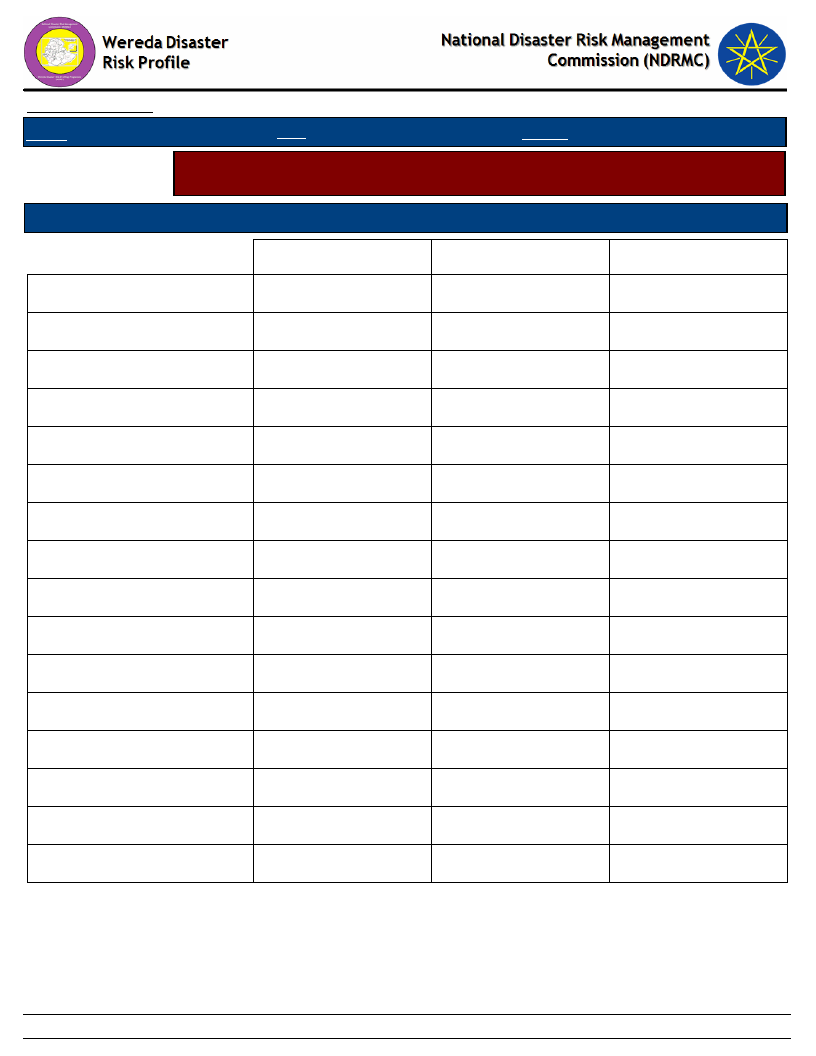
Data_Collected_Date
Region S.N.N.P
Zone GURAGE
Wednesday, July 10, 2019
Wereda MESKAN
Selected Indicator
Economic Vulnerability: Livestock Ownership and Changes - Households
perception on changes in livestock number in the last five years (response in %)
Type of Livestock Owned
Changes Observed By Households
Bee keeping
A - Decreased
40.54
B - Remained the Same
37.84
C - Increased
21.62
Camels: Female
100.00
Camels: Male
100.00
Camels: Young Female
100.00
Camels: Young Male
80.00
20.00
Cattle: Female
48.45
23.71
27.84
Cattle: Male bulls
48.61
27.78
23.61
Cattle: Mature Female
60.81
24.77
14.41
Cattle: Mature Male
54.36
33.33
12.31
Cattle: under 1 year
50.00
25.00
25.00
Donkeys
28.89
61.48
9.63
Goats
65.00
10.00
25.00
Horses
36.84
63.16
Mules
100.00
Poultry
65.80
13.85
20.35
Sheep
57.82
17.69
24.49
200
Page 1 of 3
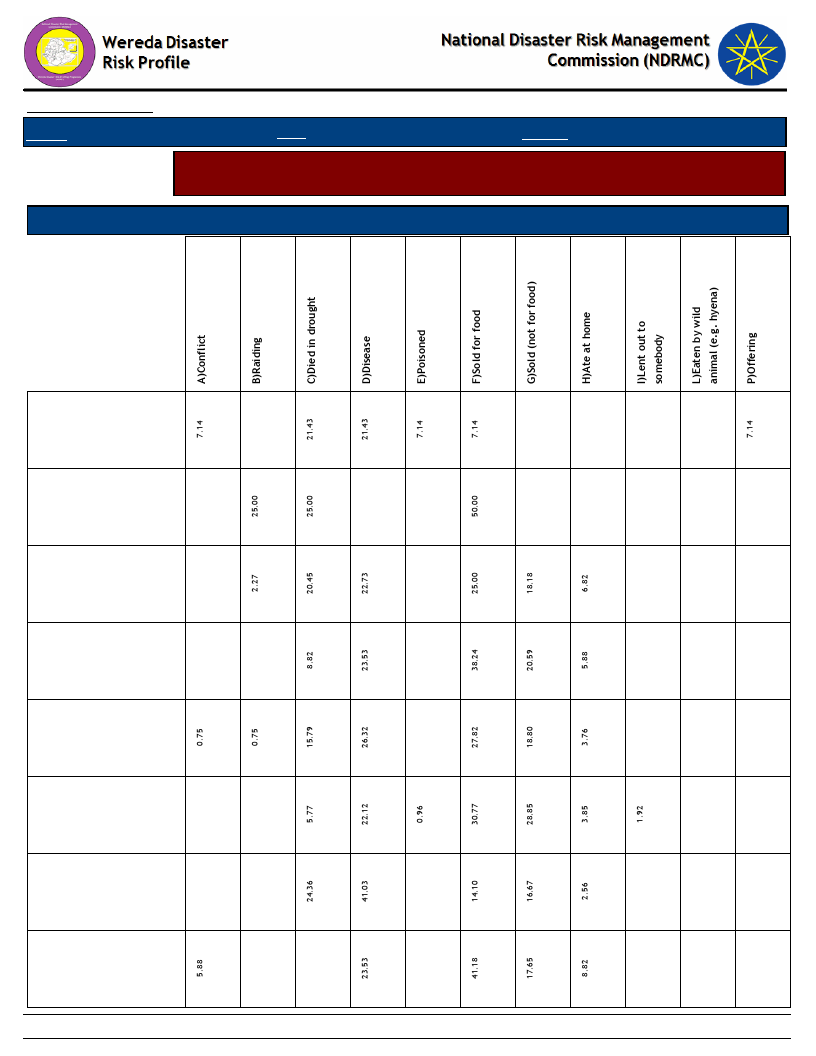
Data_Collected_Date
Region S.N.N.P
Zone GURAGE
Wednesday, July 10, 2019
Wereda MESKAN
Selected Indicator
Economic Vulnerability: Livestock Ownership and Changes - Households
perception on changes in livestock number in the last five years (response in %)
Type of Livestock Owned
Reason for Decrease in Livestock Number
Bee keeping
Camels: Young
Male
Cattle: Female
Cattle: Male bulls
Cattle: Mature
Female
Cattle: Mature
Male
Cattle: under 1
year
Donkeys
201
Page 2 of 3
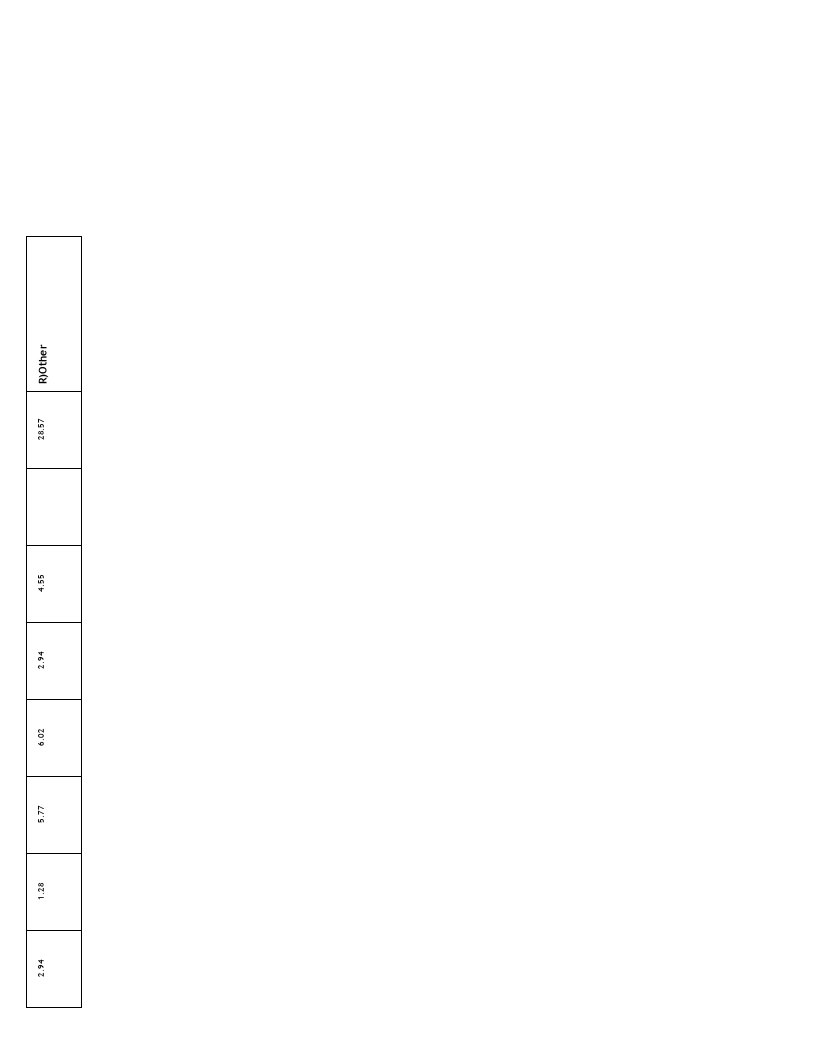
202
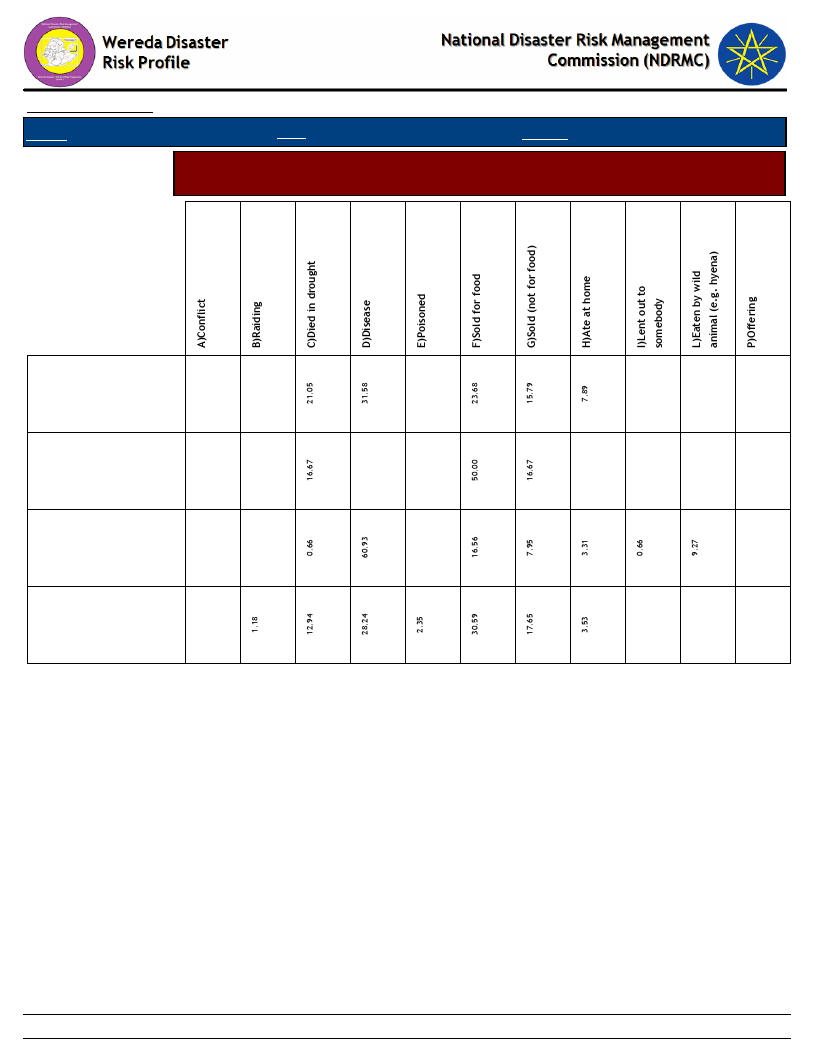
203
Page 3 of 3
Goats
Horses
Poultry
Sheep
Economic Vulnerability: Livestock Ownership and Changes - Households
perception on changes in livestock number in the last five years (response in %)
Selected Indicator
Wednesday, July 10, 2019
Wereda MESKAN
Zone GURAGE
Data_Collected_Date
Region S.N.N.P
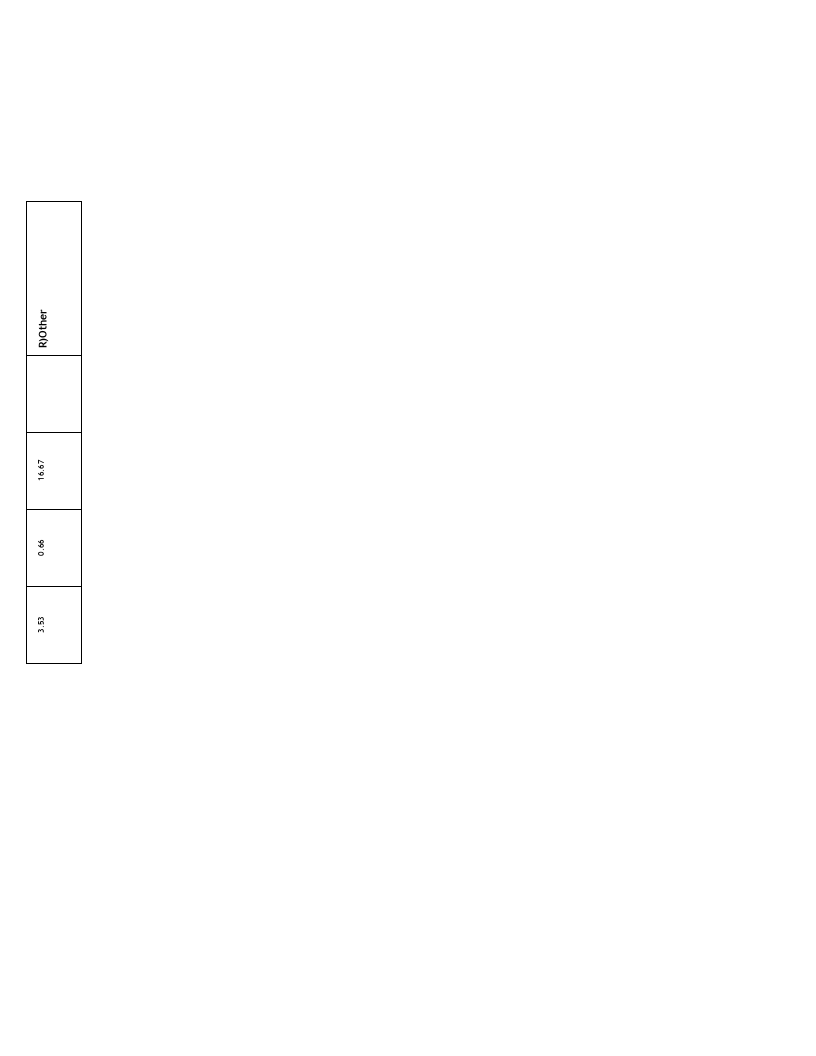
204
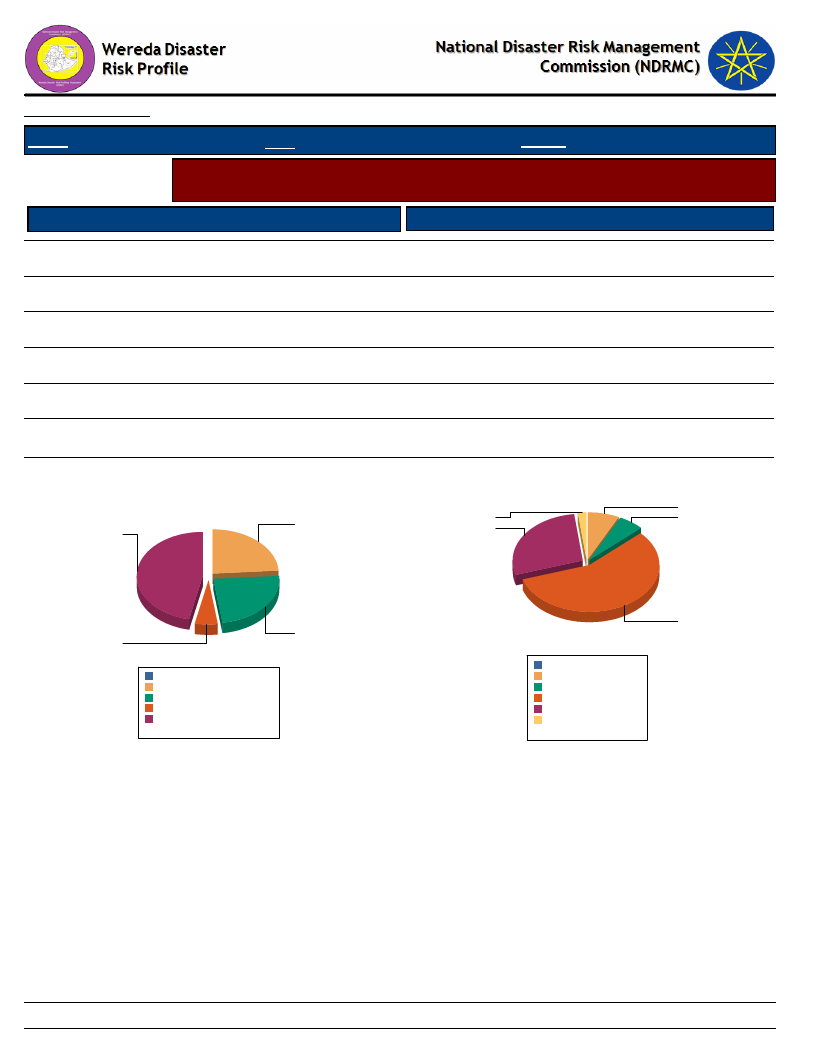
Data_Collected_Date
Wednesday, July 10, 2019
Region S.N.N.P
Zone GURAGE
Wereda MESKAN
Selected Indicator
Agriculture (Livestock): Pasture Availability - Households perception on access
and quality of pasture
Access to Pasture
Response Percent
Quality of Pasture
Response Percent
Occasionally
23.69
B - Good
7.30
Seldom available
46.56
C - Adequate
5.90
Never available
23.97
D - Poor
57.30
0.00
E - Very poor
28.09
0.00
F - DK
1.97
Regularly available
5.79
0.00
Household responses to Access to Pasture for
Livestock
24.0
46.6
Household responses to Quality of Pasture
7.3
2.0
5.9
28.1
23.7
5.8
Never available
Occasionally
Regularly available
Seldom available
0.0%
24.0%
23.7%
5.8%
46.6%
Total:
100.0%
B - Good
0.0%
7.3%
C - Adequate
D - Poor
E - Very poor
F - DK
5.9%
57.0%
27.9%
2.0%
Total:
100.0%
57.3
205
Page 1 of 1
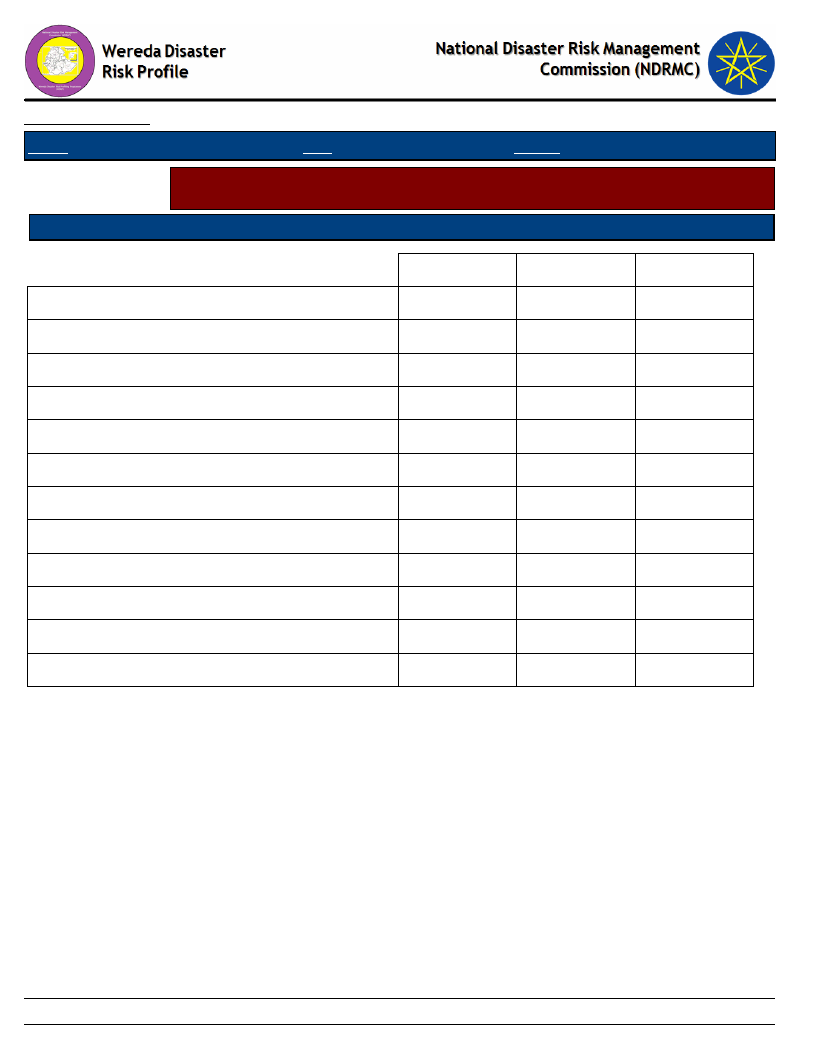
Data_Collected_Date
Region S.N.N.P
Zone GURAGE
Wednesday, July 10, 2019
Wereda MESKAN
Selected Indicator
Agriculture (Livestock): Pasture Availability - Households perception on
problematic months for pasture availability
Problematic Months
Order of Severity
A - Sep (Meskerem)
B - Oct (Tikimt)
C - Nov (Hidar)
D - Dec (Tahsas)
E - Jan (Tir)
F - Feb (Yekatit)
G - Mar (Megabit)
H - Apr (Meazea)
I - May (Ginbot)
J - Jun (Sene)
K - Jul (Hamle)
L - Aug (Nehase)
1st
1.13
0.28
6.80
11.61
13.88
33.99
18.98
9.92
3.12
0.28
2nd
0.28
0.28
0.28
6.82
13.35
17.33
36.08
18.47
5.68
1.42
3rd
0.88
0.29
0.88
9.68
13.78
17.30
35.19
16.72
5.28
206
Page 1 of 1
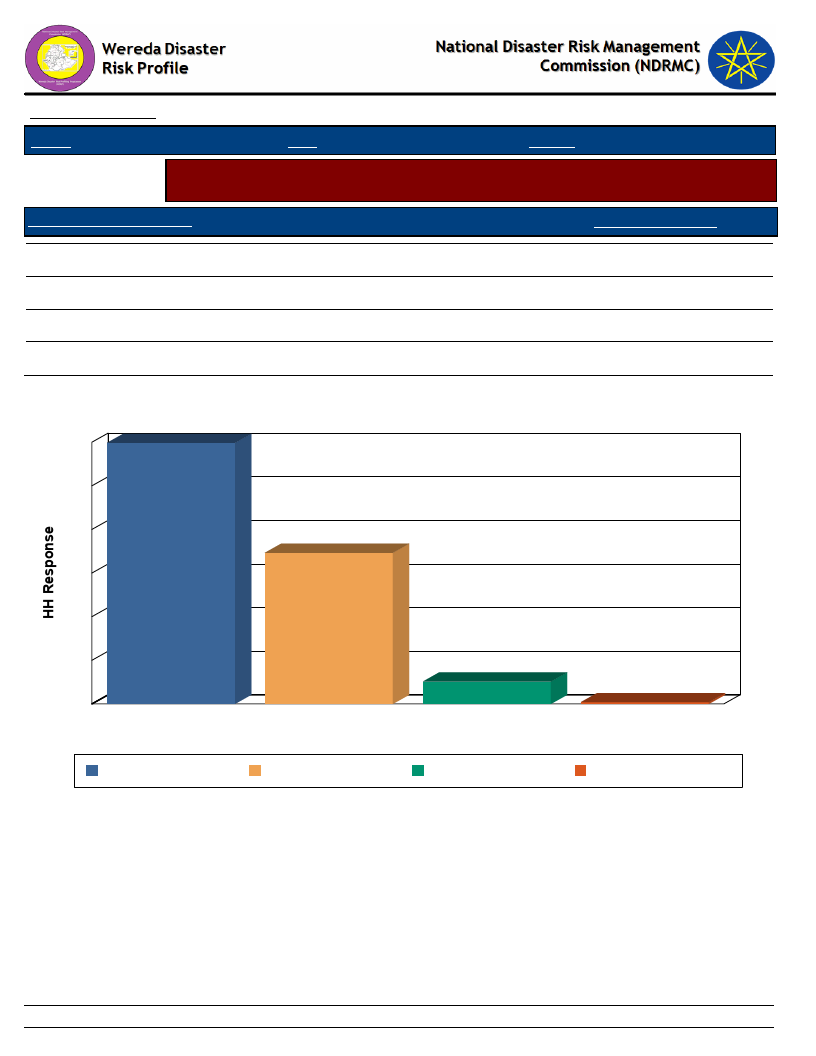
Data_Collected_Date
Region S.N.N.P
Zone GURAGE
Wednesday, July 10, 2019
Wereda MESKAN
Selected Indicator
Agriculture (Livestock): Water Availability - Households response on water
availability for livestock
Access to Water - Livestock
Household Response
A - Regularly available
B - Occasionally
C - Seldom available
D - Never available
59.84
34.65
5.12
0.39
Household Access to Water for Livestock
60
60
50
40
35
30
20
10
0
A - Regularly available
A - Regularly available
5
B - Occasionally
C - Seldom available
Access to Water - Livestock
B - Occasionally
C - Seldom available
0
D - Never available
D - Never available
207
Page 1 of 1
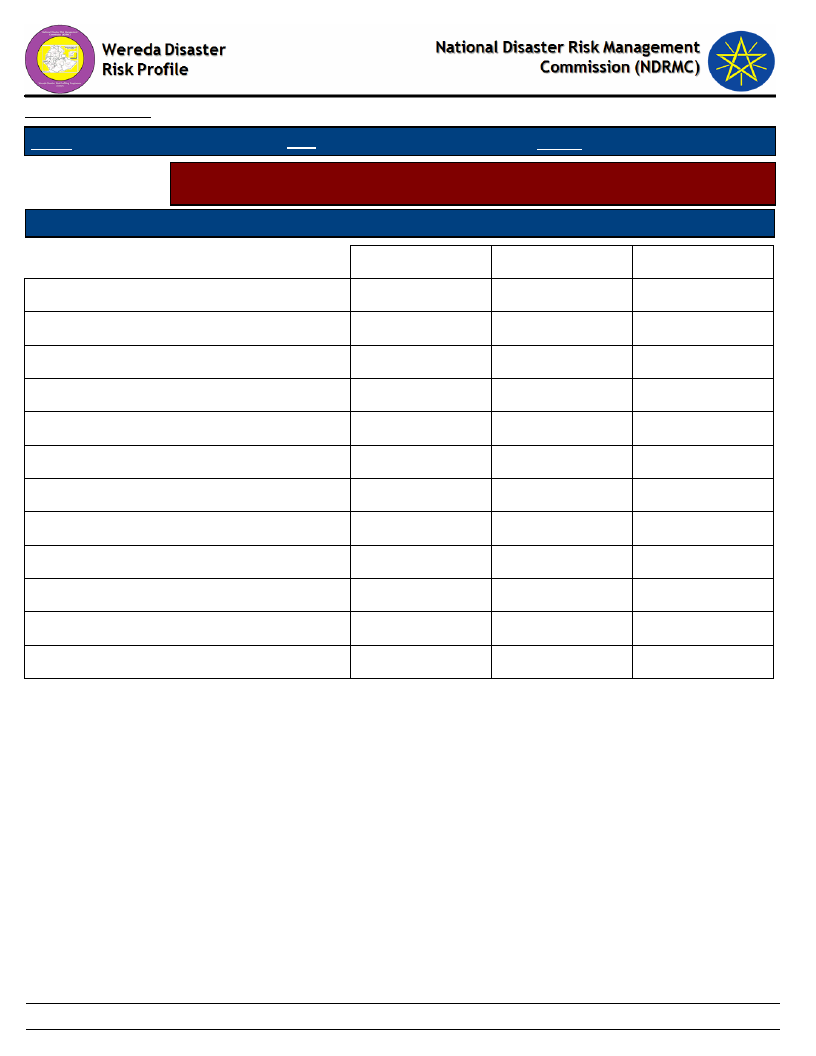
Data_Collected_Date
Region S.N.N.P
Zone GURAGE
Wednesday, July 10, 2019
Wereda MESKAN
Selected Indicator
Agriculture (Livestock): Water Availability - Households perception on
problematic months for water availability for Livestock
Problematic Months
Order of Severity
A - Sep (Meskerem)
B - Oct (Tikimt)
C - Nov (Hidar)
D - Dec (Tahsas)
E - Jan (Tir)
F - Feb (Yekatit)
G - Mar (Megabit)
H - Apr (Meazea)
I - May (Ginbot)
J - Jun (Sene)
K - Jul (Hamle)
L - Aug (Nehase)
1st
0.71
0.36
2.85
8.54
47.69
21.00
7.12
6.05
5.69
2nd
0.36
3.28
9.12
48.91
22.26
8.76
5.11
1.46
0.36
0.36
3rd
0.38
0.38
0.77
3.46
10.38
50.77
13.08
14.23
5.00
1.54
208
Page 1 of 1
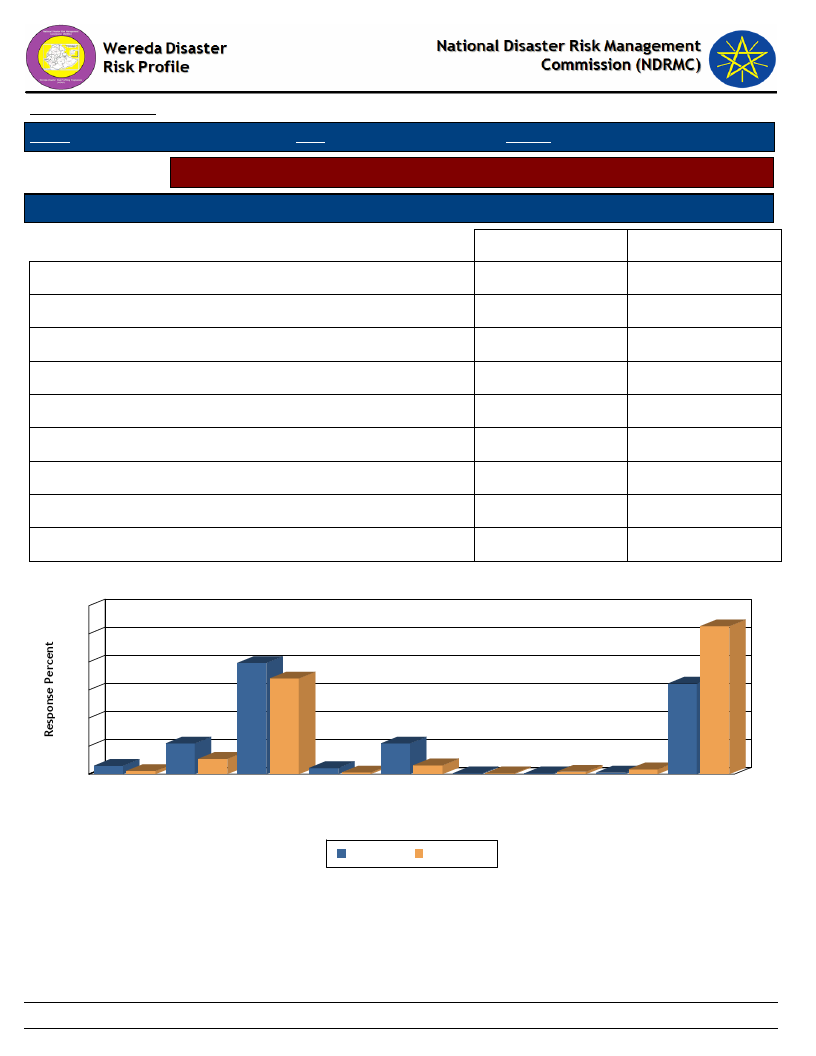
Data_Collected_Date
Region S.N.N.P
Zone GURAGE
Wednesday, July 10, 2019
Wereda MESKAN
Selected Indicator
Sources of water for livestock (households response in %)
Type of Livestock Owned
Changes Observed By Households
Birka
Communal tap (Bono)
Open/Deep well
Piped water into dwelling or plot
Piped water outside the house
Pond or lake (fenced)
Pond or lake (open access)
Rainwater harvesting
River, stream
Dry Season
3.01
10.93
39.62
2.19
10.93
0.27
0.27
0.55
32.24
Wet Season
1.15
5.44
34.10
0.57
3.15
0.29
0.86
1.72
52.72
Household Responses to Type of Water Source and Season for Livestock
60
53
50
40
40
34
32
30
20
10
3
1
0
11
5
2
1
11
3
0
0
0
1
1
2
Birka
Communal tap Open/Deep Piped water Piped water Pond or lake Pond or lake Rainwater River, stream
(Bono)
well
into dwelling outside the
(fenced)
(open access) harvesting
or plot
house
Type of Water Source & Season
Dry Season
Wet Season
209
Page 1 of 1
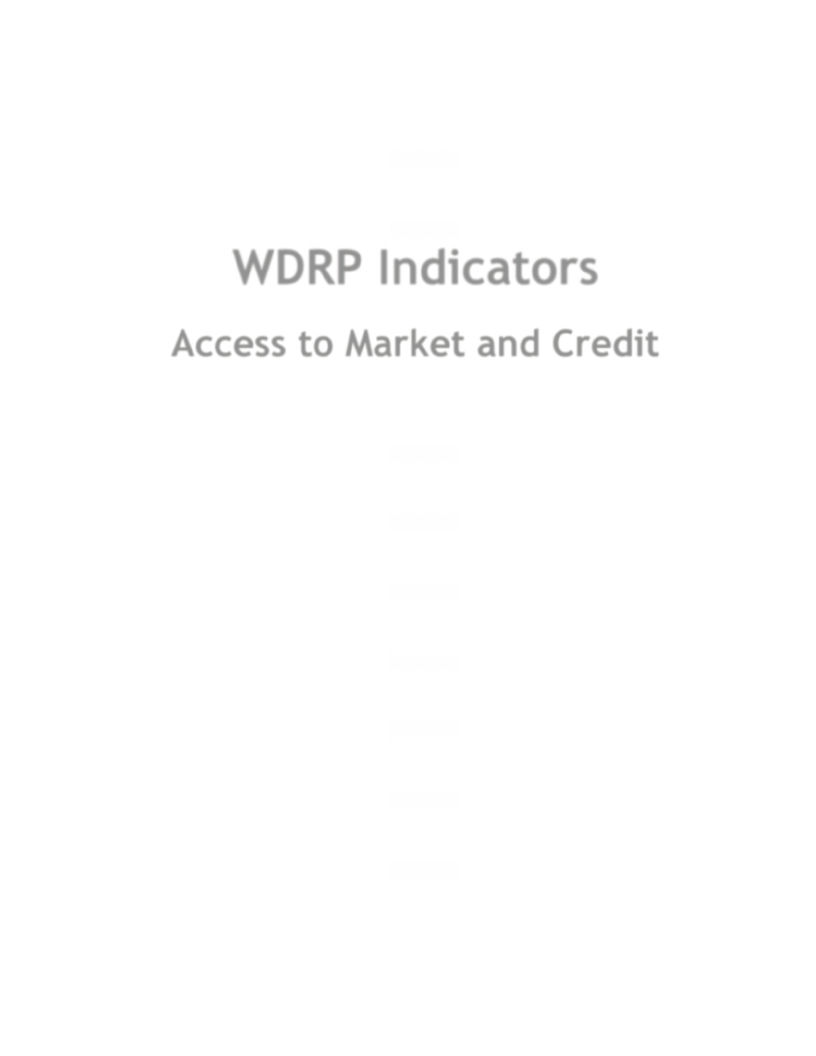
WDRP Indicators
Access to Market and Credit
210
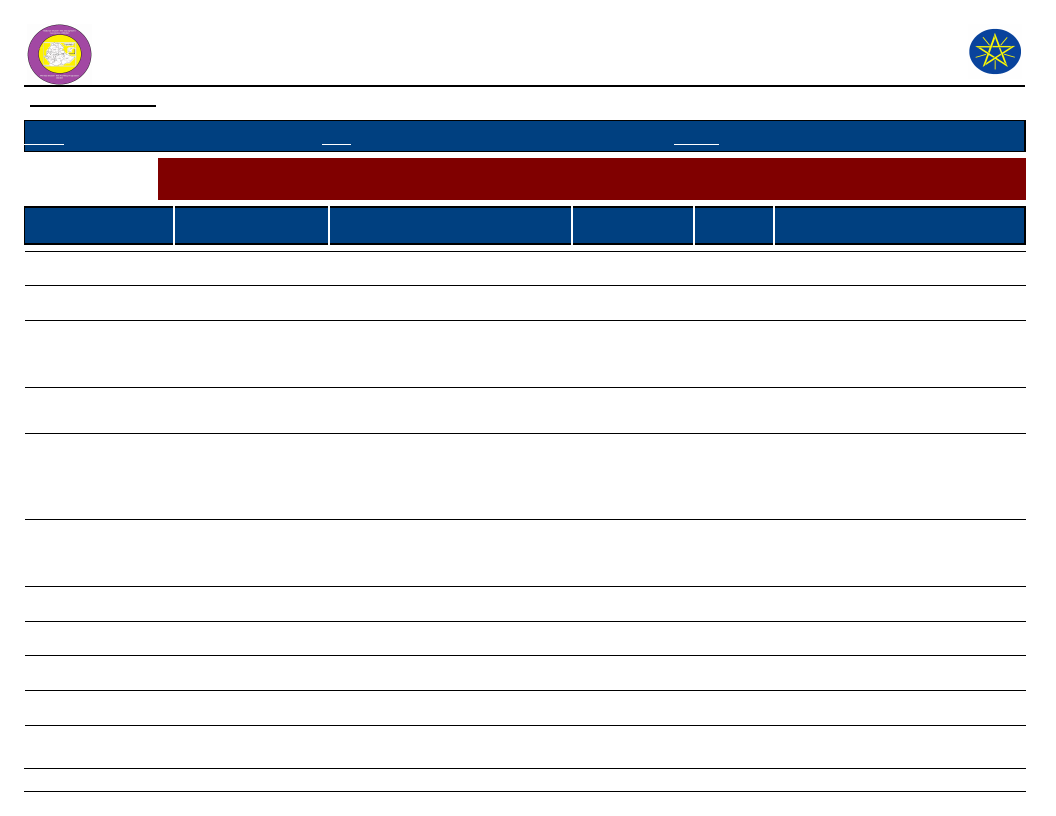
Wereda Disaster
Risk Profile
Data_Collected_Date
National Disaster Risk Management
Commission (NDRMC)
Wednesday, July 10, 2019
Region S.N.N.P
Zone GURAGE
Wereda MESKAN
Selected Indictor:
KebeleName
BATI FATO
Economic Vulnerability: Proportion of Produce Sold and Market - Proportion of crops and livestock sold from total
production and markets
Market_For_Crops
Market_For_Livestock_Produce
Percent
Livestock_Sold
Total_% Comments
Sold
Enseno
Enseno
90
50
BATI LEJANO
Enseno, Butajra
Enseno, Butajra
15
50
BECHE BULCHANO
Enseno
BERESA
DEBO TUTO
Butajira
Butajira
Enseno
Butajira
DEBUB SHERSHERA
Butajra, Enseno
DEGAGOGOT
Butajra
Butajra, Enseno
Butajra
95
60
Because of the problem of pepper
disease we have no other cash
crop, we sell most products
25
Community have no much
livestock and livestock production
10
20
Crop production is not sufficient
to feed in all year because of low
productivity and less cultivated
land
85
10
Most farmers production is very
low and most products used for
consumption
90
20
DIDA
Enseno
Enseno
90
10
DIRAMA
Butajira, Kela
Butajira, Kela
95
10
DOBENA
Butajira, Enseno
Butajira, Enseno
95
25
211
Page 1 of 3
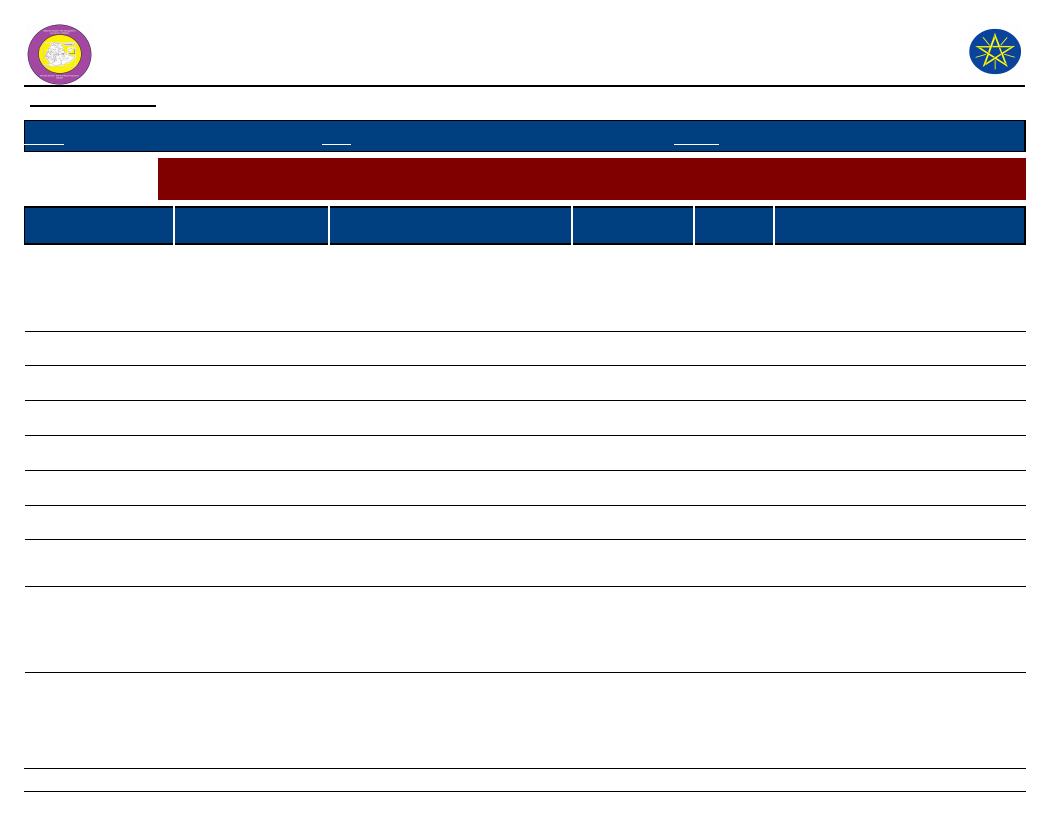
Wereda Disaster
Risk Profile
Data_Collected_Date
National Disaster Risk Management
Commission (NDRMC)
Wednesday, July 10, 2019
Region S.N.N.P
Zone GURAGE
Wereda MESKAN
Selected Indictor:
KebeleName
GIDENA ABORAT
GOYBAN
Economic Vulnerability: Proportion of Produce Sold and Market - Proportion of crops and livestock sold from total
production and markets
Market_For_Crops
Bugajra
Market_For_Livestock_Produce
Butajira
Percent
Livestock_Sold
95
Total_%
Sold
10
Comments
Most production of crop and
animals was used for consumption
due to minimize of land and soil
fertility
Butajira
Butajira
15
10
ILE
10
25
INSENO USME
50
25
JOLE ANDENYA
Kella and Butajira
Kella and Butajira
10
20
JOLE HULETENYA
Kela, Butajira
Kela, Butajira
95
30
MEKICHO
Butajira
Butajira
95
25
MESERETEWEGERAM
O
MIKAELO
Butajira
MIRAB IMBOR
Butajira
Butajira
Butajira
20
10
92
212
25
20
Most of crop and other products
keep for house consumption
specially 90% of maize used for
feeding
25
Most farmers have less lands and
most products of crop was used
for consumption and animals
produce for sell
Page 2 of 3
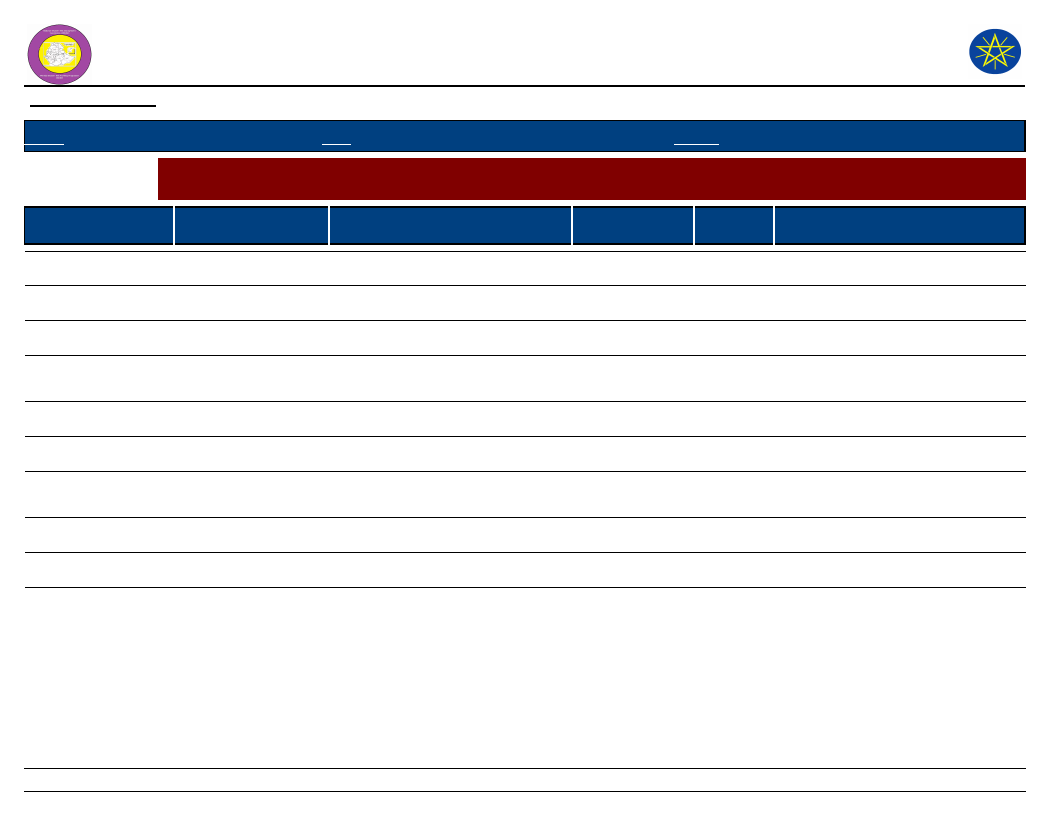
Wereda Disaster
Risk Profile
Data_Collected_Date
National Disaster Risk Management
Commission (NDRMC)
Wednesday, July 10, 2019
Region S.N.N.P
Zone GURAGE
Wereda MESKAN
Selected Indictor:
KebeleName
MIRAB MESKAN
Economic Vulnerability: Proportion of Produce Sold and Market - Proportion of crops and livestock sold from total
production and markets
Market_For_Crops
Market_For_Livestock_Produce
Percent
Livestock_Sold
Total_% Comments
Sold
Butajira
Butajra
92
25
OCHAGENEME
Enseno
Enseno
10
20
SEMEN SHORSHORA
Butajira
Butajira
95
SHERSHERA
MACHMENA
WEJABATI
Kela, Butajira
Butajira, Kela
95
75
10
15
WITA
Butajira
Butajira
10
40
WOLENSHO
ANDENYA
YETABON
Butajira
Butajira
Butajira
Butajira
10
70
95
5
YIMERWACHO 2NYA
Near market
Butajira and Enseno
30
25
YIMERWACHO 3NYA
Hamus Gebeya
90
50
213
Page 3 of 3
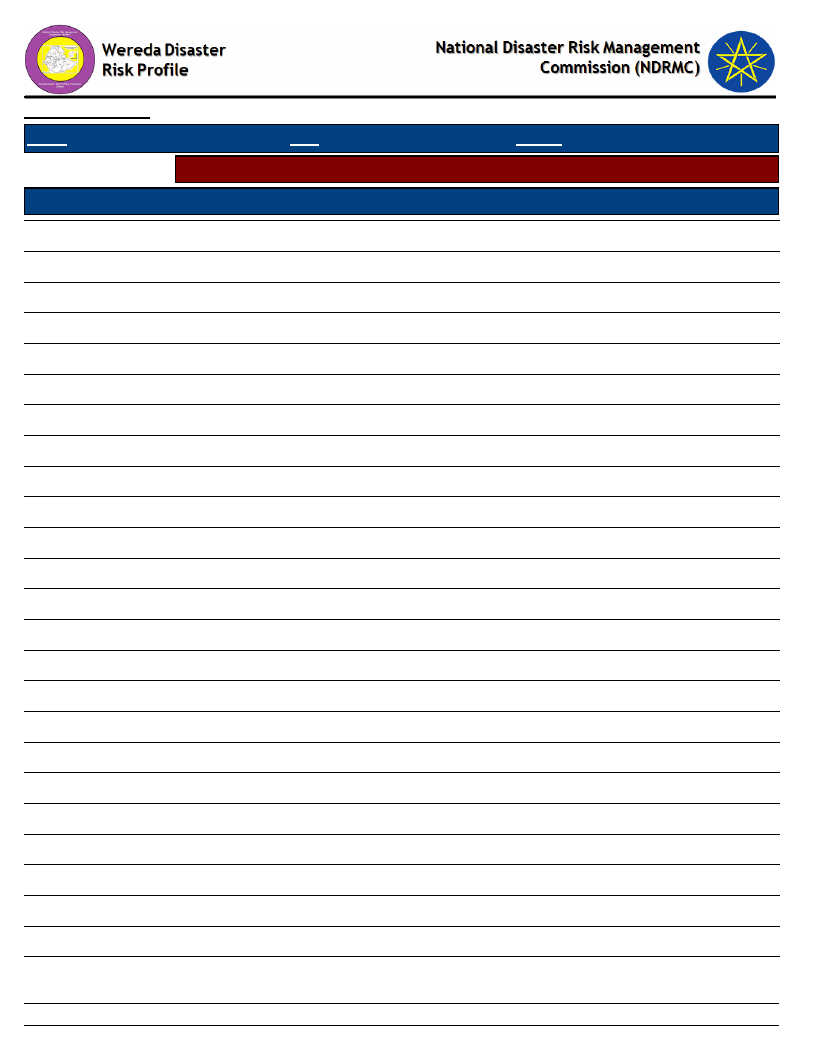
Data_Collected_Date
Region S.N.N.P
Selected Indicator
Kebele Name
BATI FATO
BATI LEJANO
BECHE BULCHANO
BERESA
DEBO TUTO
DEBUB SHERSHERA
DEGAGOGOT
DIDA
DIRAMA
DOBENA
GIDENA ABORAT
GOYBAN
ILE
INSENO USME
JOLE ANDENYA
JOLE HULETENYA
MEKICHO
MESERETEWEGERAMO
MIKAELO
MIRAB IMBOR
MIRAB MESKAN
OCHAGENEME
SEMEN SHORSHORA
SHERSHERA MACHMENA
WEJABATI
Wednesday, July 10, 2019
Zone GURAGE
Wereda MESKAN
Economic Vulnerability: Kebele Access to Markets - Access to market by Kebele
Market_Access_Comments
There is several problem of market problem to seasonal and irrigation products
Market price fluctuation, no market linkage
There is high problem of market linkage
Market price fluctuation
No transportation rail way, market information gap, market price fluctuation
Good access
Very good
Shortage of market linkage due to far to the main road and local town market
Seasonal problem and we have no market
Shortage of market linkage
The production of irrigation production there is a problem every season
Very good linkage
Fluctuation of market price
Market fluctuation
Market price fluctuation, poor market situation
Lack of market linkage
There is shortage of market linkage /specially for livestock
Market price fluctuation, no organization by farmers production
Market is not available, market price fluctuation and no transport access
The community have no market linkage in every production
There is no market linkage
Market price fluctuation, no infrastructure like roan, no market linkage
Very good
Market price fluctuation, no infrastructure like road
214
Page 1 of 2
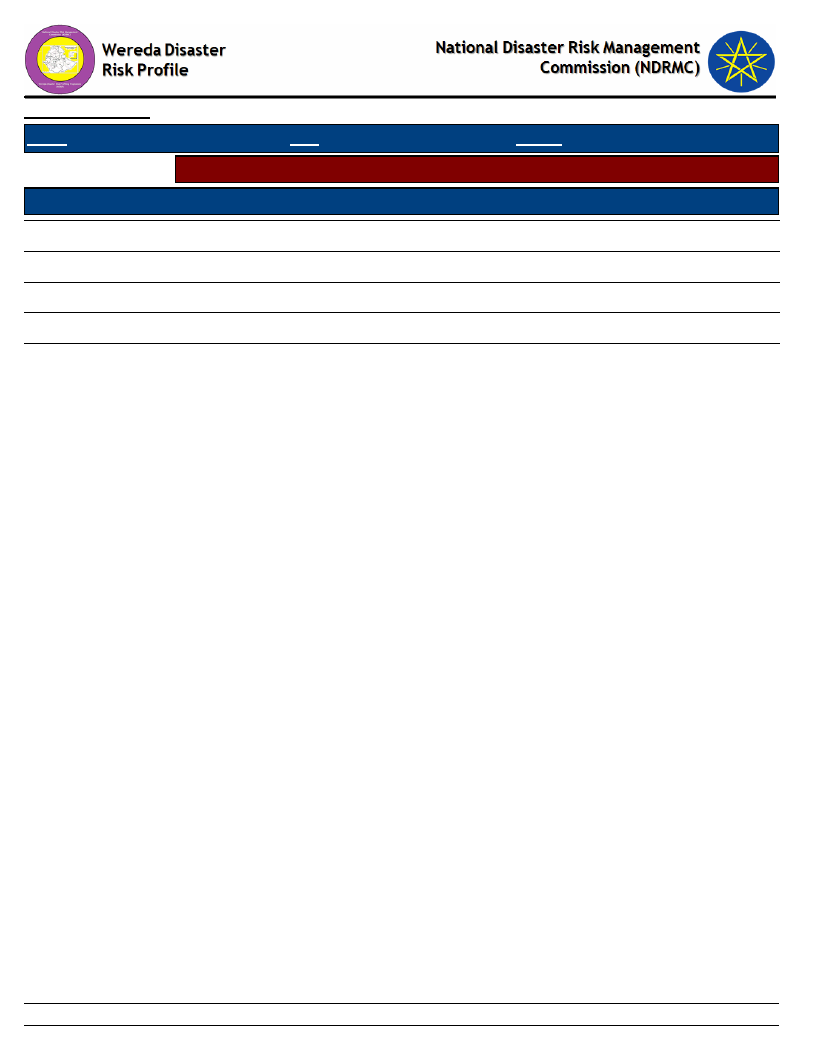
Data_Collected_Date
Region S.N.N.P
Selected Indicator
Kebele Name
WITA
WOLENSHO ANDENYA
YETABON
YIMERWACHO 2NYA
YIMERWACHO 3NYA
Wednesday, July 10, 2019
Zone GURAGE
Wereda MESKAN
Economic Vulnerability: Kebele Access to Markets - Access to market by Kebele
Market_Access_Comments
Market situation not available, market price fluctuation, poor infrastructure
Market price fluctuation, market information gap, no transport access
Less market linkage
Shortage of market access
No market price fluctuation, no any organization
215
Page 2 of 2
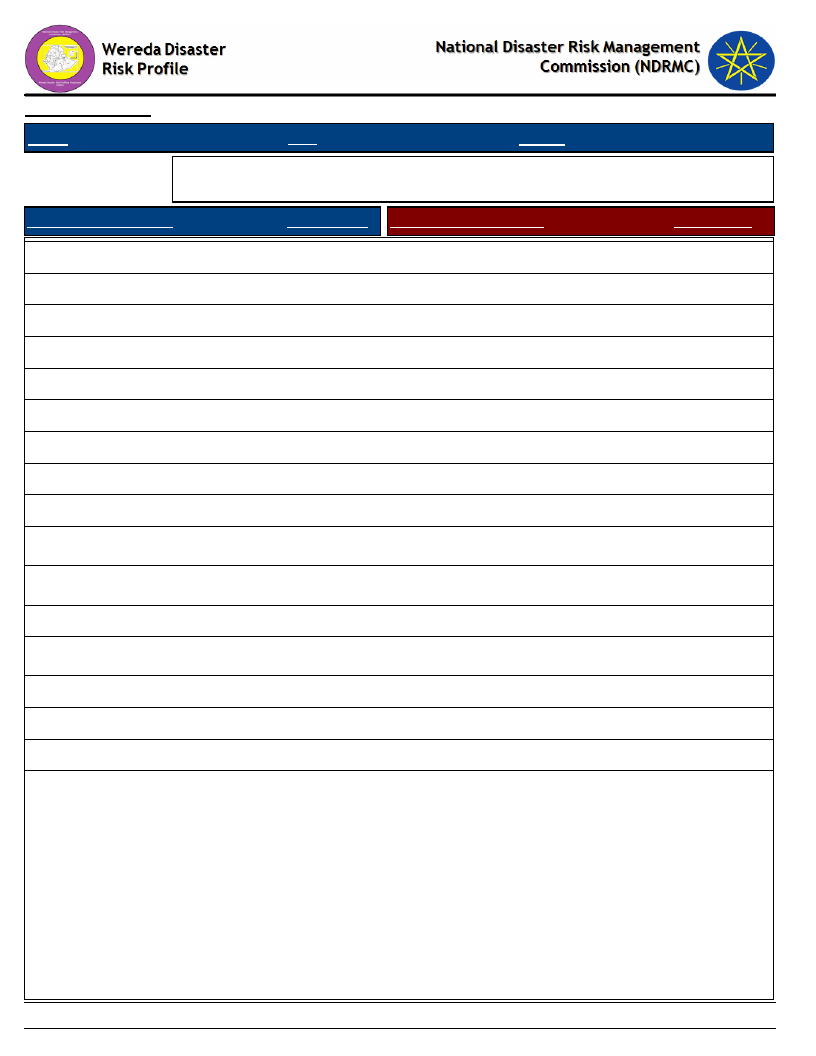
Data_Collected_Date
Region S.N.N.P
Zone GURAGE
Wednesday, July 10, 2019
Wereda MESKAN
Selected Indicator
Economic Vulnerability: Formal & Informal Transfers - Percentage of
households reporting received formal transfers
Type of Formal Transfer
Food aid
HH Response Type of Informal Transfer
Formal
14.08 Remittances (from relative living elsewhere)
HH Response
10.35
Food-for-Work project
5.43 Zakaat
0.55
Cash-for-Work project
11.68 Other cash gift
3.87
Faffa
4.89 Cash loan (no interest)
14.05
Free cash
3.15 Food or grain gift
4.16
Seeds
12.14 Grain loan (no interest)
0.83
Credit support
2.61 Seed gift
8.89
Livestock
0.29 Seed loan
1.94
Tools
0.58 Free labour
12.50
Cash or kind gift to married daughters when they
0.83
visit parents or relatives
Donation or loan of milking animals to a relative or
0.28
friend
Dowry given to bride’s parents
0.83
Donations of cash or animals to disaster stricken
people
Free use of oxen or plough
0.56
14.40
Free use of pack animals (camels or donkeys)
2.22
Restocking of poorer relatives
1.11
Distribution of meat to neighbours after a slaughter
1.11
takes place
216
Page 1 of 2
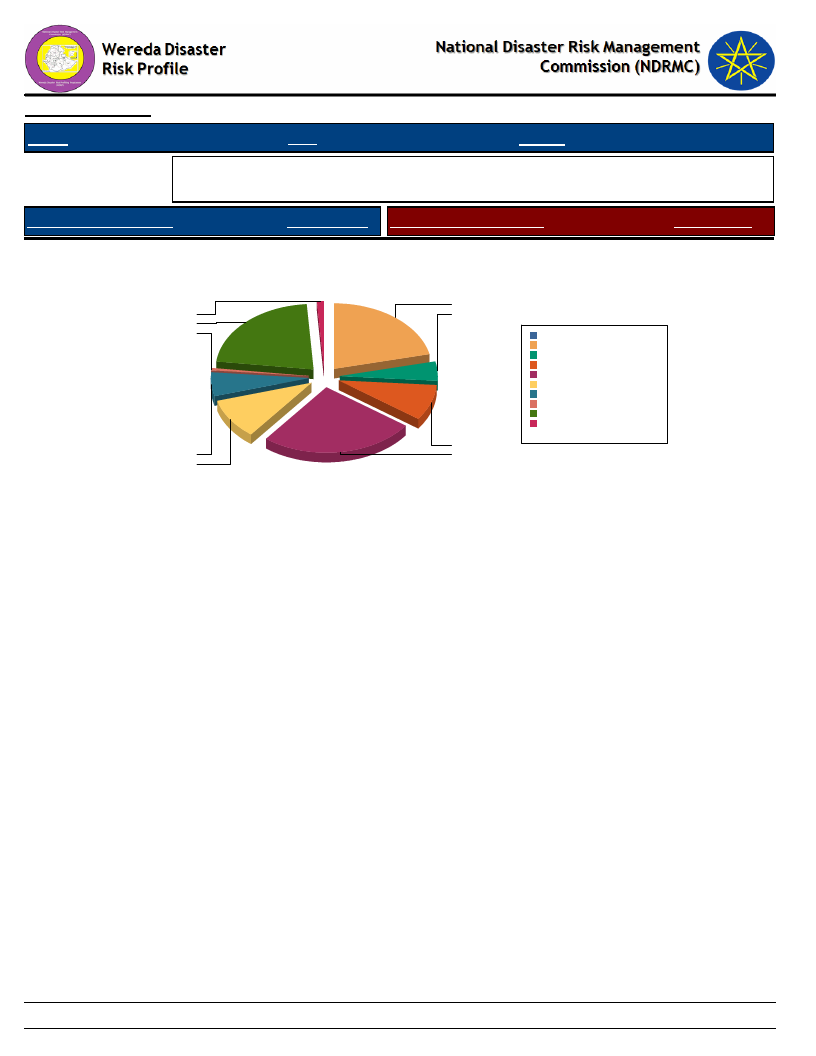
Data_Collected_Date
Wednesday, July 10, 2019
Region S.N.N.P
Zone GURAGE
Wereda MESKAN
Selected Indicator
Economic Vulnerability: Formal & Informal Transfers - Percentage of
households reporting received formal transfers
Type of Formal Transfer
HH Response Type of Informal Transfer
Formal
Type of Formal Transfer Received By Households
HH Response
0.6
12.1
0.3
3.1
5.4
11.7
2.6
4.9
14.1
0.0%
Cash-for-Work project 21.3%
Credit support
4.8%
Faffa
8.9%
Food aid
25.7%
Food-for-Work project 9.9%
Free cash
5.7%
Livestock
0.5%
Seeds
22.1%
Tools
1.1%
Total:
100.0%
217
Page 2 of 2
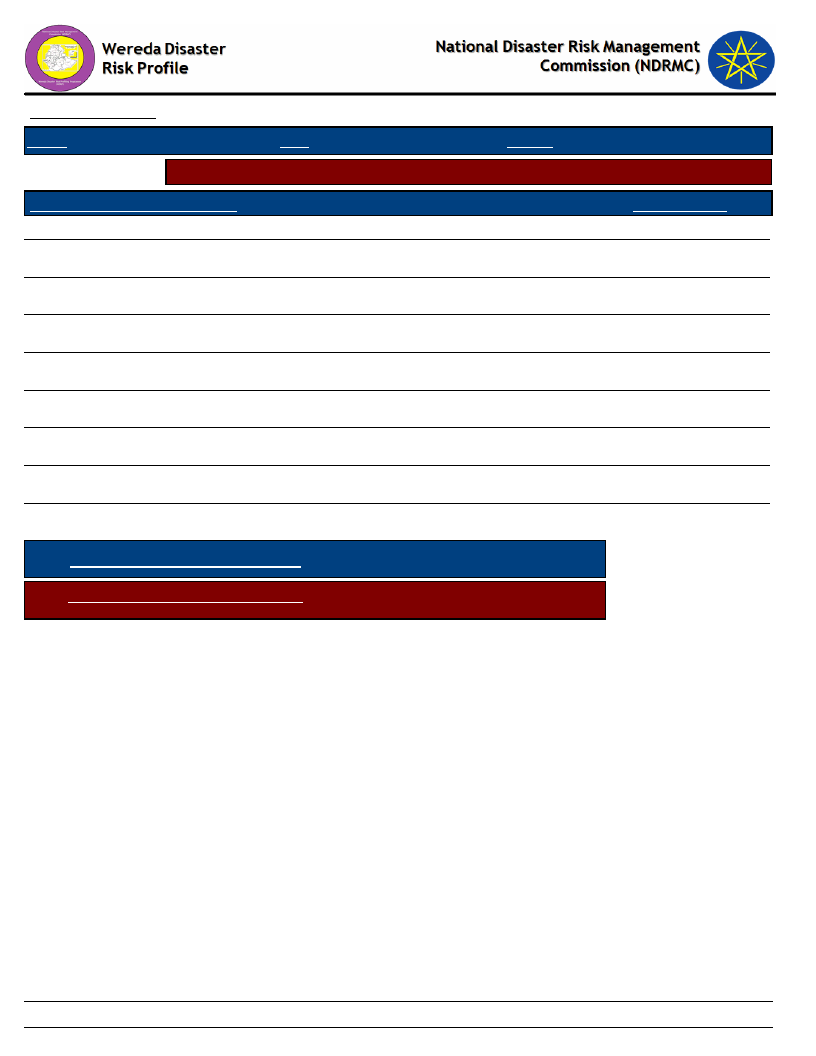
Data_Collected_Date
Wednesday, July 10, 2019
Region S.N.N.P
Zone GURAGE
Wereda MESKAN
Selected Indicator
Capacity: Access to Credit Facilities - Households access to credit facilities
Type of Access To Credit Facilities
Indicator_Value
Households with membership in any credit /micro finance society (%)
Households who borrowed any money in the last one year (%)
Households who tried to borrow 1-2
Households who tried to borrow 3-4
Households who tried to borrow 5 & Above
Households who managed to get credit 1-2
Households who managed to get credit 3-4
Households who managed to get credit 5 & Above
Average No. of HHs Tried to get Credit
Average No. HHs Managed to get Credit
24.45
22.47
75.86
18.39
5.75
88.46
6.41
5.13
1.33
2.06
218
Page 1 of 1
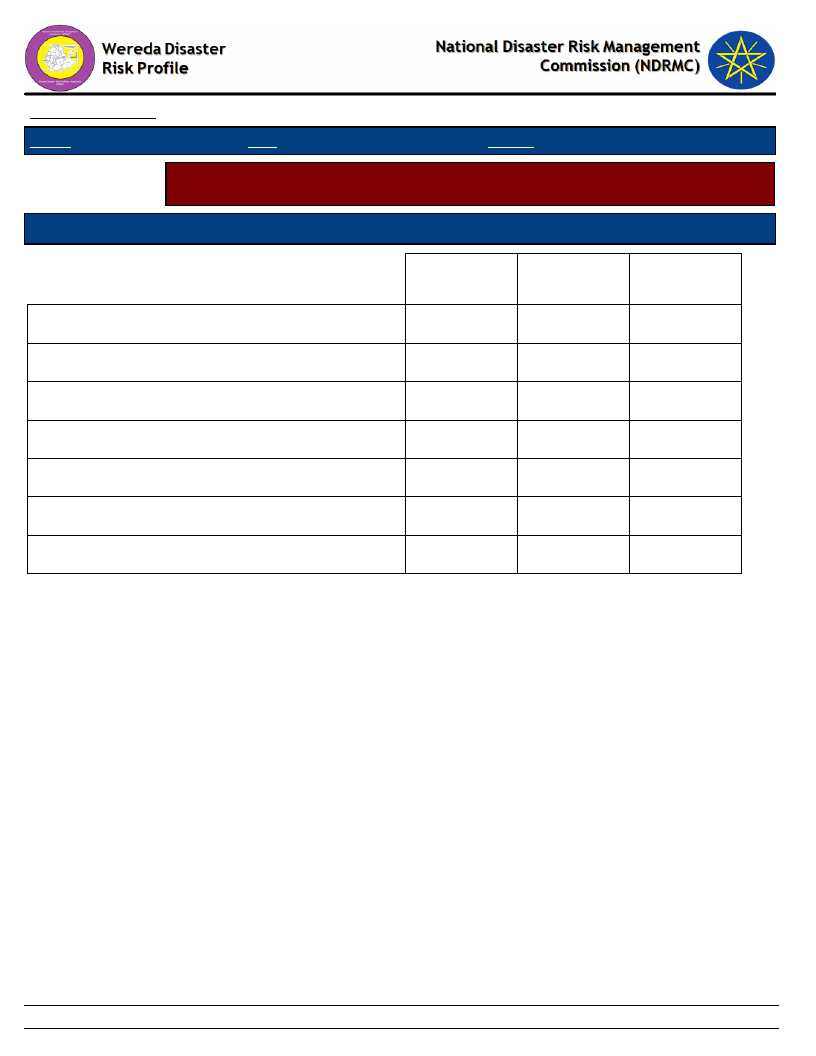
Data_Collected_Date
Region S.N.N.P
Zone GURAGE
Wereda MESKAN
Wednesday, July 10, 2019
Selected Indicator
Capacity: Access to Credit Facilities - Percentage of households by major
reasons of borrowing money
Type of Borrowing Reason
Degree of Importance of the Borrowing Reasons - HH Respones
Buy agricultural input
Buy food
Buy or rent land
Others (specify)
Pay for education
Pay for health care
Pay for social event
1st
Important
36.71
22.78
10.13
25.32
5.06
2nd
Important
20.51
23.08
7.69
5.13
30.77
12.82
3rd
Important
25.00
20.00
10.00
10.00
10.00
25.00
219
Page 1 of 1
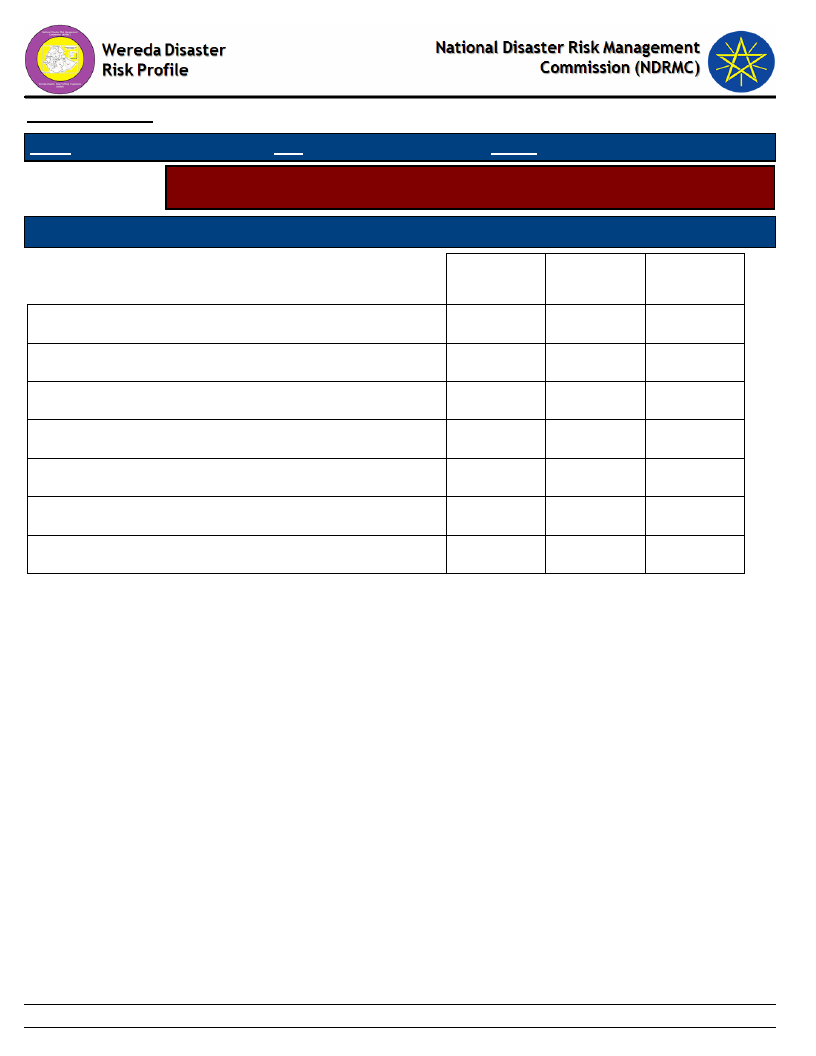
Data_Collected_Date
Wednesday, July 10, 2019
Region S.N.N.P
Zone GURAGE
Wereda MESKAN
Selected Indicator
Capacity: Access to Credit Facilities - Percentage of households by major
sources of credit
Major Sources of Credit for Households
Degree of Importance of the Credit Source
Bank/formal lending institution
Friends/relatives
1st
Important
59.52
23.81
2nd
Important
10.00
3rd
Important
33.33
Help associations (Edir)
4.76
30.00
Informal savings group (Ekub)
Local shops / moneylenders
Neighbors
Others (specify)
2.38
2.38
16.67
2.38
60.00
50.00
4.76
220
Page 1 of 1
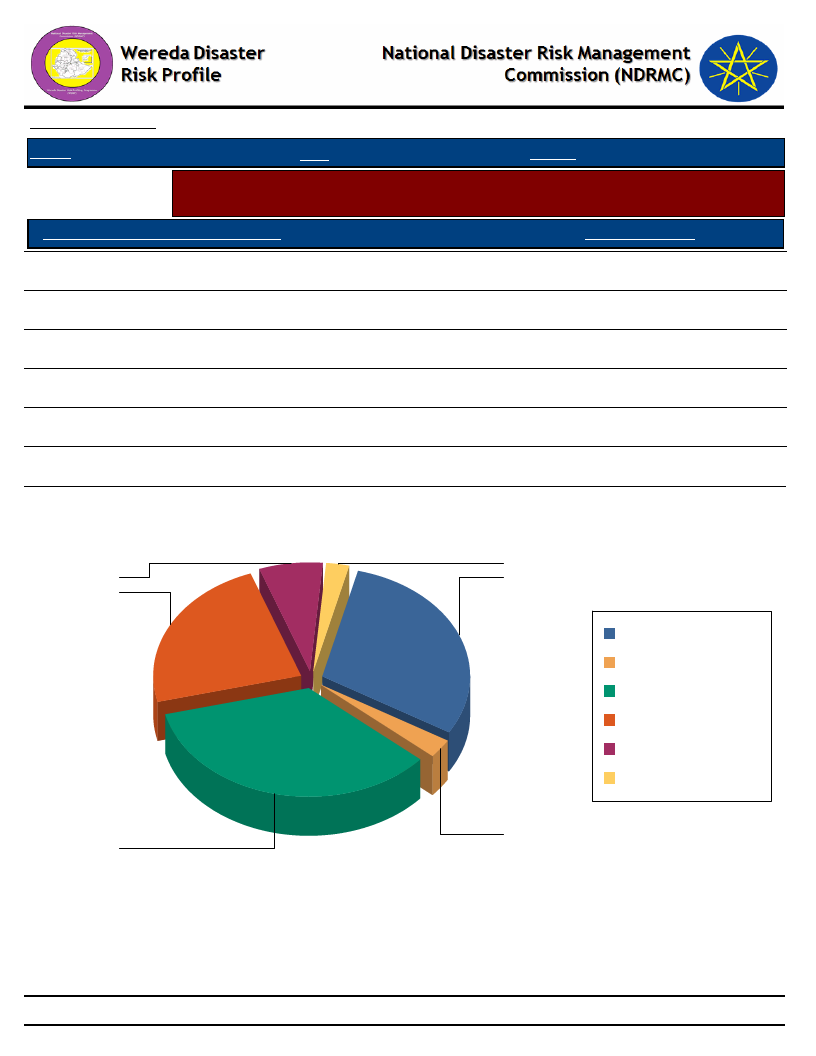
Data_Collected_Date
Wednesday, July 10, 2019
Region S.N.N.P
Zone GURAGE
Wereda MESKAN
Selected Indicator
Capacity: Access to Credit Facilities - Percent of households with ability to raise
500 birr in one week
HH Ability To Raise 500 Br in One Week
Response_Percent
Yes, we would use our savings
6.89
Yes, by borrowing money
34.71
Yes, with some help from others
2.48
Yes, by selling asset or livestock
23.42
Perhaps, but I doubt it
2.75
No, it would be impossible
29.75
Households' Ability To Raise 500 Br in One Week
2
7
30
23
No, it would be
impossible
Perhaps, but I doubt it
Yes, by borrowing
money
Yes, by selling asset or
livestock
Yes, we would use our
savings
Yes, with some help
from others
3
35
221
Page 1 of 1
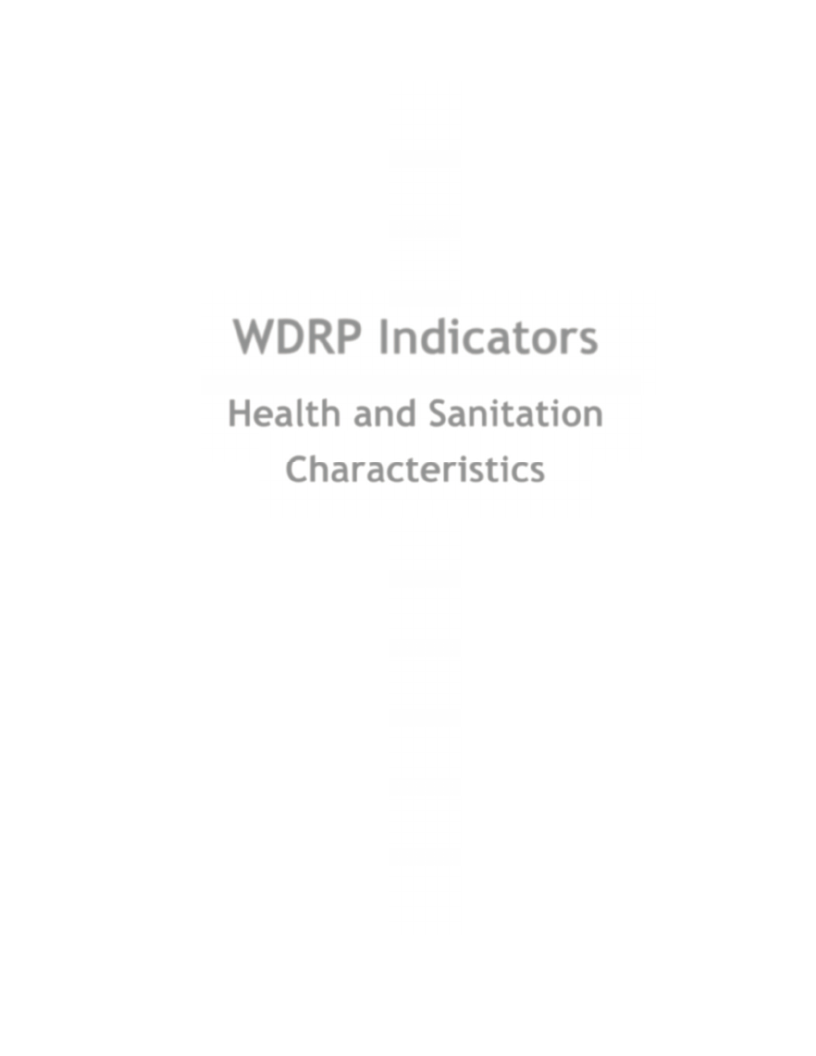
WDRP Indicators
Health and Sanitation
Characteristics
222
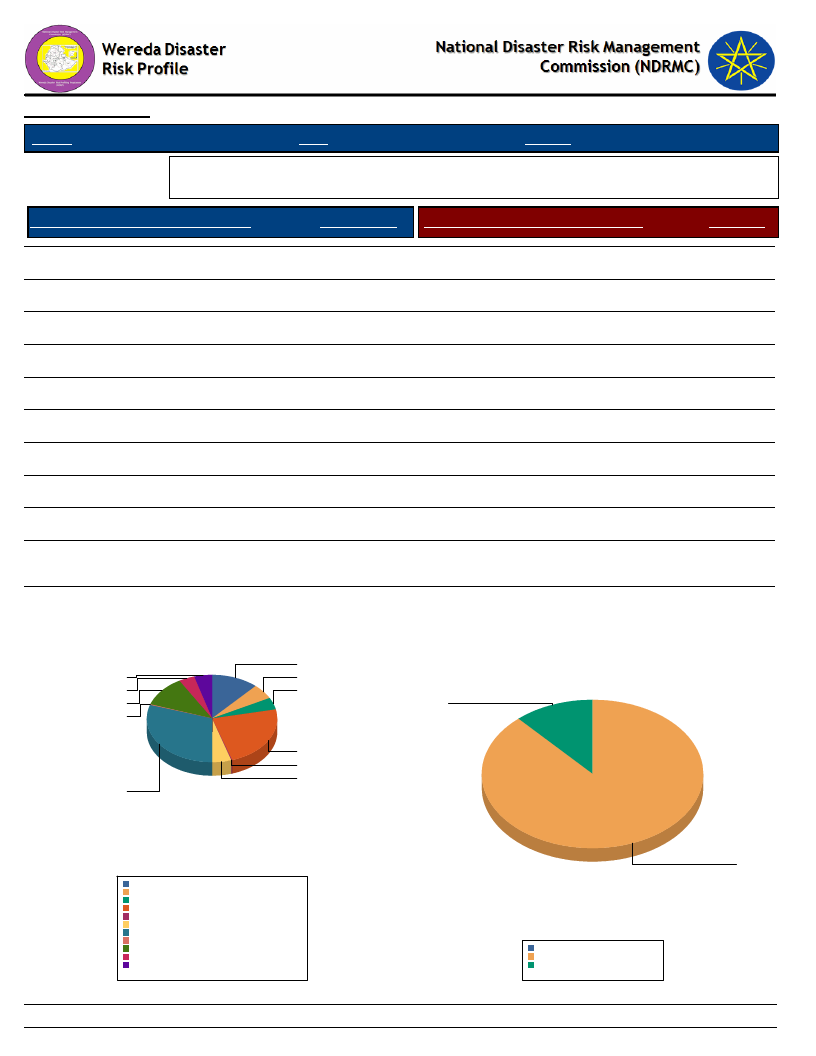
Data_Collected_Date
Region S.N.N.P
Zone GURAGE
Wednesday, July 10, 2019
Wereda MESKAN
Selected Indicator
Household Access to Health Facilities - Where do patients go for health care?
Constraints to adequate healthcare
Where do Patients Go for Healthcare
HH Response Constraints to Adequate Health Care
Response
Did not get Health Care
Central Hospital
Spiritual healer
Mission facility
Community health worker
Private hospital/clinic
Pharmacy
Other private
Traditional healer
District/Municipal hospital/health
centre/ clinic
Other public
4.38
11.60
3.87
0.26
5.67
11.34
0.52
4.64
4.38
23.45
29.90
No money for treatment costs
Poor quality of service
88.24
11.76
0.00
0.00
0.00
0.00
0.00
0.00
0.00
0.00
0.00
Where Do Patients go for Health care?
12
4
6
4
4
11
1
23
0
5
30
Constraints to Adequate Health Care
12
Central Hospital
Community health worker
Did not get Health Care
District/Municipal hospital/health centre/ clinic
Mission facility
Other private
Other public
Pharmacy
Private hospital/clinic
Spiritual healer
Traditional healer
11.6%
5.7%
4.4%
23.4%
0.3%
4.6%
29.9%
0.5%
11.3%
3.9%
4.4%
Total:
100.0%
223
88
0.0%
No money for treatment costs 88.2%
Poor quality of service
11.8%
Total:
100.0%
Page 1 of 1
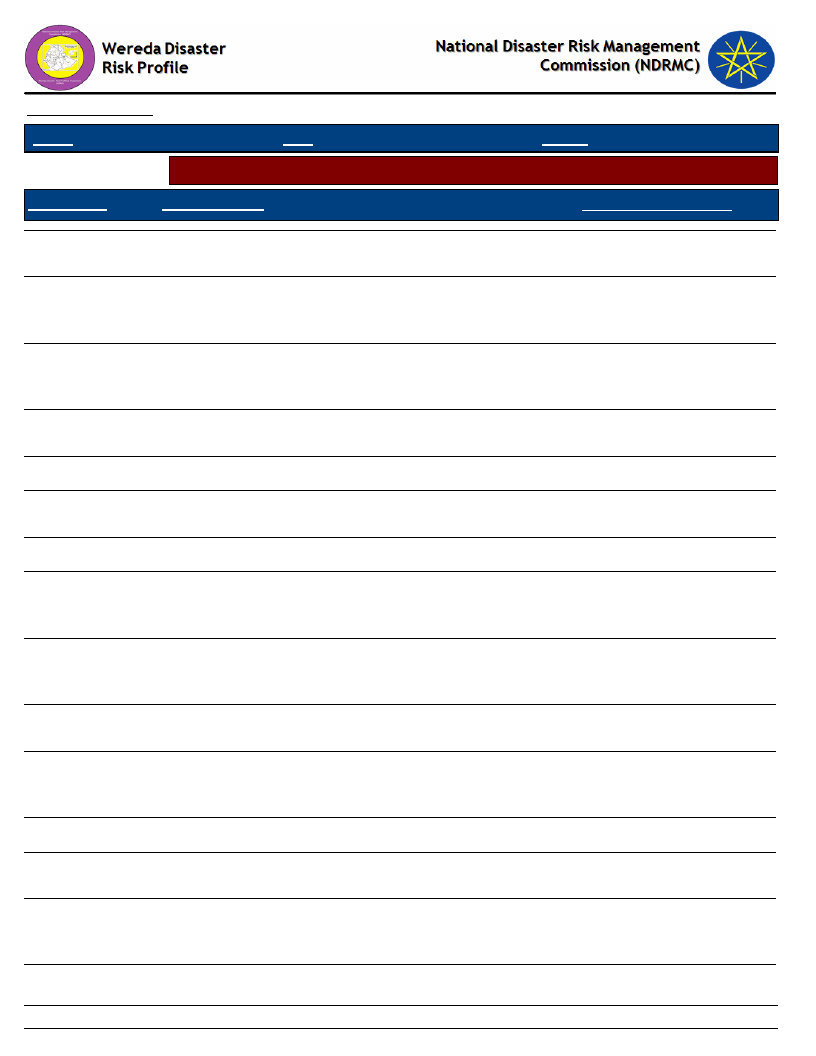
Data_Collected_Date
Region S.N.N.P
Zone GURAGE
Wednesday, July 10, 2019
Wereda MESKAN
Selected Indicator
Hazards: Health problems and changes over the last decade
Kebele Name
Health_Problems
Changes_In_Last_Decade
BATI FATO
BATI LEJANO
BECHE BULCHANO
BERESA
DEBO TUTO
DEBUB
SHERSHERA
DEGAGOGOT
DIDA
DIRAMA
DOBENA
GIDENA ABORAT
GOYBAN
ILE
INSENO USME
Typhus, typhoid, pneumonia caused by Climate change,
using contaminated food and water
Malaria, influenza, typhoid, typhus caused by Shortage of
clean water, shortage of toilet, poor sanitation. Human
death
Typhoid, typhus, pneumonia caused by Climate change,
lack of health post, loss of healthy man power, economic
loss
Malaria, eye disease, typhoid, typhus caused by
Shortage of food and drinking water. Death of human
Malaria, typhoid, water born disease
Tuberculosis, malaria, typhus, typhoid caused by Climate
change, problems of food, shortage of clean water
Decreased
Typhoid, typhus, malaria, aquatic water born disease
caused by mosquito reproduction, water pollution. Loss
of income and time, human disease
Typhus, typhoid, malaria, water born disease caused by
climate change, shortage of clean water, economic loss,
time and social crises
Typhus, typhoid, pneumonia caused by Virus, human
disease
Pneumonia, Kidney infection, pressure, sinus caused by
climate change, feeding system, water pollution,
obstacle to development, death of economic crises
Good
Malaria, typhoid, typhus caused by shortage of rest
rooms, death of human, infant mortality
Malaria, typhoid, typhus caused by transmitted, shortage
of clean water, shortage of rest room, reproduction of
mosquito net
Increasing
No change
Increased
Increased
Increased
Increased
Decreased
Decreased
Decreased
Increased
Increased
No change
NO change
224
Page 1 of 3
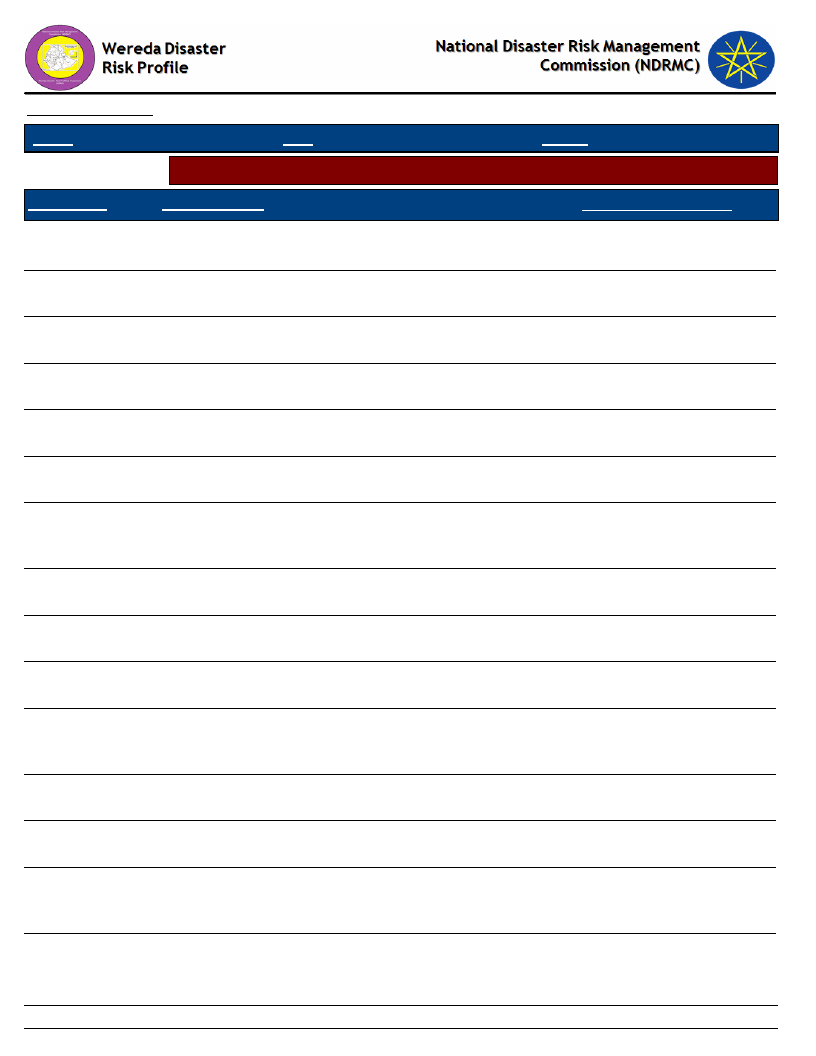
Data_Collected_Date
Wednesday, July 10, 2019
Region S.N.N.P
Zone GURAGE
Wereda MESKAN
Selected Indicator
Hazards: Health problems and changes over the last decade
Kebele Name
Health_Problems
Changes_In_Last_Decade
JOLE ANDENYA
JOLE HULETENYA
MEKICHO
MESERETEWEGERA
MO
MIKAELO
MIRAB IMBOR
MIRAB MESKAN
OCHAGENEME
SEMEN
SHORSHORA
SHERSHERA
MACHMENA
WEJABATI
WITA
WOLENSHO
ANDENYA
YETABON
YIMERWACHO
2NYA
Malaria, typhoid, influenza caused by shortage of clean
water, poor sanitation, death of human
Typhus, typhus, malaria caused by reproduction of
mosquito, virus, economic crises, sickness of human
Typhus, typhoid, malaria caused by climate change,
virus, mosquito
Typhoid, typhus caused by food contamination
Typhus, typhoid, malaria caused by shortage of clean
drinking water, human disease
Typhoid, typhus, water born disease, malaria caused by
climate change, shortage of drinking water, drought
Typhus, typhoid, malaria, pneumonia caused by climate
change, population water, less clean water, health
crises, time loss
Malaria, typhoid, typhus, influenza, gastric, kidney
caused by shortage of clean water, human disease
Very good
Malaria, typhoid, typhus caused by polluted water,
economic crises,
Malaria, typhoid and typhus, influenza caused by
shortage of toilet, shortage of clean water, death of
human
Malaria, typhoid, typhus, influenza caused by shortage of
clean water, climate change, human death
Typhus, typhoid, malaria, diarrhea, tuberculosis caused
by shortage of clean water, death of human
Typhus, typhoid, malaria, pneumonia caused by virus ,
sickness, reproduction of mosquito, social and economic
crises
Malaria, typhoid, typhus caused by lack of balance diet,
shortage of pure water, death of human, economic crises
Decreased
Increased
Increased, decreased
No change
Increasing
Increased
Decreased
No change
Increased
Decreased
No change
Decreased
Increased
Increased
Increased
225
Page 2 of 3

Data_Collected_Date
Region S.N.N.P
Zone GURAGE
Wednesday, July 10, 2019
Wereda MESKAN
Selected Indicator
Hazards: Health problems and changes over the last decade
Kebele Name
Health_Problems
Changes_In_Last_Decade
YIMERWACHO
3NYA
Malaria, typhoid, skin disease caused by not using
mosquito net, shortage of drinking water and drainage,
lack of clean water, lack of toilet, human disease
No change
226
Page 3 of 3
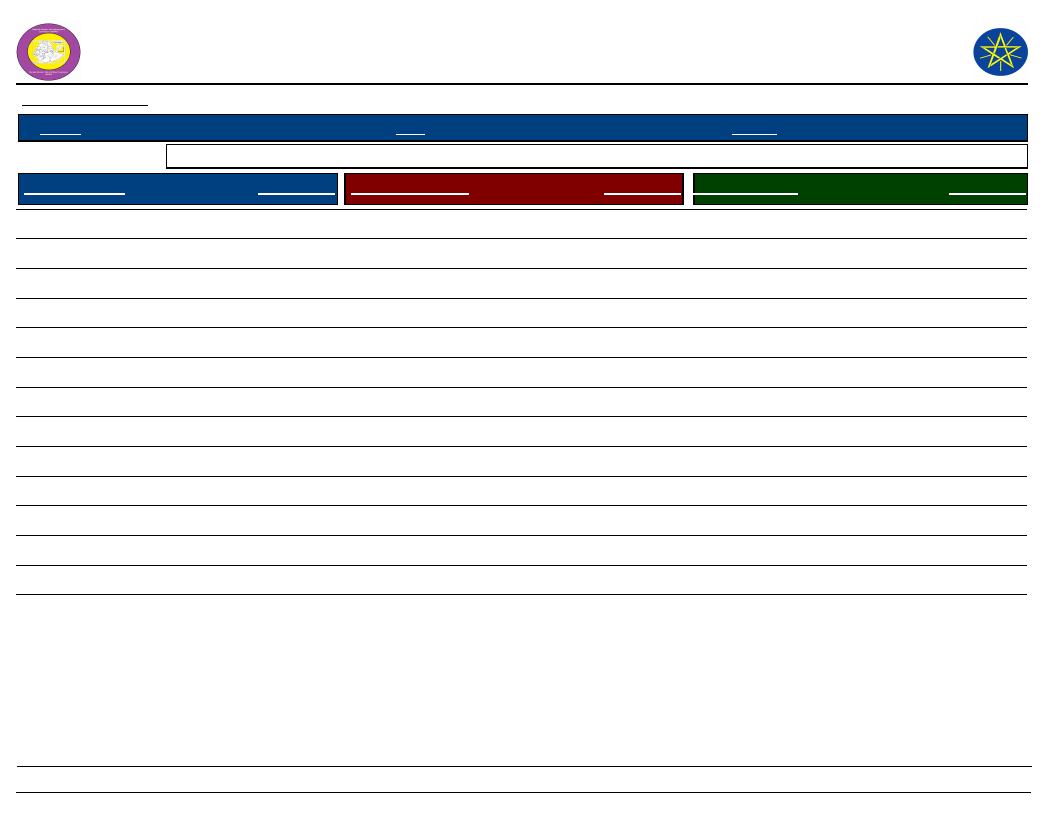
Wereda Disaster
Risk Profile
Data_Collected_Date
National Disaster Risk Management
Commission (NDRMC)
Wednesday, July 10, 2019
Region S.N.N.P
Zone GURAGE
Wereda MESKAN
Selected Indicator
Household Health Status - Households health condition and major health problems
Health Condition
HH Response Population Sickness
HH Response Children Sickness
HH Response
Good health
Ill for <3 months
Ill for more than three months
81.13
13.78
5.08
Chronic fever
Malaria
Diarrhea
Eye problems
Back ache
Stomach pain
Asthma
Mental illness
Others
Headache
Tuberculosis
Meningitis
Pneumonia/ lung problem
Hyper tension
12.50
7.31
6.84
8.02
1.65
10.38
2.83
6.13
26.18
9.91
1.42
0.24
4.48
2.12
Chronic fever
Malaria
Diarrhea
Mental illness
Others
Headache
Tuberculosis
Pneumonia/ lung problem
Eye problems
Asthma
29.51
4.92
18.03
1.64
14.75
9.84
1.64
8.20
8.20
3.28
227
Page 1 of 2
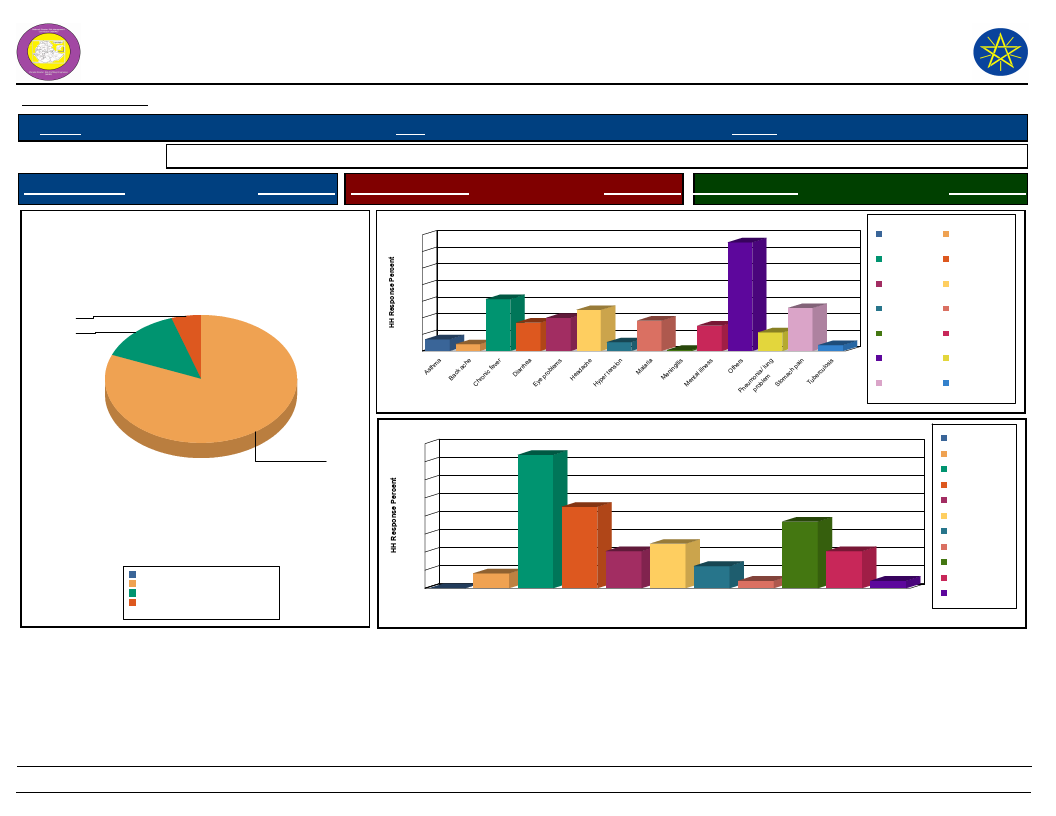
Wereda Disaster
Risk Profile
Data_Collected_Date
National Disaster Risk Management
Commission (NDRMC)
Wednesday, July 10, 2019
Region S.N.N.P
Zone GURAGE
Wereda MESKAN
Selected Indicator
Household Health Status - Households health condition and major health problems
Health Condition
HH Response Population Sickness
HH Response Children Sickness
HH Response
Health Condition of the Community
5.1
13.8
81.1
Good health
Ill for <3 months
Ill for more than three months
0.0%
81.1%
13.8%
5.1%
Total:
100.0%
Population Sickness in the Community
28
26
24
20
16
13
12
8
4
3
2
0
a
Asthm
Back ache Chronic fever
10
8
7
7
6
2
0
Diarrhea
s
problem
Eye
Headache Hyper tension
alaria
M
eningitis
M
ental illness
M
Population Sickness
10
4
1
OtherPsneumopnroiab/lelumng
pain
ach
Stom
Tuberculosis
Asthma
Chronic fever
Eye problems
Hyper tension
Meningitis
Others
Stomach pain
Back ache
Diarrhea
Headache
Malaria
Mental illness
Pneumonia/ lung
problem
Tuberculosis
32
28
24
20
16
12
8
4
0
0
Children Sickness in the Community
30
18
10
8
5
3
Asthma
Chronic
fever
Diarrhea
Eye
problems
Headache
Malaria
Children Sickness
2
Mental
illness
15
8
2
Others
Pneumonia/ Tuberculosis
lung problem
Asthma
Chronic fever
Diarrhea
Eye problems
Headache
Malaria
Mental illness
Others
Pneumonia/ lung
problem
Tuberculosis
228
Page 2 of 2
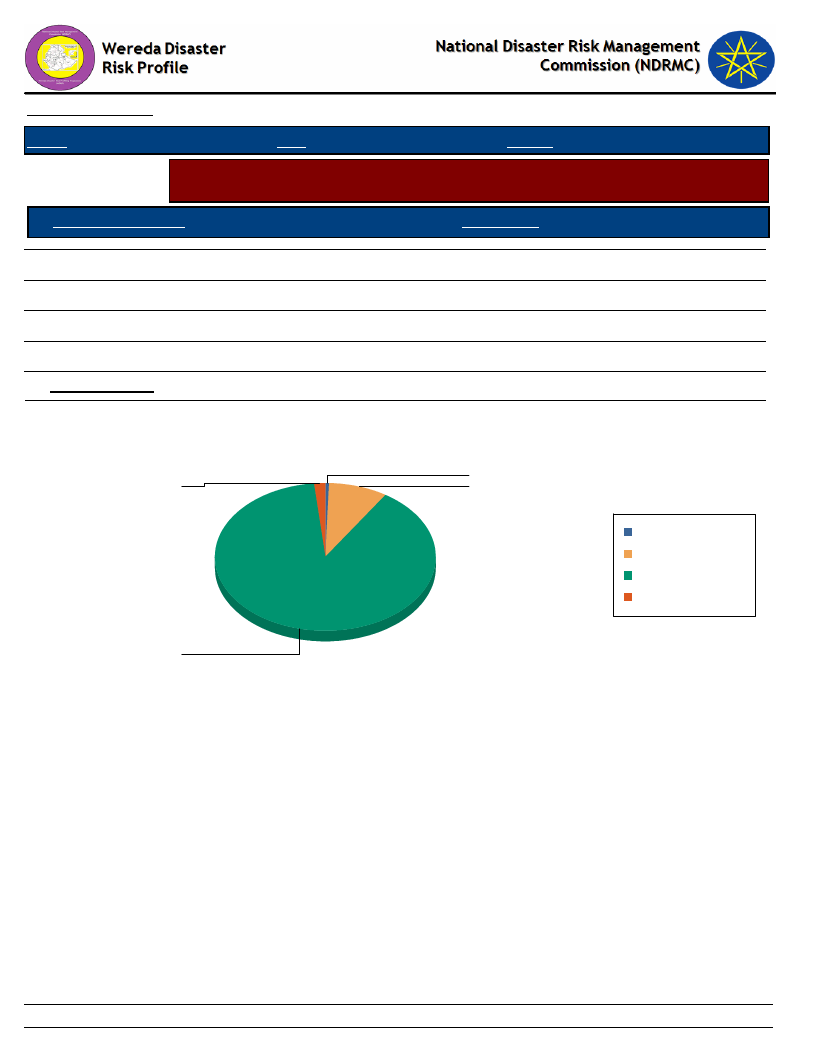
Data_Collected_Date
Wednesday, July 10, 2019
Region S.N.N.P
Zone GURAGE
Wereda MESKAN
Selected Indicator
Household Access to Sanitation - Percentage of households with access to
different kind of toilet facilities
Type of Toilet Facility
HH Response
Modern water closet
Ventilated, build in latrine
Outdoors latrine/hole on plot
No facilities/Open Space
HH Sharing Toilet
0.54
1.63
89.10
8.72
1.91
Household Responses to the type of toilet facilities in the community
0.5
1.6
8.7
Modern water closet
No facilities/Open Space
Outdoors latrine/hole on
plot
Ventilated, build in
latrine
89.1
229
Page 1 of 1
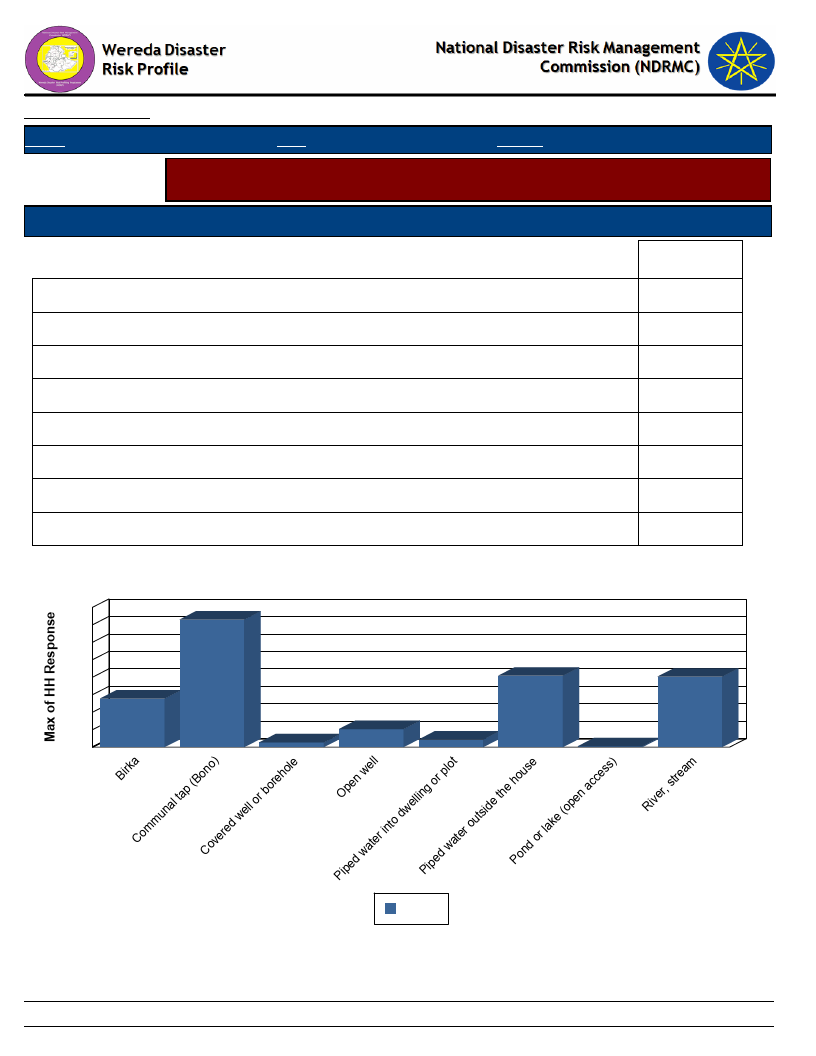
Data_Collected_Date
Region S.N.N.P
Zone GURAGE
Wednesday, July 10, 2019
Wereda MESKAN
Selected Indicator
Household Access to Drinking Water - Sources of drinking water for households
(response in %)
Sources of drinking water for Households
Priority of the Water Source
Main
Birka
Communal tap (Bono)
Covered well or borehole
Open well
Piped water into dwelling or plot
Piped water outside the house
Pond or lake (open access)
River, stream
13.90
36.51
1.36
5.18
2.18
20.44
0.27
20.16
Source of Drinking Water & Type of Source
40
37
35
30
25
20
15
14
20
20
10
5
5
1
2
0
0
Main
230
Page 1 of 1
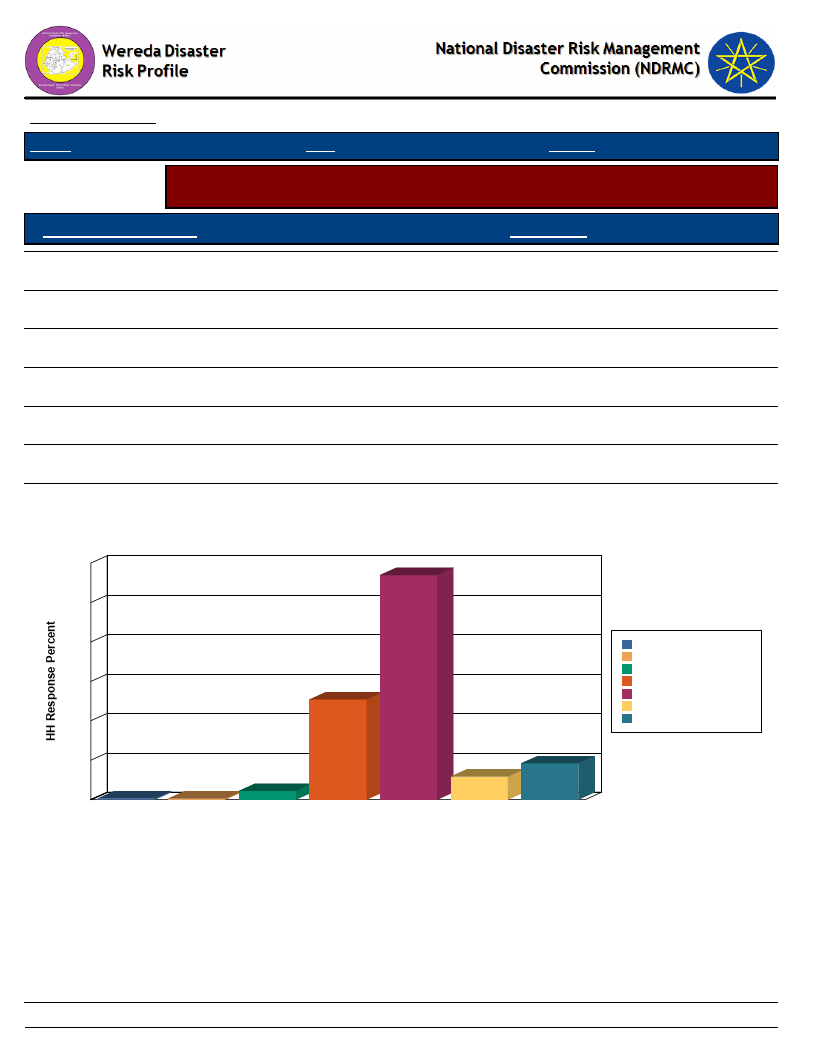
Data_Collected_Date
Region S.N.N.P
Zone GURAGE
Wereda
Wednesday, July 10, 2019
MESKAN
Selected Indicator
Household Access to Drinking Water - Households methods of treating drinking
water
Method of Treating Water
HH Response
Boil
0.28
Water Guard
9.22
Use filter
5.87
Other chemicals
25.42
Other Method (specify)
56.98
None
2.23
DK
0.28
Method of Treating Water by Households
60
57
50
40
30
20
10
0
0
Boil
25
2
0
9
6
DK
None
Other Other Method Use filter Water Guard
chemicals
(specify)
Water Treatment Method
Boil
DK
None
Other chemicals
Other Method (specify)
Use filter
Water Guard
231
Page 1 of 1
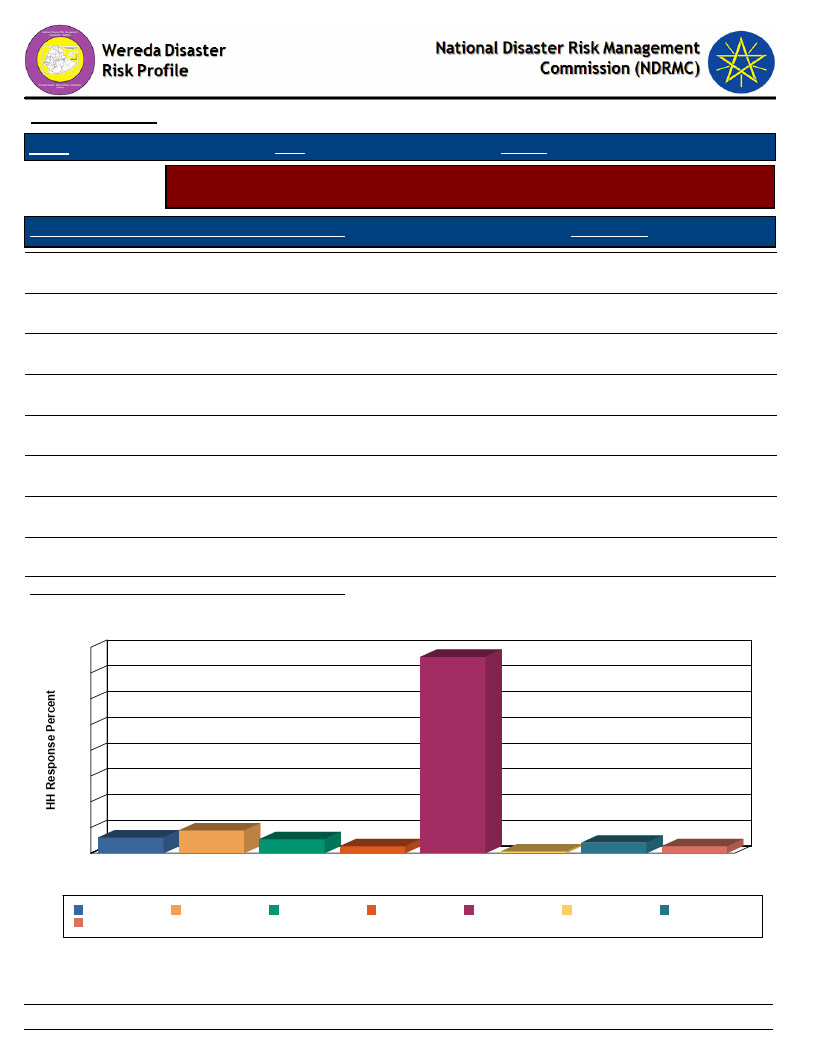
Data_Collected_Date
Wednesday, July 10, 2019
Region S.N.N.P
Zone GURAGE
Wereda MESKAN
Selected Indicator
Household Access to Drinking Water - Number of times households fetch water
in a week
Number of Times Households Fetch Water in a Week
HH Response
Once
1.09
Twice
1.09
Three times
1.63
Four times
2.18
Five times
3.54
Six times
0.27
Seven times
30.52
Eight and more
2.45
Average Number of Times HH Fetch Water Per Week
14.43
Number of Times HH Fetch Water in a Week
32
31
28
24
20
16
12
8
4
2
0
Eight and more
4
Five times
2
1
0
Four times
Once
Seven times
Six times
Number of Times HH Fetch Water in a Week
2
Three times
Eight and more
Twice
Five times
Four times
Once
Seven times
Six times
1
Twice
Three times
232
Page 1 of 1
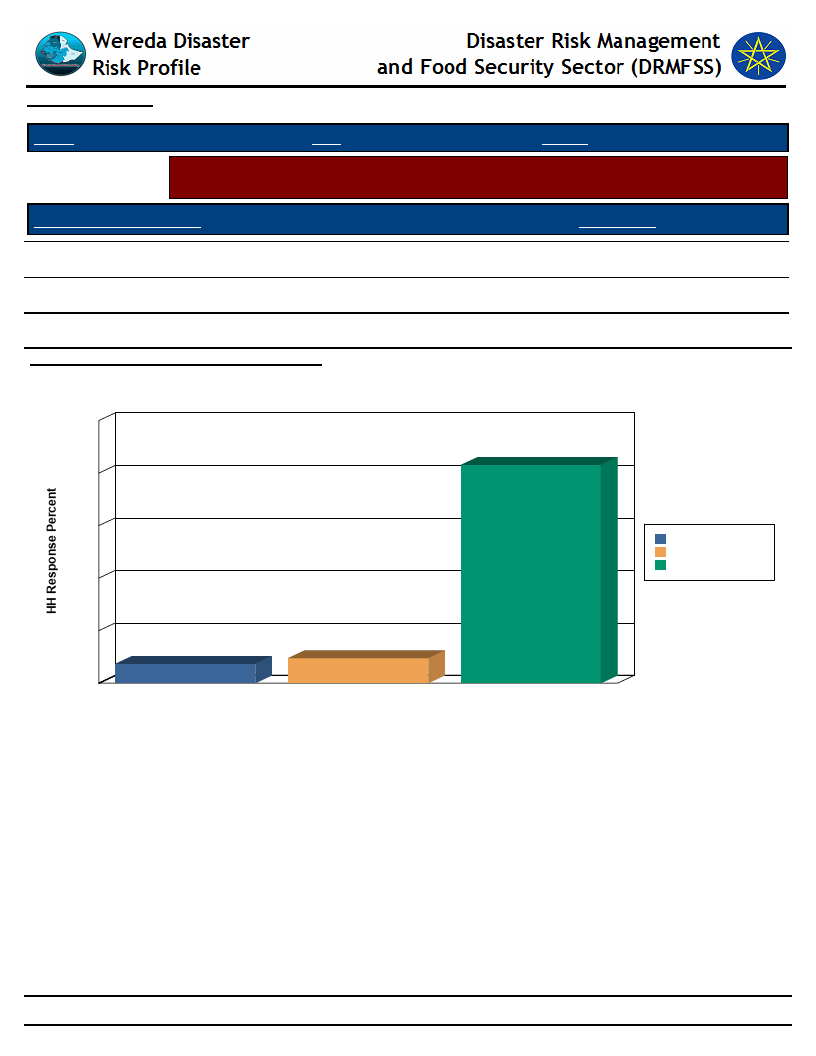
Data_Collected_Date
Wednesday, July 10, 2019
Region S.N.N.P
Zone GURAGE
Wereda MESKAN
Selected Indicator
Household Access to Drinking Water - Time taken per day to fetch water for
households
Time Taken To Fetch Water
HH Response
Less than 30 min
83.11
30 min - 1 hr
9.54
1 hr and Above
Average Number of Times Taken To Fetch Water
7.36
26.98
Time Taken To Fetch Water for the HH
100
83
80
60
1 hr and Above
30 min - 1 hr
Less than 30 min
40
20
7
10
0
1 hr and Above
30 min - 1 hr
Less than 30 min
Time Taken To Fetch Water
233
Page 1 of 1
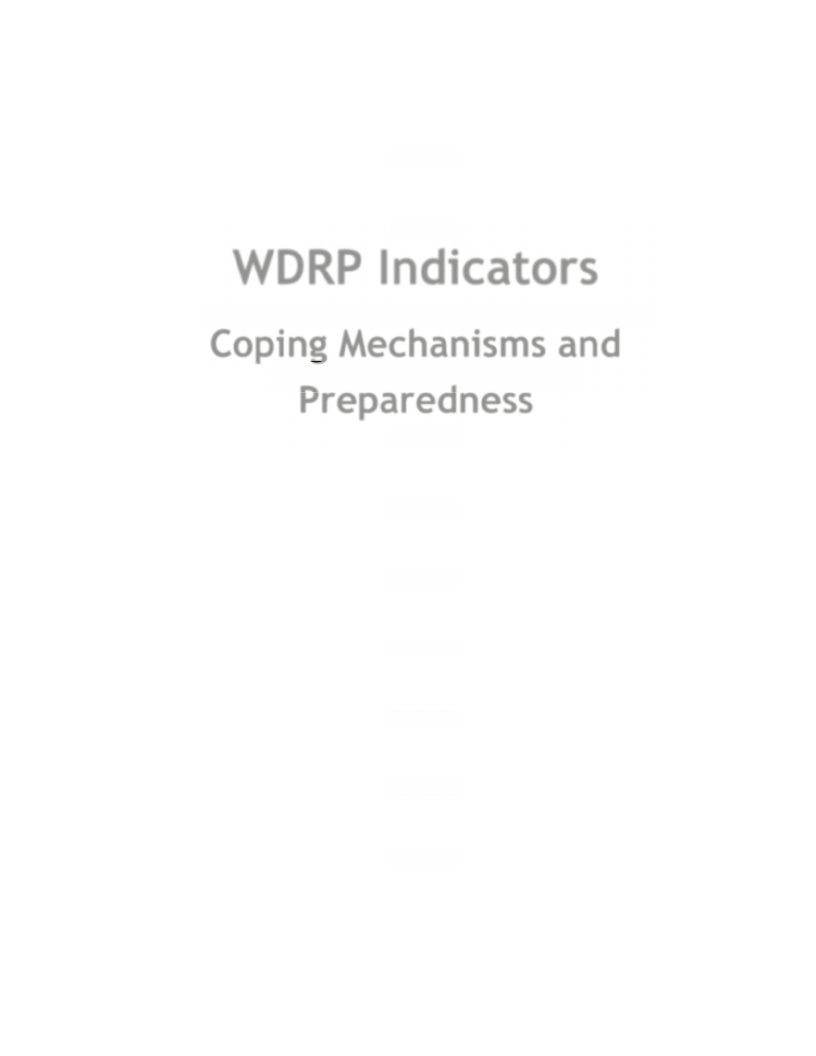
WDRP Indicators
Coping Mechanisms and
Preparedness
234
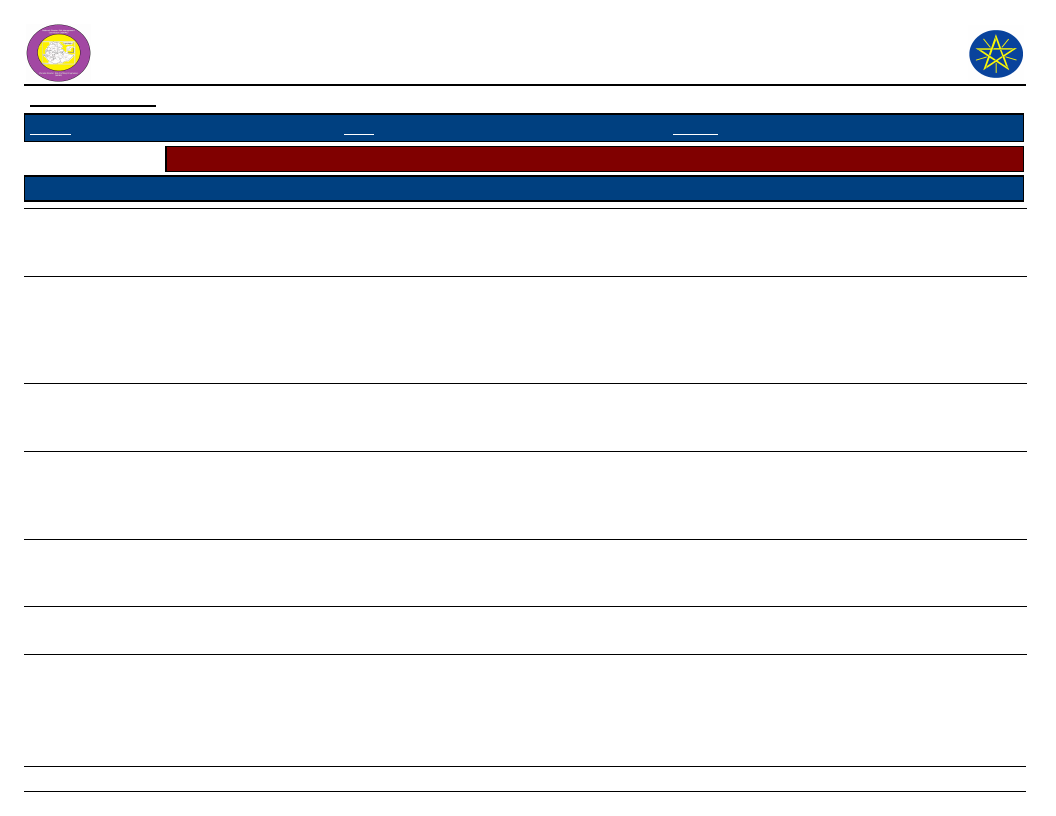
Wereda Disaster Risk
Profile
Data_Collected_Date
Region S.N.N.P
Zone GURAGE
Selected Indicator
KebeleName
Capacity: Community Preparedness against Sudden Onset Disasters
Precaution_1
Comment_1
Precaution_2
BATI FATO
BATI LEJANO
Helping each other
Report to wereda
To get others help
To get enabling
condition
Report to
government by
telephone
Collecting hoe
goods including
food
BECHE BULCHANO
BERESA
DEBO TUTO
Report to responsible
bodies
Migrate to relative
family those not
vulnerable
Migration to relative
those not vulnerable
To get government
support
No other possible
action better than
those to protect the
family
No other means and
time
Take children and
asset to safe area
from disaster area
Ready asset, food
and cloths
Collect goods,
needy food, cloths
DEBUB SHERSHERA
DEGAGOGOT
Selling and applying
help
Migrate with
children, elders and
cattle to relatives,
take away food items
To get others
supporter
To minimize effect
of disaster
Report to
government
Move
National Disaster Risk Management
Commission (NDRMC)
Wednesday, July 10, 2019
Wereda MESKAN
Comment_2
To get response
Precaution_3
Comment_3
Means of safe guard
and human live
Children no power
to resist
Coordinate
community
participation,
in order to the
quick measure
It is best activity
to prevent
sudden disaster
Immediate action
and early effective
Report to
wereda
To get response
No other possibility
it is good
preventive means
To get response
Report to the
wereda
To get
immediate
response
235
Page 1 of 4
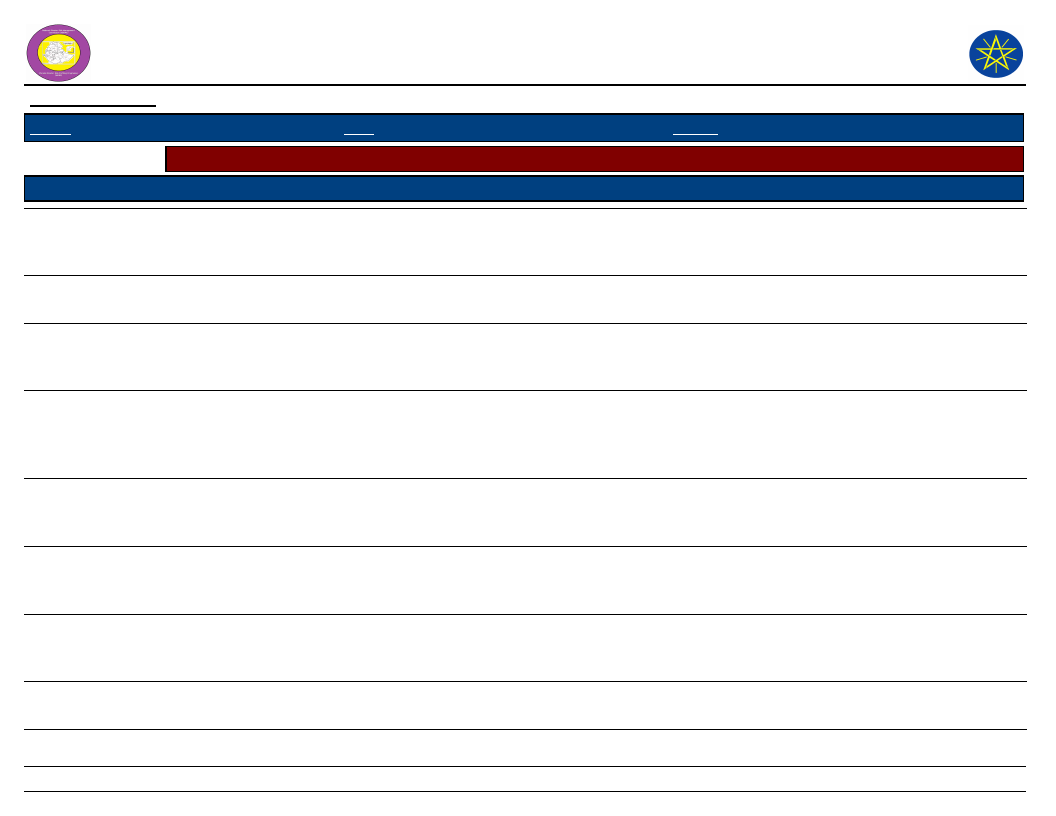
Wereda Disaster Risk
Profile
Data_Collected_Date
Region S.N.N.P
Zone GURAGE
National Disaster Risk Management
Commission (NDRMC)
Wednesday, July 10, 2019
Wereda MESKAN
Selected Indicator
KebeleName
Capacity: Community Preparedness against Sudden Onset Disasters
Precaution_1
Comment_1
Precaution_2
Comment_2
Precaution_3
Comment_3
DIDA
DIRAMA
DOBENA
GIDENA ABORAT
GOYBAN
ILE
INSENO USME
JOLE ANDENYA
Protect children and
asset from disaster
Protect children and
asset from disaster
Applying the others
help
Report to concerned
body
Inform to kebele
administration
Report to wereda
Report to wereda
administrative
authorities
Move children and
elders to relative
To prevent effect of
flood or fire
Need help from
neighbors
To protect our
children and asset
To get the nearest
peoples help
Report to
government
The disaster was
over our power or
potential
Gathering each
other
Give information
about sudden
disaster
Responsible to solve
the problem of the
community
To get any possible
measure
Report to wareda
early warning
Collect home
goods, food and
seeds
To get support
Report to
government
body
To get response
Go get government
help
Because the first
action/activity is
community have
helping adaptation
To decrease effect
of disaster
Move our
children and
asset
Shouting
To prevent the
effect of
disaster
To get help
It can prevent
human life
Coordinate
communities to
take measure
It is the only
possible ways
/actions
No power to protect
the disaster
Prevent ready food
and house material
To minimize food
problem
236
Page 2 of 4
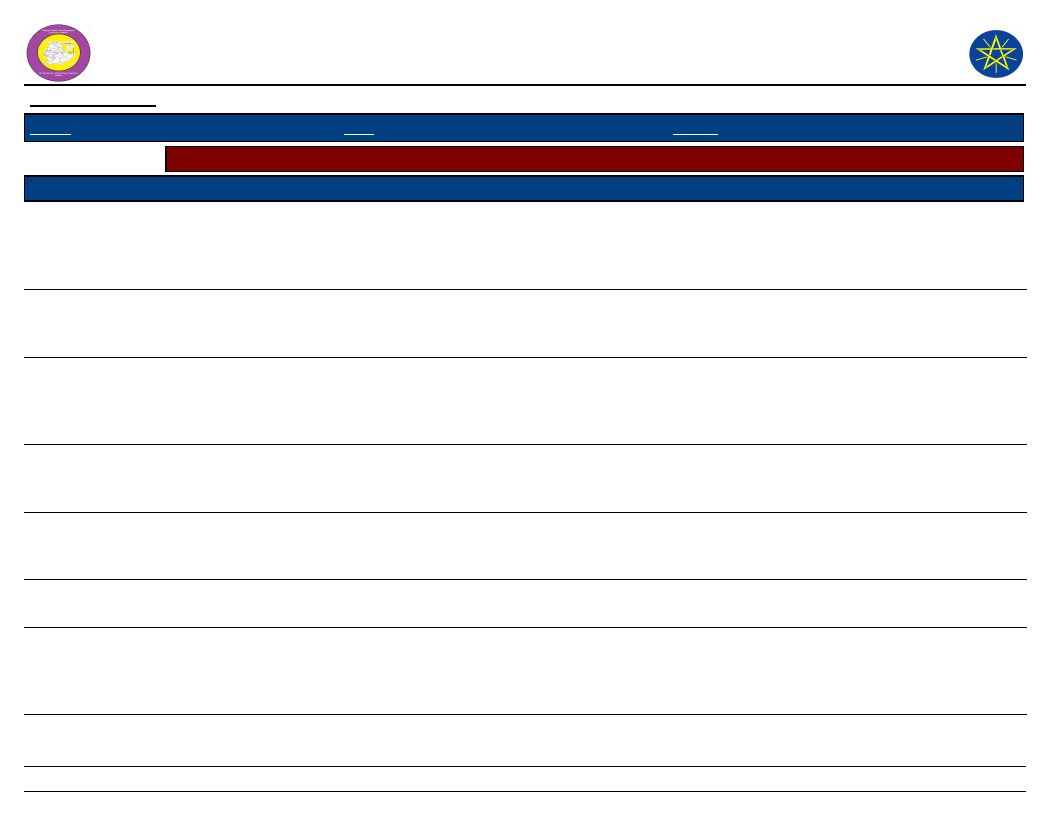
Wereda Disaster Risk
Profile
Data_Collected_Date
Region S.N.N.P
Zone GURAGE
National Disaster Risk Management
Commission (NDRMC)
Wednesday, July 10, 2019
Wereda MESKAN
Selected Indicator
Capacity: Community Preparedness against Sudden Onset Disasters
KebeleName
JOLE HULETENYA
Precaution_1
Move children, elder,
animals and asset to
relatives
MEKICHO
MESERETEWEGERA
MO
Move children and
elders families and
asset
Report to wereda
administration
authority
MIKAELO
Reporting to wereda
MIRAB IMBOR
MIRAB MESKAN
OCHAGENEME
Asking help from
neighbors
Asking neighbor help
Reporting to wereda
SEMEN SHORSHORA
Report to kebele
administration
Comment_1
To prevent the
effect of disaster
Precaution_2
Apply other help
from the area
They have no power
Asking neighbor for
help
It is the nearest
authorities
Collect and gather
home goods, seeds
ready food
To get response
For flood and fire
must ask others help
Collecting and
secure goods, seed
and cloth to home
Move children and
asset
To get help from
fire and food
It is the nearest
authority
Report to kebele
administration
Collect seeds, good
and close outside
the home
To minimize the
effect of disaster
Asking help from
any person
237
Comment_2
To control the
disaster and help to
the assets for the
area
To get help
Because it is better
alternative to
protect human life
To protect asset
and goods from the
disaster
To protect them
To get response
from government
It is good
To get help
Precaution_3
Report to the
government by
telephone
Comment_3
To get help
from the
government
Report to
government by
telephone
Feeding is done
with
economical like
enset
Move family to
relative
To get
government
response
Because it is
easy method
Report to
responsible
bodies
Migrate
To get response
To save life
Move the
families to the
relatives
families
It is easy and
good method
Page 3 of 4

Wereda Disaster Risk
Profile
Data_Collected_Date
Region S.N.N.P
Zone GURAGE
National Disaster Risk Management
Commission (NDRMC)
Wednesday, July 10, 2019
Wereda MESKAN
Selected Indicator
KebeleName
Capacity: Community Preparedness against Sudden Onset Disasters
Precaution_1
Comment_1
Precaution_2
Comment_2
Precaution_3
Comment_3
SHERSHERA
MACHMENA
WEJABATI
WITA
WOLENSHO
ANDENYA
YETABON
YIMERWACHO
2NYA
YIMERWACHO
3NYA
Migration
Reporting to wereda
Seed collecting
Collecting goods,
seed and cloths
Move family and
asset to neighbors
Asking neighbors help
Report to wereda
administration
authorities
For the moment to
save life and asset
from hazard
They are responsible
body
To mitigate damage
It is easily method
to protect asset and
goods from the
disaster
To prevent the
effect of flood, fire
etc
To get others help
to control disaster
To get any possible
measure
Report to
responsible body
Collecting goods,
and animal feed
Coordinate
community
Report to the
wereda
Ask help from any
body
Report to
government bodies
Collecting home
goods, seed and
food
To get response
To protect food
shortage and
prevent asset
To control the
disaster
It is the only
method to transmit
information
To save life
To get response
To save life
Coordinate
community to
take temporary
measure
It is the only
fast action to
prevent sudden
disaster
Move the
family to
relative family
Because no
other possibility
for at that time
Report to
government
To get response
Move families
and asset
To save life and
asset
238
Page 4 of 4
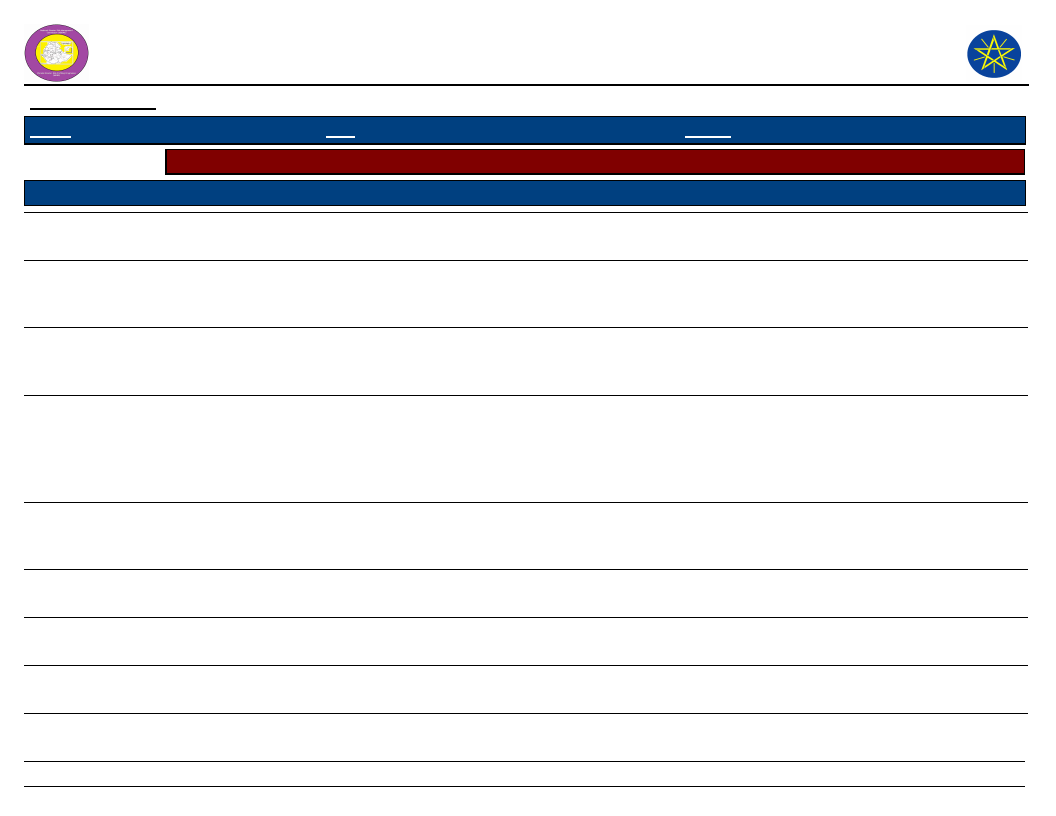
Wereda Disaster
Risk Profile
Data_Collected_Date
Region S.N.N.P
Zone GURAGE
National Disaster Risk Management
Commission (NDRMC)
Wednesday, July 10, 2019
Wereda MESKAN
Selected Indicator
Capacity: Community Preparedness against Increase in Disaster Intensity
KebeleName
Precaution_1
Comment_1
Precaution_2
Comment_2
Precaution_3
Comment_3
BATI FATO
BATI LEJANO
BECHE BULCHANO
BERESA
Save money and
assets
Will do water
harvest in the
cultivated land
Construct
permanent water
diversion
Supply drought
resistant and
early mature
variety
To use during
incident
Will do easily and
with less expenses
To control flood
DEBO TUTO
DEBUB SHERSHERA
DEGAGOGOT
DIDA
Government and
NGOs will be solve
the water problem
Planting drought
resistant plants
Improve sowing
habit
Conservation
construction
It is not solve with
the community
economic level
To control drought
and flood
To cope
To control the
effect of flood
Governmental aid
Forestation
It is adaptive activity
in the community
Planting drought
and flood resistant
plants
Strong soil and
water conservation
activities
Strong activity of
soil ad water
conservation
Shift construction of
house
Migration
Saving asset
To resist drought and
sudden flood
Availability of
resource
It is the cheapest
method
To control flood
To get income
To use after incident
Job
opportunities
Tree plantation
in the high
sloppy area
Save asset
Resettlement
Working for
food
Because stony
and sandy due
to this have
little cultivated
land
The problems of
sloppy area
To solve the
problem
Decrease effect
of disaster
To get food
239
Page 1 of 4
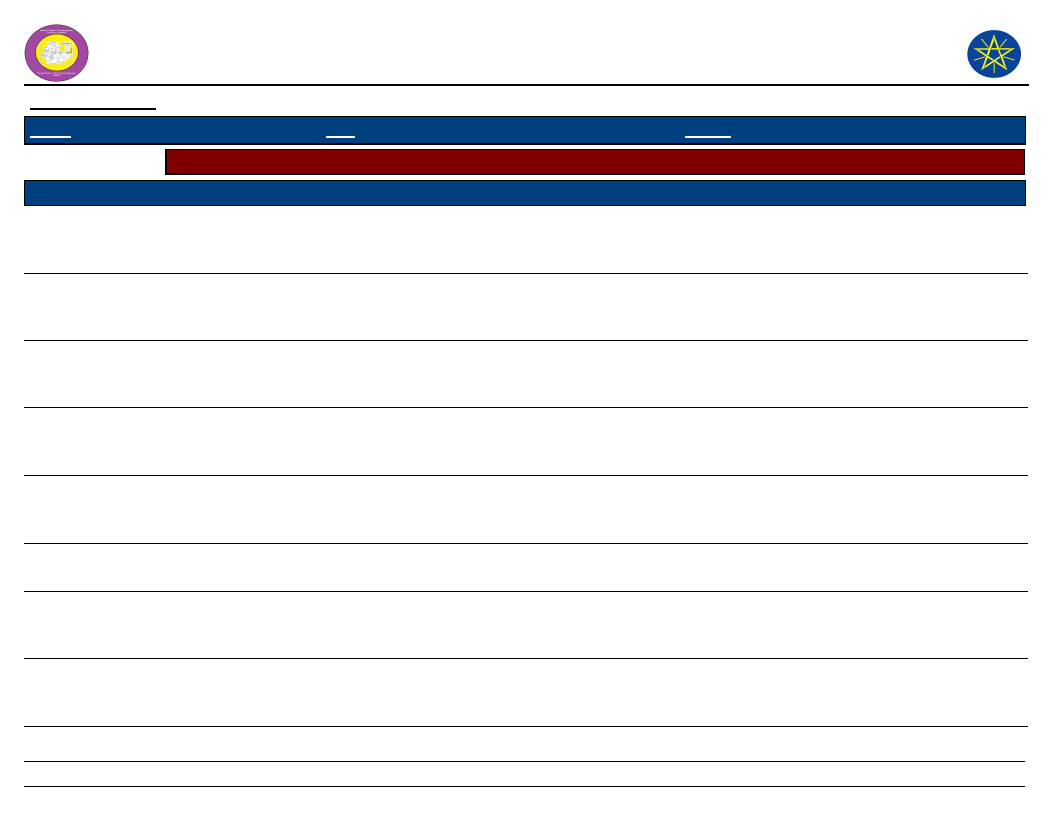
Wereda Disaster
Risk Profile
National Disaster Risk Management
Commission (NDRMC)
Data_Collected_Date
Region S.N.N.P
Zone GURAGE
Wereda MESKAN
Wednesday, July 10, 2019
Selected Indicator
Capacity: Community Preparedness against Increase in Disaster Intensity
KebeleName
DIRAMA
DOBENA
GIDENA ABORAT
GOYBAN
ILE
INSENO USME
JOLE ANDENYA
JOLE HULETENYA
Precaution_1
Sowing disaster
resistant crops and
livestock
Saving assets
Saving the present
asset or resource
Cut off drainage
A forestation
Make strong water
harvesting
Soil and water
conservation
Saving food, feed
and money and
other resource
Comment_1
To resist disaster
Precaution_2
Saving money and
crop production
To get food at the
disaster time
Construct soil and
water conservation
No other option
To minimize effect
of disaster
Migrate to other
urban and rural
area
Asking food aid
Availability of forest
tree seedling
Less expense
Soil erosion,
increase soil
fertility
To use for future
disaster period
Soil and water
conservation
measure
Increase forest tree
plantation
Water harvest in to
cultivated land
Sowing disaster
resistant early
matured crops
Comment_2
To use disaster time
To solve the problem
No other option
To prevent human
death due to food
gap
To increase soil
moisture
To resist and prevent
drought, flood, frost
and other hazards
Precaution_3
Comment_3
Dig under
ground water
To resist and to
get water at the
drought time
Sowing early
mature crops
Water
harvesting
activities
To fulfill food
gaps
There is cheep
construction
inputs
Tree plantation
To control
erosion and
climate change
240
Page 2 of 4
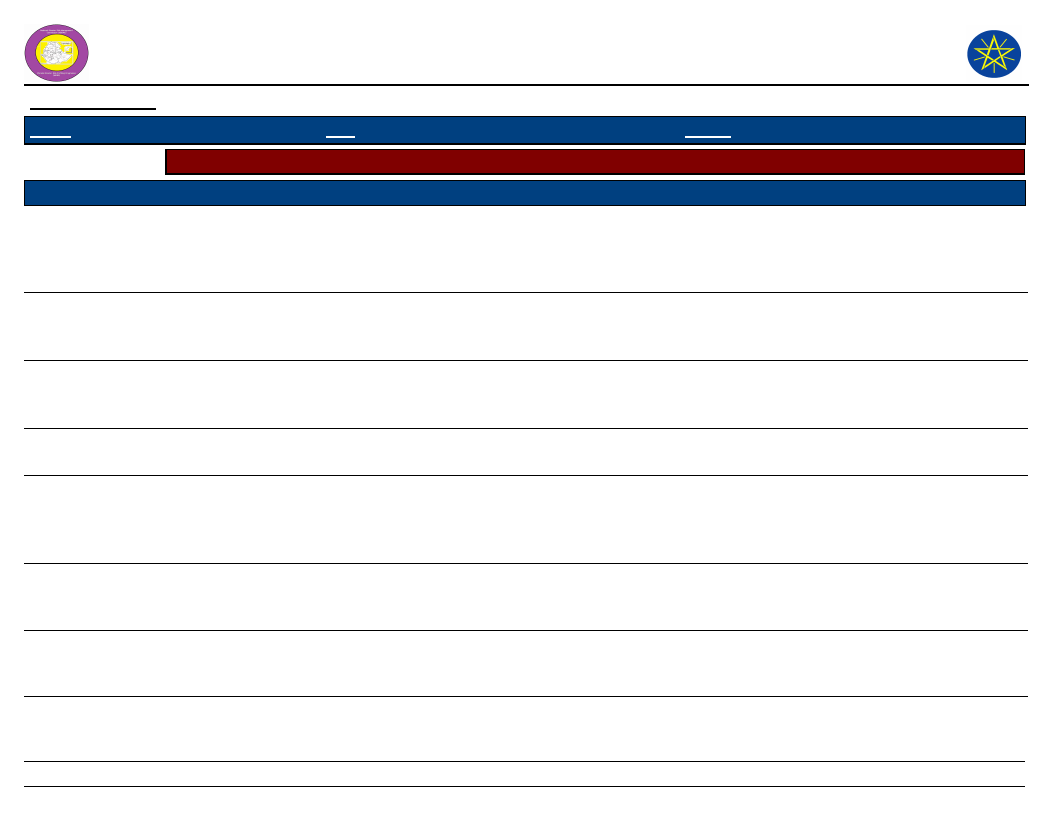
Wereda Disaster
Risk Profile
National Disaster Risk Management
Commission (NDRMC)
Data_Collected_Date
Region S.N.N.P
Zone GURAGE
Wereda MESKAN
Wednesday, July 10, 2019
Selected Indicator
Capacity: Community Preparedness against Increase in Disaster Intensity
KebeleName
MEKICHO
Precaution_1
Save our assets
Comment_1
To prevent
Precaution_2
Construct
conservation
structures
MESERETEWEGERA
MO
MIKAELO
MIRAB IMBOR
MIRAB MESKAN
OCHAGENEME
Construction of
strong soil and
water conservation
Construction of
soil and water
conservation
Saving
Asking relief and
material from
government and
NGOs
Water harvesting
activity
It is a good
controlling method
To resist disaster
time
Disaster can not
solved or controlled
alone
Any farmers will do
easily
Better tree
plantation
Tree plantation
Soil and water
conservation
Plant drought and
flood resistant and
early matured
plants
Forestation
SEMEN SHORSHORA
Harvesting water
To minimize
shortage of water
Planting early
matured crops
Comment_2
To control flood
effects
To get three seedling
Precaution_3
Planting
drought
resistant
plant/enset
Comment_3
To control
drought
Due to high sloppy
and high run off
To resist flood
To survive from
disaster
Ditch diversion
To resist flood
Distribute forest tree
To fill food gap
Soil and water
conservation
Fattening and
poultry
production
Construction
good abundant
in our kebele
To generate
income
241
Page 3 of 4
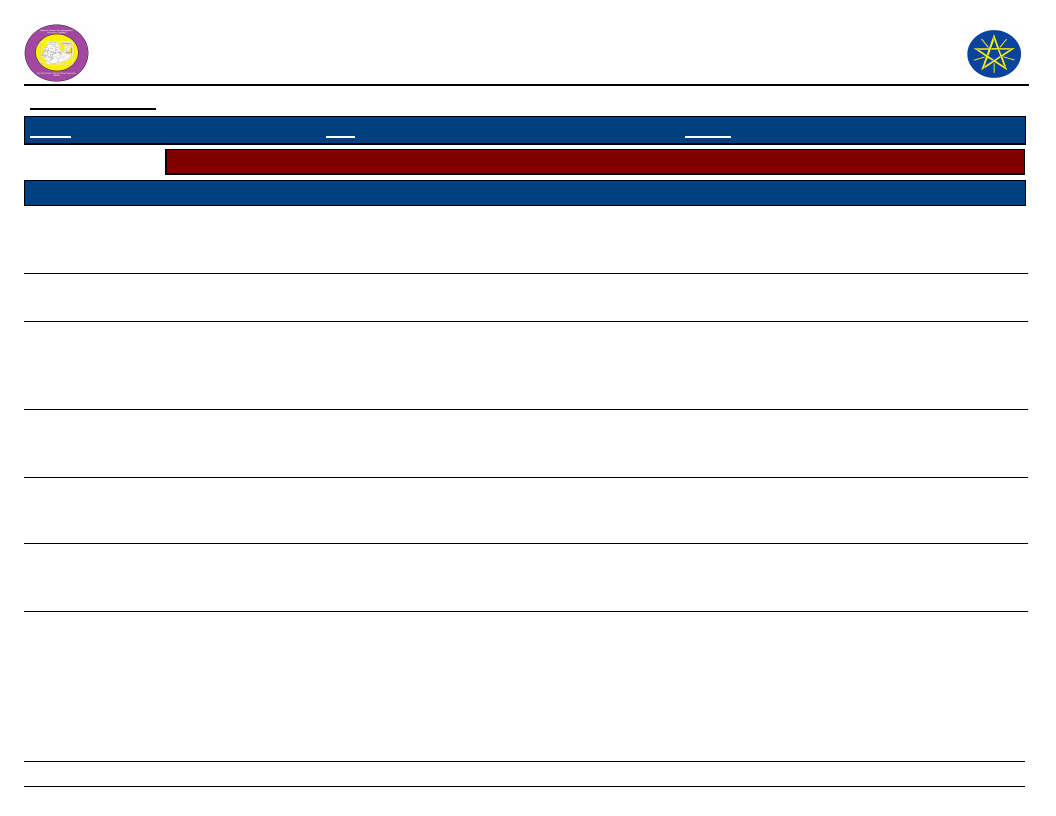
Wereda Disaster
Risk Profile
National Disaster Risk Management
Commission (NDRMC)
Data_Collected_Date
Region S.N.N.P
Zone GURAGE
Wereda MESKAN
Wednesday, July 10, 2019
Selected Indicator
Capacity: Community Preparedness against Increase in Disaster Intensity
KebeleName
SHERSHERA
MACHMENA
WEJABATI
WITA
WOLENSHO
ANDENYA
YETABON
YIMERWACHO
2NYA
YIMERWACHO
3NYA
Precaution_1
Construction of
conservation as a
group
Water harvesting
Water harvest
Support from
government and
NGOs
Planting enset
Using natural
resource
effectively
Water harvesting
activities
Comment_1
To control flood and
soil erosion
Precaution_2
A forestation
To resist drought
A forestation
To control drought
damage
It is because above
the community
To resist drought
and other hazards
Constraction of
diffienret soil and
water conservation
acivities
Construction of soil
and water
conservation
Saving asset and
food
No other option
Migration
Comment_2
To control soil
erosion, flood,
improved soil
To distribute forest
tree natural resource
To control soil
erosion
Precaution_3
Construct water
way
Comment_3
Soil and water
conservation
Will get material
with cheep
Tree plantation
Because the
area topography
To prevent the future
disaster effect
No other option
Construct soil
and water
conservation
Government aid
To control the
effect of flood
and soil erosion
With less labor
Shift rain feed
agriculture to
irrigation
Available of ground
water in the kebele
242
Page 4 of 4
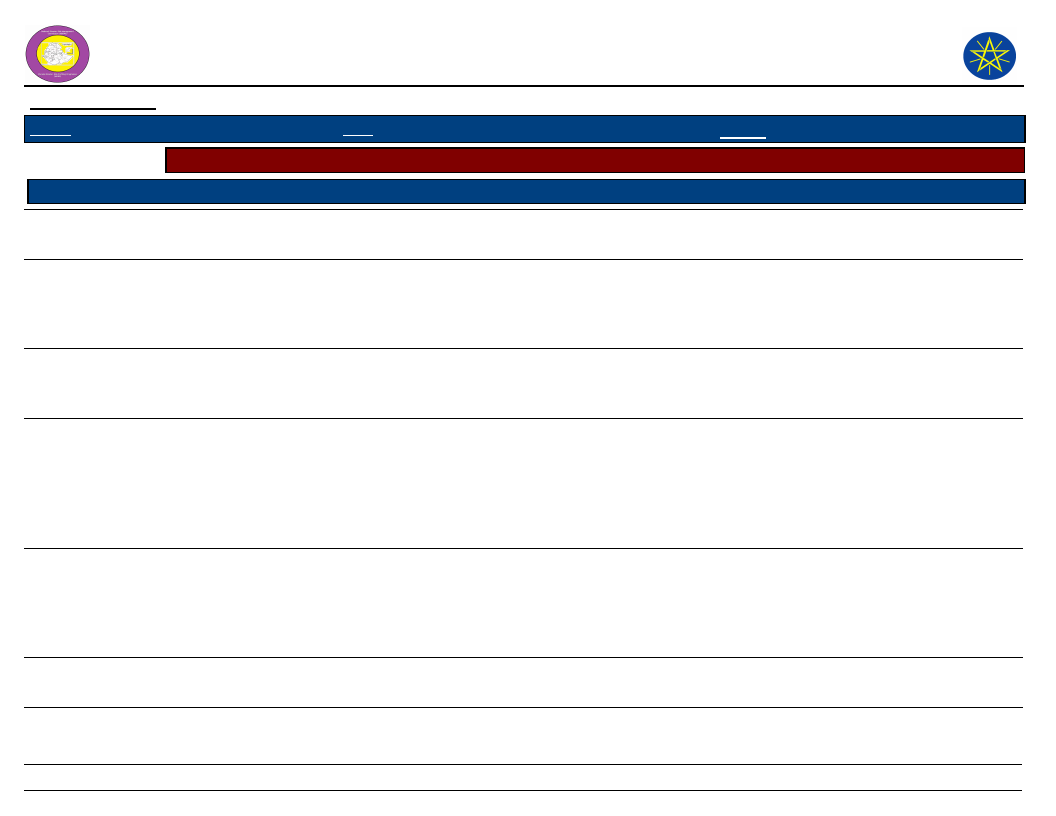
Wereda Disaster
Risk Profile
Data_Collected_Date
Region S.N.N.P
Zone
GURAGE
Selected Indicator
Capacity: Community Preparedness against Disasters
Kebele Name
Precaution 1
Comment 1
Precaution 2
BATI FATO
BATI LEJANO
Saving money
Report to kebele
administration
To prevent the
disaster
The nearest response
territories
Applying relief
Shift family to
relevant family
BECHE
BULCHANO
BERESA
DEBO TUTO
DEBUB
SHERSHERA
Divert the flood
ways to water way
To prevent the effect
of flood
Plant early mature
crops, income
generating
To survive and get
income
Re plant the
damaged
cultivated land
with any disaster
To compensate the
lost production, to
insure food security in
the future
Saving asset for the
sever times
To resist the effect of
disaster
Soil and water
conservation
Replant the
damage cultured
land with
drought and
flood
Organizing the
community to
take possible
action like soil
bund, plantation
Diversion
activities
National Disaster Risk Management
Commission (NDRMC)
Wednesday, July 10, 2019
Wereda MESKAN
Comment 2
To resist the
heavy disasters
It is the only
effective and
efficient
measure
To control the
disaster of flood
and soil erosion
To compost the
host production,
to insure food
security in the
future
There is
different
opportunity to
do this easily
Precaution 3
Planting resistant
crops
Coordinate the
community in order
to prevent the
disaster
Save our asset,
food and feed
Organize the
community to take
possible action
together
Comment 3
To resist the
disasters
To take quick
action
To pas the severity
of drought and
flood
Have much and
chipset natural
rescores helps for
construct the
activities like soil,
stone, wood
To control flood
243
Page 1 of 5
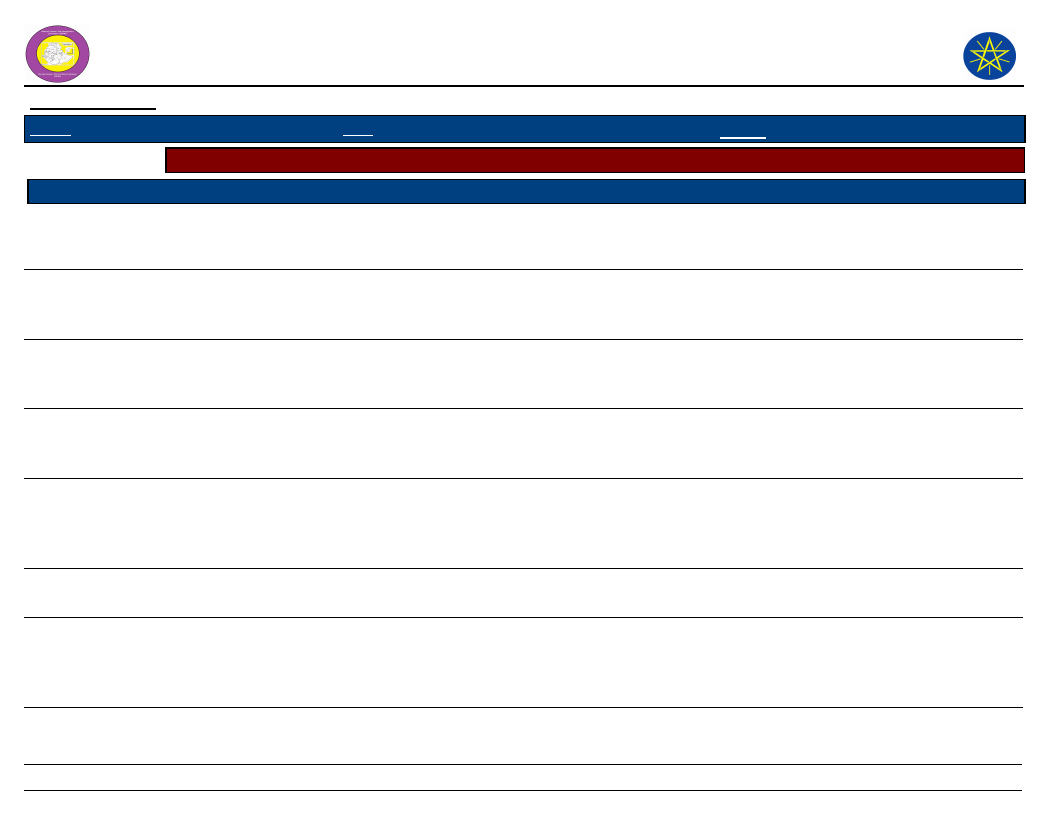
Wereda Disaster
Risk Profile
Data_Collected_Date
Region S.N.N.P
Zone
GURAGE
Selected Indicator
Capacity: Community Preparedness against Disasters
Kebele Name
DEGAGOGOT
Precaution 1
Minimizing number
of cattle
Comment 1
To decrease death of
animals
Precaution 2
Minimize extra
cost
DIDA
Save food and
asset
To prevent the sever
time
Drainage
construction
DIRAMA
DOBENA
GIDENA ABORAT
GOYBAN
ILE
Divert the flood
To resist risk of flood
Saving food, money
and assets
To prevent the effect
of disaster
Strong storing
system
To protect from flood
Improve our saving
habits
Move family and
asset to relative
To decrease the effect
of disasters
It is a good possibility
to get food and shelter
Sowing flood
and drought
resistant crops
Diversities water
way
conservation
construct soil
and water
conservation
structure
Cultivate early
mature crops
Coordinate the
communities in
order to prevent
the disaster
National Disaster Risk Management
Commission (NDRMC)
Wednesday, July 10, 2019
Wereda MESKAN
Comment 2
To improve
coping abilities
Precaution 3
Move children to
relatives
To protect the
effect of flood
and disease
To resist disaster
effect
Comment 3
To decrease
negative effect of
disasters
To protect flood
effect
Construct our
house at sage area
To protect the
effect of flood
To conserve or
remain and
control excess
water
To fulfill food
gaps
Enable to bring
quick response
Saving cereals and
other food and
livestock feed
To resist the
expected disaster
time
Construct good
cutoff drainage
To decrease
negative effect
244
Page 2 of 5
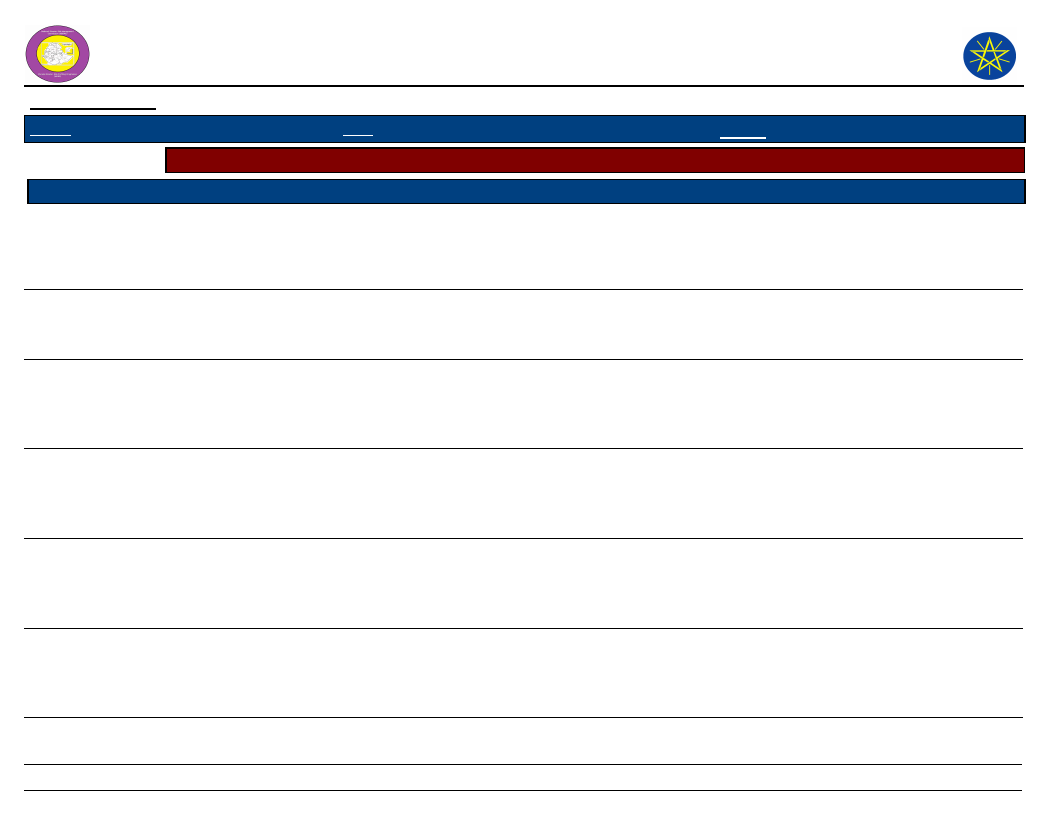
Wereda Disaster
Risk Profile
Data_Collected_Date
Region S.N.N.P
Zone
GURAGE
Selected Indicator
Capacity: Community Preparedness against Disasters
Kebele Name
INSENO USME
Precaution 1
Repot local kebele
authorities
Comment 1
Because the nearest
responsible
administrative
Precaution 2
Move families to
relative family
JOLE ANDENYA
JOLE HULETENYA
Taken measure to
control the disaster
together
Saving our food,
money and asset
To mitigate the
severity of disaster
To prevent from effect
of disaster
Reporting to
wereda
Diversion water
way
construction
MEKICHO
MESERETEWEGER
AMO
Construct soil and
water conservation
structures and
group every year
Report to local
kebele
To prevent the effect
of flood
Because both are the
nears to or locations
Save money and
asset
Shift families to
relevant families
MIKAELO
Replant the
damage cultivated
land as soon as
possible
To compensate the
loss
Temporarily
measure
National Disaster Risk Management
Commission (NDRMC)
Wednesday, July 10, 2019
Wereda MESKAN
Comment 2
No any other
alternative
better than this
Will get response
and additional
control activities
To control the
effect of disaster
To prevent
financial and
food shortage
This is the best
alternative to
protect human
life
To minimize the
disaster severity
Precaution 3
Coordinate the
communities to
prevent the
disaster
Planting dropout
and flood
resistance crop and
plants
Planting
permanent and
resistant
plants/Enset
Coordinate the
community in order
to prevent the
disaster
Organized the
population take
possible action
Comment 3
To take fast action
To control from
drought and flood
effects
permanently
To resist flood and
drought
To take quick
action agent to
the disaster
Early and quick
control the effects
245
Page 3 of 5
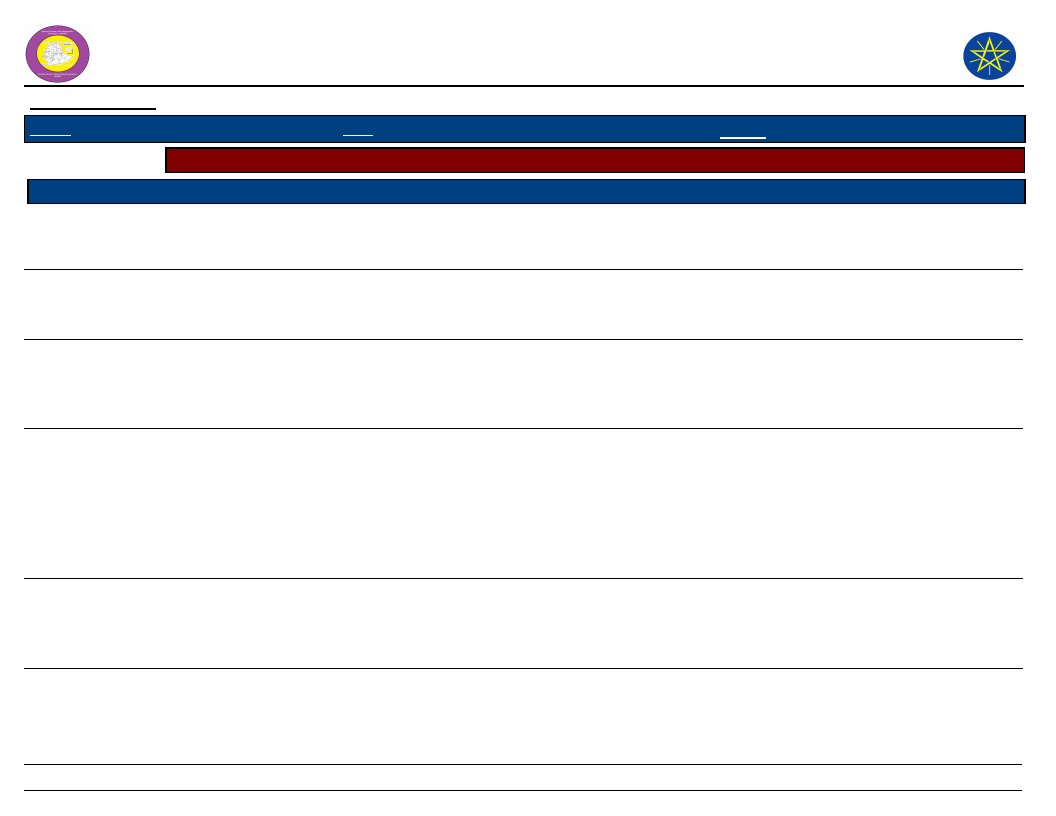
Wereda Disaster
Risk Profile
Data_Collected_Date
Region S.N.N.P
Zone
GURAGE
Selected Indicator
Capacity: Community Preparedness against Disasters
Kebele Name
MIRAB IMBOR
Precaution 1
Save asset
Comment 1
To resist disaster and
minimize migration
Precaution 2
Build soil and
water
conservation
MIRAB MESKAN
Construction soil
and water
conservation
To protect flood
Saving money,
food, feed and
other asset
OCHAGENEME
Report to wereda
Has responsible
Move families to
relative gather
with good and
goods
SEMEN
SHORSHORA
Develop saving
habit
To minimize negative
effect of disaster
Construct good
cut off drainage,
cultivate early
mature crops,
consternate on
off farm
activities
SHERSHERA
MACHMENA
Construct check
dam, construct soil
and water
conservation
To control erosion and
flood
Storage of food
WEJABATI
Reporting
To get response
Move family,
goods and food
246
National Disaster Risk Management
Commission (NDRMC)
Wednesday, July 10, 2019
Wereda MESKAN
Comment 2
To control flood
Precaution 3
Comment 3
To resist the
disaster
Planting resistant
plants/Enset
To resist drought
It is possible
opportunity to
get food and
shelters
To minimize
negative effect
of disaster
Coordinate
community in order
to prevent the
disaster
Afforestation
To bring quick
response
To minimize soil
erosion and to
balance climate
change
To prevent food
scarcity
Storing livestock
feed
It is only option
Coordinate
communities in
order to prevent
disaster
Remove the
problem of
livestock feed
problem
Enable to bring
quick response
Page 4 of 5
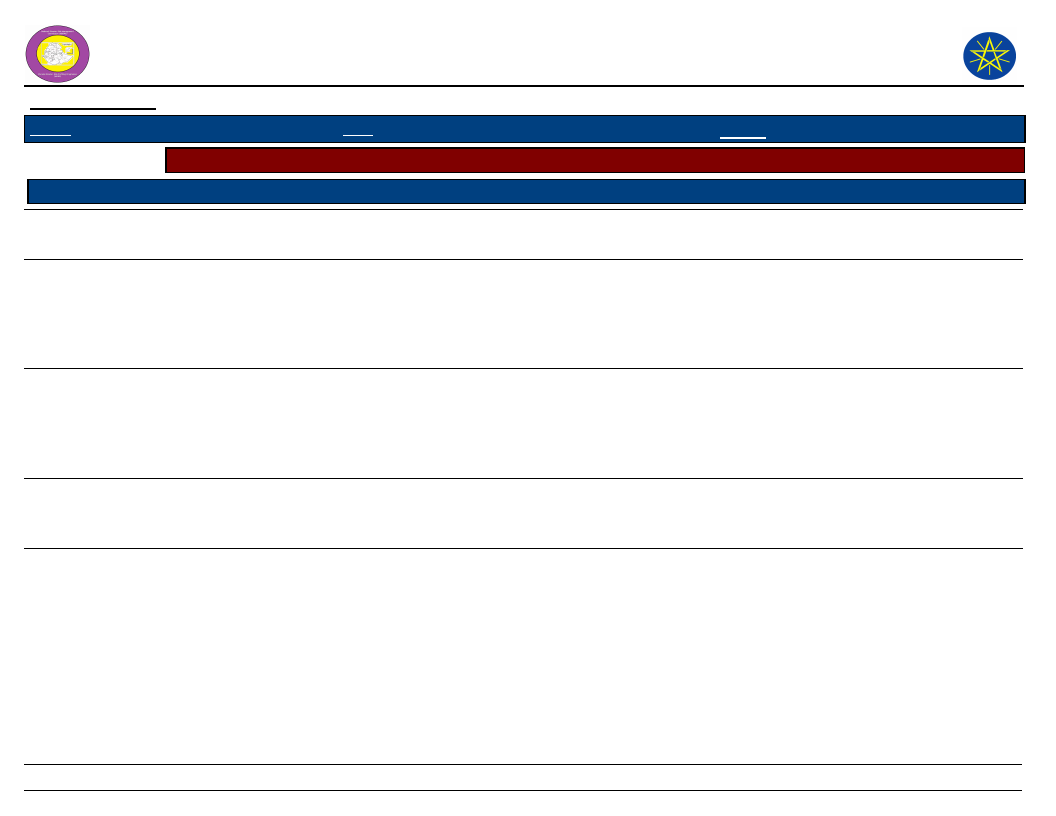
Wereda Disaster
Risk Profile
Data_Collected_Date
Region S.N.N.P
Zone
GURAGE
Selected Indicator
Capacity: Community Preparedness against Disasters
Kebele Name
Precaution 1
Comment 1
Precaution 2
WITA
WOLENSHO
ANDENYA
YETABON
YIMERWACHO
2NYA
Reporting to
wereda
Replant the
damage cultivated
land
Cultivate resistant
and early matured
plants
Saving and store
food and feed
To get response
To commonest the lost
product
To prevent to disaster
effects to the future
Take temporary
measure
Organizing the
community to
take possible
action make soil
bund
Construct soil
and water
conservation
and diversion
ditches
Saving money,
food and feed
YIMERWACHO
3NYA
Report to kebele
local authorities
Because the nearest
responsible
administration
Sift families to
relevant families
National Disaster Risk Management
Commission (NDRMC)
Wednesday, July 10, 2019
Wereda MESKAN
Comment 2
To migrate the
disaster
To protect easily
Precaution 3
Comment 3
To control effect
of flood
Perennial plant
/Enset
To resist hazards
It is better
alterative from
other
Soil and water
conservation
activities
Coordinate the
community to
prevent the
disaster
To get fast results
247
Page 5 of 5
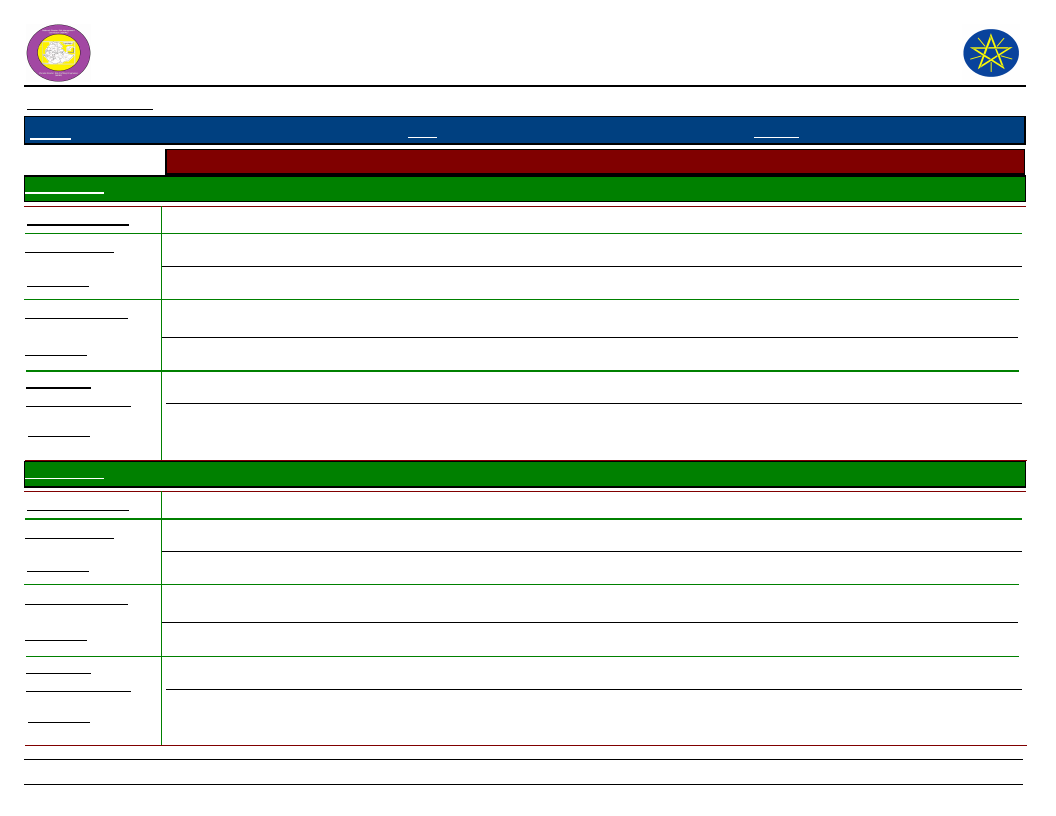
Wereda Disaster
Risk Profile
Data_Collected_Date
Region S.N.N.P
Zone
GURAGE
Selected Indicator
Kebele Name
Hazard: Coping and recovering during last Disaster
BATI FATO
Type of Disaster(s)
Coping_Strategy
Frost
Helping each other
Description
Medium
Recovery_Strategy
Shifting other plants
Description
Community
Participation_Ways
Description
Less
Helping each other by financial material
Very good
Kebele Name
Type of Disaster(s)
Coping_Strategy
Description
Recovery_Strategy
Description
Community
Participation_Ways
Description
BATI LEJANO
Drought
Relief
Not sufficient in order to campaign the disaster severity
Searching job opportunities
To get income
For mitigate the problem helping each other with feeding
Good cooperation
248
National Disaster Risk Management
Commission (NDRMC)
Wednesday, July 10, 2019
Wereda MESKAN
Page 1 of 15
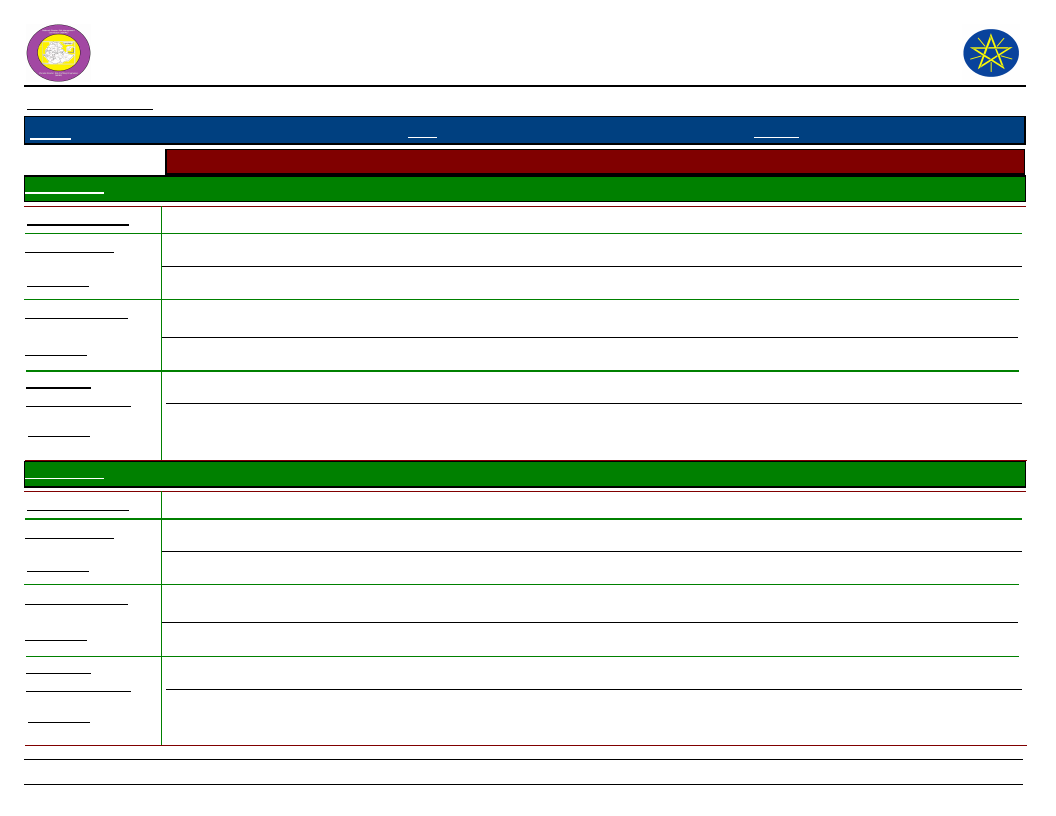
Wereda Disaster
Risk Profile
Data_Collected_Date
Region S.N.N.P
Zone
GURAGE
Selected Indicator
Kebele Name
Hazard: Coping and recovering during last Disaster
BECHE BULCHANO
Type of Disaster(s)
Coping_Strategy
Flood and drought
Divert flood to water way as organization
Description
Very effective
Recovery_Strategy
Helping each other, support by government
Description
Community
Participation_Ways
Description
Less effective
Borrowing material, oxen and help with finance
Very good
Kebele Name
Type of Disaster(s)
Coping_Strategy
Description
Recovery_Strategy
Description
Community
Participation_Ways
Description
BERESA
Drought
Migrate to relative to get help
Only possibility during the incident
No water harvest
Temporarily it is effective
Do cooperative works to protect some disaster
It is good cooperative
249
National Disaster Risk Management
Commission (NDRMC)
Wednesday, July 10, 2019
Wereda MESKAN
Page 2 of 15
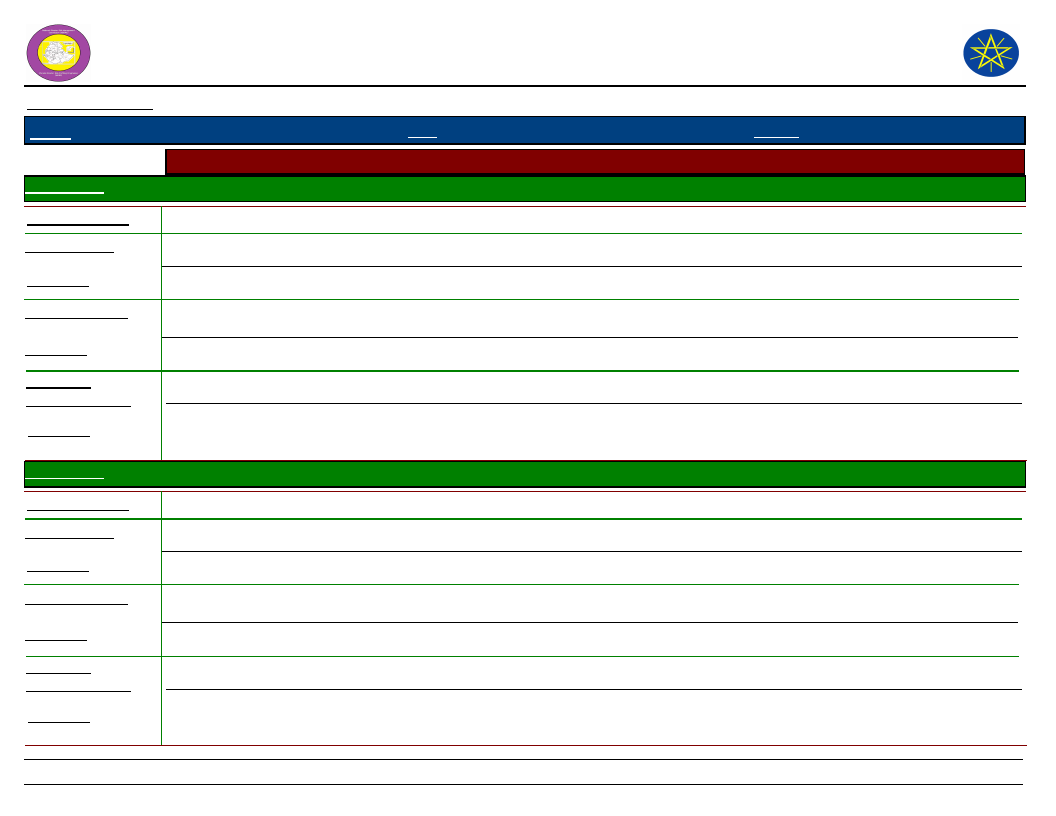
Wereda Disaster
Risk Profile
Data_Collected_Date
Region S.N.N.P
Zone
GURAGE
Selected Indicator
Kebele Name
Hazard: Coping and recovering during last Disaster
DEBO TUTO
Type of Disaster(s)
Coping_Strategy
Drought
Fetching water from far away
Description
To survive
Recovery_Strategy
Water pipe line from neighbor kebele
Description
Community
Participation_Ways
Description
It is not effective
Borrowing or gift of water, helping each other
It is good cooperative
National Disaster Risk Management
Commission (NDRMC)
Wednesday, July 10, 2019
Wereda MESKAN
Kebele Name
Type of Disaster(s)
Coping_Strategy
Description
Recovery_Strategy
Description
Community
Participation_Ways
Description
DEBUB SHERSHERA
Flood and drought
Helping each other by material and also man power
Very effective
Apply the help of government, construct soil and water conservation, plating trees
Very effective
Helping with money, oxen and material
Very effective
250
Page 3 of 15
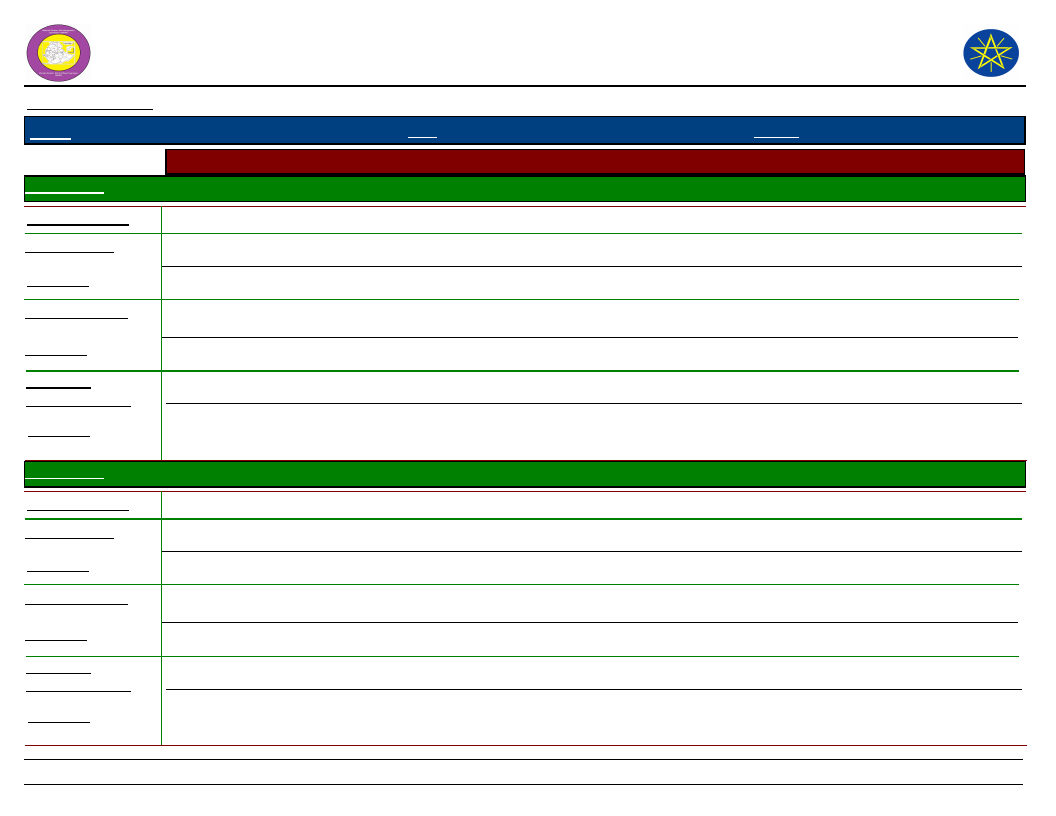
Wereda Disaster
Risk Profile
Data_Collected_Date
Region S.N.N.P
Zone
GURAGE
Selected Indicator
Kebele Name
Hazard: Coping and recovering during last Disaster
DEGAGOGOT
Type of Disaster(s)
Coping_Strategy
Food
Helping each other, support money, food and wood
Description
They have no recovery efforts because they are economical dependent /poor
Recovery_Strategy
Helping each other in labor, wood and money support, sharing resource
Description
Community
Participation_Ways
Description
They have good participation and support culture
Sharing resource support food and money
Very good participation and cooperatives
Kebele Name
Type of Disaster(s)
Coping_Strategy
Description
Recovery_Strategy
Description
Community
Participation_Ways
Description
DIDA
Drought, flood and livestock disease
Government aid, renting their land, using credit service
Effective
Food relief by government, food for work
Effective
Borrowing mane, food, material and helping with man power and oxen
Very effective
National Disaster Risk Management
Commission (NDRMC)
Wednesday, July 10, 2019
Wereda MESKAN
251
Page 4 of 15
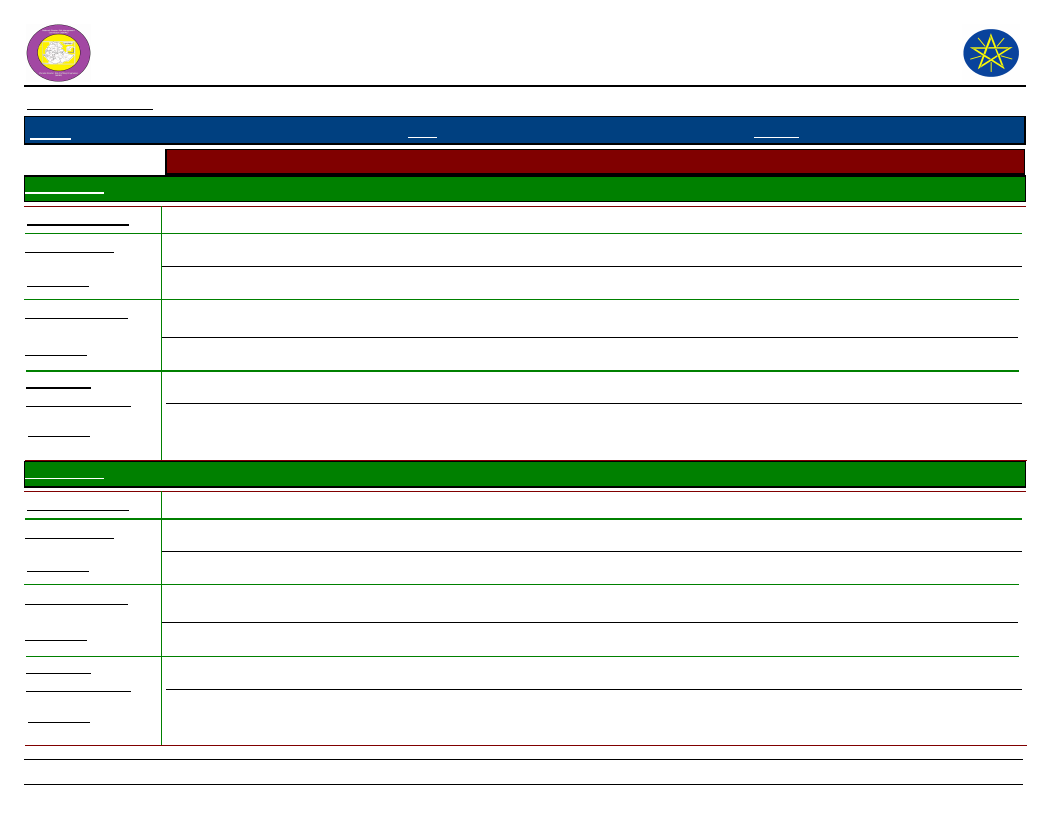
Wereda Disaster
Risk Profile
Data_Collected_Date
Region S.N.N.P
Zone
GURAGE
Selected Indicator
Kebele Name
Hazard: Coping and recovering during last Disaster
DIRAMA
Type of Disaster(s)
Coping_Strategy
Flood
Divert the direction of flood, repair or maintain structures, helped each other
Description
Very effective
Recovery_Strategy
Sowing short period crops, terracing, shifting
Description
Community
Participation_Ways
Description
Effective
Sharing finance and materialism helping each other
Effective
Kebele Name
Type of Disaster(s)
Coping_Strategy
Description
Recovery_Strategy
Description
Community
Participation_Ways
Description
DOBENA
Flood
Government support by food and money, food relief, build their house
Good
Helping each other, government support, conservation work
Well
Helping each other by food, material and oxen
Very good
National Disaster Risk Management
Commission (NDRMC)
Wednesday, July 10, 2019
Wereda MESKAN
252
Page 5 of 15
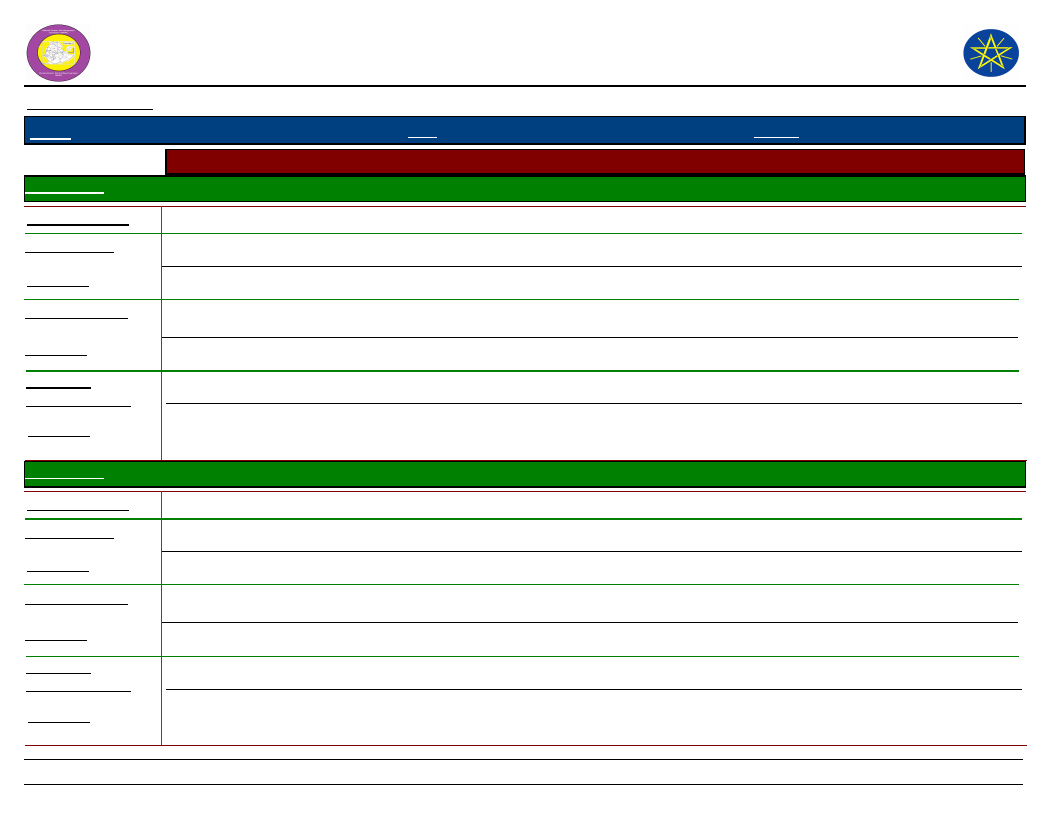
Wereda Disaster
Risk Profile
Data_Collected_Date
Region S.N.N.P
Zone
GURAGE
Selected Indicator
Kebele Name
Hazard: Coping and recovering during last Disaster
GIDENA ABORAT
Type of Disaster(s)
Coping_Strategy
Flood
Selling permanent asset, sowing short season crop, ask relief
Description
Effective
Recovery_Strategy
Relenting, replaced damaged crop by others
Description
Community
Participation_Ways
Description
Effective
By lend money from edir, helping each other by material
Very effective
National Disaster Risk Management
Commission (NDRMC)
Wednesday, July 10, 2019
Wereda MESKAN
Kebele Name
Type of Disaster(s)
Coping_Strategy
Description
Recovery_Strategy
Description
Community
Participation_Ways
Description
GOYBAN
Flood
Dam construction, move children to relatives, store food items and other purchasable goods
Effective
Making sustainable soil and water conservation activities, construct cutoff drainage
Effective
Sharing resource, participate and helping each other from any labor work
Effective
253
Page 6 of 15
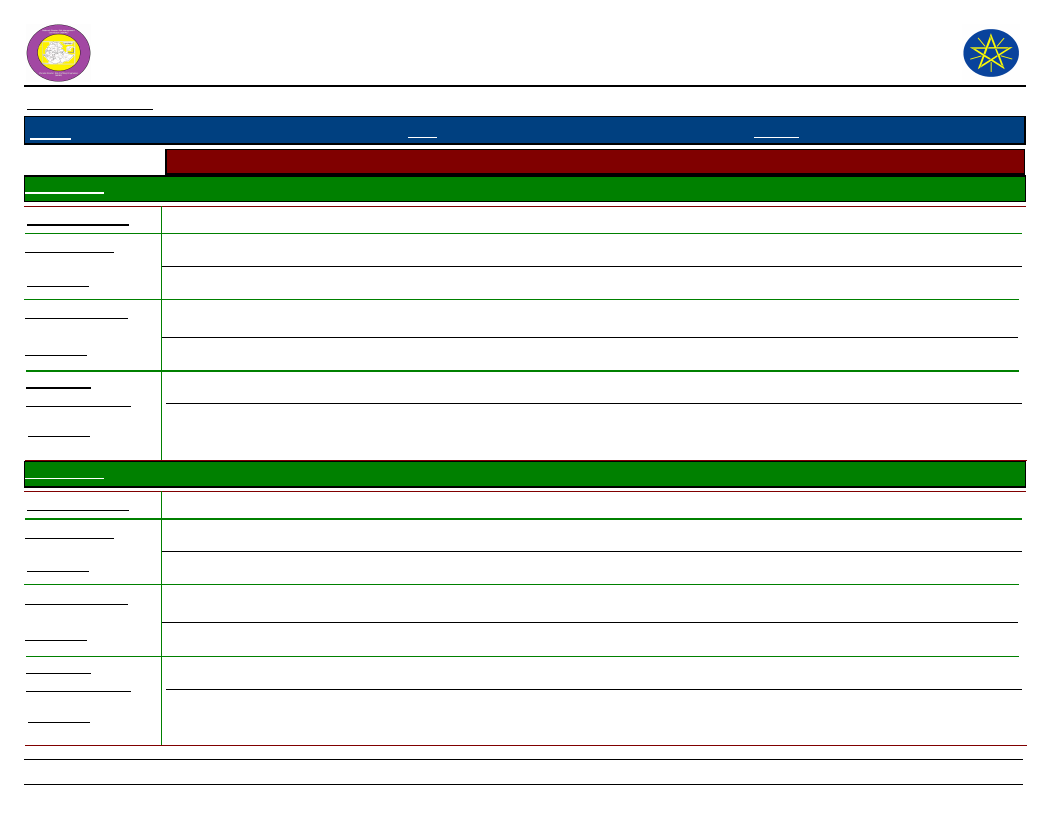
Wereda Disaster
Risk Profile
Data_Collected_Date
Region S.N.N.P
Zone
GURAGE
Selected Indicator
Kebele Name
Hazard: Coping and recovering during last Disaster
ILE
Type of Disaster(s)
Coping_Strategy
Flood
Relief
Description
It is sufficient
Recovery_Strategy
Create job opportunity
Description
Community
Participation_Ways
Description
It is good for short period of time
Helping each other
Good cooperative
Kebele Name
Type of Disaster(s)
Coping_Strategy
Description
Recovery_Strategy
Description
Community
Participation_Ways
Description
INSENO USME
Drought
Relief
Not sufficient
Daily labor
Helping each other, in order to mitigate the problem
It is good cooperation
254
National Disaster Risk Management
Commission (NDRMC)
Wednesday, July 10, 2019
Wereda MESKAN
Page 7 of 15
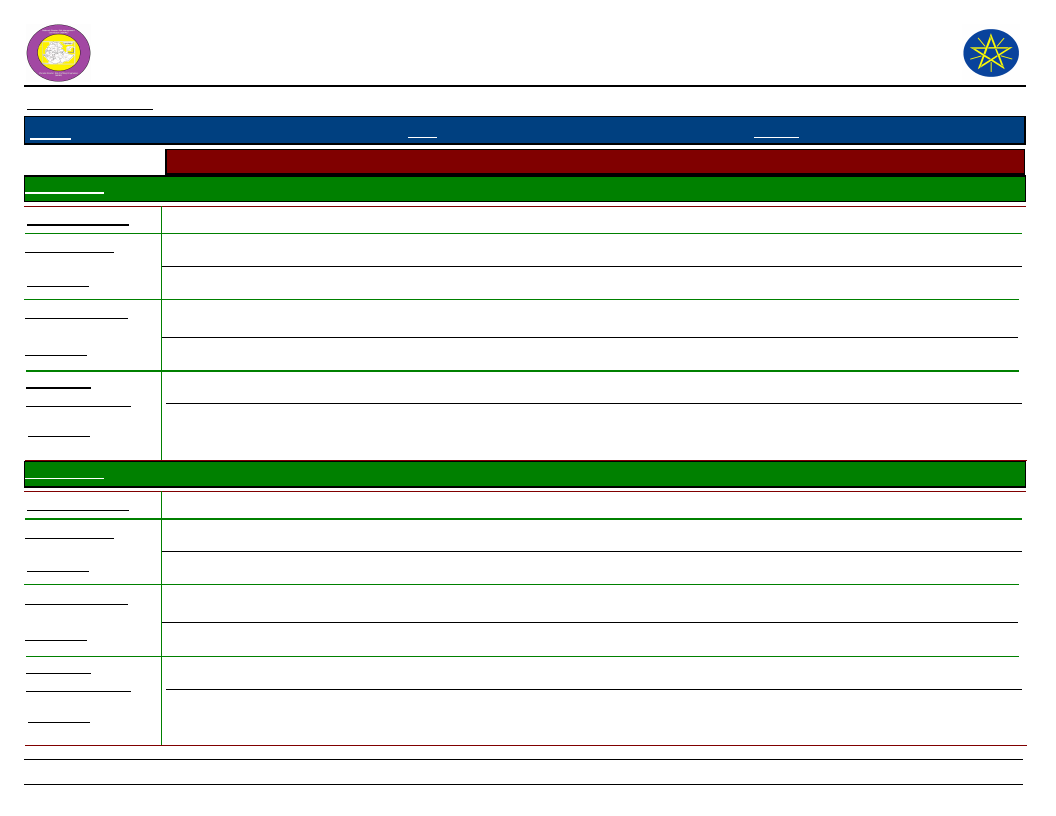
Wereda Disaster
Risk Profile
Data_Collected_Date
Region S.N.N.P
Zone
GURAGE
Selected Indicator
Kebele Name
Hazard: Coping and recovering during last Disaster
JOLE ANDENYA
Type of Disaster(s)
Coping_Strategy
Flood
Description
Recovery_Strategy
Relief, job opportunity
Description
Community
Participation_Ways
Description
Good
Food and cloth gift, prevent in credit
Helping each other
National Disaster Risk Management
Commission (NDRMC)
Wednesday, July 10, 2019
Wereda MESKAN
Kebele Name
Type of Disaster(s)
Coping_Strategy
Description
Recovery_Strategy
Description
Community
Participation_Ways
Description
JOLE HULETENYA
Flood
Government help, helping each other
Not satisfactory
Construct soil and water conservation, shifting plants
Good but not enough
Building damaged house, working agricultural activities, helping money and material
Very good
255
Page 8 of 15
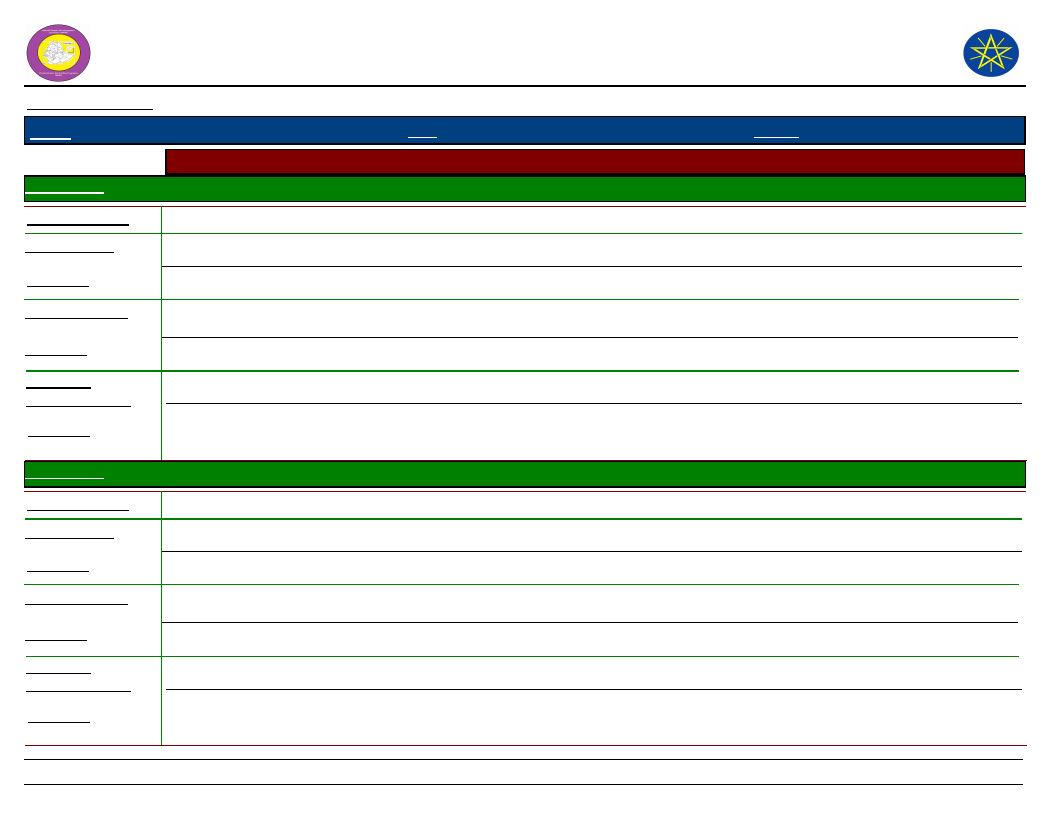
Wereda Disaster
Risk Profile
Data_Collected_Date
Region S.N.N.P
Zone
GURAGE
National Disaster Risk Management
Commission (NDRMC)
Wednesday, July 10, 2019
Wereda MESKAN
Selected Indicator
Kebele Name
Hazard: Coping and recovering during last Disaster
MEKICHO
Type of Disaster(s)
Coping_Strategy
Flood
Supported by government, helping each other, enset harvest, borrowing money and seed from government
Description
Good
Recovery_Strategy
Construct soil and water conservation, diversion, shifting plant
Description
Community
Participation_Ways
Description
Effective
By helping give money and food, material and building house, borrowing money and materials
Effective
Kebele Name
Type of Disaster(s)
Coping_Strategy
Description
Recovery_Strategy
Description
Community
Participation_Ways
Description
MESERETEWEGERAMO
Flood
Help each other, soil bund and drainage ditch
Good working habit
Do small petty trade, shift to other agriculture
Not effective
Help each other with feeding
Good cooperative
256
Page 9 of 15
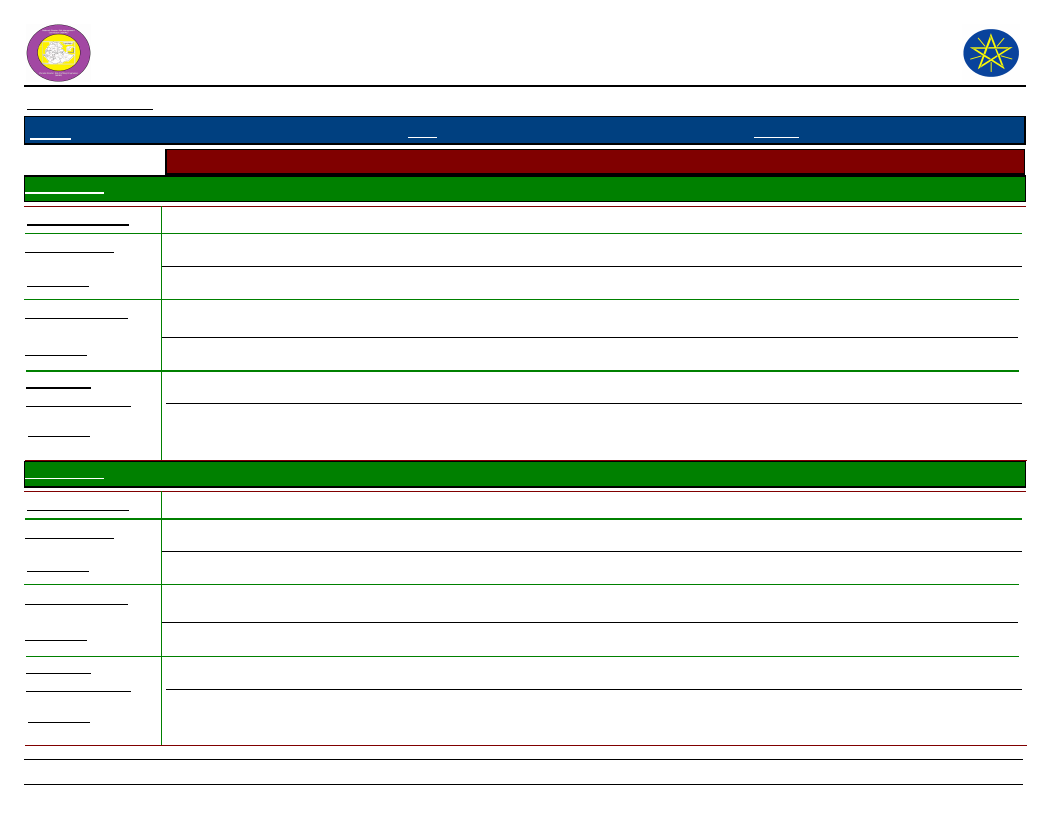
Wereda Disaster
Risk Profile
Data_Collected_Date
Region S.N.N.P
Zone
GURAGE
Selected Indicator
Kebele Name
Hazard: Coping and recovering during last Disaster
MIKAELO
Type of Disaster(s)
Coping_Strategy
Flood
Description
Recovery_Strategy
Description
Community
Participation_Ways
Description
Kebele Name
Type of Disaster(s)
Coping_Strategy
Description
Recovery_Strategy
Description
Community
Participation_Ways
Description
MIRAB IMBOR
Flood
Protect themselves to their life and families, helping each other
Increased
Repair and development damaged, helping each other
Financially and material help very good
Financial, material, man power
For food and building house
257
National Disaster Risk Management
Commission (NDRMC)
Wednesday, July 10, 2019
Wereda MESKAN
Page 10 of 15
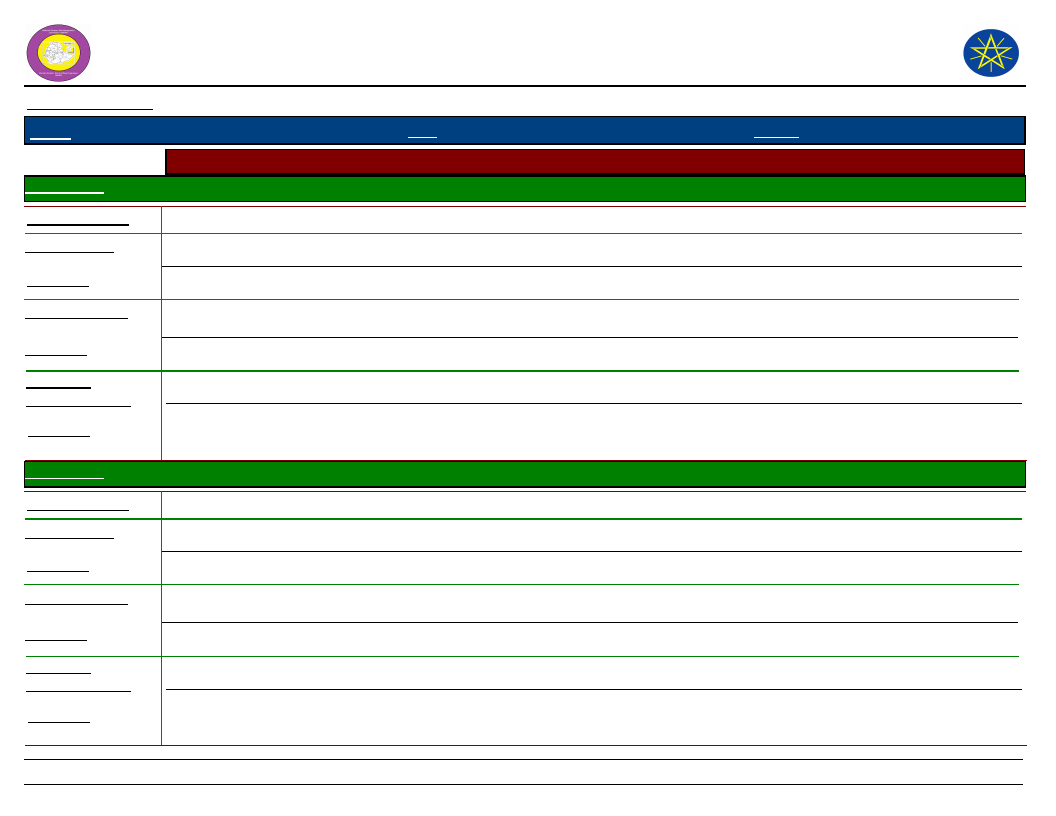
Wereda Disaster
Risk Profile
Data_Collected_Date
Region S.N.N.P
Zone
GURAGE
Selected Indicator
Kebele Name
Hazard: Coping and recovering during last Disaster
MIRAB MESKAN
Type of Disaster(s)
Coping_Strategy
Flood
Helping each other socially and financial
Description
Very good
Recovery_Strategy
Saving, organization
Description
Community
Participation_Ways
Description
Effective
Helping ach other by finance and material
Effective
Kebele Name
Type of Disaster(s)
Coping_Strategy
Description
Recovery_Strategy
Description
Community
Participation_Ways
Description
OCHAGENEME
Drought
Job opportunity
It is not effective
Relief
It is not effective
Borrowing/gift of food
It is good cooperation
258
National Disaster Risk Management
Commission (NDRMC)
Wednesday, July 10, 2019
Wereda MESKAN
Page 11 of 15
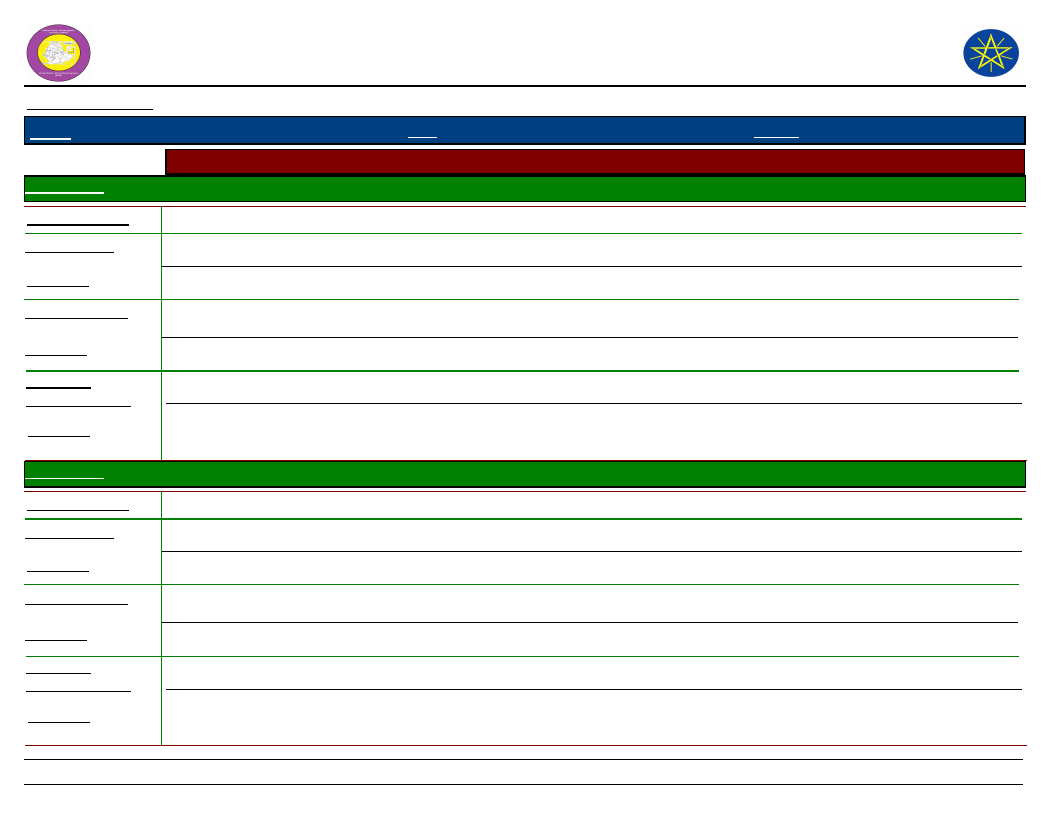
Wereda Disaster
Risk Profile
Data_Collected_Date
Region S.N.N.P
Zone
GURAGE
Selected Indicator
Kebele Name
Hazard: Coping and recovering during last Disaster
SEMEN SHORSHORA
Type of Disaster(s)
Coping_Strategy
Drought
Dam construction, move children and elders to relative, store food items
Description
Very good
Recovery_Strategy
Make sustainable soil and water conservation, construct cut off drainage
Description
Community
Participation_Ways
Description
Very good
Share resource, participate from any labor work, food aid specially for children
Very good
National Disaster Risk Management
Commission (NDRMC)
Wednesday, July 10, 2019
Wereda MESKAN
Kebele Name
Type of Disaster(s)
Coping_Strategy
Description
Recovery_Strategy
Description
Community
Participation_Ways
Description
SHERSHERA MACHMENA
Flood
Helping each other, minimize the hazard, reporting
Good
Helping man power and economic faineance
Very good
Financial material and tools
Helping each other
259
Page 12 of 15
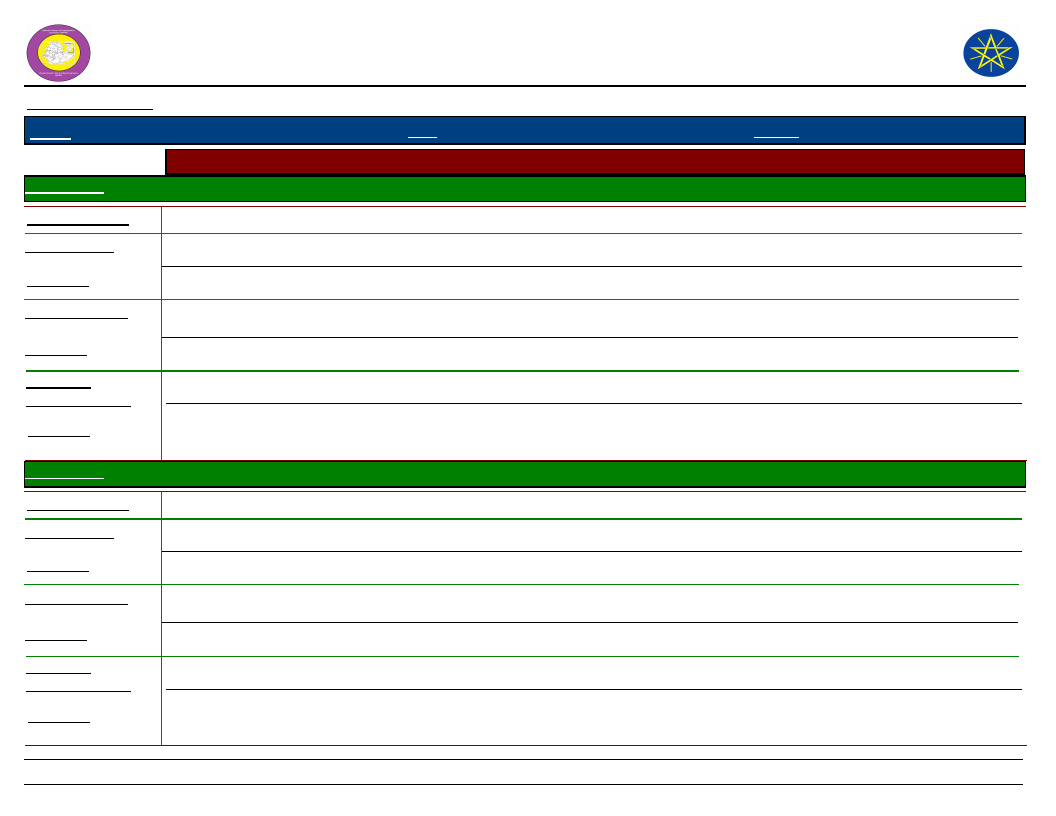
Wereda Disaster
Risk Profile
Data_Collected_Date
Region S.N.N.P
Zone
GURAGE
Selected Indicator
Kebele Name
Hazard: Coping and recovering during last Disaster
WEJABATI
Type of Disaster(s)
Coping_Strategy
Drought
Job opportunity
Description
Not effective and not sustainable
Recovery_Strategy
Relief
Description
Community
Participation_Ways
Description
It is not sufficient
Sharing of food each other
It is good cooperative
Kebele Name
Type of Disaster(s)
Coping_Strategy
Description
Recovery_Strategy
Description
Community
Participation_Ways
Description
WITA
Drought
Job opportunity
Good
Relief
Good
Borrowing food, clothe and cash
Good
260
National Disaster Risk Management
Commission (NDRMC)
Wednesday, July 10, 2019
Wereda MESKAN
Page 13 of 15
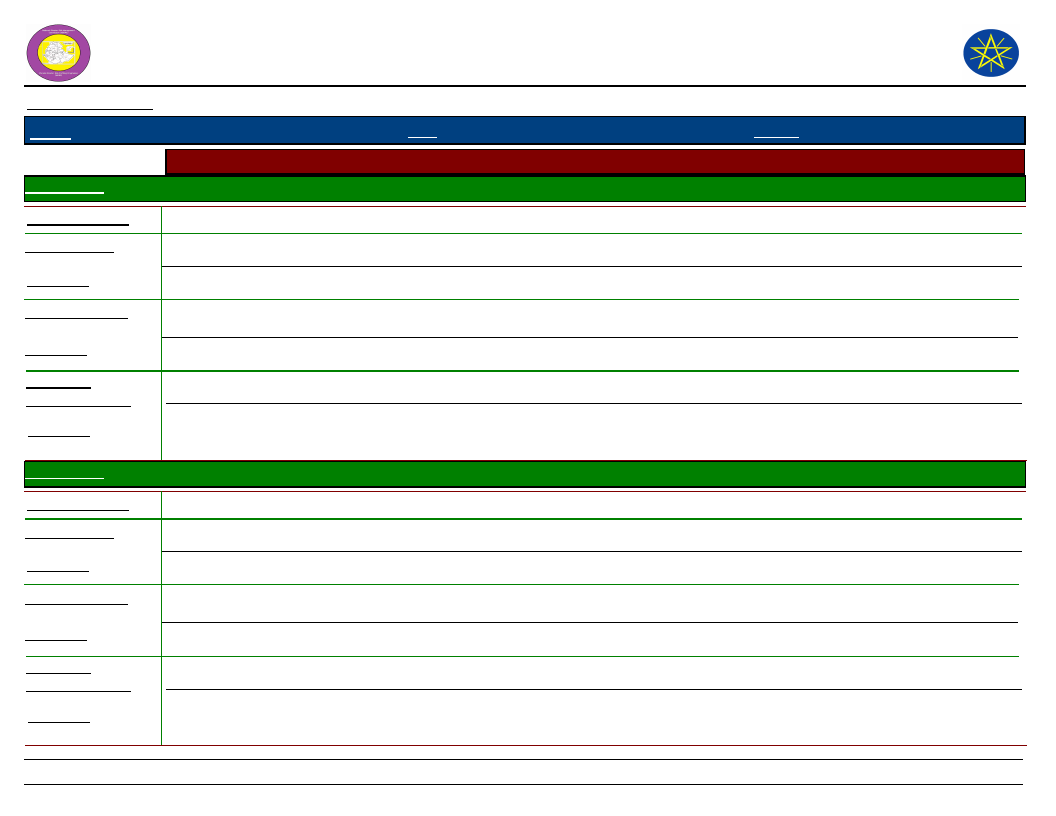
Wereda Disaster
Risk Profile
Data_Collected_Date
Region S.N.N.P
Zone
GURAGE
Selected Indicator
Kebele Name
Hazard: Coping and recovering during last Disaster
WOLENSHO ANDENYA
Type of Disaster(s)
Coping_Strategy
Shortage of water/Drought
Bring water from far area
Description
Effective for human but not animals
Recovery_Strategy
Digging to up ground water
National Disaster Risk Management
Commission (NDRMC)
Wednesday, July 10, 2019
Wereda MESKAN
Description
Community
Participation_Ways
Description
Not effective because the water table is too for it is not possible do with power
Borrowing of water and helping each other
It is effective and good cooperative
Kebele Name
Type of Disaster(s)
Coping_Strategy
Description
Recovery_Strategy
Description
Community
Participation_Ways
Description
YETABON
Flood and frost
Government help, helping each other
Good
Relief, shifting plants, helping each other
Good
Helping with finance and material
Very good
261
Page 14 of 15
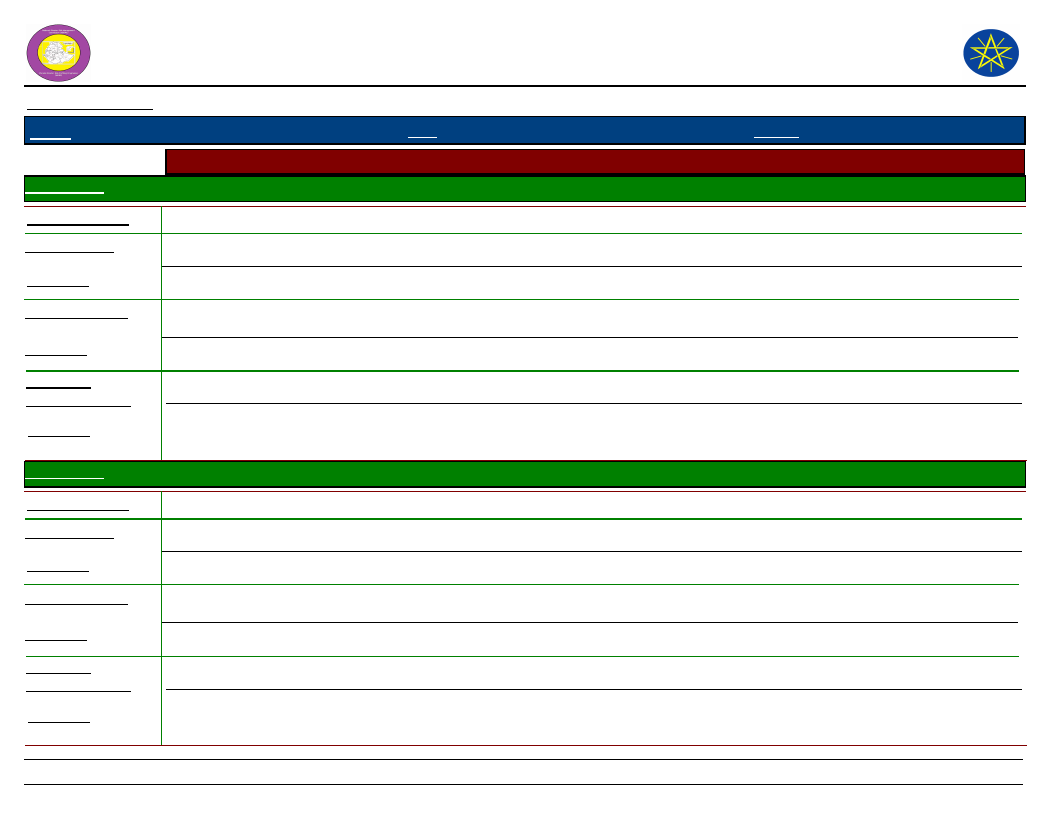
Wereda Disaster
Risk Profile
Data_Collected_Date
Region S.N.N.P
Zone
GURAGE
Selected Indicator
Kebele Name
Hazard: Coping and recovering during last Disaster
YIMERWACHO 2NYA
Type of Disaster(s)
Coping_Strategy
Flood
By helping each other
Description
Good
Recovery_Strategy
Supported by government and NGOS
Description
Community
Participation_Ways
Description
Good
Credit service and borrowing material
Helping each other
Kebele Name
Type of Disaster(s)
Coping_Strategy
Description
Recovery_Strategy
Description
Community
Participation_Ways
Description
YIMERWACHO 3NYA
Drought
Relief
Not sufficient
Irrigation practice
Good
Helping each other
Good cooperation
262
National Disaster Risk Management
Commission (NDRMC)
Wednesday, July 10, 2019
Wereda MESKAN
Page 15 of 15
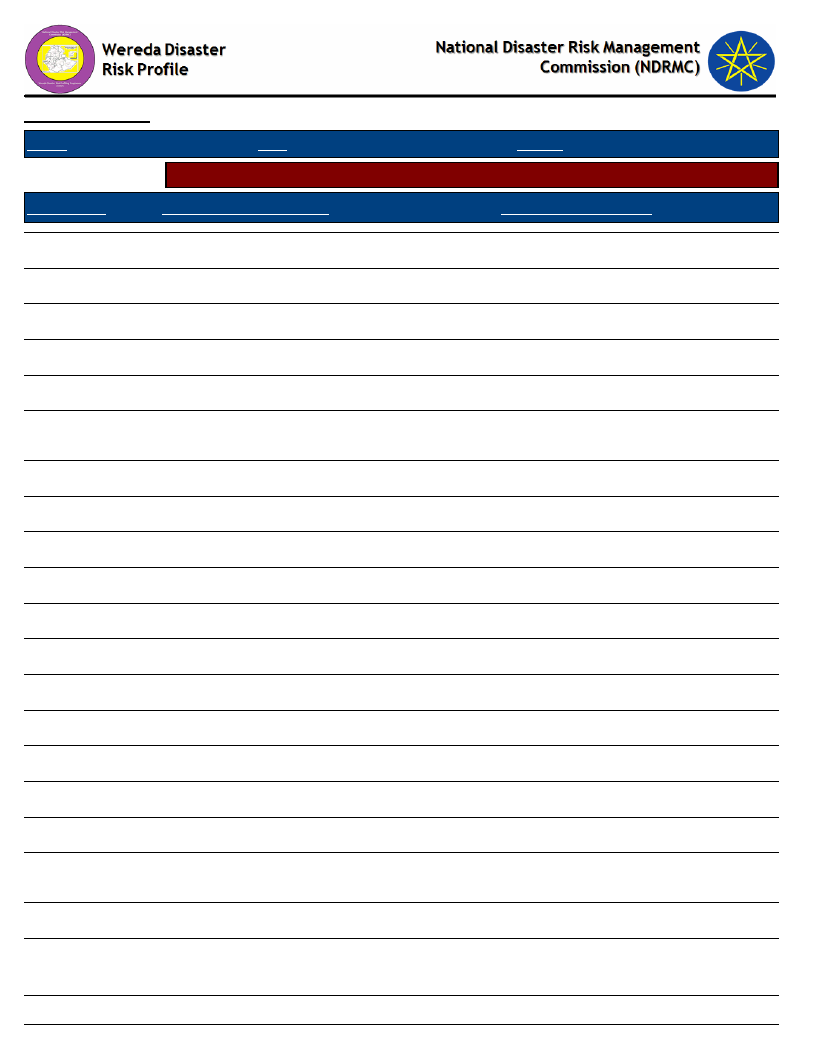
Data_Collected_Date
Region S.N.N.P
Zone GURAGE
Selected Indicator
Capacity: Type Community Participation
Kebele Name
Levels_Comm_Participation
BATI FATO
Very good
BATI LEJANO
Good cooperative
BECHE BULCHANO Very good
BERESA
Good cooperative
DEBO TUTO
Good cooperative
DEBUB
SHERSHERA
DEGAGOGOT
Very good
Very good
DIDA
Very good
DIRAMA
Good cooperatives
DOBENA
Very good
GIDENA ABORAT
Very good
GOYBAN
Very good
ILE
Good cooperative
INSENO USME
Good cooperative
JOLE ANDENYA
Good cooperative/Debo
JOLE HULETENYA
Very good
MEKICHO
Very good
MESERETEWEGERA
MO
MIKAELO
Good cooperative
Good
MIRAB IMBOR
Very good
263
Wednesday, July 10, 2019
Wereda MESKAN
Changes_In_Last_Decade
Increasing
No change
Increased
Increased
Increased
Increased
Increased
Increased
Increased
Increased
Increased
Increased
No change
No change
No change
Increased
Increased
No change
Increased
Increased
Page 1 of 2
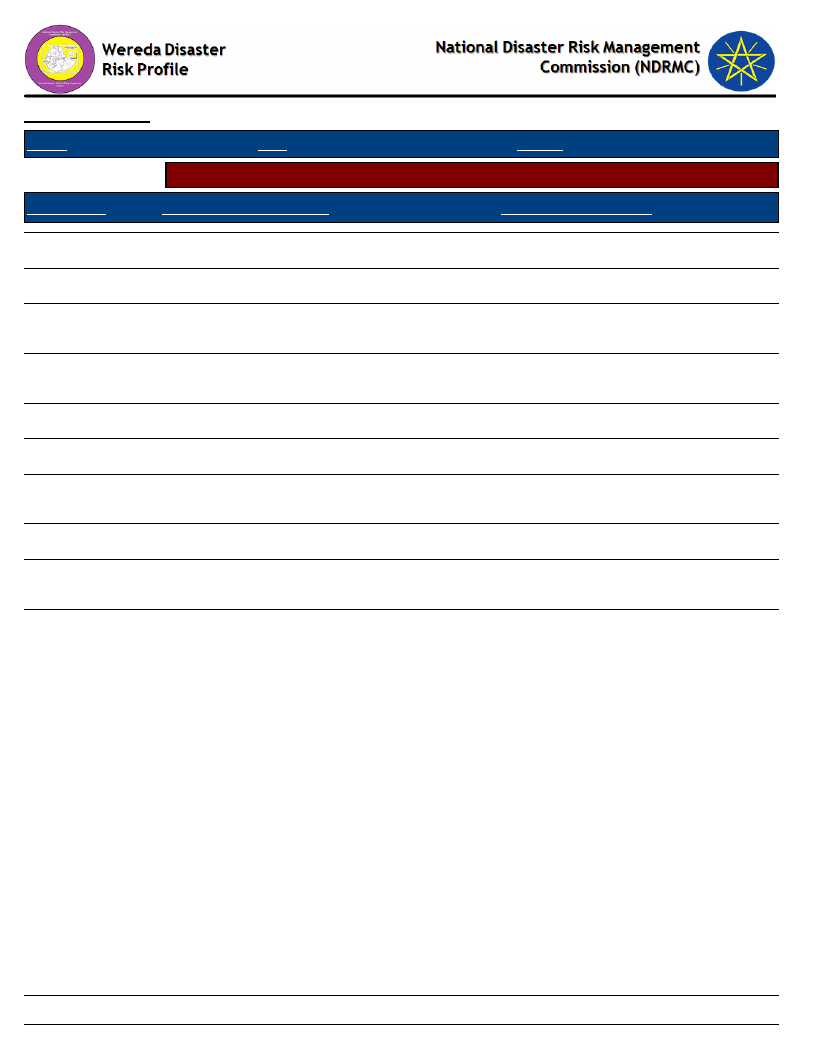
Data_Collected_Date
Region S.N.N.P
Zone GURAGE
Selected Indicator
Capacity: Type Community Participation
Kebele Name
Levels_Comm_Participation
MIRAB MESKAN
OCHAGENEME
SEMEN
SHORSHORA
SHERSHERA
MACHMENA
WEJABATI
WITA
WOLENSHO
ANDENYA
YETABON
YIMERWACHO
2NYA
YIMERWACHO
3NYA
Very good
Good cooperation
Very good
Very good
Has good cooperation
Good cooperative
Good cooperative
Very good
Good
Good cooperation
Wednesday, July 10, 2019
Wereda MESKAN
Changes_In_Last_Decade
Increased
No change
Increased
Increased
No change
No change
Increased
Increased
Increasing
No change
264
Page 2 of 2
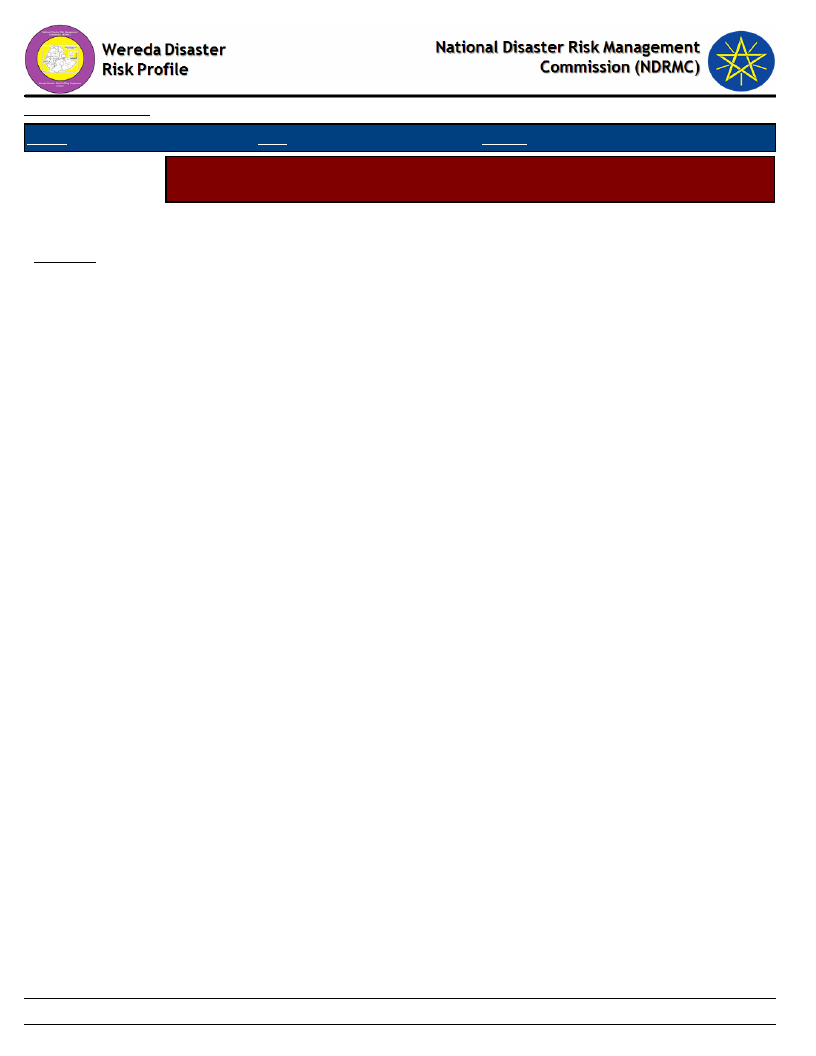
Data_Collected_Date
Region S.N.N.P
Zone GURAGE
Wereda MESKAN
Wednesday, July 10, 2019
Selected Indicator
Capacity: Recovery from Losses from Disasters - Percentage of Households who
have managed to recover from losses of disasters
Percentage of households who have managed to recover from losses of disasters
Comments
49.43 %
265
Page 1 of 1
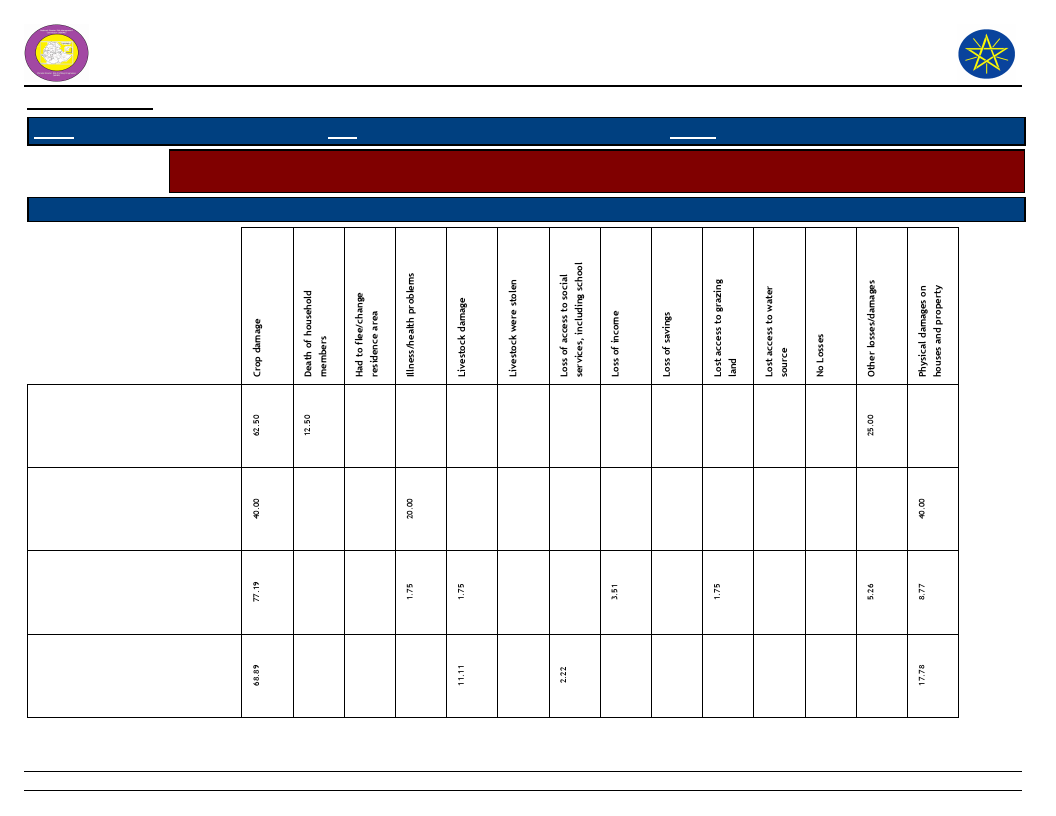
Wereda Disaster
Risk Profile
National Disaster Risk Management
Commission (NDRMC)
Data_Collected_Date
Region S.N.N.P
Zone GURAGE
Wereda MESKAN
Wednesday, July 10, 2019
Selected Indicator
Capacity: Coping Strategies Adopted by Households - Main coping strategies adopted by households to recover
from respective losses
Type of Coping Strategy Adopted
Type of Loss
Begging for money or for food
Borrowing of food or cash
(including purchasing food on
credit)
Consumption rather than sale
of crop surplus
Increased working hours
266
Page 1 of 4
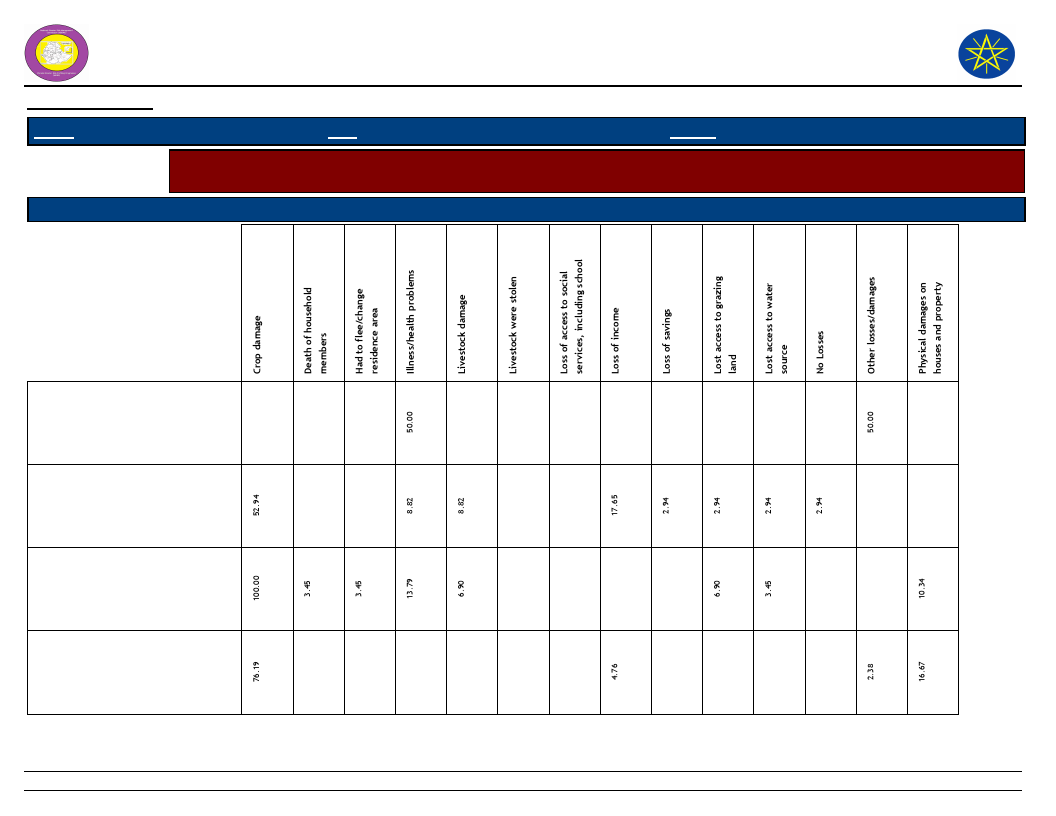
Wereda Disaster
Risk Profile
National Disaster Risk Management
Commission (NDRMC)
Data_Collected_Date
Region S.N.N.P
Zone GURAGE
Wereda MESKAN
Wednesday, July 10, 2019
Selected Indicator
Capacity: Coping Strategies Adopted by Households - Main coping strategies adopted by households to recover
from respective losses
Type of Coping Strategy Adopted
Type of Loss
Limit portion size at meals
No coping strategy adopted
Others -
Reduced expenditure on
non-essential items (beer,
cigarettes, clothes, meat, etc.)
267
Page 2 of 4
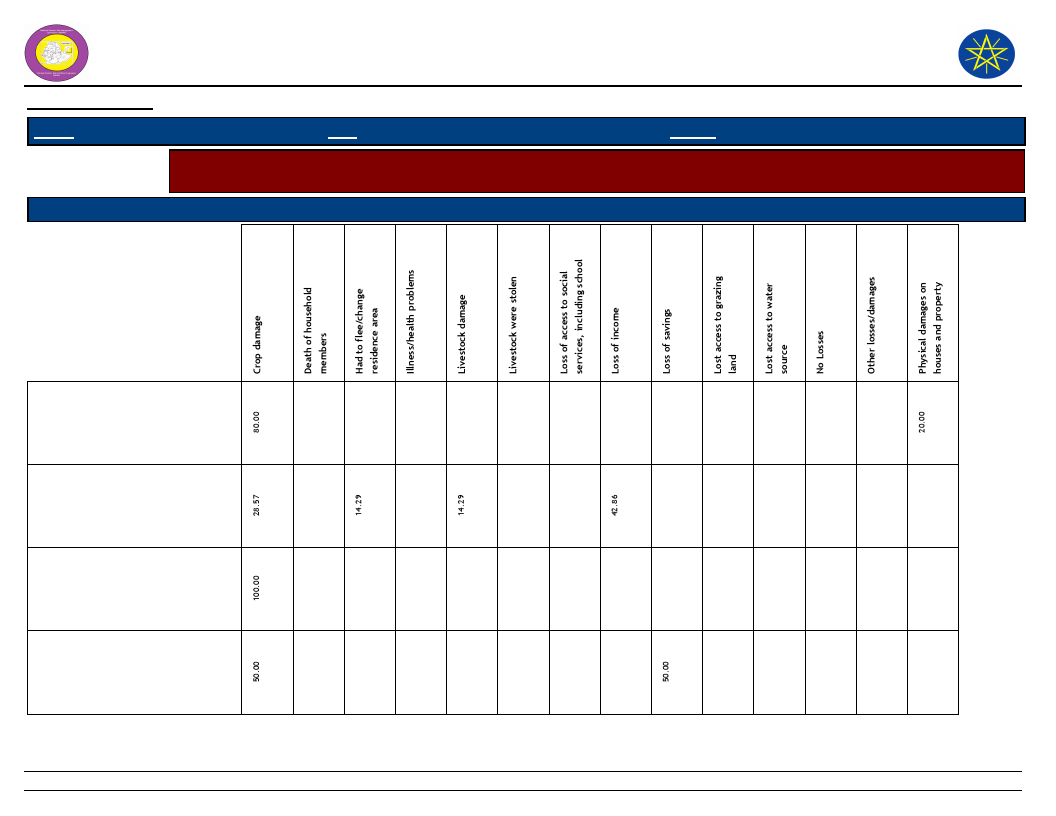
Wereda Disaster
Risk Profile
National Disaster Risk Management
Commission (NDRMC)
Data_Collected_Date
Region S.N.N.P
Zone GURAGE
Wereda MESKAN
Wednesday, July 10, 2019
Selected Indicator
Capacity: Coping Strategies Adopted by Households - Main coping strategies adopted by households to recover
from respective losses
Type of Coping Strategy Adopted
Type of Loss
Reduced expenditure on
productive inputs (fertilizer,
seeds, livestock drugs, etc.)
Rely on less preferred and less
expensive food
Restrict consumption by adults
in order for small children to
eat
Sale of productive assets (land,
farm implements, vehicle, etc.)
268
Page 3 of 4
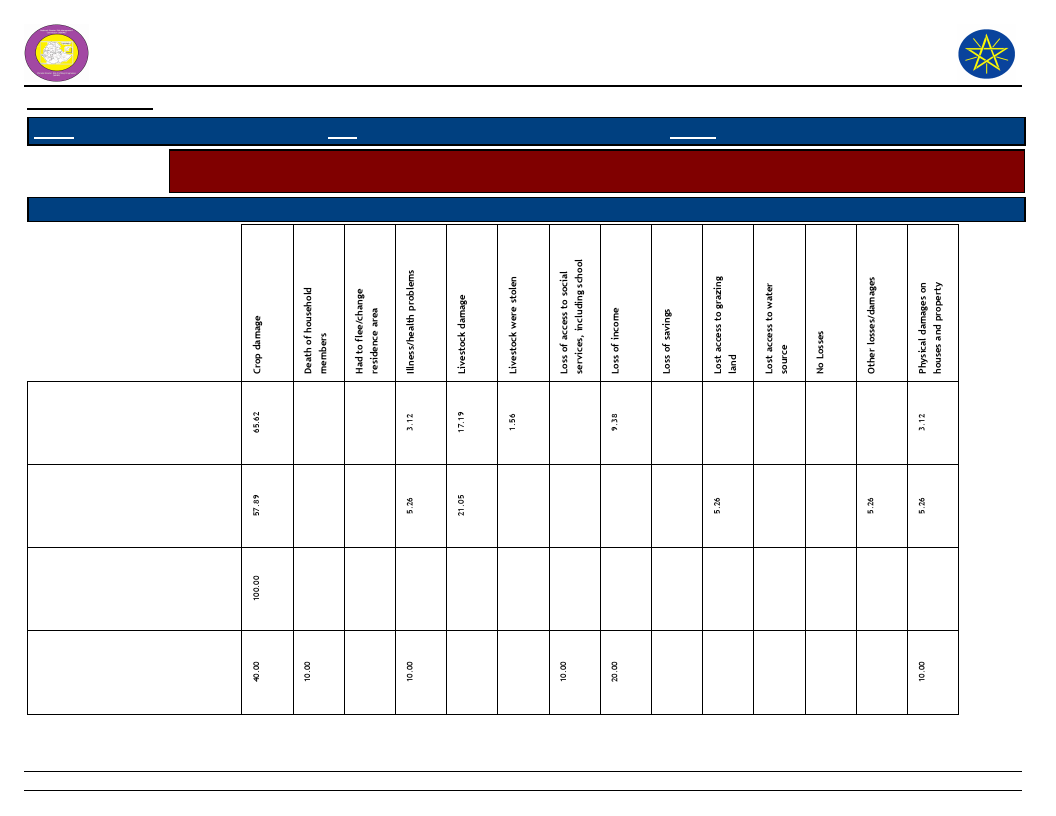
Wereda Disaster
Risk Profile
National Disaster Risk Management
Commission (NDRMC)
Data_Collected_Date
Region S.N.N.P
Zone GURAGE
Wereda MESKAN
Wednesday, July 10, 2019
Selected Indicator
Capacity: Coping Strategies Adopted by Households - Main coping strategies adopted by households to recover
from respective losses
Type of Coping Strategy Adopted
Type of Loss
Seek alternative or additional
jobs
Sell more livestock than usual
Sending children of household
for work
Short-term / seasonal labor
migration
269
Page 4 of 4
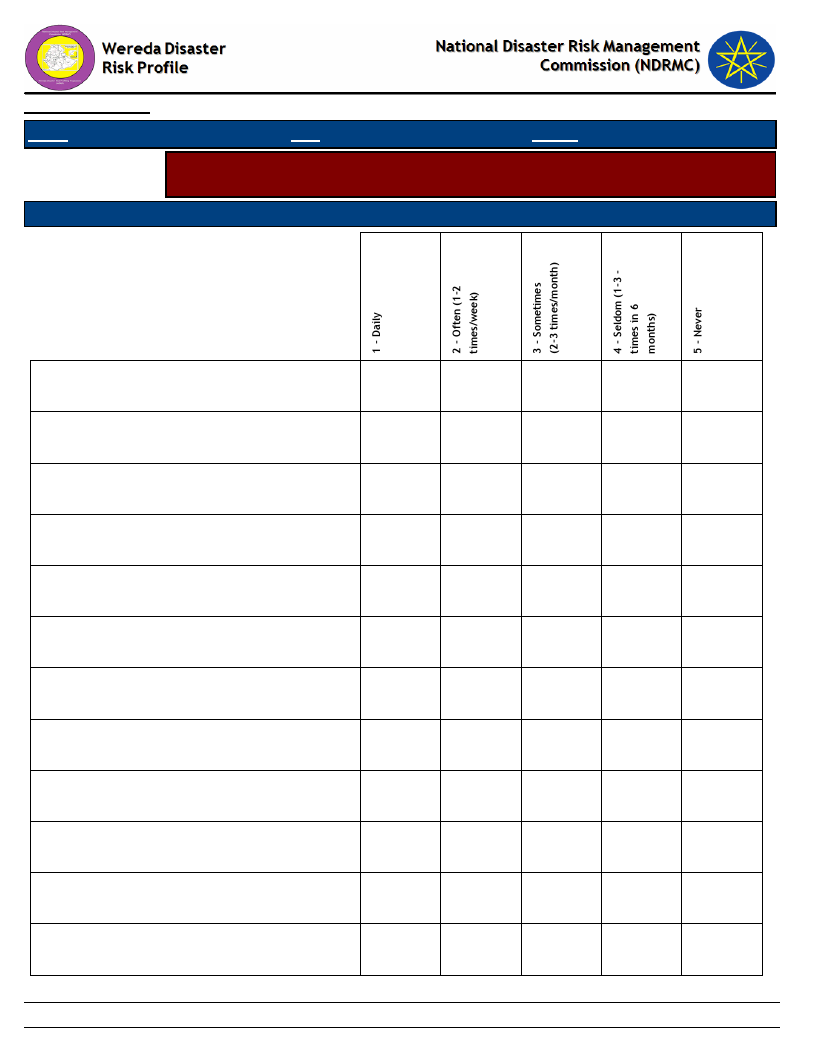
Data_Collected_Date
Wednesday, July 10, 2019
Region S.N.N.P
Zone GURAGE
Wereda MESKAN
Selected Indicator
Capacity: Coping Strategies Adopted by Households - Percentage of households
by frequency of main coping strategies adopted
Type of Coping Strategy Adopted
Frequency of Adoption
Begging for money or for food
Borrowing of food or cash (including purchasing
food on credit)
Consumption rather than sale of crop surplus
Increased working hours
Limit portion size at meals
No coping strategy adopted
Others -
Reduced expenditure on non-essential items
(beer, cigarettes, clothes, meat, etc.)
Reduced expenditure on productive inputs
(fertilizer, seeds, livestock drugs, etc.)
Rely on less preferred and less expensive food
Restrict consumption by adults in order for small
children to eat
Sale of productive assets (land, farm implements,
vehicle, etc.)
12.50
2.38
11.11
2.44
37.50
10.42
14.29
44.44
7.32
14.29
50.00
12.50
12.50
9.52
50.00
11.11
7.32
12.50
75.00
75.00
73.81
50.00
16.67
50.00
80.49
100.00
85.71
100.00
50.00
25.00
25.00
2.08
83.33
50.00
2.44
270
Page 1 of 2
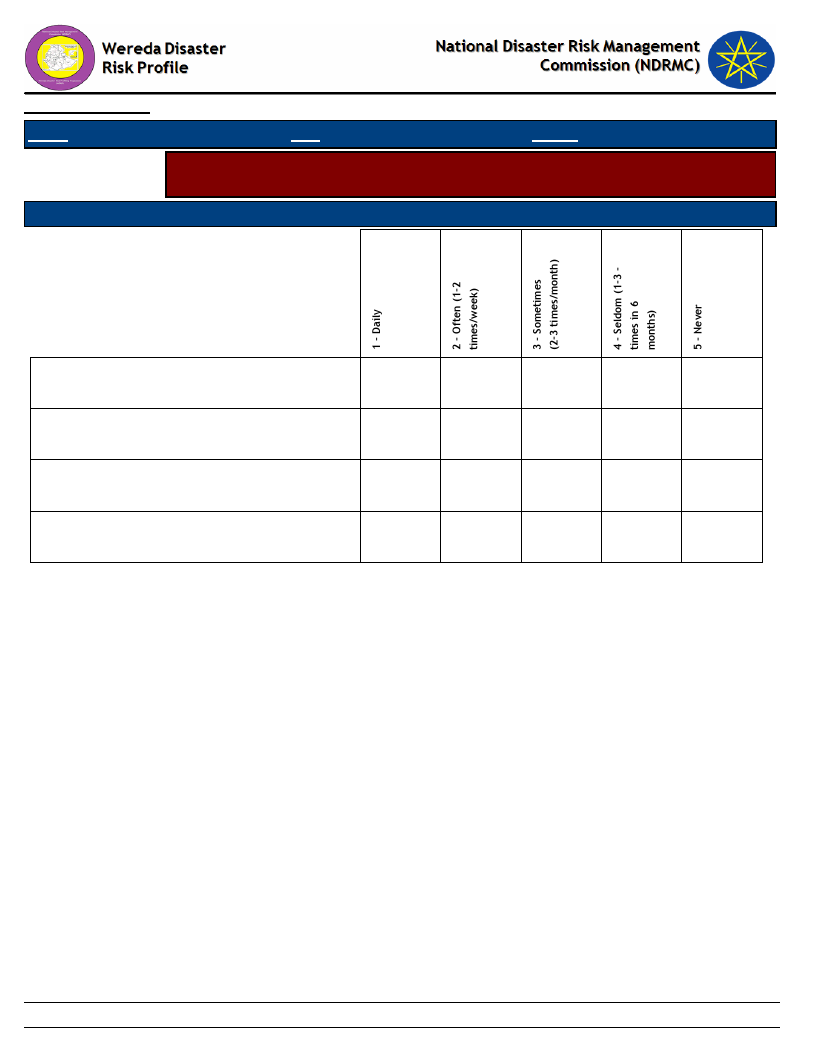
Data_Collected_Date
Wednesday, July 10, 2019
Region S.N.N.P
Zone GURAGE
Wereda MESKAN
Selected Indicator
Capacity: Coping Strategies Adopted by Households - Percentage of households
by frequency of main coping strategies adopted
Type of Coping Strategy Adopted
Frequency of Adoption
Seek alternative or additional jobs
Sell more livestock than usual
Sending children of household for work
Short-term / seasonal labor migration
3.03
11.11
15.15
14.29
3.03
21.43
69.70
42.86
100.00
88.89
9.09
21.43
271
Page 2 of 2
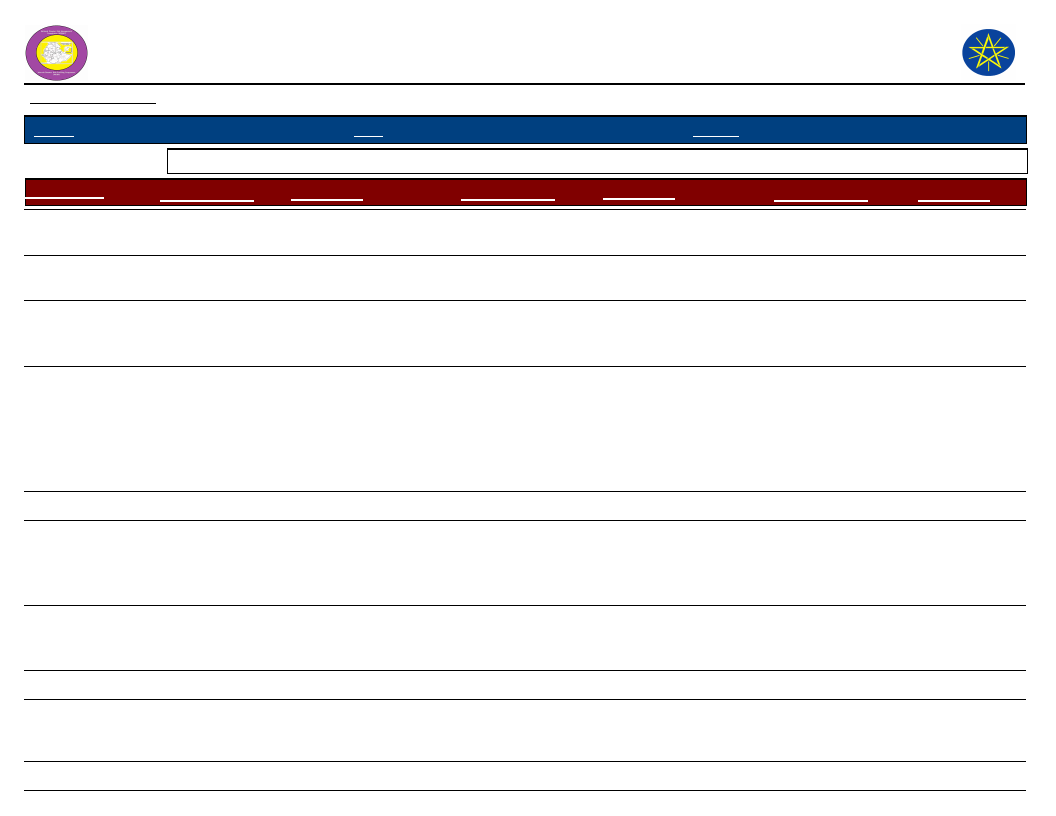
Wereda Disaster
Risk Profile
Data_Collected_Date
National Disaster Risk Management
Commission (NDRMC)
Wednesday, July 10, 2019
Region S.N.N.P
Zone GURAGE
Wereda MESKAN
Selected Indicator
Kebele Name
BATI FATO
BATI LEJANO
Capacity: Alternative Livelihood Sources - Alternative livelihood sources suggested by the community
Work_Option_1
Comment_1
Work_Option_2
Comment_2
Work_Option_3
Helping each
other
Irrigation
To recover the effect
of disaster
Have available water
Migrating
Fattening
To get job opportunities
Have available forage
Small trade
BECHE BULCHANO
BERESA
DEBO TUTO
DEBUB SHERSHERA
DEGAGOGOT
DIDA
Applying
government and
NGOs support
Relief
Daily labor
Migrate to other
areas to day
working or job
opportunities
Off farm activities
like poultry
production
Government aid
Government has more
potential and
responsible
Due to drought and
flood the community
faced shortage of
food and no food
security because of
water scarcity
No need expense
To get current income
Easily managed
activities
To get relief, food aid
Working for food To get food
Construction of
water source
Small trading
Selling trees
Daily labor
Migration
Due to drought and
flood the community
faced shortage of food
and no food security
because of water
scarcity
Need less capital
Because the area was
produced mainly
tree/wood
To get daily income
access
To get job
Migrate
Apply helps to
government,
NGOs and our
parents
Migrate to other
place
Daily labor
Comment_3
Need less
expense
To solve the
current
problems
To get current
food asset
For better job
opportunities
To get income
272
Page 1 of 4
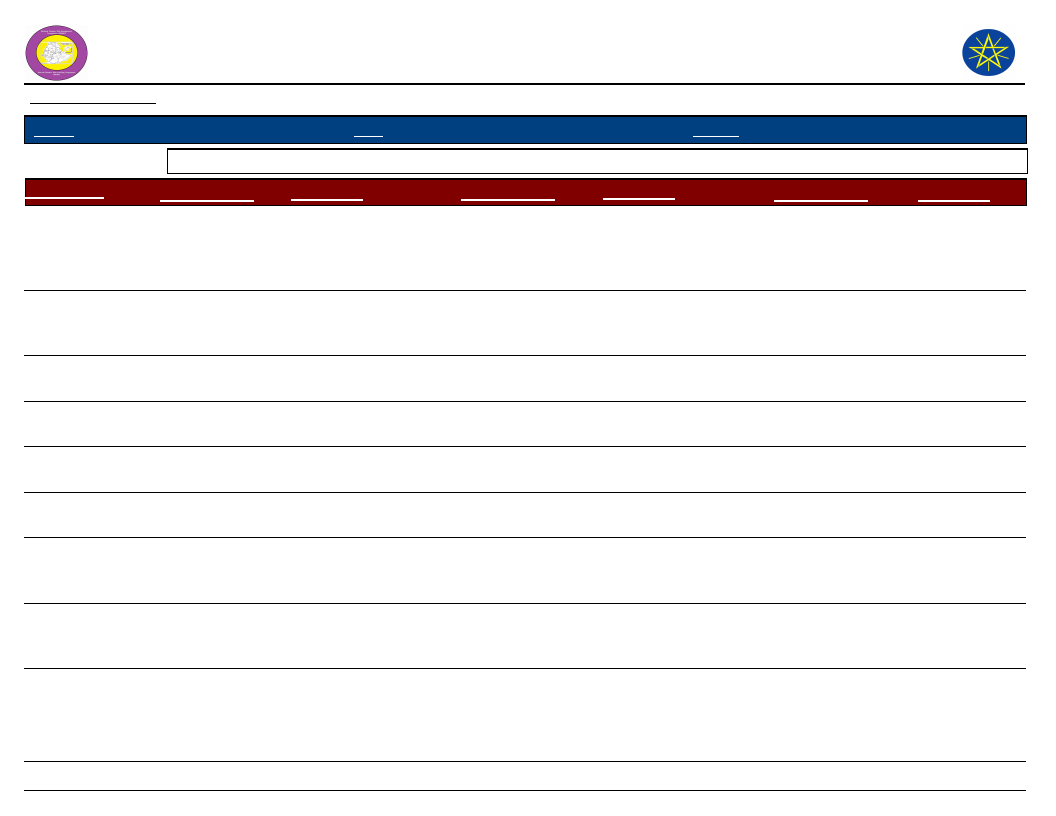
Wereda Disaster
Risk Profile
Data_Collected_Date
National Disaster Risk Management
Commission (NDRMC)
Wednesday, July 10, 2019
Region S.N.N.P
Zone GURAGE
Wereda MESKAN
Selected Indicator
Kebele Name
DIRAMA
Capacity: Alternative Livelihood Sources - Alternative livelihood sources suggested by the community
Work_Option_1
Coping system,
shift resistant
crops
Comment_1
Have no other option
Work_Option_2
Migration
Comment_2
To get income
Work_Option_3
Applying to
government
DOBENA
GIDENA ABORAT
GOYBAN
ILE
INSENO USME
JOLE ANDENYA
Borrowing money
from Omo micro
finance
Shift to other
farming land
Daily labor
Livestock
production
Irrigation
To trade and buying
ox and fattening
It is fast income
generating activities
Available forage
Have available water
Fattening
To get income
Daily labor
Daily labor
Migration
Fattening
Fattening
Irrigation
To get current income
Diminish our land by
flood
To better job
opportunities
Available forage
Have available plant
residue
They get irrigation
water easily
Migrate to other
urban areas
Migrate
Helping each
other
Petty trade
Small trade
Poultry
JOLE HULETENYA
Daily labor
To get income
Migration
To generate permanent
income
Applying help of
government
MEKICHO
Migrate to job
opportunities to
the other urban
area
To get income and
solve the current
problems
Apply helping of
government and
others
Have no other option
Comment_3
To get
response food
and financial
relief
To solve the
current
problems
To save life
They have
good cultures
Need some
expense
Need little
expensive
Have god
condition and
less expense
to prevent the
effect of
disaster
273
Page 2 of 4
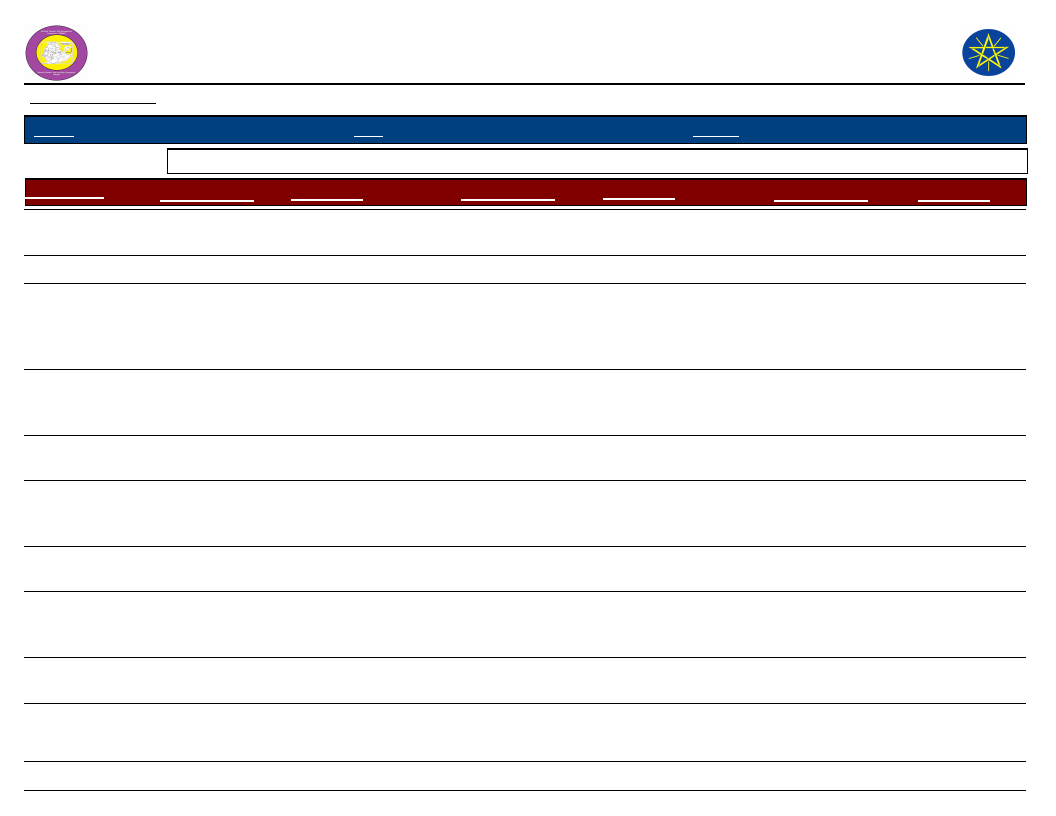
Wereda Disaster
Risk Profile
Data_Collected_Date
National Disaster Risk Management
Commission (NDRMC)
Wednesday, July 10, 2019
Region S.N.N.P
Zone GURAGE
Wereda MESKAN
Selected Indicator
Kebele Name
MESERETEWEGERA
MO
MIKAELO
MIRAB IMBOR
MIRAB MESKAN
OCHAGENEME
SEMEN
SHORSHORA
Capacity: Alternative Livelihood Sources - Alternative livelihood sources suggested by the community
Work_Option_1
Comment_1
Work_Option_2
Comment_2
Work_Option_3
Livestock
production
Daly labor
Have good condition
To get income
Fattening
Small trading
Forage, grazing land
available
Less expense
Poultry
Asking help for
government
Migrate to other
working area
Daily labor
Daily labor
Because the
government has very
several option
To get income
It is the cheapest
Income generation
Try to planting
other resistant
and fast growing
plants
Planting disaster
resistant and fast
growing plants
Small trading
Fire wood trading
To get more production
To solve migration
problems
Because use with less
expense
Easily available resource
Migration
Asking help for
government and
NGOs
Migration
SHERSHERA
MACHMENA
WEJABATI
Migrate to other
area
Petty trade
Because we have no
other option
Need little expense
Shift to trading
Fattening
Land was diminished
To get income
Daily labor
WITA
WOLENSHO
ANDENYA
Irrigation
Daily labor
Easily get income
It is not need
additional expense
Fattening a
cattle
Small trading
Easily get income
With less expenses
Poultry
Hand
craft/cultural
Comment_3
Need little
expense
To save life
No any other
option
To find better
job
opportunities
To get
additional
income
Need less
expense
With less
expense
274
Page 3 of 4
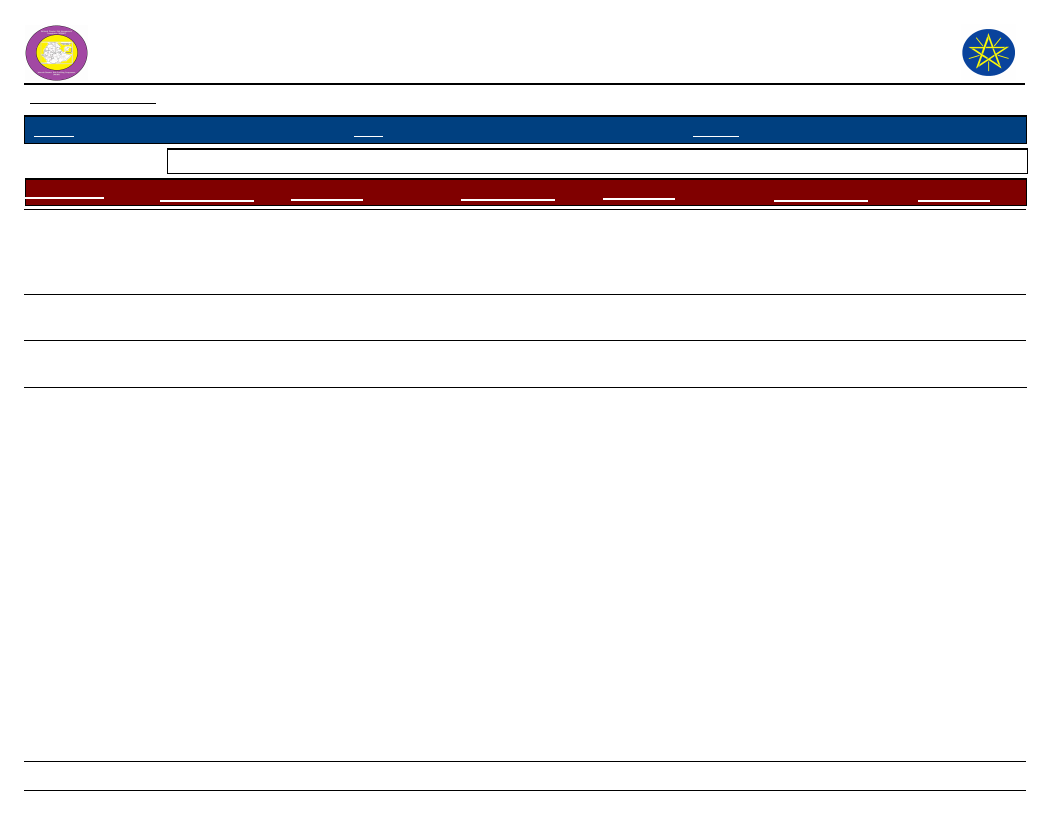
Wereda Disaster
Risk Profile
Data_Collected_Date
National Disaster Risk Management
Commission (NDRMC)
Wednesday, July 10, 2019
Region S.N.N.P
Zone GURAGE
Wereda MESKAN
Selected Indicator
Kebele Name
YETABON
YIMERWACHO
2NYA
YIMERWACHO
3NYA
Capacity: Alternative Livelihood Sources - Alternative livelihood sources suggested by the community
Work_Option_1
Comment_1
Work_Option_2
Comment_2
Work_Option_3
Shifting plants or
disaster resistant
and early matured
plants
Selling asset
To protect the future
To buy food
Irrigation
Have available ground
water river
Daily labor
Asking others
help
Fattening
To get income
Migration
There is no other option
Available plant residue
fodder
Bee keeping
Comment_3
To get income
permanently
good source of
flower
275
Page 4 of 4
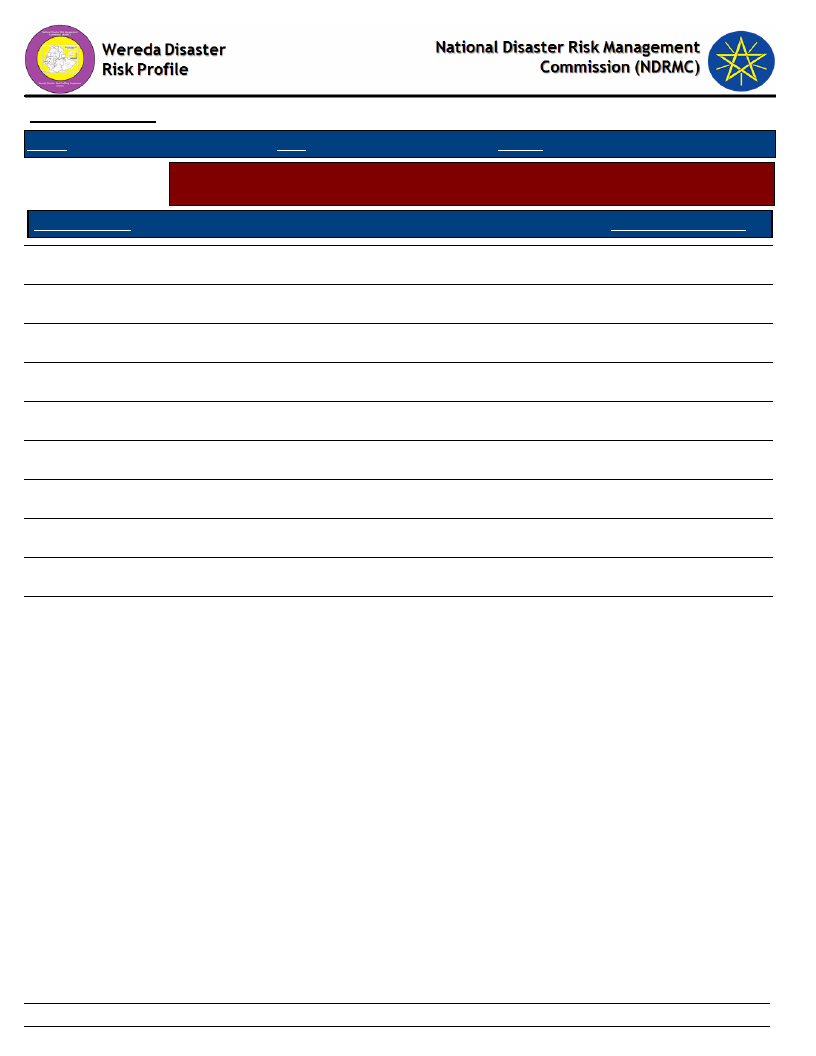
Data_Collected_Date
Region S.N.N.P
Zone GURAGE
Wereda MESKAN
Wednesday, July 10, 2019
Selected Indicator
Type of Disaster
Capacity: Recovery from Losses from Disasters - Percentage of households
recovered from past disasters by type of Disasters
Recovered Percentage
Drought
45.03
Flood
24.56
Crop diseases
11.70
Livestock diseases
7.02
Human diseases
1.17
Storms / hail storm
1.17
Heavy Rain
0.58
Frost / Cold waves
6.43
Conflicts
0.58
No Disaster
1.75
276
Page 1 of 1
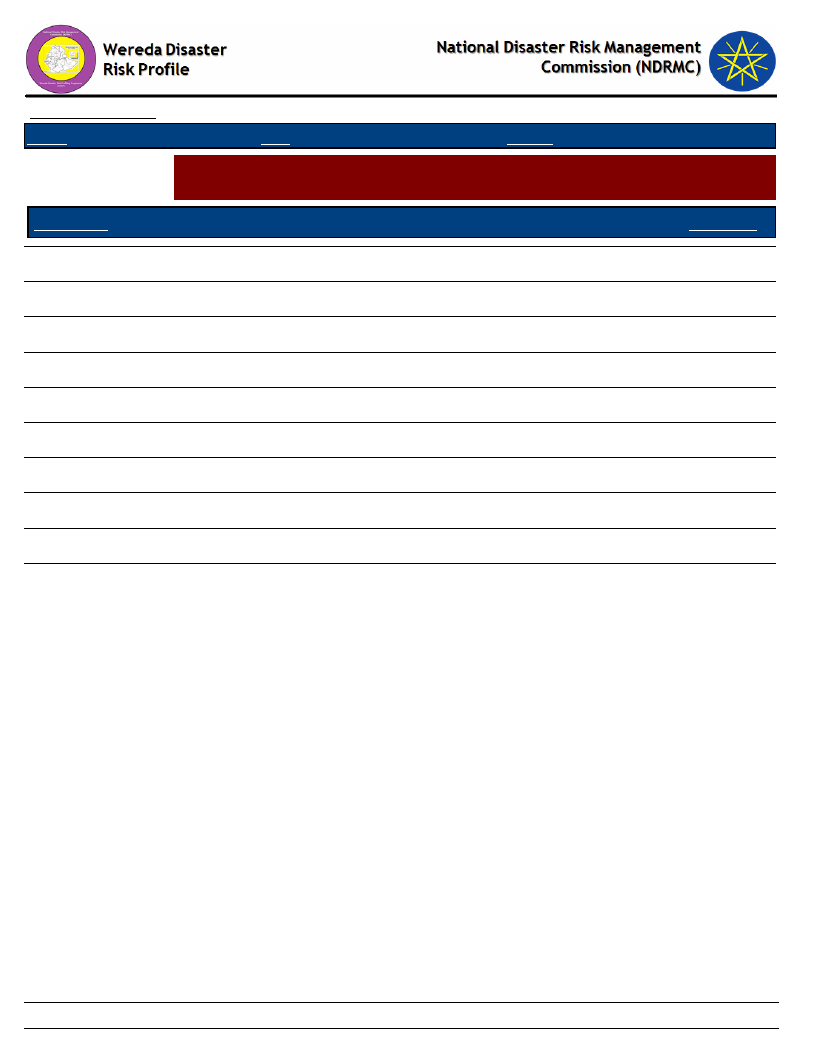
Data_Collected_Date
Region S.N.N.P
Zone GURAGE
Wereda MESKAN
Selected Indicator:
Capacity: Recovery from Losses from Disasters - Proportion of households
recovered by type of Losses
Wednesday, July 10, 2019
Type of Loss
Percentage
Physical damages on houses and property
11.05
Crop damage
69.19
Livestock damage
5.23
Death of household members
0.58
Illness/health problems
3.49
Loss of income
5.81
Livestock were stolen
0.58
Lost access to grazing land
1.16
Lost access to water source
0.58
Other losses/damages
2.33
277
Page 1 of 1
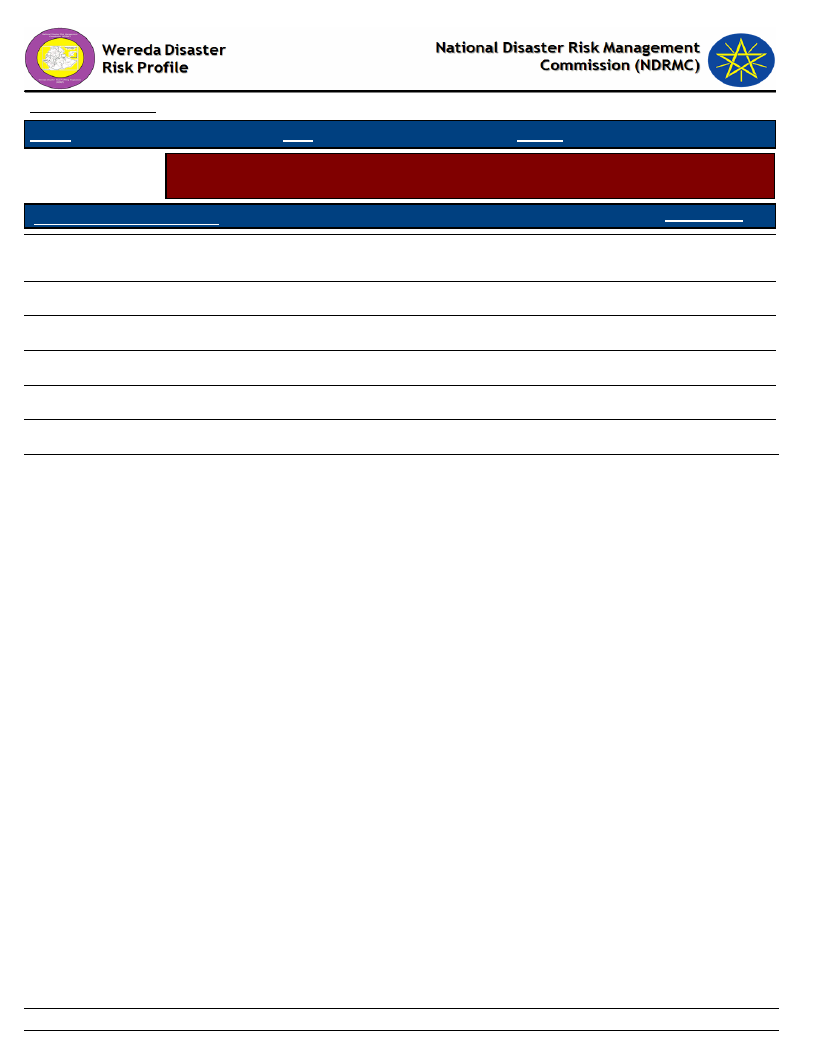
Data_Collected_Date
Region S.N.N.P
Zone GURAGE
Wednesday, July 10, 2019
Wereda MESKAN
Selected Indicator
Capacity: Coping Options if More Resources Available - What coping strategy
could be adopted if more resource were available?
Coping Strategy To Be Adopted
Response (%)
Adaptation of economic activities to hazards season (e.g. cropping cycle, short term
crops, etc.)
Storage of food and other necessities
40.28
24.44
Physical protection of buildings and property
31.94
Changing residence area/migration
1.67
Others (specify)
1.39
None
0.28
278
Page 1 of 1
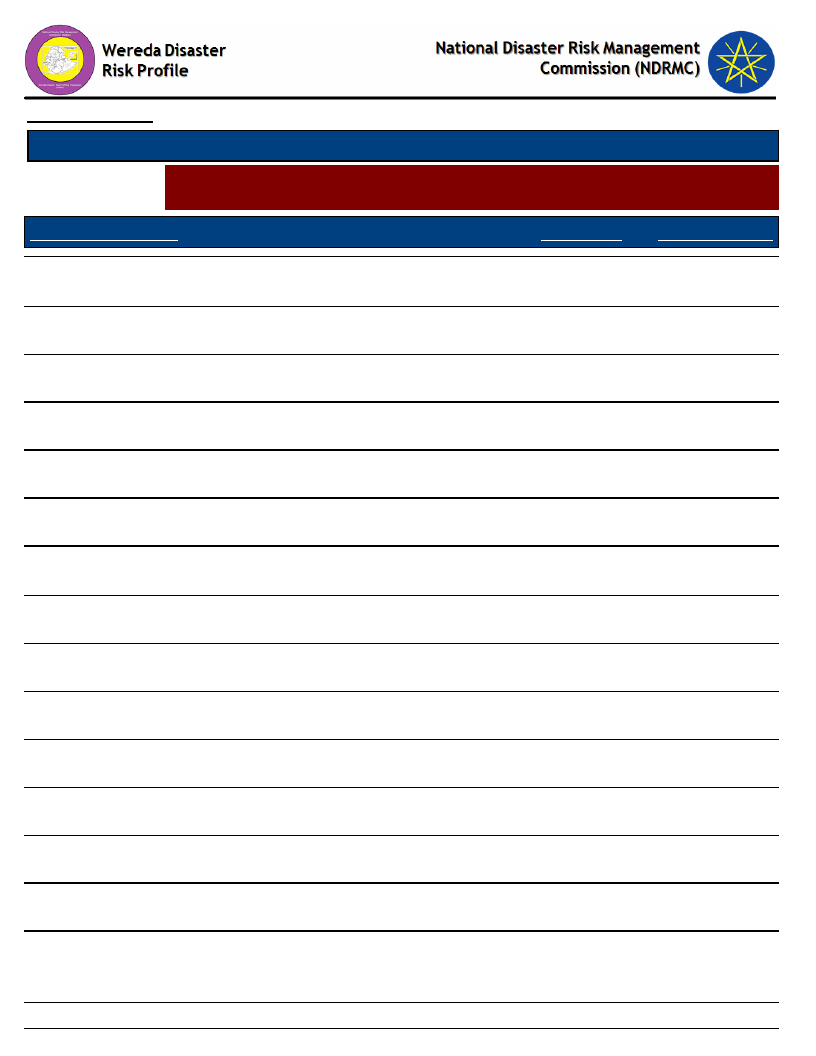
Data_Collected_Date
Wednesday, July 10, 2019
Region S.N.N.P
Selected Indictor:
Zone GURAGE
Wereda MESKAN
Capacity: Coping Strategies Adopted by Households - Percentage of households by
major type of coping strategies adopted (at least once)
Coping Strategy Adopted
Main Strategy
Secondary Strategy
Reduced expenditure on non-essential items (beer, cigarettes,
clothes, meat, etc.)
Consumption rather than sale of crop surplus
12.57
17.07
13.51
10.81
Sell more livestock than usual
5.99
5.41
Borrowing of food or cash (including purchasing food on credit)
1.50
8.11
Sale of productive assets (land, farm implements, vehicle, etc.)
0.60
0.00
Sending children of household for work
0.30
2.70
Reduced expenditure on productive inputs (fertilizer, seeds,
livestock drugs, etc.)
Short-term / seasonal labor migration
1.50
2.70
2.99
10.81
Increased working hours
13.47
29.73
Seek alternative or additional jobs
19.16
2.70
Rely on less preferred and less expensive food
2.10
2.70
Limit portion size at meals
0.60
8.11
Restrict consumption by adults in order for small children to eat
0.30
0.00
Begging for money or for food
2.40
0.00
Others -
8.68
0.00
279
Page 1 of 2
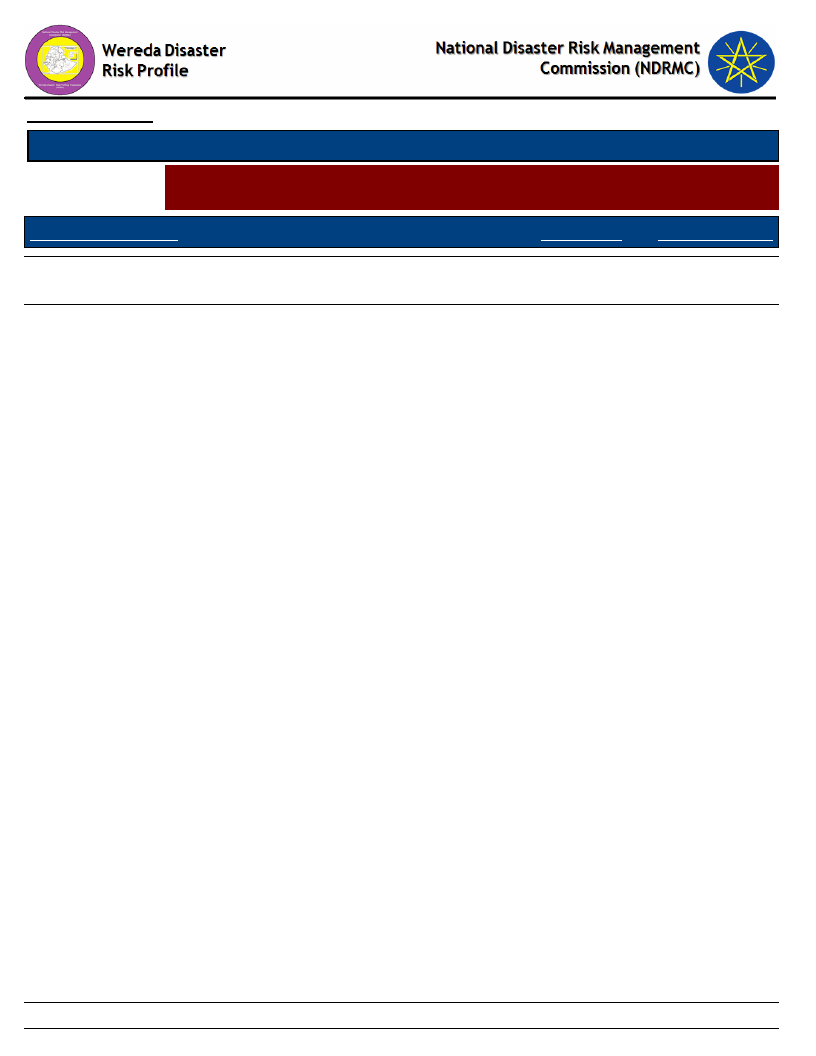
Data_Collected_Date
Wednesday, July 10, 2019
Region S.N.N.P
Selected Indictor:
Zone GURAGE
Wereda MESKAN
Capacity: Coping Strategies Adopted by Households - Percentage of households by
major type of coping strategies adopted (at least once)
Coping Strategy Adopted
Main Strategy
Secondary Strategy
Others -
0.60
0.00
No coping strategy adopted
10.18
0.00
280
Page 2 of 2
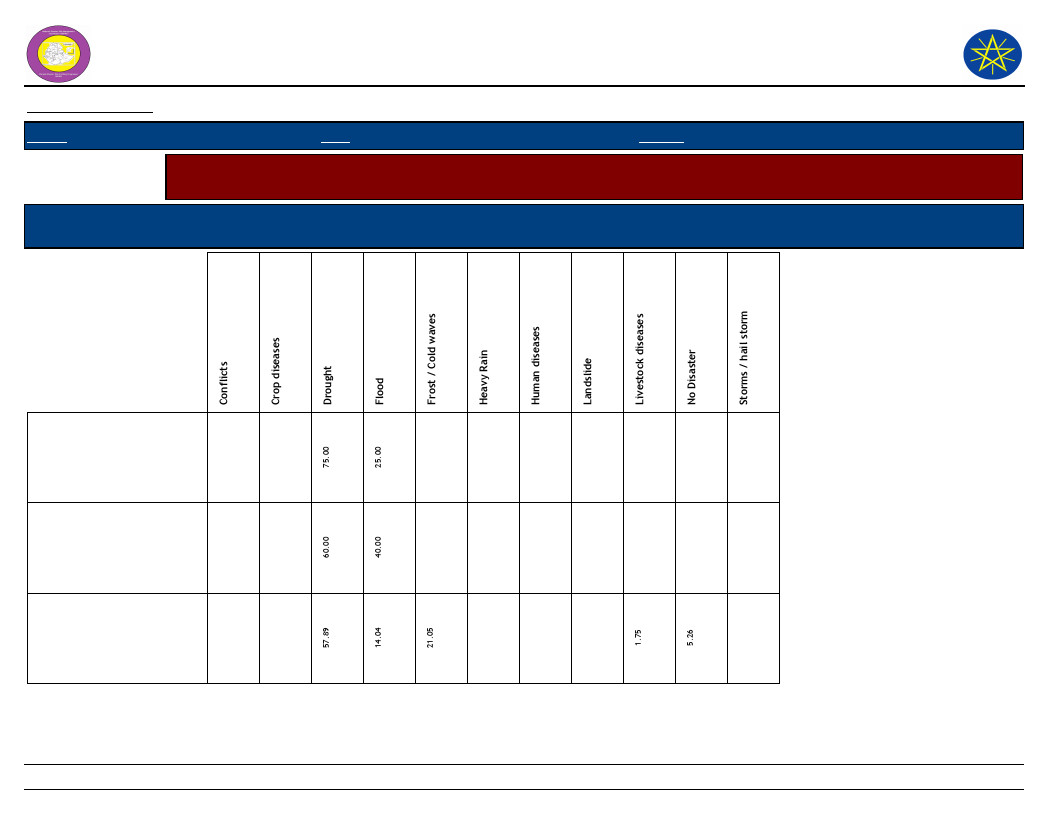
Wereda Disaster
Risk Profile
National Disaster Risk Management
Commission (NDRMC)
Data_Collected_Date
Region S.N.N.P
Zone GURAGE
Wereda MESKAN
Selected Indicator
Capacity: Coping Strategies Adopted by Households - Main coping strategies adopted by households for respective
disasters
Coping Strtegies Adopted
Types of disaters for which HHs in the community adopt the listed
Coping Strtegies
Wednesday, July 10, 2019
Begging for money or for
food
Borrowing of food or cash
(including purchasing food
on credit)
Consumption rather than
sale of crop surplus
281
Page 1 of 6
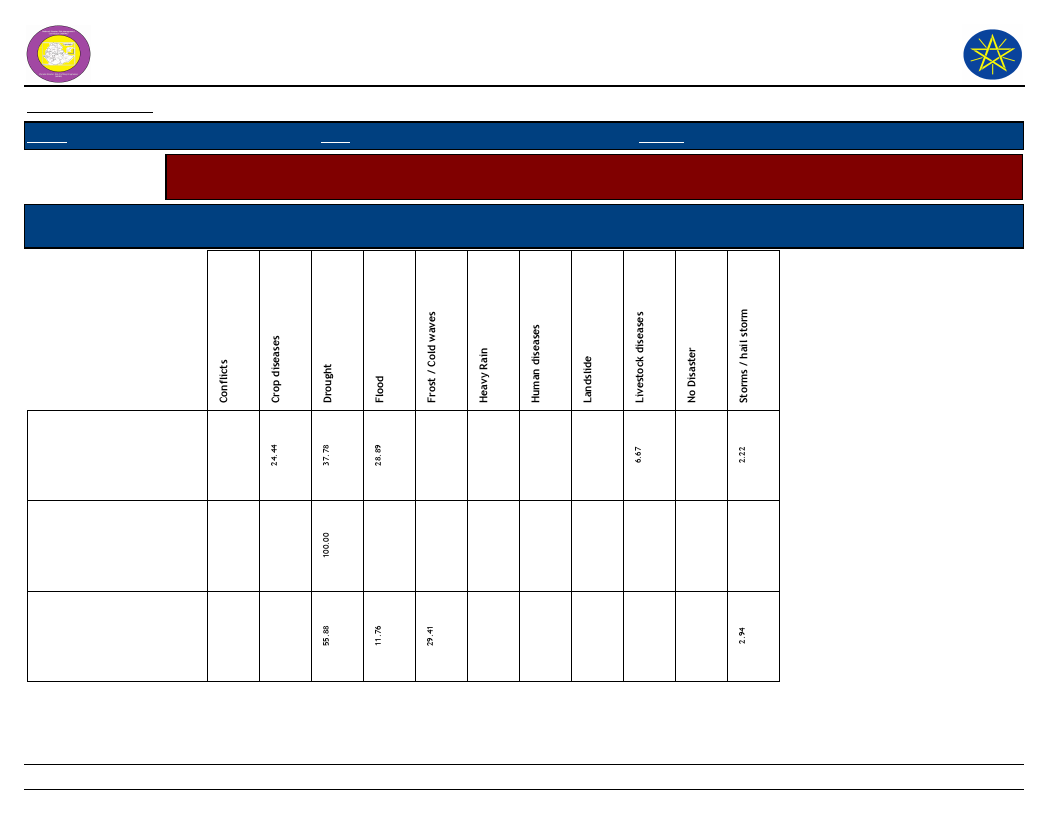
Wereda Disaster
Risk Profile
National Disaster Risk Management
Commission (NDRMC)
Data_Collected_Date
Region S.N.N.P
Zone GURAGE
Wereda MESKAN
Selected Indicator
Capacity: Coping Strategies Adopted by Households - Main coping strategies adopted by households for respective
disasters
Coping Strtegies Adopted
Types of disaters for which HHs in the community adopt the listed
Coping Strtegies
Wednesday, July 10, 2019
Increased working hours
Limit portion size at meals
No coping strategy
adopted
282
Page 2 of 6
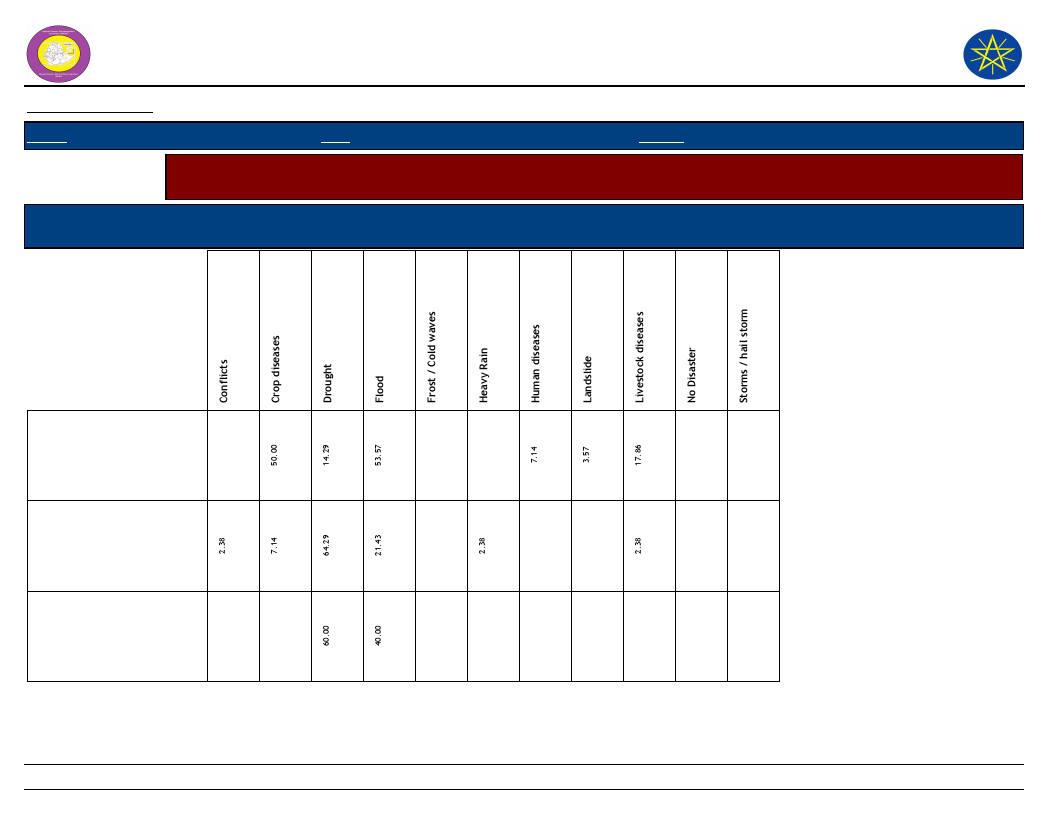
Wereda Disaster
Risk Profile
National Disaster Risk Management
Commission (NDRMC)
Data_Collected_Date
Region S.N.N.P
Zone GURAGE
Wereda MESKAN
Selected Indicator
Capacity: Coping Strategies Adopted by Households - Main coping strategies adopted by households for respective
disasters
Coping Strtegies Adopted
Types of disaters for which HHs in the community adopt the listed
Coping Strtegies
Wednesday, July 10, 2019
Others -
Reduced expenditure on
non-essential items (beer,
cigarettes, clothes, meat,
etc.)
Reduced expenditure on
productive inputs
(fertilizer, seeds,
livestock drugs, etc.)
283
Page 3 of 6
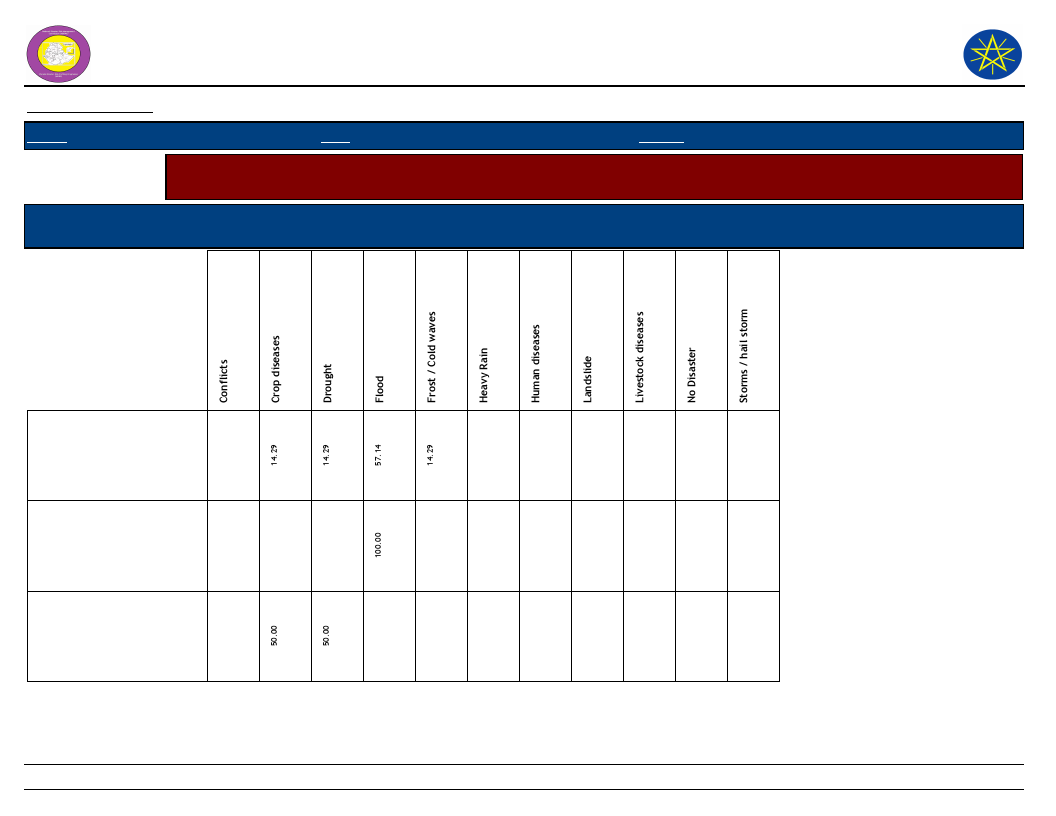
Wereda Disaster
Risk Profile
National Disaster Risk Management
Commission (NDRMC)
Data_Collected_Date
Region S.N.N.P
Zone GURAGE
Wereda MESKAN
Selected Indicator
Capacity: Coping Strategies Adopted by Households - Main coping strategies adopted by households for respective
disasters
Coping Strtegies Adopted
Types of disaters for which HHs in the community adopt the listed
Coping Strtegies
Wednesday, July 10, 2019
Rely on less preferred and
less expensive food
Restrict consumption by
adults in order for small
children to eat
Sale of productive assets
(land, farm implements,
vehicle, etc.)
284
Page 4 of 6
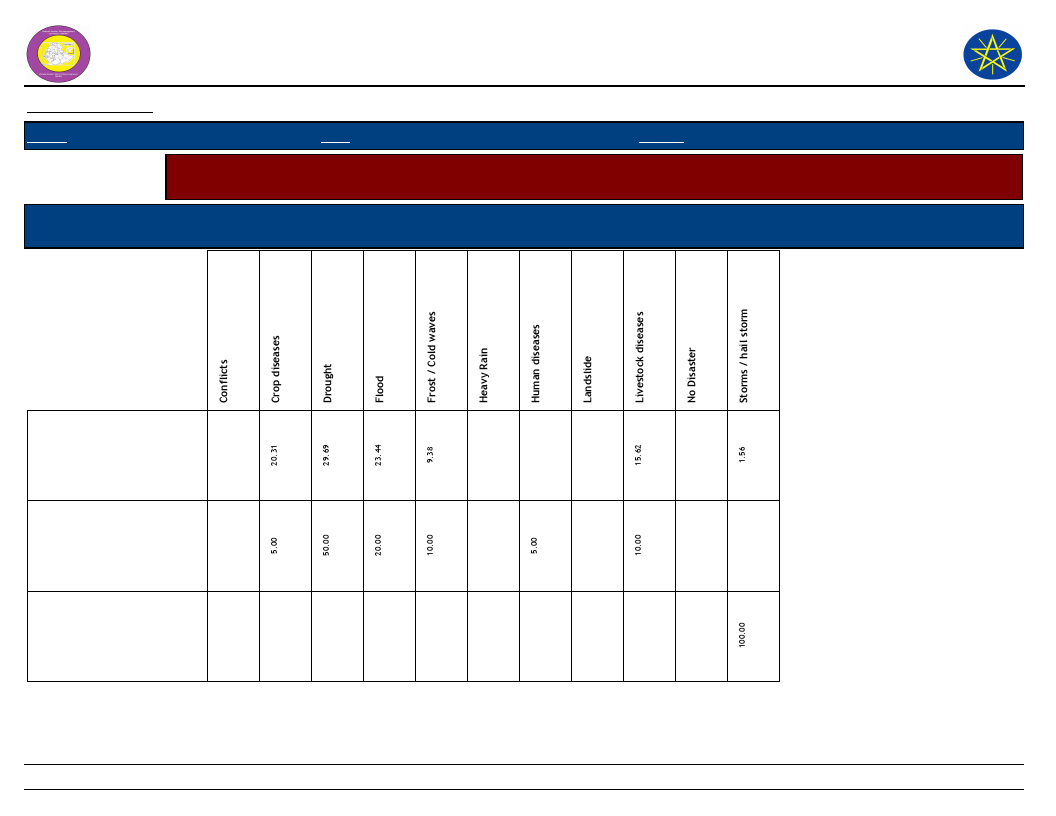
Wereda Disaster
Risk Profile
National Disaster Risk Management
Commission (NDRMC)
Data_Collected_Date
Region S.N.N.P
Zone GURAGE
Wereda MESKAN
Selected Indicator
Capacity: Coping Strategies Adopted by Households - Main coping strategies adopted by households for respective
disasters
Coping Strtegies Adopted
Types of disaters for which HHs in the community adopt the listed
Coping Strtegies
Wednesday, July 10, 2019
Seek alternative or
additional jobs
Sell more livestock than
usual
Sending children of
household for work
285
Page 5 of 6
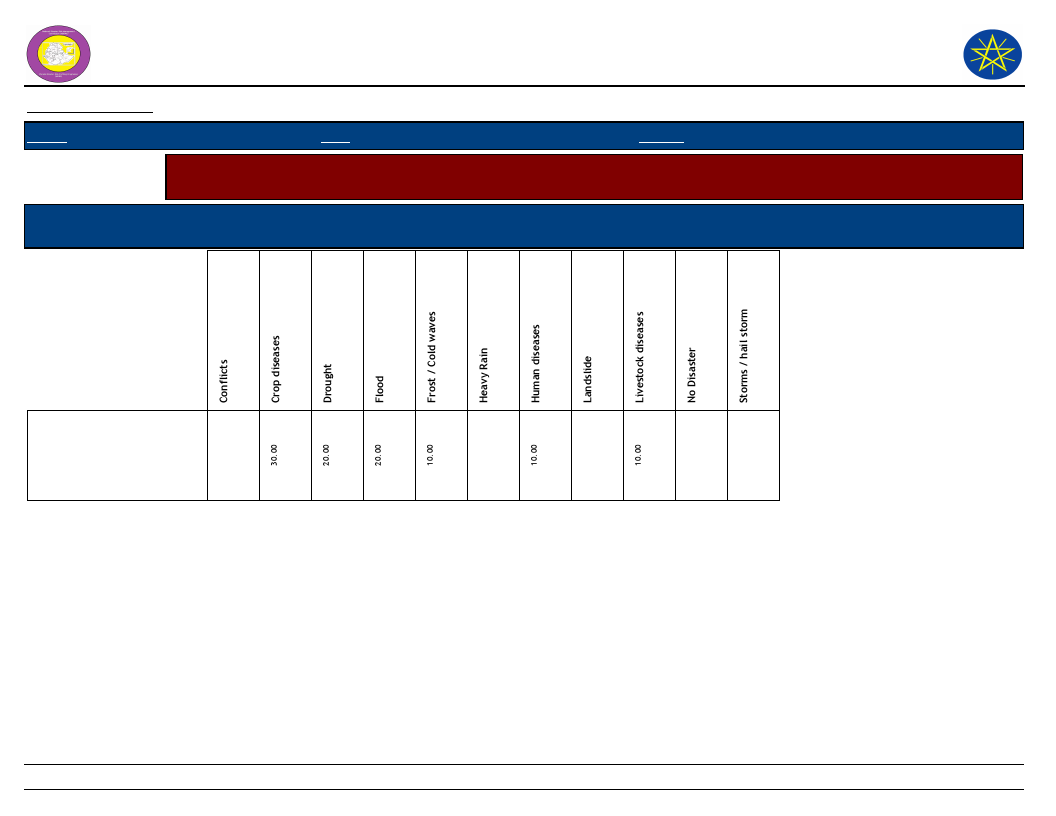
Wereda Disaster
Risk Profile
National Disaster Risk Management
Commission (NDRMC)
Data_Collected_Date
Region S.N.N.P
Zone GURAGE
Wereda MESKAN
Selected Indicator
Capacity: Coping Strategies Adopted by Households - Main coping strategies adopted by households for respective
disasters
Coping Strtegies Adopted
Types of disaters for which HHs in the community adopt the listed
Coping Strtegies
Wednesday, July 10, 2019
Short-term / seasonal
labor migration
286
Page 6 of 6
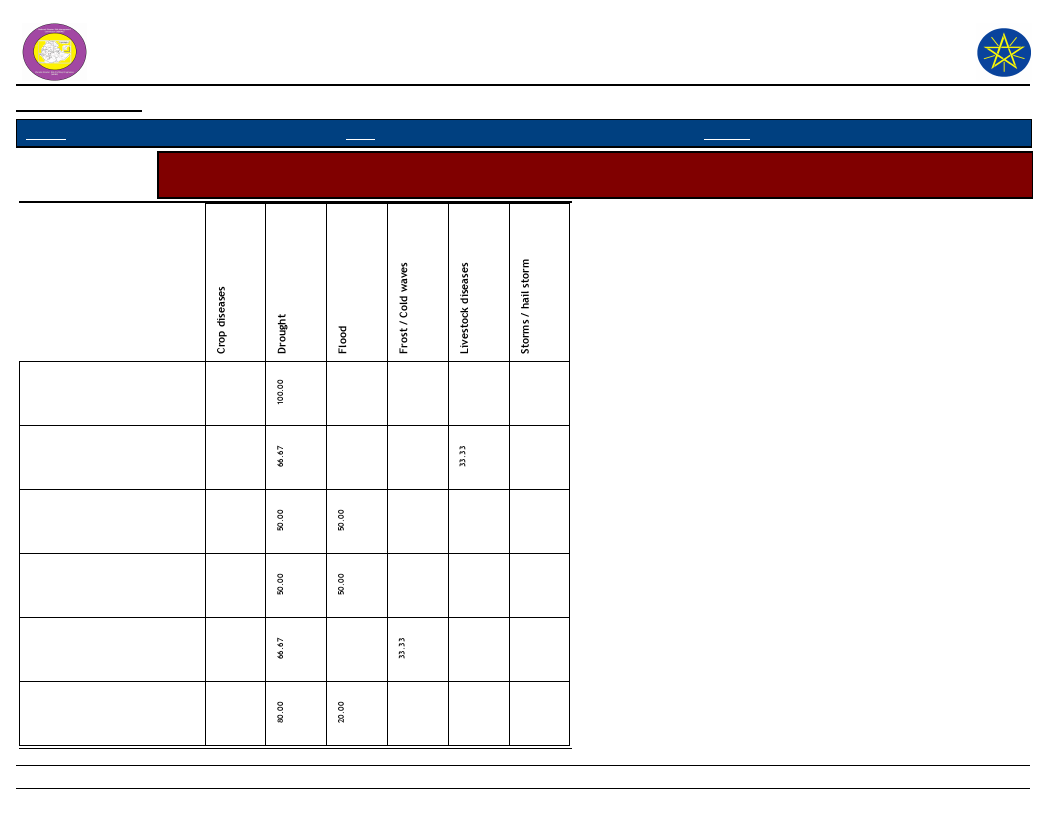
Wereda Disaster Risk
Profile
National Disaster Risk Management
Commission (NDRMC)
Data_Collected_Date
Region S.N.N.P
Zone
GURAGE
Wereda MESKAN
Wednesday, July 10, 2019
Selected Indicator
Capacity: Coping Strategies Adopted by Households - Secondary coping strategies adopted by households for
respective disasters
Begging for money or for
food
Borrowing of food or cash
(including purchasing food
on credit)
Consumption rather than
sale of crop surplus
Increased working hours
No coping strategy adopted
Reduced expenditure on
non-essential items (beer,
cigarettes, clothes, meat,
287
Page 1 of 2
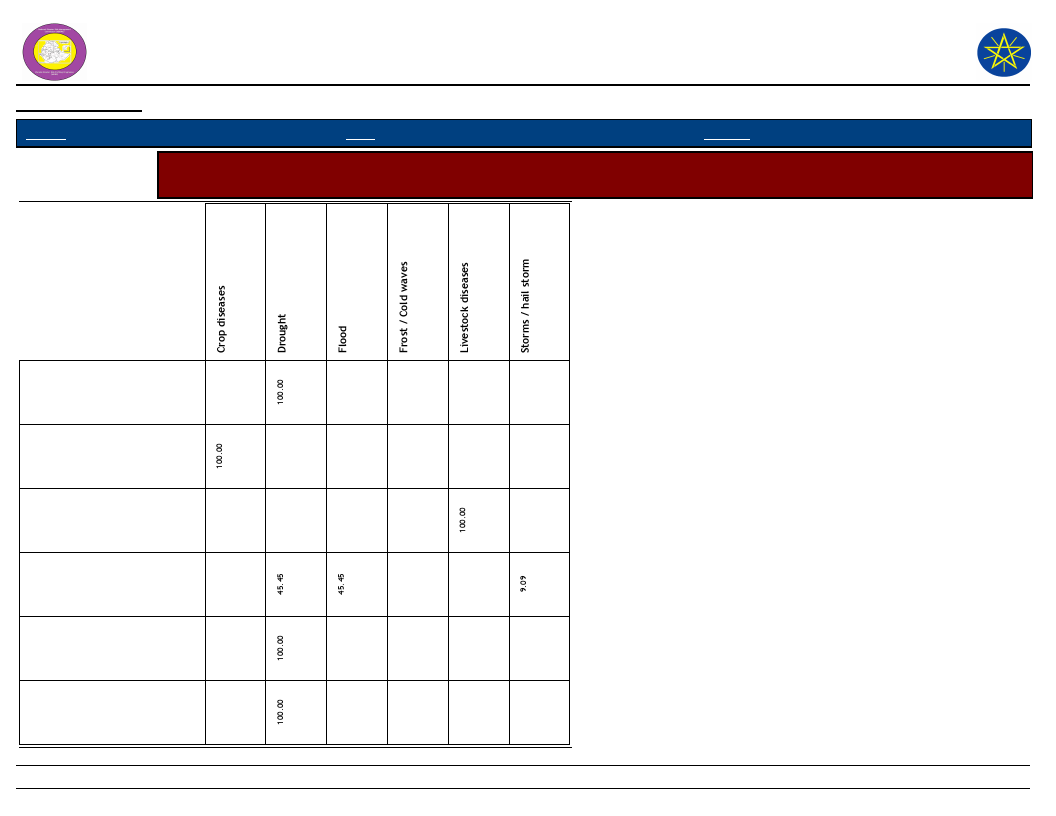
Wereda Disaster Risk
Profile
National Disaster Risk Management
Commission (NDRMC)
Data_Collected_Date
Region S.N.N.P
Zone
GURAGE
Wereda MESKAN
Wednesday, July 10, 2019
Selected Indicator
Capacity: Coping Strategies Adopted by Households - Secondary coping strategies adopted by households for
respective disasters
Rely on less preferred and
less expensive food
Sale of non-productive
assets (Jewelry, clothing,
etc.)
Sale of productive assets
(land, farm implements,
vehicle, etc.)
Seek alternative or
additional jobs
Sell more livestock than
usual
Sending children of
household for work
288
Page 2 of 2
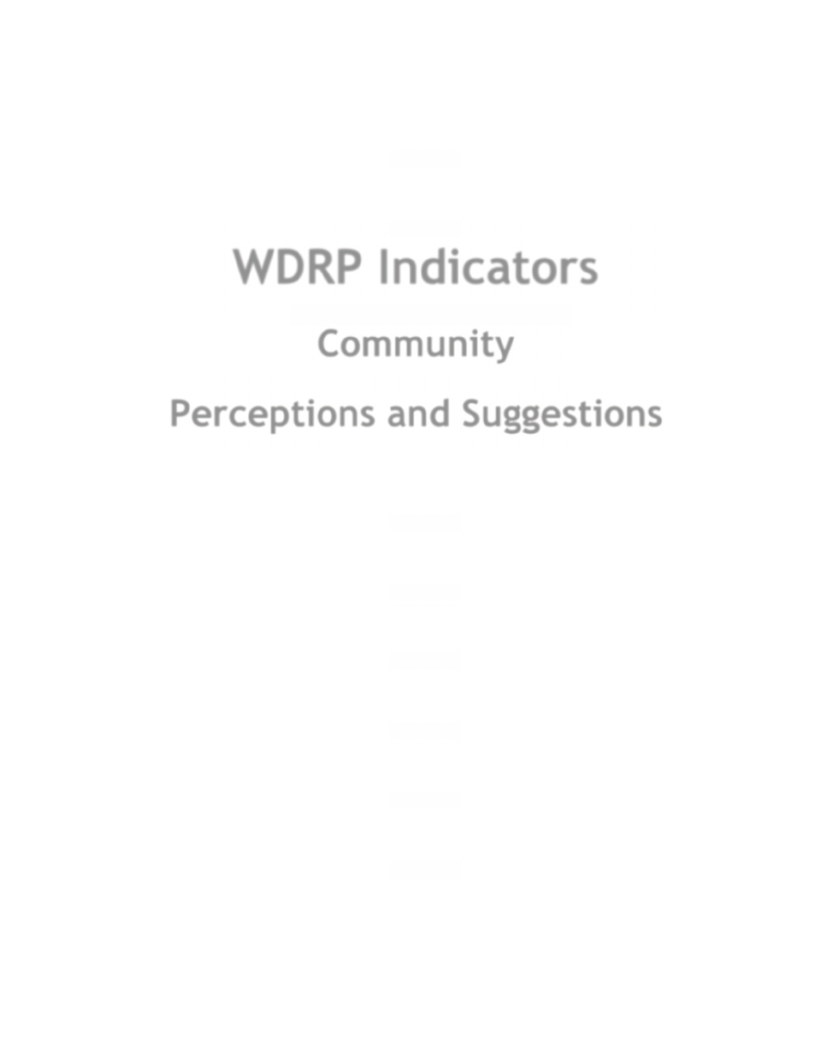
WDRP Indicators
Community
Perceptions and Suggestions
289
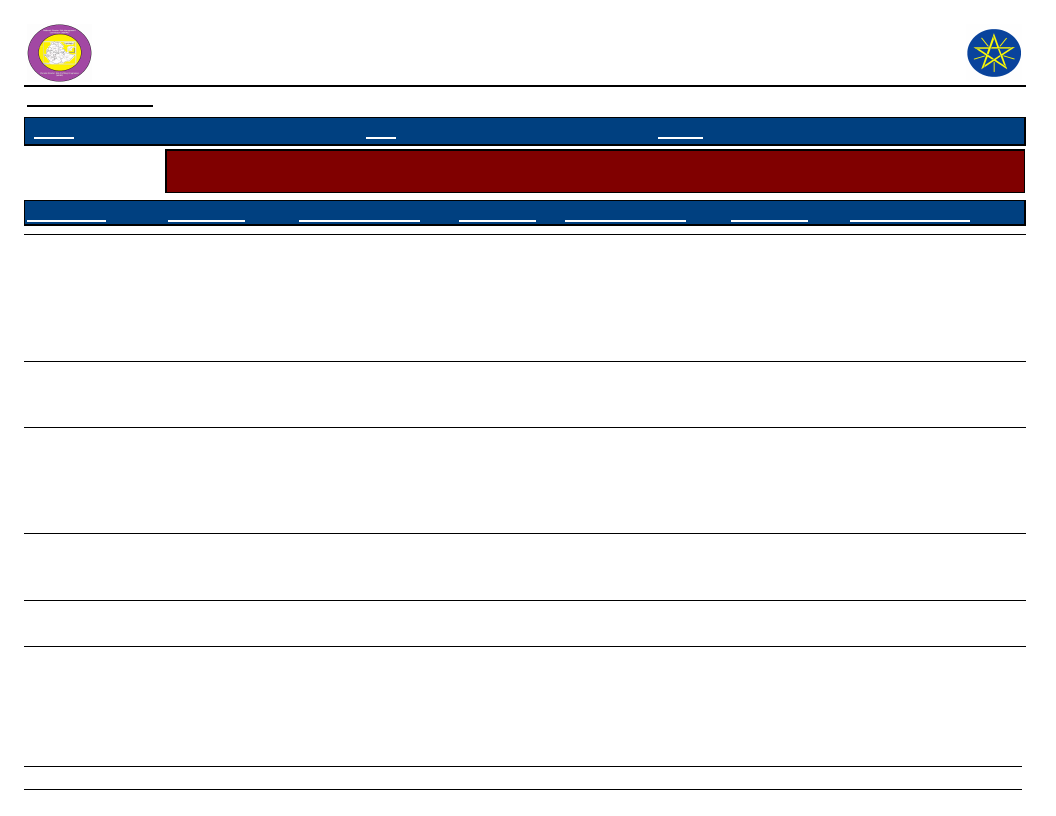
Wereda Disaster
Risk Profile
Data_Collected_Date
National Disaster Risk Management
Commission (NDRMC)
Wednesday, July 10, 2019
Region S.N.N.P
Zone
GURAGE
Wereda MESKAN
Selected Indicator
Kebele Name
Interventions: Community Perception on Mediums to Influence DRM Actors - Community perception on the
effectiveness of institutional channels to use to influence DRM actors
Institution_1
Process_Description
Institution_2 Process_Description
Institution_3
Process_Description
BATI FATO
Kebele
administration
BATI LEJANO
Radio
BECHE BULCHANO
Kebele
administration
BERESA
Radio
DEBO TUTO
Radio
DEBUB SHERSHERA
Kebele
administration
Report the
communities
problem to
administration and
then to responsible
bodies
Information from
new
Report the problems
of the community to
kebele and then to
other bodies
Listening news
Agriculture
office
Report to extension
agents and to the
command to wereda
Wereda
natural
resource office
Woreda
administration
News pepper
Contact extension
agents
If the kebele must
can not get at the
time then we go to
wereda
administration
Reading
By sharing
information
Report to kebele
then to wereda
News paper
By reading
Risk
management
Report to kebele risk
management if we
can not get
management
Education
office (School)
Report to school and
transfer the
information by student
to community
Mobile, news
paper
Exchange information
through social media
Informality
from kebele to
town
Kebele to town
Direct contact by using
mobile
By using mobile
Wereda
disaster
If we can not get
kebele administration
290
Page 1 of 5
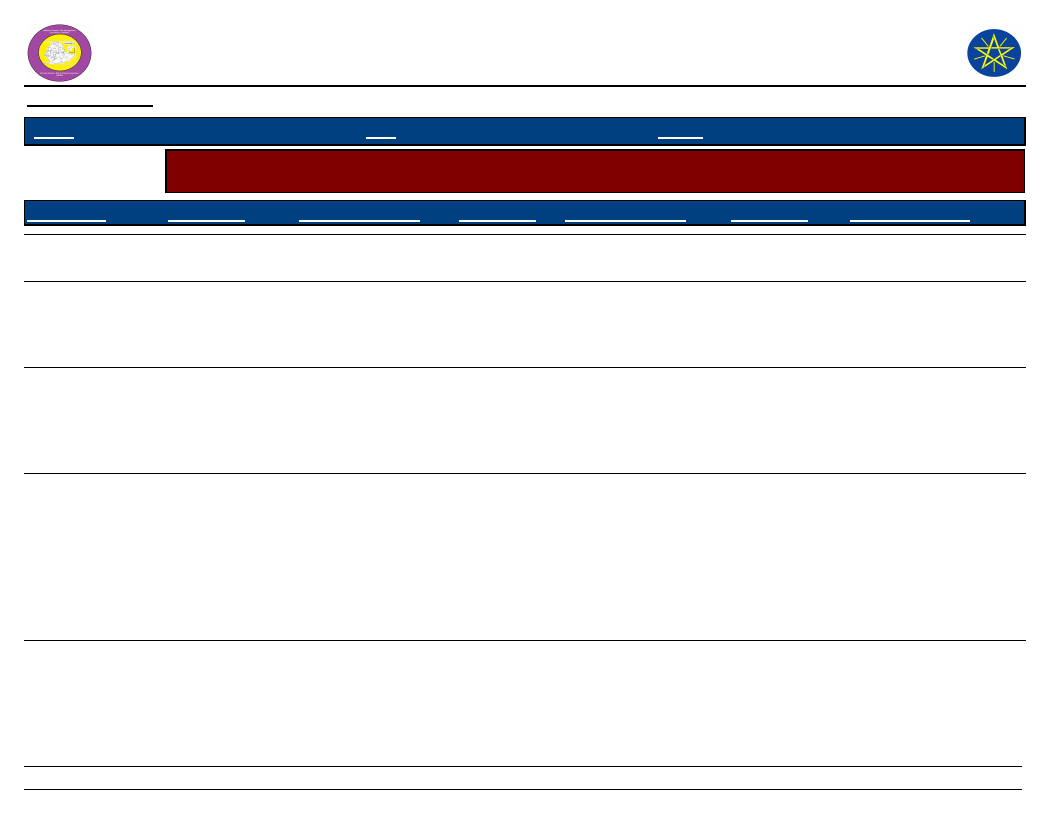
Wereda Disaster
Risk Profile
Data_Collected_Date
National Disaster Risk Management
Commission (NDRMC)
Wednesday, July 10, 2019
Region S.N.N.P
Zone
GURAGE
Wereda MESKAN
Selected Indicator
Kebele Name
Interventions: Community Perception on Mediums to Influence DRM Actors - Community perception on the
effectiveness of institutional channels to use to influence DRM actors
Institution_1
Process_Description
Institution_2 Process_Description
Institution_3
Process_Description
DEGAGOGOT
DIDA
DIRAMA
Kebele
administration
Kebele
administrating
Kebele
administration
DOBENA
Kebele
Administration
GIDENA ABORAT
Kebeles
administration
Reporting
We have report our
problems to kebele
administration and
then to wereda
Define the disaster
or problems to the
chair man and to
transmit the issues
to wereda
Report our problems
to kebele and then
transfer to
responsible bodies
If we have to get
any disaster we
contact our kebele
leader and then
transfer to helps
Wereda
administration
If we can not get
solution we have to
go to wereda
Kebele food
security
committee
Kebele
developmental
agent
If we can not get
kebele authority and
who received our
feeling and then
transfer to wereda
Report to the
communities to the
staff and
development agent
transfer the
information to the
government and
community
Health post
Report to the
communities to the
staff and health
extension transfer the
information to the
government and
community
291
Page 2 of 5
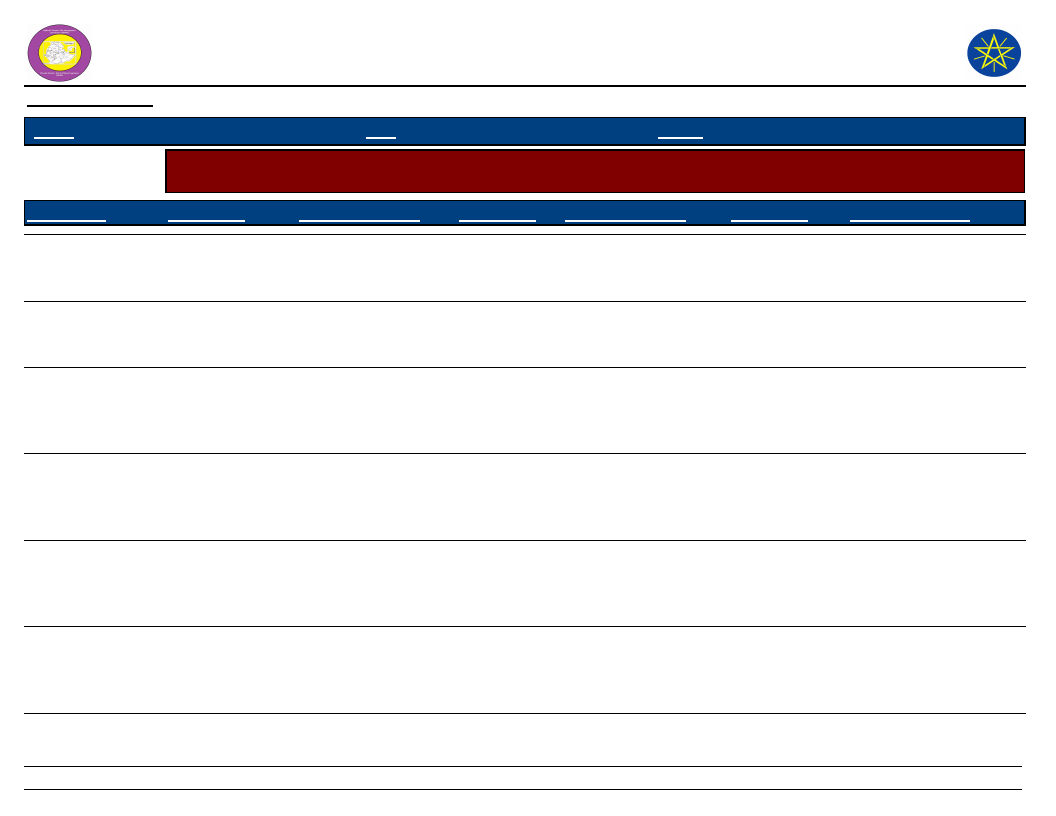
Wereda Disaster
Risk Profile
Data_Collected_Date
National Disaster Risk Management
Commission (NDRMC)
Wednesday, July 10, 2019
Region S.N.N.P
Zone
GURAGE
Wereda MESKAN
Selected Indicator
Kebele Name
Interventions: Community Perception on Mediums to Influence DRM Actors - Community perception on the
effectiveness of institutional channels to use to influence DRM actors
Institution_1
Process_Description
Institution_2 Process_Description
Institution_3
Process_Description
GOYBAN
ILE
INSENO USME
Kebele
administration
Radio
Radio
JOLE ANDENYA
Radio
JOLE HULETENYA
Kebele
administration
MEKICHO
Kebele
administration
MESERETEWEGERA
MO
Radio
Reporting
Information from
news
Information for news
Listening radio
Report our feelings
and solve minor
problem and report
the others
Report to kebele
administration then
to wereda and to
the community
Get information
from news
Kebele early
warning
committee
News paper
Reporting
Reading
Kebele
agricultural
extension
office
Wereda farm
and natural
resource office
Contact the extension
agent
Kebele extension
agent share
information to the
community
Agriculture
office
From neighbor
kebele
292
Informed our
problems and transfer
to wereda
administration
Contact and talk each
other
Wereda
agriculture
office
Mobile network
News paper
and calling by
mobile phone
Reporting
Exchange information
through mobile phone
network
Exchange information
through mobile network
From neighbor
wereda and
kebeles
Sharing information
Education
Mobile
To school community
received our
information and then to
the community
Exchange information
through mobile
Page 3 of 5
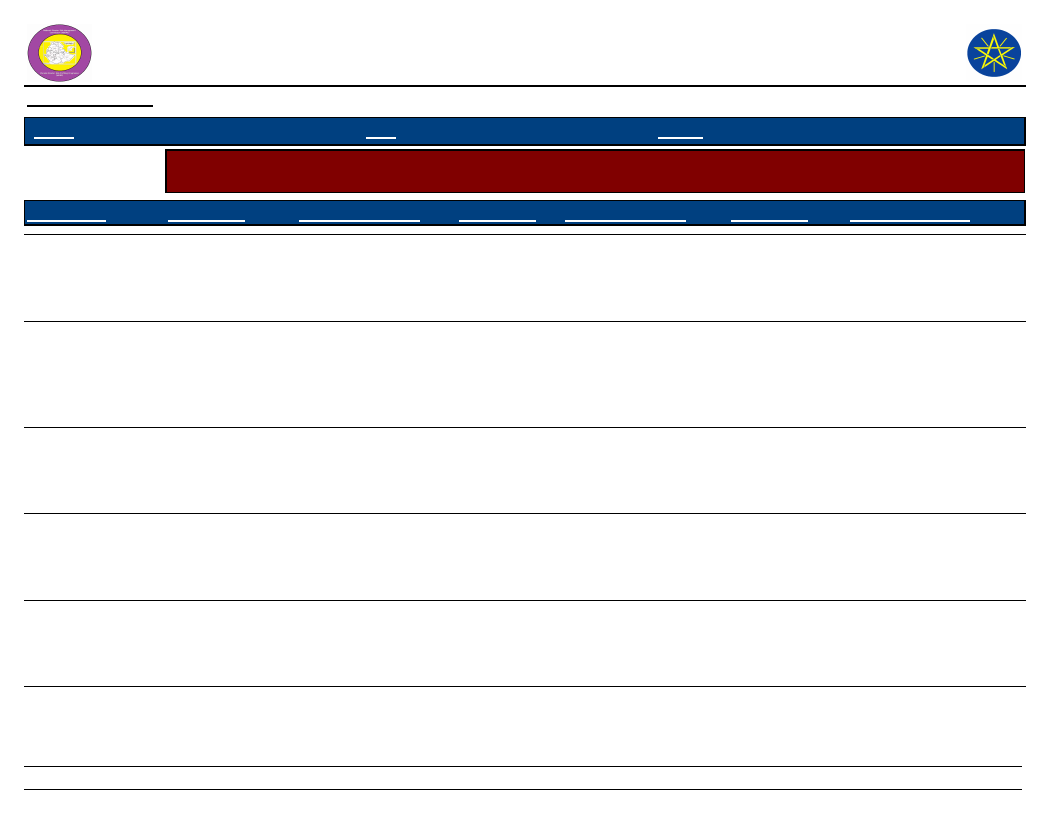
Wereda Disaster
Risk Profile
Data_Collected_Date
National Disaster Risk Management
Commission (NDRMC)
Wednesday, July 10, 2019
Region S.N.N.P
Zone
GURAGE
Wereda MESKAN
Selected Indicator
Kebele Name
Interventions: Community Perception on Mediums to Influence DRM Actors - Community perception on the
effectiveness of institutional channels to use to influence DRM actors
Institution_1
Process_Description
Institution_2 Process_Description
Institution_3
Process_Description
MIKAELO
MIRAB IMBOR
MIRAB MESKAN
OCHAGENEME
SEMEN
SHORSHORA
SHERSHERA
MACHMENA
Radio medium
Kebele
administration
Kebele
administration
Radio
Kebele
administrative
Kebele
administration
Information flows
from the medium
and higher the
community
The community
feeling reported to
the chair man and
then to the
responsible bodies
Report to kebele
then transfer to
wereda responsible
bodies
Information from
news
Report for wereda
agricultural office
and wereda
administration
If there is any
problem we report
News paper
By reading
Mobile
Wereda
representative
If the kebeles
administration not
present the area we
informed to weredas
Exchange information
each other
Wereda farm
and natural
resource office
Contact the wereda
experts and extension
workers
Kebele early
warning
committee
Gathering information
of the community
Mobile
information
from different
area
Wereda
agricultural
office
Direct contact and
exchange information
through mobile network
Report for wereda
administration
293
Page 4 of 5
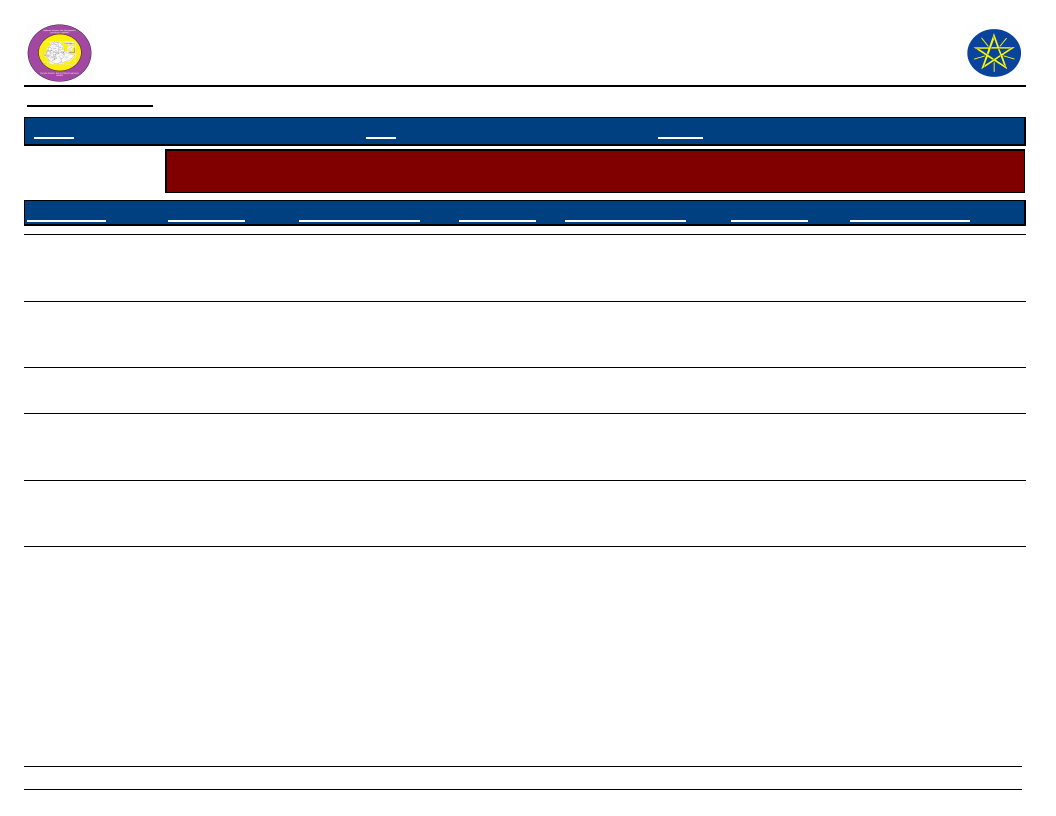
Wereda Disaster
Risk Profile
Data_Collected_Date
National Disaster Risk Management
Commission (NDRMC)
Wednesday, July 10, 2019
Region S.N.N.P
Zone
GURAGE
Wereda MESKAN
Selected Indicator
Kebele Name
Interventions: Community Perception on Mediums to Influence DRM Actors - Community perception on the
effectiveness of institutional channels to use to influence DRM actors
Institution_1
Process_Description
Institution_2 Process_Description
Institution_3
Process_Description
WEJABATI
WITA
WOLENSHO
ANDENYA
YETABON
YIMERWACHO
2NYA
YIMERWACHO
3NYA
Radio
Radio
Radio
Kebele
administration
Kebele
management
Information from
news
Lessening news
direct from radio
channel
Get information
from news
Report to any
disaster to wereda
managements
Transfer our
problem to
responsible body
Wereda farm
and natural
resource office
Wereda farm
and natural
resource office
News paper
Conant the expert
and extension agent
communication with
kebele developmental
agent
By reading
Mobile
Exchange information
through mobile network
From neighbors
wereda or
kebeles
From other
kebele
Information transfer
Direct contact
Farmer
training center
Report to wereda
office
294
Page 5 of 5
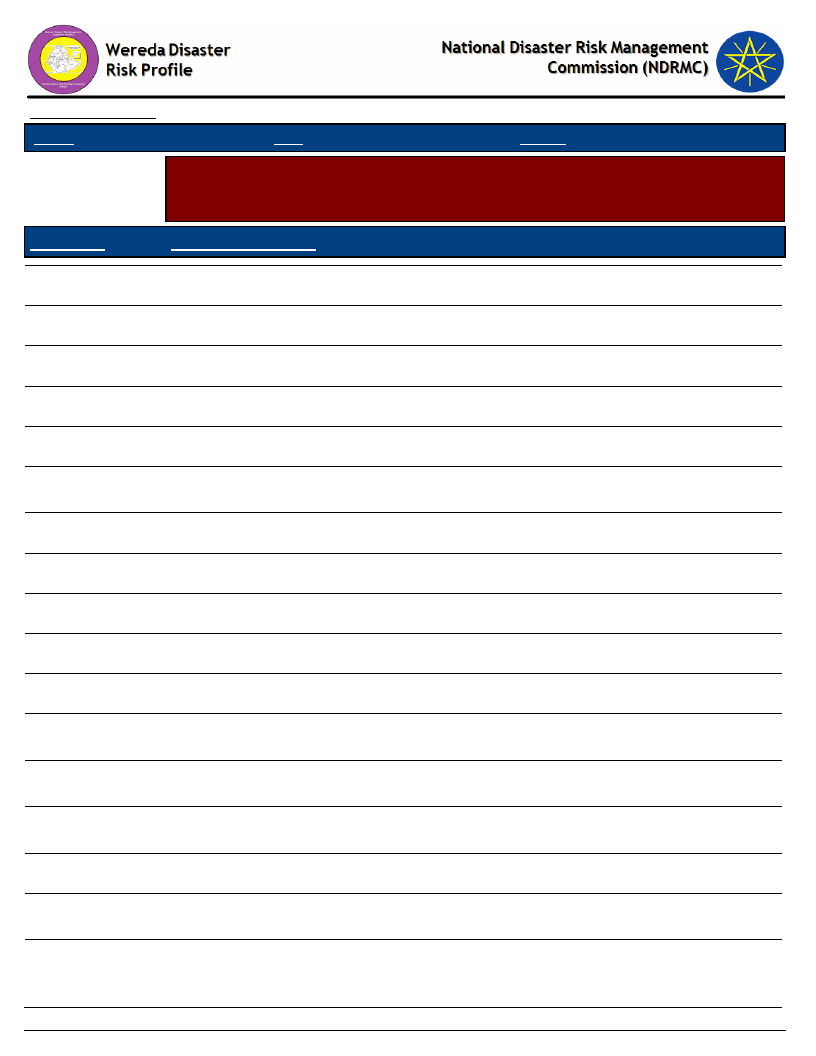
Data_Collected_Date
Region S.N.N.P
Zone
GURAGE
Wednesday, July 10, 2019
Wereda MESKAN
Selected Indicator
Interventions: Community Perception on their Knowledge used in DRM Process -
Perception of the community on how their knowledge influences the priorities
and measures of DRM actors
KebeleName
Community_Suggestions
BATI FATO
Priorities the community feeding
BATI LEJANO
Relief, help the community in water harvesting activities.
BECHE BULCHANO
Priorities firs the authorities but not the community
BERESA
Relief
DEBO TUTO
Sustainable funds and credit opportunity
DEBUB
SHERSHERA
DEGAGOGOT
There is a problem to prioritize to community feeling
Yes, the community idea accepted by the authorities
DIDA
No
DIRAMA
The management prioritize partially the communities feeling
DOBENA
Yes, but the response and practical activities are very late
GIDENA ABORAT
No but the first mandate had been took placed by the management system
GOYBAN
ILE
INSENO USME
JOLE ANDENYA
Yes, the community ideas or suggestions are influence measures taken by the
authorities or risk management institutions
Relief, help the community in soil and water conservation as well as water/harvest
activities
Relief, help the communities in water harvest activity, not any relief also will do
sustainable work that control the disaster
Relief
JOLE HULETENYA
MEKICHO
Listen our feeling and priority for our knowledge and suggestion, nut the response is
very late
Have problem to priorities to our feeling/no influenced our feeling by authority
295
Page 1 of 2
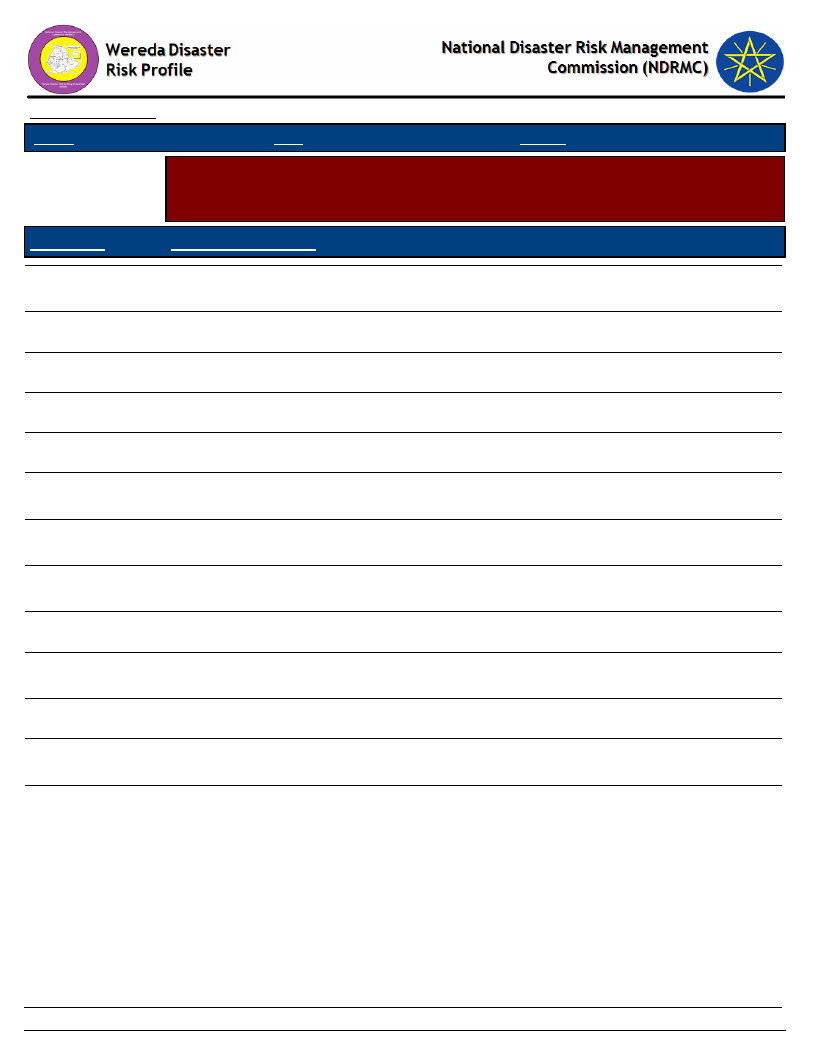
Data_Collected_Date
Region S.N.N.P
Zone
GURAGE
Wednesday, July 10, 2019
Wereda MESKAN
Selected Indicator
Interventions: Community Perception on their Knowledge used in DRM Process -
Perception of the community on how their knowledge influences the priorities
and measures of DRM actors
KebeleName
Community_Suggestions
MESERETEWEGERA
MO
MIKAELO
With sustainable water and soil conservation techniques and afforestation activities
Control of the flood by construction and sustainable dam
MIRAB IMBOR
We have no priorities to our feelings
MIRAB MESKAN
Yes our feeling is listen and response and prioritize our feeling
OCHAGENEME
Relief, help to water harvest in cultivated land
SEMEN
SHORSHORA
SHERSHERA
MACHMENA
WEJABATI
WITA
Yes, the community ideas accepted by the authorities
Relief, help the community in water activity by prepare continue in the cultivated
land
Relief, do different activities to control and mitigate the disasters
WOLENSHO
ANDENYA
YETABON
Construction of sustainable deep water hall in the kebele
Listened our feeling and prior to our suggestion but the response is very late
YIMERWACHO
2NYA
YIMERWACHO
3NYA
Well influenced to authorities of our feelings
Relief, help in water harvest activity, will do sustainable work that control disaster
296
Page 2 of 2
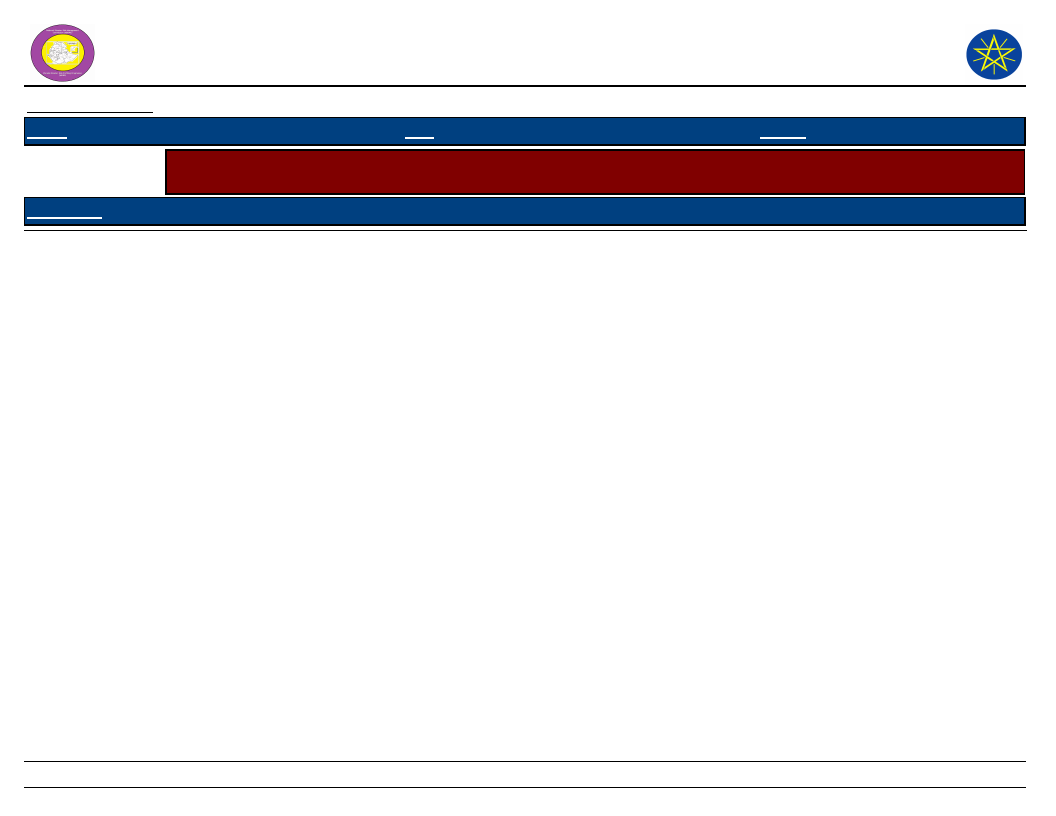
Wereda Disaster Risk
Profile
National Disaster Risk Management
Commission (NDRMC)
Data_Collected_Date
Region
Zone
Wereda
Wednesday, July 10, 2019
Selected Indicator
Interventions: Suggestions to improve preparedness - Interventions suggested by the community to development
actors to improve preparedness in the area
KebeleName
Measure 1
Comment 1
Measure 2
Comment 2
Measure 3
Comment 3
297
Page 1 of 1
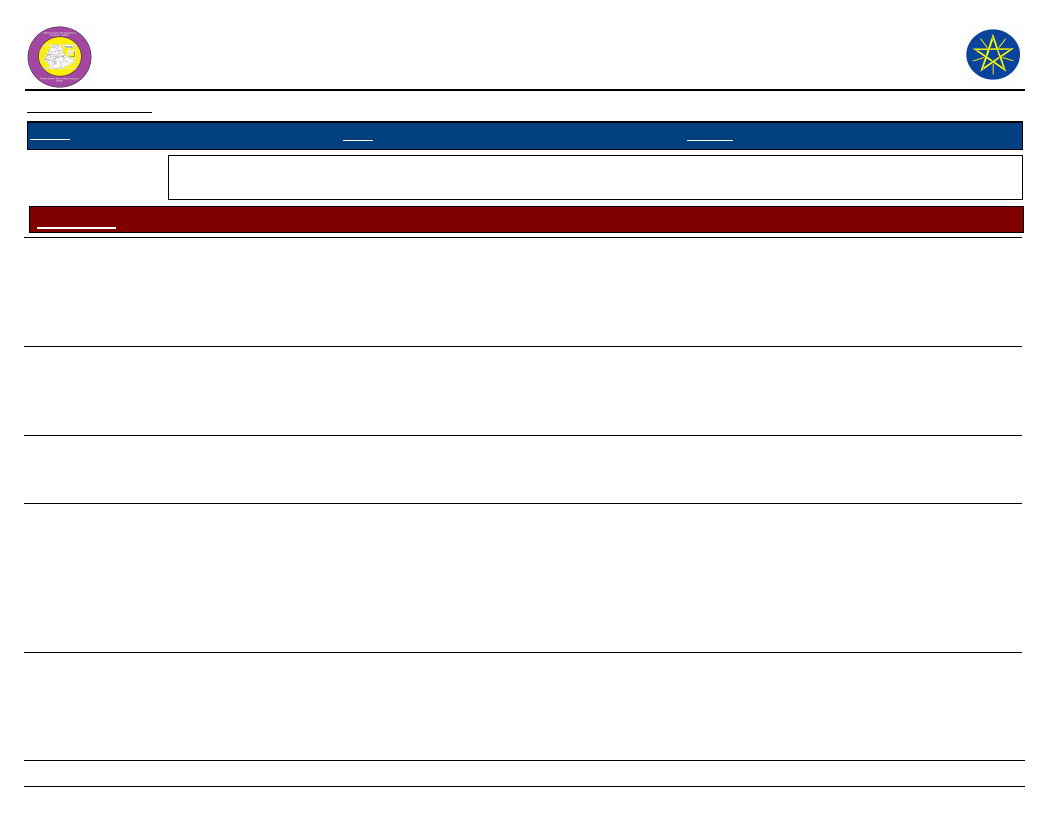
Wereda Disaster Risk
Profile
National Disaster Risk Management
Commission (NDRMC)
Data_Collected_Date
Region S.N.N.P
Zone GURAGE
Wereda MESKAN
Wednesday, July 10, 2019
Selected Indicator
Interventions: Suggestions to DRM Actors in the Area - Community suggested measures to DRM actors in the area
for effective DRM actions
Kebele Name
BATI FATO
Measure 1
Facilitate for the
development
activities of
irrigation system
BATI LEJANO
Relief/food aid
BECHE
BULCHANO
BERESA
Relief
Relief
Comment 1
Because the
kebeles have
irrigation
potential /land
and water
To help and to
protect human
life, it is quick
action
To get food the
affected
communities
Due to drought
and flood the
community lost
there asset, ace
economic
problem and
shortage of food
Measure 2
Relief /food
Animal and crop
disease protection help
with the medicine
Money
Constructing water
way, supply
construction
Comment 2
There is shortage
of food due to
shortage of rainfall
Measure 3
Job opportunity
The only way to
protect
To replace loss of
assets by the
disaster
Because it is one of
the largest
problem in the
community
Inputs
Comment 3
To sustain it self
by sowing crop
298
Page 1 of 6
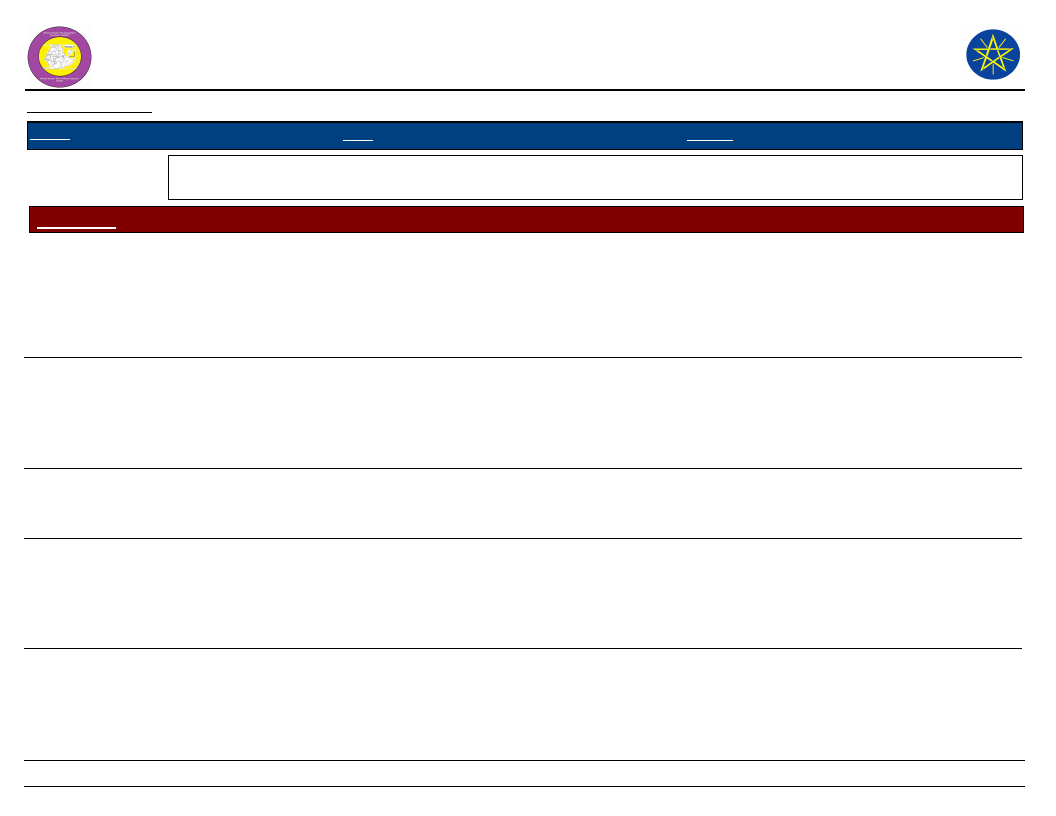
Wereda Disaster Risk
Profile
National Disaster Risk Management
Commission (NDRMC)
Data_Collected_Date
Region S.N.N.P
Zone GURAGE
Wereda MESKAN
Wednesday, July 10, 2019
Selected Indicator
Interventions: Suggestions to DRM Actors in the Area - Community suggested measures to DRM actors in the area
for effective DRM actions
Kebele Name
DEBO TUTO
Measure 1
Relief
DEBUB
SHERSHERA
Supplying food,
money and relief
DEGAGOGOT
Relief support
DIDA
Relief
DIRAMA
Supplying
food/relief and
supplying water
Comment 1
Due to flood and
other hazard the
community lost
their asset
Measure 2
Funds and credit
opportunity
Because food is
the main problem
of the community
Health service
To fill gap
Because the
kebele has very
high food gap
Soil and water
conservation activities
Working for food
To resist from
disaster, control
water born
disease
Clinical service
Comment 2
The land is stony
and sandy, not
fertile, low
productivity so
they need other
job opportunity
Because disease is
the main problem
of the area
To decease soil
erosion
To get food by
working
development
workers
To control human
and livestock
disease
Measure 3
Comment 3
Job opportunity
Solving water
problem
Migration/job
opportunity
Supplying disaster
resistant crop
Community was
migrated to
other area to
search job
opportunity
To minimize
shortage of
water
Because most
kebele
community was
migrate to get
job
To sustainable
and permanently
299
Page 2 of 6
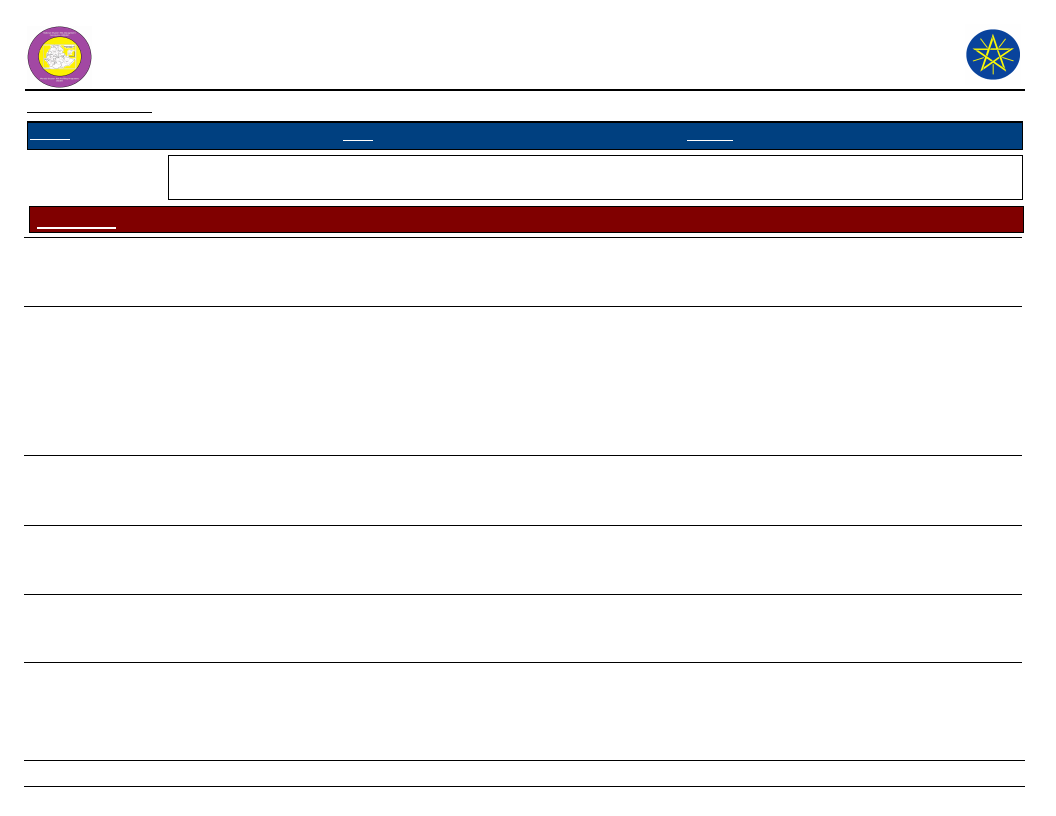
Wereda Disaster Risk
Profile
National Disaster Risk Management
Commission (NDRMC)
Data_Collected_Date
Region S.N.N.P
Zone GURAGE
Wereda MESKAN
Wednesday, July 10, 2019
Selected Indicator
Interventions: Suggestions to DRM Actors in the Area - Community suggested measures to DRM actors in the area
for effective DRM actions
Kebele Name
DOBENA
Measure 1
Relief
GIDENA
ABORAT
GOYBAN
Immediate response
to vulnerable
community to
recover to disasters
life relief water
supplying, material
help
Solve drinking water
problem
Comment 1
To prevent from
the effect of
disaster
Because the
vulnerable
community must
be get first basic
needs
Mina problem for
community
Measure 2
Support by input and
credit
The helping of
supplying of seeds
Rod construction
ILE
Relief
INSENO USME
Relief
JOLE ANDENYA Relief
Relief is fast
action of food
gap
To save life, it is
quick
methodology
To minimize food
shortage, method
of protect human
life
Forest tree
plantation/forestation
Livestock and crop
disease protection
support with medicine
Take control measure
of the disaster
Comment 2
To produce more
production
Measure 3
Working for food
Comment 3
To get food at
disaster time
Dig and construct
the ditch
The area flood
do not control by
man power
conservation
system
Accelerate income
generating
activities
Flood is the main
problem of the
community
It is the direct and
effective
Forestation
It is important
Construction of
ditch, dam and
drainage
To minimize
negative impact
of disaster
To control
disaster
300
Page 3 of 6
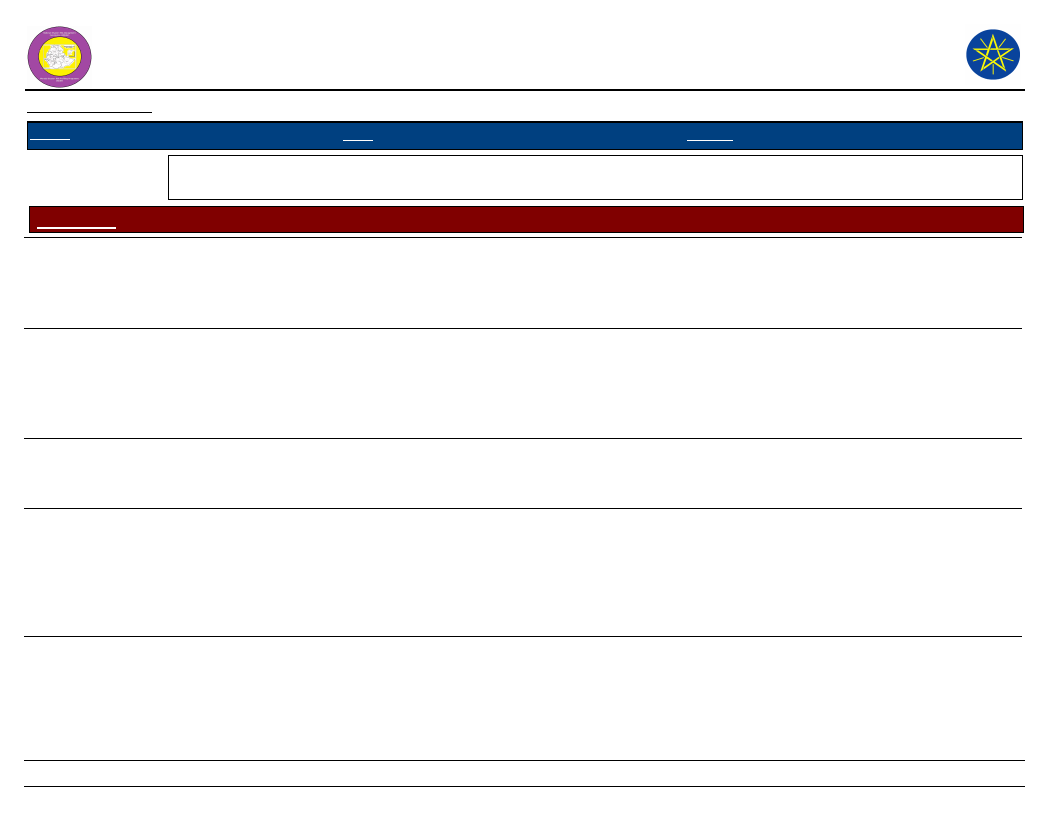
Wereda Disaster Risk
Profile
National Disaster Risk Management
Commission (NDRMC)
Data_Collected_Date
Region S.N.N.P
Zone GURAGE
Wereda MESKAN
Wednesday, July 10, 2019
Selected Indicator
Interventions: Suggestions to DRM Actors in the Area - Community suggested measures to DRM actors in the area
for effective DRM actions
Kebele Name
JOLE
HULETENYA
MEKICHO
Measure 1
Construction of
permanent water
diverting dam and
ditches
Migration
Comment 1
To prevent and
control the effect
of flood specially
Meki river
To solve the
problem job
opportunities
Measure 2
Constructing soil and
water conservation, by
working for food
programs
Relief
MESERETEWEG
ERAMO
Fund and organized
youth
Most of youth is
jobless
Supported with
agricultural inputs
MIKAELO
Sustainable control
and flood/river and
stream
In the harvesting
year to control
the flood
Relief
MIRAB IMBOR
Relief
Vulnerable
community should
be get food first
Working for food
Comment 2
To control flood
and soil erosion for
the future
permanently
Support by
government and
NGOs by food and
financial support
No economical
strength
Because of flood
and other hazards
the community lost
their asset and
faced food
problem
To reduce
migration
Measure 3
Relief/food aid
Supplying of
productive and
resistant variety
of crops and
animals
Support with
agricultural
inputs
Supplying disaster
resistant crops
and livestock
varieties to the
community
Comment 3
To cope the
community at
the period of
disaster
To permanently
solve the
problems /effect
of the area
disaster
Technology is
very back ward
in area
The resist and
help himself
from
301
Page 4 of 6
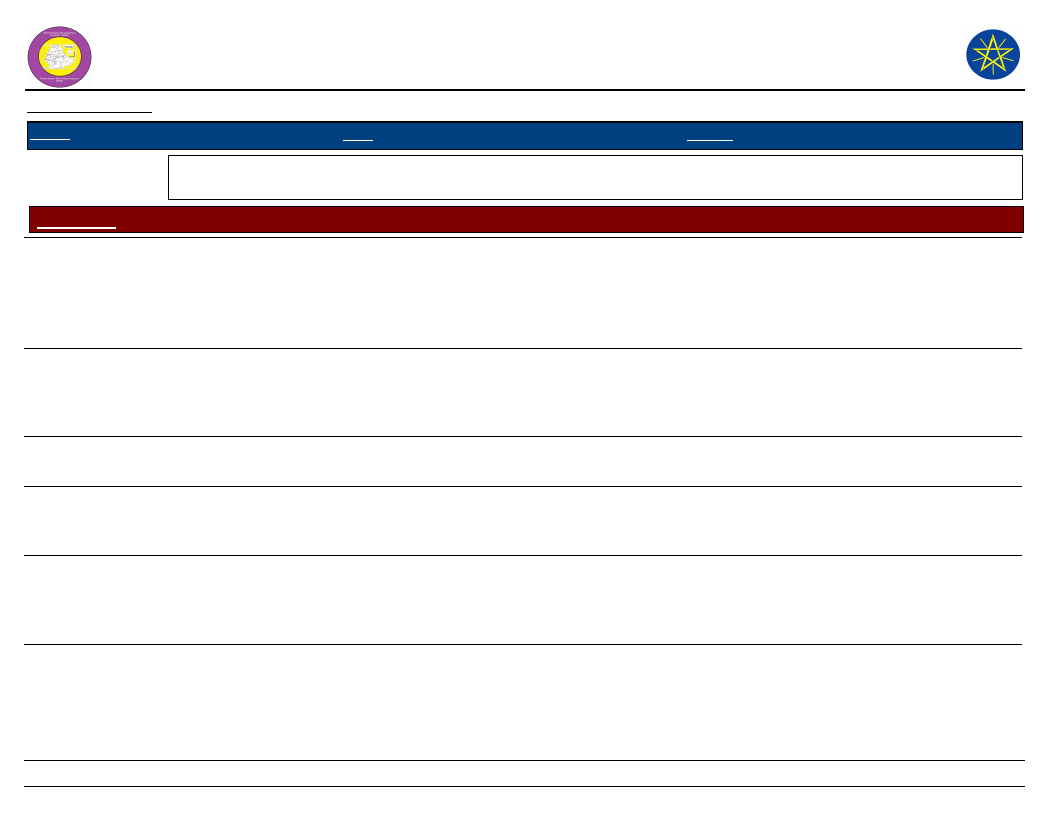
Wereda Disaster Risk
Profile
National Disaster Risk Management
Commission (NDRMC)
Data_Collected_Date
Region S.N.N.P
Zone GURAGE
Wereda MESKAN
Wednesday, July 10, 2019
Selected Indicator
Interventions: Suggestions to DRM Actors in the Area - Community suggested measures to DRM actors in the area
for effective DRM actions
Kebele Name
MIRAB MESKAN
Measure 1
Pick the area
problem and
prioritize the
problem
OCHAGENEME
Relief
Comment 1
Identify the probe
and awareness
creation
Measure 2
Who should be
immediate response
It is solution to
mitigate food gap
Livestock and human
health treatment
SEMEN
SHORSHORA
SHERSHERA
MACHMENA
WEJABATI
Solve drinking water
problem
Constructing and
distributing pure
drinking water
Relief
Water is main
problem
Water shortage s
very serious
problem
Because in the
presence of food
gap relief is the
fastest action
Job opportunities
Respond the questions
immediate
Animal and crop
disease protections
activity
Comment 2
Who have no
response the
problem at a time
of disaster
To protect
different disease
came due to
disaster
It helps to
minimize migration
Response is very
late
Measure 3
Solve the problem
of good and clean
water and money
at a disaster
effect
Support
afforesstation
Comment 3
There is very
problems of
food, water and
money after
disaster effect
For sustainable
prevention
It is the anyway of
protect disease
302
Page 5 of 6
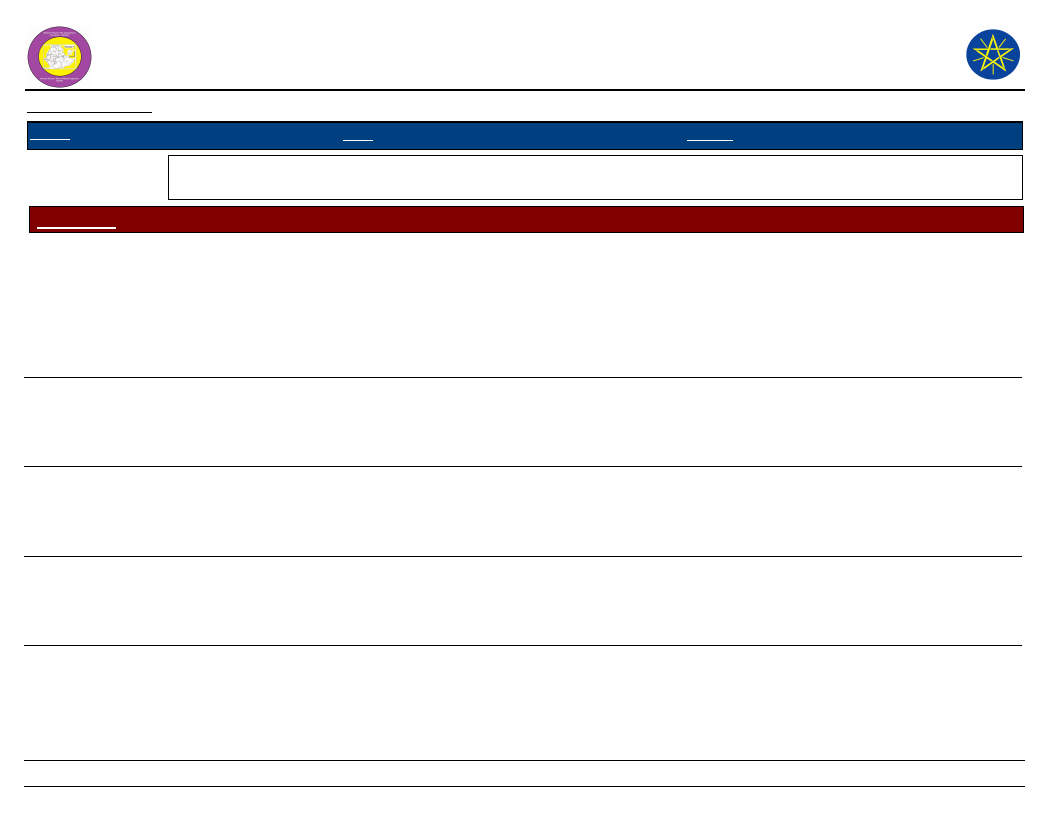
Wereda Disaster Risk
Profile
National Disaster Risk Management
Commission (NDRMC)
Data_Collected_Date
Region S.N.N.P
Zone GURAGE
Wereda MESKAN
Wednesday, July 10, 2019
Selected Indicator
Interventions: Suggestions to DRM Actors in the Area - Community suggested measures to DRM actors in the area
for effective DRM actions
Kebele Name
WITA
Measure 1
Relief
Comment 1
To control
shortage of food,
it is quick
methodology
Measure 2
Take control measure
of the disaster
WOLENSHO
ANDENYA
Deep water hall
construction
YETABON
Relief
To get food
Relief
Migration
YIMERWACHO
2NYA
YIMERWACHO
3NYA
The management or
institution should
be respond
immediate response
Relief
The help and to
protect human
live, it is quick
methods of
protection
Crop and animal
disease protection
support with medina
Comment 2
Ask community
needs to mitigate
the specific
disaster, it is
effective measure
to protect the
disaster
Community lost
their asset and
faced food gap due
to flood
Job opportunity
Measure 3
Rehabilitation
Supply improved
varieties of crop
and drought
resistant plants
Comment 3
To increase
community
assets
To protect
disasters and
recover to the
future
It is effective
measure to
protective disease
303
Page 6 of 6
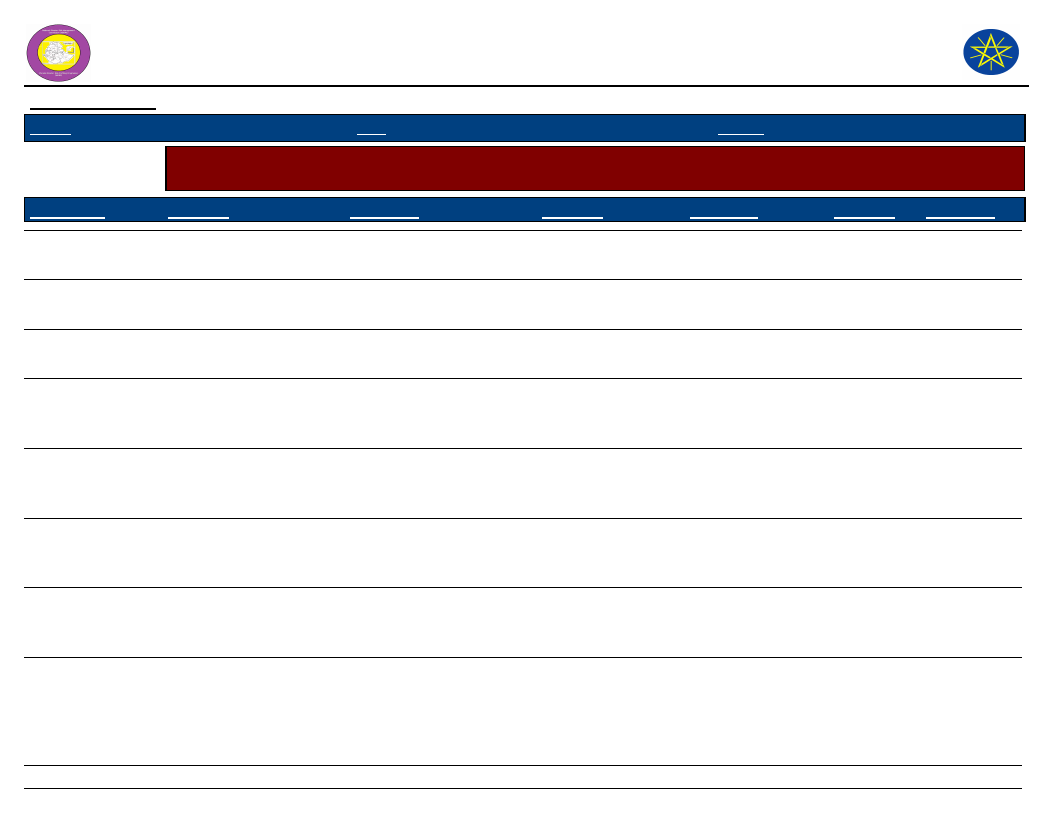
Wereda Disaster Risk
Profile
National Disaster Risk Management
Commission (NDRMC)
Data_Collected_Date
Region S.N.N.P
Zone GURAGE
Wereda MESKAN
Wednesday, July 10, 2019
Selected Indicator
Economic Vulnerability: Community Suggestions to Improve Economic Situation - Community suggested measures
to improve the economic situation of the area
KebeleName
Measure 1
Comment 1
Measure 2
Comment 2
Measure 3 Comment 3
BATI FATO
BATI LEJANO
BECHE
BULCHANO
BERESA
DEBO TUTO
DEBUB
SHERSHERA
DEGAGOGOT
DIDA
Change he developing
activities
Small trading
Using new agricultural
technologies
Create better job
opportunity
Create job opportunity
Improve relief supply
and increased chat
income
Road construction
No improvement of
income due to climate
change
Need loss expense
Aware the community to
improve production
Crop cultivate is
substance farming system
Irrigation activities
Fattening
Available crop
residue
Poultry
Improve farm
technology
Improve farm
technology
Have poor soil
fertility, poor
productivity
Increase soil
fertility for better
production
It is not need
much labour
Accelerate any income
activity
Poultry production
Easily manageable
Credit access
To create
good job
opportunity
304
Page 1 of 4
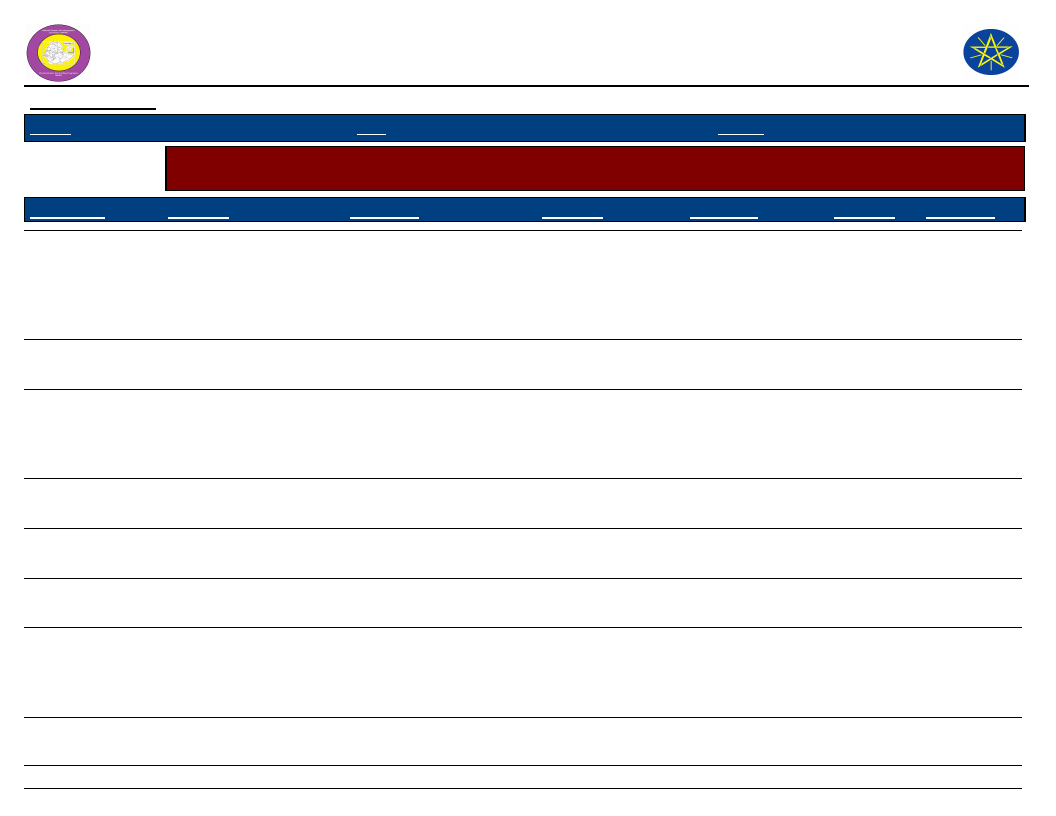
Wereda Disaster Risk
Profile
National Disaster Risk Management
Commission (NDRMC)
Data_Collected_Date
Region S.N.N.P
Zone GURAGE
Wereda MESKAN
Wednesday, July 10, 2019
Selected Indicator
Economic Vulnerability: Community Suggestions to Improve Economic Situation - Community suggested measures
to improve the economic situation of the area
KebeleName
Measure 1
Comment 1
Measure 2
Comment 2
Measure 3 Comment 3
DIRAMA
Improved agricultural
systems and
productivities
Increased income
DOBENA
Create job opportunity
GIDENA ABORAT
Supplying drought
resistant crop
To solve migration
There is problem of
variety
GOYBAN
ILE
INSENO USME
JOLE ANDENYA
Petty trade
Petty trade
Small trade
Improve farm
technologies
Easily manageable
Need less expense
Need less expense
Increase productivity
Income generating
mechanism
Facilitate irrigation
production
Cooperative and
job opportunities to
settled
communities
Daily farm
Fattening
Fattening
Better job
opportunities
Increased income
To get job
opportunity
Migration
increased
Off farm activities
Available livestock
forage
Available crop
residue
Increase income
Using
improved
variety and
new
technologies
Poultry
Poultry
Different
income
generating
system
Increased
income
Easily
manageable
Need less
expense
Develop asset
building
305
Page 2 of 4
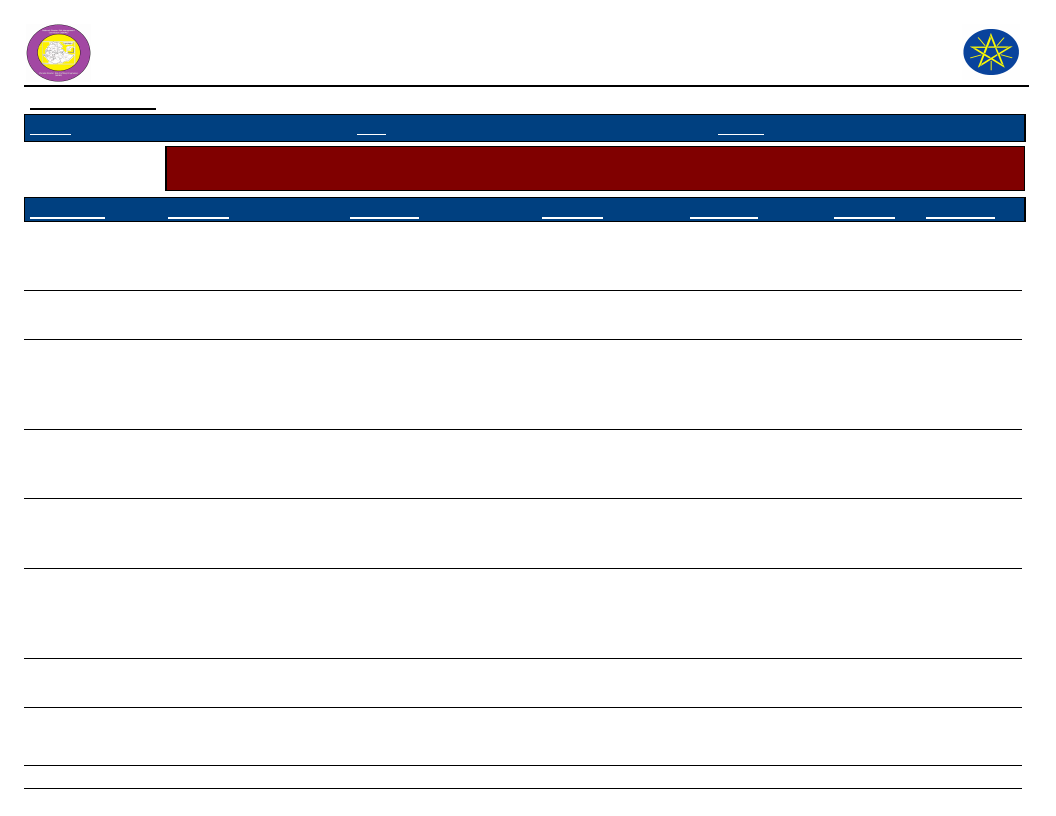
Wereda Disaster Risk
Profile
National Disaster Risk Management
Commission (NDRMC)
Data_Collected_Date
Region S.N.N.P
Zone GURAGE
Wereda MESKAN
Wednesday, July 10, 2019
Selected Indicator
Economic Vulnerability: Community Suggestions to Improve Economic Situation - Community suggested measures
to improve the economic situation of the area
KebeleName
JOLE HULETENYA
Measure 1
Construction and
facilitate river for
irrigation
Comment 1
To get more production
Measure 2
Job opportunities
Comment 2
To remain
migration
Measure 3 Comment 3
MEKICHO
Market linkage
To solve the problem of
market
Job opportunities
To solve migration
MESERETEWEGER
AMO
Fattening
Grazing land available
Poultry
Need little
expense
Bee keeping
Have
available
water and
zone
MIKAELO
Increase farm
technologies
Increasing productivity
Better job
opportunity
To increase
income
Increase
market
facility
To exchange
production
MIRAB IMBOR
Make Soil and water
conservation
To protect soil fertility,
get more production
Health post and
veterinary service
To protect human
and livestock form
disease
MIRAB MESKAN
Supplying of variety
seed crops
There is seed quality
problem
Access to irrigation
To solve the
problem of
seasonal rain
dependent
Create job
opportunity
To minimize
migration
OCHAGENEME
Small trading
Take less expense
Fattening
Easy get crop
residue
306
Page 3 of 4
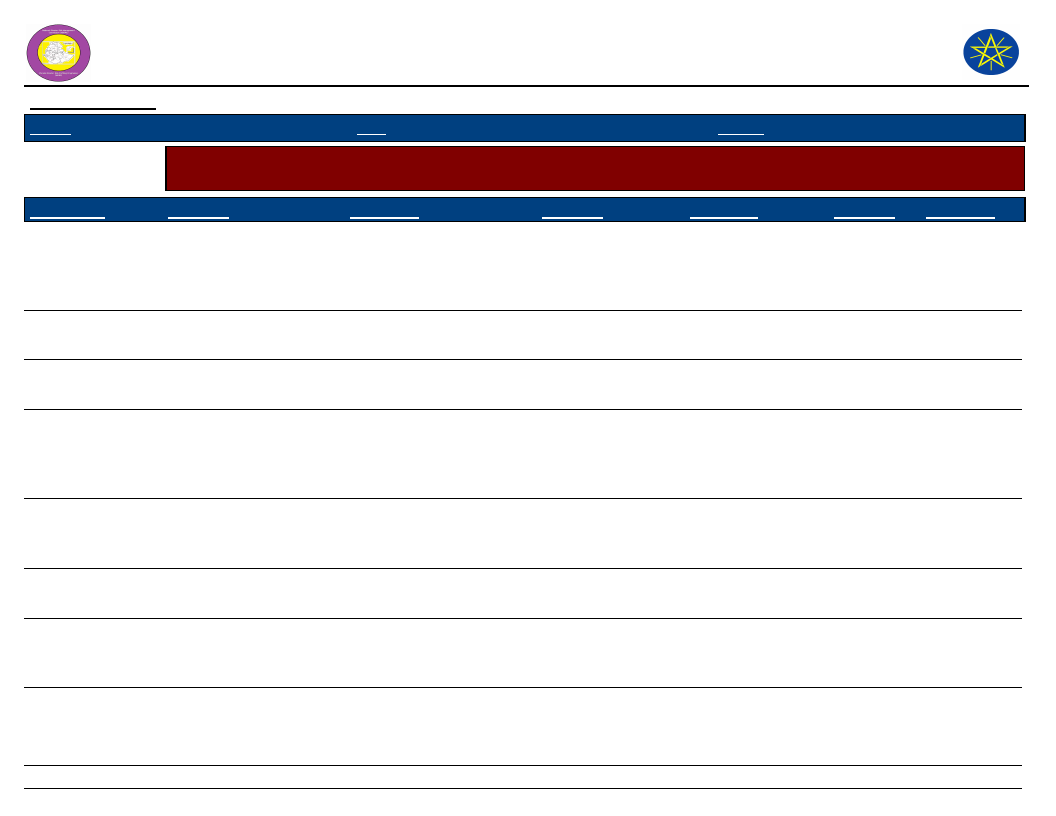
Wereda Disaster Risk
Profile
National Disaster Risk Management
Commission (NDRMC)
Data_Collected_Date
Region S.N.N.P
Zone GURAGE
Wereda MESKAN
Wednesday, July 10, 2019
Selected Indicator
Economic Vulnerability: Community Suggestions to Improve Economic Situation - Community suggested measures
to improve the economic situation of the area
KebeleName
SEMEN
SHORSHORA
SHERSHERA
MACHMENA
WEJABATI
WITA
WOLENSHO
ANDENYA
YETABON
YIMERWACHO
2NYA
YIMERWACHO
3NYA
Measure 1
Credit service
Improve market linkage
Small relief
Market facility
Improve farm
technologies
Create job opportunity
Create market linkage
Irrigation
Comment 1
Good opportunities, any
income generating
activities
To solve the problem of
market linkage
Take less expanse
Increasing farmers
income
Technology increased the
productivity
To decrease migration
There is market problem
Have good awareness and
available water source
Measure 2
Off farm activities
poultry, bee
keeping, diary farm
Create job
opportunity
Fattening
Submit different
type of farming
technology
Create better job
opportunity
Improve irrigation
access
Supply improved
and drought
resistant crops
Fattening
307
Comment 2
Good option rather
than any farming
activities
To solve problem
of migration
Crop residue is
available
To increase
productivity
To get income
Measure 3
Solving
drinking
water
problems
Comment 3
It is the main
problems in
these
community
Create job
opportunity
income
generating
Create good
market
facility
Increase
farmers asset
building
It is possible
way to get
have income
There is problem
of improved
varieties
Availability of crop
residue
Poultry
Need less
expense and
man power
Page 4 of 4
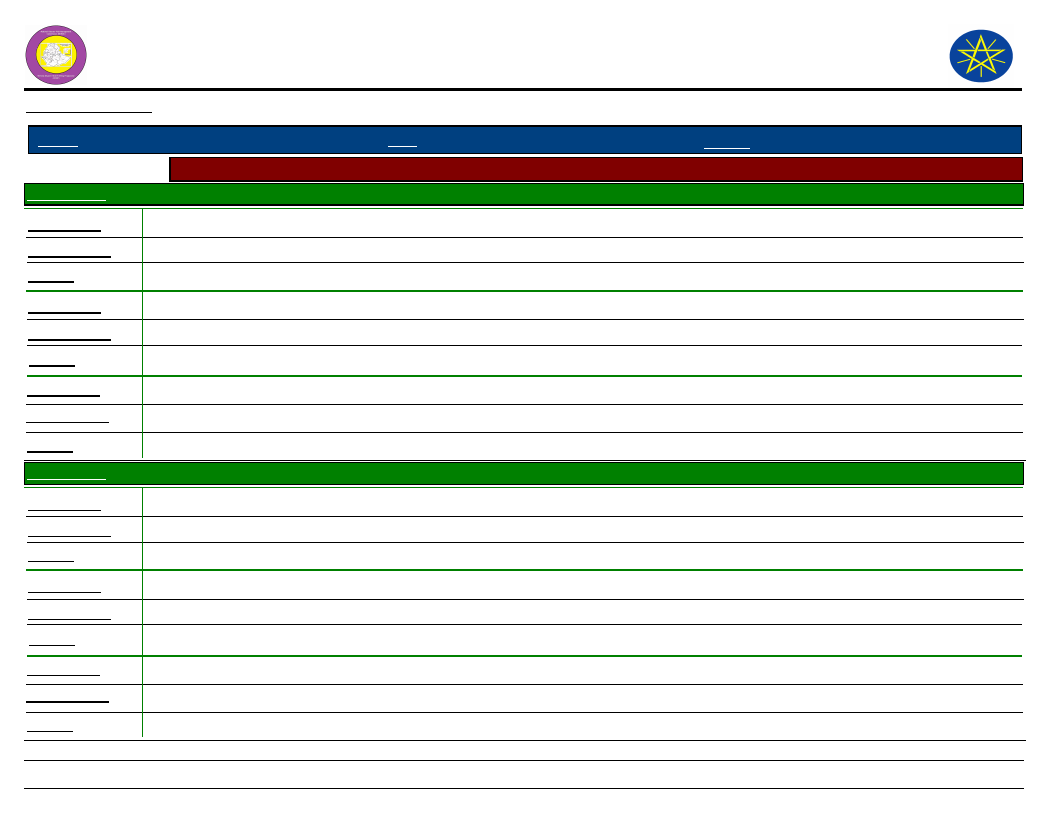
Wereda Disaster
Risk Profile
Data_Collected_Date
Region S.N.N.P
Zone GURAGE
Selected Indicator
Community Awareness of Disaster Risk Management System and Actors
Kebele Name
BATI FATO
Institution 1
Responsibility
Activity
Kebele administration
Coordinating community
Coordinate community and solve the problem easily
Institution 2
Responsibility
Activity
Agricultural office
Agriculture extension
Supply extension activities
Institution 3
Responsibility
Activity
Kebele Name
Health office
Health care
Treatment and reporting
BATI LEJANO
Institution 1
Responsibility
Activity
Agriculture office
Give extension service
Raising awareness of the farmers
Institution 2
Responsibility
Activity
Education office
Teaching the children
By direct lecture
Institution 3
Responsibility
Activity
Health post
Health care
Diagnosis
National Disaster Risk
Management Comission (NDRMC)
Wednesday, July 10, 2019
Wereda MESKAN
308
Page 1 of 15
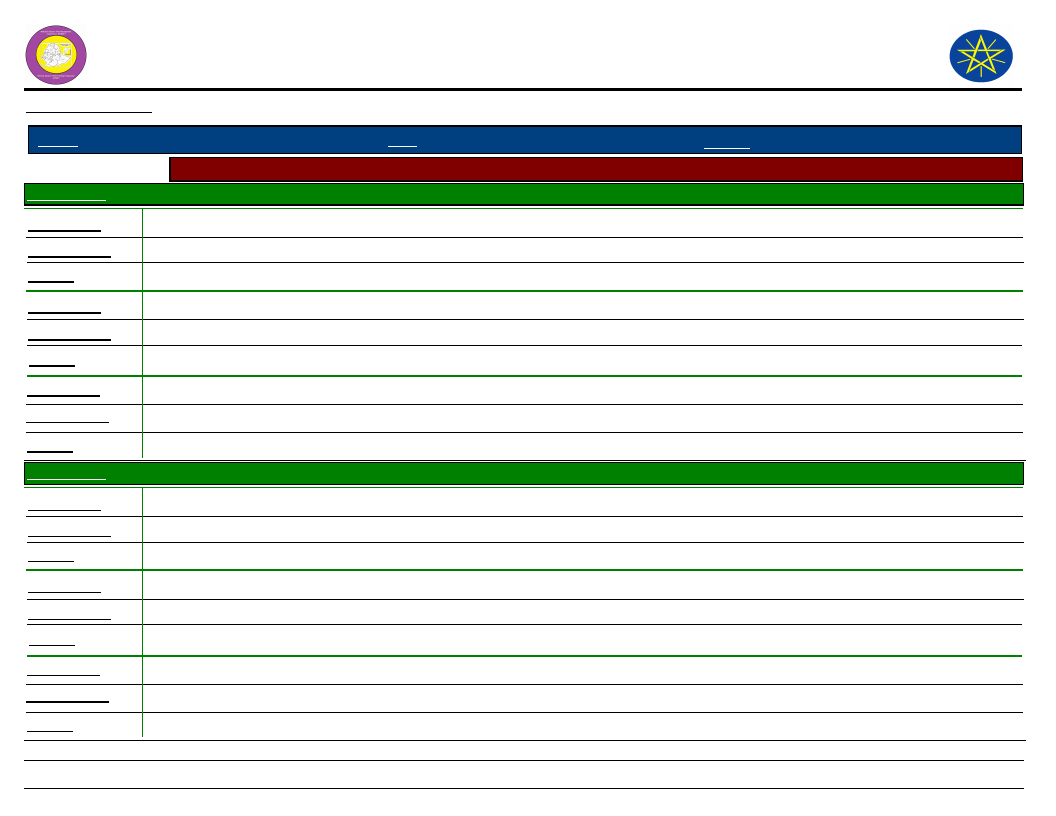
Wereda Disaster
Risk Profile
Data_Collected_Date
Region S.N.N.P
Zone GURAGE
Selected Indicator
Community Awareness of Disaster Risk Management System and Actors
Kebele Name
BECHE BULCHANO
Institution 1
Responsibility
Activity
Kebele administration
Coordinate kebele community
Solve main problem and report
Institution 2
Responsibility
Activity
Kebele Disaster risk management
Management of disaster risk
Report the problem to wereda
Institution 3
Responsibility
Activity
Kebele Name
Agricultural office
Create awareness
Report to wereda
BERESA
Institution 1
Responsibility
Activity
Agriculture office
Creating awareness
Supplying input and agricultural extension service
Institution 2
Responsibility
Activity
Health office
Prevent community health
Treatment
Institution 3
Responsibility
Activity
Education office
Teaching the students
Awareness creation
National Disaster Risk
Management Comission (NDRMC)
Wednesday, July 10, 2019
Wereda MESKAN
309
Page 2 of 15
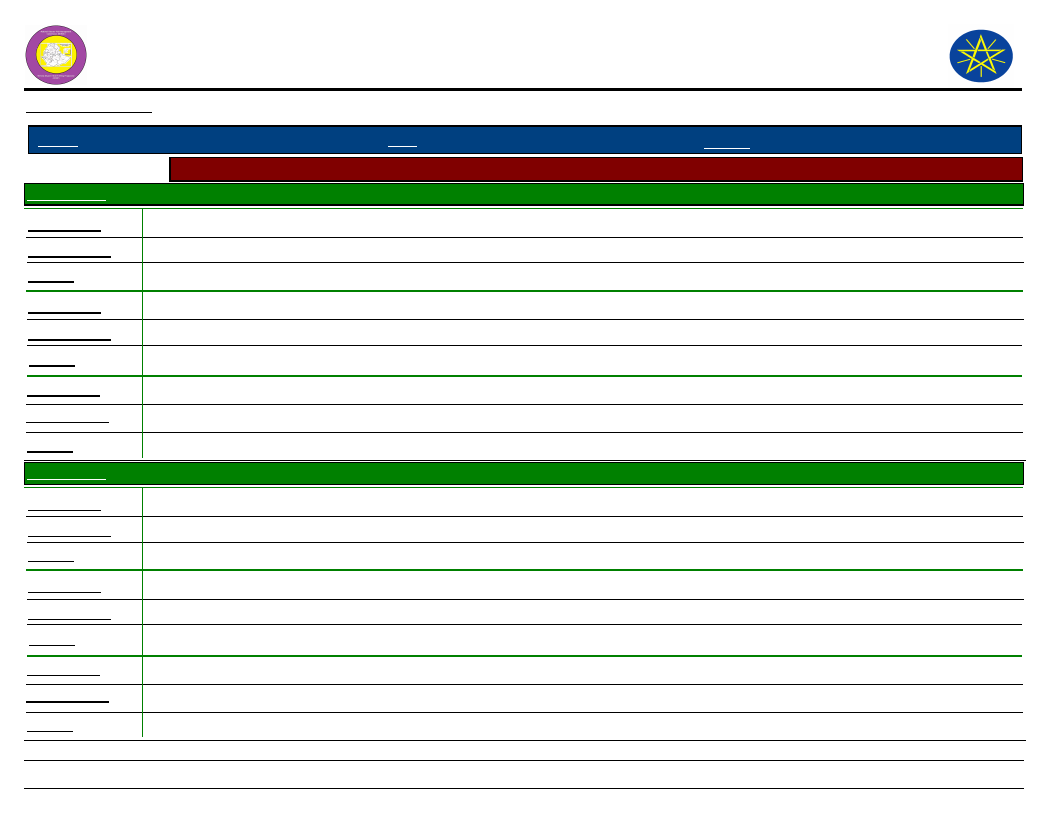
Wereda Disaster
Risk Profile
Data_Collected_Date
Region S.N.N.P
Zone GURAGE
Selected Indicator
Community Awareness of Disaster Risk Management System and Actors
Kebele Name
DEBO TUTO
Institution 1
Responsibility
Activity
Agricultural office
Create awareness
Agricultural extension service
Institution 2
Responsibility
Activity
Health office
Prevent human health
By treatment
Institution 3
Responsibility
Activity
Kebele Name
Education office
Teaching children
Awareness creation
DEBUB SHERSHERA
Institution 1
Responsibility
Activity
Kebele administration
Chair man
Report to wereda
Institution 2
Responsibility
Activity
Agricultural office
Head of the office
Awareness creation and report to wereda
Institution 3
Responsibility
Activity
Disaster risk management
Manage
Report
National Disaster Risk
Management Comission (NDRMC)
Wednesday, July 10, 2019
Wereda MESKAN
310
Page 3 of 15
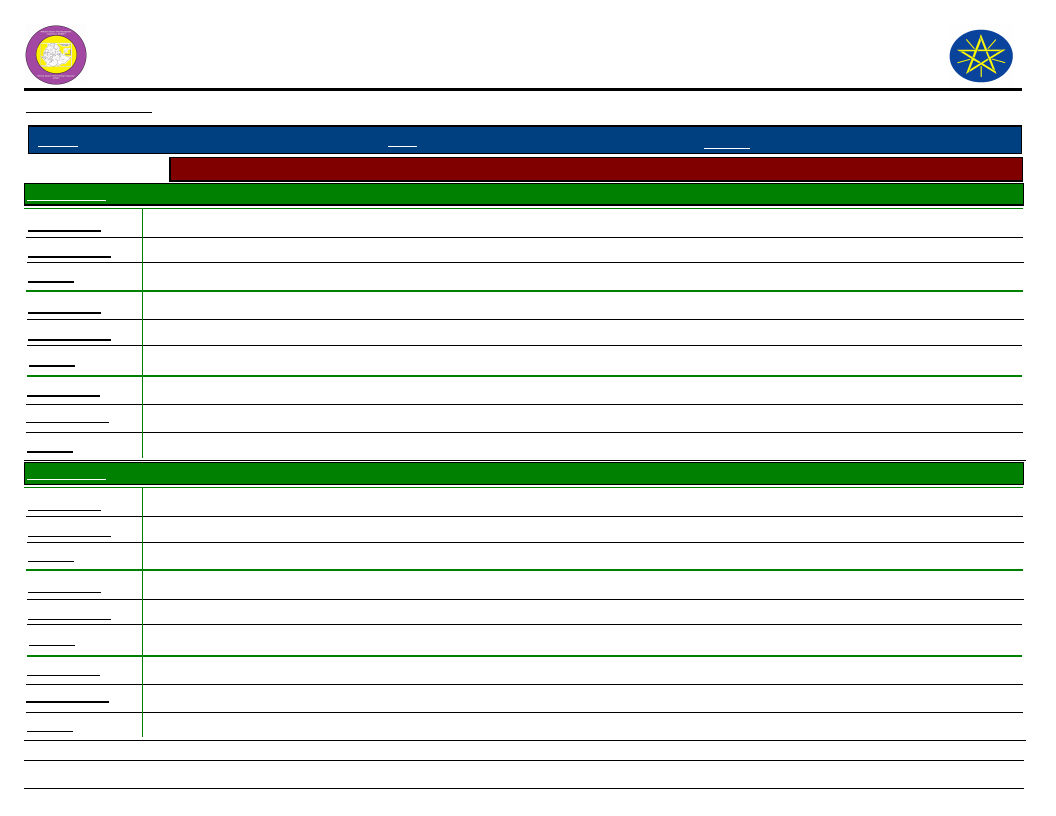
Wereda Disaster
Risk Profile
Data_Collected_Date
Region S.N.N.P
Zone GURAGE
Selected Indicator
Community Awareness of Disaster Risk Management System and Actors
Kebele Name
DEGAGOGOT
Institution 1
Responsibility
Activity
Kebele Agriculture office
Supporting farmers
Agricultural extension service
Institution 2
Responsibility
Activity
Kebele health office
Support community
Care community health
Institution 3
Responsibility
Activity
Kebele Name
Kebele education office
Support community students
Teach and support students
DIDA
Institution 1
Responsibility
Activity
Kebele administration
Chari man
Solve minor problems and report to wereda
Institution 2
Responsibility
Activity
Agricultural office
Extension agent
Awareness creation and report to wereda
Institution 3
Responsibility
Activity
Health office
Health care
First aid and report
National Disaster Risk
Management Comission (NDRMC)
Wednesday, July 10, 2019
Wereda MESKAN
311
Page 4 of 15
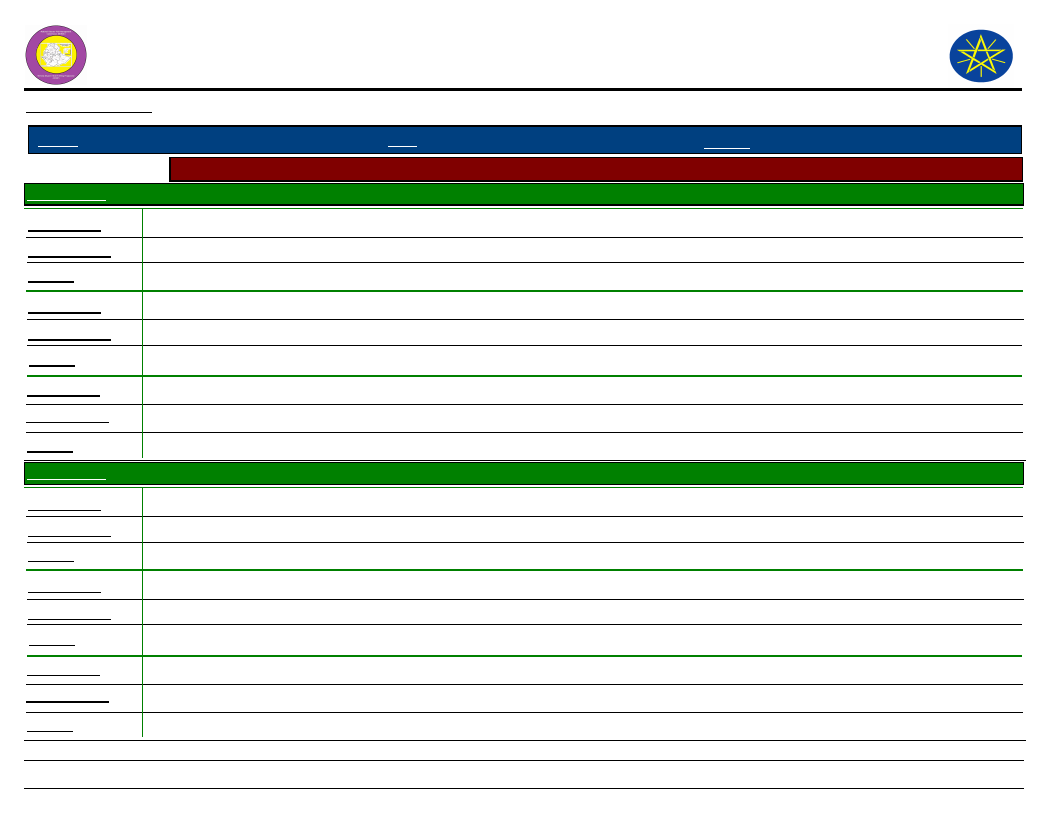
Wereda Disaster
Risk Profile
Data_Collected_Date
Region S.N.N.P
Zone GURAGE
Selected Indicator
Community Awareness of Disaster Risk Management System and Actors
Kebele Name
DIRAMA
Institution 1
Responsibility
Activity
Kebele administration
Coordinate community
Report the problems to wereda
Institution 2
Responsibility
Activity
Agricultural office
Creating awareness
Identify the problems and report
Institution 3
Responsibility
Activity
Kebele Name
Health post
Prevent health
Medical treatment and rifer to hospital
DOBENA
Institution 1
Responsibility
Activity
Kebele Management
Chair man coordinate the kebele
Solve the problem and report to others
Institution 2
Responsibility
Activity
Kebele Agriculture office
Agricultural extension
Awareness creation and report
Institution 3
Responsibility
Activity
Health post
Prevent human health
First aid, awareness creation and report
National Disaster Risk
Management Comission (NDRMC)
Wednesday, July 10, 2019
Wereda MESKAN
312
Page 5 of 15
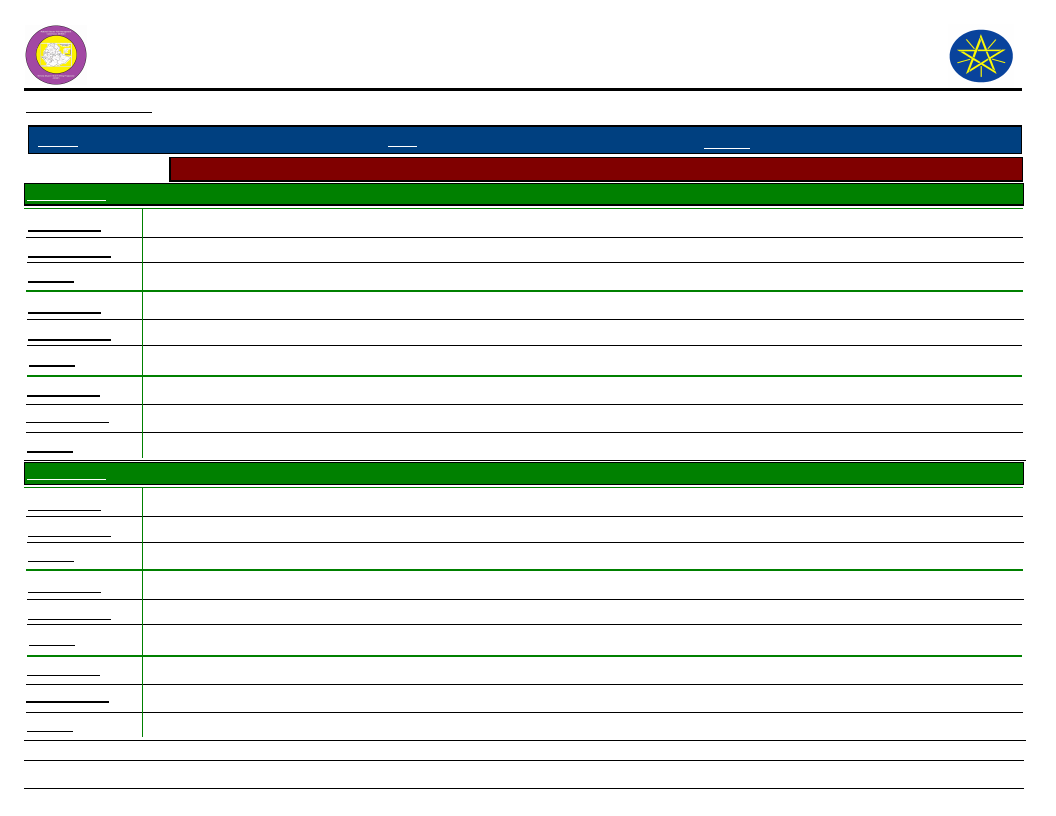
Wereda Disaster
Risk Profile
Data_Collected_Date
Region S.N.N.P
Zone GURAGE
Selected Indicator
Community Awareness of Disaster Risk Management System and Actors
Kebele Name
GIDENA ABORAT
Institution 1
Responsibility
Activity
Kebele Administration
Chair man, coordinating community
Report the problem to wereda
Institution 2
Responsibility
Activity
Kebele Agriculture office
Head of the office
Report the problem to wereda
Institution 3
Responsibility
Activity
Kebele Name
Kebele health office
Head of the office
Treat and manage the problems
GOYBAN
Institution 1
Responsibility
Activity
Kebele agriculture office
Provide agricultural inputs
For agricultural extension service
Institution 2
Responsibility
Activity
Kebele health office
Follow up community health
Treatment, health care
Institution 3
Responsibility
Activity
Kebele cooperatives
Initiate farmers to help each other
For sharing resource
National Disaster Risk
Management Comission (NDRMC)
Wednesday, July 10, 2019
Wereda MESKAN
313
Page 6 of 15
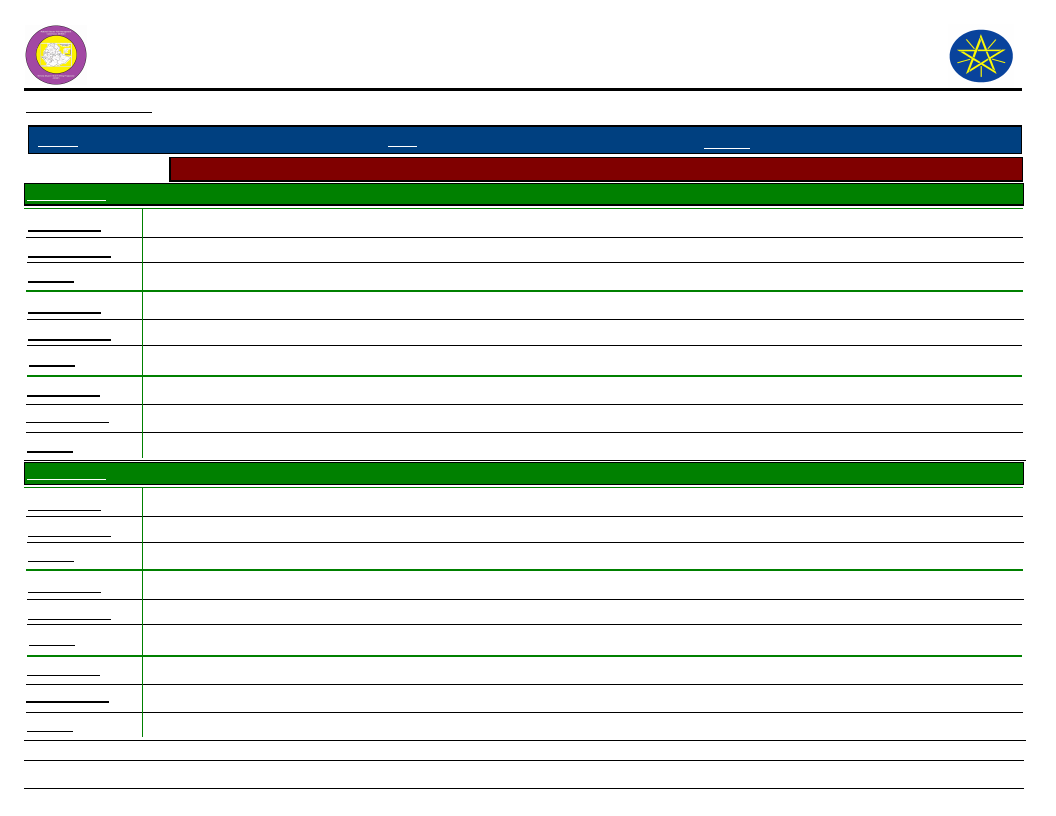
Wereda Disaster
Risk Profile
Data_Collected_Date
Region S.N.N.P
Zone GURAGE
Selected Indicator
Community Awareness of Disaster Risk Management System and Actors
Kebele Name
ILE
Institution 1
Responsibility
Activity
Irrigation Office
Give extension service
Creating awareness
Institution 2
Responsibility
Activity
Health center
Care community health
Treatment and follow up
Institution 3
Responsibility
Activity
Kebele Name
Education office
Teaching students
Teaching and learning activities
INSENO USME
Institution 1
Responsibility
Activity
Agricultural office
Extension service
Creating awareness
Institution 2
Responsibility
Activity
Education office
Teaching students
Teaching and learning activities
Institution 3
Responsibility
Activity
Health Office
Health care
Medical treatment
National Disaster Risk
Management Comission (NDRMC)
Wednesday, July 10, 2019
Wereda MESKAN
314
Page 7 of 15
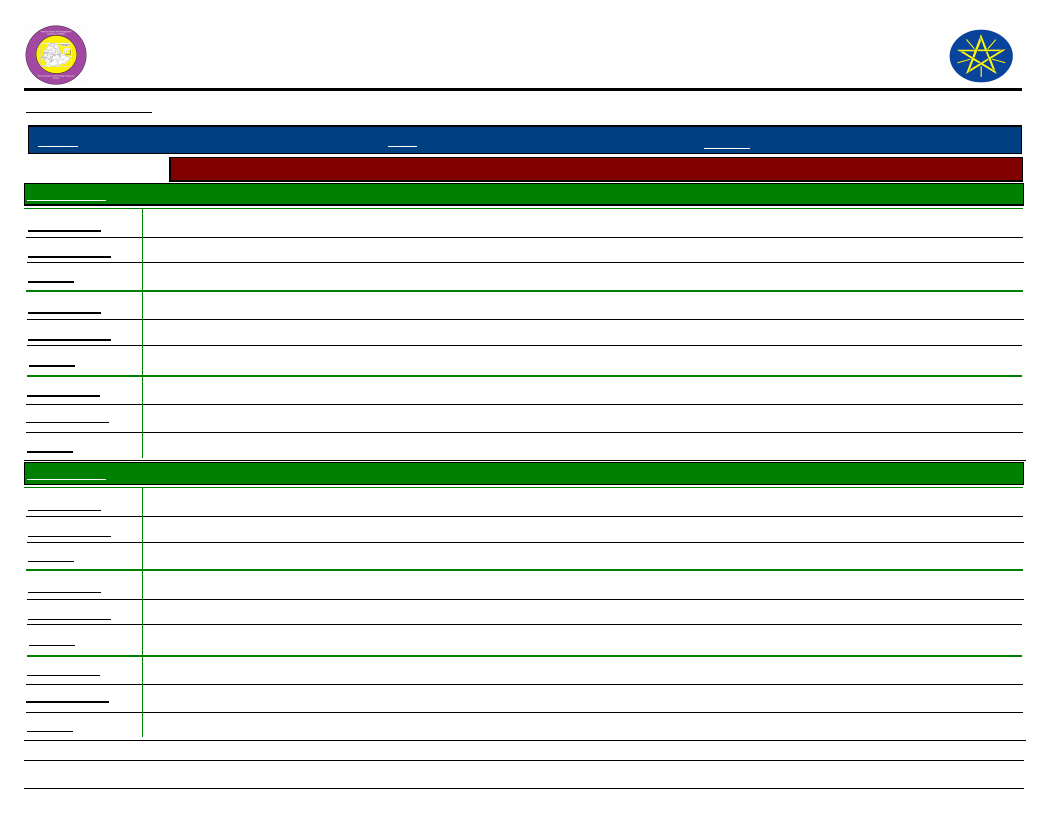
Wereda Disaster
Risk Profile
Data_Collected_Date
Region S.N.N.P
Zone GURAGE
Selected Indicator
Community Awareness of Disaster Risk Management System and Actors
Kebele Name
JOLE ANDENYA
Institution 1
Responsibility
Activity
Farmer training center
Increase production
Institution 2
Responsibility
Activity
Health post
Prevent disease
Treatment
Institution 3
Responsibility
Activity
Kebele Name
Education office
Teaching students
Awareness creation
JOLE HULETENYA
Institution 1
Responsibility
Activity
Kebele administration
Chair man, coordinate community
Response, solve minor problems, report to wereda
Institution 2
Responsibility
Activity
Agriculture office
Agricultural extension service
Creating awareness and report
Institution 3
Responsibility
Activity
Health post
Prevent community health
Creating awareness, treatment, first aid and report
National Disaster Risk
Management Comission (NDRMC)
Wednesday, July 10, 2019
Wereda MESKAN
315
Page 8 of 15
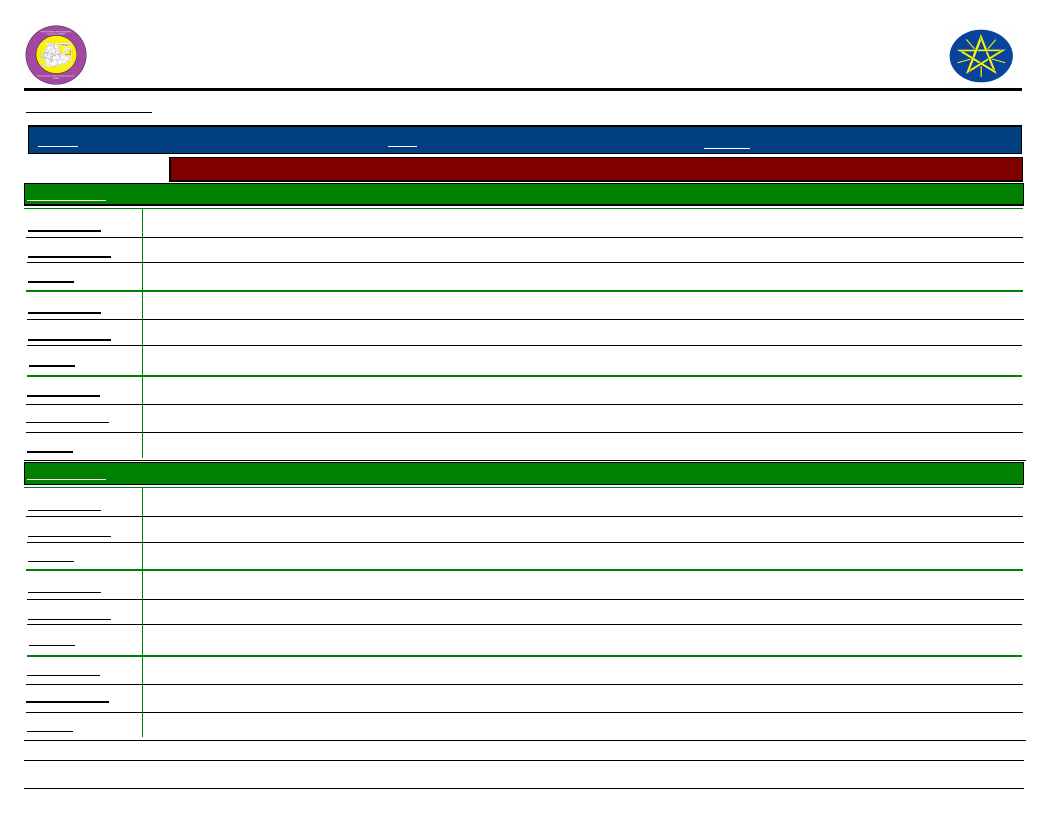
Wereda Disaster
Risk Profile
Data_Collected_Date
Region S.N.N.P
Zone GURAGE
Selected Indicator
Community Awareness of Disaster Risk Management System and Actors
Kebele Name
MEKICHO
Institution 1
Responsibility
Activity
Kebele administration
Chair man
Solve easy problems and report to weredas
Institution 2
Responsibility
Activity
Agricultural office
Extension service
Extension awareness and report
Institution 3
Responsibility
Activity
Kebele Name
Health post
Health care
First aid, report to wereda
MESERETEWEGERAMO
Institution 1
Responsibility
Activity
Agriculture office
Give extension service
Raising awareness in agricultural activity
Institution 2
Responsibility
Activity
Education
Teaching the children
Do learning activity
Institution 3
Responsibility
Activity
Health post
Health care
Diagnosis after the treatment
National Disaster Risk
Management Comission (NDRMC)
Wednesday, July 10, 2019
Wereda MESKAN
316
Page 9 of 15
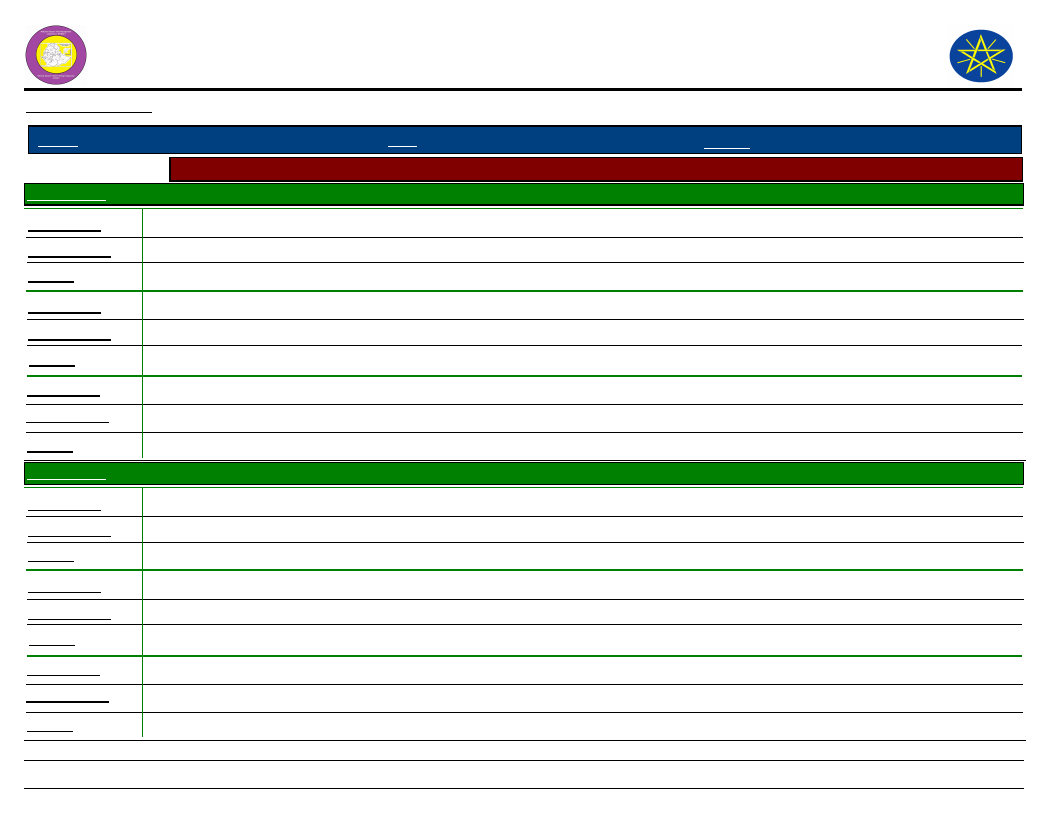
Wereda Disaster
Risk Profile
Data_Collected_Date
Region S.N.N.P
Zone GURAGE
Selected Indicator
Community Awareness of Disaster Risk Management System and Actors
Kebele Name
MIKAELO
Institution 1
Responsibility
Activity
Agricultural office
Create awareness to farmer
By demonstration site
Institution 2
Responsibility
Activity
Health post
Prevent disease
Diagnosis
Institution 3
Responsibility
Activity
Kebele Name
Education office
Teaching the children
Awareness creation
MIRAB IMBOR
Institution 1
Responsibility
Activity
Kebele administration
Coordinate the kebele communities/chair man
Report and help them
Institution 2
Responsibility
Activity
Education office
Teaching the students/teachers
Report and creating awareness
Institution 3
Responsibility
Activity
Agriculture office
Head of the office
Creating awareness
National Disaster Risk
Management Comission (NDRMC)
Wednesday, July 10, 2019
Wereda MESKAN
317
Page 10 of 15
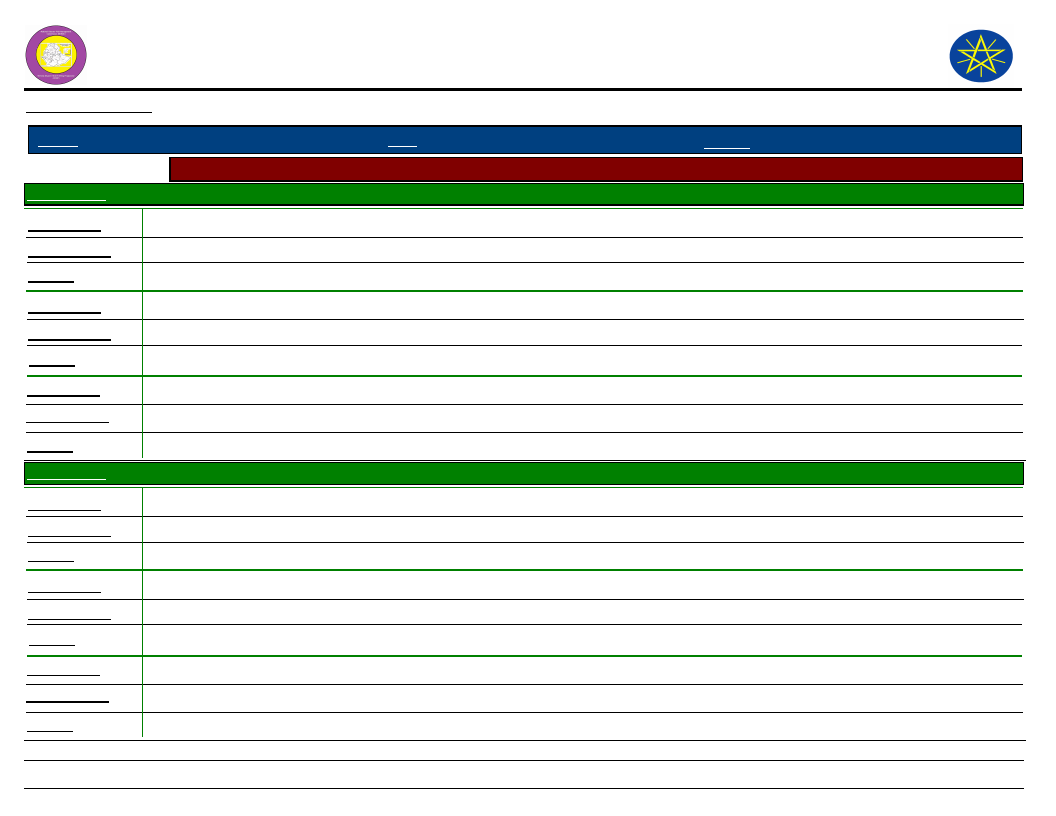
Wereda Disaster
Risk Profile
Data_Collected_Date
Region S.N.N.P
Zone GURAGE
Selected Indicator
Community Awareness of Disaster Risk Management System and Actors
Kebele Name
MIRAB MESKAN
Institution 1
Responsibility
Activity
Kebele administration
Report to kebele to wereda
Institution 2
Responsibility
Activity
Kebele agricultural office
Reporting and awareness
Institution 3
Responsibility
Activity
Kebele Name
Health post
First treatment and report
OCHAGENEME
Institution 1
Responsibility
Activity
Agriculture office
Give extension service
Create awareness by vesting the groups and village meeting
Institution 2
Responsibility
Activity
Health office
Health cane
Diagnosis
Institution 3
Responsibility
Activity
Education
Teaching the children
Teaching activity
National Disaster Risk
Management Comission (NDRMC)
Wednesday, July 10, 2019
Wereda MESKAN
318
Page 11 of 15
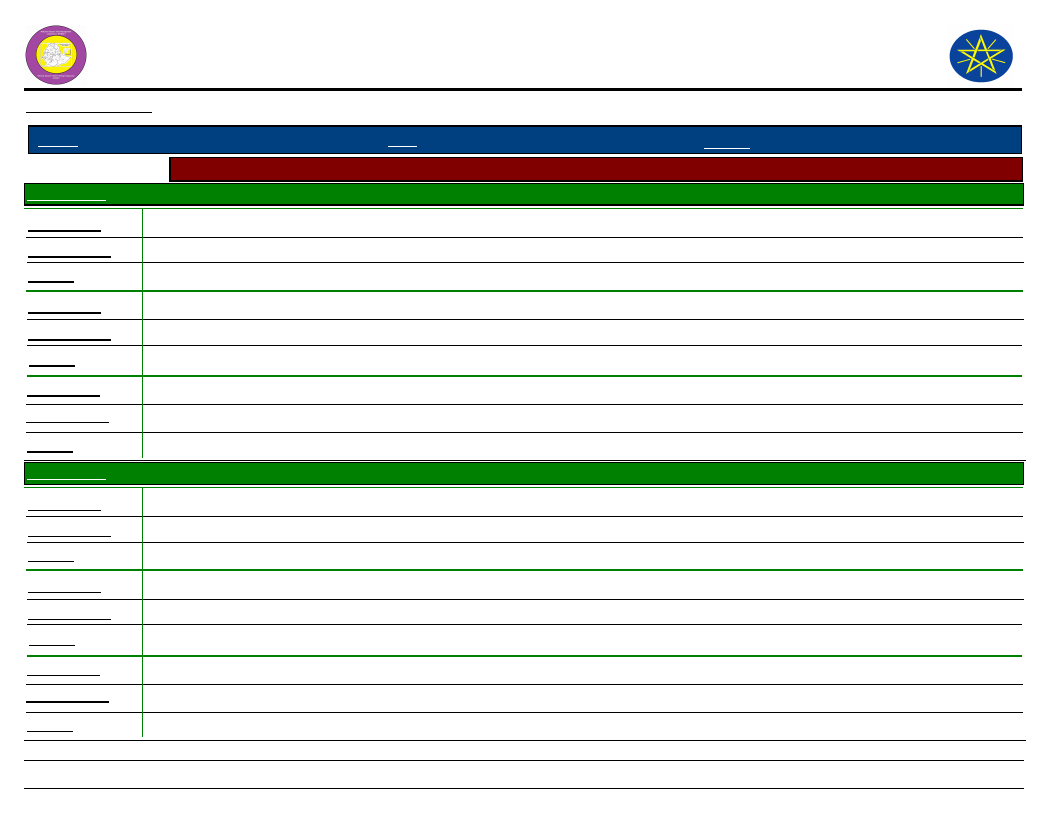
Wereda Disaster
Risk Profile
Data_Collected_Date
Region S.N.N.P
Zone GURAGE
Selected Indicator
Community Awareness of Disaster Risk Management System and Actors
Kebele Name
SEMEN SHORSHORA
Institution 1
Responsibility
Activity
Agricultural office
Provide agricultural input
For agricultural extension service
Institution 2
Responsibility
Activity
Health office
Health care
First aid, reporting and awareness creation
Institution 3
Responsibility
Activity
Kebele Name
Livestock health
livestock health care
Livestock vaccination, clinical treatment
SHERSHERA MACHMENA
Institution 1
Responsibility
Activity
Kebele administration
Coordination the community
Creating awareness
Institution 2
Responsibility
Activity
Kebele agriculture office
Agricultural extension
Creating awareness
Institution 3
Responsibility
Activity
Kebele health post
Prevent community health
Treatment
National Disaster Risk
Management Comission (NDRMC)
Wednesday, July 10, 2019
Wereda MESKAN
319
Page 12 of 15
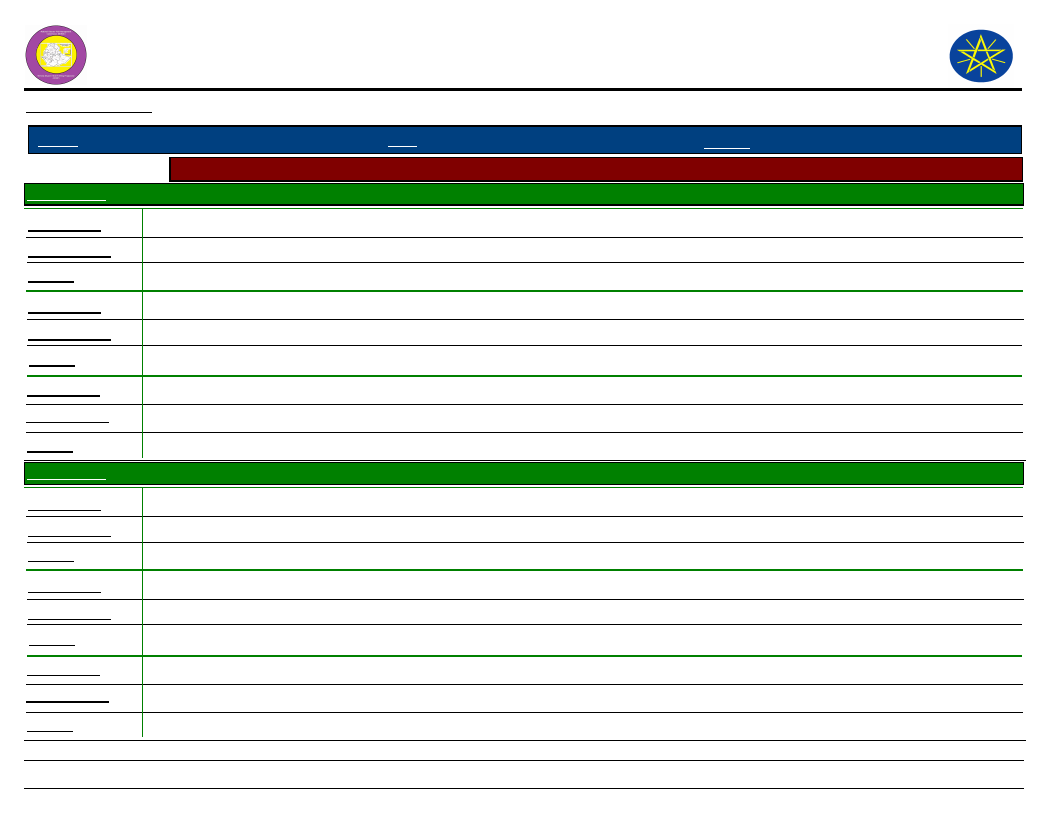
Wereda Disaster
Risk Profile
Data_Collected_Date
Region S.N.N.P
Zone GURAGE
Selected Indicator
Community Awareness of Disaster Risk Management System and Actors
Kebele Name
WEJABATI
Institution 1
Responsibility
Activity
Agricultural office
Give extension service
Raising awareness by visit the contact farmers
Institution 2
Responsibility
Activity
Health office
Care community health
Treatment patient
Institution 3
Responsibility
Activity
Kebele Name
Education office
Teaching the children
Teaching and learning activities
WITA
Institution 1
Responsibility
Activity
Farmer training center
Increase productivity
Institution 2
Responsibility
Activity
Health office
Prevent common disease
Treat patient
Institution 3
Responsibility
Activity
Education office
Teaching children
Crate awareness
National Disaster Risk
Management Comission (NDRMC)
Wednesday, July 10, 2019
Wereda MESKAN
320
Page 13 of 15
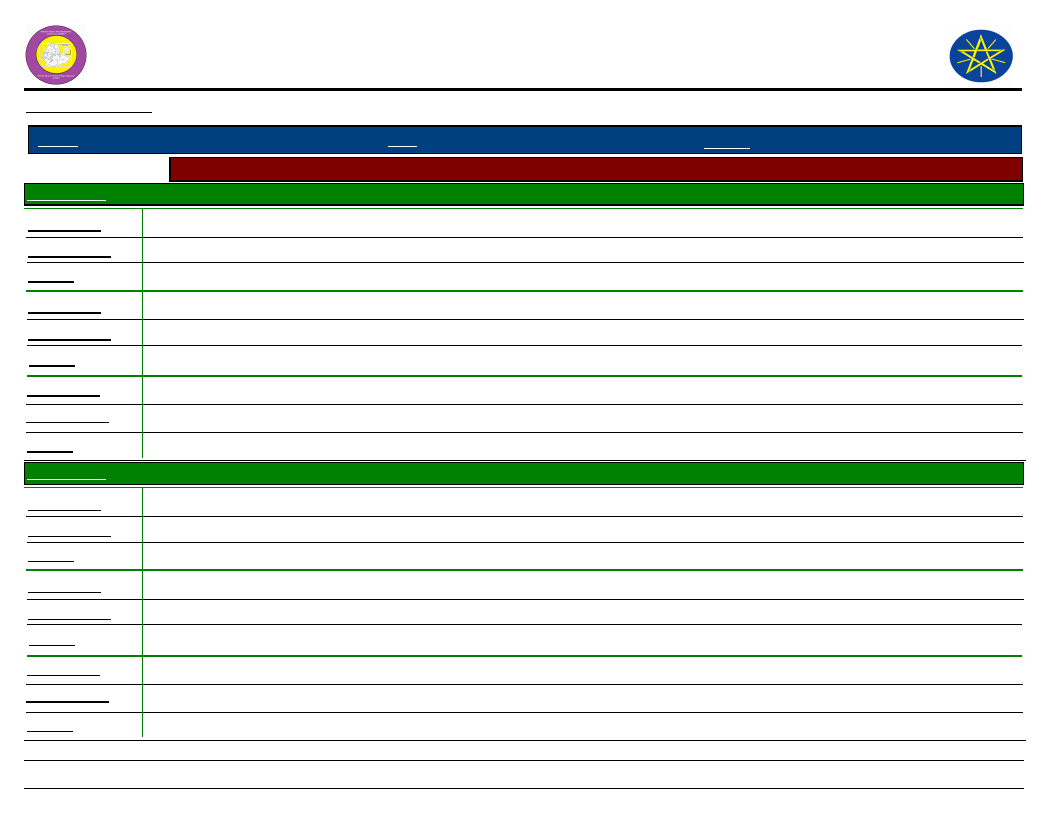
Wereda Disaster
Risk Profile
Data_Collected_Date
Region S.N.N.P
Zone GURAGE
Selected Indicator
Community Awareness of Disaster Risk Management System and Actors
Kebele Name
WOLENSHO ANDENYA
Institution 1
Responsibility
Activity
Agricultural office
Create awareness to farmers
With agricultural extension service
Institution 2
Responsibility
Activity
Health office
Protect some disease
Treatment
Institution 3
Responsibility
Activity
Kebele Name
Education office
Teaching the children and adults
Awareness creation
YETABON
Institution 1
Responsibility
Activity
Kebele Administration Office
Coordinate community
Reponses minor problems and report
Institution 2
Responsibility
Activity
Kebele Agricultural Office
Extension worker
Other heavy problems
Institution 3
Responsibility
Activity
National Disaster Risk
Management Comission (NDRMC)
Wednesday, July 10, 2019
Wereda MESKAN
321
Page 14 of 15
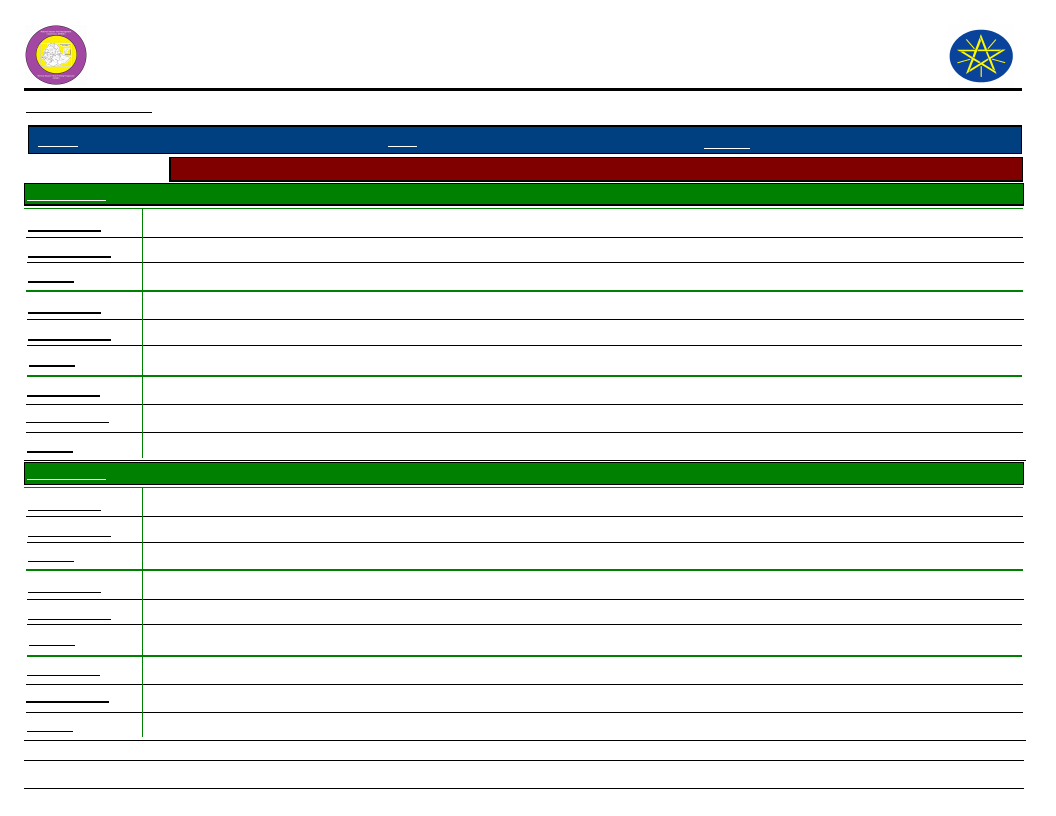
Wereda Disaster
Risk Profile
Data_Collected_Date
Region S.N.N.P
Zone GURAGE
Selected Indicator
Community Awareness of Disaster Risk Management System and Actors
Kebele Name
YIMERWACHO 2NYA
Institution 1
Responsibility
Activity
Kebele administration
Coordinate community
Contact
Institution 2
Responsibility
Activity
Agricultural office
Awareness creation
Report and awareness creation
Institution 3
Responsibility
Activity
Kebele Name
Health post
Health post agents
Treatment, first aid and report
YIMERWACHO 3NYA
Institution 1
Responsibility
Activity
Agriculture office
Give extension service
Raising awareness
Institution 2
Responsibility
Activity
Education office
Teaching the children
Teaching and learning activities
Institution 3
Responsibility
Activity
Health post
Improve community health
Treatment and diagnosis
National Disaster Risk
Management Comission (NDRMC)
Wednesday, July 10, 2019
Wereda MESKAN
322
Page 15 of 15
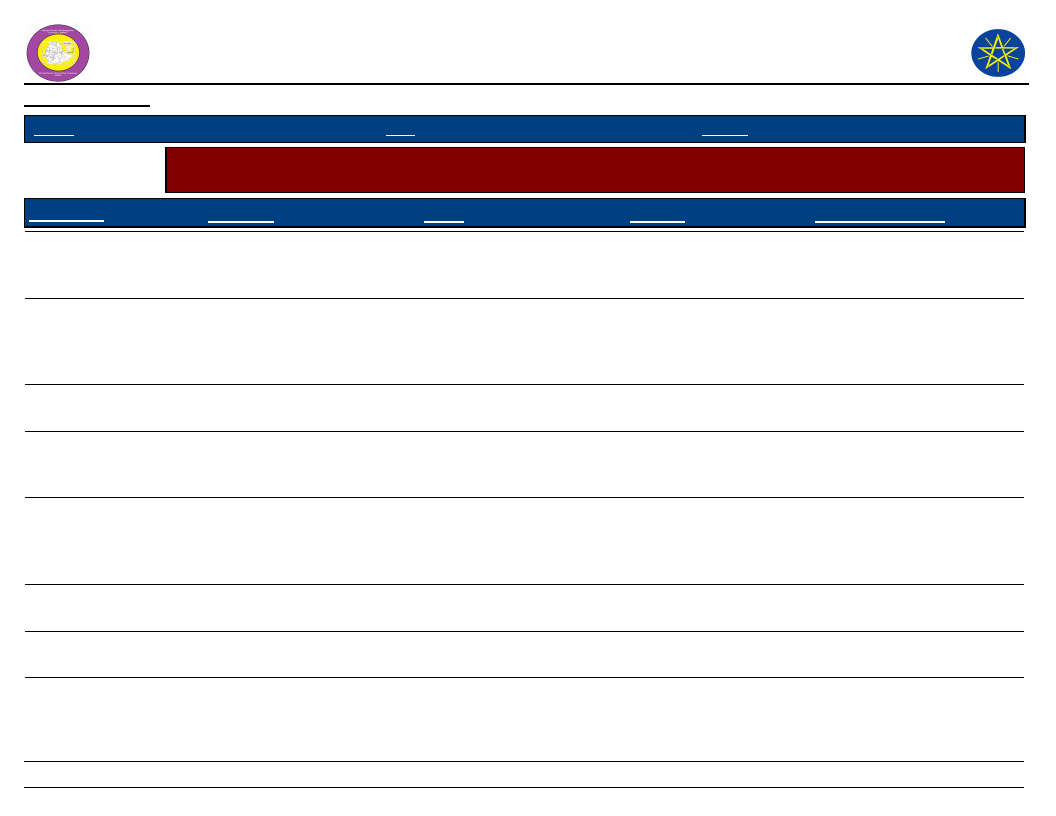
Wereda Disaster
Risk Profile
National Disaster Risk Management
Commission (NDRMC)
Data_Collected_Date
Wednesday, July 10, 2019
Region S.N.N.P
Zone GURAGE
Wereda MESKAN
Selected Indicator
Community Perception of DRM System and Actors - Perception of the community on the effectiveness of DRM
system in helping them to prevent, cope and recover from disasters
KebeleName
Prevention
Coping
Recovery
Overall_Effectiveness
BATI FATO
BATI LEJANO
BECHE BULCHANO
BERESA
DEBO TUTO
DEBUB SHERSHERA
DEGAGOGOT
DIDA
The community should be
take to irrigation activities
Not effective
Working as organization and
who should be linkage
Effective
Effective but not sustainable
Partially effective
Effective
Awareness to community
prioritize the problems and
sole the problem
By relief food and working
for food
Not effective
Relief, input aid and skilled
man power
Not satisfactory
Not effective
Not effective
Effective
Working for food program,
soil and water conservation
, vaccination and treatment
Cooperate the
communities by different
job opportunities
Shortage of fund and
budget and skilled man
power, no early response
Working food programs,
supplying input
Shortage of budget and
skilled man power
Shortage of budget and
skilled man power, no
coordination, nor early
response
Increase conservation
activities food for work
Good
Working for food
program, relief/food and
input aid
Lack of agricultural input,
lack of drug, lack of
awareness, lack of budget
and skilled man power
Linage of problem and late
the response of the disaster
Lack of drug, lack of
awareness and financial
problem
Lack of drug, lack of
awareness and financial
problem
The problem of
organization, carelessness
Unbalance demand and
supply
The problem of organization
of staff and scarcity of
finance /lack of budget
323
Page 1 of 5
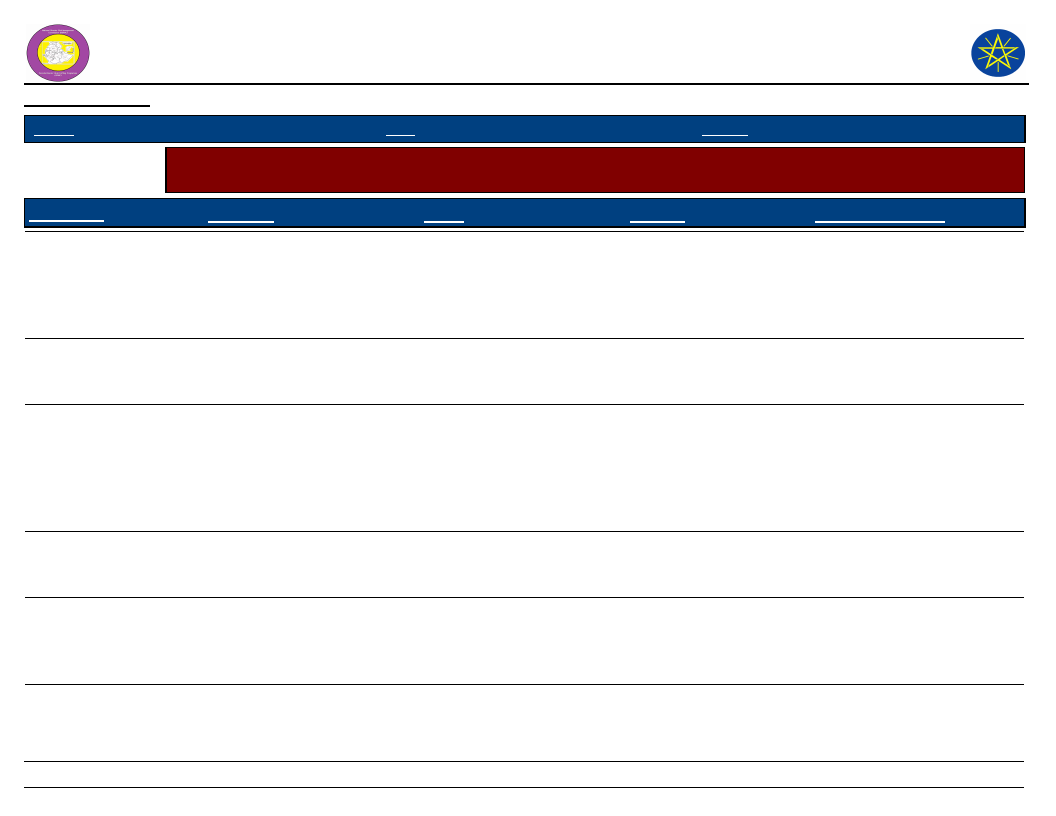
Wereda Disaster
Risk Profile
National Disaster Risk Management
Commission (NDRMC)
Data_Collected_Date
Wednesday, July 10, 2019
Region S.N.N.P
Zone GURAGE
Wereda MESKAN
Selected Indicator
Community Perception of DRM System and Actors - Perception of the community on the effectiveness of DRM
system in helping them to prevent, cope and recover from disasters
KebeleName
Prevention
Coping
Recovery
Overall_Effectiveness
DIRAMA
DOBENA
GIDENA ABORAT
GOYBAN
ILE
Selecting and identifying the
kebels disaster and prioritize
as their issue and organize
linkage make each other to
solve the problem
Conservation activities,
helping with relief and food
Identify the list kebeles
problem and report if it was
not solved and response at a
time to the problems as their
priority
Effective
Not effective
Facilitate and apply the
relief and other need
Relief, working for food,
support money and input
Help by food and material
at the disaster time,
construct permanent flood
protecting canals, supplying
productive and drought
resistant varieties
Effective
Not effective
Creating awareness and
working the protecting
measure to the
community
Hard working to the
effectiveness problem,
apply the theoretical
activities to practice
Support to build their
house by material, relief
and input support
By helping seed, food,
material and creating job
opportunities
Effective
Scarcity of budget and
shortage of skilled
person, no coordination,
no early response
Shortage of resource,
budget and problem of
identification of priority
The problem of selected and
identifying the damage
community and area,
problem of response and
prioritization, problem of
early warning precaution
Shortage of supply, financial
problem and lack of
coordination
Lack of drug and
equipment, financial
problem, lack of awareness
324
Page 2 of 5
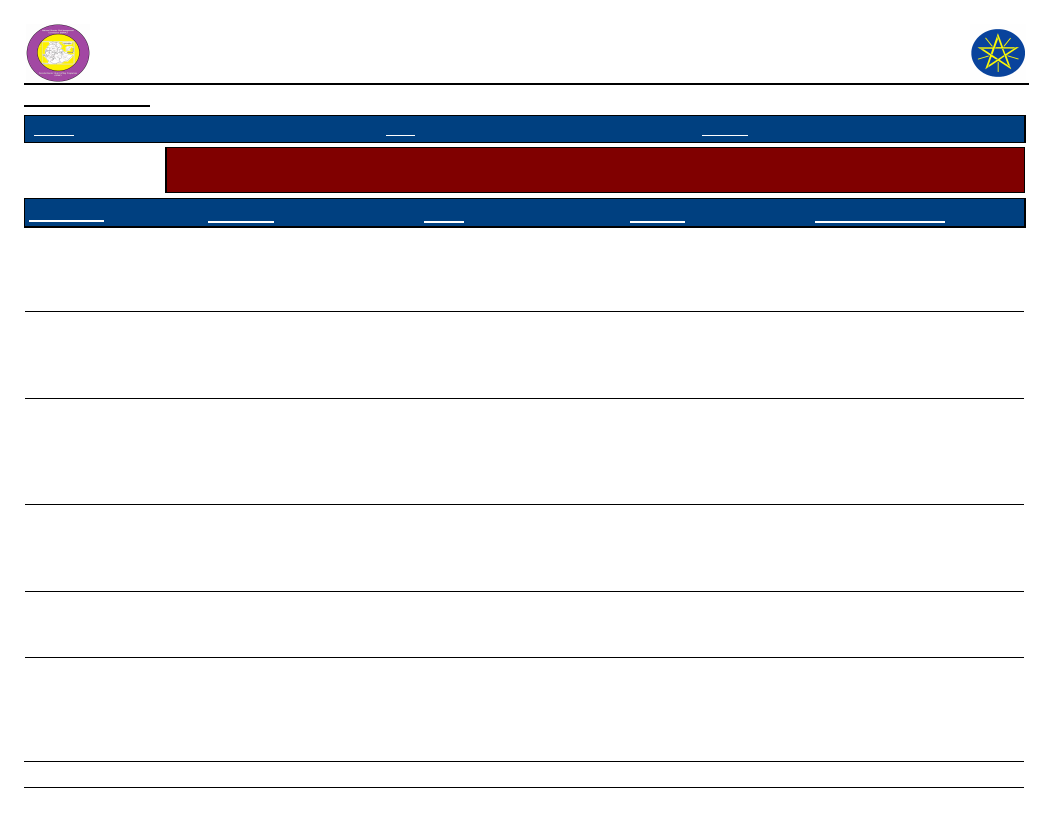
Wereda Disaster
Risk Profile
National Disaster Risk Management
Commission (NDRMC)
Data_Collected_Date
Wednesday, July 10, 2019
Region S.N.N.P
Zone GURAGE
Wereda MESKAN
Selected Indicator
Community Perception of DRM System and Actors - Perception of the community on the effectiveness of DRM
system in helping them to prevent, cope and recover from disasters
KebeleName
INSENO USME
JOLE ANDENYA
JOLE HULETENYA
MEKICHO
MESERETEWEGERAMO
MIKAELO
Prevention
Not effective
Coping
Not effective
Not effective
Not effective
Early warning information,
make preparedness activities
from the community
example, conservation,
saving activities etc
Facilitate the conservation
work of the area and food
security and working for food
program
Not effective
Relief, helping each other,
creating awareness
Relief/food, conservation
structures, planting
permanent protecting
plants
Not effective
Effective
Not effective
Recovery
Shortage of budget and
skilled man power
Shortage and less skilled
man power, no
coordination, no early
response
Support by inputs and
money, working for food,
supplying early matured
and resistant crops
Overall_Effectiveness
Lack of drug, lack of
awareness, not timely
submit agricultural not,
financial problem
Lack of drug for human and
livestock, financial problem,
lack of awareness
Early response, problem of
resistant variety and early
preparedness
Help with money, relief
and work for food
Shortage of capacity,
resource problem, less
commitment
Shortage of budget and
as killed man power
Shortage of budget and
skilled man power, no
coordination, no early
response
Lack of drug, lack of
awareness and financial
problems
Lack of drugs, lack of
awareness, financial
problems
325
Page 3 of 5
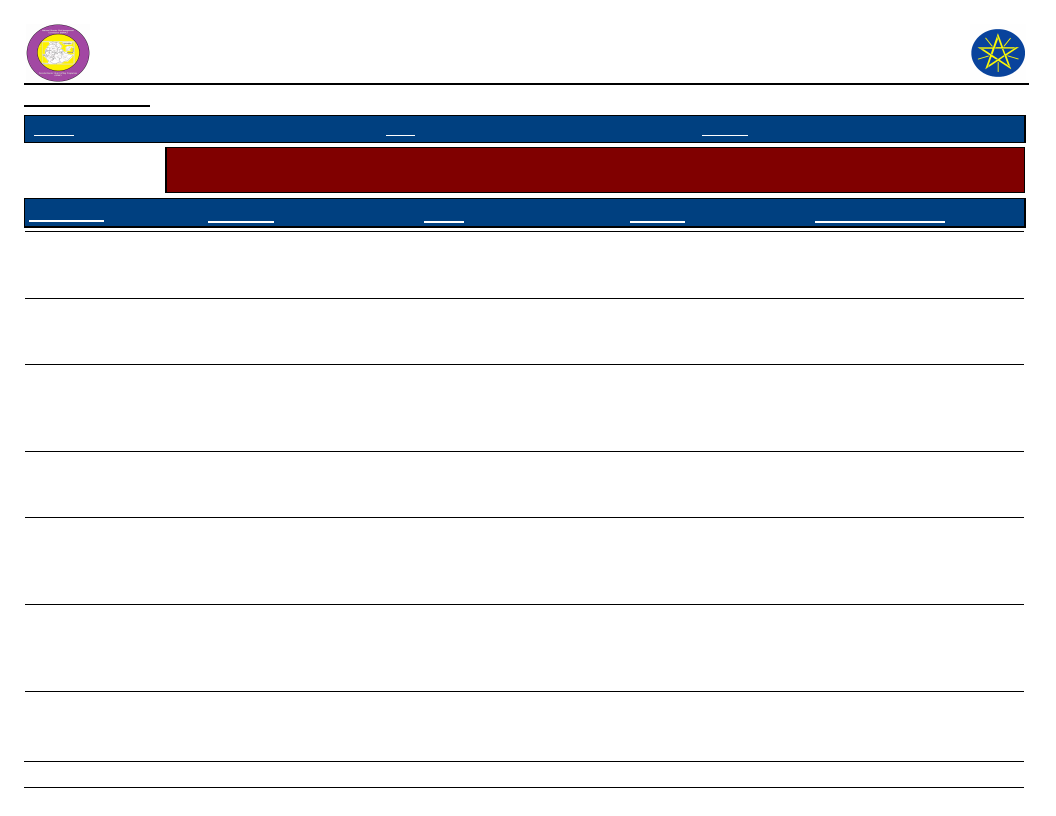
Wereda Disaster
Risk Profile
National Disaster Risk Management
Commission (NDRMC)
Data_Collected_Date
Wednesday, July 10, 2019
Region S.N.N.P
Zone GURAGE
Wereda MESKAN
Selected Indicator
Community Perception of DRM System and Actors - Perception of the community on the effectiveness of DRM
system in helping them to prevent, cope and recover from disasters
KebeleName
Prevention
Coping
Recovery
Overall_Effectiveness
MIRAB IMBOR
MIRAB MESKAN
OCHAGENEME
Effective
Not effective
SEMEN SHORSHORA
Not sufficient
SHERSHERA MACHMENA
Not effective
WEJABATI
It is not satisfactory to solve
the problem due to the
shortage of goods, service,
administration cost
Effective
Organized each other and
priorities the communities
problem and the disaster
Response and relief work
less or compare to the
vulnerable community
Not sufficient
Partially effective
Response and relief is not
satisfactory
By relief, helping with
financial and material
Relief helping from
government, material
and input support
Shortage and scarcity of
budget and skilled man
power, no coordination,
no early response
Very good
The response was very
late so the future the
response of the disaster
should be fasted
Shortage of budget and
skilled man power, no
coordination, no early
response
The problem of good
management, organization,
capacity and economic
Problem of organization,
poor awareness, problem of
good governance
Lack of drug, awareness and
financial problem
Shortage of supply, financial
problem, problem of
coordination
The problem bad
administration and less or
weak respondent
Lack of drugs, financial
problem, lack of awareness
326
Page 4 of 5
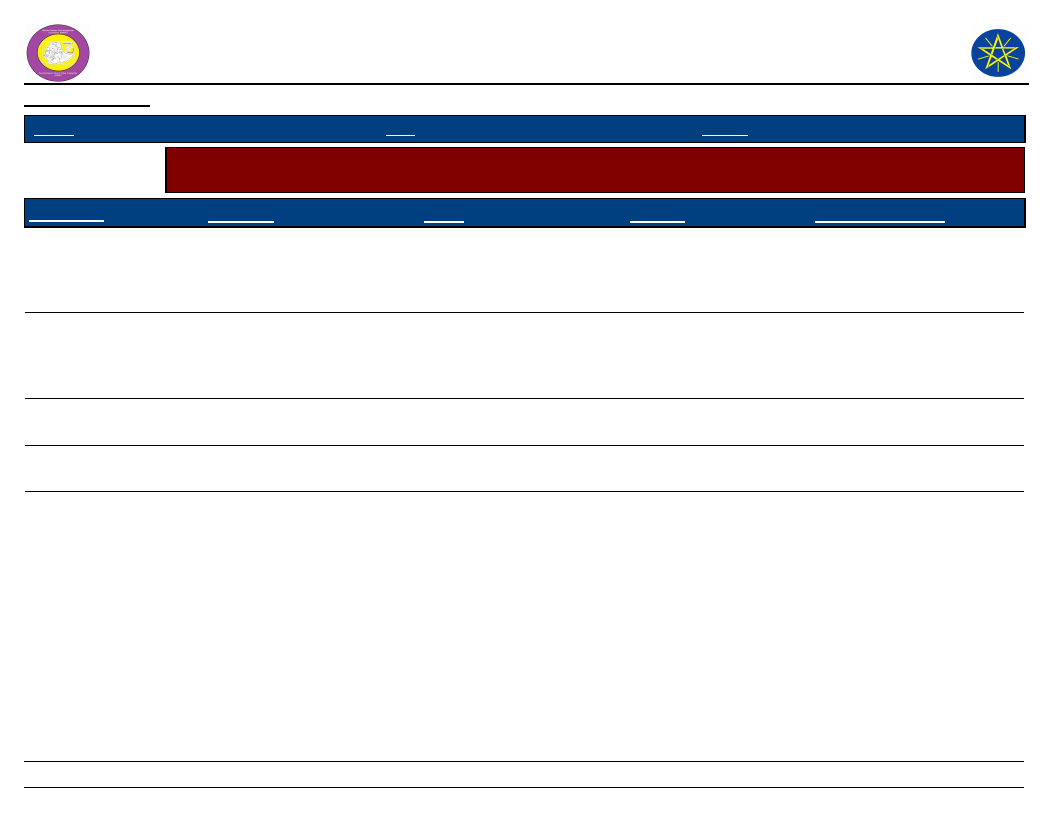
Wereda Disaster
Risk Profile
National Disaster Risk Management
Commission (NDRMC)
Data_Collected_Date
Wednesday, July 10, 2019
Region S.N.N.P
Zone GURAGE
Wereda MESKAN
Selected Indicator
Community Perception of DRM System and Actors - Perception of the community on the effectiveness of DRM
system in helping them to prevent, cope and recover from disasters
KebeleName
WITA
WOLENSHO ANDENYA
YETABON
YIMERWACHO 2NYA
YIMERWACHO 3NYA
Prevention
It is moderately good but
they need sustainable control
measure
The activity is good and
effective
Coping
Response and relief water
effectiveness is good
Not effective
Effective
Effective
Not effective
Relief, working for food
program
Not effective
Not effective
Recovery
Shortage of budget and
skilled man power, no
coordination, no early
response
Shortage of budget and
skilled man power, no
coordination, no early
response
Cultivate resistant and
early mature plants
Not effective
Shortage of budget and
skilled man power
Overall_Effectiveness
Lack of resource, lack of
drug, financial problem
Lack of drug both animals
human transmit, financial
problem, lack of awareness
Poor early response and
problem of preparedness
The government or relief
respond very delay
Agricultural input not
submit in the area timely in
sufficient enough human
and livestock medicine not
available due to this the
institution is not effective
327
Page 5 of 5
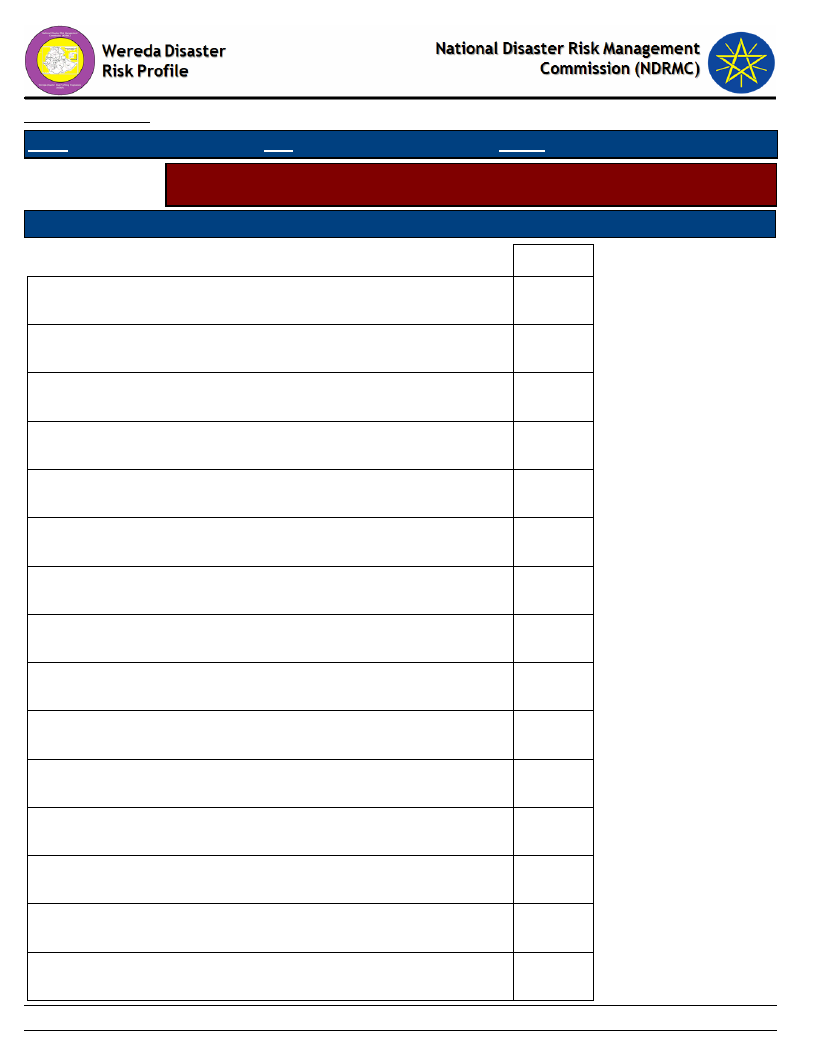
Data_Collected_Date
Region S.N.N.P
Zone GURAGE
Wereda MESKAN
Wednesday, July 10, 2019
Selected Indicator
Major Public Interventions Desired - Percentage of households by type of
intervention desired
Major public interventions desired by the community
Degree of Importance for the community
1st
Access to markets
0.27
Access to roads
0.55
Agricultural inputs (fertilizer, improved seeds, etc.)
13.11
Better job
21.86
Cash transfers/social assistance
11.75
Enhance access to schools / School feeding for children
2.19
Food-for-work activities
1.91
Medical assistance / access to health facilities
1.64
Micro-credit programmes
2.73
Other
0.27
Rental subsidies
0.55
School fees for children
0.27
Subsidized food
2.19
Subsidized health care
2.19
Supplementary feeding for women and young children
1.64
328
Page 1 of 2
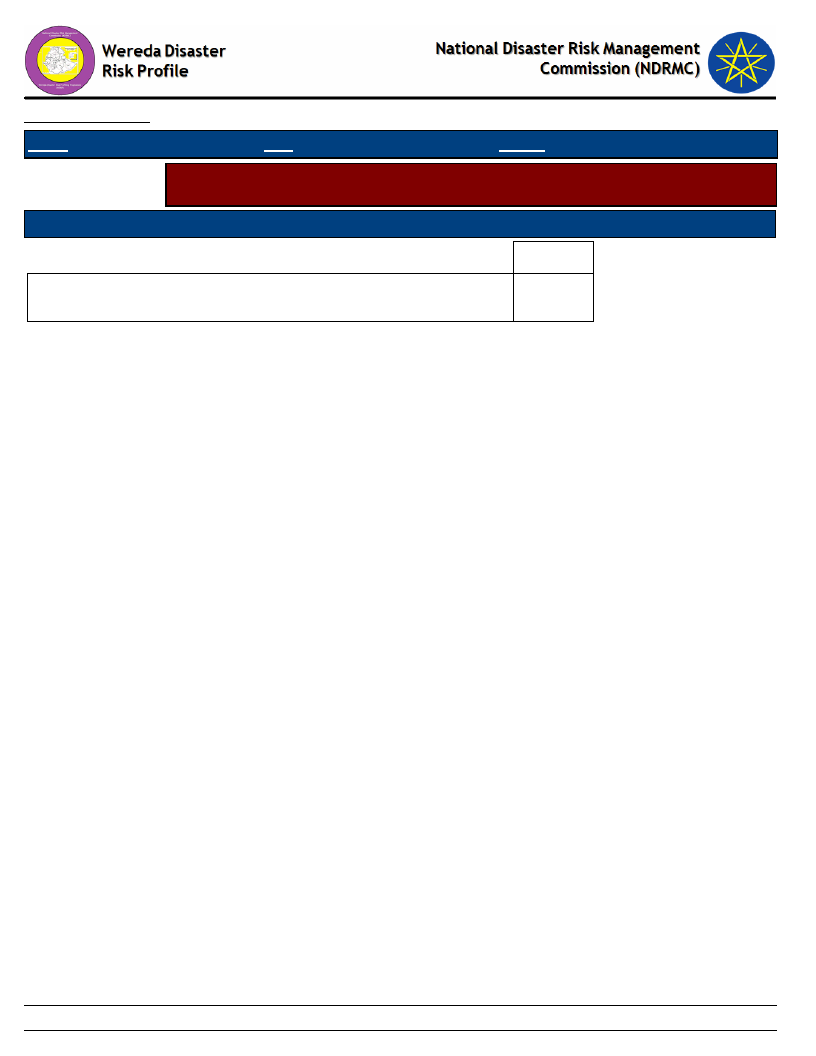
Data_Collected_Date
Region S.N.N.P
Zone GURAGE
Wereda MESKAN
Wednesday, July 10, 2019
Selected Indicator
Major Public Interventions Desired - Percentage of households by type of
intervention desired
Major public interventions desired by the community
Degree of Importance for the community
Food aid
1st
35.79
329
Page 2 of 2
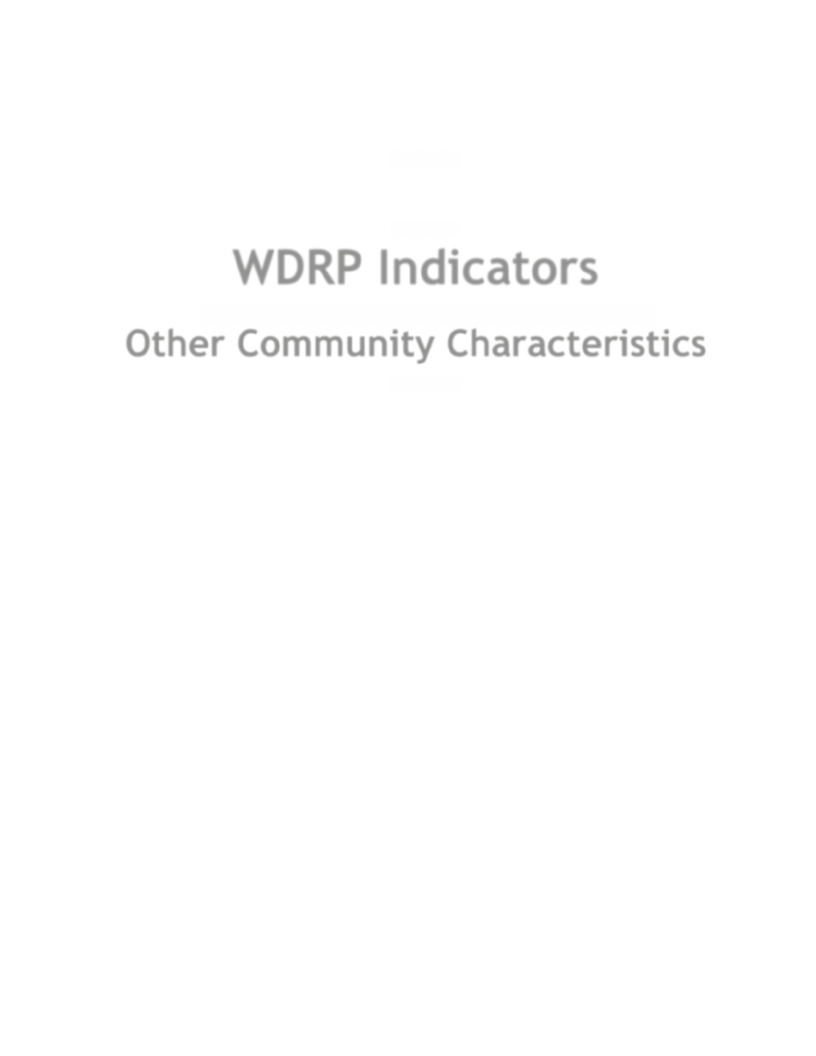
WDRP Indicators
Other Community Characteristics
330
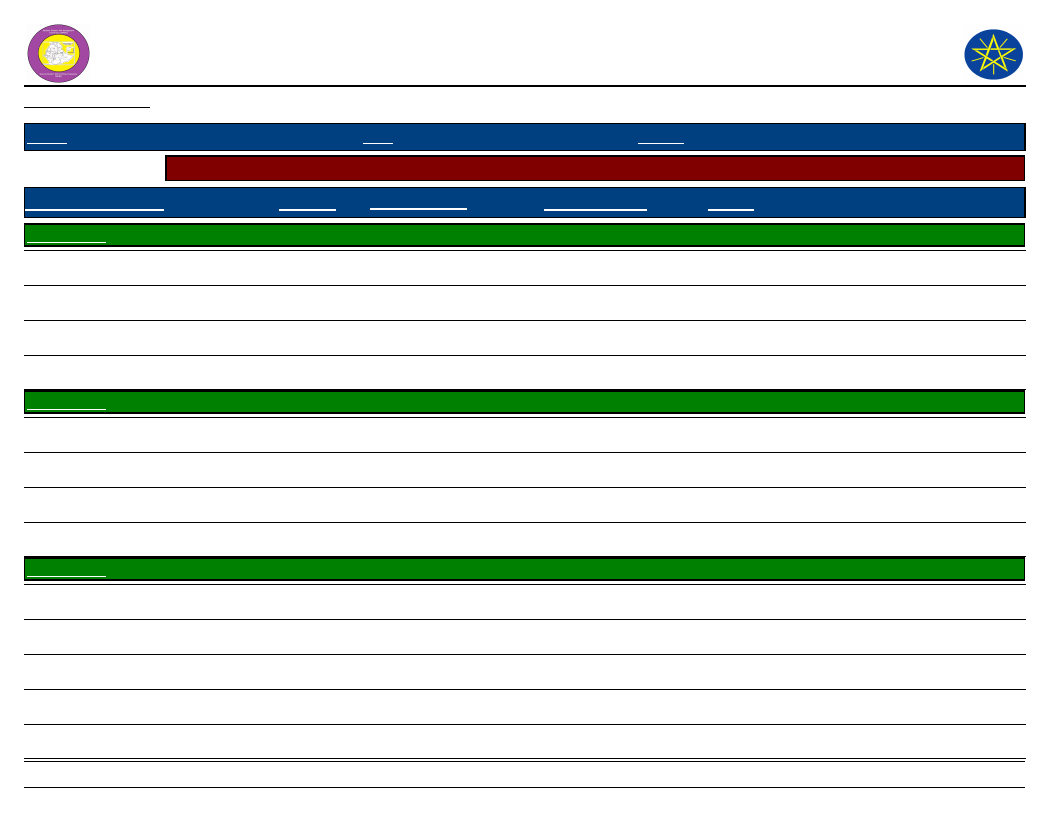
Wereda Disaster
Risk Profile
Data_Collected_Date
National Disaster Risk Management
Commission (NDRMC)
Wednesday, July 10, 2019
Region S.N.N.P
Zone GURAGE
Wereda MESKAN
Selected Indicator
Capacity: Community Based Organizations in the Wereda
Name_Of_Organization
Est._Year
Formal/Informal
Type of Members
Activity
Kebele Name BATI FATO
Saving and credit association
1992
Formal
Both
Saving and credit activities
Farmers
2007
Informal
Both
Helping each other
Edir
Informal
Both
Helping each other
Ekub
Informal
Both
Helping each other
Kebele Name
Edir
BATI LEJANO
Informal
All communities
Helping each other
Farmers Association
1996
Formal
Farmers
Irrigation, selling the products
Women Association
1990
Formal
Women
Saving and credit activities
Youth Association
1996
Formal
Youth
Selling the product
Kebele Name
Cooperatives
BECHE BULCHANO
1969
Formal
Both
Supplying input and house hold consumption
Lika
---------
Male
Social and spiritual activities
Saving and credit cooperatives
2000
---------
Both
Saving and credit activities
Equb
---------
Both
Saving and credit activities
Edir
1978
Informal
Both
Save food and economic problem
331
Page 1 of 11
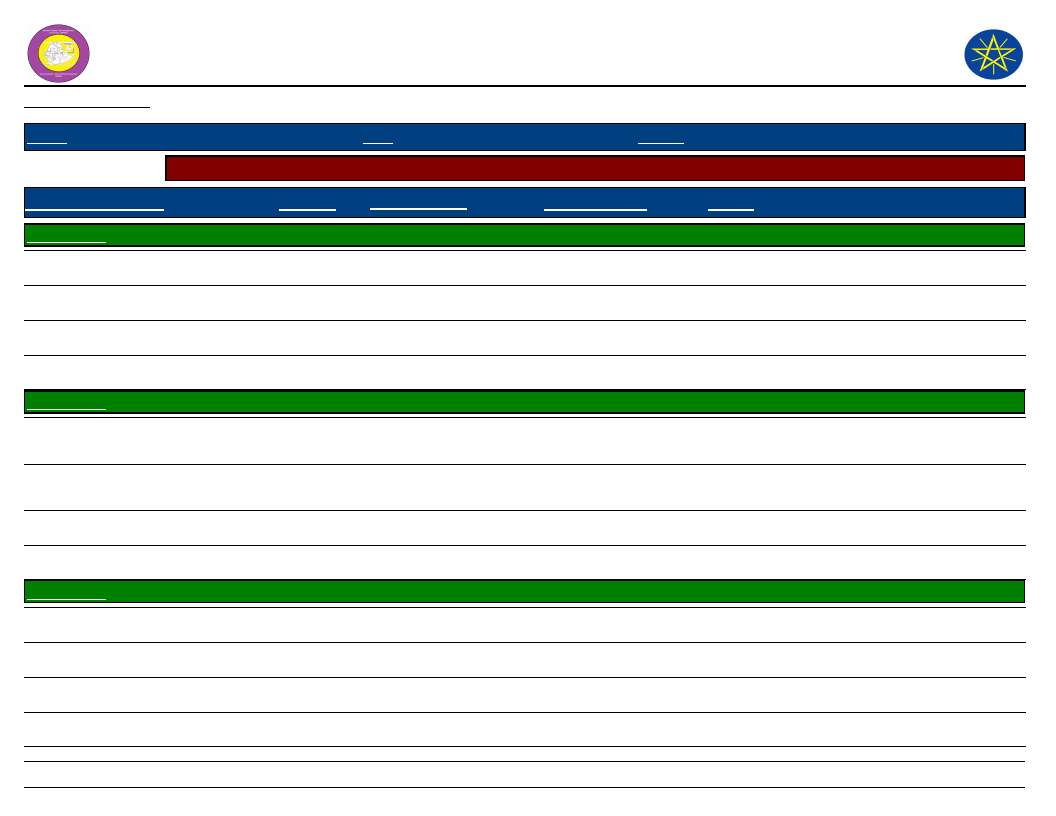
Wereda Disaster
Risk Profile
Data_Collected_Date
Region S.N.N.P
Zone GURAGE
Selected Indicator
Capacity: Community Based Organizations in the Wereda
Name_Of_Organization
Est._Year
Formal/Informal
Kebele Name
Edir
BERESA
1942
Informal
Cooperative
1989
Formal
Women association
2004
Formal
Youth association
Kebele Name DEBO TUTO
Youth Association
2007 - 2008
2004
Formal
Formal
Women Association
2007
Formal
Farmers Association
Edir
Kebele Name
Lika
DEBUB SHERSHERA
Omo microfinance
Saving and credit association
Edir
1997
1985
2002
2005
Formal
Informal
Informal
Formal
Formal
Formal
National Disaster Risk Management
Commission (NDRMC)
Wednesday, July 10, 2019
Wereda MESKAN
Type of Members
Male
Both
Both
Both
Activity
Helping each other
Saving and credit activities
Petty trade
Stone and sand, irrigation, bee keeping
Selling sand and stone, fattening, selling
the production
Soil and oil distribute to the community,
saving and credit activities
Distribute the inputs
Selling he mature seed
Spiritual and social problems
To get saving and credit access
To get saving and credit access
To solve social problem, helping each other
332
Page 2 of 11
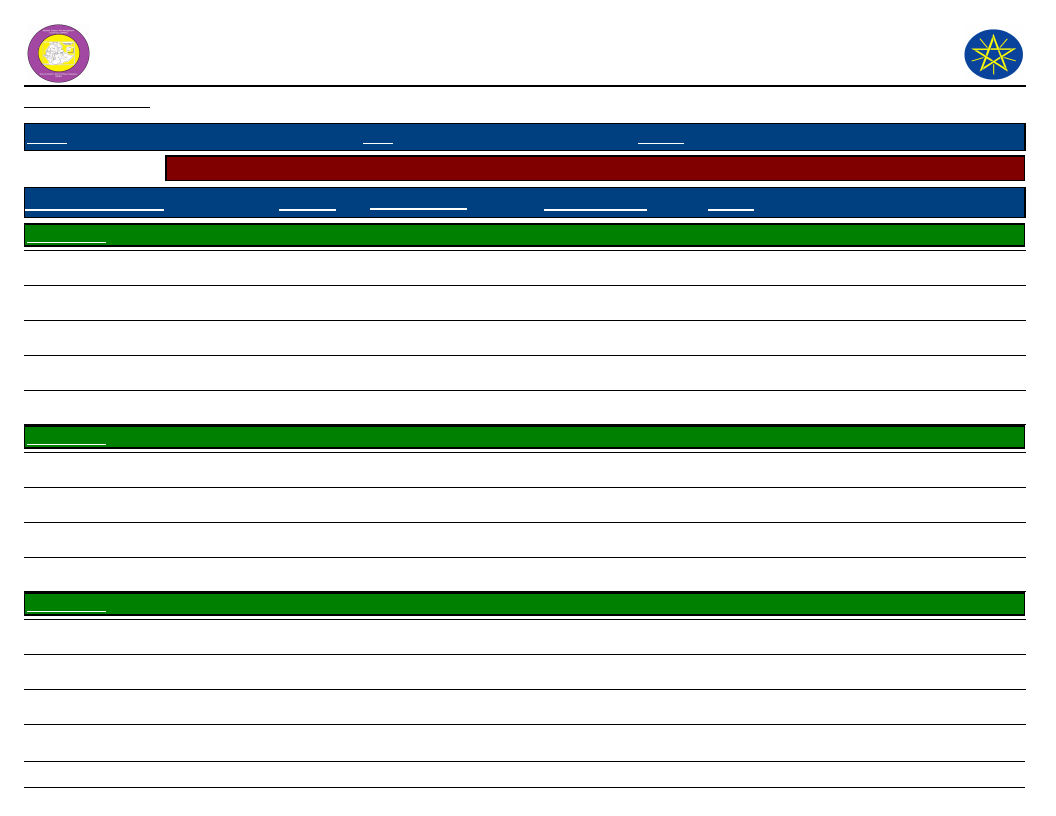
Wereda Disaster
Risk Profile
Data_Collected_Date
National Disaster Risk Management
Commission (NDRMC)
Wednesday, July 10, 2019
Region S.N.N.P
Zone GURAGE
Wereda MESKAN
Selected Indicator
Capacity: Community Based Organizations in the Wereda
Name_Of_Organization
Est._Year
Formal/Informal
Type of Members
Activity
Kebele Name DEGAGOGOT
saving and credit
1998
Formal
Both
Solve socio economic problems
Debo
Informal
Female
Solve socio economic problems
Edir
Informal
Both
Solve socio economic problems
Ekub
Informal
Both
Solve socio economic problems
Lika
Informal
Make
Solve socio economic problems
Kebele Name
Equb
DIDA
Informal
Both
Economic solution
Edir
Informal
Both
Solve social and economic problem
Lika
Informal
Male
Spiritual and social solution
Saving and credit
1991
Formal
Both
Economic solution
Kebele Name DIRAMA
Saving and credit cooperative
2008
Formal
Both
Saving and credit service
Cooperatives
1999
Formal
Both
Credit and saving activities
Senbete
Informal
Male
Solved social problems
Ekup
Informal
Both
To solve financial problems
333
Page 3 of 11
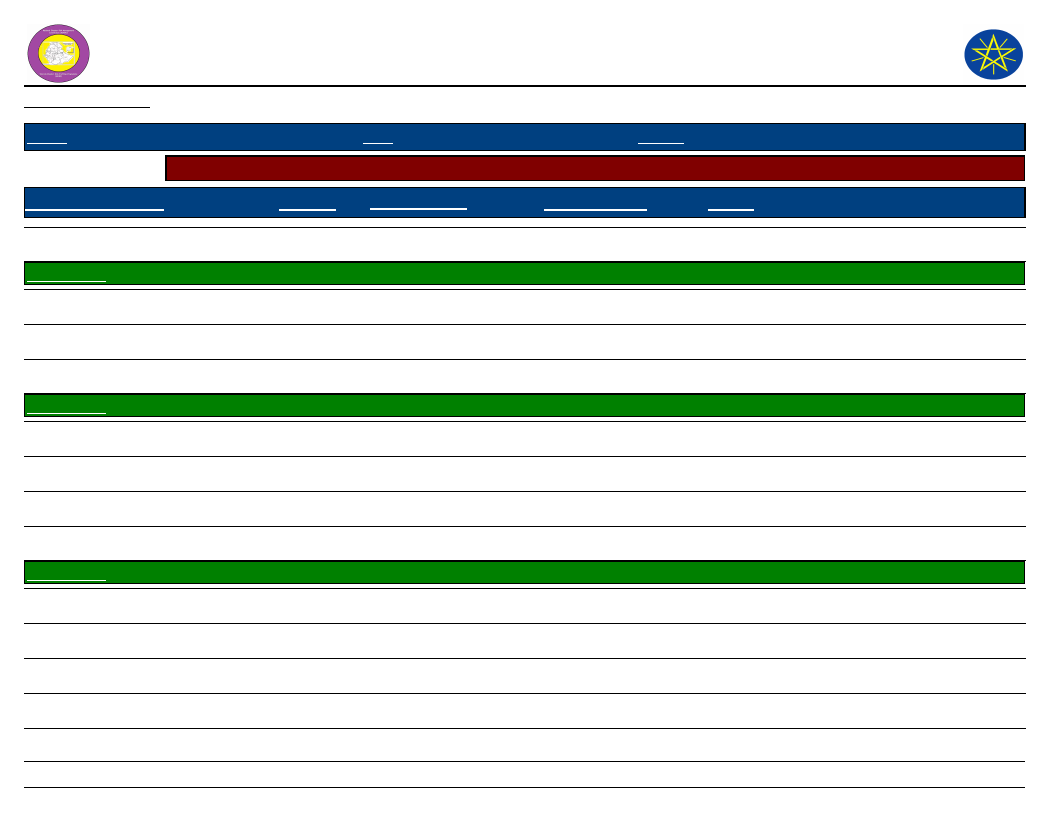
Wereda Disaster
Risk Profile
Data_Collected_Date
National Disaster Risk Management
Commission (NDRMC)
Wednesday, July 10, 2019
Region S.N.N.P
Zone GURAGE
Selected Indicator
Capacity: Community Based Organizations in the Wereda
Name_Of_Organization
Est._Year
Formal/Informal
Wereda MESKAN
Type of Members
Activity
Edir
Kebele Name
Equp
DOBENA
Edir
Saving and credit activities
Kebele Name GIDENA ABORAT
Saving and credit activities
Irrigation cooperative
Edir
Equp
Kebele Name
Lika
GOYBAN
Dado
Equb
Edir
Saving and credit service
2003
1996
1998
Informal
Both
Informal
Informal
Formal
Both
Both
Both
Formal
Formal
Informal
Informal
Both
Both
Both
Both
Informal
Informal
Informal
Informal
Formal
Community
Community
Community
Community
Farmers
334
Helping each other
Solve financial problems
Solve the problem, helping each other
Solve financial problems
Solve financial problems
Crop production
Solve social and economical solution
Solve financial problems
Spiritual and economic problems
Solve spiritual and economic problems
Solve social and economic problem
Solve social and economic problem
Solve economic problem
Page 4 of 11
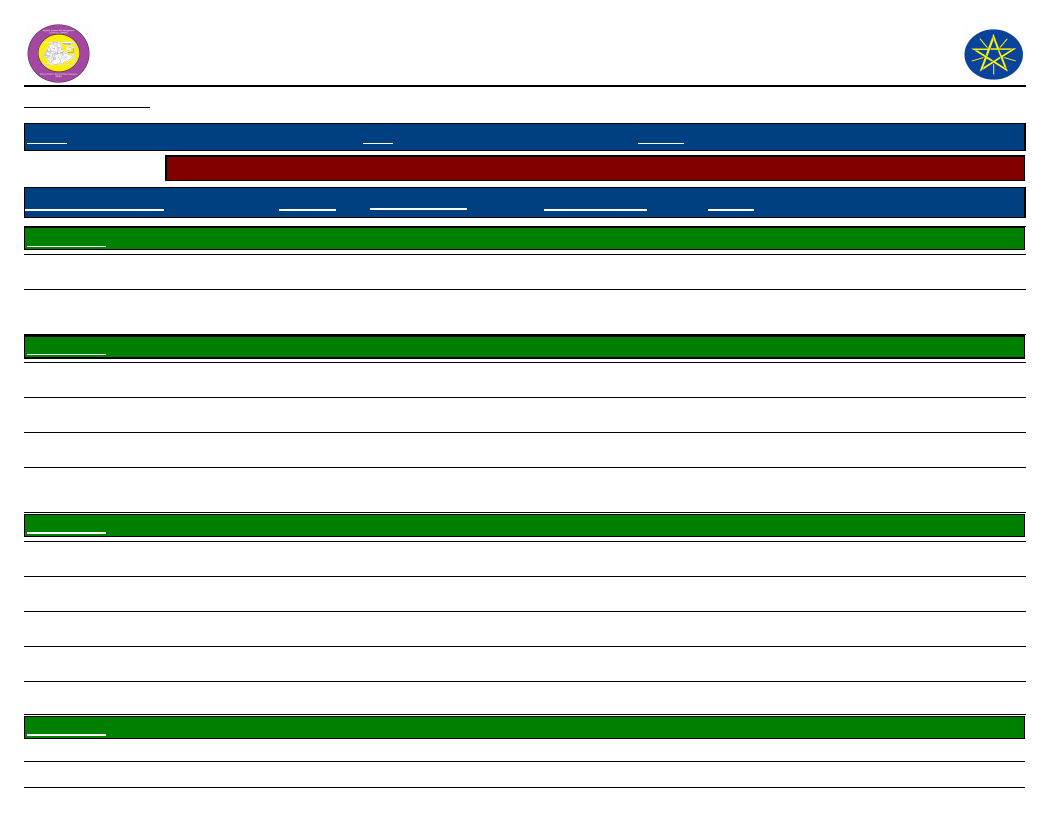
Wereda Disaster
Risk Profile
Data_Collected_Date
Region S.N.N.P
Zone GURAGE
Selected Indicator
Capacity: Community Based Organizations in the Wereda
Name_Of_Organization
Est._Year
Formal/Informal
Kebele Name ILE
Youth Association
2006
Formal
Women Association
2006
Formal
Kebele Name INSENO USME
Women Association
Farmers Association
Youth Association
Edir
2004
2004
2003
Formal
Formal
Formal
Informal
Kebele Name
Edir
JOLE ANDENYA
Ekub
Youth
Farmers association
Women
Kebele Name
JOLE HULETENYA
1990
2002
2006
2004
2004
Informal
Informal
Formal
Formal
Formal
National Disaster Risk Management
Commission (NDRMC)
Wednesday, July 10, 2019
Wereda MESKAN
Type of Members
Activity
Youth
Women
Women
Irrigation
Youth
Both
Youth
Women
Women
Fattening and stole selling
Selling products to community like oil,
sugar
Give service
Selling farming production
Give service
Helping each other, collecting money for
the members
Helping each other
Saving money and creating job opportunism
Selling stone and sand, selling production
Saving money
Saving money
335
Page 5 of 11
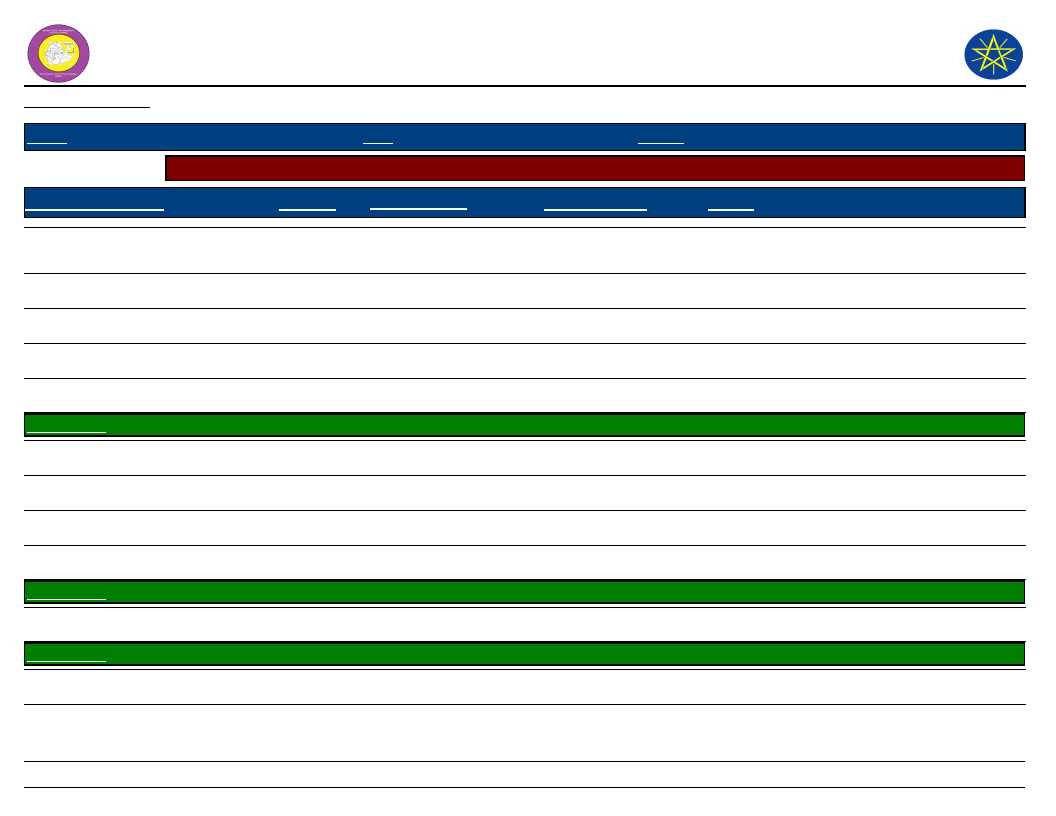
Wereda Disaster
Risk Profile
Data_Collected_Date
Region S.N.N.P
Zone GURAGE
Selected Indicator
Capacity: Community Based Organizations in the Wereda
Name_Of_Organization
Est._Year
Formal/Informal
Saving and credit activities
1996
Formal
Edir
Lika
Dado
Ekub
Kebele Name
Edir
MEKICHO
Equb
Saving and credit
1987
Input union
2002
Kebele Name MESERETEWEGERAMO
Youth organization
2006
Kebele Name MIKAELO
Youth organization
2002
Saving and credit association
2002
Informal
Informal
Informal
Informal
Informal
Informal
Formal
Formal
Formal
Formal
Formal
National Disaster Risk Management
Commission (NDRMC)
Wednesday, July 10, 2019
Wereda MESKAN
Type of Members
Male and female
Male and female
Male
Female
Male and female
Both
Both
Both
Both
Irrigation
Women
Activity
Saving and credit service, solve financial
problems
Solve social and economical problems
Spiritual and social problems
Spiritual and social problems
Solve financial problems
Solve social and financial problems
Solve financial problems
Solve financial problems
Supply inputs and consumption
Sell the products
Increasing income
Saving and credit activity
336
Page 6 of 11
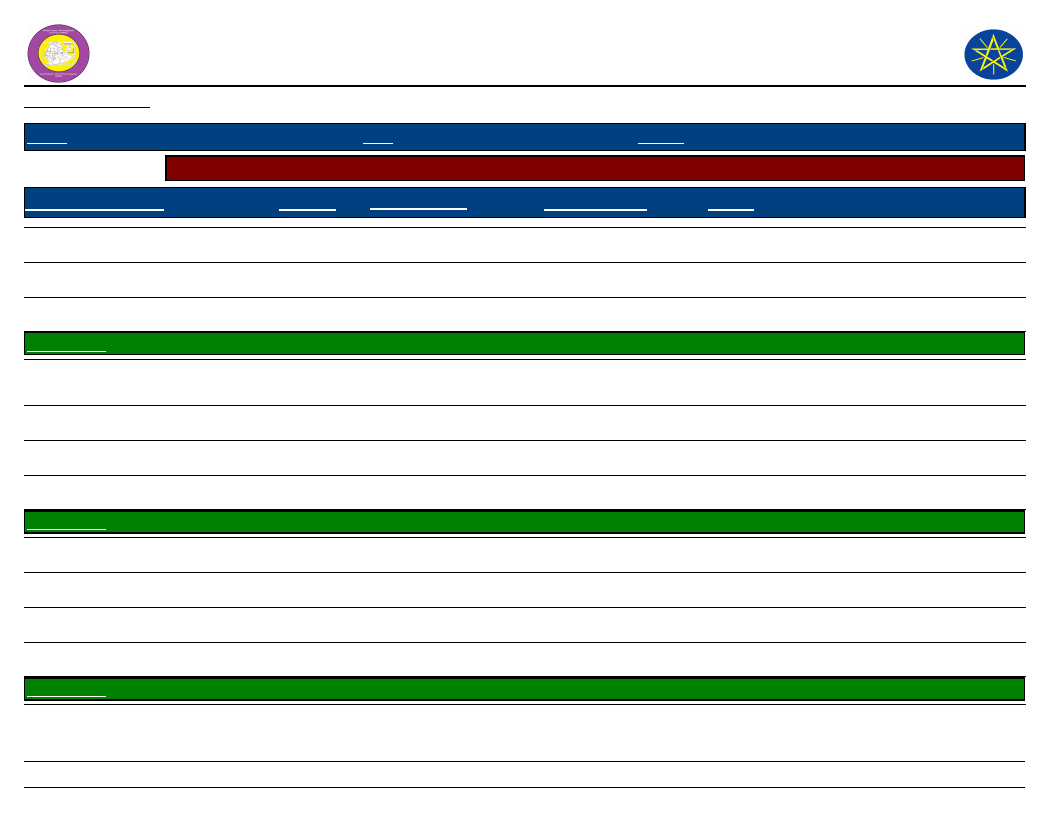
Wereda Disaster
Risk Profile
Data_Collected_Date
Region S.N.N.P
Zone GURAGE
Selected Indicator
Capacity: Community Based Organizations in the Wereda
Name_Of_Organization
Est._Year
Formal/Informal
Farmer organization
Edir
Ekub
Kebele Name
Lika
MIRAB IMBOR
1996
1950
1993
Formal
Informal
Informal
Informal
Equb
Edir
Saving and credit association
Kebele Name MIRAB MESKAN
Saving and credit association
Edir
Lika
Dado
Kebele Name
Edir
OCHAGENEME
2003
2003
Informal
Informal
Formal
Formal
Informal
Informal
Informal
Informal
National Disaster Risk Management
Commission (NDRMC)
Wednesday, July 10, 2019
Wereda MESKAN
Type of Members
Male
Both
Both
Both
Both
Both
Male
Female
Both
Activity
Fattening, increase income
Helping each other
Creating better job opportunity
Spiritual, financial and social problems
solved
Solve economic problems
Solve social and financial problems
Solve economic problem
For financial problems
Solving social and economic problems
Spiritual and social problem
Spiritual and social problem
Helping each other
337
Page 7 of 11

Wereda Disaster
Risk Profile
Data_Collected_Date
Region S.N.N.P
Zone GURAGE
Selected Indicator
Capacity: Community Based Organizations in the Wereda
Name_Of_Organization
Est._Year
Formal/Informal
Ekub
2002
Farmer association
1993
Women association
1999
Youth association
Kebele Name SEMEN SHORSHORA
Coordinate
2007
200
Ekub
Lika
Dado
Edir
Kebele Name SHERSHERA MACHMENA
Saving and credit association
2006
Ekub
1958
Edir
1966
Saving and credit association
2003
Informal
Formal
Formal
Formal
Formal
Informal
Informal
Informal
Informal
Informal
Informal
Informal
Formal
National Disaster Risk Management
Commission (NDRMC)
Wednesday, July 10, 2019
Wereda MESKAN
Type of Members
Both
Male
Both
Both
Both
Both
Male
Female
Both
Both
Both
Both
Both
Activity
Collect cash and using with turn
Selling the production
Credit and saving activity
Sell the product
Saving and credit activity
Solve socio-economic problems
Solve socio-economic problems
Solve socio-economic problems
Solve socio-economic problems
Used financial problem
Used financial problem
Helping each other
Credit and saving activities
338
Page 8 of 11
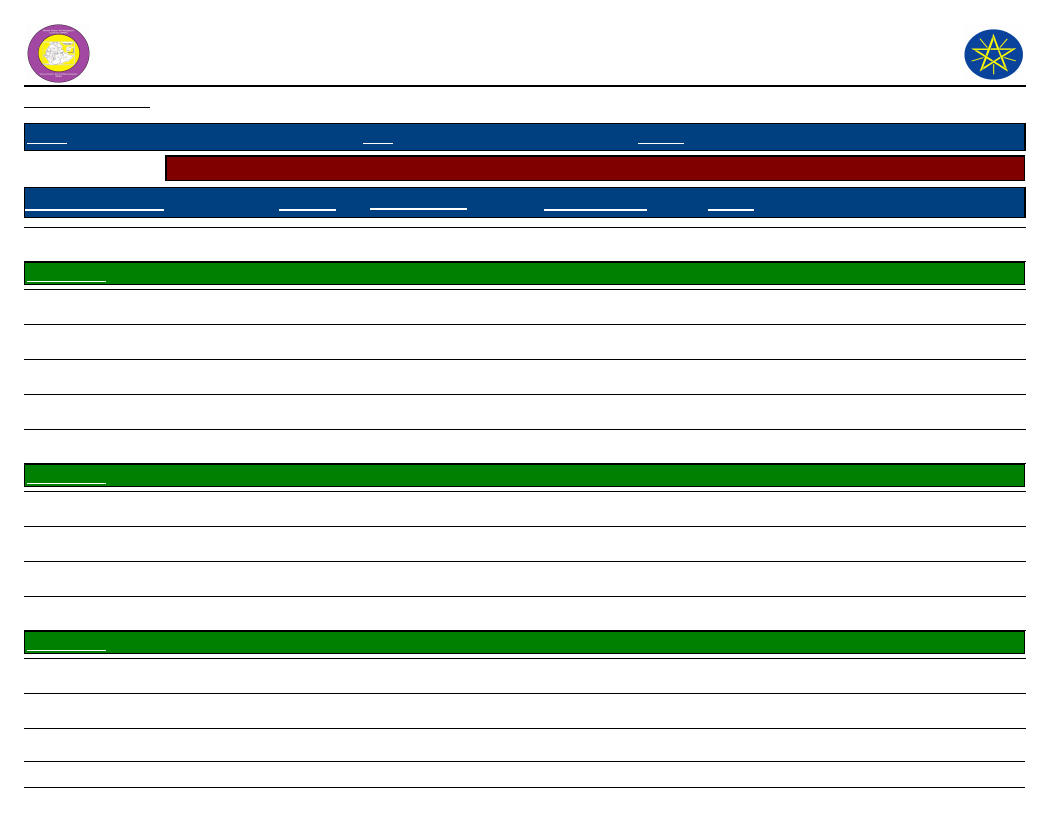
Wereda Disaster
Risk Profile
Data_Collected_Date
National Disaster Risk Management
Commission (NDRMC)
Wednesday, July 10, 2019
Region S.N.N.P
Zone GURAGE
Selected Indicator
Capacity: Community Based Organizations in the Wereda
Name_Of_Organization
Est._Year
Formal/Informal
Wereda MESKAN
Type of Members
Activity
Union
Kebele Name WEJABATI
Youth association
1997
1997
Farmer association
2007
Farmer association
2009
Women association
2001
Edir association
Kebele Name WITA
Ekub
2001
Edir
1985
Women association
2002
Youth association
2001
Kebele Name WOLENSHO ANDENYA
Youth association
2000
Women association
2000
Cooperative
2003
Formal
Both
Formal
Formal
Formal
Formal
Informal
Youth
Farmers
Farmers
Women
Community
Informal
Informal
Formal
Formal
Women
Youth
Formal
Formal
Formal
Youth
Women
339
Used for agricultural input
Sell the product, agricultural activities
Collect seed and selling production
Collect seed and selling production
Saving and credit activities
Helping each other
To create better job opportunity
Contribute
Saving money
Sell the products
Selling livestock and livestock production
Selling production in near market
Distribute agricultural input
Page 9 of 11
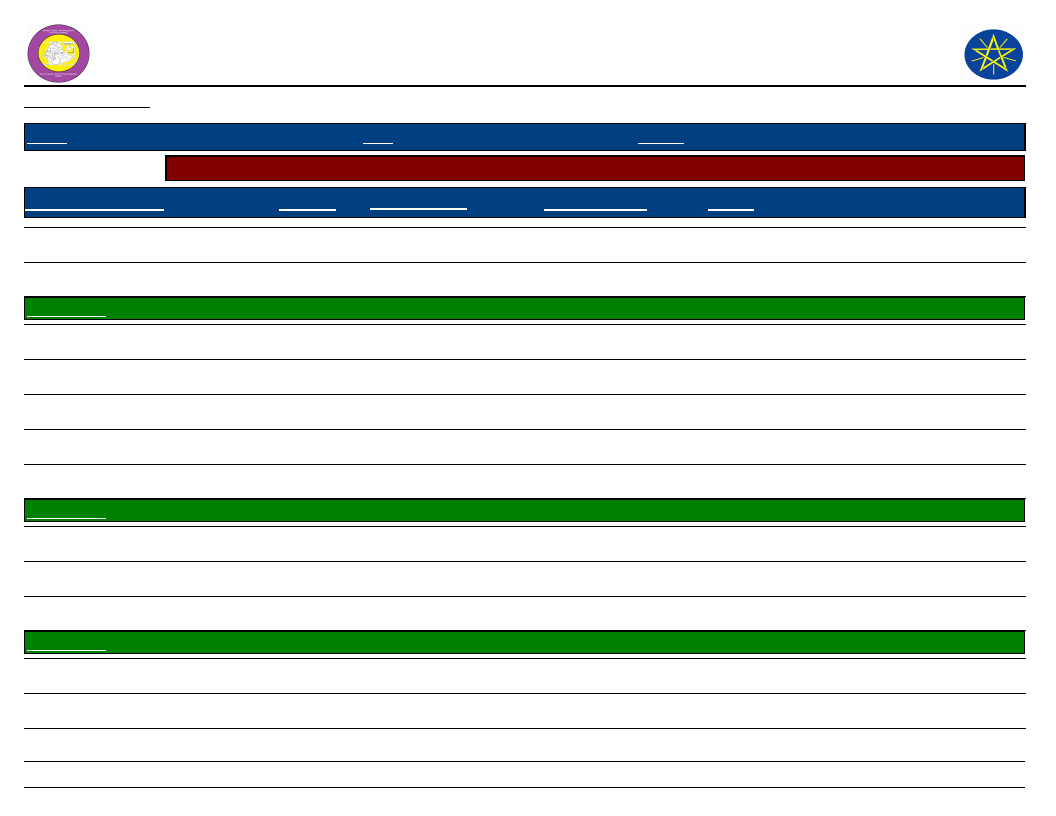
Wereda Disaster
Risk Profile
Data_Collected_Date
National Disaster Risk Management
Commission (NDRMC)
Wednesday, July 10, 2019
Region S.N.N.P
Zone GURAGE
Selected Indicator
Capacity: Community Based Organizations in the Wereda
Name_Of_Organization
Est._Year
Formal/Informal
Wereda MESKAN
Type of Members
Activity
Saving and credit association
Edir, Ekub
Kebele Name
Dado
YETABON
Lika
Equb
Edir
Saving
Kebele Name YIMERWACHO 2NYA
Saving and credit association
Edir
Ekub
Kebele Name
Edir and ekub
YIMERWACHO 3NYA
Farmers association
Women association
2003
2003
2007
2000
2008
Formal
Informal
Informal
Informal
Informal
Informal
Formal
Female
Male
Both
Both
Both
Formal
Informal
Informal
Both
Both
Both
Informal
Formal
Formal
340
Saving and credit activities
To crate better job and helping each other
Social and spiritual problems
Social and spiritual problems
Solve economical problem
Solve social and economical problems
Solve economical problem
Solve social and economic problems
Solve social and economic problems
Solve social and economic problems
Solve social problems
Selling the produce
Selling the produce
Page 10 of 11
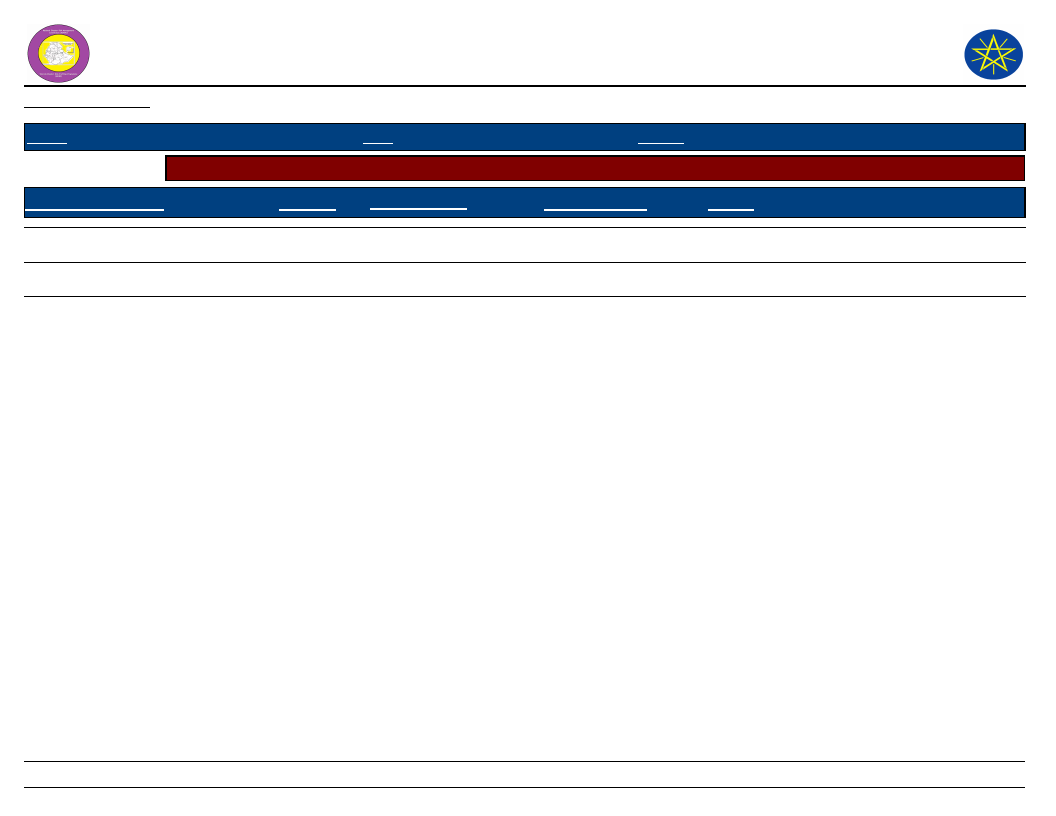
Wereda Disaster
Risk Profile
Data_Collected_Date
Region S.N.N.P
Zone GURAGE
Selected Indicator
Capacity: Community Based Organizations in the Wereda
Name_Of_Organization
Est._Year
Formal/Informal
Youth association
Farmers association
1997
2005
Formal
Formal
National Disaster Risk Management
Commission (NDRMC)
Wednesday, July 10, 2019
Wereda MESKAN
Type of Members
Activity
Selling the produce
Saving and credit activities
341
Page 11 of 11
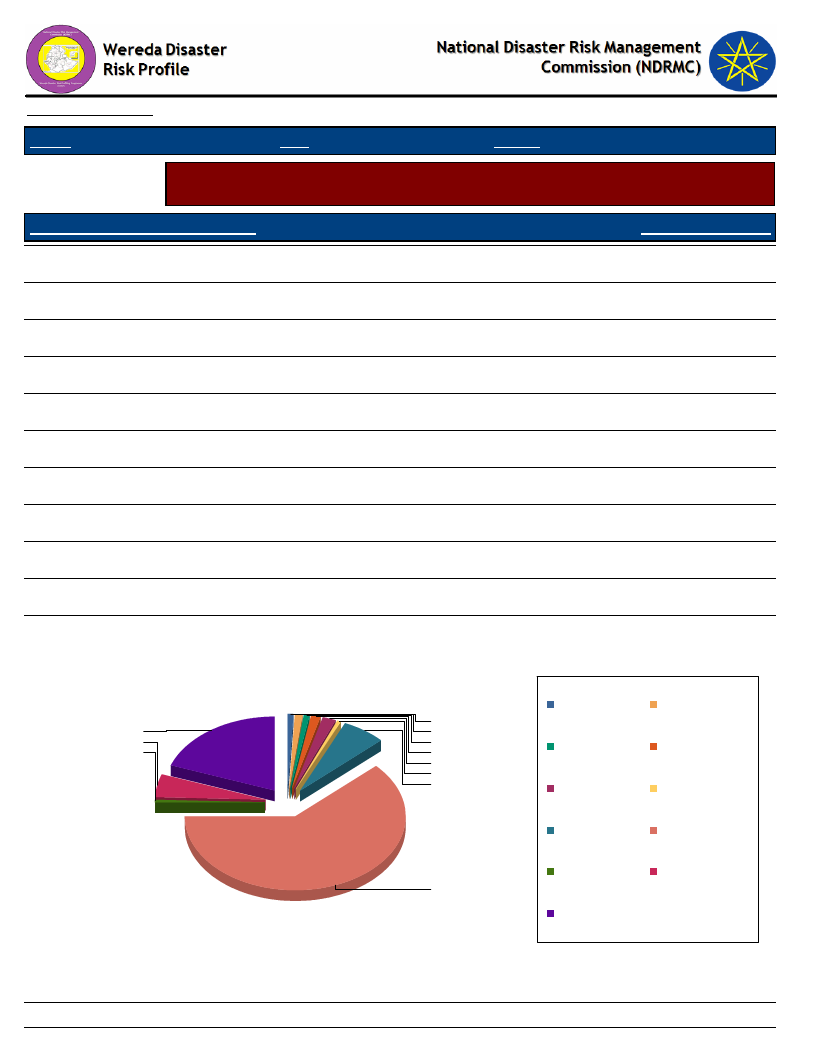
Data_Collected_Date
Region S.N.N.P
Zone GURAGE
Wereda MESKAN
Wednesday, July 10, 2019
Selected Indicator
Supporting Agencies against Disasters - Percentage of households by supporting
institutions to handle or recover from disaster damages
Supporting Agencies Against Disasters
Response_Percentage
National or local authorities
6.50
International NGOs (e.g. UN organizations, ICRC, etc.)
1.98
Local NGOs
0.56
Family members in the same community
1.13
Friends and neighbors in the same community
1.41
Family members outside the community
0.85
Support via contacts working for the authorities
19.49
Support via contacts working for NGOs
5.08
Religious sources such as the mosque
0.56
None
62.43
DK
0.85
19.5
5.1
0.6
Supporting Agencies Against Disasters
0.8
1.1
0.8
1.4
2.0
0.6
6.5
62.4
Family members in the
DK
same community
Family members outside
the community
Friends and neighbors in
the same community
International NGOs (e.g.
UN organizations, ICRC,
etc.)
Local NGOs
National or local
authorities
None
Religious sources such
as the mosque
Support via contacts
working for the
authorities
Support via contacts
working for NGOs
342
Page 1 of 1
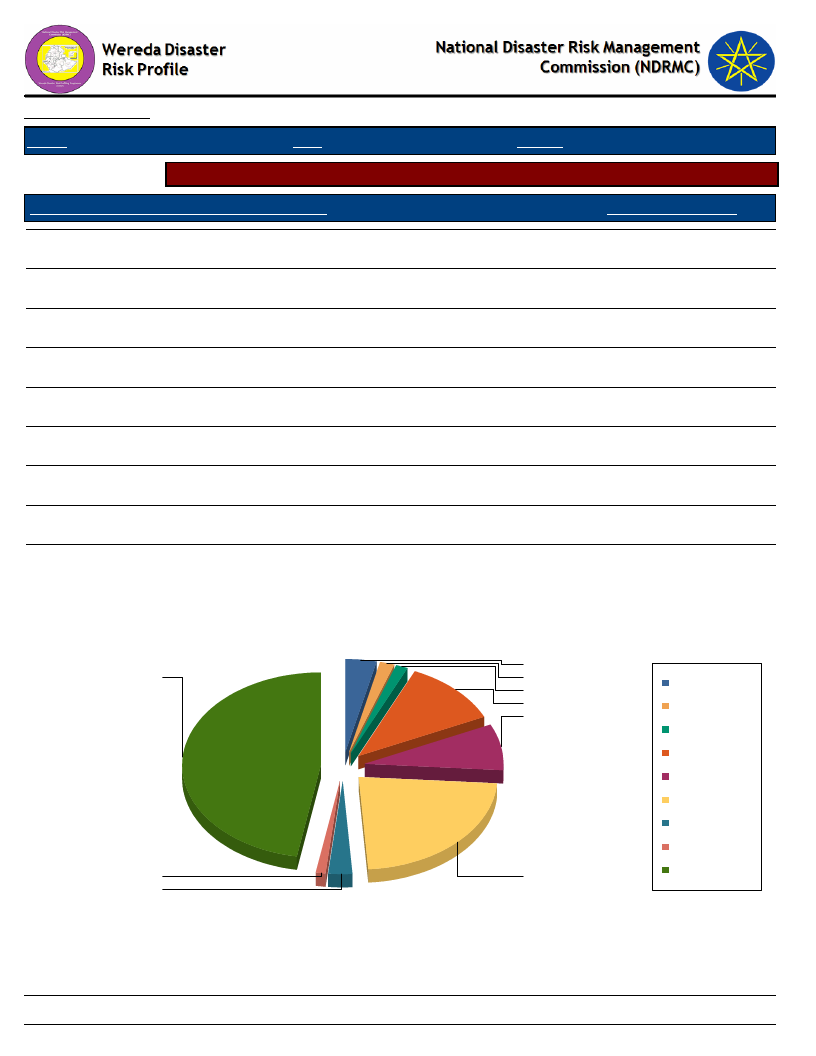
Data_Collected_Date
Region S.N.N.P
Zone GURAGE
Wednesday, July 10, 2019
Wereda MESKAN
Selected Indicator
Types of support received by households during disasters
Type of Support Provided By Supporting Agencies
Response_Percentage
Emergency aid (food, water, shelter, etc.)
22.91
Capital for re-construction of house and property
11.45
New house
1.32
Access to loan for re-construction
1.76
Access to capital or loan for adaptation/protection measures
3.52
Assets such as livestock replenishment
1.32
Other
47.14
DK
7.93
NA
2.64
Type of Support Provided By Supporting Agencies
4
47
2
Access to capital or loan
for adaptation/protection
1
measures
11
Access to loan for
re-construction
8
Assets such as livestock
replenishment
Capital for
re-construction of house
and property
DK
Emergency aid (food,
water, shelter, etc.)
NA
New house
Other
1
23
3
343
Page 1 of 1
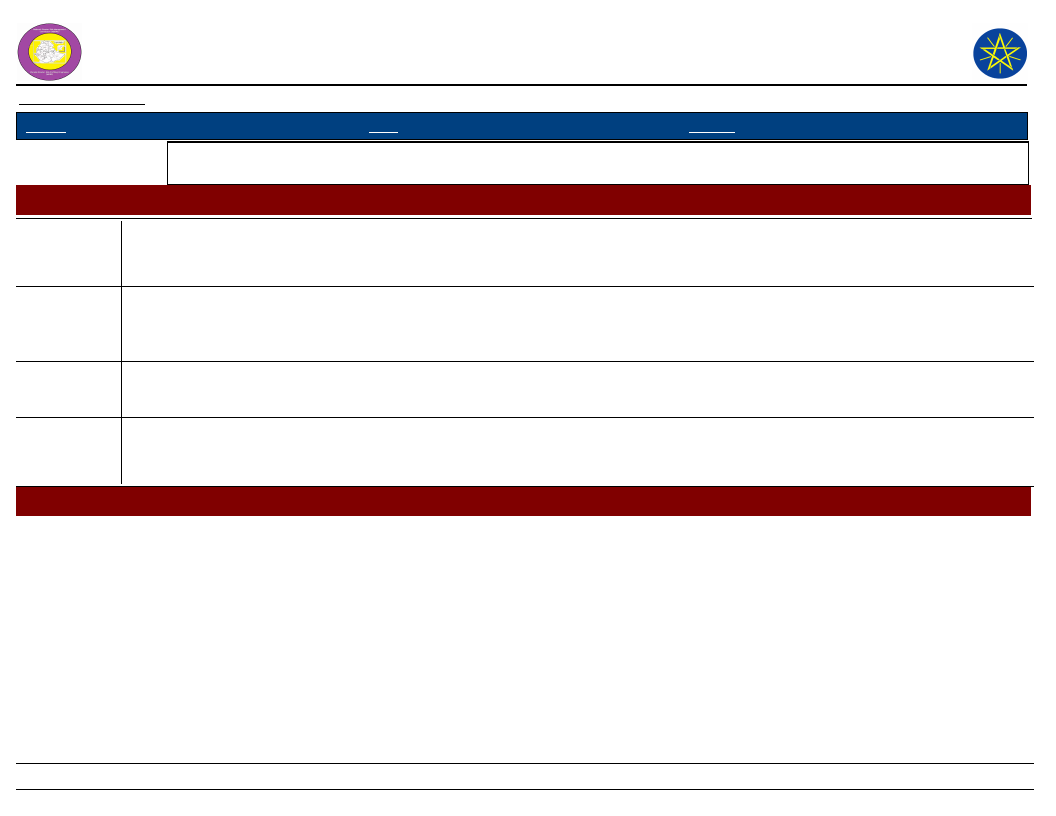
Wereda Disaster
Risk Profile
Data_Collected_Date
National Disaster Risk Management
Commission (NDRMC)
Wednesday, July 10, 2019
Region S.N.N.P
Zone GURAGE
Wereda MESKAN
Selected Indicator
Government Actors in the Field of Disaster Risk Management - Government actors and their activities in the field
of Disaster Risk Managements
Government Institution
Wereda Agriculture Office
Activity
Description
Prevention
To prevent flood effects, soil erosion, to save soil fertility, stimulate soil cover or plantation and afforestation
Activity
Preparedness
Description
Activity
Create awareness of saving and the future conservation of disaster and extends formal money saving program and practically
participated all 40 kebeles of the wereda community by the coordination of Omo micro finance
Response
Description
Activity
Description
To cope more affected communities help by food and money as their severity status
Adaptive measure relief and food for working
To recover from the effect of hazard sever support by food and food for working programs by the help of saftynet program and other
actors
Government Institution
Wereda Education Office
344
Page 1 of 3
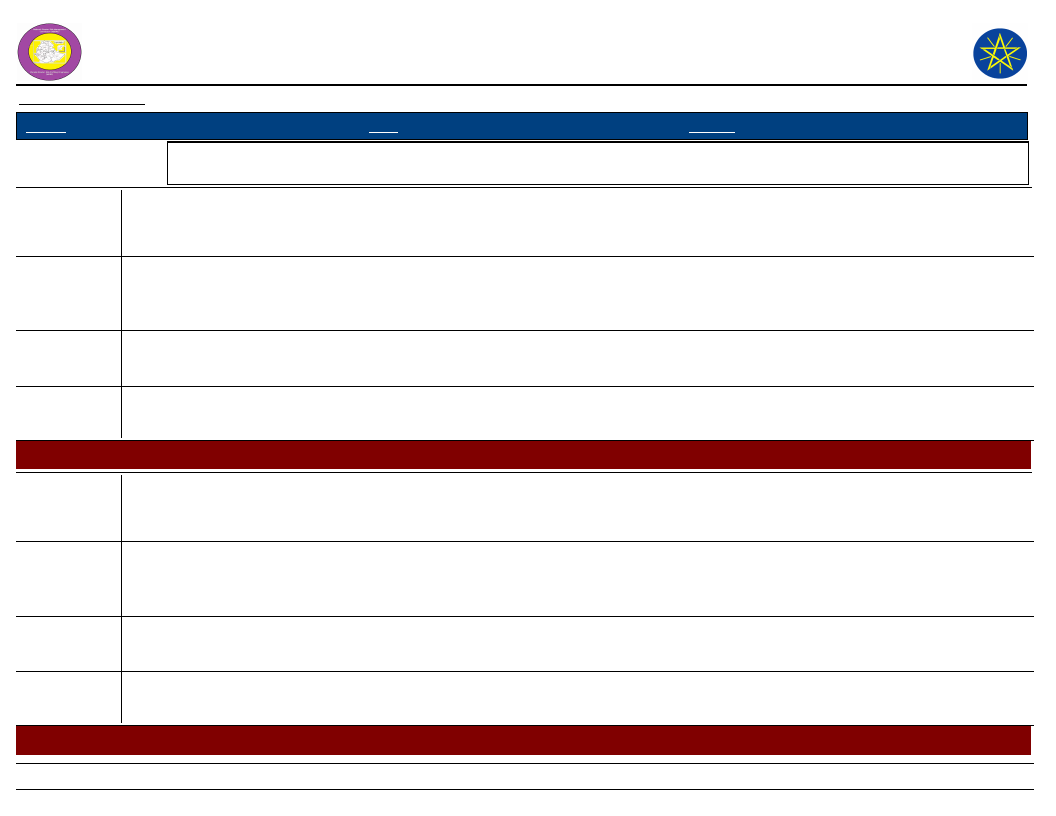
Wereda Disaster
Risk Profile
Data_Collected_Date
National Disaster Risk Management
Commission (NDRMC)
Wednesday, July 10, 2019
Region S.N.N.P
Zone GURAGE
Wereda MESKAN
Selected Indicator
Government Actors in the Field of Disaster Risk Management - Government actors and their activities in the field
of Disaster Risk Managements
Activity
Prevention awareness creation at school level, give information for students, coordination and participate in prevention measure
Description
Helps to prevents students
Activity
Description
Preparedness:- awareness creation for every schools and community levels helps to prevent onset of hazard
Enhance coordination and participations
Activity
Response: coordinate any school supports like food, teaching aids
Description
Activity
Description
Activiely participate from any school support to reduce withdrawal students dye to effect of hazards
Adaptive measure: awareness creation
To reduce socio economic problems of students and school staffs
Government Institution
Wereda Health Office
Activity
Description
Prevention
To minimize the negative effect of disaster and improved disease prevention mechanism
Activity
Description
Preparedness
To reduce the effect of disasters and control the incidence
Activity
Response
Description
Activity
Description
Reduce the effects, reduce socio economic disturbance
Adaptive measure
To minimize socio economic disturbance
Government Institution
Wereda Water Resource Development Office
345
Page 2 of 3
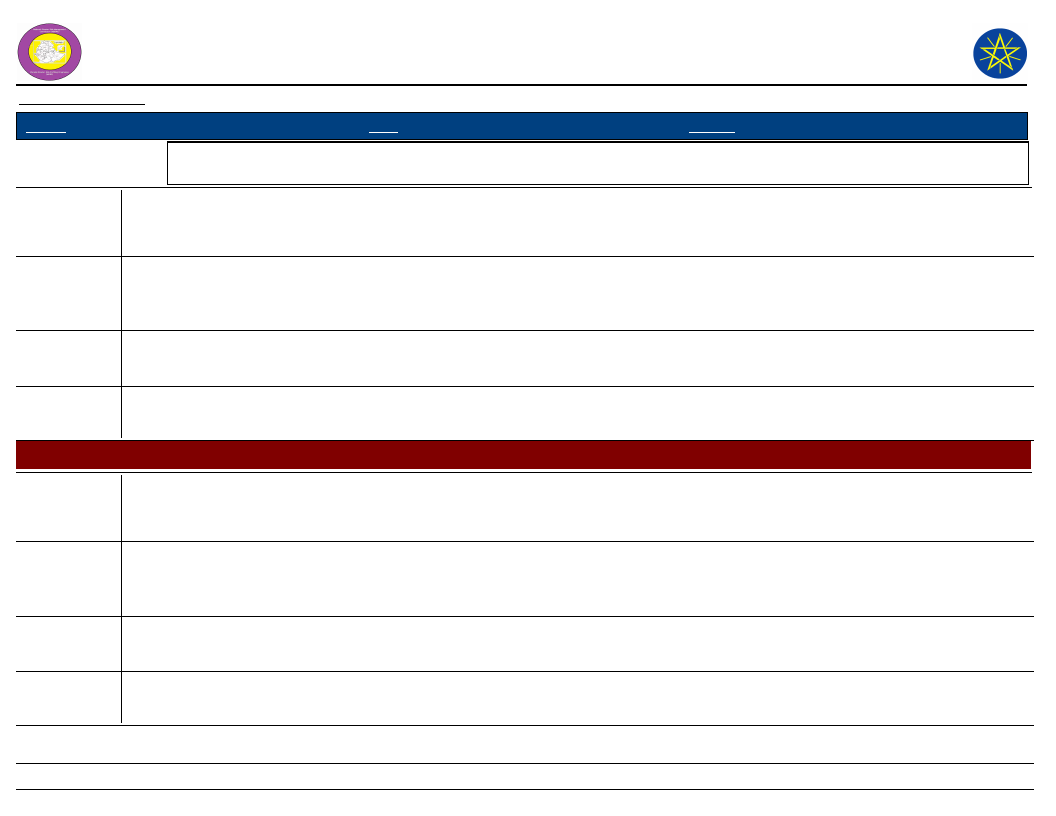
Wereda Disaster
Risk Profile
Data_Collected_Date
National Disaster Risk Management
Commission (NDRMC)
Wednesday, July 10, 2019
Region S.N.N.P
Zone GURAGE
Wereda MESKAN
Selected Indicator
Government Actors in the Field of Disaster Risk Management - Government actors and their activities in the field
of Disaster Risk Managements
Activity
Prevention, non functional water scheme to be functional
Description
To reduce shortage of water
Activity
Description
Preparedness, water treatment chemicals and non food items
Decrease water pollution and water born disease
Activity
Response, construct additional water scheme, purified chemical
Description
Activity
Description
Support non food items and chemicals
Adaptive measure, use purified chemicals, supply water from other source
Re functioned disable water organization
Government Institution
Wereda Women and Children Office
Activity
Description
Prevention:- attend the precaution of food and vaccination facilities for children and women
To prevent women and children from the effect of hazard
Activity
Description
Preparedness: awareness for every kebeles of community to help onset of hazards
With the coordination of UNICEF and safe the children and wereda management
Activity
Description
Activity
Description
Response: relief/food
By the help of UNICEF and safe the children
Adaptive measure:- organized women by saving and credit program
To recover for the future time
346
Page 3 of 3
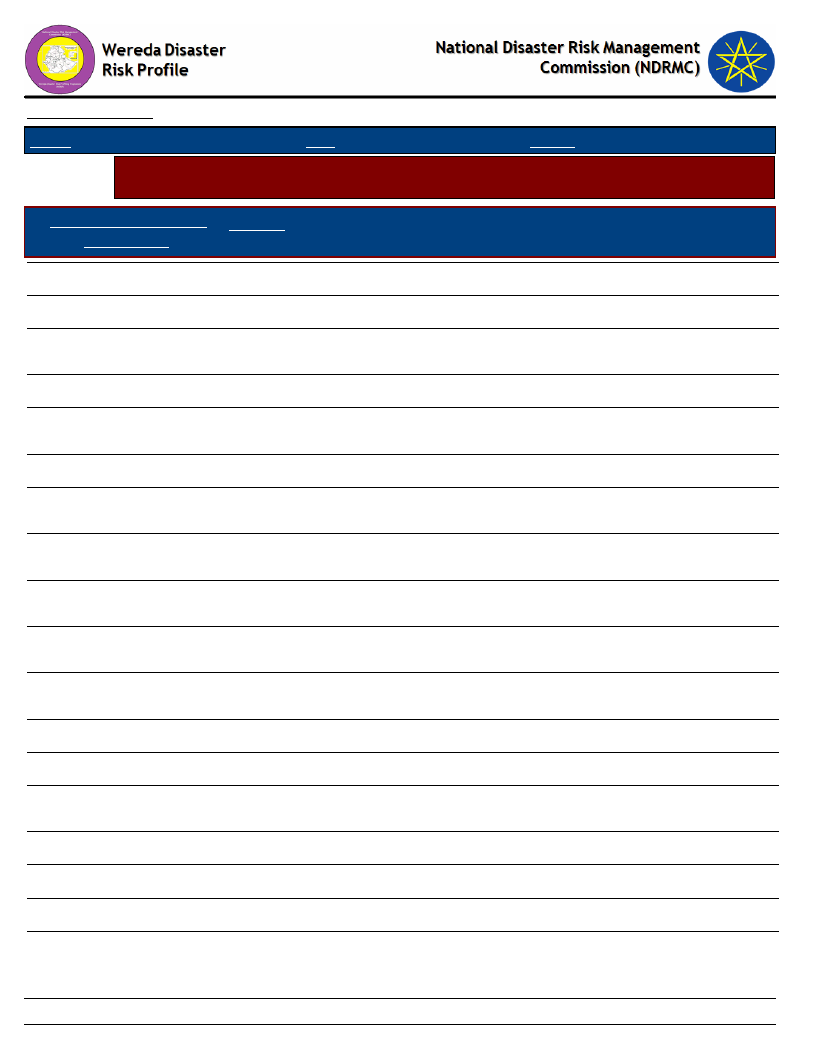
Data_Collected_Date
Wednesday, July 10, 2019
Region S.N.N.P
Zone GURAGE
Wereda MESKAN
Selected
Indicator
Non-Government Actors in the Field of Disaster Risk Management - Non-government
actors and their activities in the field of Disaster Risk Management
Non Governmental Actors
in the Wereda
Activities
MERCY CORPS
SOS Sahel Ethiopia
Help by clinical service, learning and financial support
Provide agricultural inputs and off-farm inputs
Hunger Project
Help to communities by supplying crop and livestock inputs for youth and
women group
Provide agricultural inputs
Supplying agricultural/ crop, animal and input for women and help
financially at hazard time
Provide agricultural inputs and off-farm inputs
NGO who help the communities by supplying crop seeds other facilities
before and after hazards
Who have support more selected kebeles to the development activities and
participate in hazard activities
Help the community by supplying inputs and support after hazard to
recover the community and capacity enhancement activities to experts
Provide agricultural inputs for selective farmers and saving and credit
access
NGO who help the community extending different infrastructure and help
at after hazard by supplying replaced seeds and other marital
Support foods and non food item, provide agricultural inputs
Agri Service Ethiopia
Save The Children
Provide agricultural inputs
Provide improved seed, CBNBC/community based new born child care
program/
Helping population by supplying seed and food to the community
CBNCP/community based new born child care, provide agricultural inputs
Child care and provide agricultural inputs
Supply agricultural vegetables, seed and support to children
347
Page 1 of 1
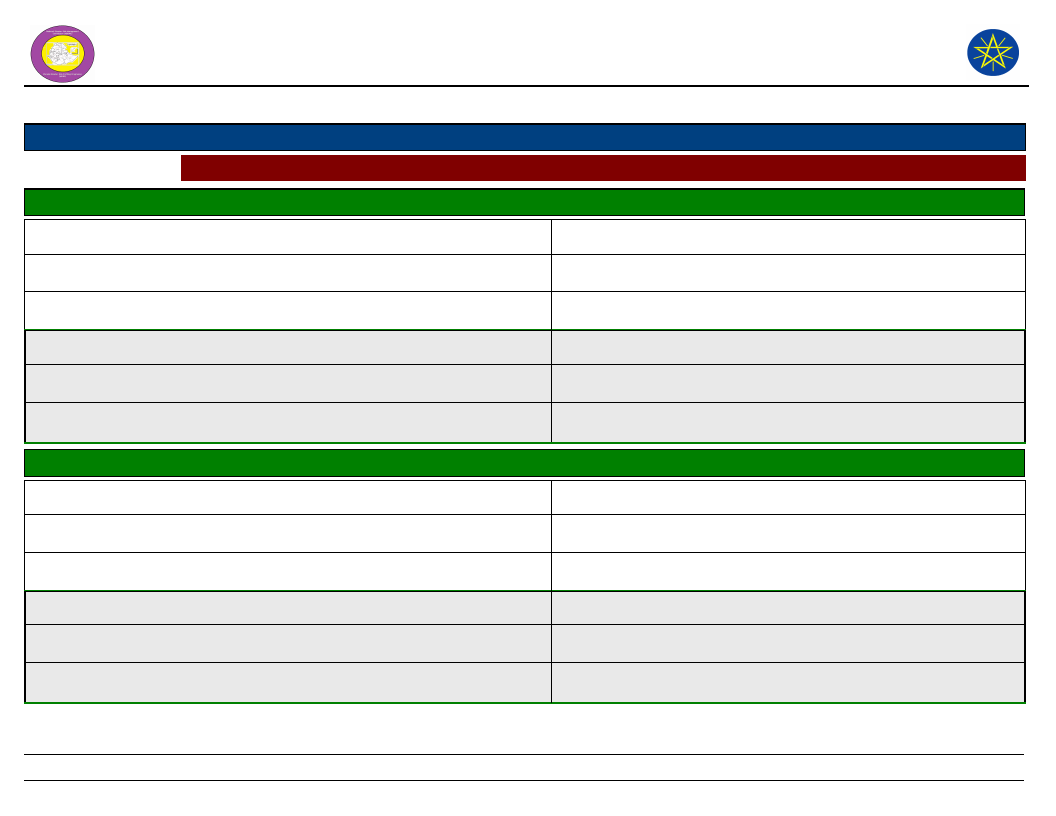
Wereda Disaster Risk
Profile
Data_Collected_Date
National Disaster Risk Management
Commission (NDRMC)
July 10, 2019
Region S.N.N.P
Selected Indicator:
Zone
GURAGE
Interventions: Community Suggestions to Development Actors
Wereda MESKAN
Kebele Name
Type Of Disaster 1
Early Warning Indicator
BATI FATO
Drought
High temperature
Type Of Disaster 3
Early Warning Indicator
Preparedness Measure
Type Of Disaster 2
Save their money
Snow/heavy rain
Preparedness Measure
Type Of Disaster 4
Early Warning Indicator
Preparedness Measure
Collect our family and livestock
Early Warning Indicator
Preparedness Measure
Kebele Name
Type Of Disaster 1
Early Warning Indicator
Preparedness Measure
Type Of Disaster 2
Early Warning Indicator
Preparedness Measure
BATI LEJANO
Drought
Erratic rain fall, strong wind, increasing
temperature
Harvesting water
Flood
Dark heavy cloud, rain at high land
Make soil bund and drainage ditch
Type Of Disaster 3
Early Warning Indicator
Preparedness Measure
Type Of Disaster 4
Early Warning Indicator
Preparedness Measure
348
Page 1 of 15
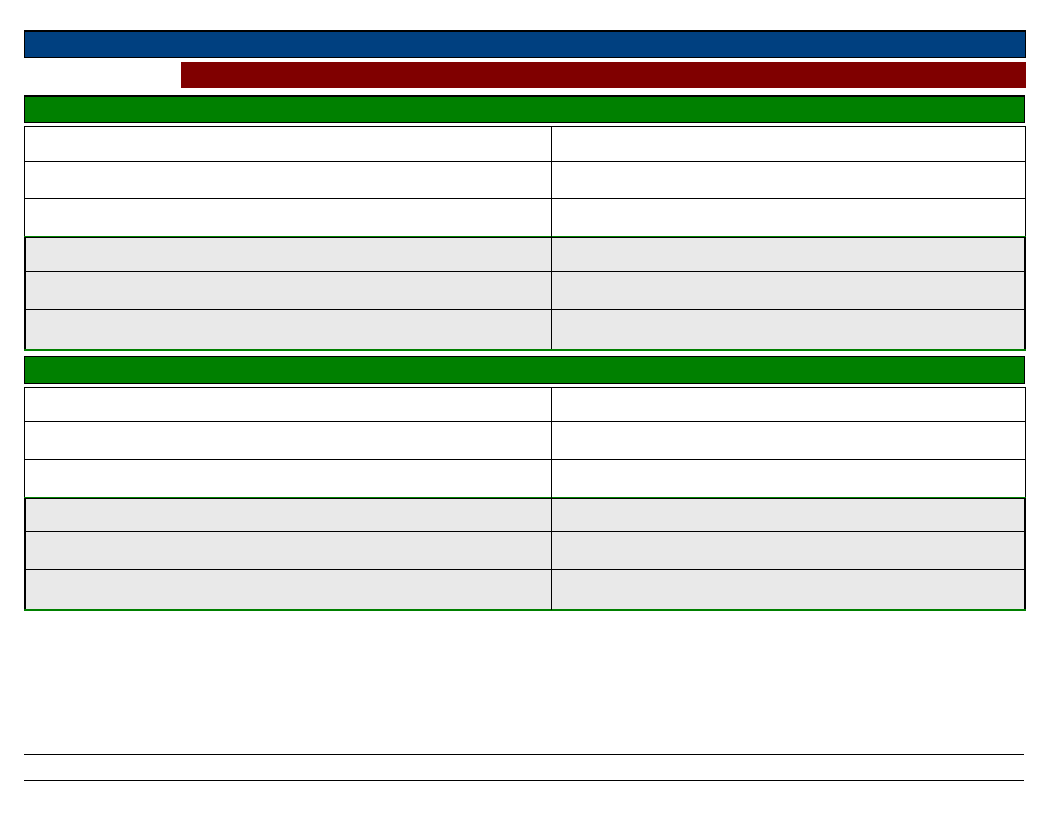
Region S.N.N.P
Selected Indicator:
Zone
GURAGE
Interventions: Community Suggestions to Development Actors
Wereda MESKAN
Kebele Name
Type Of Disaster 1
Early Warning Indicator
Preparedness Measure
BECHE BULCHANO
Drought
Shortage of rain fall, wind direction, looking
animals intestine
Saving assets, dig deep ground water
Type Of Disaster 3
Early Warning Indicator
Preparedness Measure
Type Of Disaster 2
Early Warning Indicator
Type Of Disaster 4
Early Warning Indicator
Preparedness Measure
Preparedness Measure
Kebele Name
Type Of Disaster 1
Early Warning Indicator
Preparedness Measure
Type Of Disaster 2
Early Warning Indicator
Preparedness Measure
BERESA
Drought
Shortage and erratic rain fall
Water harvest practice on the cultivated land
Flood
Very dens cloud
Settle community
Type Of Disaster 3
Early Warning Indicator
Preparedness Measure
Type Of Disaster 4
Early Warning Indicator
Preparedness Measure
349
Page 2 of 15
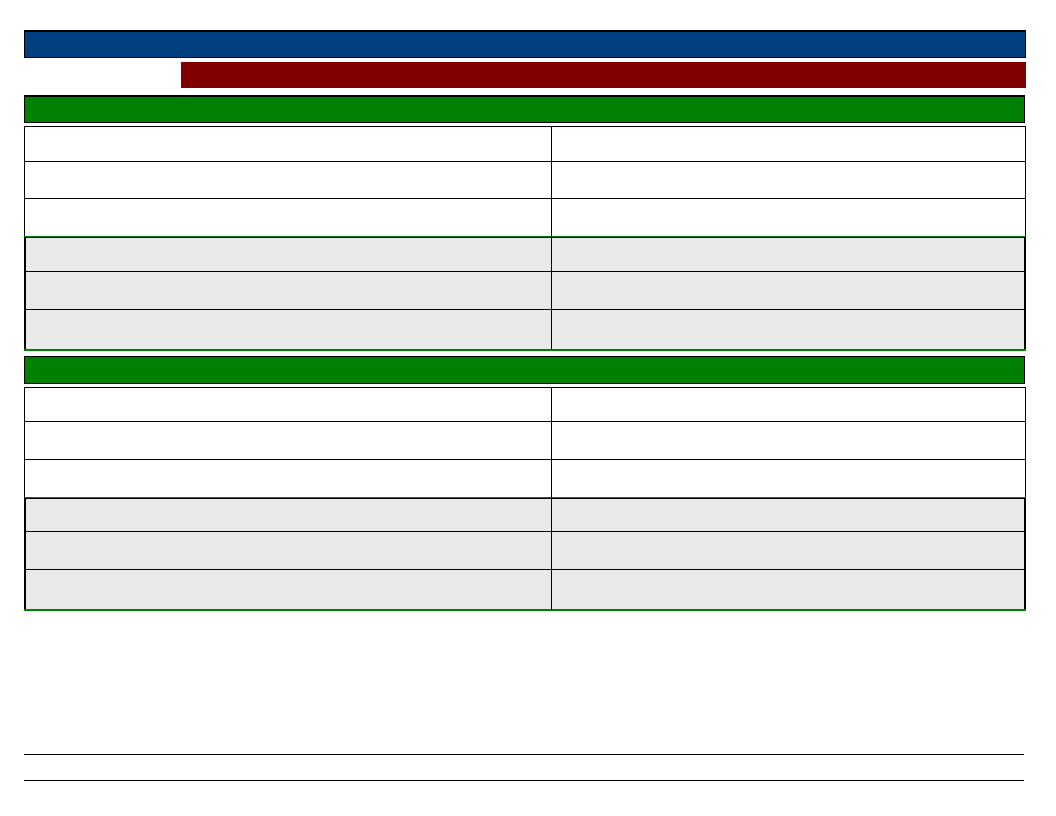
Region S.N.N.P
Selected Indicator:
Zone
GURAGE
Interventions: Community Suggestions to Development Actors
Wereda MESKAN
Kebele Name
Type Of Disaster 1
Early Warning Indicator
DEBO TUTO
Flood
Very dark cloud
Type Of Disaster 3
Early Warning Indicator
Preparedness Measure
Migration
Preparedness Measure
Type Of Disaster 2
Early Warning Indicator
Preparedness Measure
Drought
Erratic rain fall
Water harvesting practice in the cultivated land
Type Of Disaster 4
Early Warning Indicator
Preparedness Measure
Kebele Name
Type Of Disaster 1
Early Warning Indicator
Preparedness Measure
Type Of Disaster 2
Early Warning Indicator
Preparedness Measure
DEBUB SHERSHERA
Flood
Dark cloud
Collect good and children and animals
Drought
Wind direction
Save and care for asset
Type Of Disaster 3
Early Warning Indicator
Preparedness Measure
Type Of Disaster 4
Early Warning Indicator
Preparedness Measure
350
Page 3 of 15
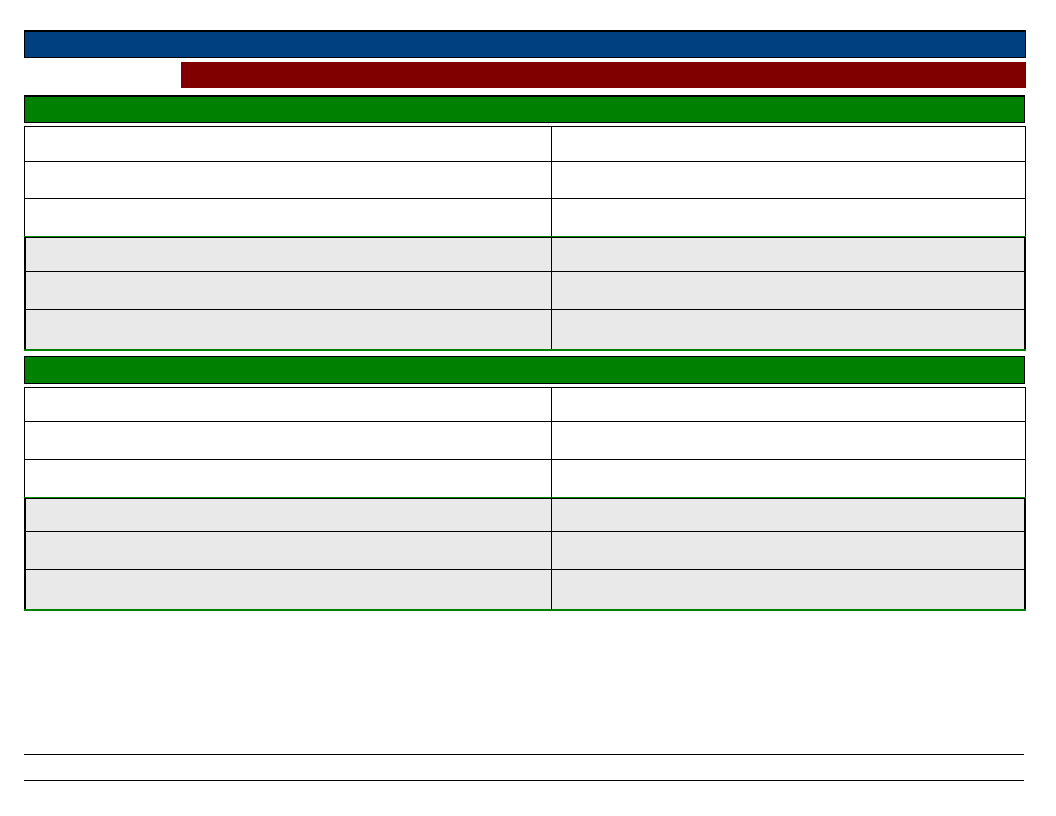
Region S.N.N.P
Selected Indicator:
Zone
GURAGE
Interventions: Community Suggestions to Development Actors
Wereda MESKAN
Kebele Name
Type Of Disaster 1
Early Warning Indicator
DEGAGOGOT
Flood
Cloud, eat wind direction
Type Of Disaster 3
Early Warning Indicator
Preparedness Measure
Care
Preparedness Measure
Type Of Disaster 2
Early Warning Indicator
Preparedness Measure
Frost
Very high cold temperature
Fumigation, watering
Type Of Disaster 4
Early Warning Indicator
Preparedness Measure
Kebele Name
Type Of Disaster 1
Early Warning Indicator
Preparedness Measure
Type Of Disaster 2
Early Warning Indicator
Preparedness Measure
DIDA
Drought
Wind direction
Saving our asset and other
Flood
Heavy rain fall, cloud
Protect our children and asset
Type Of Disaster 3
Early Warning Indicator
Preparedness Measure
Type Of Disaster 4
Early Warning Indicator
Preparedness Measure
351
Page 4 of 15
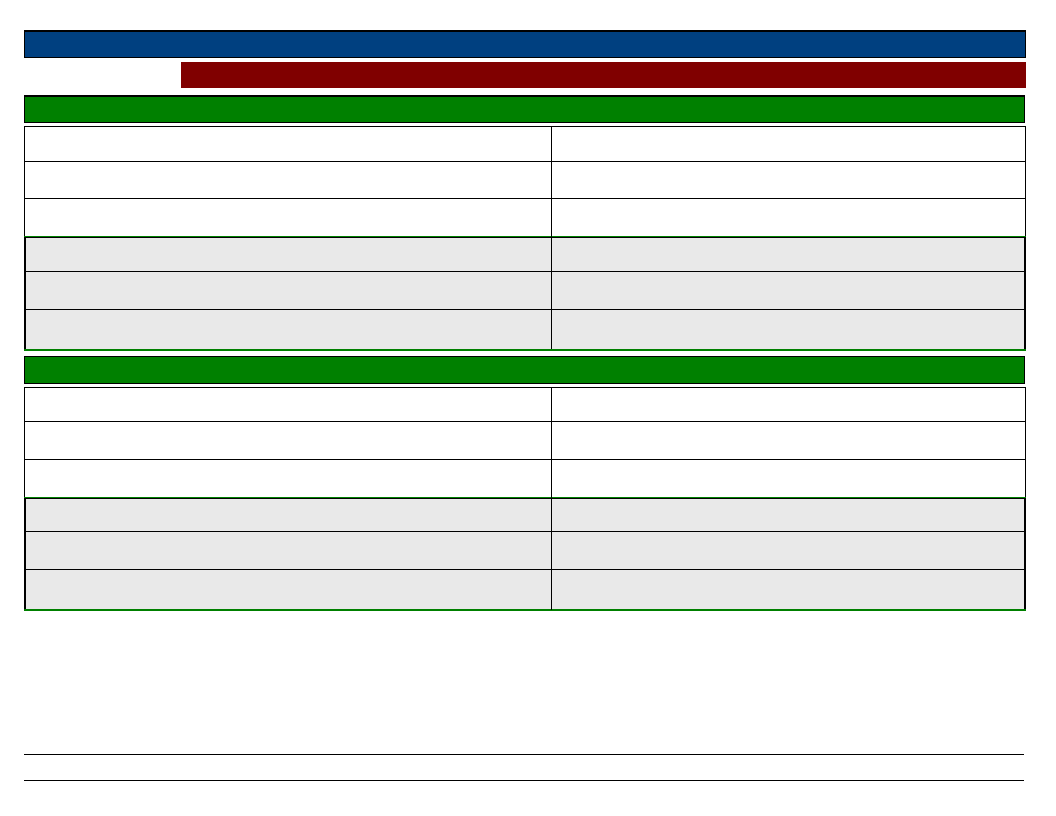
Region S.N.N.P
Selected Indicator:
Zone
GURAGE
Interventions: Community Suggestions to Development Actors
Wereda MESKAN
Kebele Name
Type Of Disaster 1
Early Warning Indicator
Preparedness Measure
DIRAMA
Livestock disease
Drought
Medical treatment, vaccination
Type Of Disaster 3
Early Warning Indicator
Preparedness Measure
Human disease
Drought
Saving money, medical treatment
Type Of Disaster 2
Early Warning Indicator
Preparedness Measure
Flood
Heavy rain, high wind, increasing temperature
Make flood diversion ditch
Type Of Disaster 4
Early Warning Indicator
Preparedness Measure
Kebele Name
Type Of Disaster 1
Early Warning Indicator
Preparedness Measure
Type Of Disaster 2
Early Warning Indicator
Preparedness Measure
DOBENA
Drought
Scattered could
Saving food, money and change assets
Type Of Disaster 3
Early Warning Indicator
Preparedness Measure
Type Of Disaster 4
Early Warning Indicator
Preparedness Measure
352
Page 5 of 15
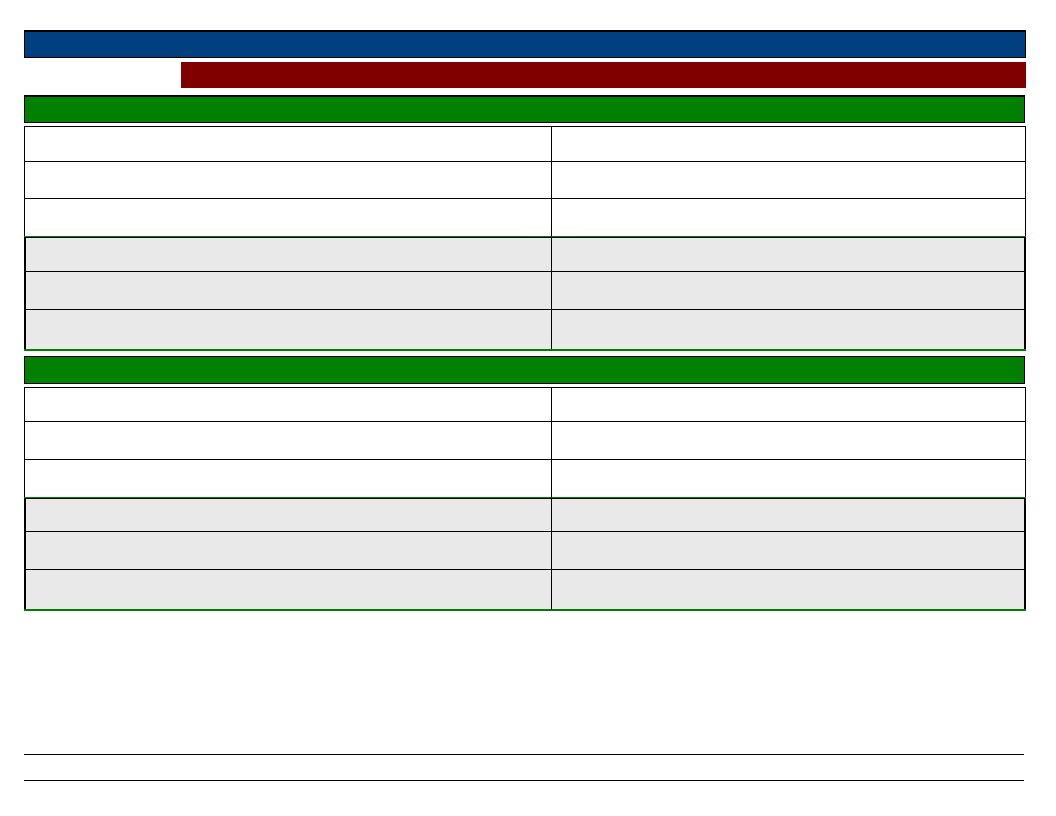
Region S.N.N.P
Selected Indicator:
Zone
GURAGE
Interventions: Community Suggestions to Development Actors
Wereda MESKAN
Kebele Name
Type Of Disaster 1
Early Warning Indicator
GIDENA ABORAT
Frost
Extending of begging or rain
Type Of Disaster 3
Early Warning Indicator
Flood
High amount of rain
Preparedness Measure
Type Of Disaster 2
Early Warning Indicator
Livestock disease
Disease and death of livestock
Preparedness Measure
Type Of Disaster 4
Early Warning Indicator
Drought
Shortage of rain fall
Preparedness Measure
Preparedness Measure
Kebele Name
Type Of Disaster 1
Early Warning Indicator
Preparedness Measure
Type Of Disaster 2
Early Warning Indicator
Preparedness Measure
GOYBAN
Flood
High rain fall, tender and increasing temperature
Collect children, elders and assets to protect
Drought
Erratic rain fall
Saving crops, sowing early mature crops
Type Of Disaster 3
Early Warning Indicator
Preparedness Measure
Type Of Disaster 4
Early Warning Indicator
Preparedness Measure
353
Page 6 of 15
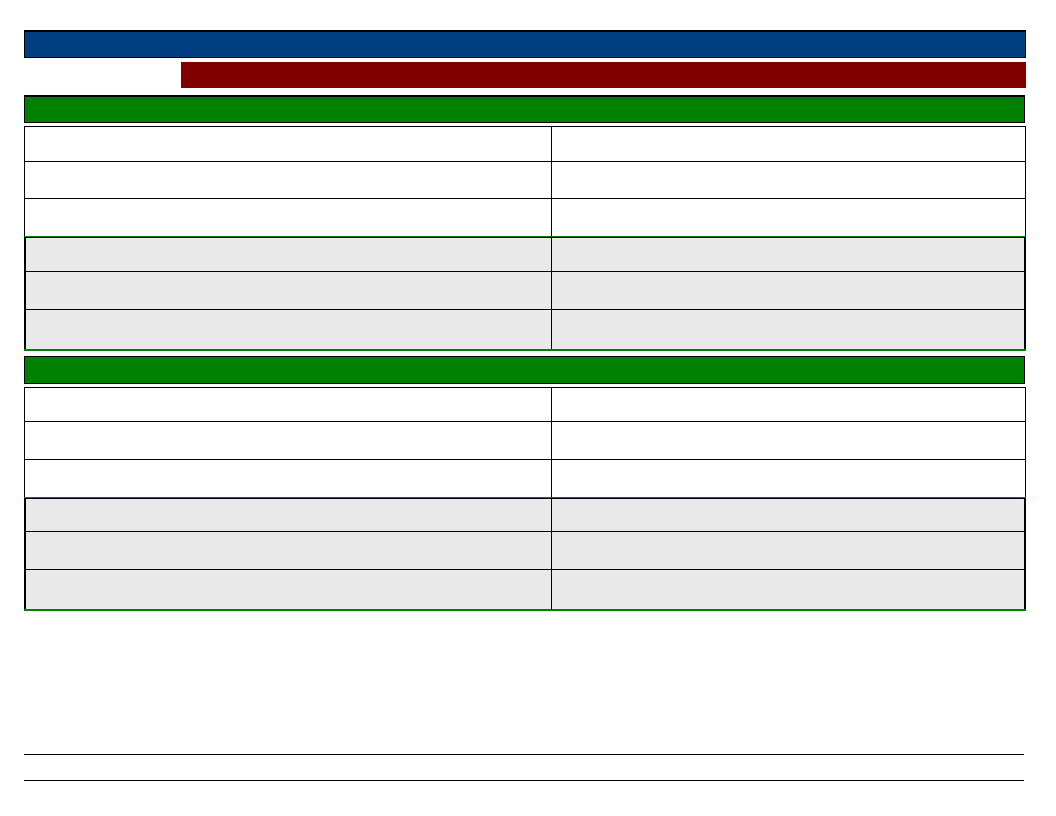
Region S.N.N.P
Selected Indicator:
Zone
GURAGE
Interventions: Community Suggestions to Development Actors
Wereda MESKAN
Kebele Name
Type Of Disaster 1
Early Warning Indicator
ILE
Flood
Cloud accumulation, rain at high land
Type Of Disaster 3
Early Warning Indicator
Preparedness Measure
Ready to make soil bund, drainage ditch
Preparedness Measure
Type Of Disaster 2
Early Warning Indicator
Preparedness Measure
Drought
High temperature, iritic rain fall
Harvesting water
Type Of Disaster 4
Early Warning Indicator
Preparedness Measure
Kebele Name
Type Of Disaster 1
Early Warning Indicator
Preparedness Measure
Type Of Disaster 2
Early Warning Indicator
Preparedness Measure
INSENO USME
Drought
Erratic rain fall, strong wind and hot weather
Harvesting water form any source
Livestock disease
Long dry season, shortage of forage
Submit reports to veterinary clinic, plant dry
types of forage species
Type Of Disaster 3
Early Warning Indicator
Preparedness Measure
Type Of Disaster 4
Early Warning Indicator
Preparedness Measure
354
Page 7 of 15
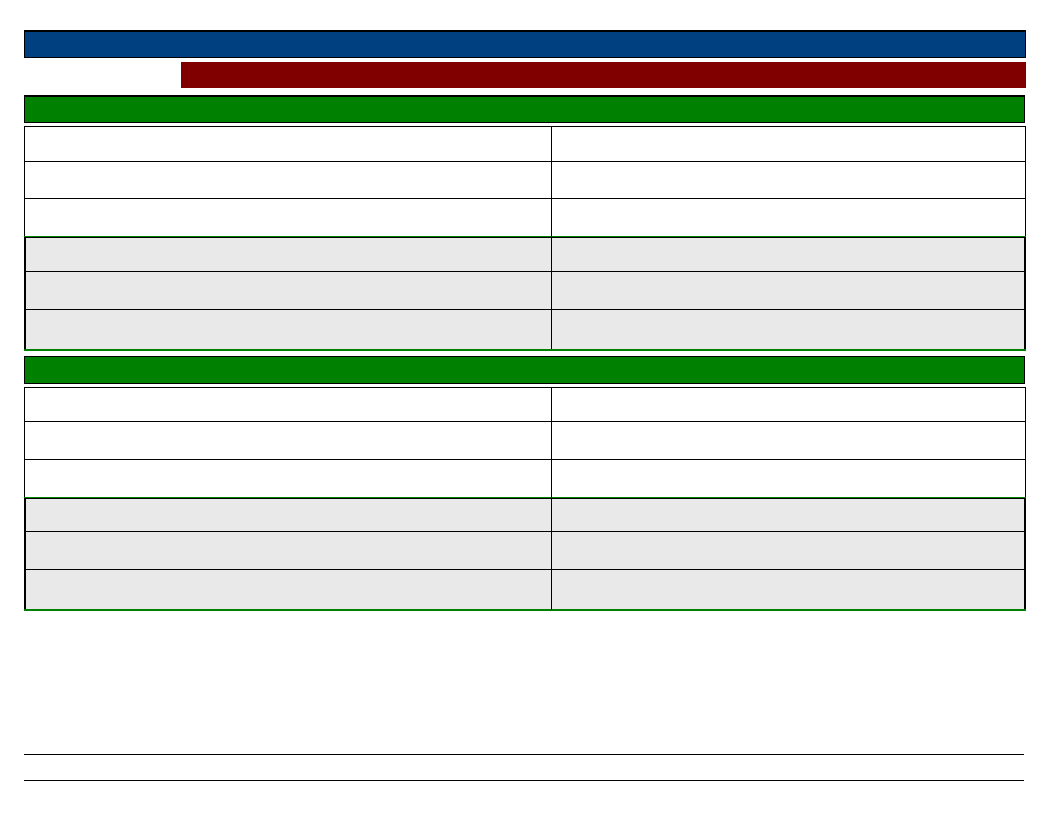
Region S.N.N.P
Selected Indicator:
Zone
GURAGE
Interventions: Community Suggestions to Development Actors
Wereda MESKAN
Kebele Name
Type Of Disaster 1
Early Warning Indicator
JOLE ANDENYA
Flood
Cloud accumulation
Type Of Disaster 3
Early Warning Indicator
Preparedness Measure
Type Of Disaster 2
Early Warning Indicator
Preparedness Measure
Gabion construction, soil and stone bund
contraction
Drought
Shortage of rain fall, high temperature
Water harvest techniques
Preparedness Measure
Type Of Disaster 4
Early Warning Indicator
Preparedness Measure
Kebele Name
Type Of Disaster 1
Early Warning Indicator
Preparedness Measure
Type Of Disaster 2
Early Warning Indicator
Preparedness Measure
JOLE HULETENYA
Snow
Cloud
Drought
Shortage of rain fall
Ready seed and land to sow
Type Of Disaster 3
Early Warning Indicator
Preparedness Measure
Type Of Disaster 4
Early Warning Indicator
Preparedness Measure
355
Page 8 of 15
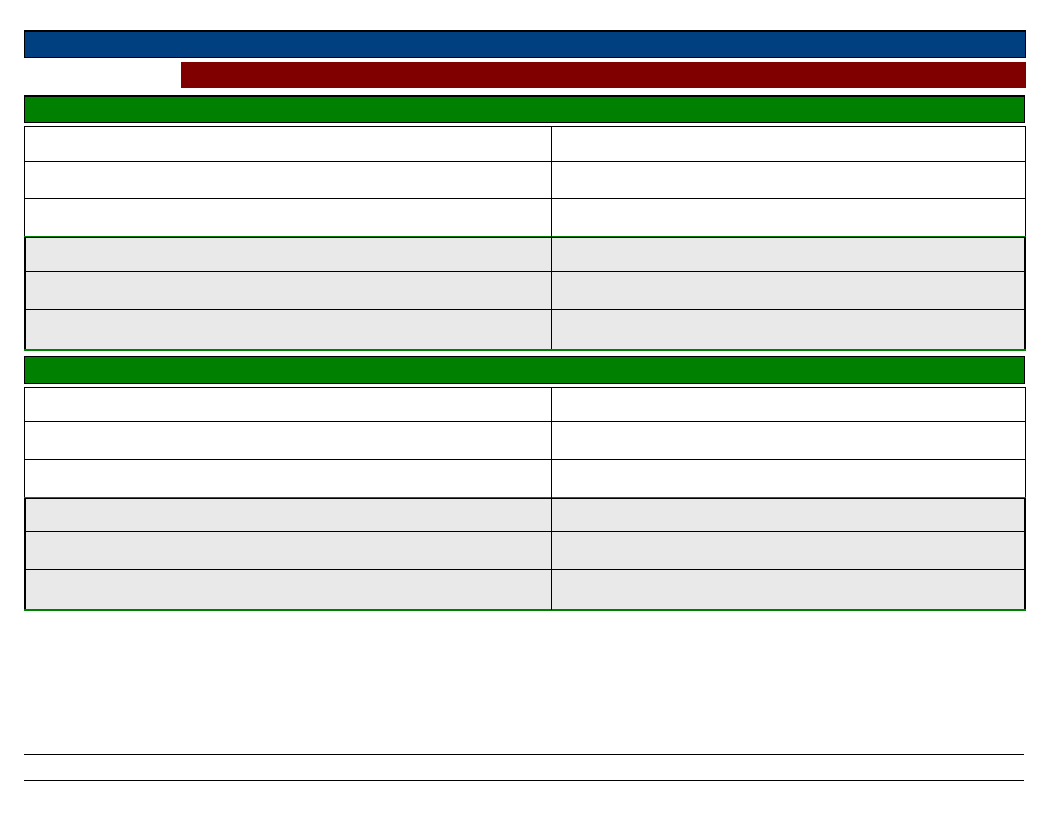
Region S.N.N.P
Selected Indicator:
Zone
GURAGE
Interventions: Community Suggestions to Development Actors
Wereda MESKAN
Kebele Name
Type Of Disaster 1
Early Warning Indicator
MEKICHO
Snow
Cloud
Type Of Disaster 3
Early Warning Indicator
Preparedness Measure
Collect children and asset
Preparedness Measure
Type Of Disaster 2
Early Warning Indicator
Type Of Disaster 4
Early Warning Indicator
Preparedness Measure
Preparedness Measure
Kebele Name
Type Of Disaster 1
Early Warning Indicator
Preparedness Measure
Type Of Disaster 2
Early Warning Indicator
Preparedness Measure
MESERETEWEGERAMO
Flood
High rain fall starting in the near high land
Ready to proper water
Snow
Highly block cloud
No preparedness
Type Of Disaster 3
Early Warning Indicator
Preparedness Measure
Type Of Disaster 4
Early Warning Indicator
Preparedness Measure
356
Page 9 of 15
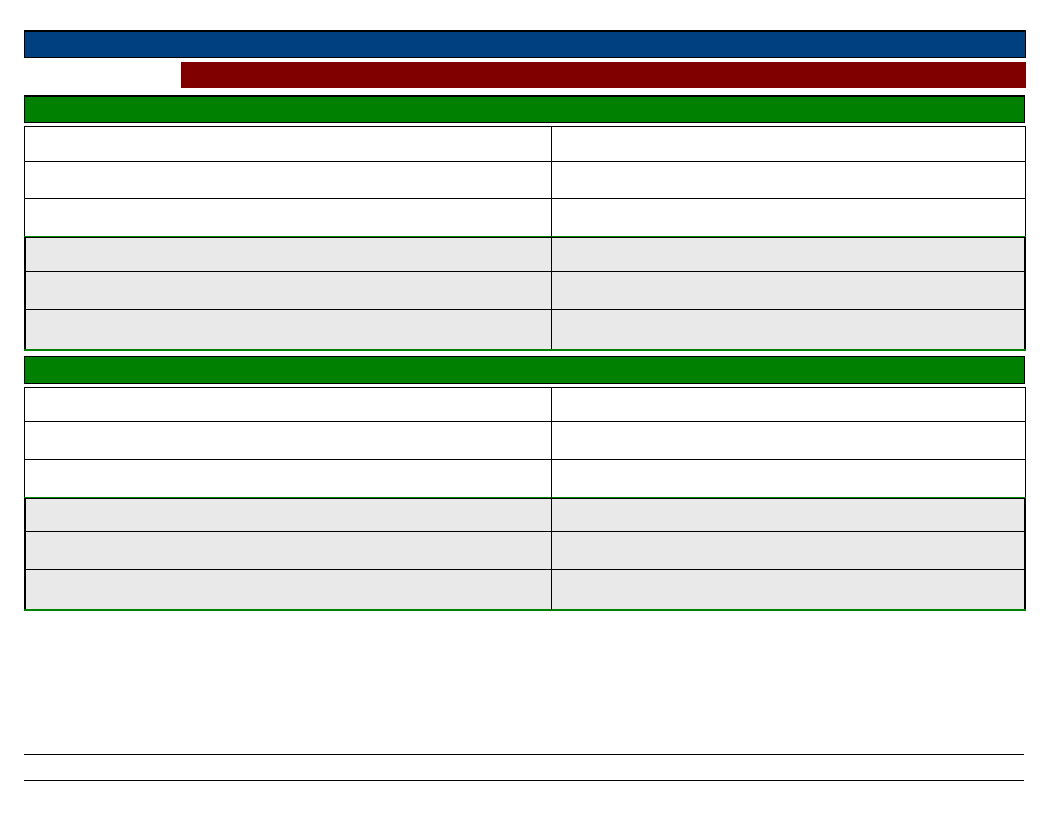
Region S.N.N.P
Selected Indicator:
Zone
GURAGE
Interventions: Community Suggestions to Development Actors
Wereda MESKAN
Kebele Name
Type Of Disaster 1
Early Warning Indicator
MIKAELO
Flood
Cloud, strong and heavy rain fall
Type Of Disaster 3
Early Warning Indicator
Preparedness Measure
Type Of Disaster 2
Ready to take any measure, resettlement of
community
Preparedness Measure
Type Of Disaster 4
Early Warning Indicator
Early Warning Indicator
Preparedness Measure
Preparedness Measure
Kebele Name
Type Of Disaster 1
Early Warning Indicator
Preparedness Measure
Type Of Disaster 2
Early Warning Indicator
Preparedness Measure
MIRAB IMBOR
Flood
Heavy rain fall
Gather livestock, children and asset
Human disease
Very less rain with wind
Vaccination, ready with finance
Type Of Disaster 3
Early Warning Indicator
Preparedness Measure
Type Of Disaster 4
Early Warning Indicator
Preparedness Measure
357
Page 10 of 15
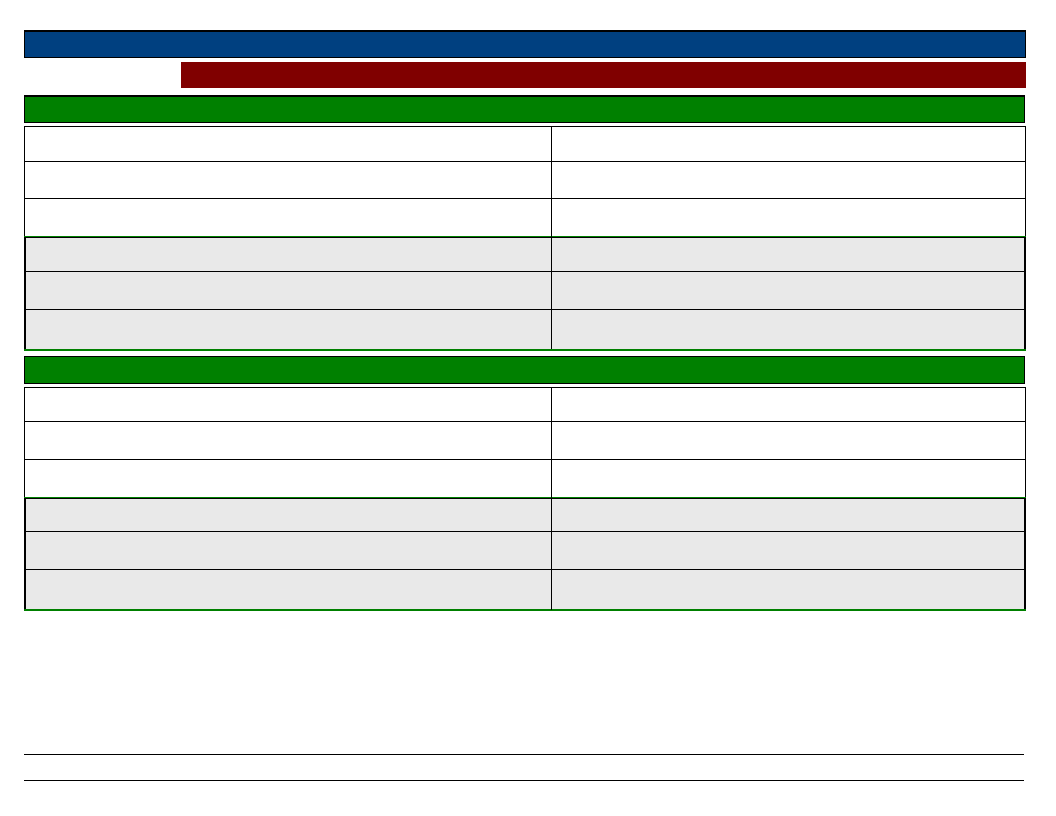
Region S.N.N.P
Selected Indicator:
Zone
GURAGE
Interventions: Community Suggestions to Development Actors
Wereda MESKAN
Kebele Name
Type Of Disaster 1
Early Warning Indicator
MIRAB MESKAN
Flood
Heavy rain fall, hot temperature
Type Of Disaster 3
Early Warning Indicator
Hail storm
Cloud change to white
Preparedness Measure
Gather asset and families
Preparedness Measure
Type Of Disaster 2
Early Warning Indicator
Preparedness Measure
Drought
Wind direction, wind moisture, shortage of rain
fall
Save food and feed and ground water
Type Of Disaster 4
Early Warning Indicator
Preparedness Measure
Kebele Name
Type Of Disaster 1
Early Warning Indicator
Preparedness Measure
Type Of Disaster 2
Early Warning Indicator
Preparedness Measure
OCHAGENEME
Drought
High temperature, wind direction
Harvest rain water and run off
Flood
Tender, dark cloud, high sunshine
Prepare soil bund to minimize the disaster
Type Of Disaster 3
Early Warning Indicator
Preparedness Measure
Type Of Disaster 4
Early Warning Indicator
Preparedness Measure
358
Page 11 of 15
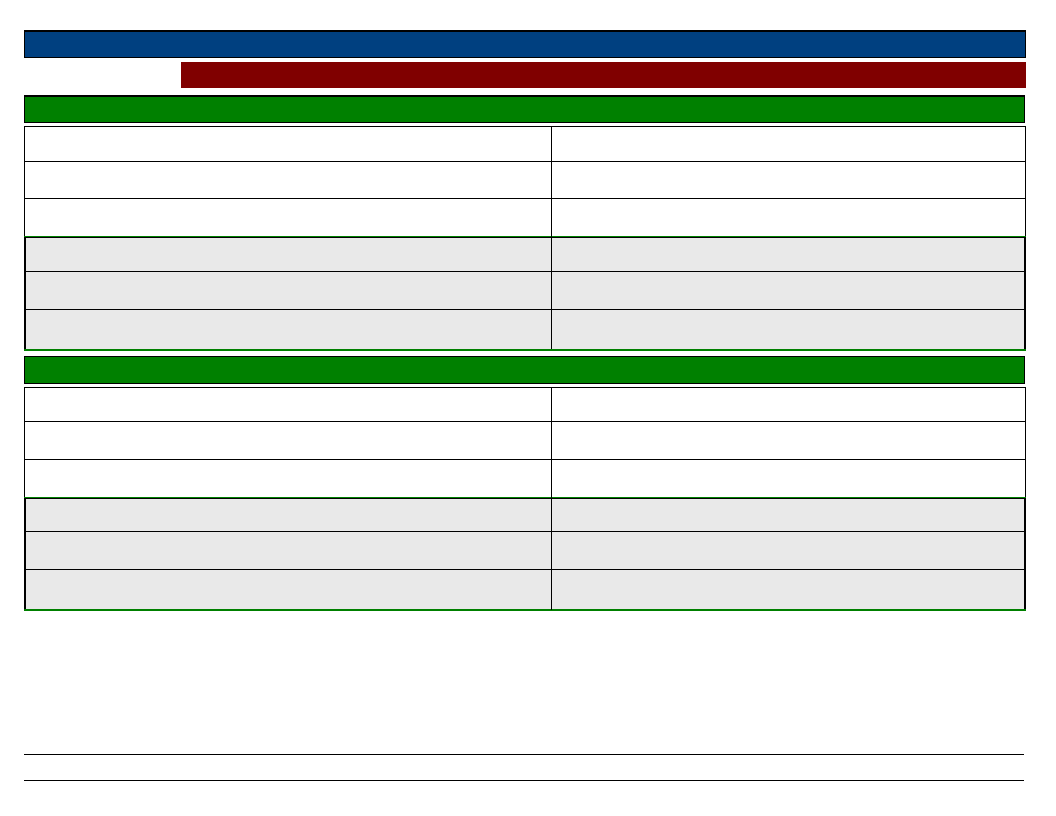
Region S.N.N.P
Selected Indicator:
Zone
GURAGE
Interventions: Community Suggestions to Development Actors
Wereda MESKAN
Kebele Name
Type Of Disaster 1
Early Warning Indicator
Preparedness Measure
SEMEN SHORSHORA
Flood
Heavy rain fall, high cloud, wind direction, bird
sound
Soil and water conservation, dam construction
Type Of Disaster 3
Early Warning Indicator
Preparedness Measure
Type Of Disaster 2
Early Warning Indicator
Type Of Disaster 4
Early Warning Indicator
Preparedness Measure
Preparedness Measure
Kebele Name
Type Of Disaster 1
Early Warning Indicator
Preparedness Measure
Type Of Disaster 2
Early Warning Indicator
Preparedness Measure
SHERSHERA MACHMENA
Flood
Topography
Soil and water conservation
Water pollution
Climate change
Planting forest plant, resistant plant
Type Of Disaster 3
Early Warning Indicator
Preparedness Measure
Type Of Disaster 4
Early Warning Indicator
Preparedness Measure
359
Page 12 of 15
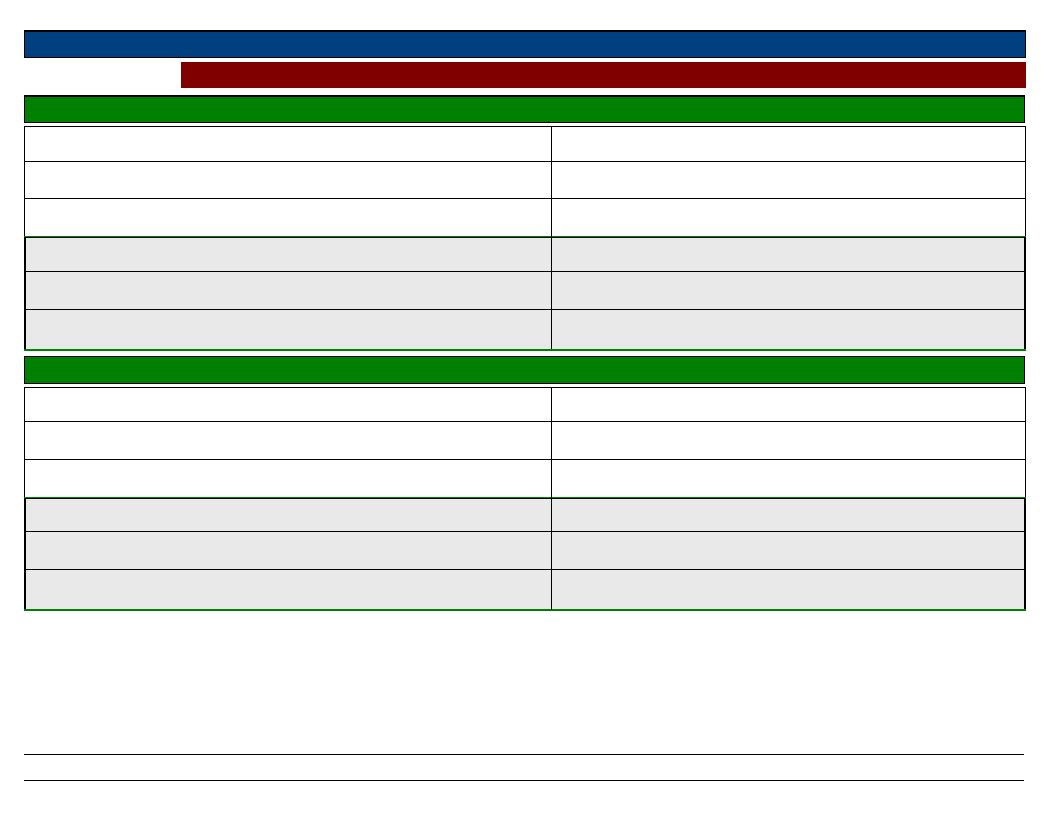
Region S.N.N.P
Selected Indicator:
Zone
GURAGE
Interventions: Community Suggestions to Development Actors
Wereda MESKAN
Kebele Name
Type Of Disaster 1
Early Warning Indicator
WEJABATI
Drought
High temperature and wind, erratic rainfall
Type Of Disaster 3
Early Warning Indicator
Preparedness Measure
Water harvesting in cultivated land
Preparedness Measure
Type Of Disaster 2
Early Warning Indicator
Preparedness Measure
Crop disease and pest
Let starting rain fall and let time of sowing
Crop rotation, timely sowing proper weeding
Type Of Disaster 4
Early Warning Indicator
Preparedness Measure
Kebele Name
Type Of Disaster 1
Early Warning Indicator
Preparedness Measure
Type Of Disaster 2
Early Warning Indicator
Preparedness Measure
WITA
Drought
Un balance rain fall distribution
Water harvest to increase soil moisture
Flood
Could accumulate
Construction of soil bund, construction of gabion
and ditch
Type Of Disaster 3
Early Warning Indicator
Preparedness Measure
Type Of Disaster 4
Early Warning Indicator
Preparedness Measure
360
Page 13 of 15
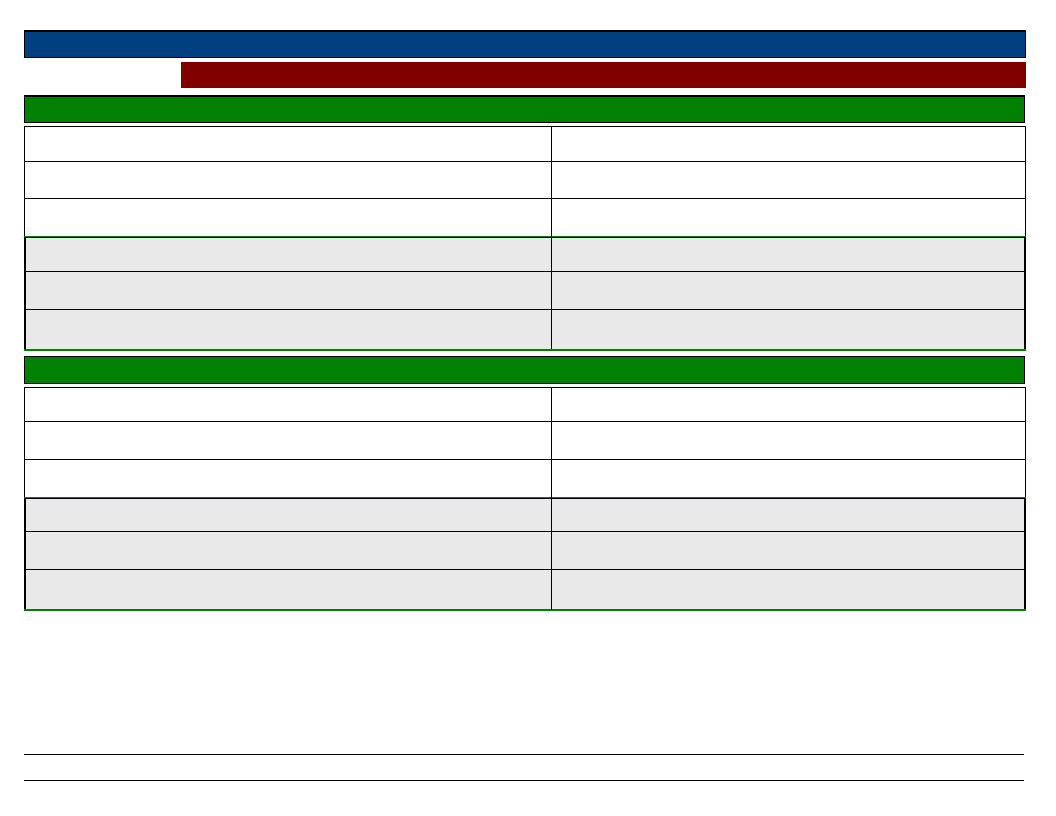
Region S.N.N.P
Selected Indicator:
Zone
GURAGE
Interventions: Community Suggestions to Development Actors
Wereda MESKAN
Kebele Name
Type Of Disaster 1
Early Warning Indicator
WOLENSHO ANDENYA
Flood
High rain fall, cloud
Type Of Disaster 3
Early Warning Indicator
Preparedness Measure
Type Of Disaster 2
Early Warning Indicator
Preparedness Measure
Shortage of rain fall/drought
The direction of wind
Water harvesting
Preparedness Measure
Type Of Disaster 4
Early Warning Indicator
Preparedness Measure
Kebele Name
Type Of Disaster 1
Early Warning Indicator
Preparedness Measure
Type Of Disaster 2
Early Warning Indicator
Preparedness Measure
YETABON
Snow
White cloud
Collect asset and crops
Drought
Shortage of rain fall, wind direction
Saving our food and asset
Type Of Disaster 3
Early Warning Indicator
Preparedness Measure
Type Of Disaster 4
Early Warning Indicator
Preparedness Measure
361
Page 14 of 15
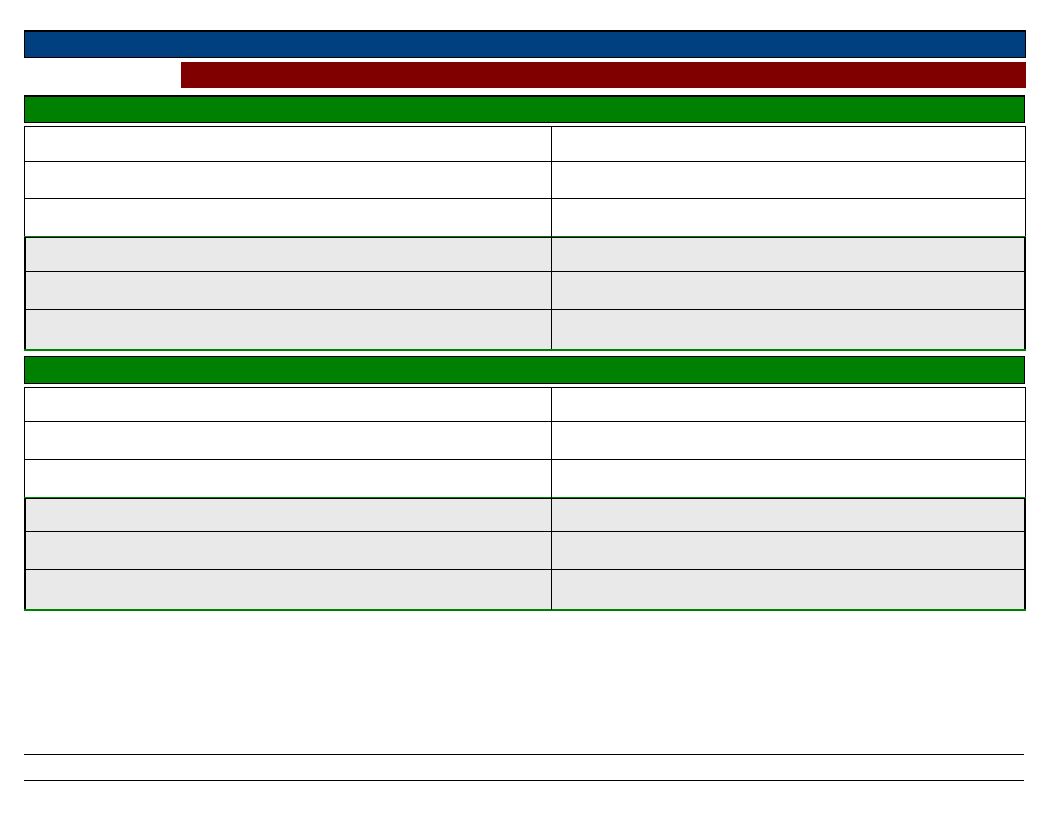
Region S.N.N.P
Selected Indicator:
Zone
GURAGE
Interventions: Community Suggestions to Development Actors
Wereda MESKAN
Kebele Name
Type Of Disaster 1
Early Warning Indicator
Preparedness Measure
Type Of Disaster 2
Early Warning Indicator
Preparedness Measure
YIMERWACHO 2NYA
Flood
Heavy rain, hot temperature
Construction of bund to control flood
Drought
Climate change
Dig deep ground water
Type Of Disaster 3
Early Warning Indicator
Preparedness Measure
Type Of Disaster 4
Early Warning Indicator
Preparedness Measure
Human and livestock disease
Drought and flood
Medical treatment, vaccination and work
diversion activities
Kebele Name
Type Of Disaster 1
Early Warning Indicator
Preparedness Measure
Type Of Disaster 2
Early Warning Indicator
Preparedness Measure
YIMERWACHO 3NYA
Drought
Erratic rain fall
Harvest water, using irrigation
Crop disease
Erratic rain fall, long dry season
Sowing disease resistant varieties
Type Of Disaster 3
Early Warning Indicator
Preparedness Measure
Type Of Disaster 4
Early Warning Indicator
Preparedness Measure
362
Page 15 of 15
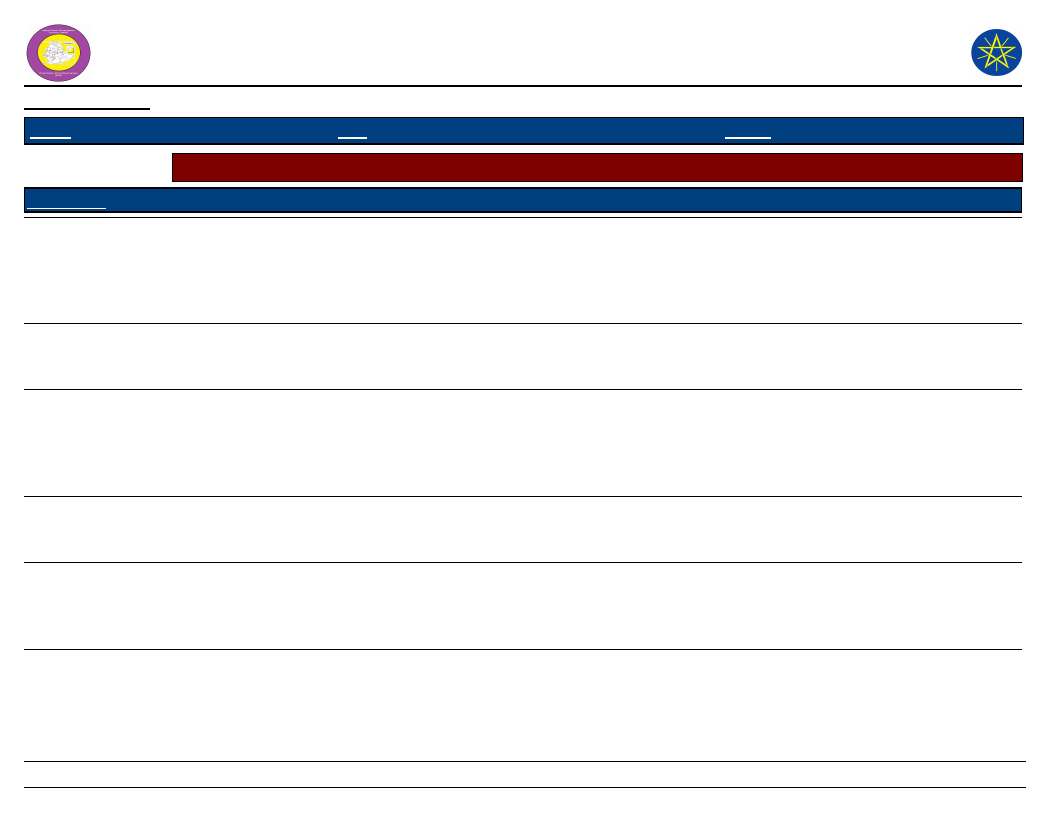
Wereda Disaster Risk
Profile
Data_Collected_Date
Region S.N.N.P
Zone
GURAGE
National Disaster Risk Management
Commission (NDRMC)
Wednesday, July 10, 2019
Wereda MESKAN
Selected Indicator
Wereda Strengths, weaknesses, opportunites and treats (SWOT) Analysis
Kebele Name
BATI FATO
BATI LEJANO
BECHE
BULCHANO
BERESA
DEBO TUTO
Strength
- Hard workers
- Using modern
technologies/investors
- Helping each other
- Community cooperative
participation
- Tree plantation
- Applied modern
technologies
- Helping each other
- Reflect their feeling and
apply response
- Replant the tree aid
cooperation of community
control hazard
- Cooperation of
community control hazards
ad protect vulnerability of
family
Weakness
- Not use families man
power
- Saving problem
- Poor farming system
- No strength to work
- Saving problems, problem
of creativity
- Problem of preparedness
- Problem land preparation
- Dependent
- Lack of awareness
- Lack of awareness
Opportunity
- Productive land
- Under ground water
- Working man power
- Nearest to local market
- Good topography and land
- Good climate condition
- Irrigation water and land
- Main road
- Near to capital city
- Resource man power
- Resource man power
Threat
- Human and livestock
disease
- Crop disease/pepper
disease
- Unconditional rain
- Lack of fund, climate
change
- Shortage of rain
- Drought, climate change
- Human and livestock
disease
- Increasing input price
- Lack of fund
- Lack of fund, increase
severity of disaster
363
Page 1 of 7
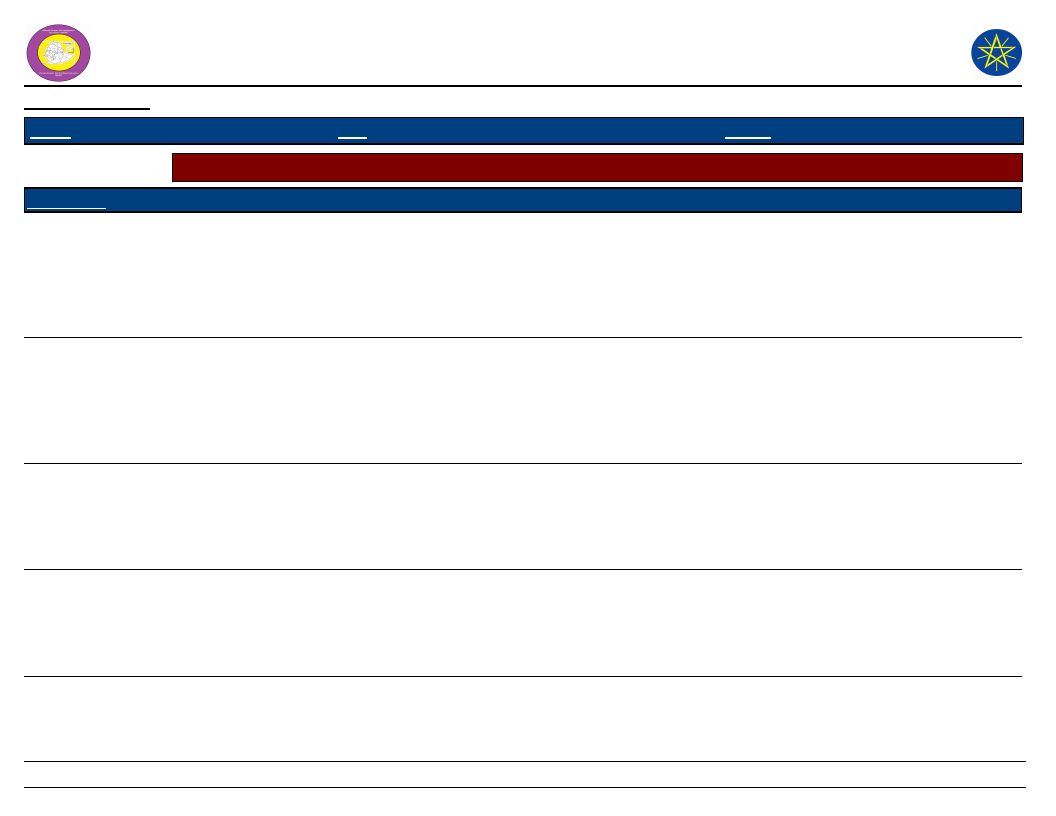
Wereda Disaster Risk
Profile
Data_Collected_Date
Region S.N.N.P
Zone
GURAGE
National Disaster Risk Management
Commission (NDRMC)
Wednesday, July 10, 2019
Wereda MESKAN
Selected Indicator
Wereda Strengths, weaknesses, opportunites and treats (SWOT) Analysis
Kebele Name
DEBUB
SHERSHERA
DEGAGOGOT
DIDA
Strength
- Committed to the
development or to build
infrastructure
- Helping each other
- Saving asset
- Helping each other
- Soil and water
conservation
- Good participation
- Saving habit
- Helping each other
- Organized by different
cooperative
DIRAMA
- Practice their awareness
- Hard workers
- Cooperative /helping
each other
Weakness
- The problem of use of
modern technologies
- Unnecessary anti work and
poor saving culture
Opportunity
- Land, stone and sand
- Asphalt road, nearest to the
town
- Drinking alcohol,
dependent
- Exposed to unnecessary
cost
- Lack of awareness for
modern technology
- Poor saving culture
- Dependent
- Poor preparedness
- Spring and river water
- Economic hardship resistant
- Land
- Ground water
- Working man power
- Problem of soil structure
- Poor saving culture
- Education
- Migration
- Main road
- Nearest to Addis Ababa
- Working man power
- Ecology
Threat
- Decreasing of soil
fertility
- Drought, shortage of
rain
- Climate change,
population growth
- Topography
- Agro ecology of the area
- Lack of funding
- For apart from main
road and local market
- Climate change
- Livestock and crop
disease
- Agro ecological
condition of the area
- Potential water source
for irrigation
- Drought
- Soil erosion
- Climate change
364
Page 2 of 7
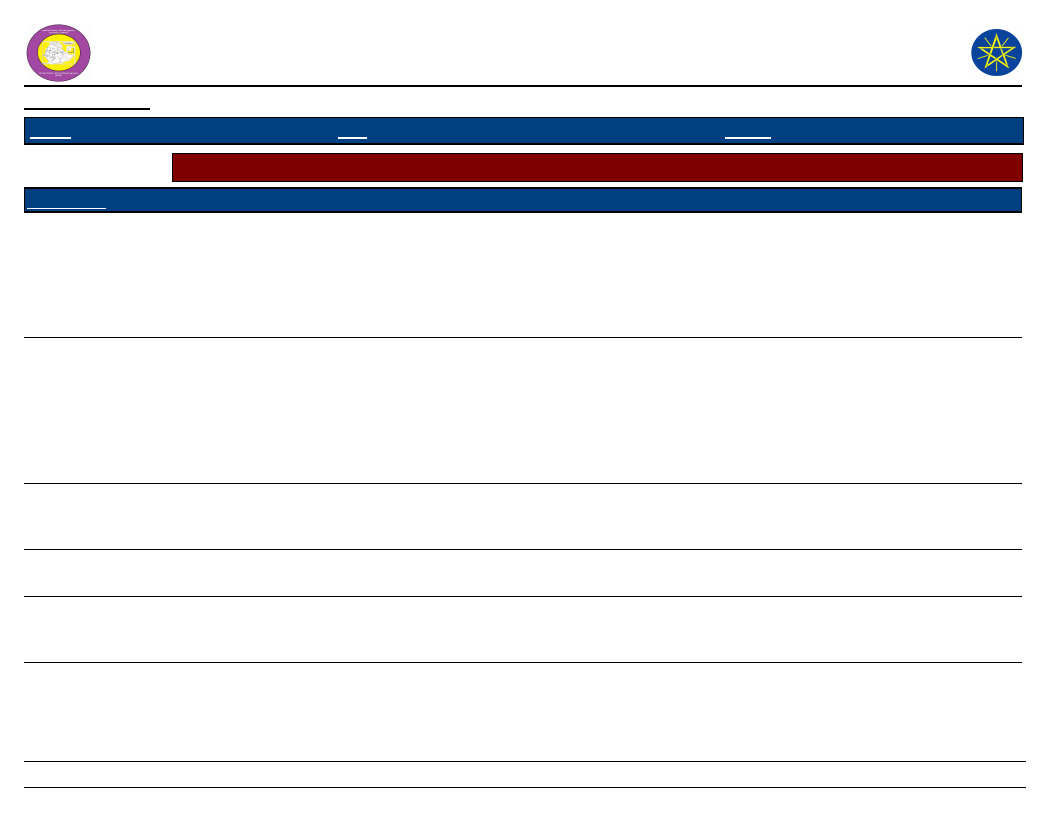
Wereda Disaster Risk
Profile
Data_Collected_Date
Region S.N.N.P
Zone
GURAGE
National Disaster Risk Management
Commission (NDRMC)
Wednesday, July 10, 2019
Wereda MESKAN
Selected Indicator
Wereda Strengths, weaknesses, opportunites and treats (SWOT) Analysis
Kebele Name
DOBENA
Strength
- Helping each other
- Hard workers
- Respect work
- Participate infrastructure
development
GIDENA ABORAT
- Hard working
- Helping each other
- Saving behavior
GOYBAN
ILE
INSENO USME
- Helping each other
- Saving habit
- High social interaction
- Afforestation
- Community cooperation
and good participation
- Afforestation
Weakness
- Dependent of government
- Lack of modern
technologies
- Problem of sustainable
development
- Sharing experience
- Weekness of sustainable of
or sanitation workers
- Over drinking alcohol
- Exposed to extra cost
- Improper land use
- Over grazing
- Poor farming system
- No effective time used
Opportunity
- Construction irrigation dam
and canals
- Near to woreda town
- Land, water
- Solving social and financial
problem
- Helping adaptation
- Working man power
- Cooperative and
participations
- There willingness
- Have grazing land, some
natural trees
- Good topography of land
Threat
- Shortage of clean and
irrigation water
- Climate change. drought
- Shortage of water
- Livestock and human
disease
- Shortage of rain fall
- Shortage of land
- Shortage of improved
crop and animal variety
- Clan water human and
livestock
- Misunderstanding
- Lack of funding
- Lack of funds, climate
change
- Increased severity and
disaster, lack of funds
- Climate change
365
Page 3 of 7
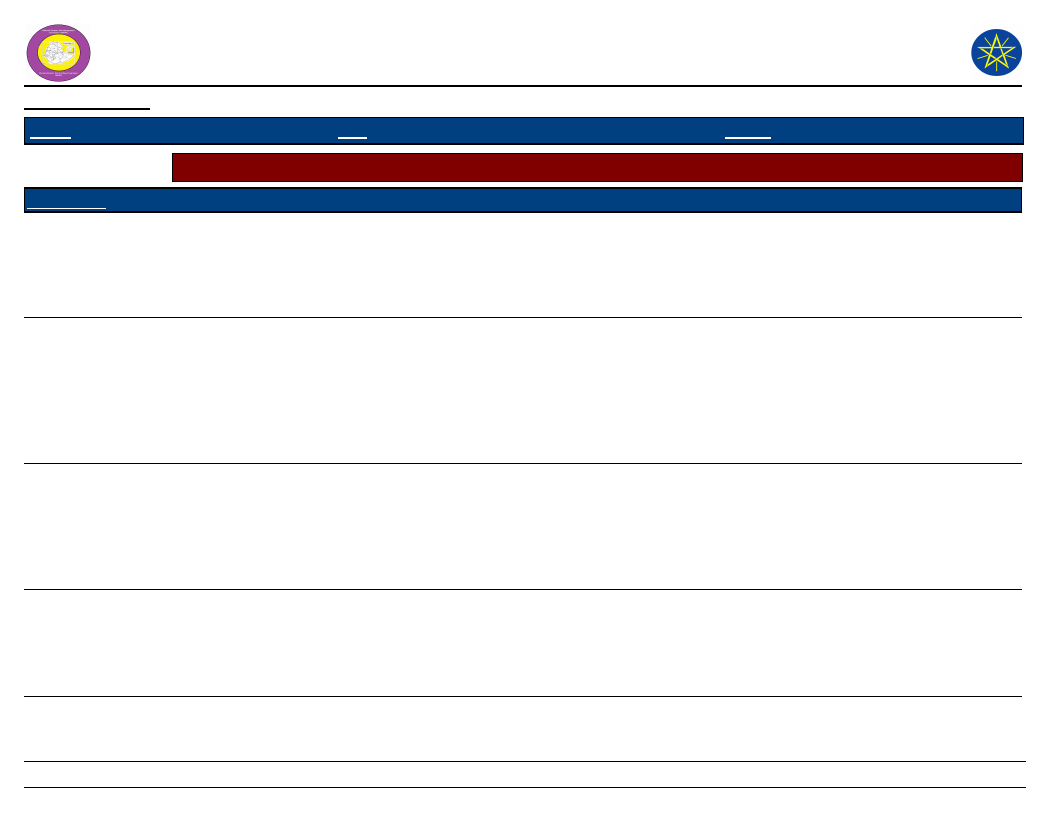
Wereda Disaster Risk
Profile
Data_Collected_Date
Region S.N.N.P
Zone
GURAGE
National Disaster Risk Management
Commission (NDRMC)
Wednesday, July 10, 2019
Wereda MESKAN
Selected Indicator
Wereda Strengths, weaknesses, opportunites and treats (SWOT) Analysis
Kebele Name
JOLE ANDENYA
Strength
- Soil and water
conservation
- Afforestation
JOLE HULETENYA
- Helping each other
- Hard worker
- Defense bad character
Weakness
- Improper farming system
- Over grazing
- Deforestation
- Shortage of awareness
- Dependent
- Saving problems
Opportunity
- Permanent river/Meki river
- Rich under ground water
- Good fertile slop soil
MEKICHO
- Helping each other
- Hard workers
- Creativeness
- Migrate
MESERETEWEGER
AMO
- Afforestation
- Good participation public
development activity
- In order to control
hazards
- No effective used in the
community
- Un proper farming system
- Land and water
- Nearest to Butajira town
- Working man power
- Topography to used
irrigation
- Have much forest land
- Good grazing land
- Good water source/spring
Threat
- Lack of fund
- No attention and
responses from concerned
part
- Less plantation
- Climate change, shortage
of rain fall
- Drought, flood, crop
disease
- Pepper disease and
livestock disease
- Conflict
- Water shortage and
climate change
- Drought
- Pest
- Human disease and
animal disease
- Lack of fund, less
productivity
366
Page 4 of 7
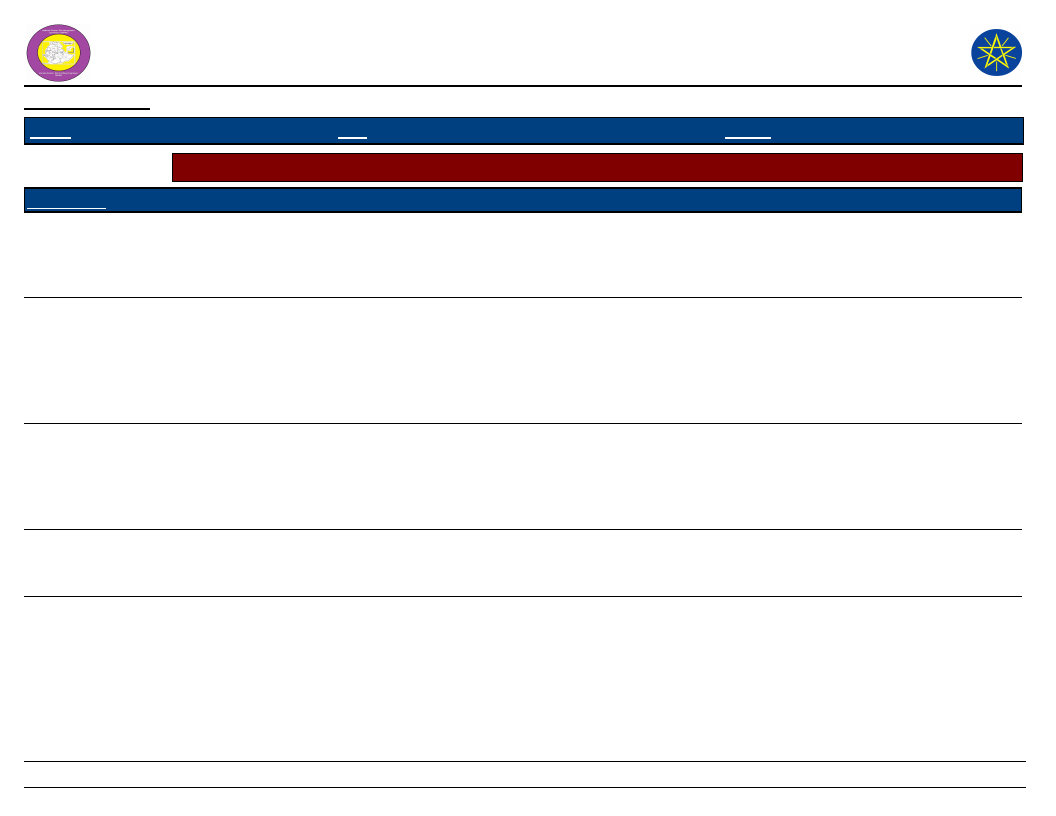
Wereda Disaster Risk
Profile
Data_Collected_Date
Region S.N.N.P
Zone
GURAGE
National Disaster Risk Management
Commission (NDRMC)
Wednesday, July 10, 2019
Wereda MESKAN
Selected Indicator
Wereda Strengths, weaknesses, opportunites and treats (SWOT) Analysis
Kebele Name
MIKAELO
MIRAB IMBOR
MIRAB MESKAN
Strength
- Cooperation to construct
soil and water conservation
- Rehabilitation the
vulnerable farmers
- Hard Workers
- Create a new activities
to resist disasters
- Helping or cooperating
each other
- Helping each other
- Working hard
Weakness
- Do no take solution to the
problem timely
- Problem of care and
maintenance of conservation
structure
- The problems of
sustainable development
activities
- Saving problems
- Depending on chat
- Time loss
Opportunity
- Differnet resource to
construct dam, stone, man
power
- Land, water source
- Forest, collage and schools
- Favorable air condition
- Near to health center
- Good topography of land
- Water
- Near to the main road
OCHAGENEME
- Forest plantation
- High social interaction
- Improper farming system
- Deforestation
- Good natural and land, man
power
- Over grazing
Threat
- Lack of fund
- Construction of high way
road
- Climate change, shortage
of rain fall
- Topography of the area
- Population growth
- Fluctuate of rain
distribution
- Drought
- Climate change
- Population growth
- Lack of fund, climate
change
367
Page 5 of 7
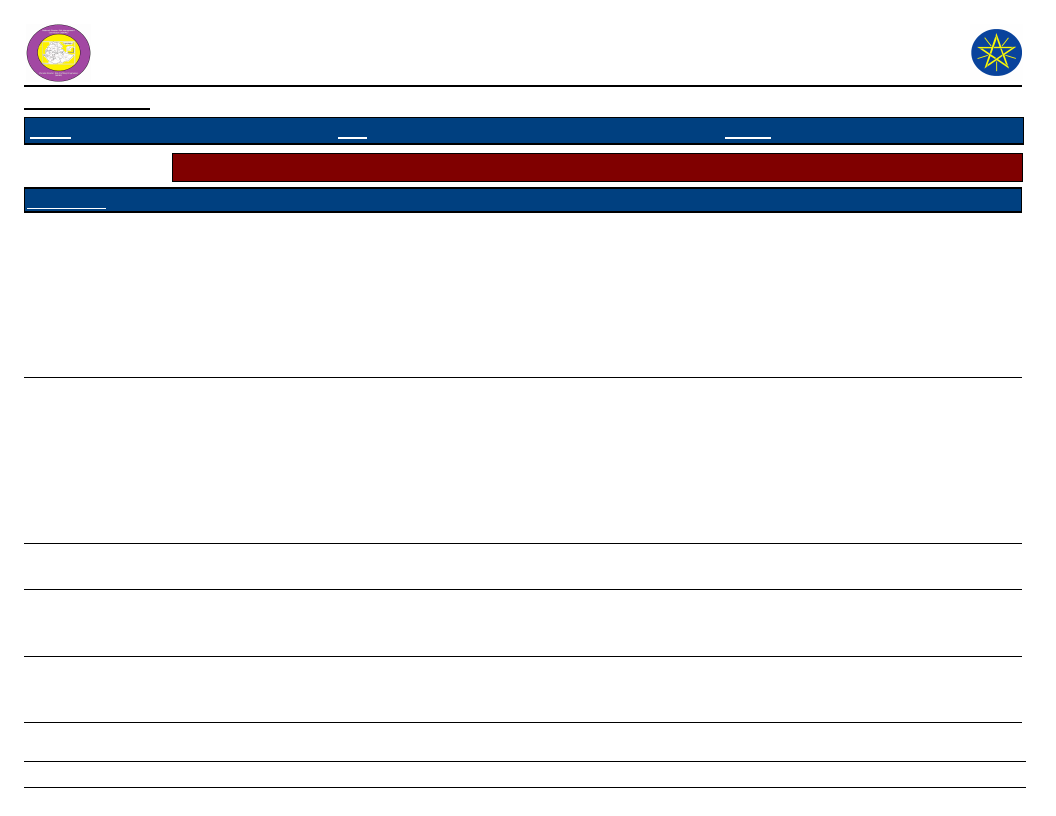
Wereda Disaster Risk
Profile
Data_Collected_Date
Region S.N.N.P
Zone
GURAGE
National Disaster Risk Management
Commission (NDRMC)
Wednesday, July 10, 2019
Wereda MESKAN
Selected Indicator
Wereda Strengths, weaknesses, opportunites and treats (SWOT) Analysis
Kebele Name
SEMEN
SHORSHORA
SHERSHERA
MACHMENA
WEJABATI
WITA
WOLENSHO
ANDENYA
Strength
- Helping each other by
sharing resource
- Sustainable soil and
water conservation
activities
- Saving habit
- Organized as group and
working soil and water
conservations
- Using modern
technologies
- Planting forest plant
every year
- Excluding the forest area
- Forest plantation
- Community cooperation
- Construction of terrace,
soil bund
- Forest plantation
- Good cooperatives
- Rehabilitation the
vulnerable family
Weakness
- Lack of awareness
- Illiteracy
- Uncultivated early
matured crop variety
- Farming system
- The probem of
maintenance of conservation
structures
- Lack of pasture plants
- Improper farm practice
- Over grazing
- Improper farming system
- Over grazing
- Deforestation
- Lack of awareness and
illiteracy
Opportunity
- Road construction,
afforestation, good soil and
water conservation practice
- Good water harvesting
practice
- Good participation, good
sharing resource
- Helping each other
- Business opportunity
- Land
- Man power
- Helping cultural
- Good topography of land
- Has different resource
Threat
- Shortage of water
- Lack of improved seed
specially early mature
varieties
- Very low yield and low
soil fertility
- Livestock disease, crop
disease,
- Water scarcity
- shortage of money
- Topography
- Wild animals
- Lack fund
- Climate change
- Lack of funding
- Lack of alternative from
wereda
- Lack of funds, increasing
severity of disaster
368
Page 6 of 7
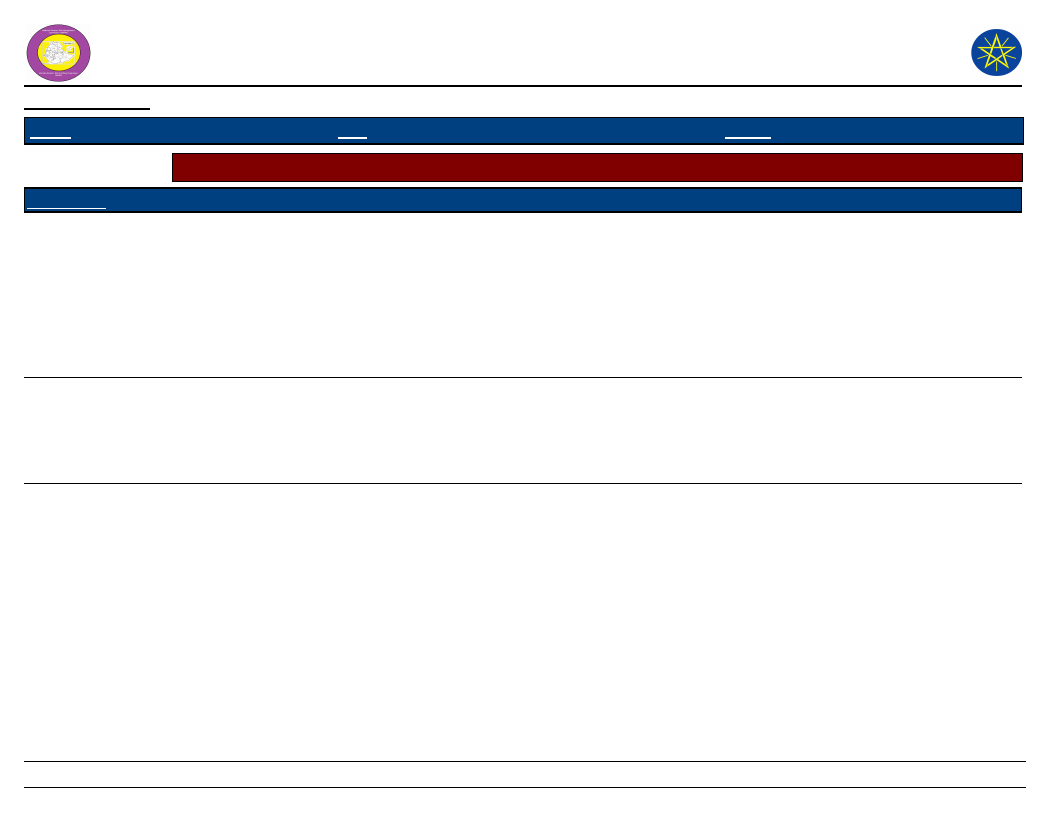
Wereda Disaster Risk
Profile
Data_Collected_Date
Region S.N.N.P
Zone
GURAGE
National Disaster Risk Management
Commission (NDRMC)
Wednesday, July 10, 2019
Wereda MESKAN
Selected Indicator
Wereda Strengths, weaknesses, opportunites and treats (SWOT) Analysis
Kebele Name
YETABON
Strength
- Helping each other
- Participate development
activities
- Hard working
- Hard organizations
Weakness
- Not defense and exposed
weak or corrupted
management
- Shortage of saving
Opportunity
- Land, stream and rivers
- Working man power
YIMERWACHO
2NYA
YIMERWACHO
3NYA
- Helping characteristics
- Community cooperation
- Hard workers
- Good participation on
public development activity
- Afforestation
- Preparedness problems
- Lack of saving
- The problem of dependent
- Poor farmers system
- No effective time used in
the community
- give loss attention for our
problems
- Land and water
- Man power
- Air condition, well
geographical land
- Good topography, good
available ground water
Threat
- Shortage of clean water
and irrigation water
- Shortage of land and
population growth
- Shortage of rain fall,
drought
- Human, livestock and
crop disease
- Climate change, lack of
market linkage
- Lack of fund
- Shortage of clean water
and electricity
- Climate change, increase
severity of disaster
369
Page 7 of 7




